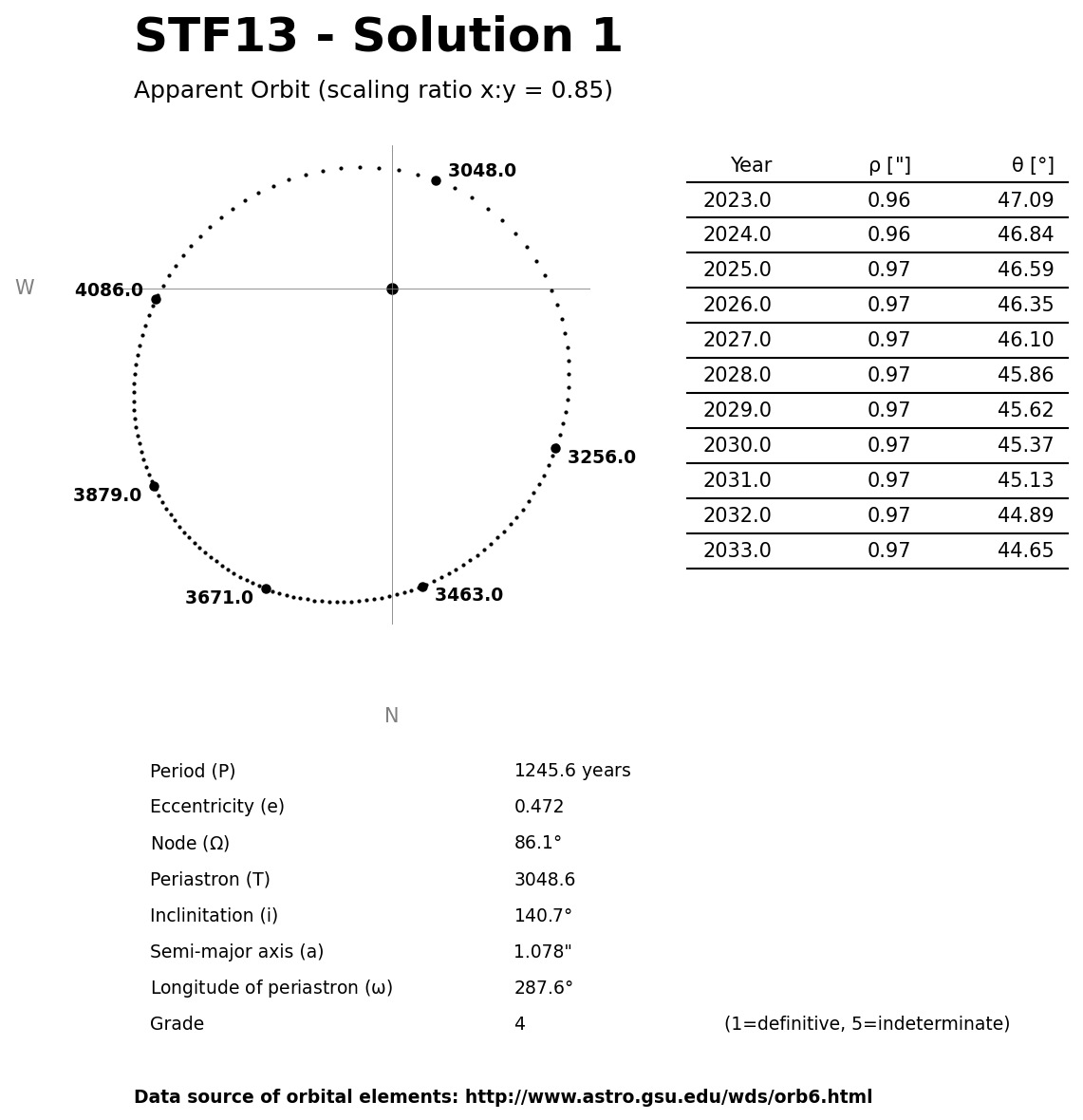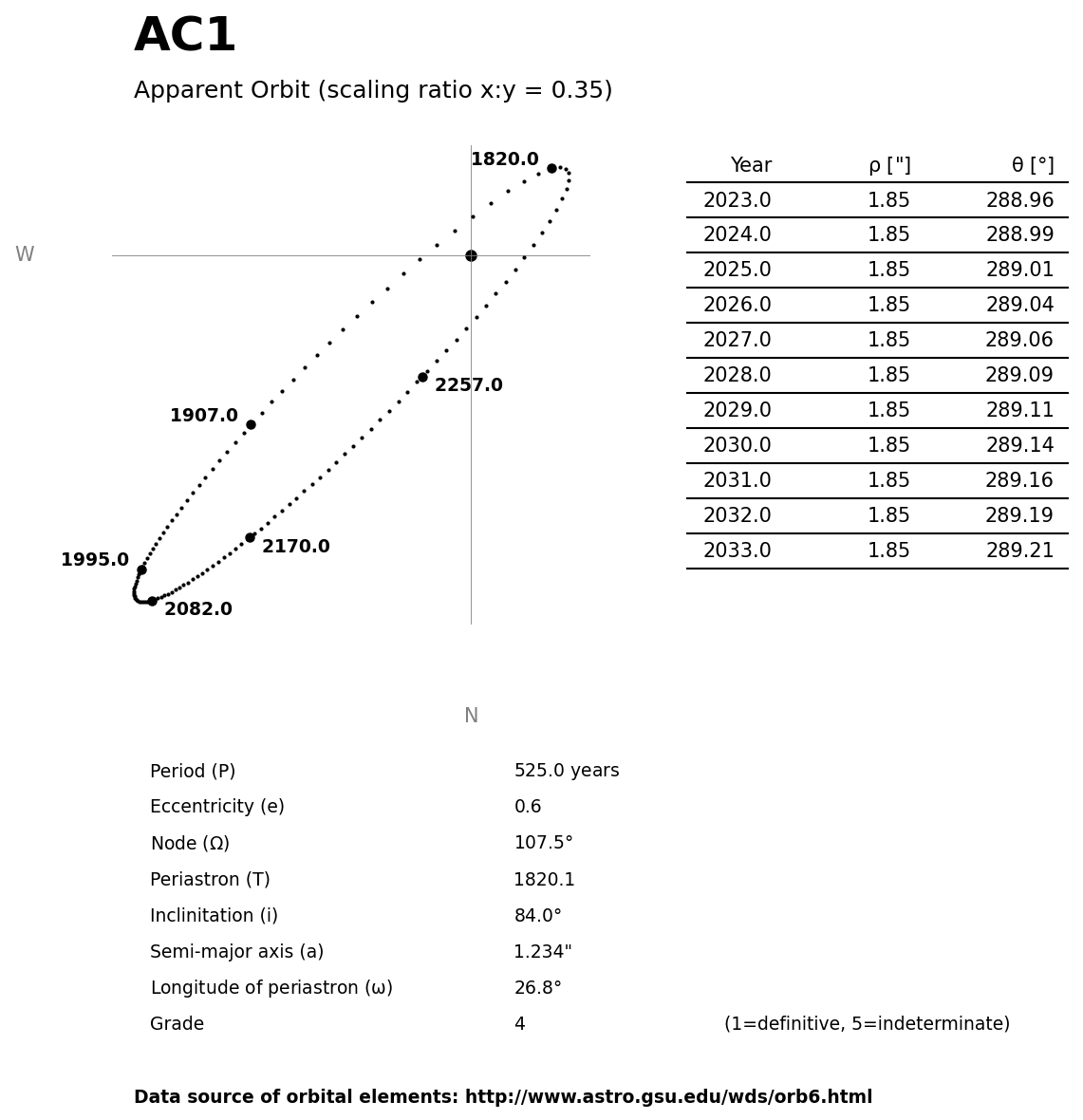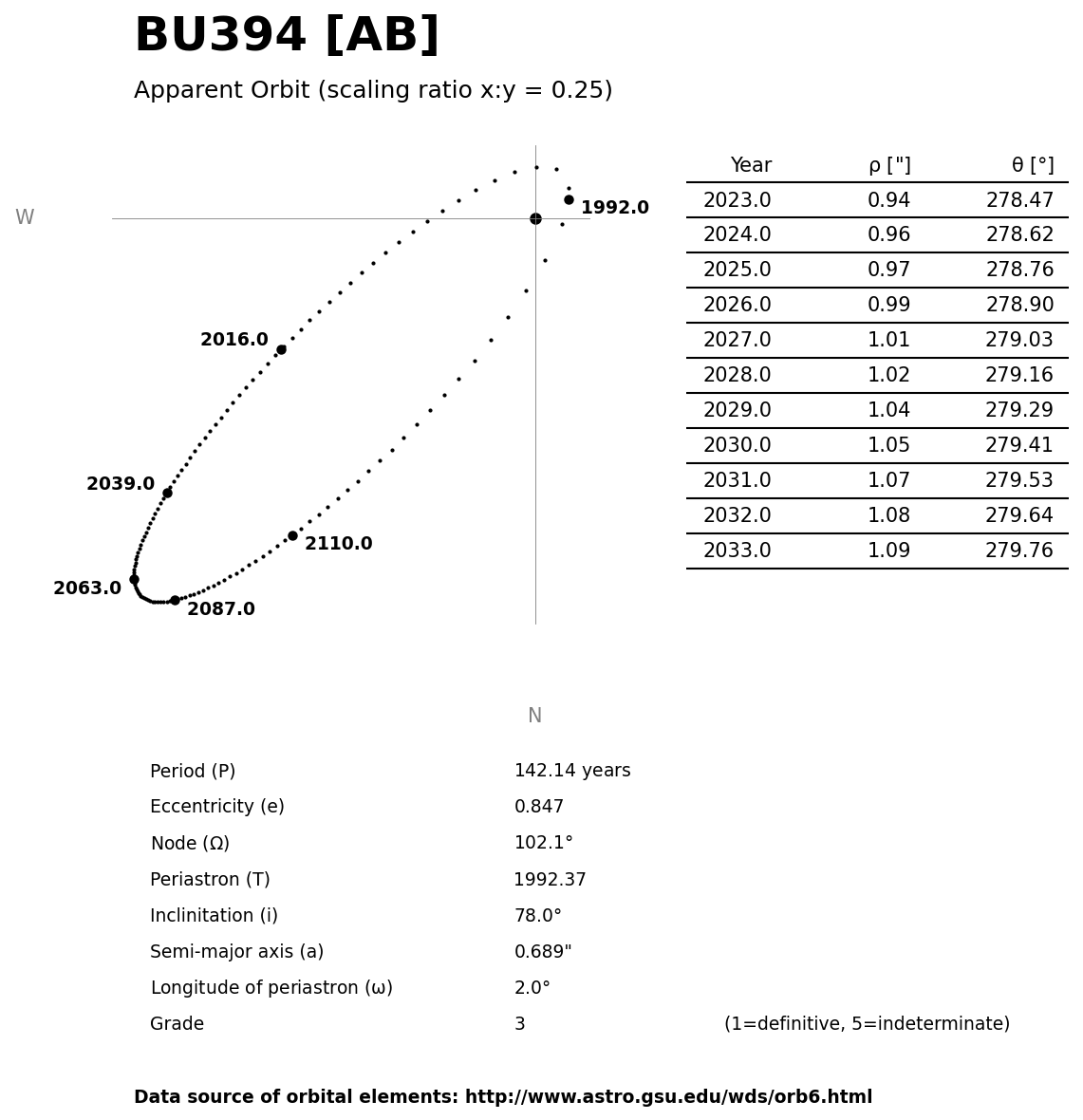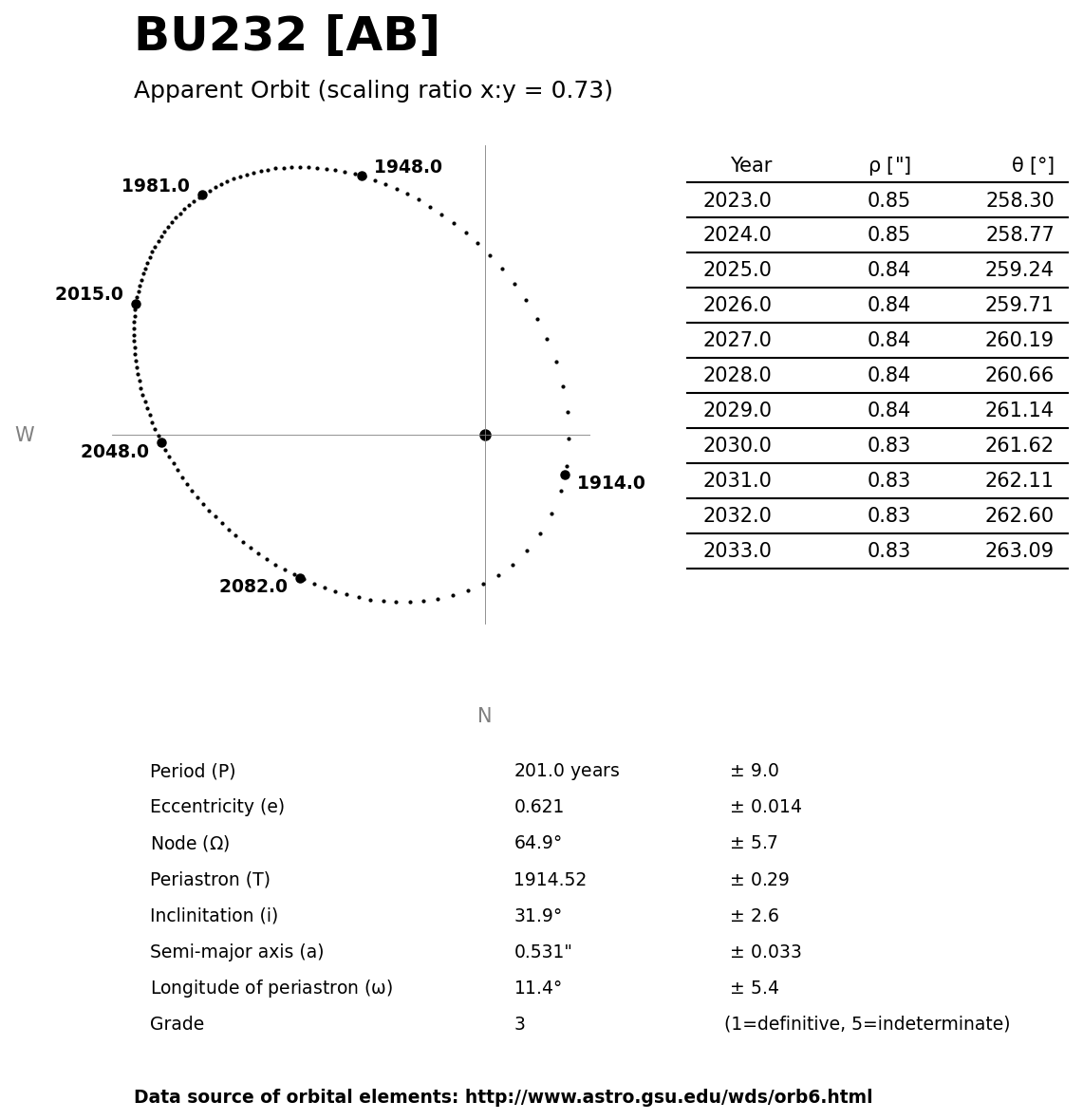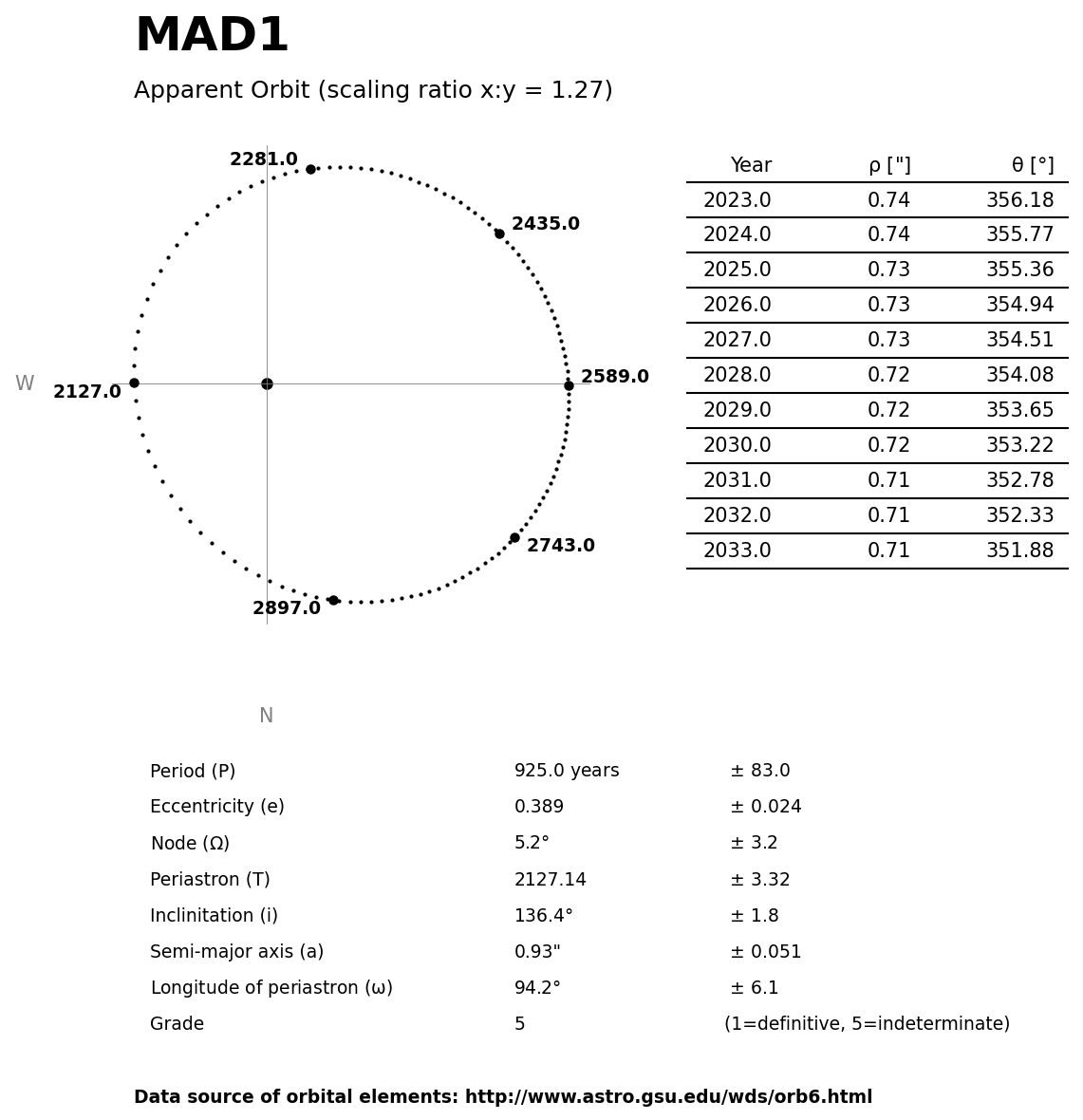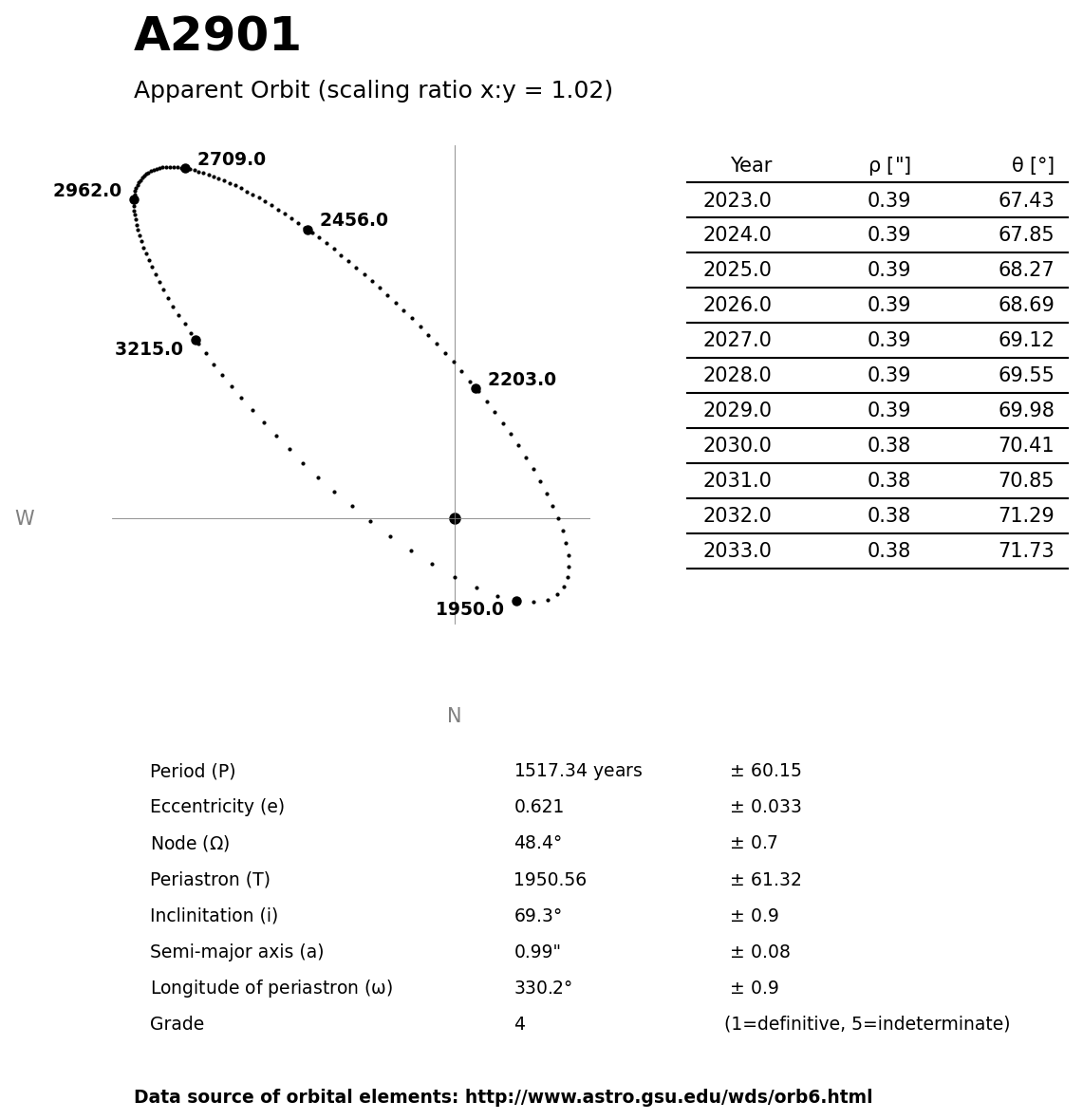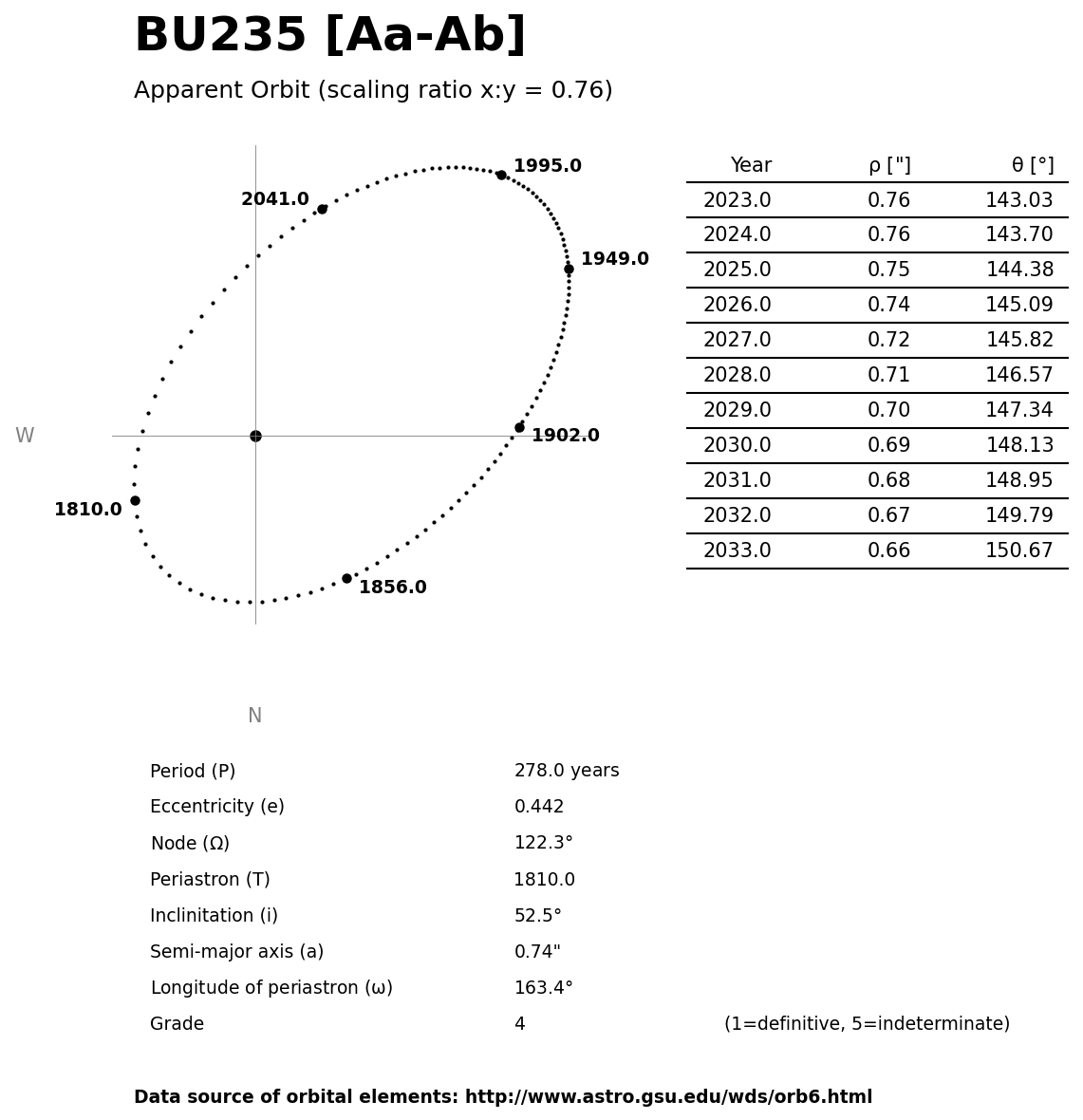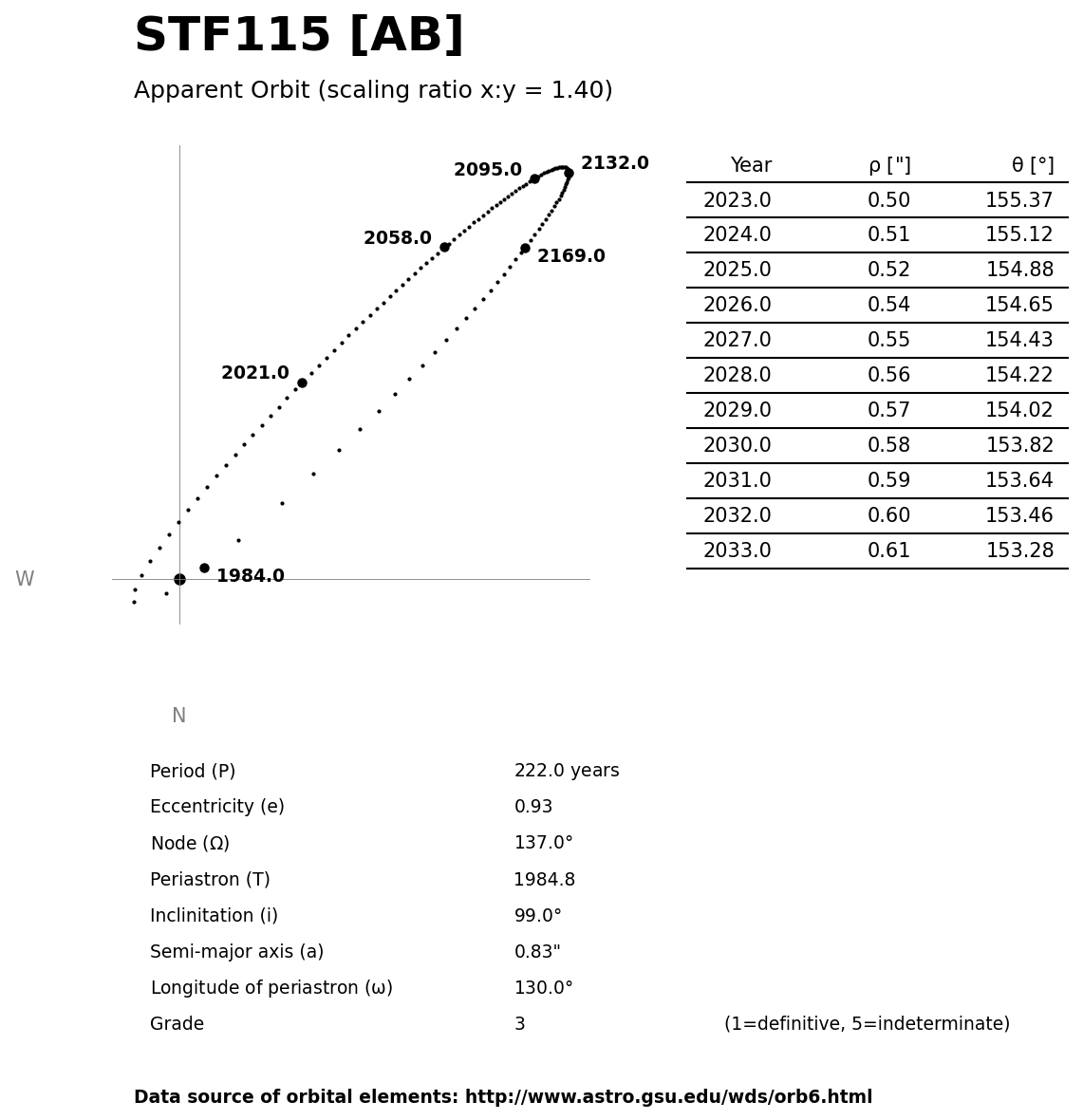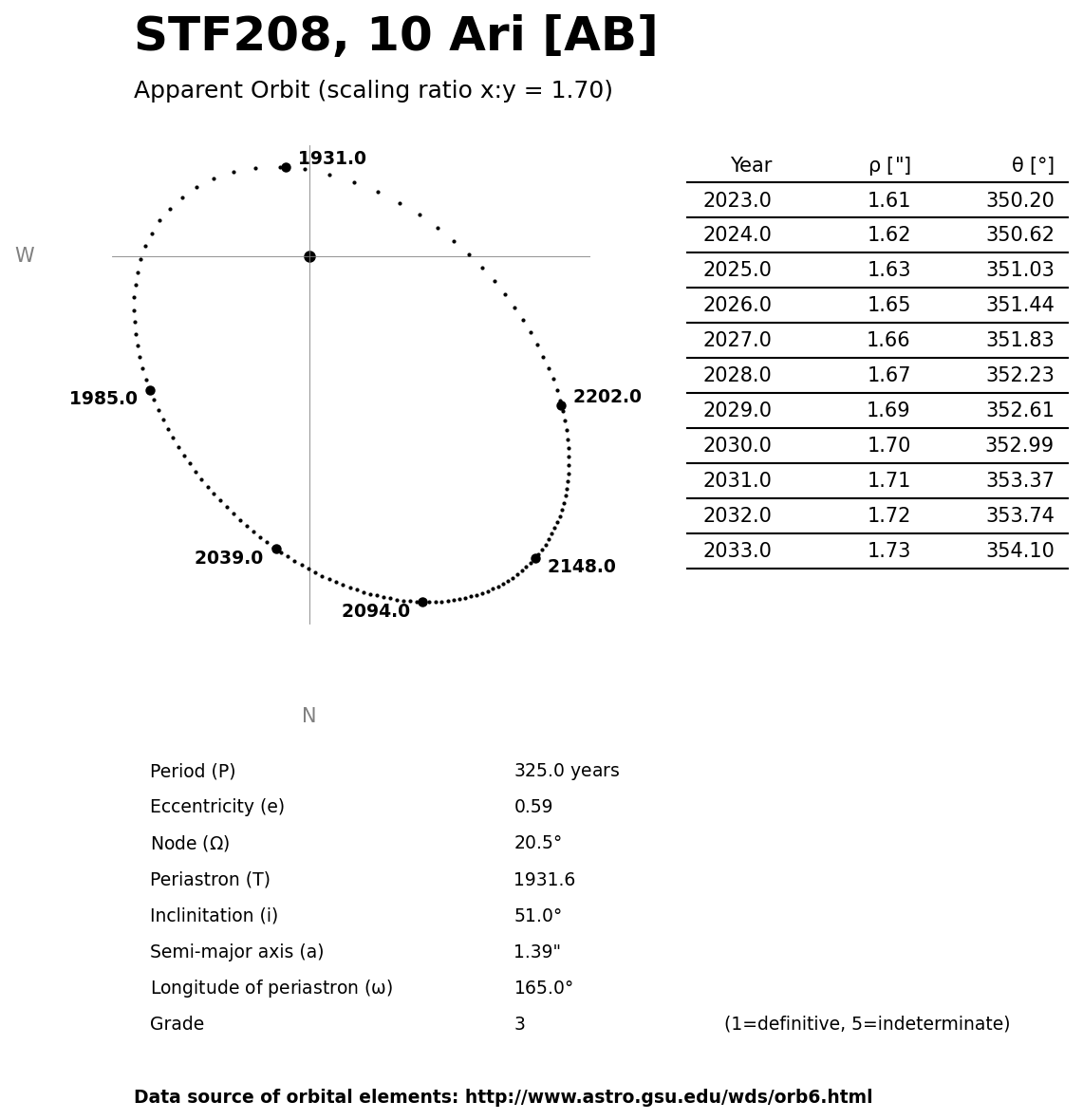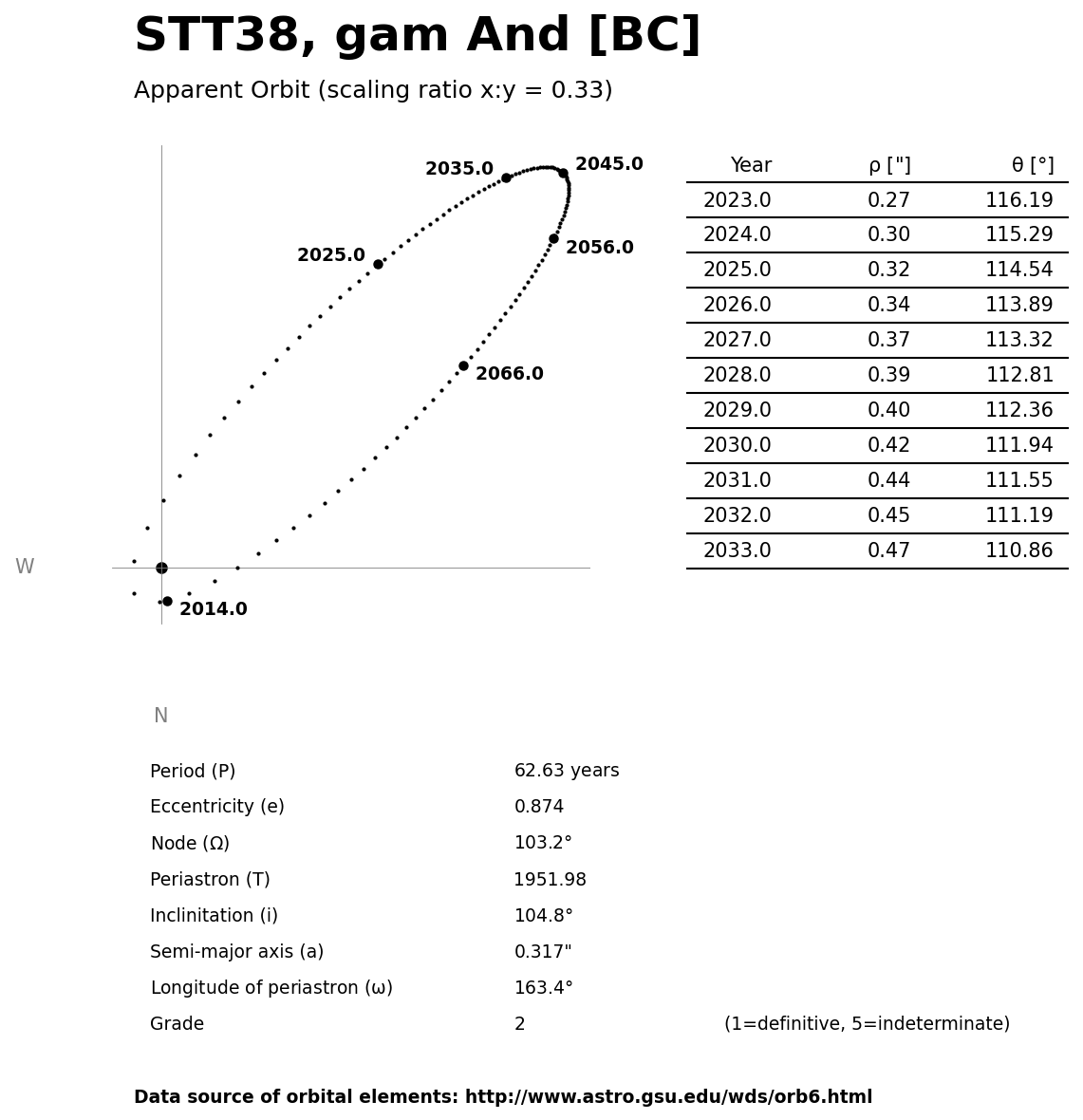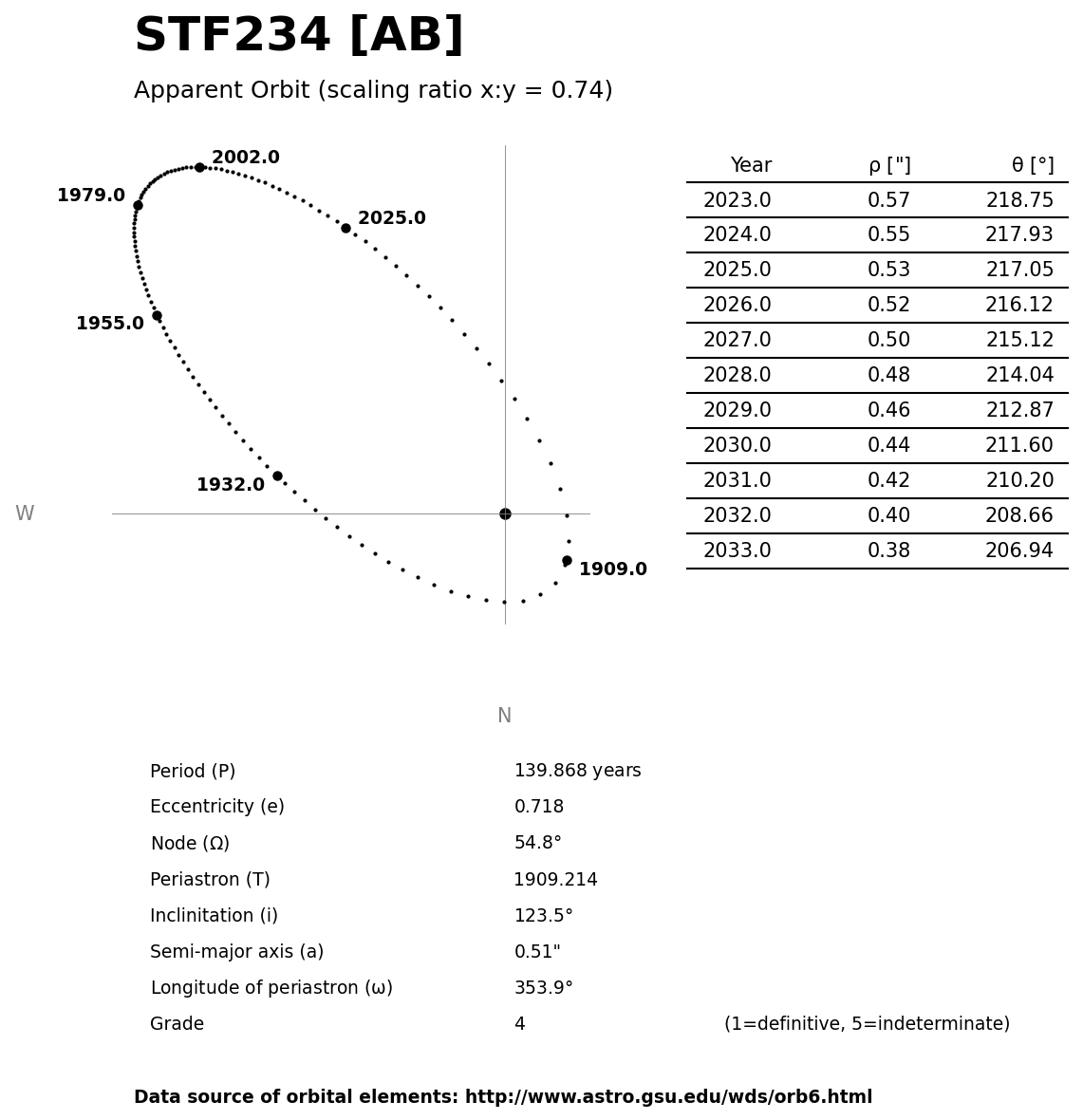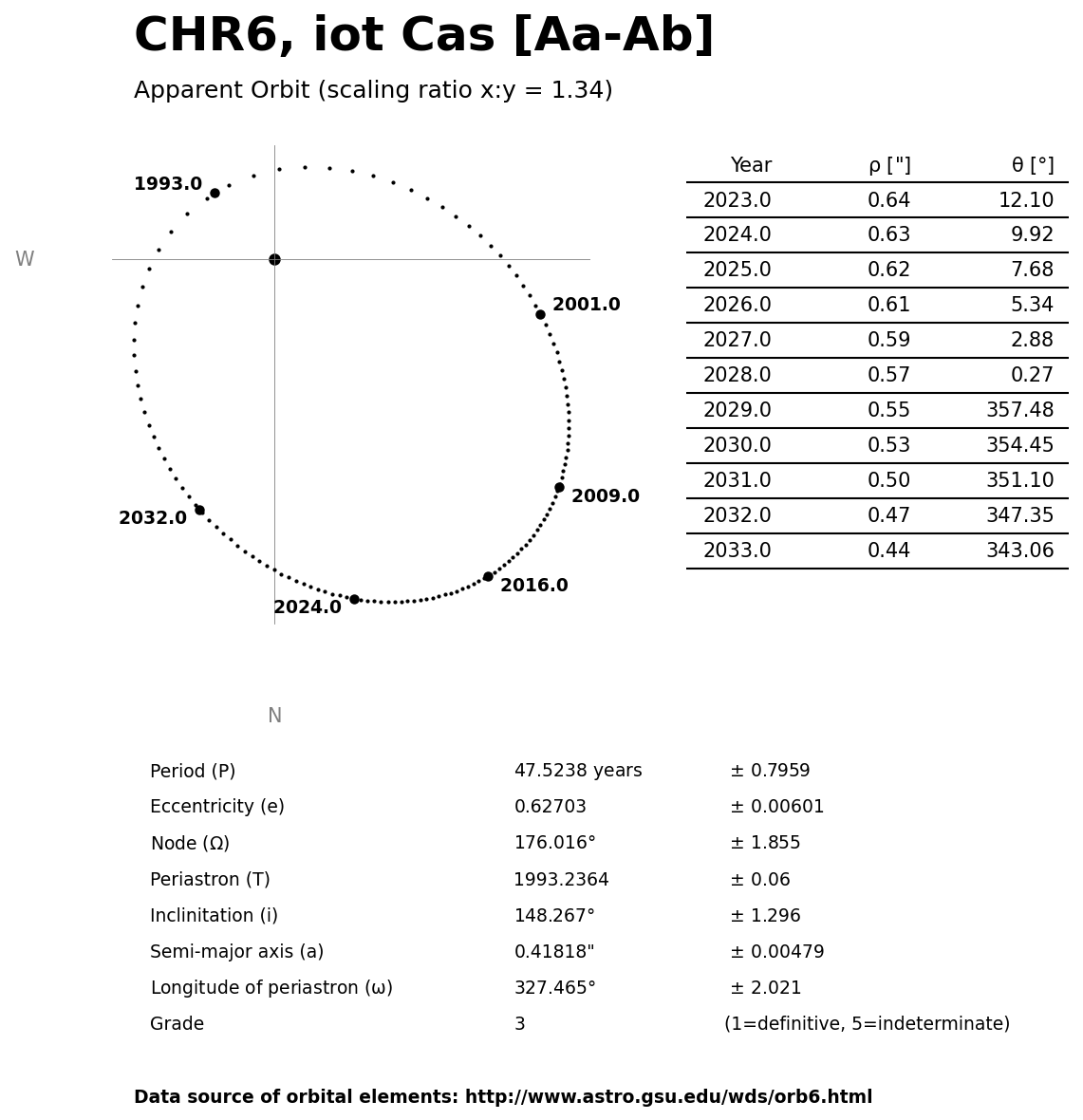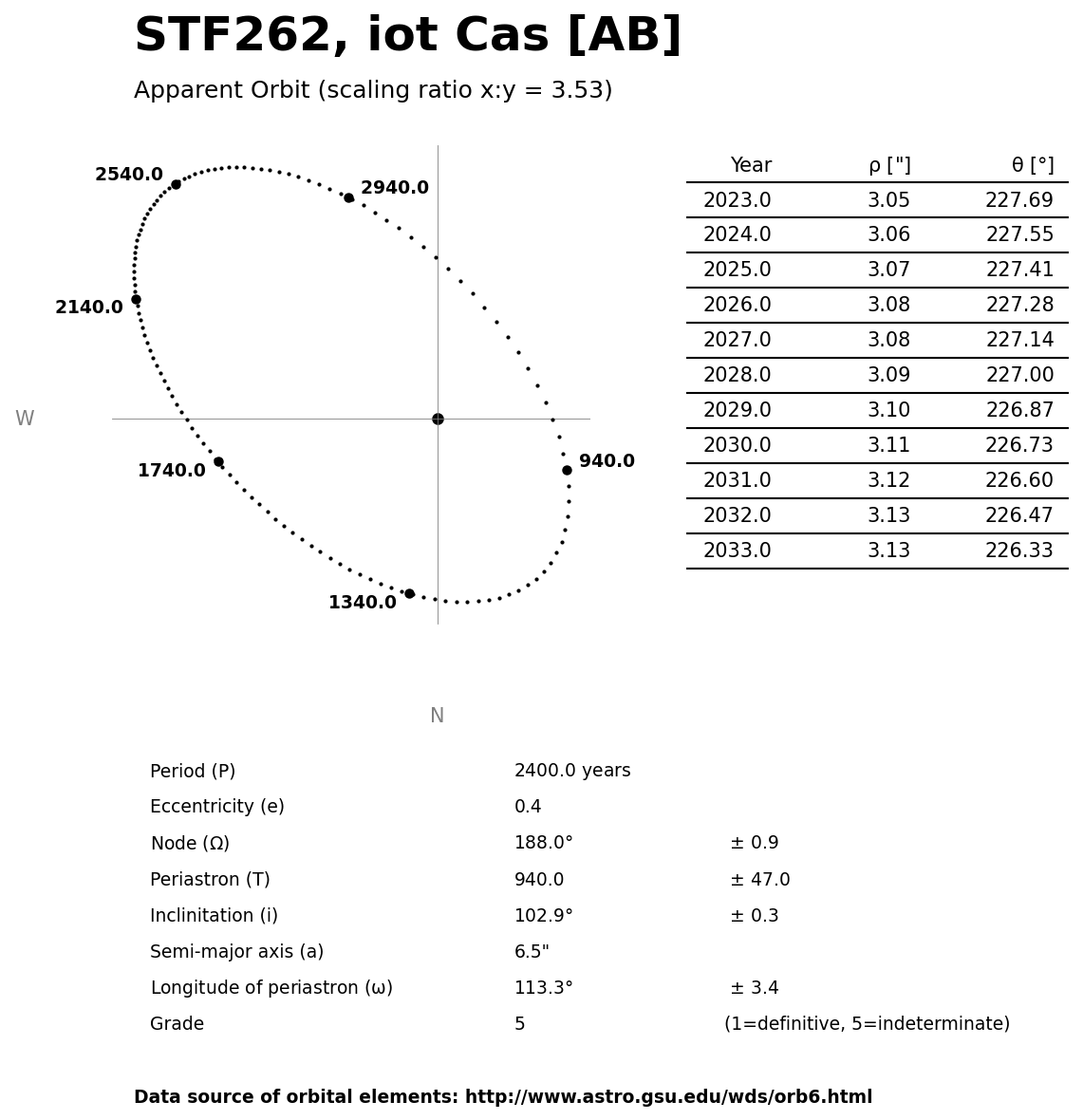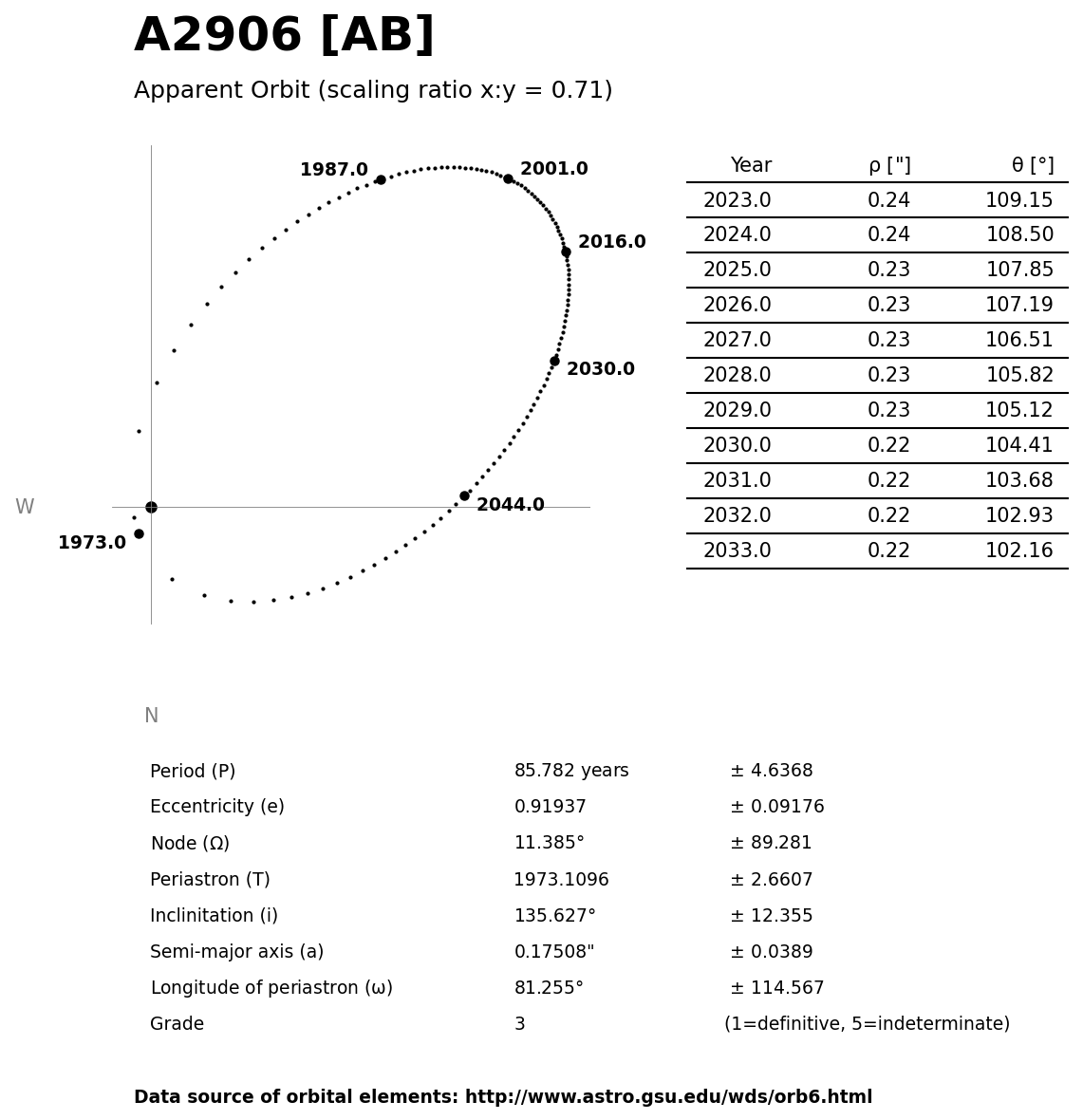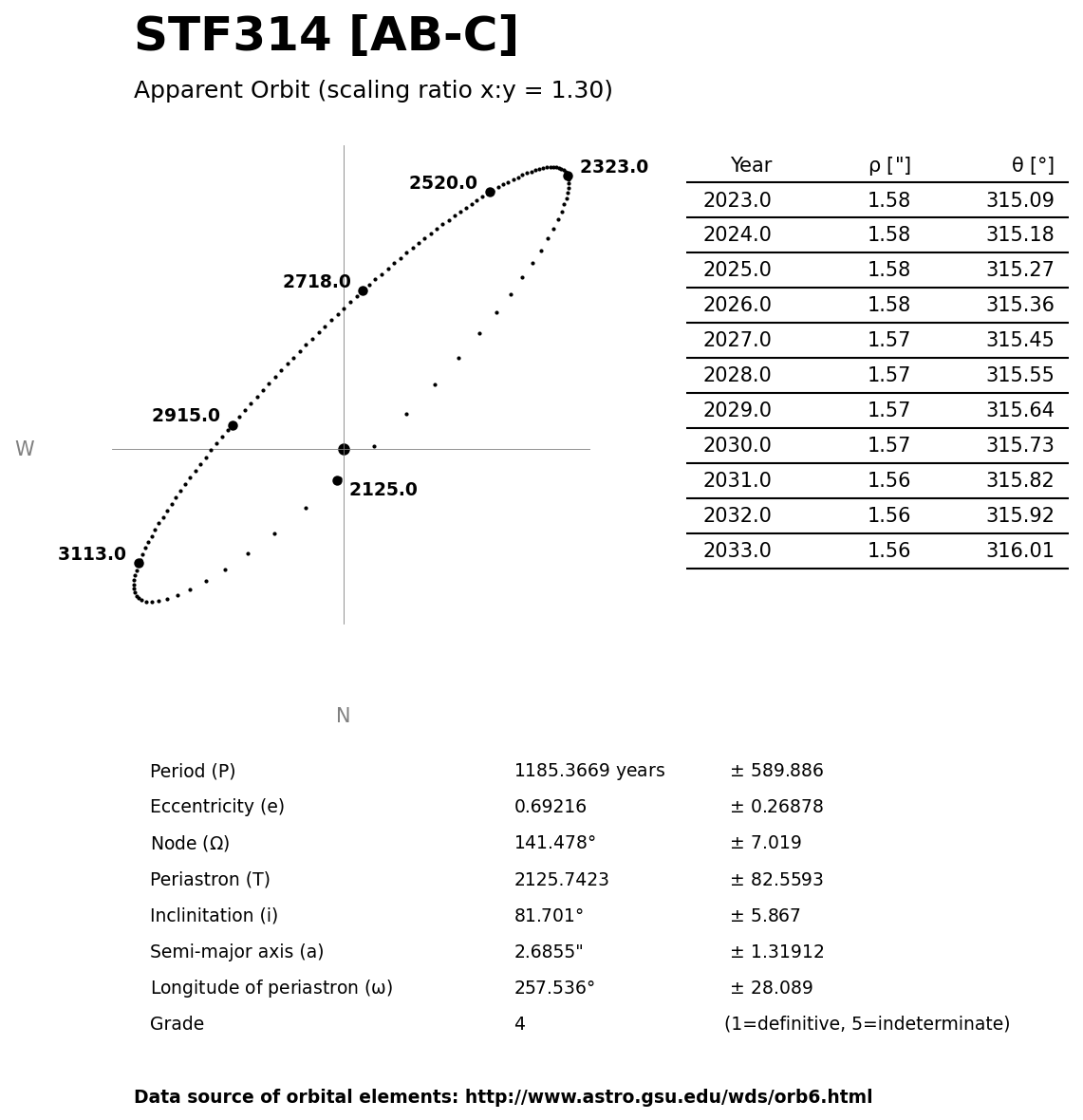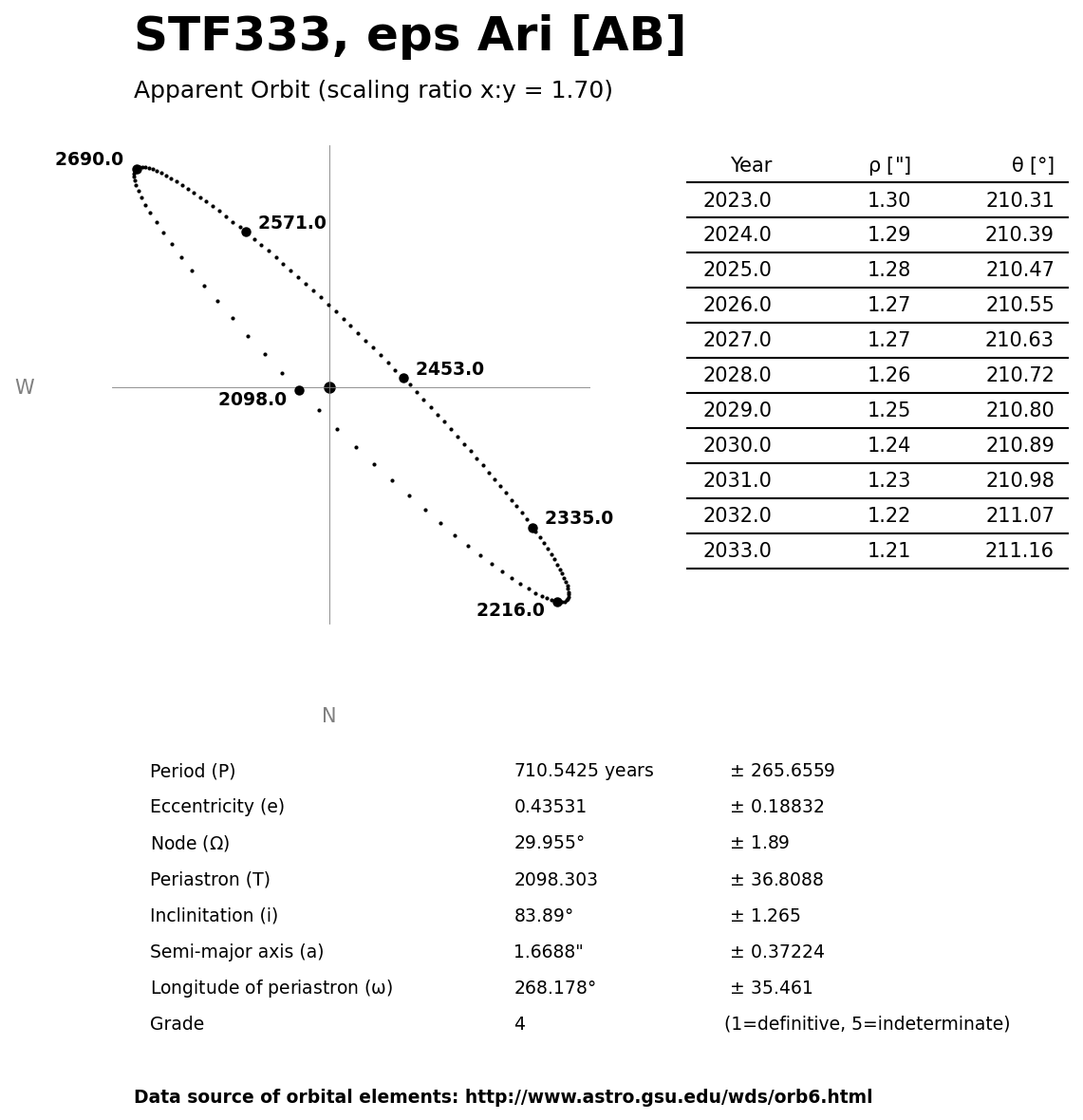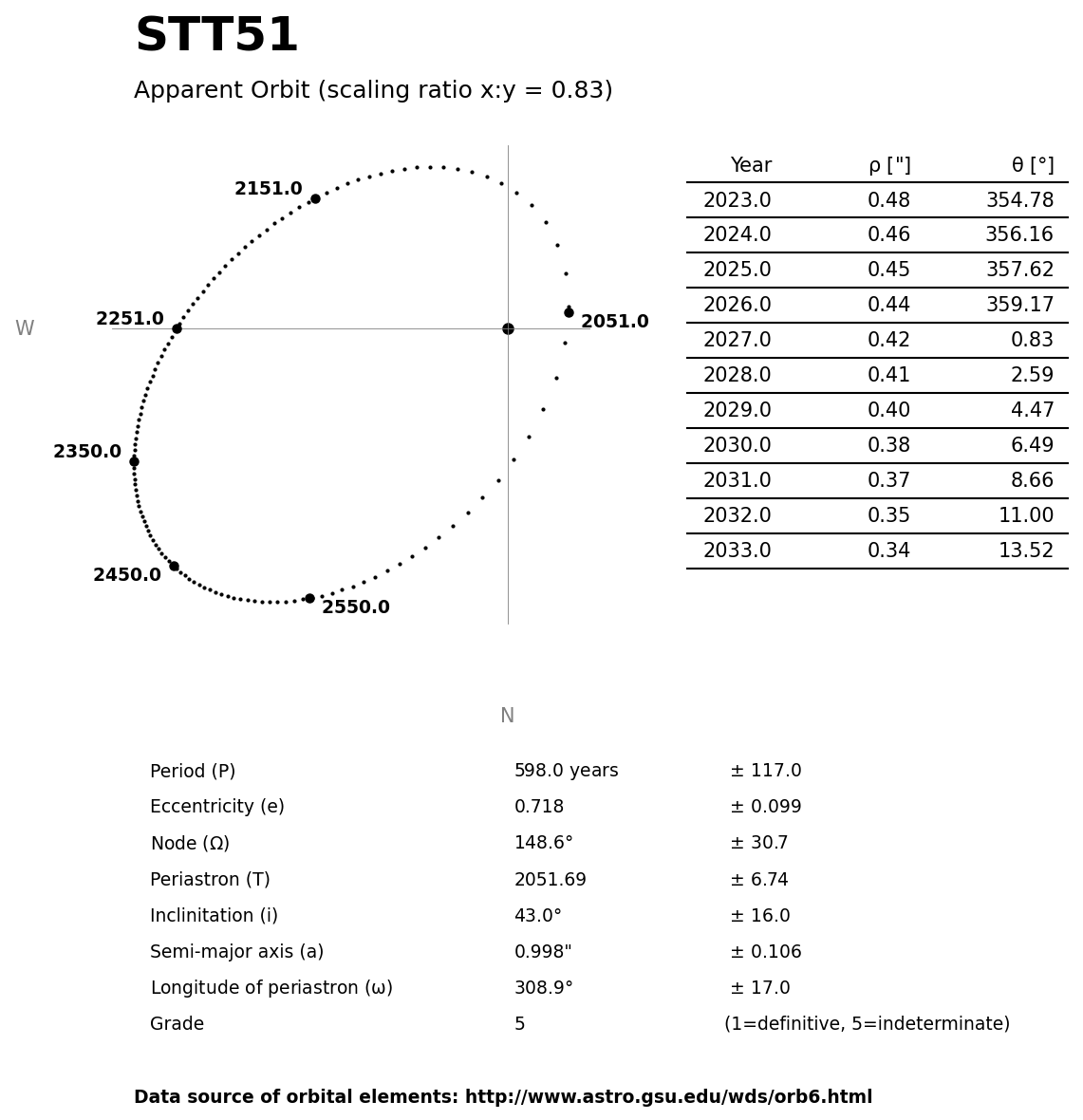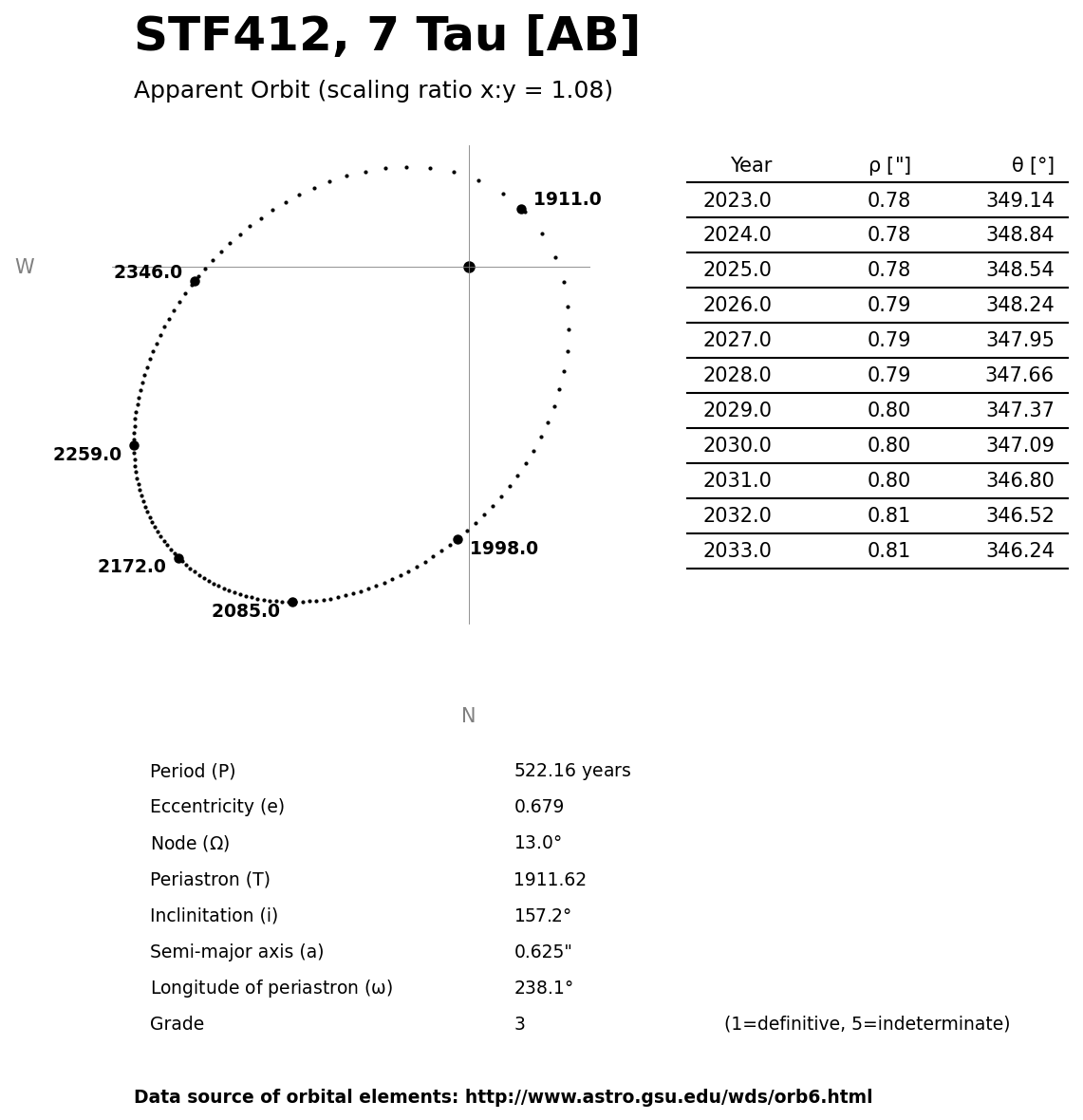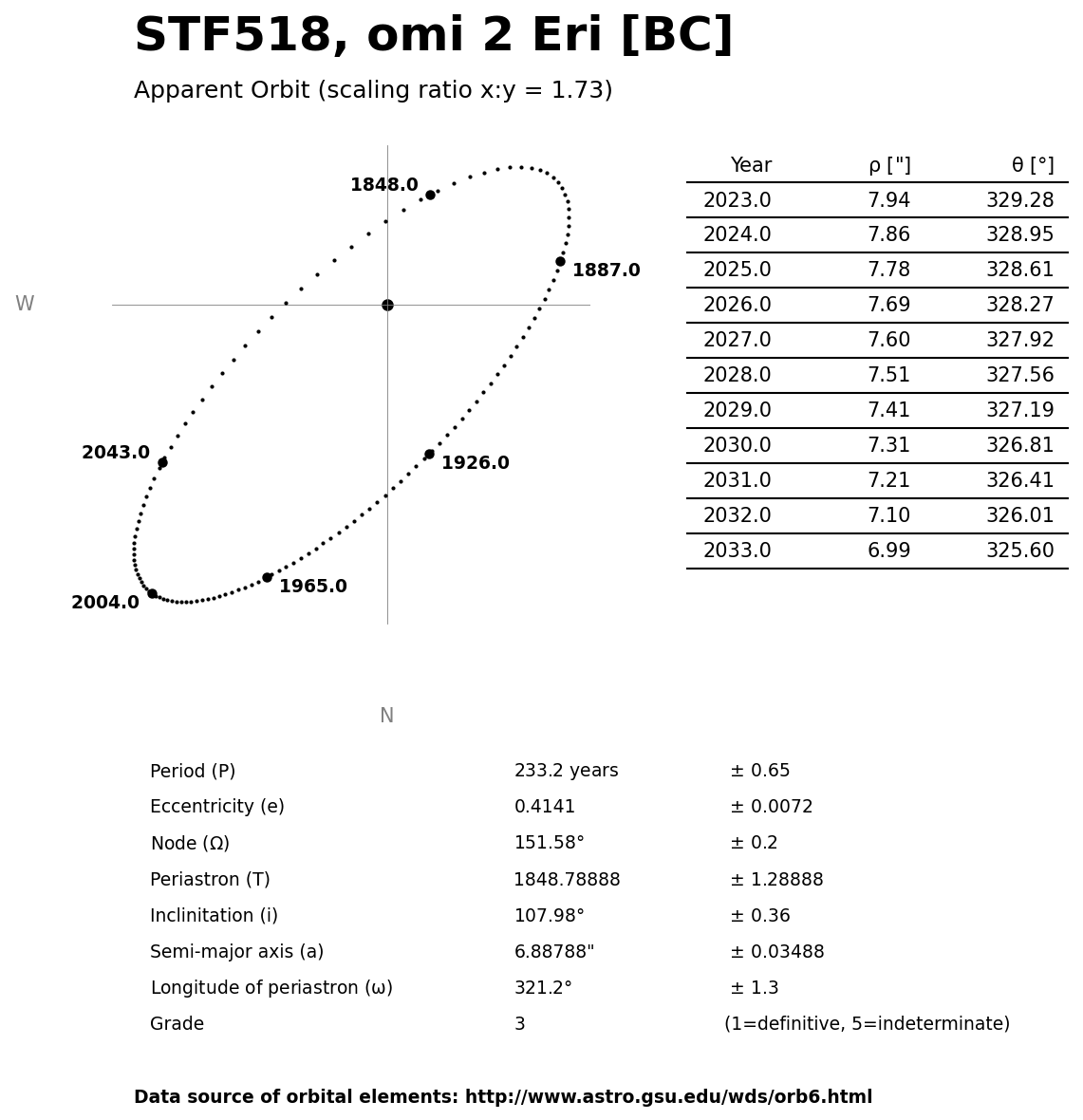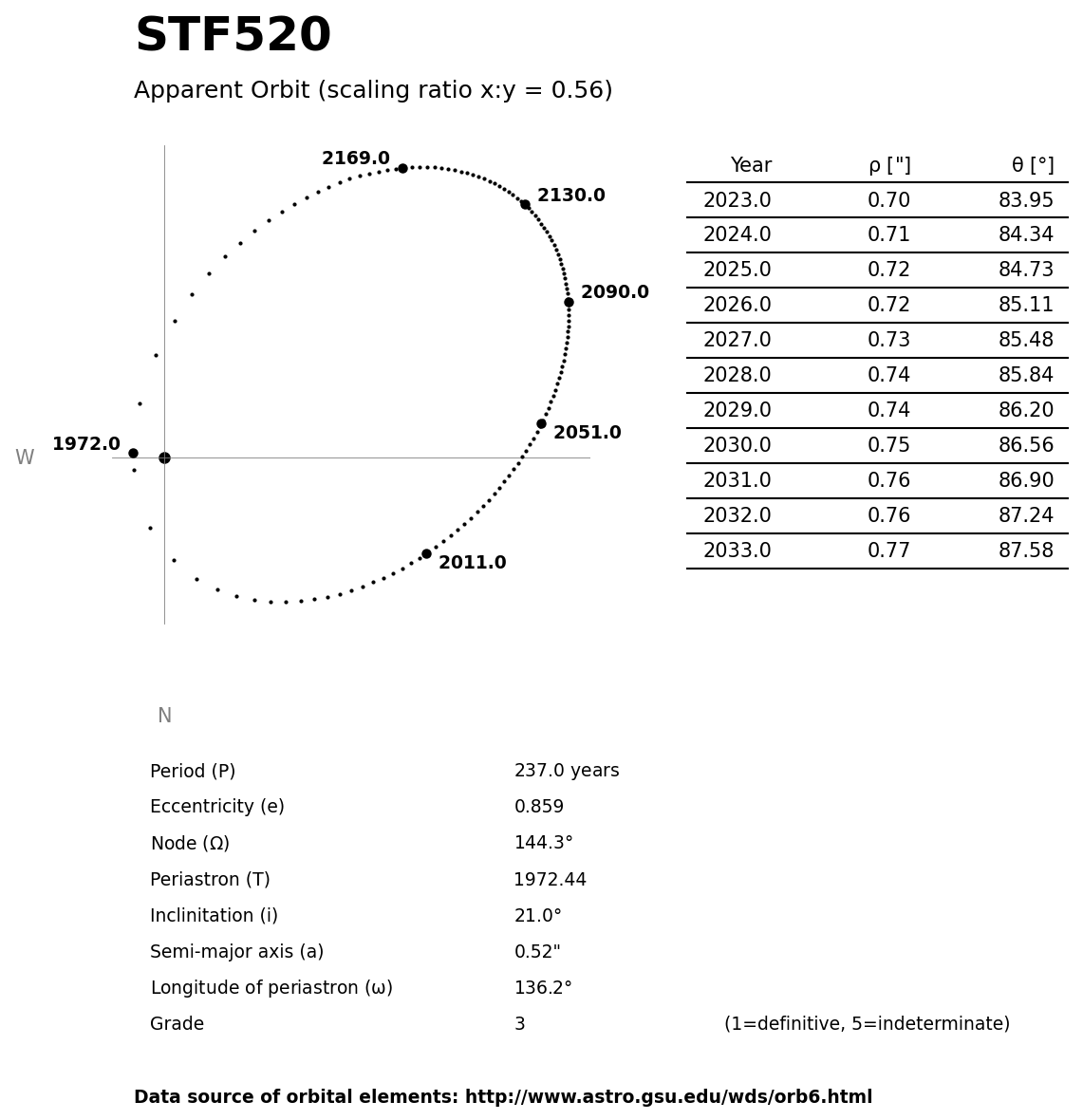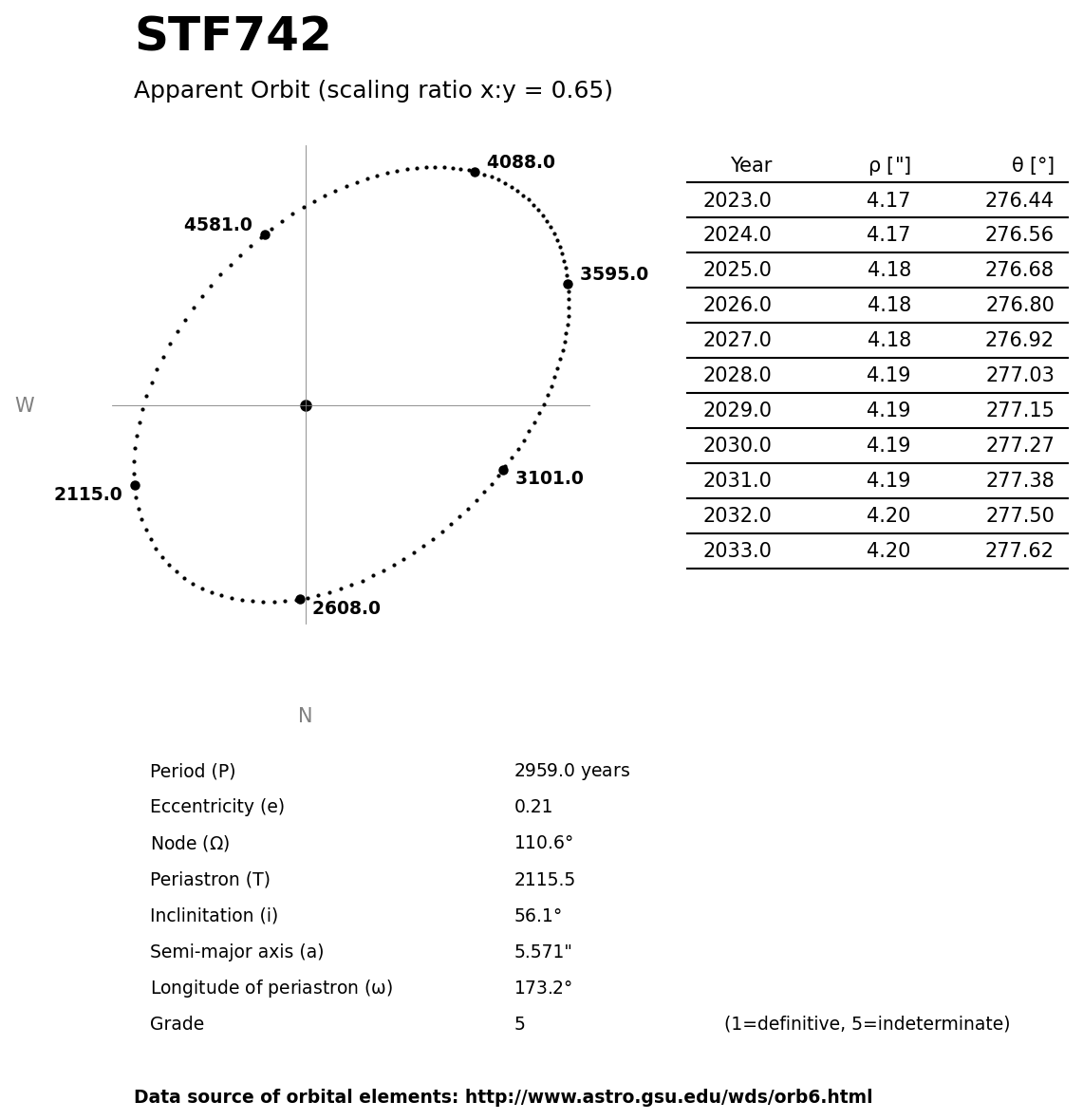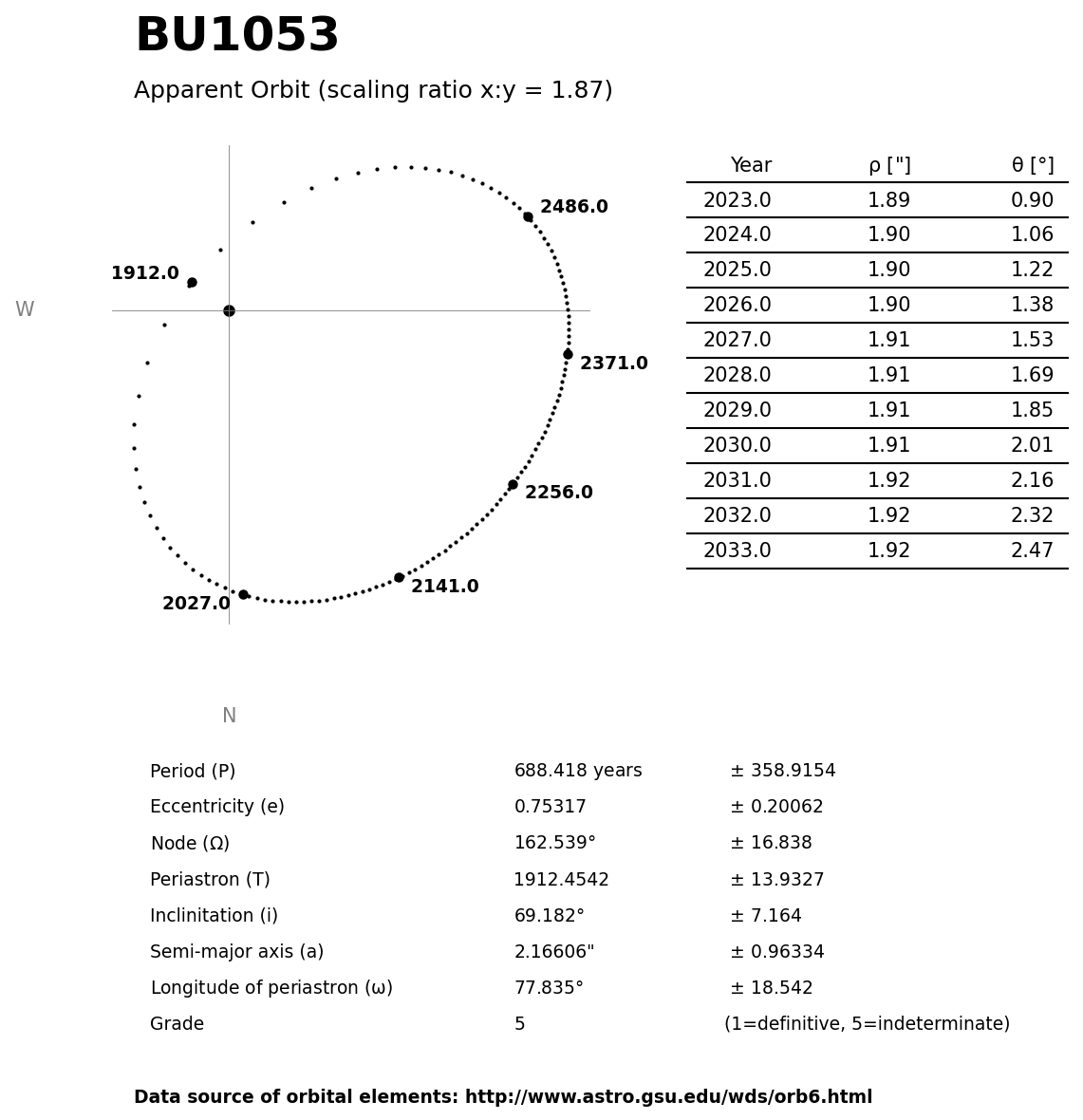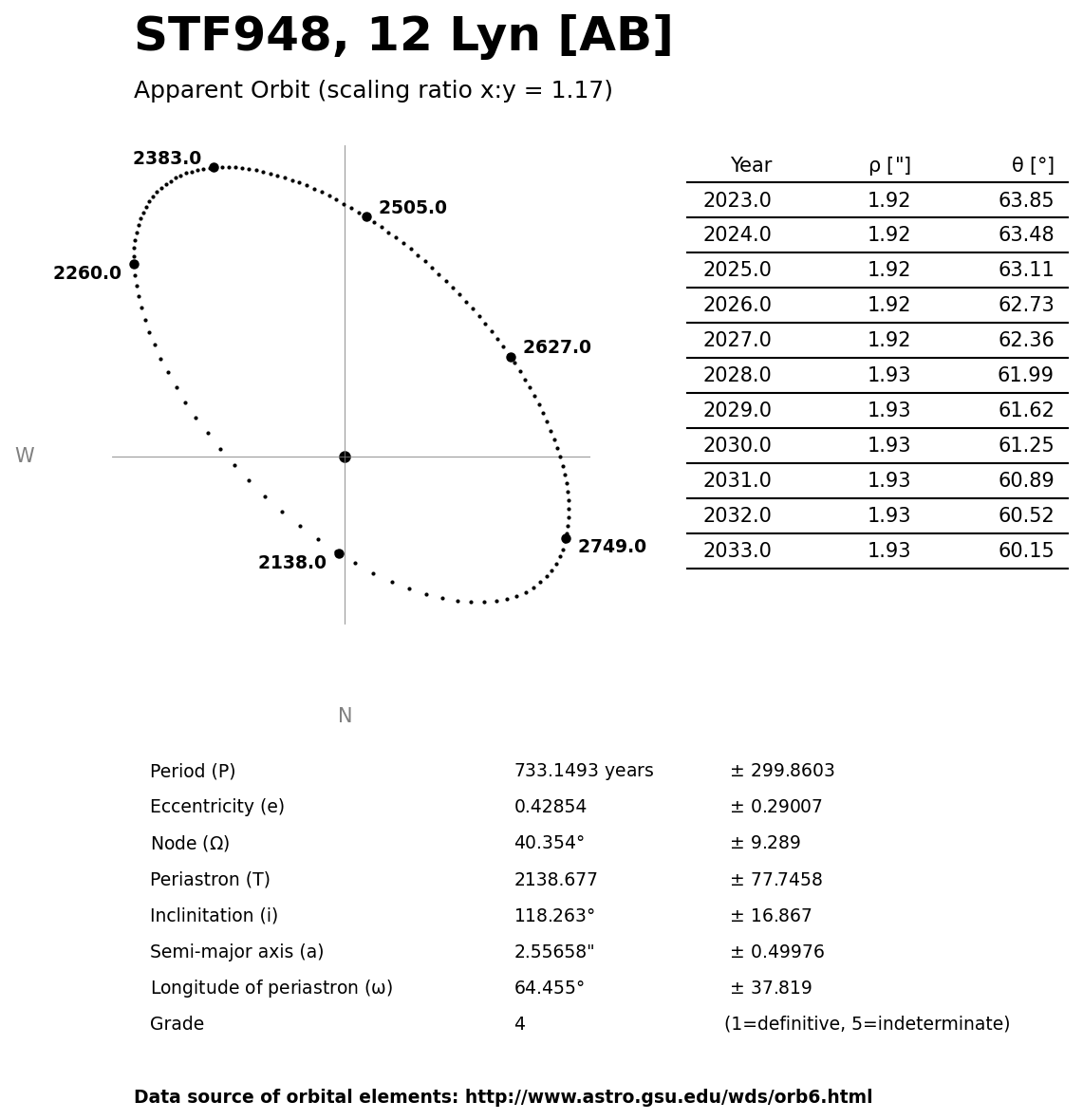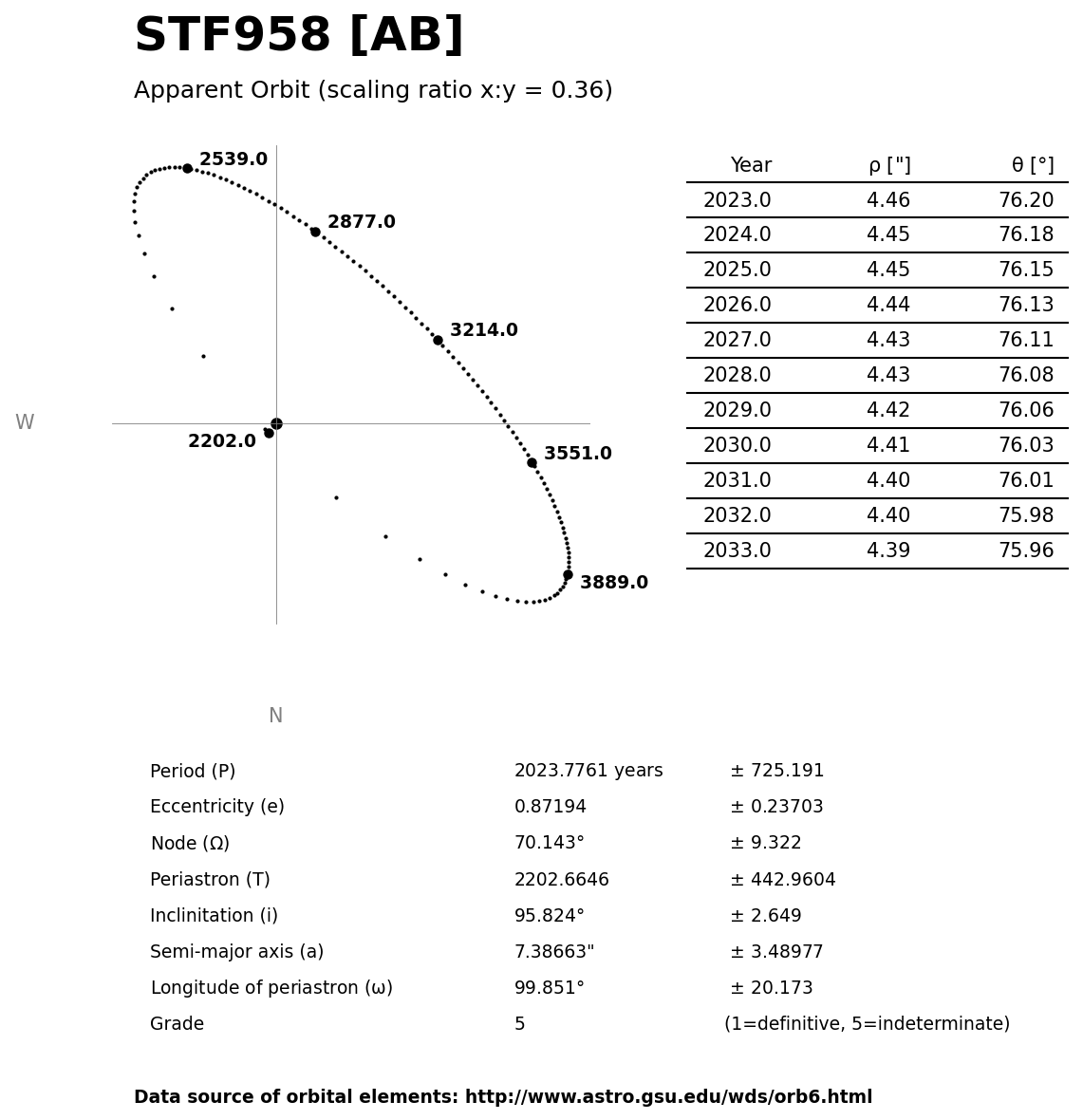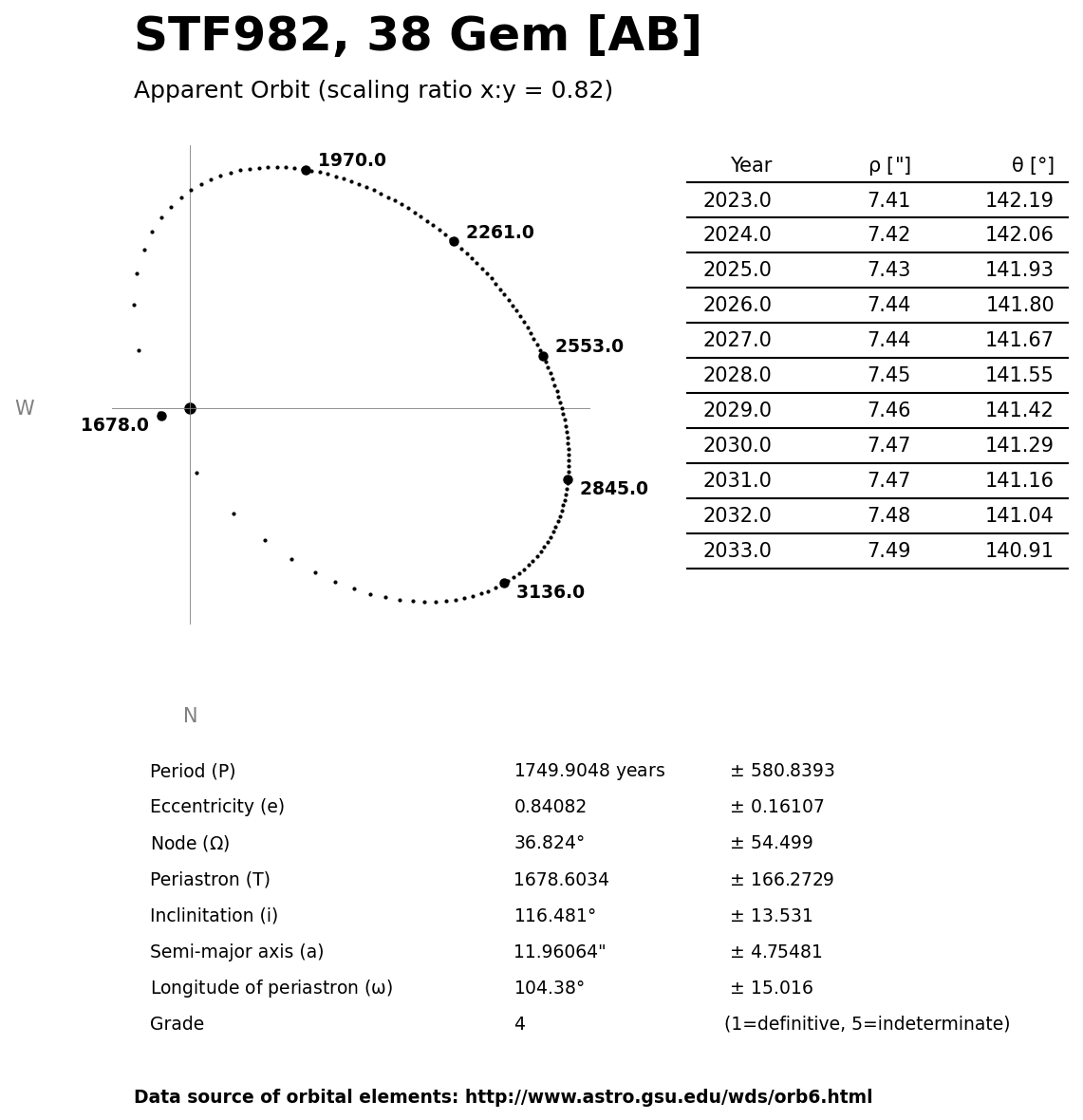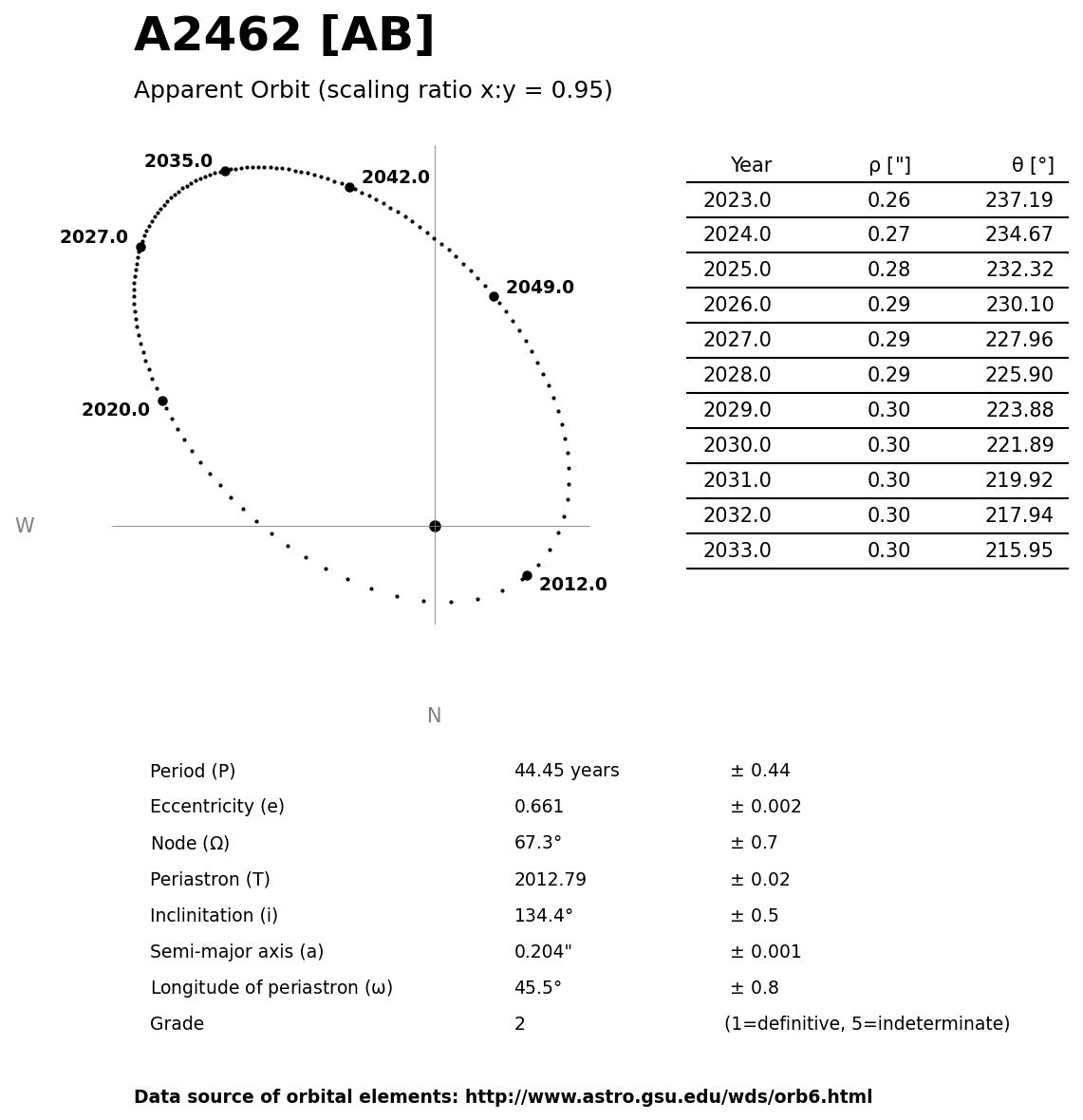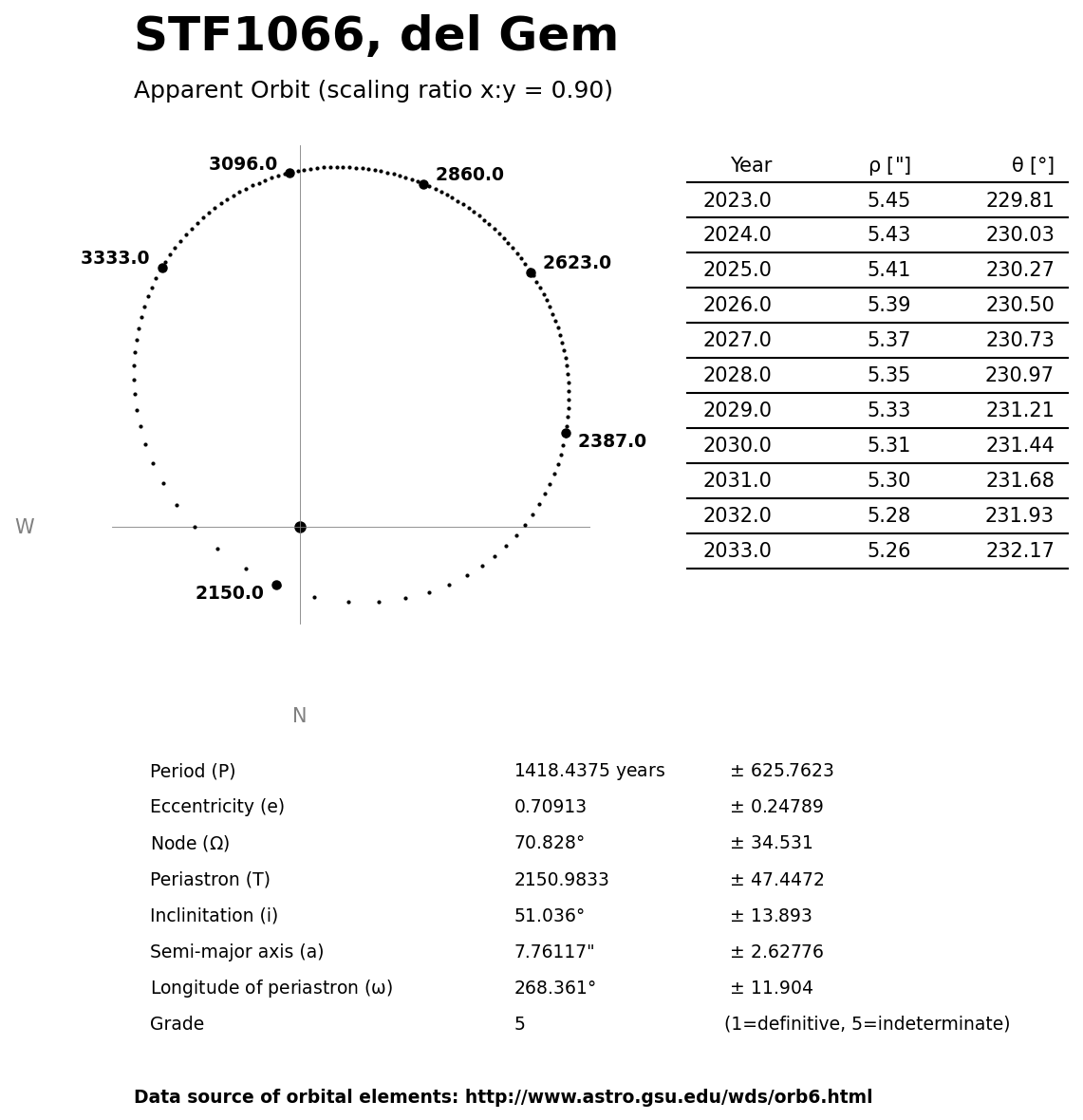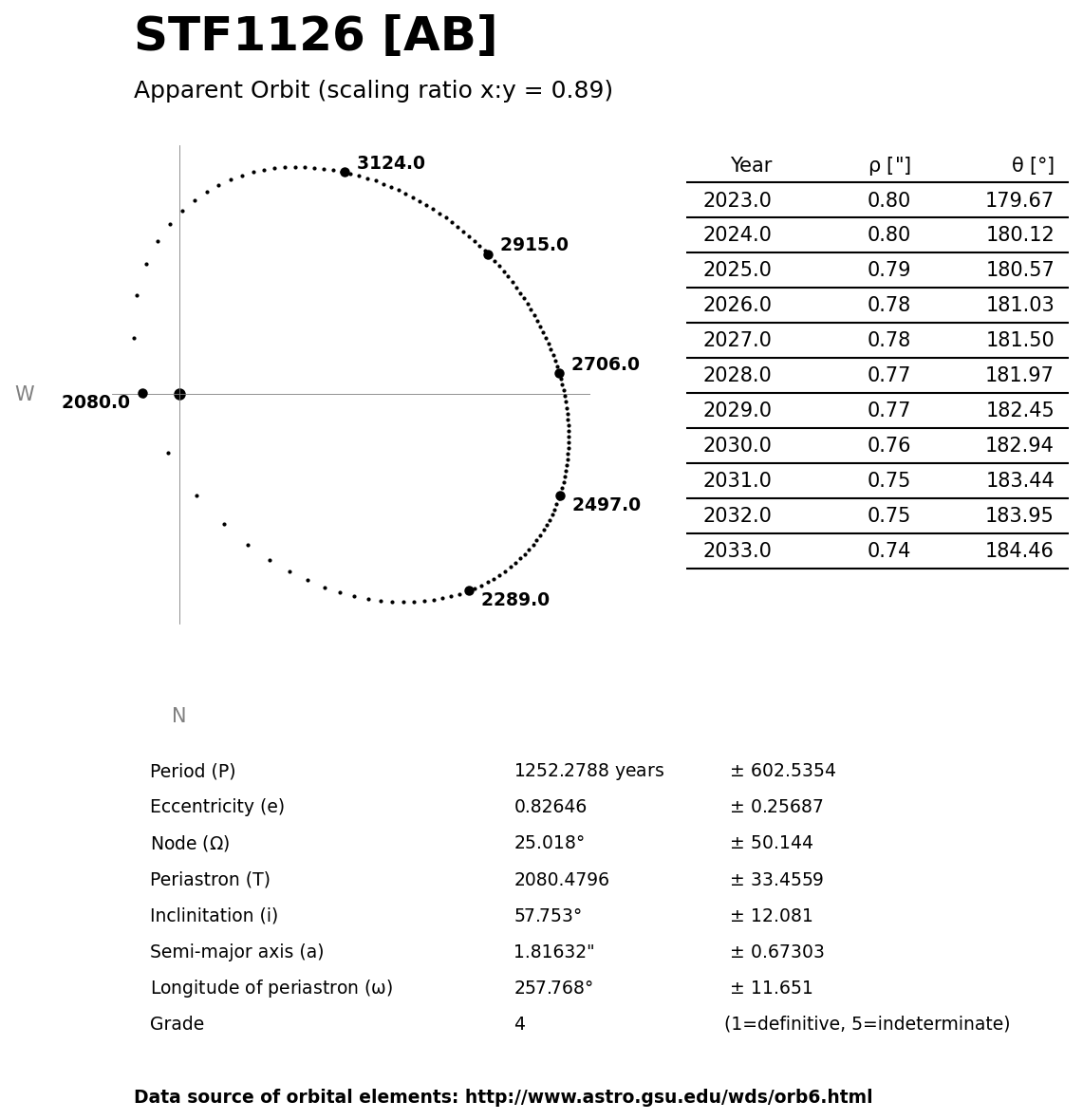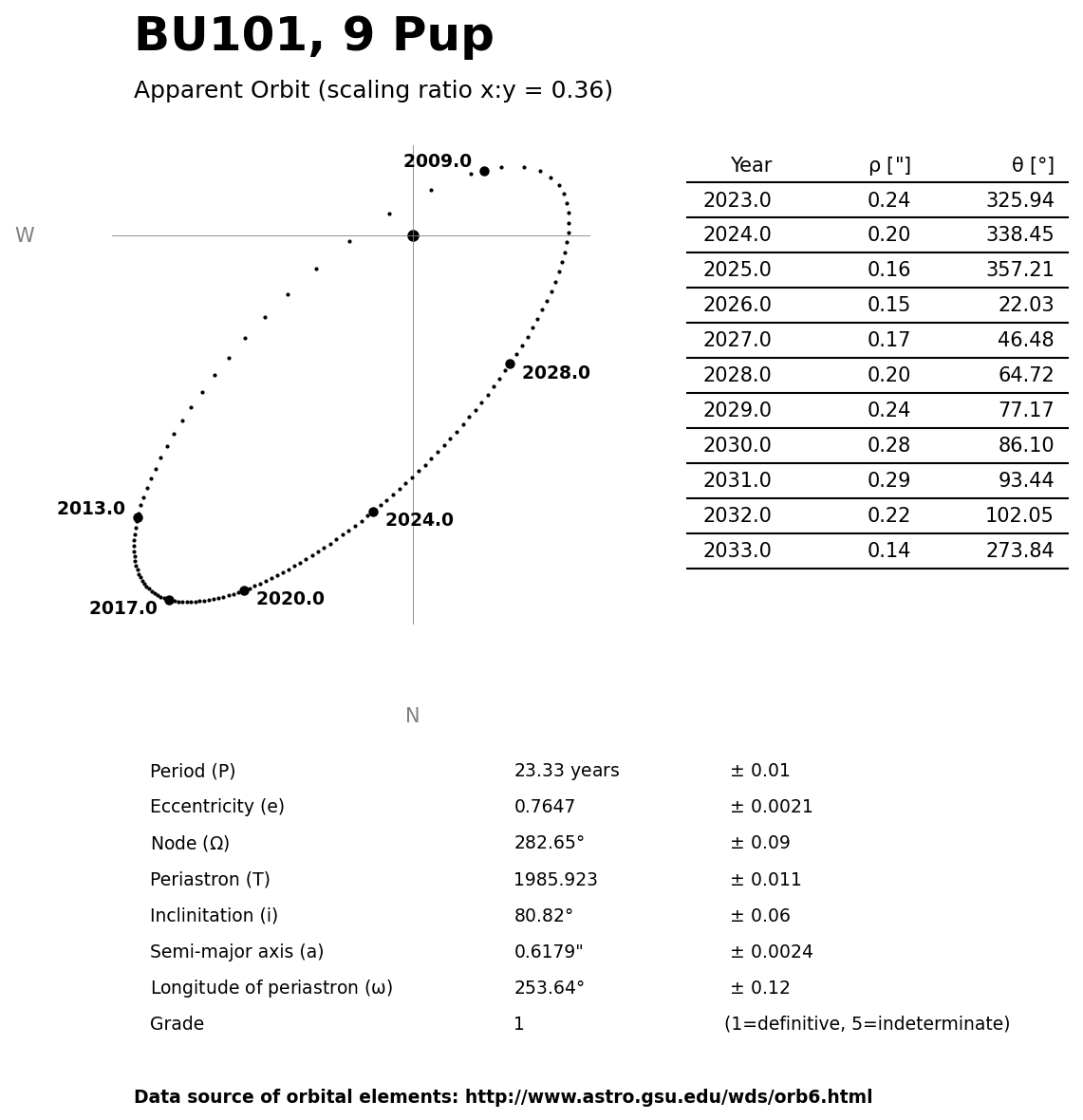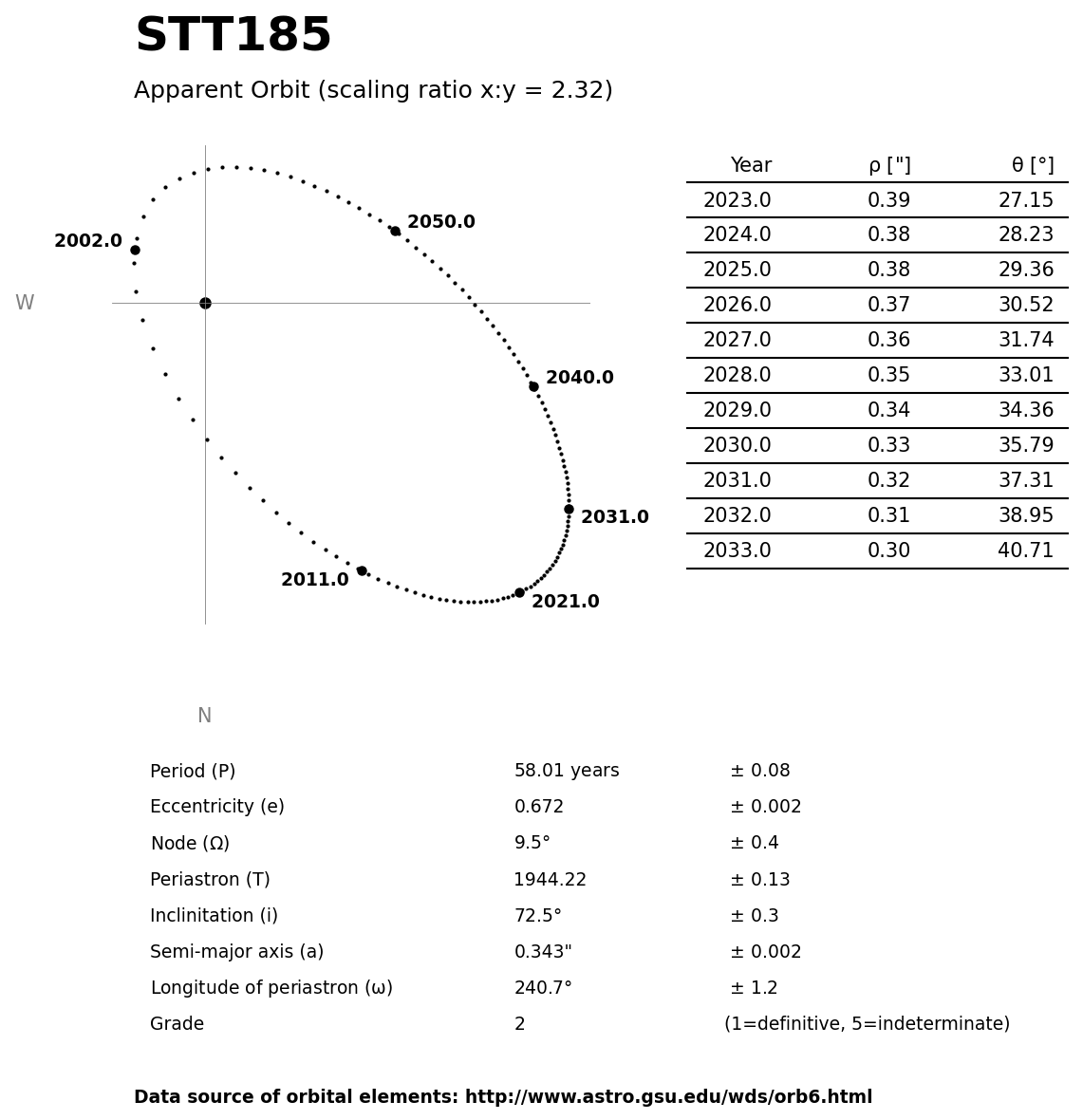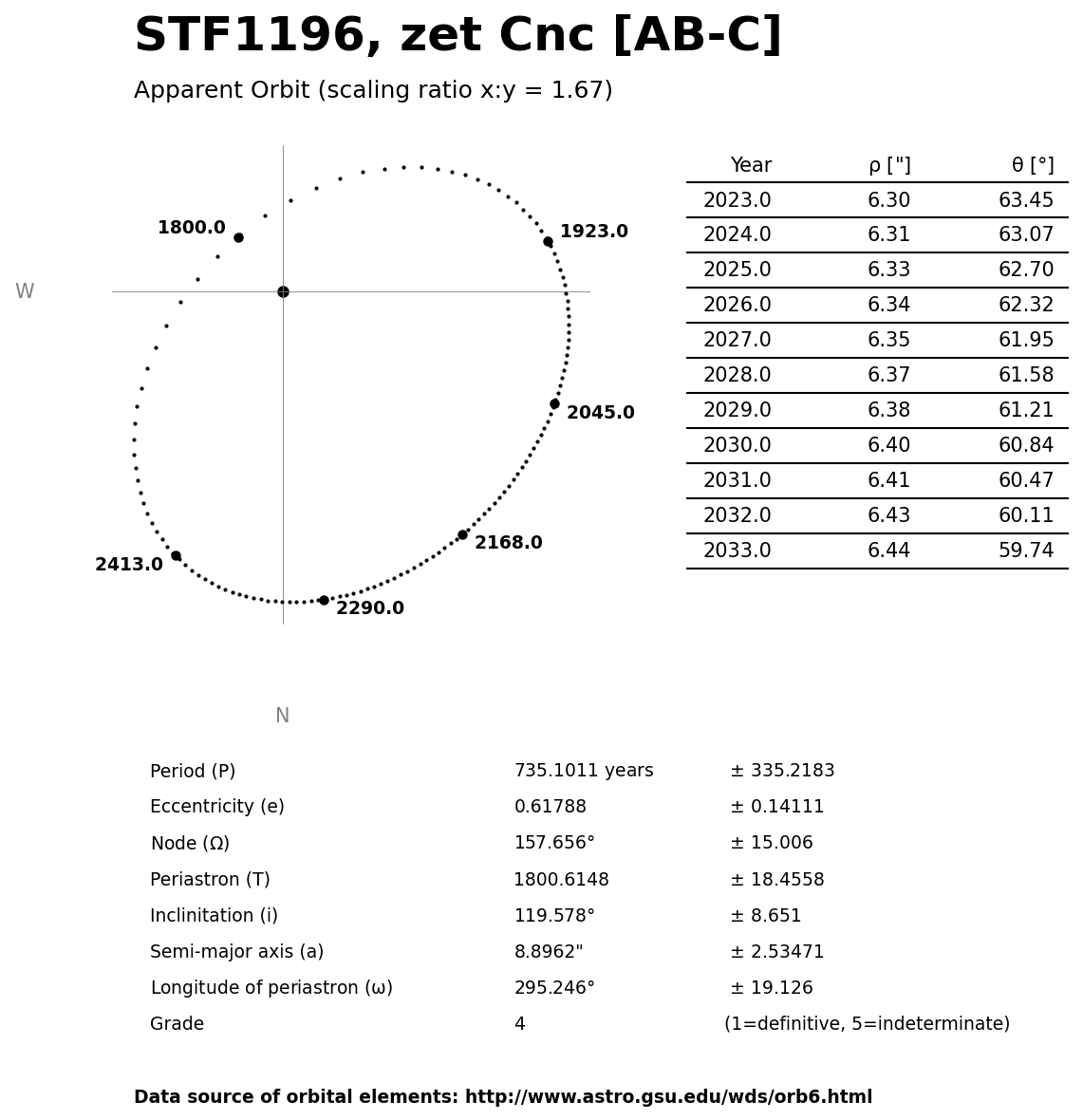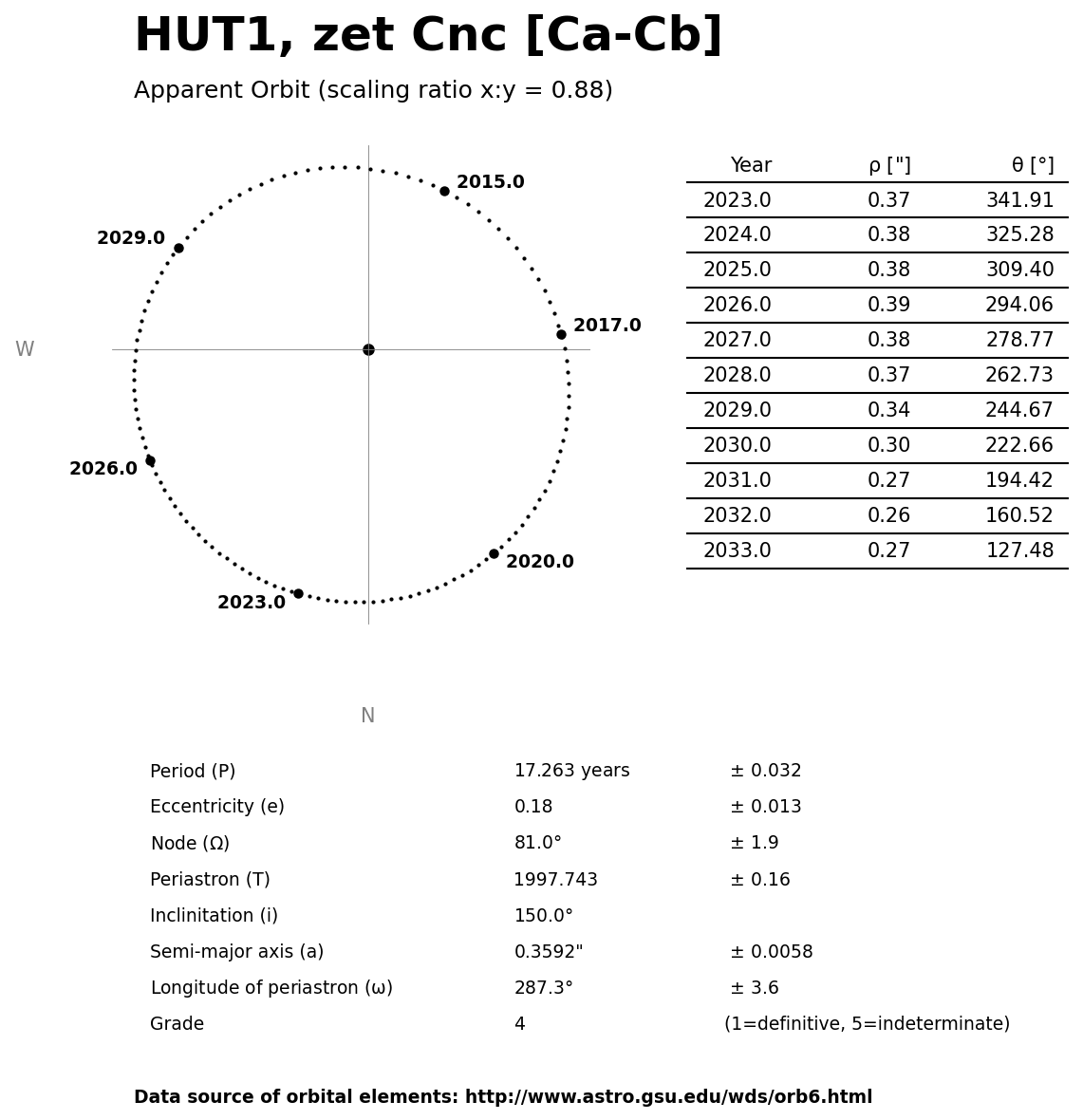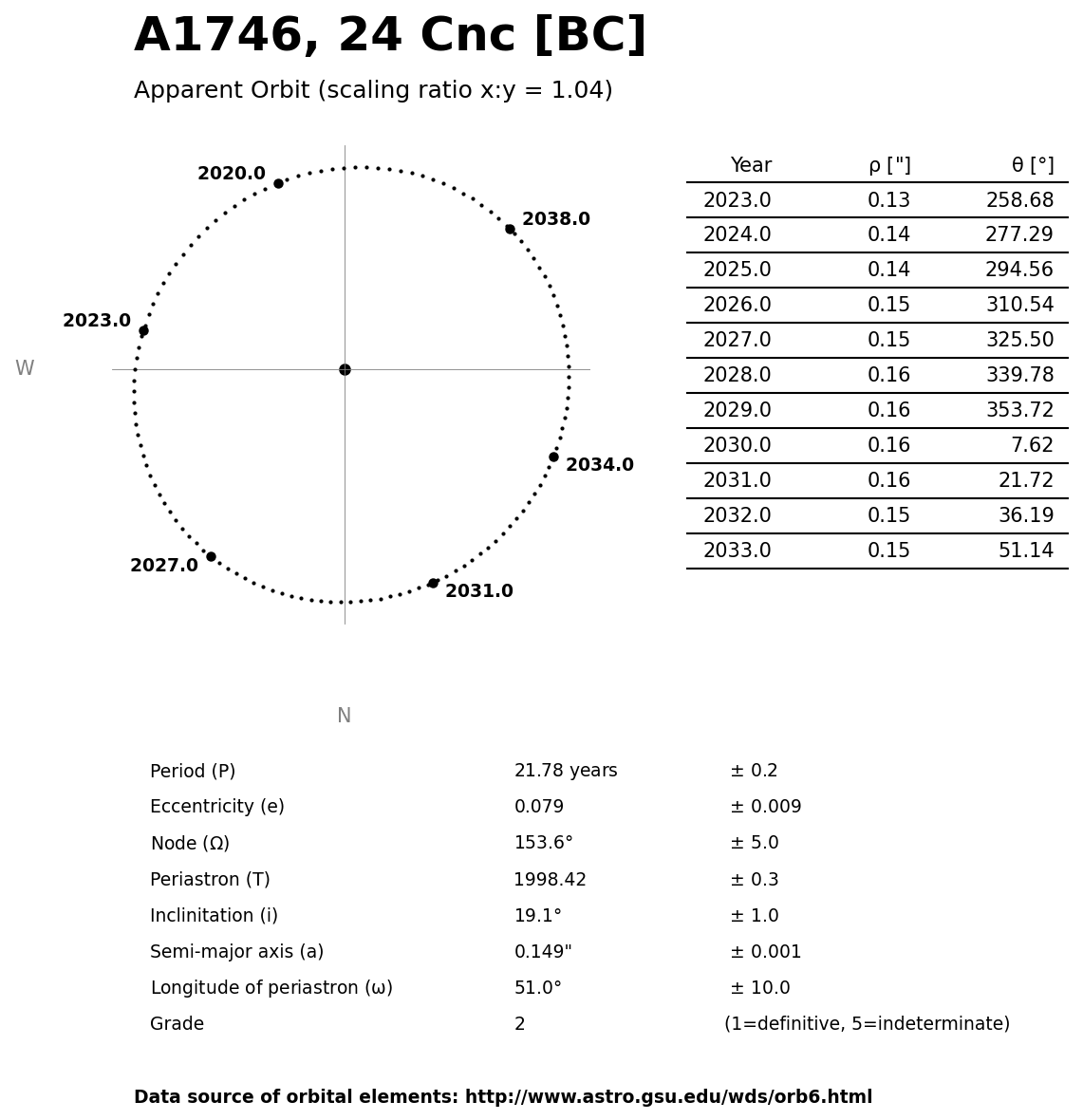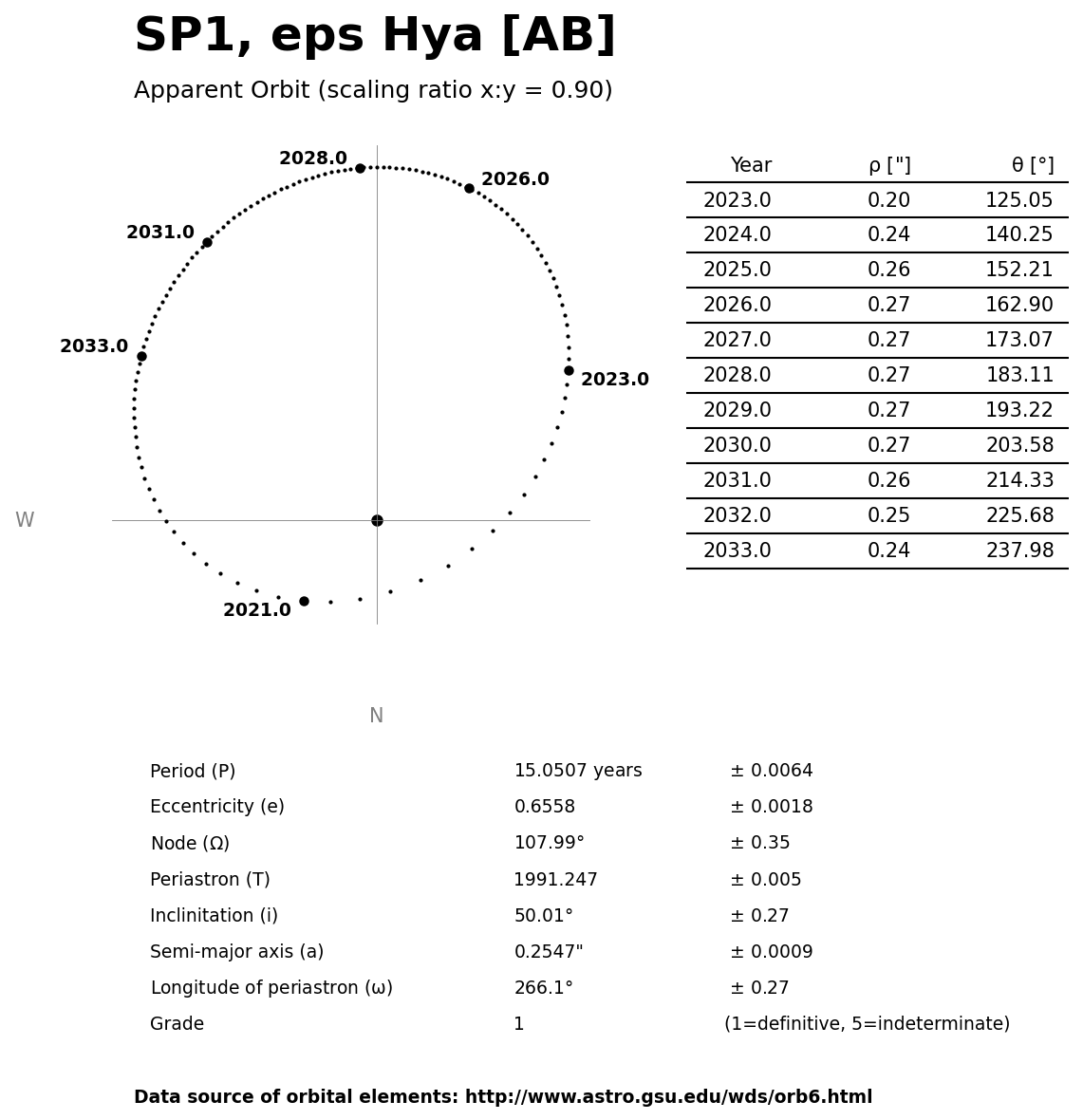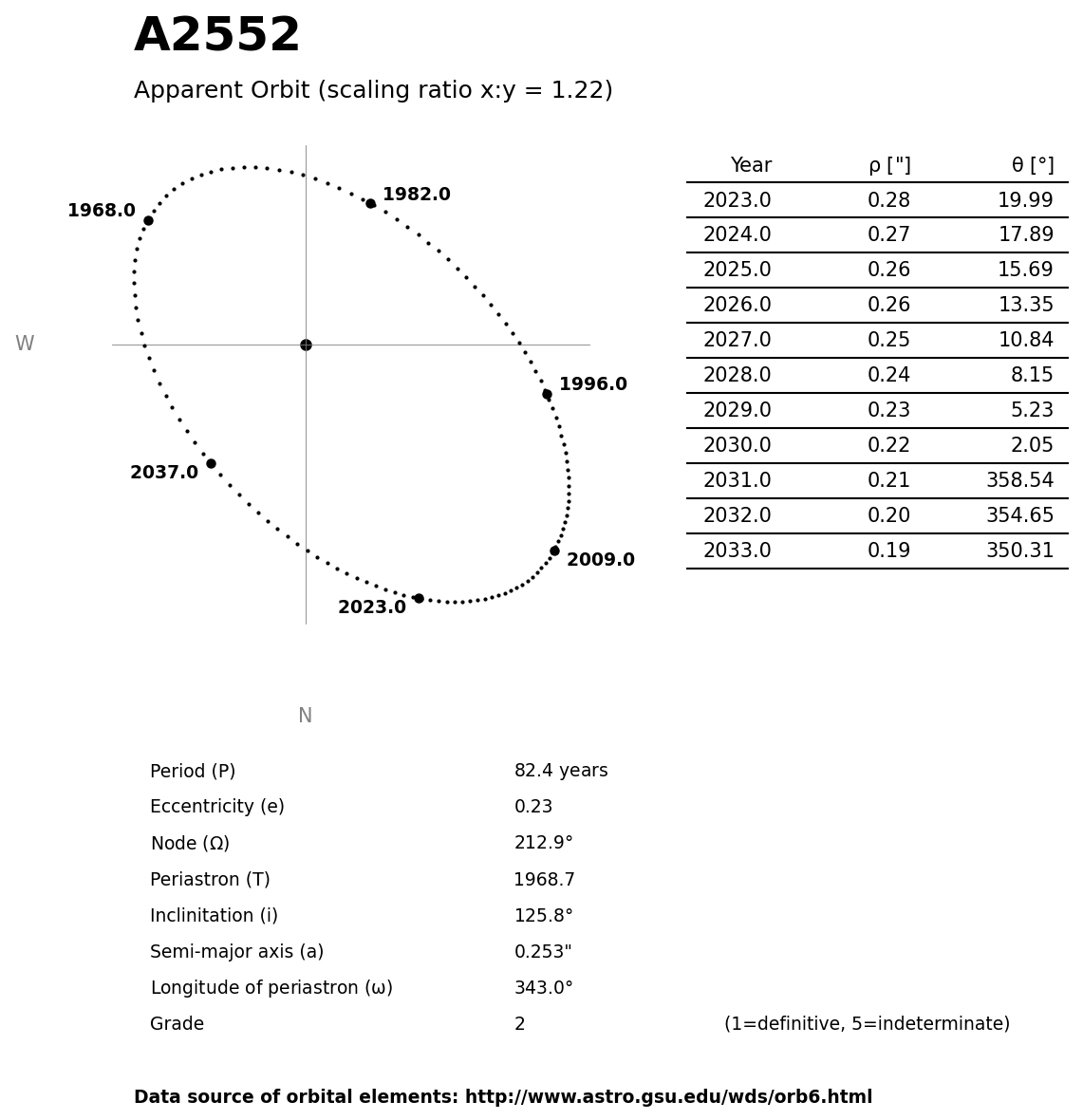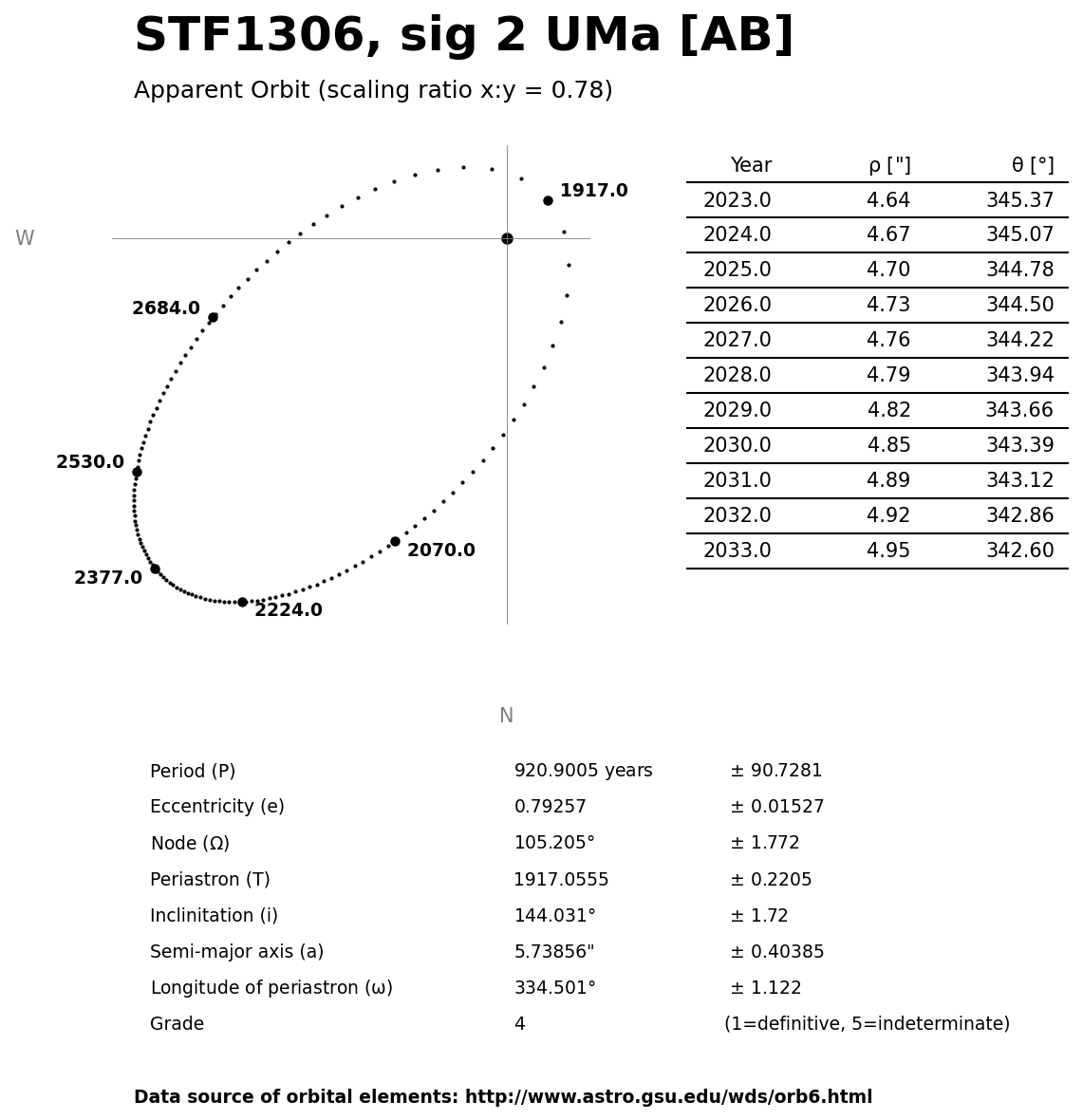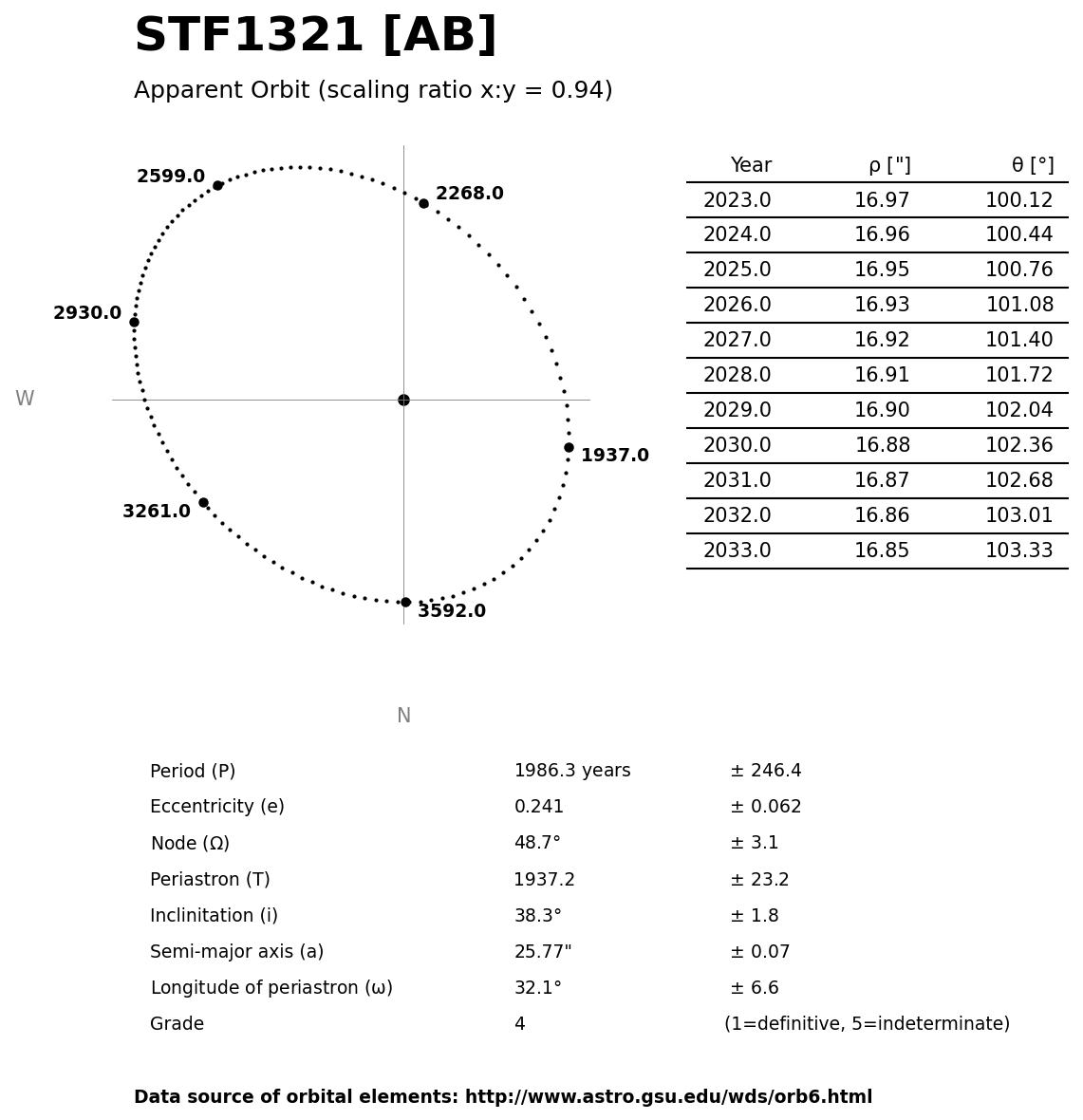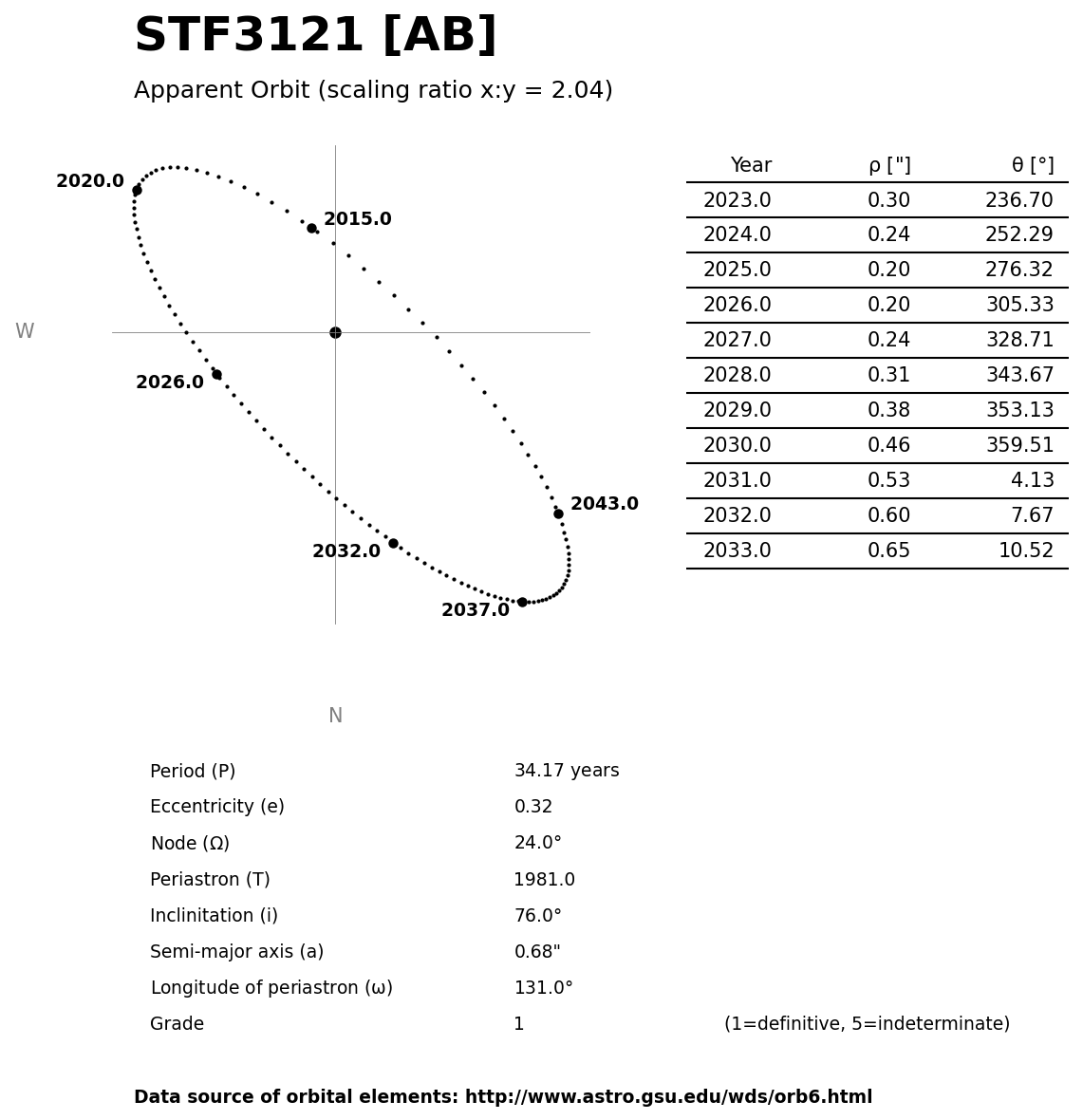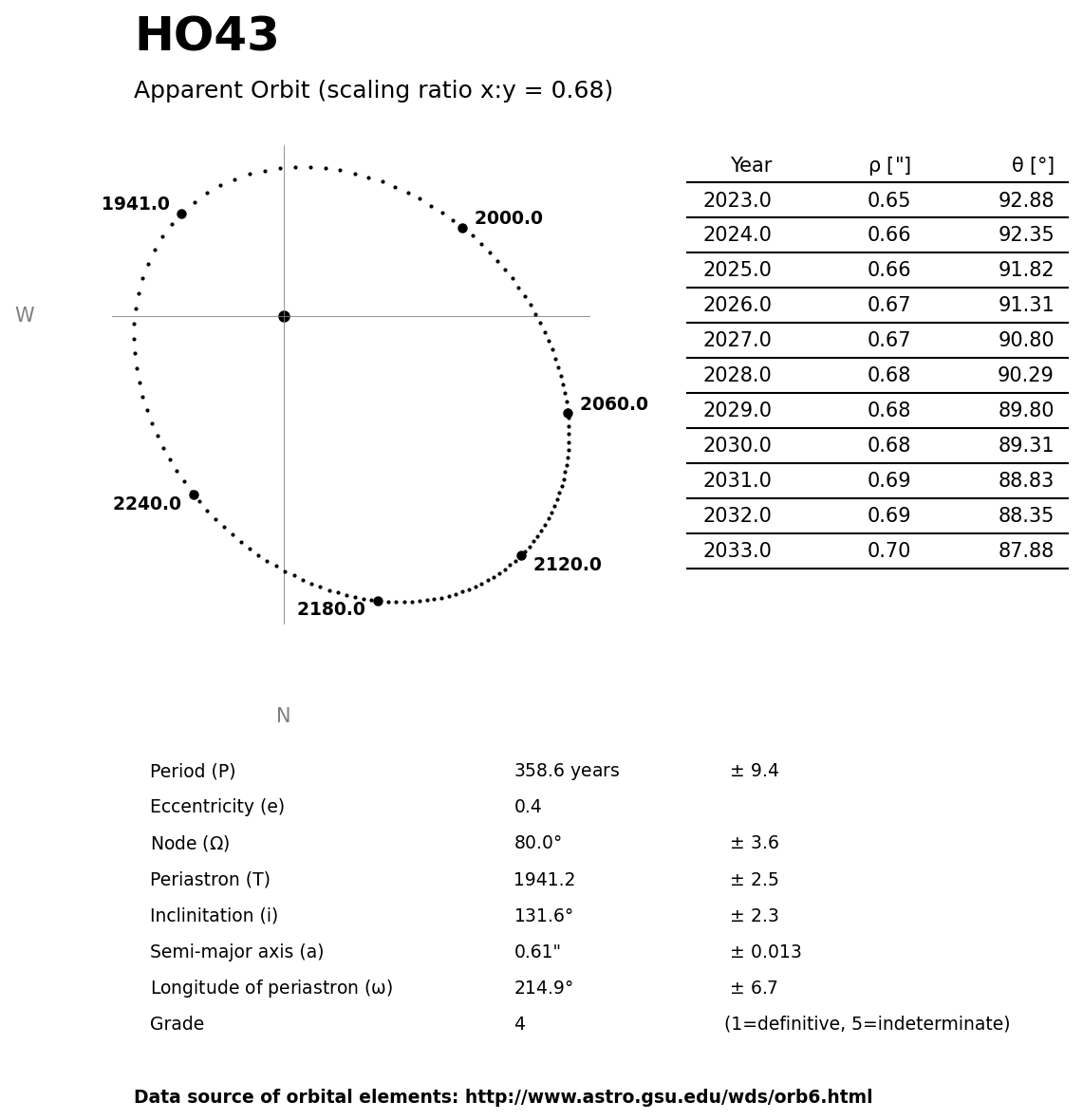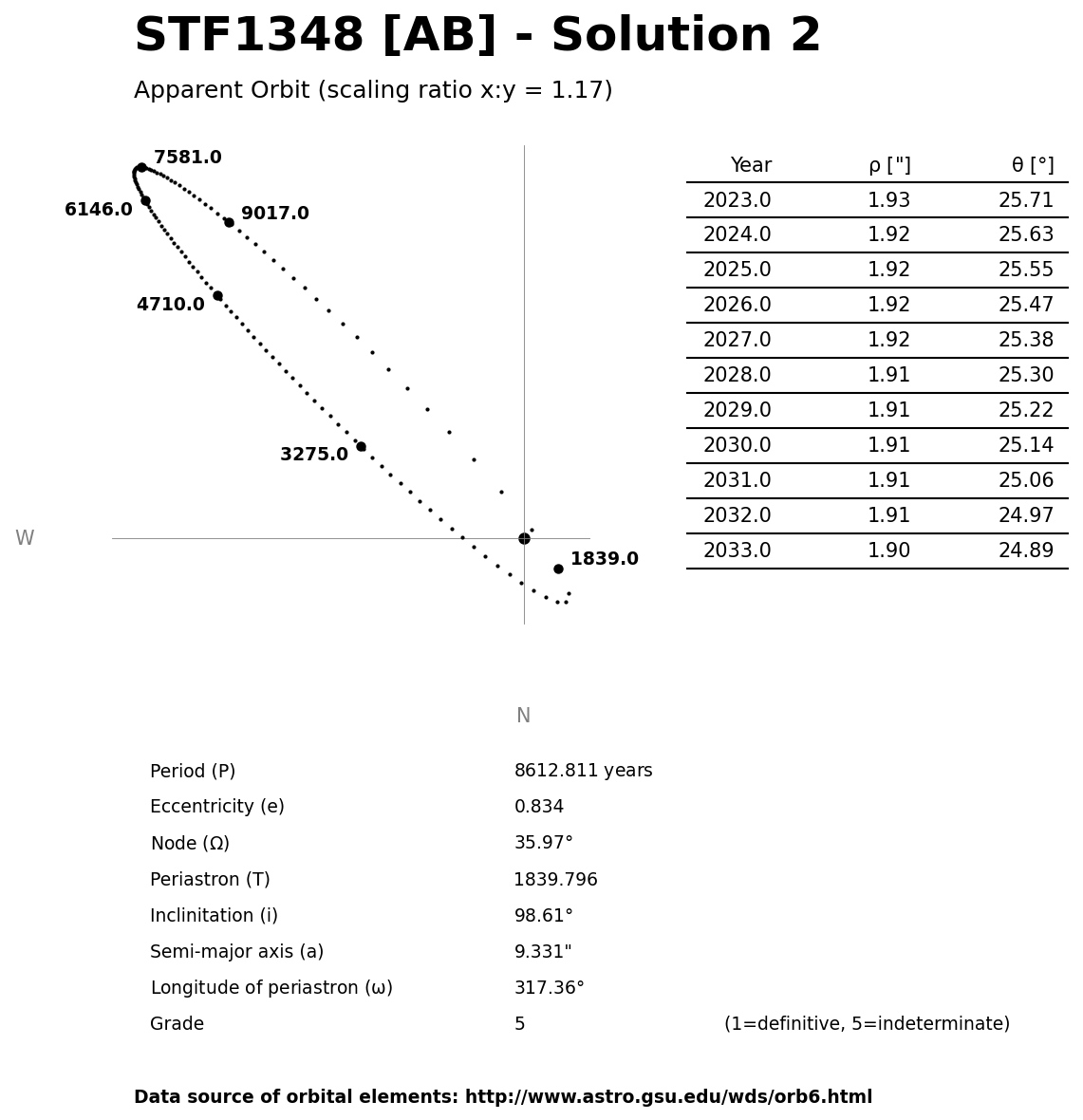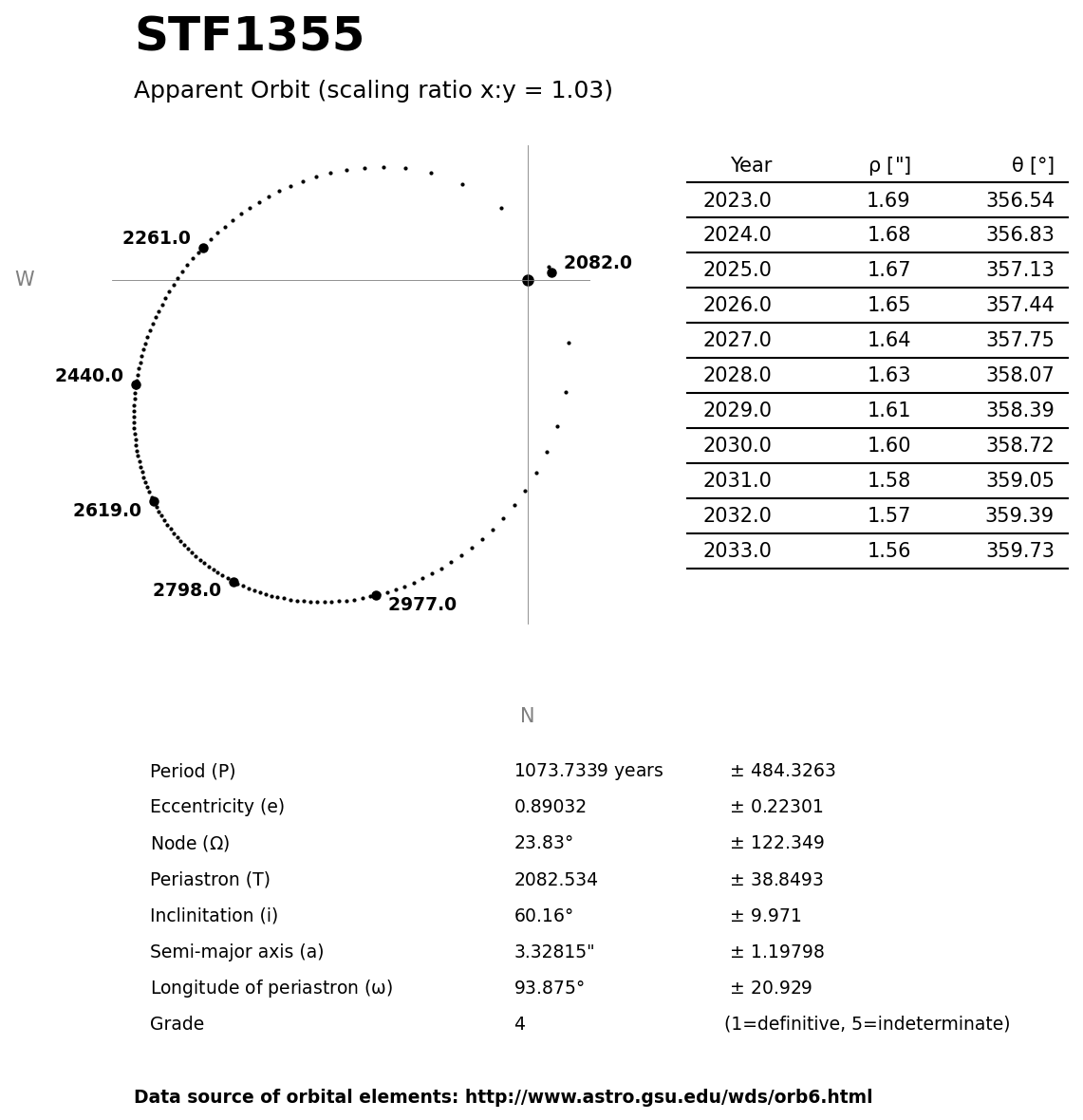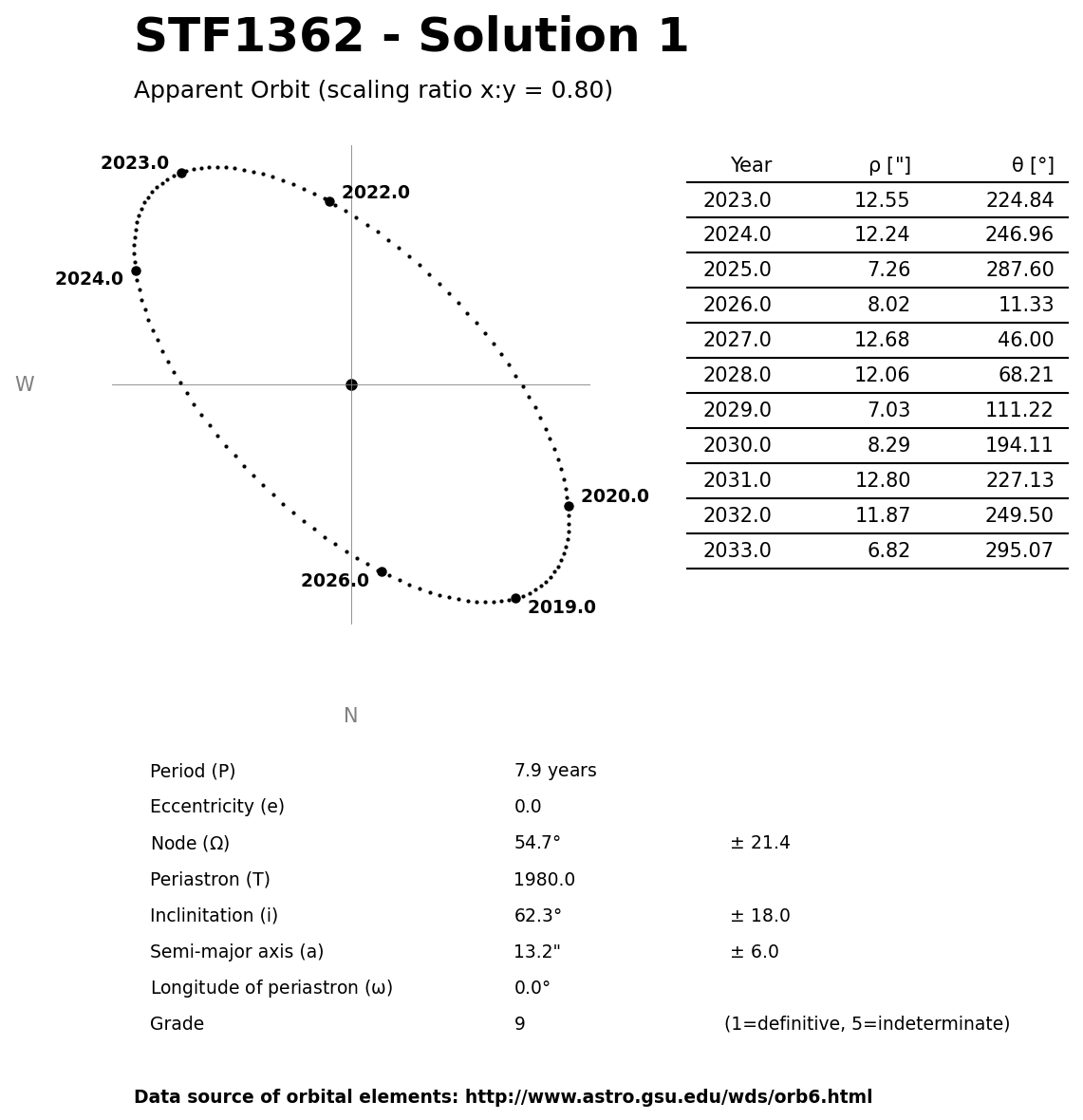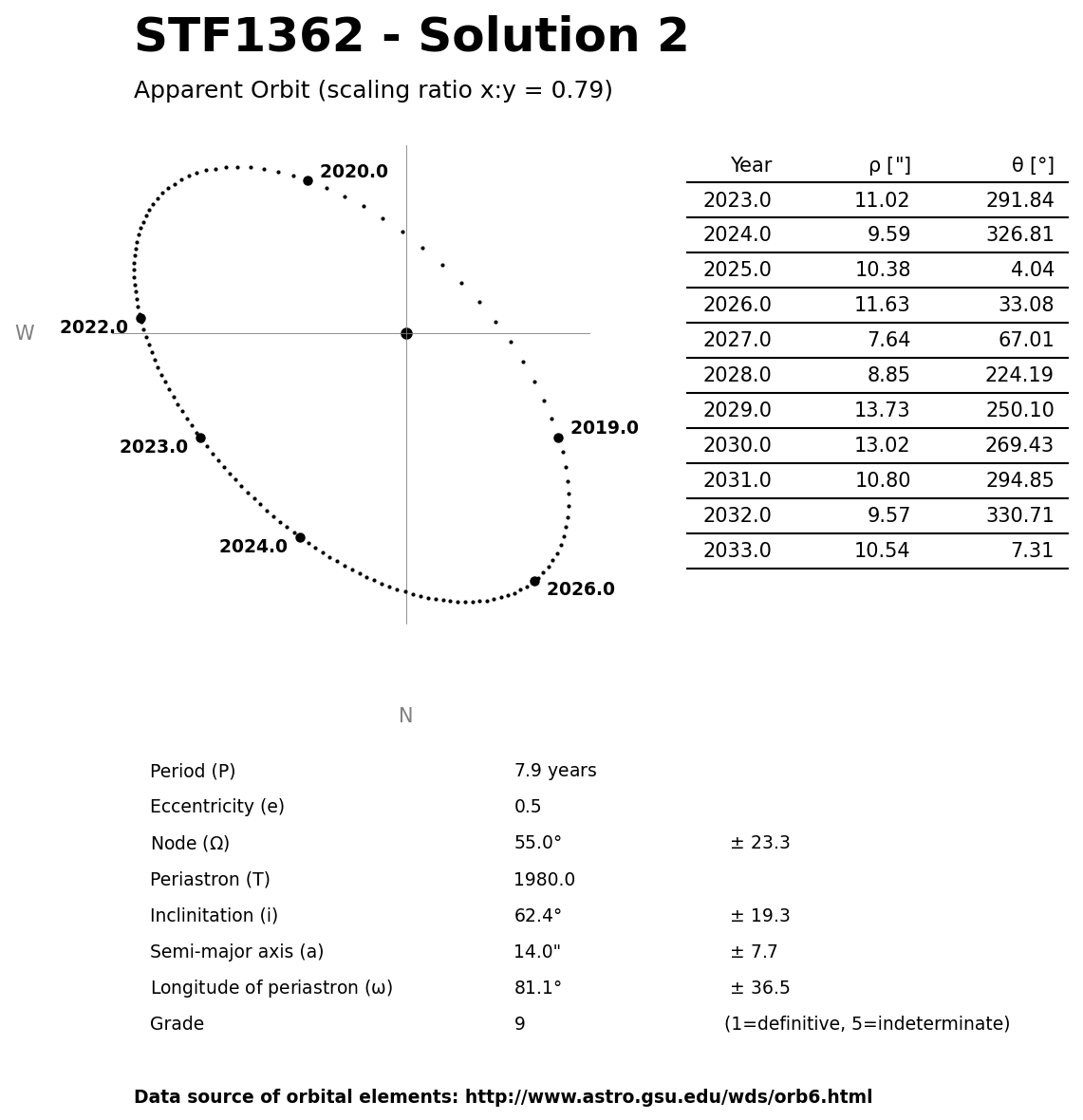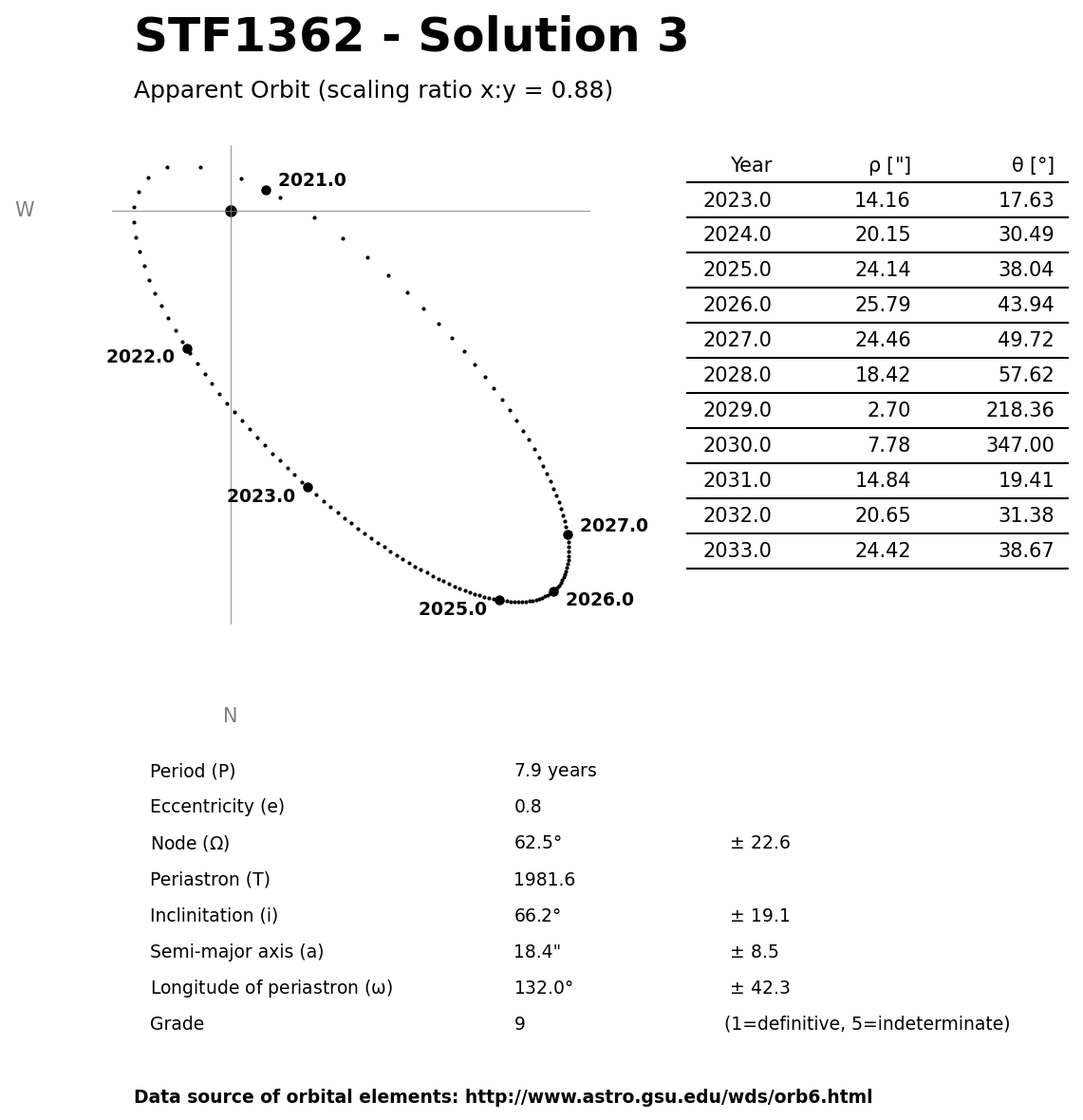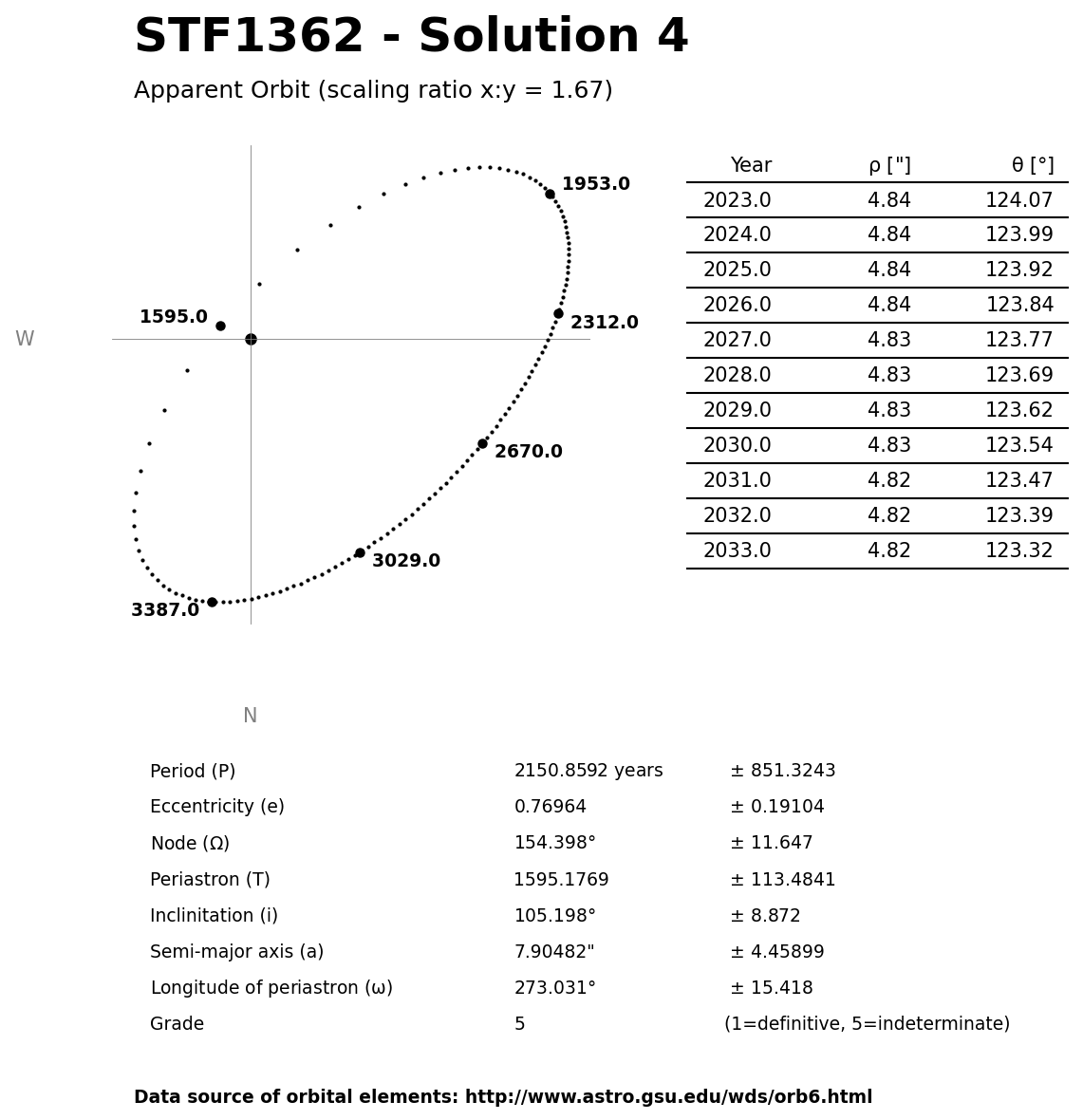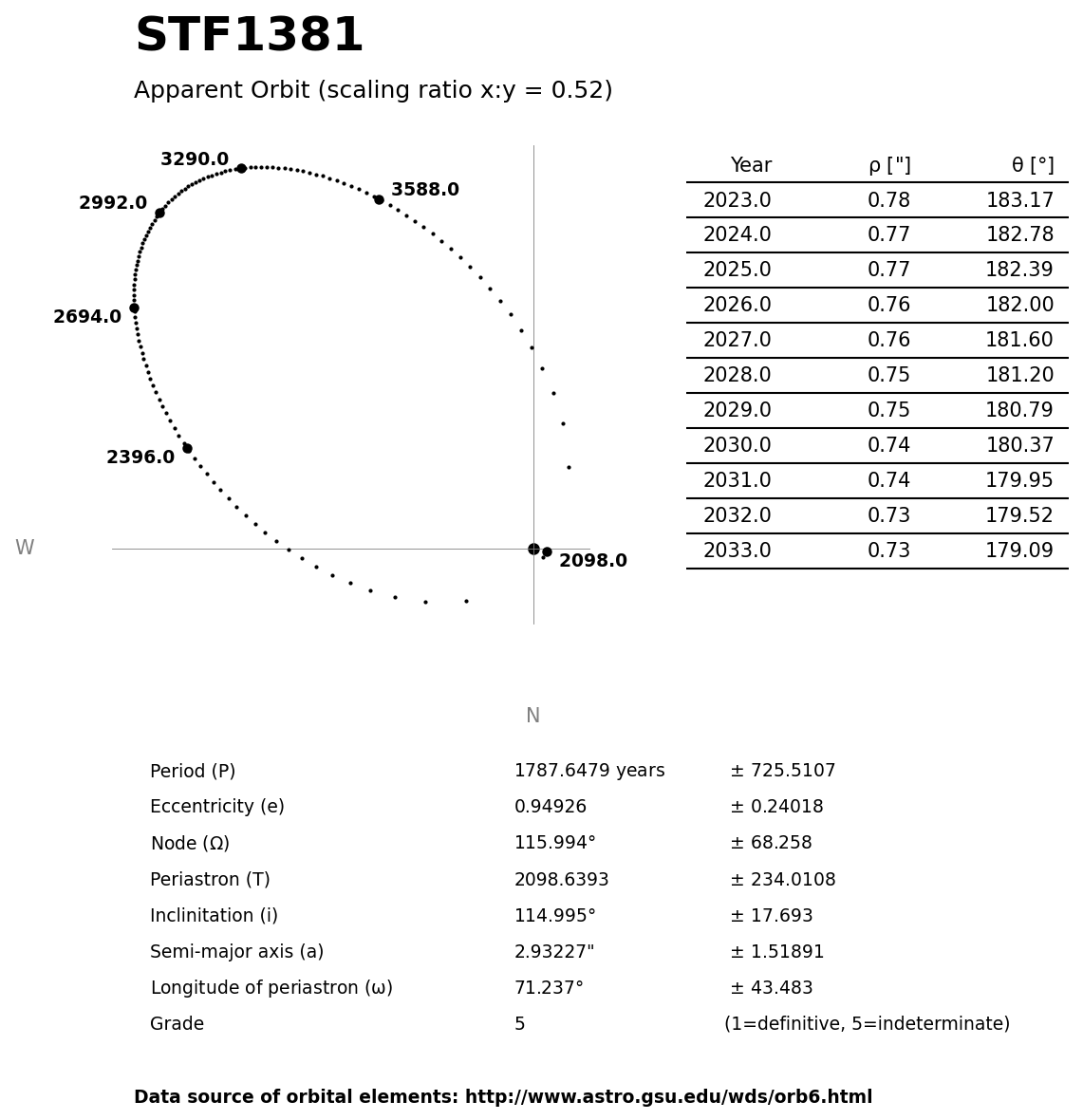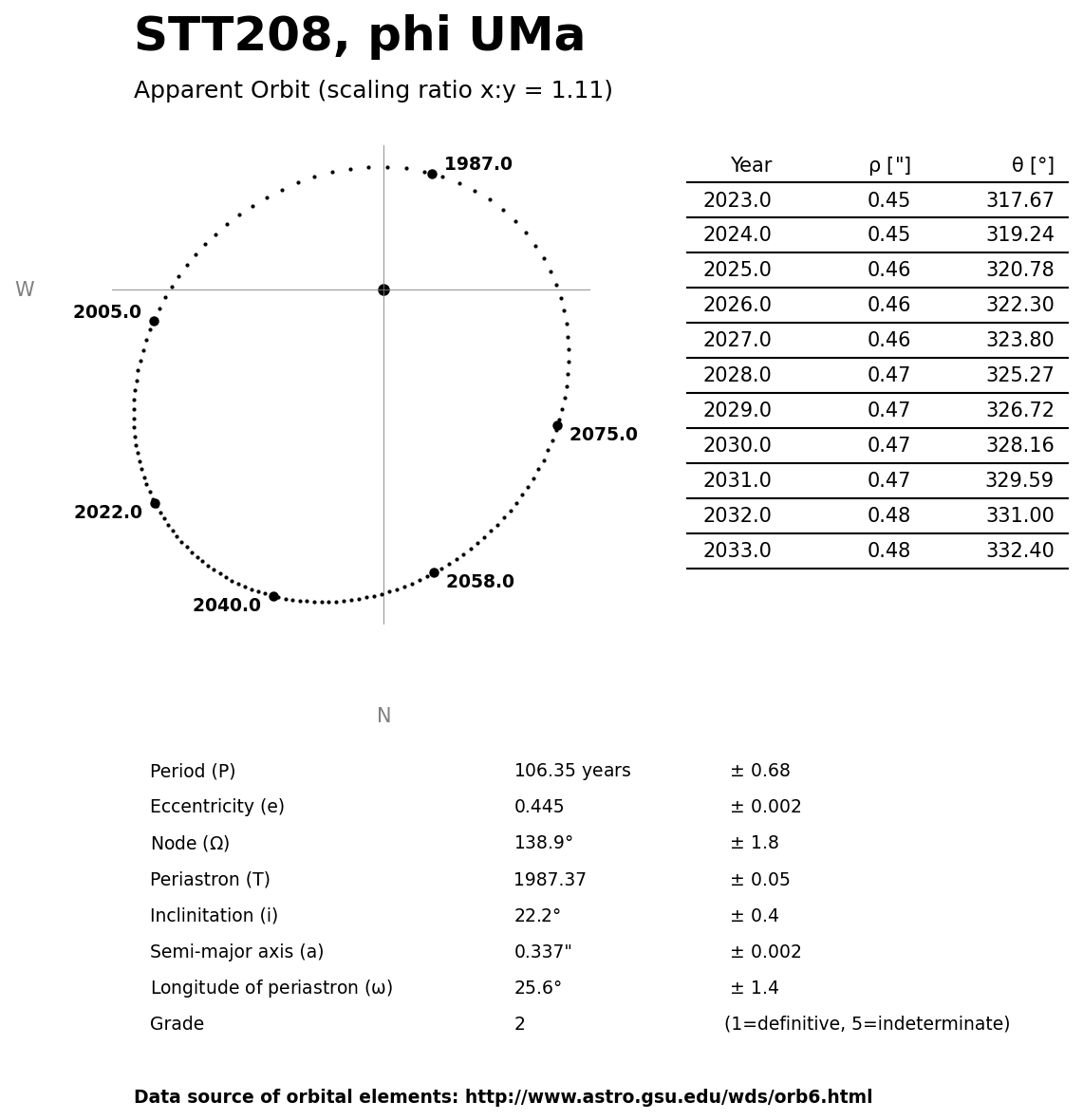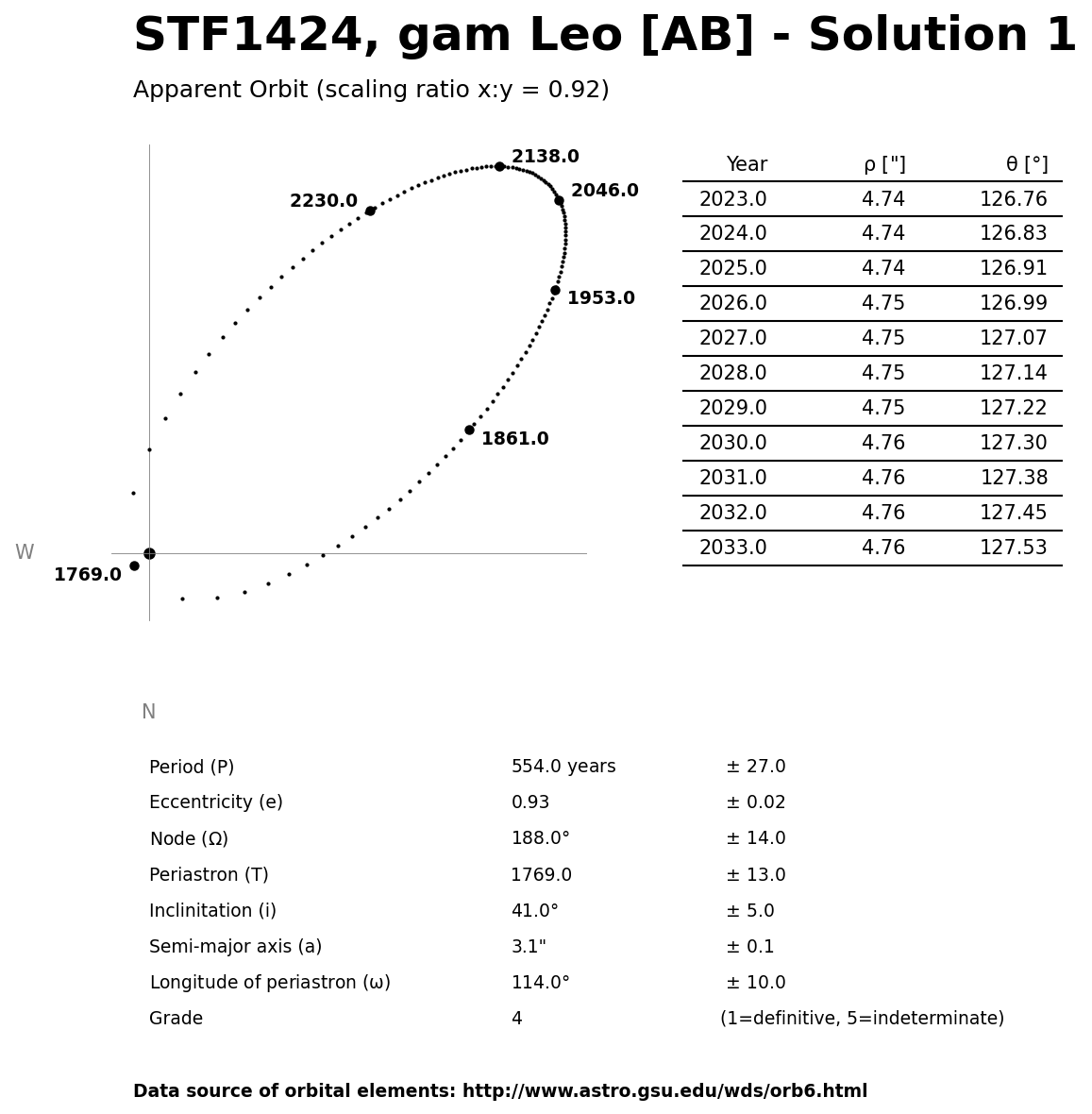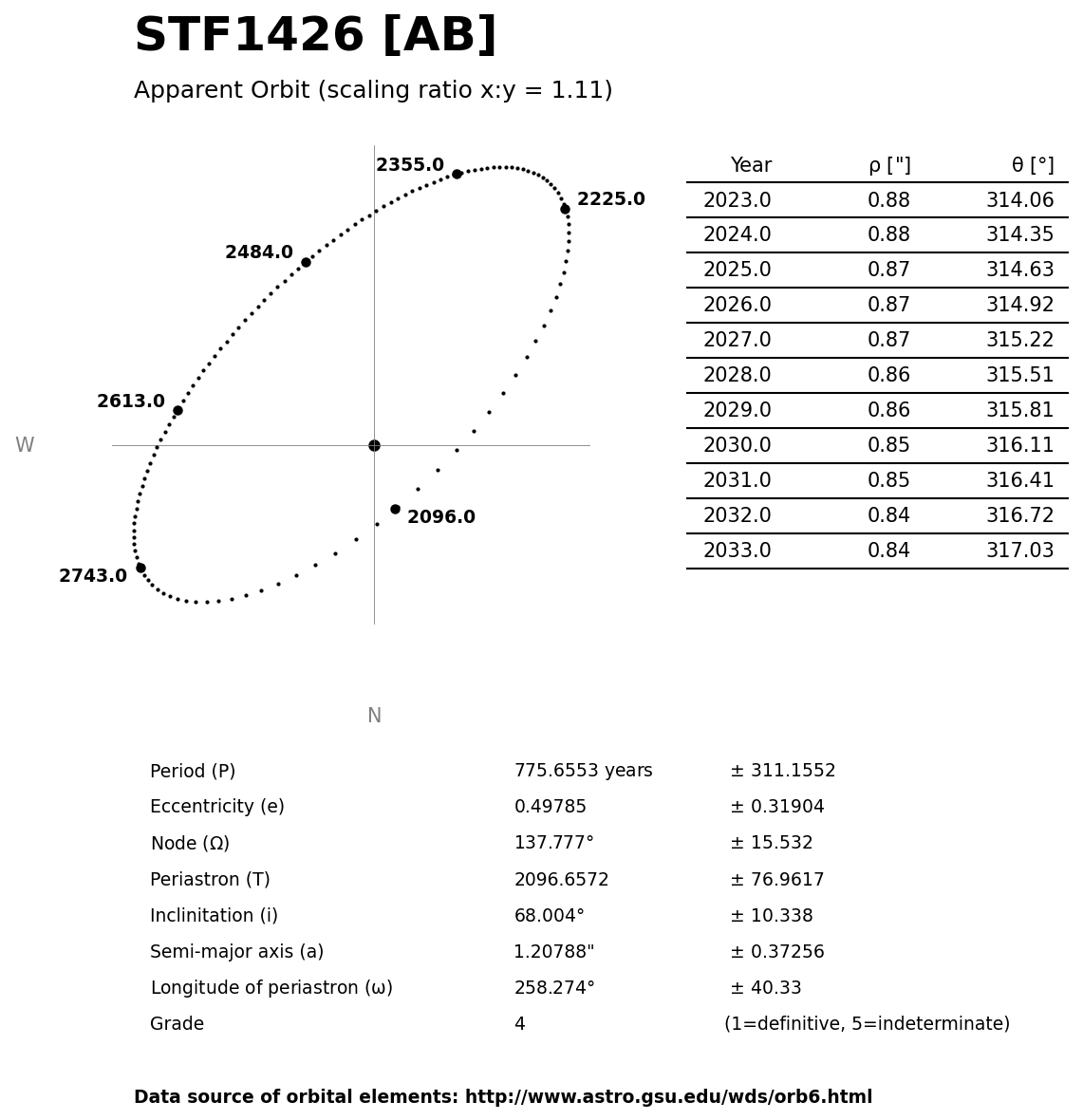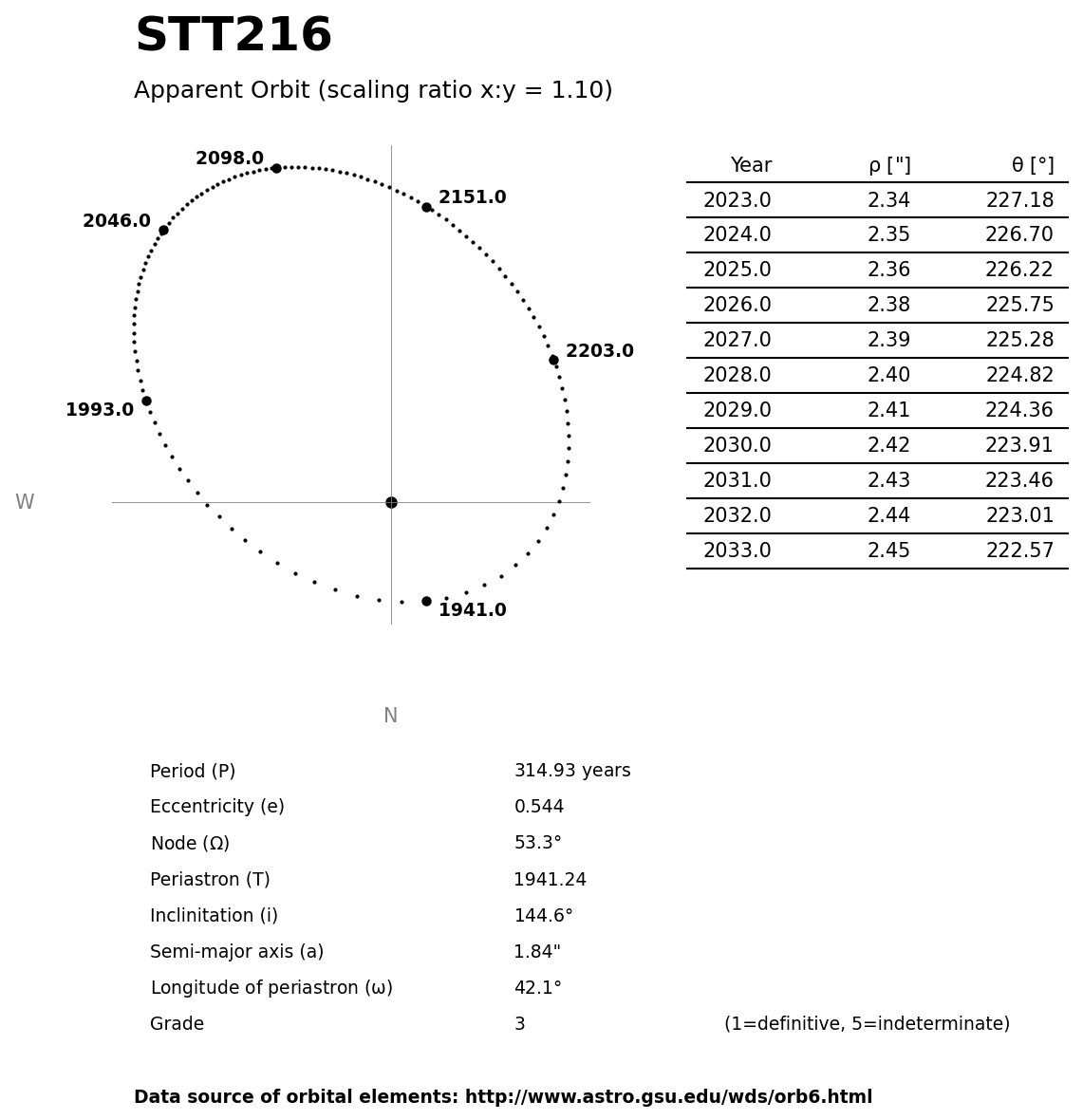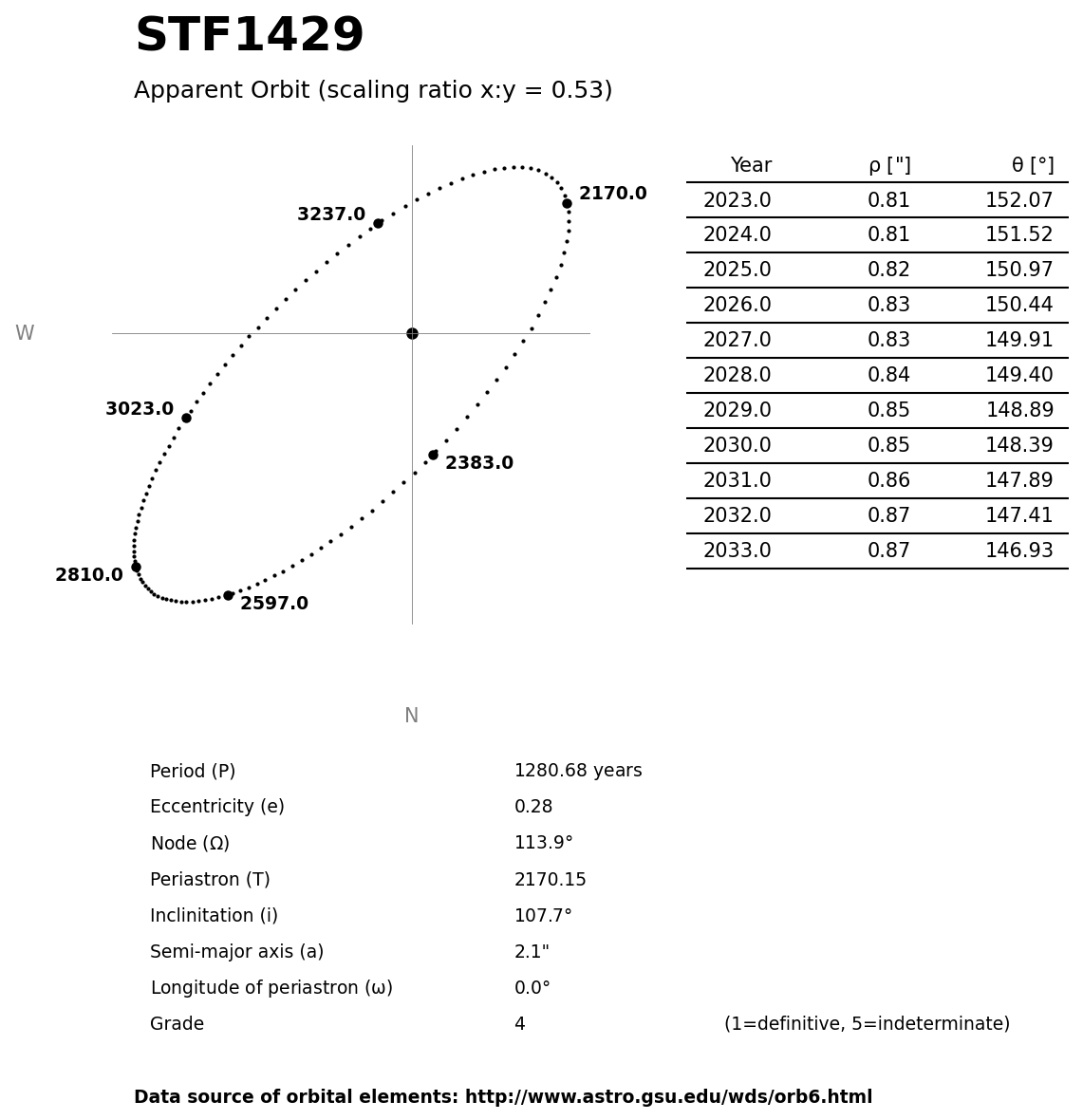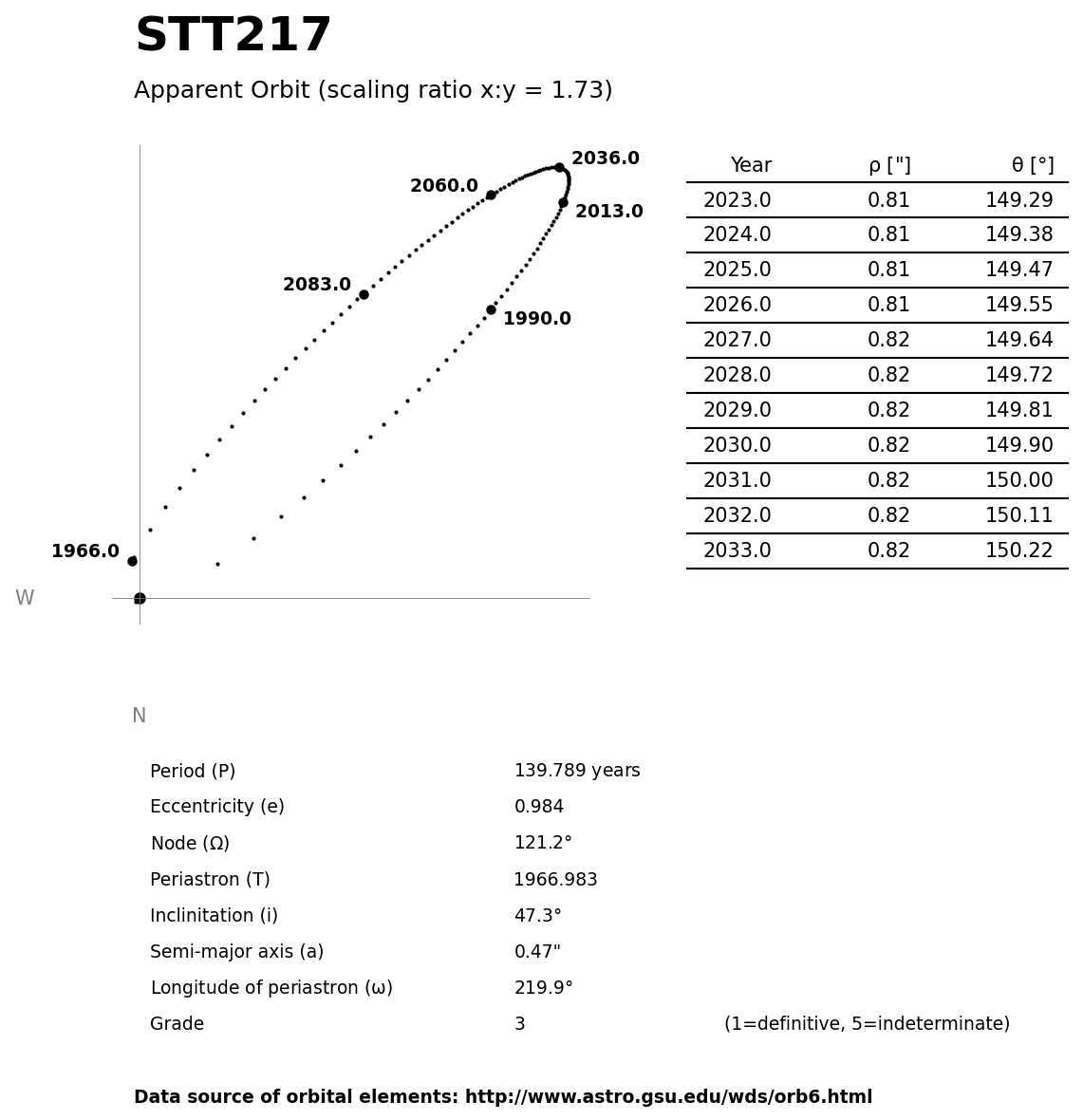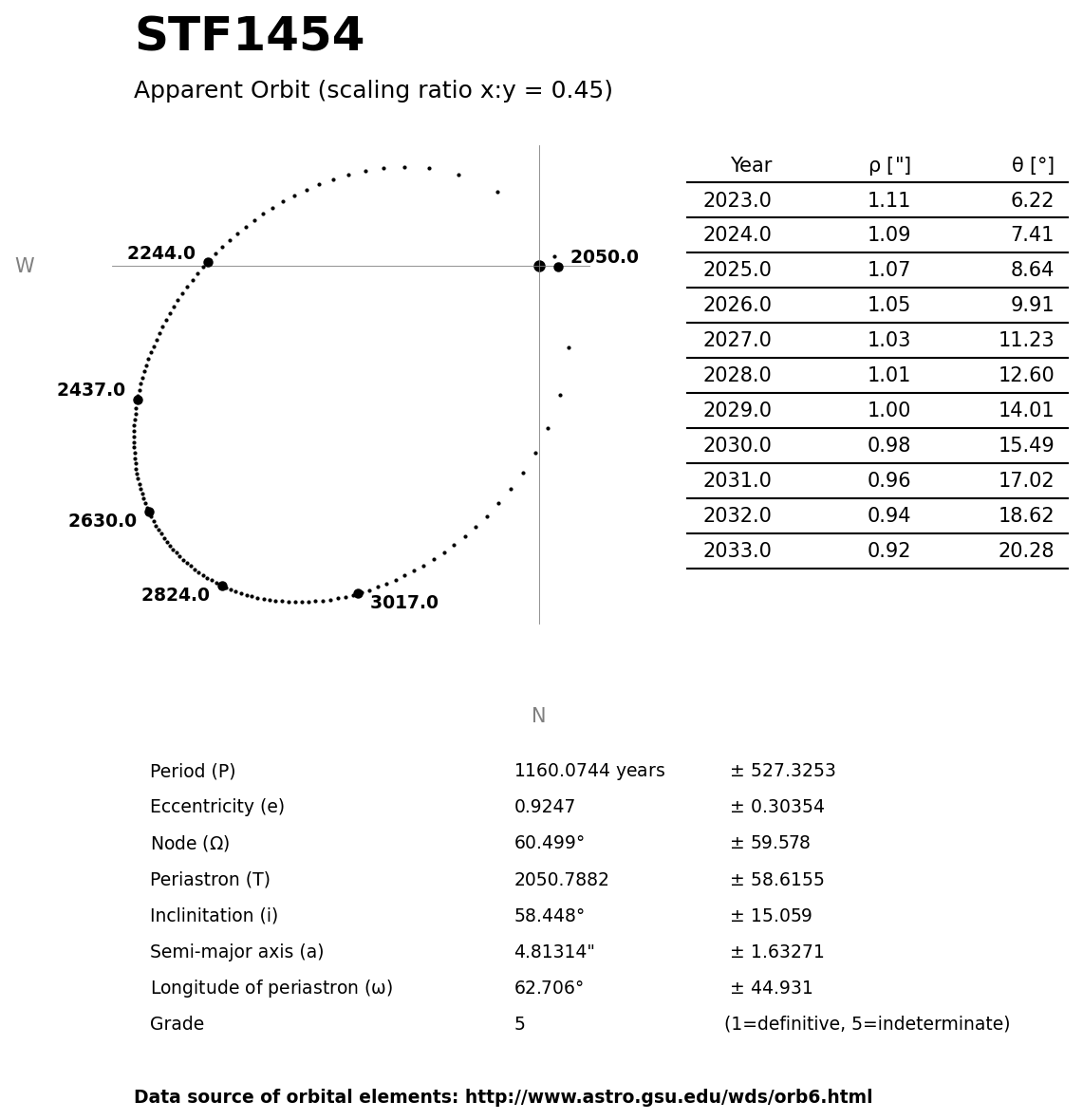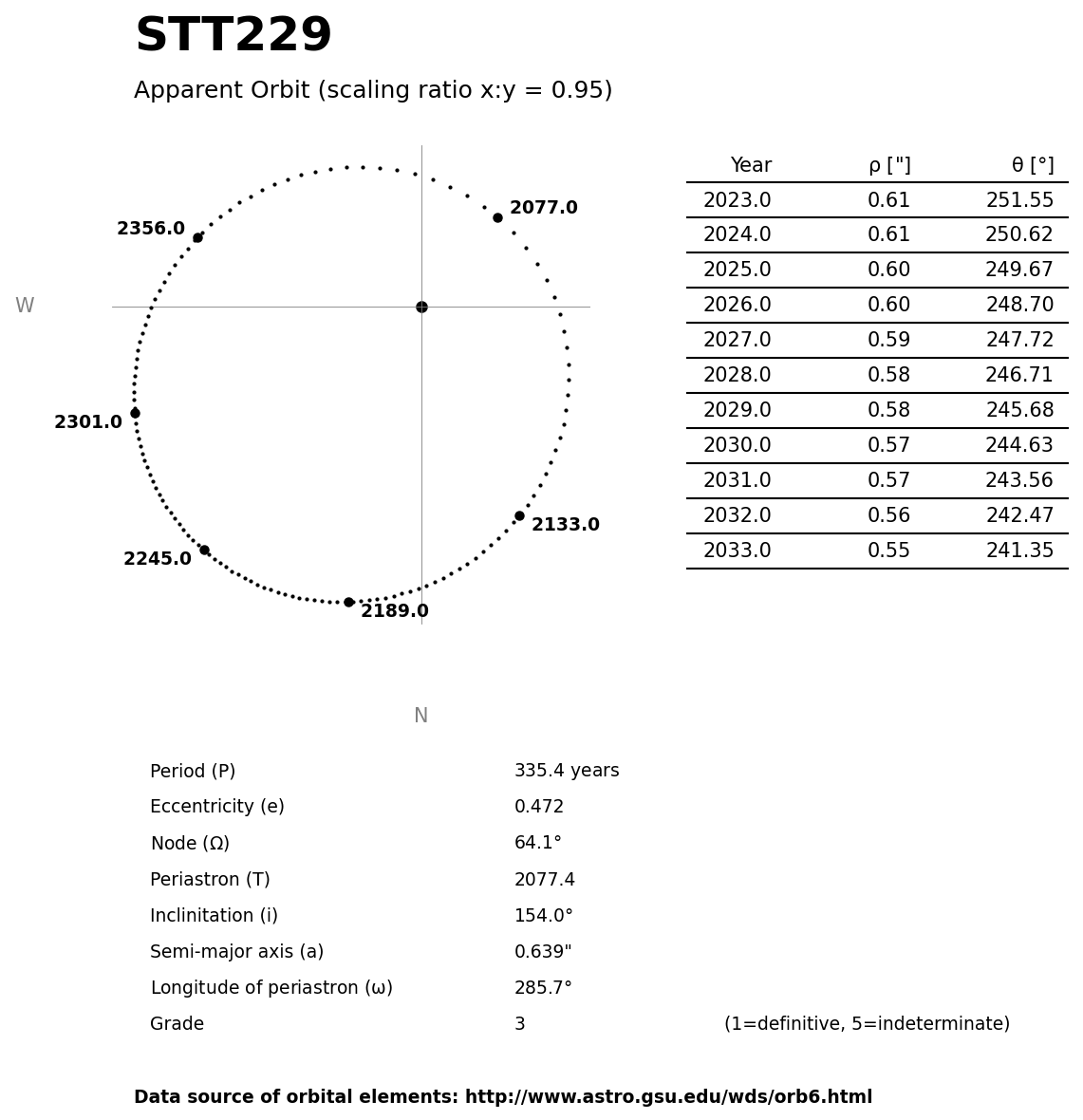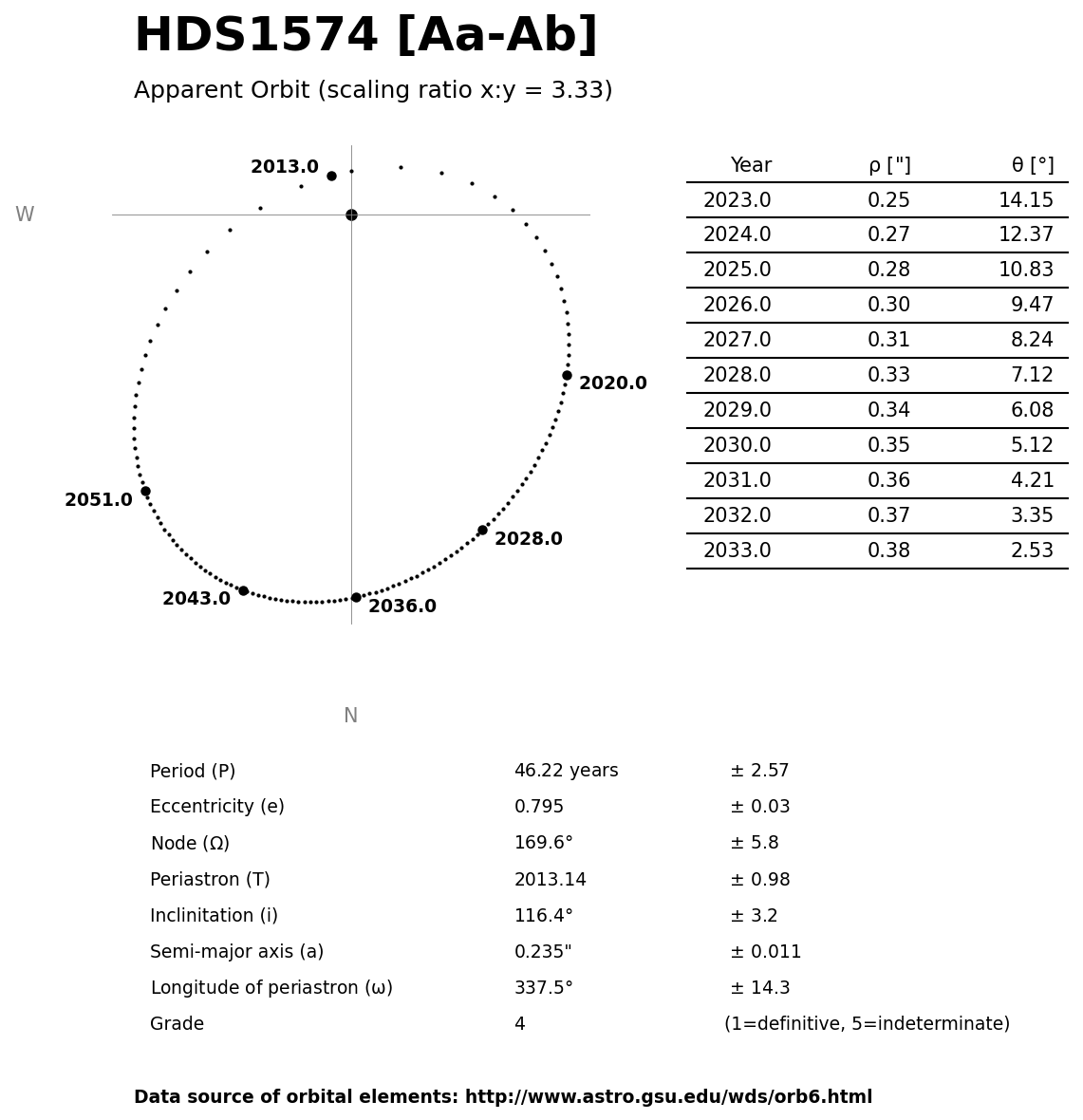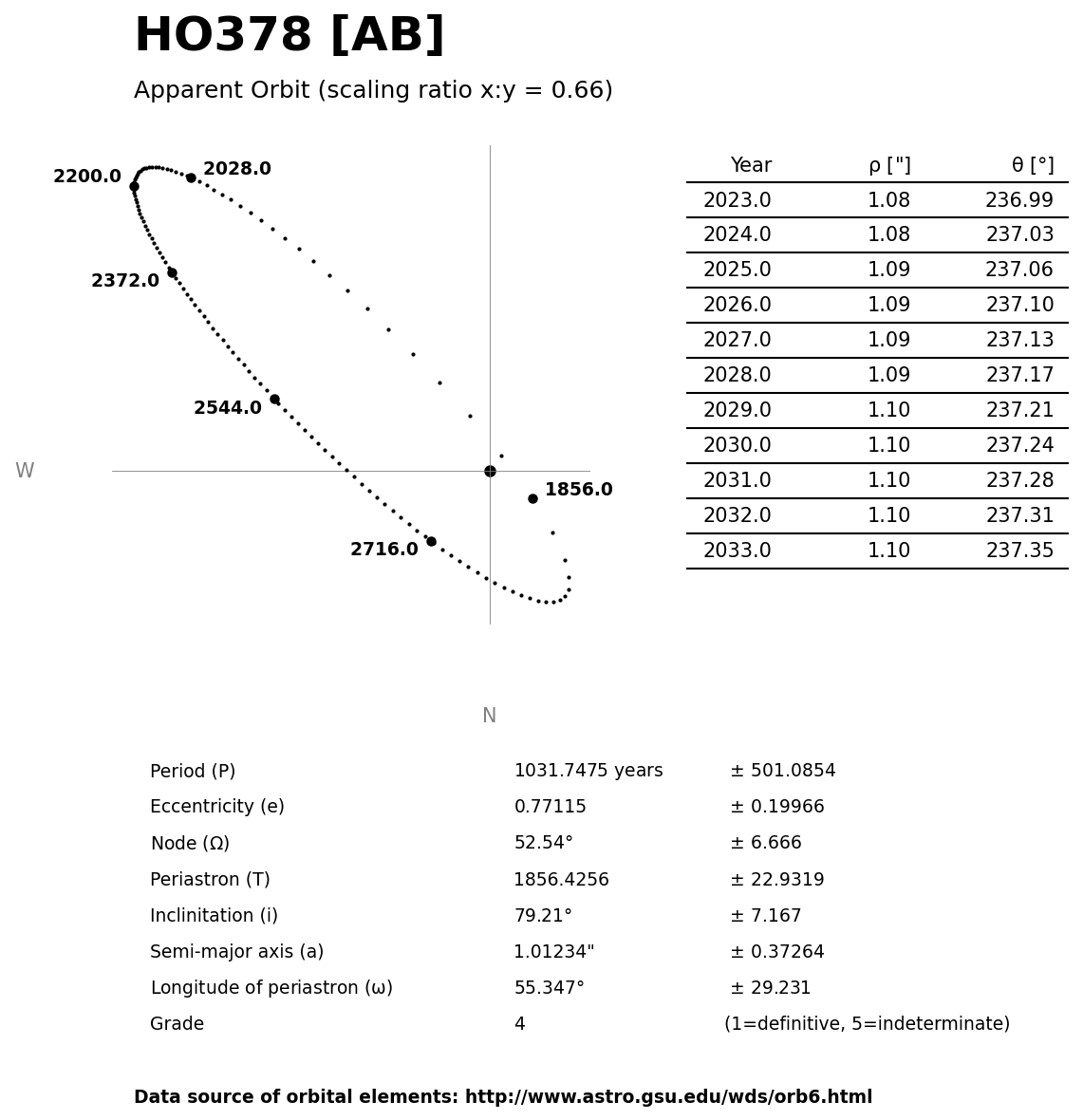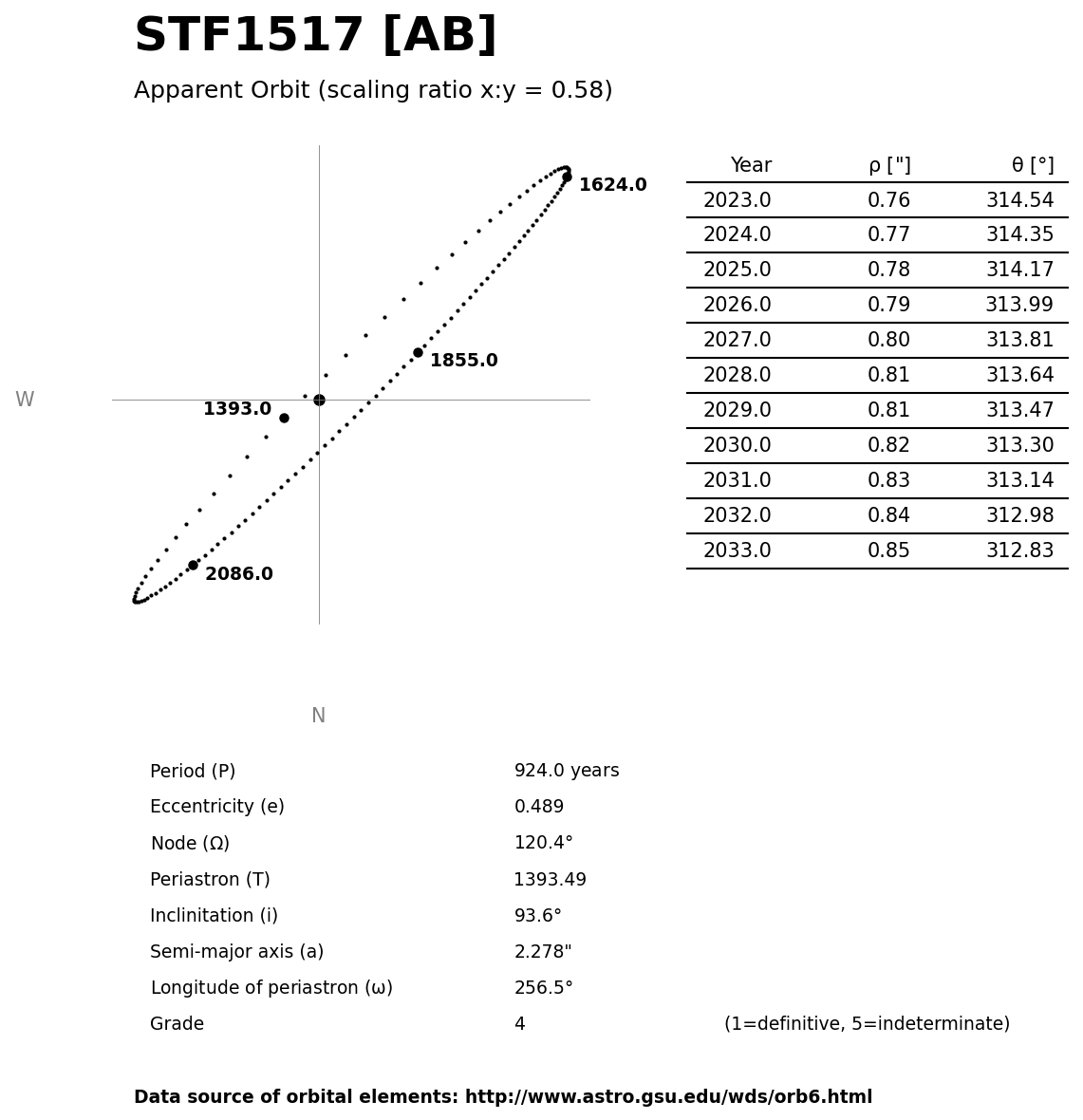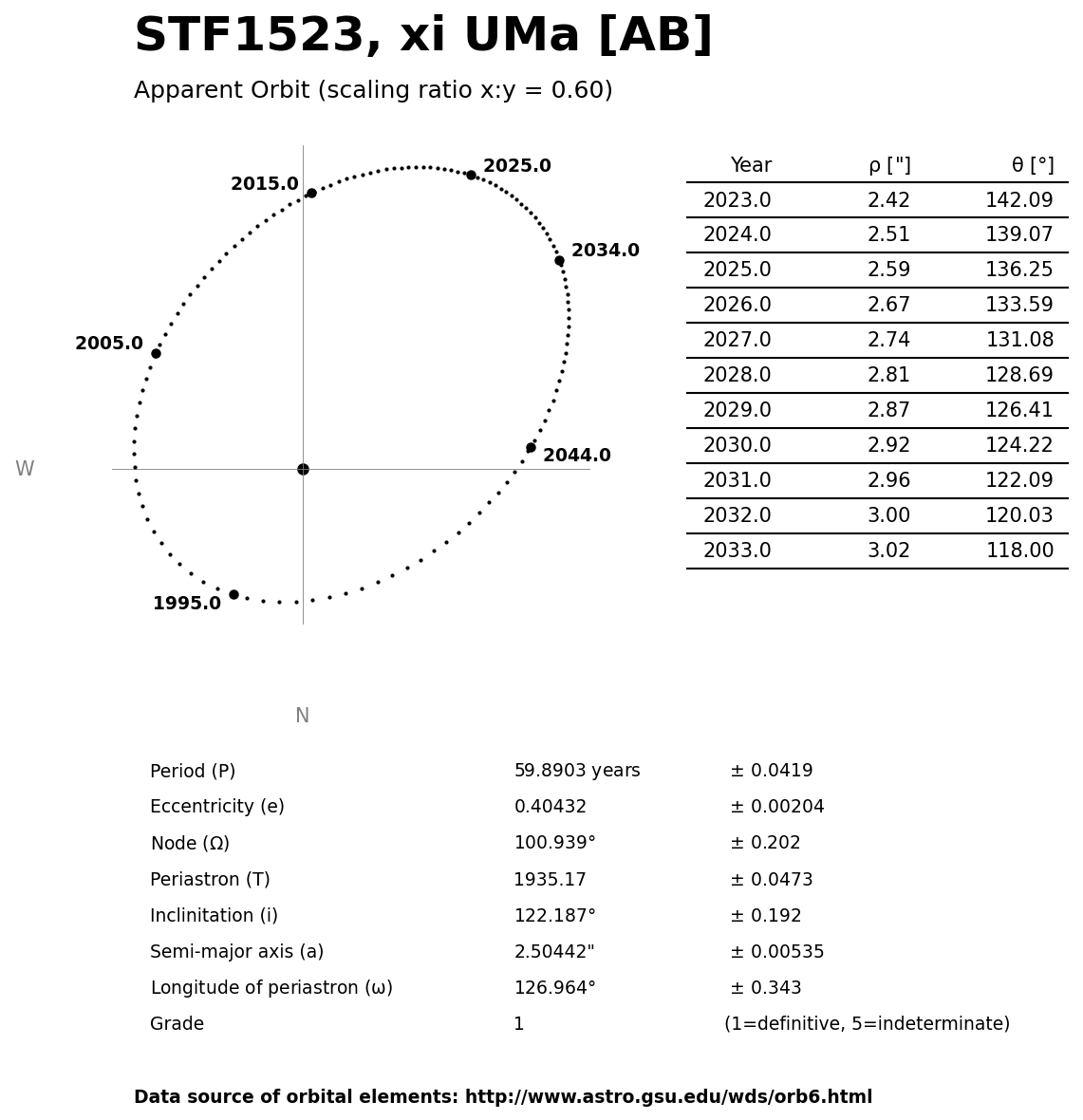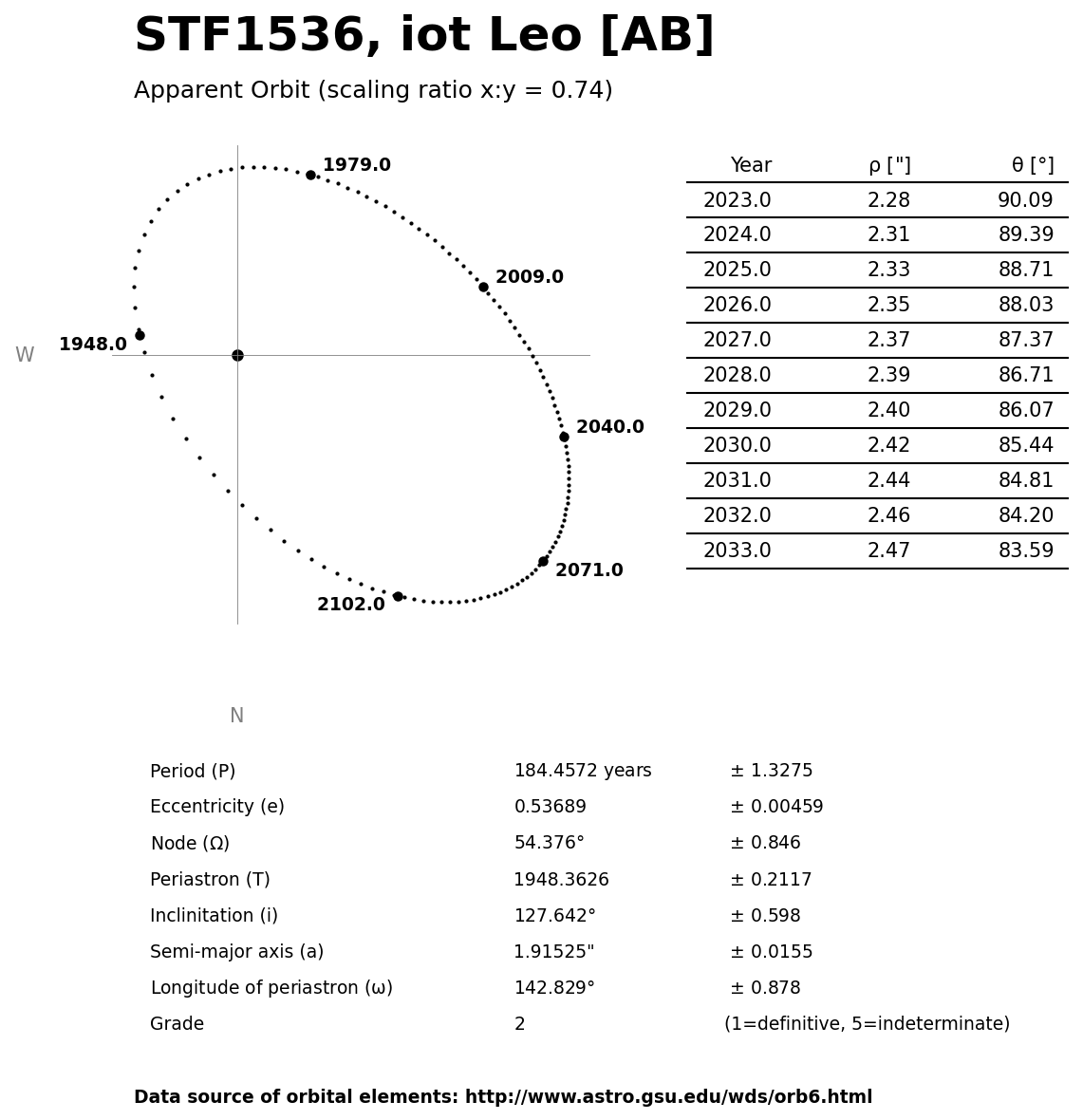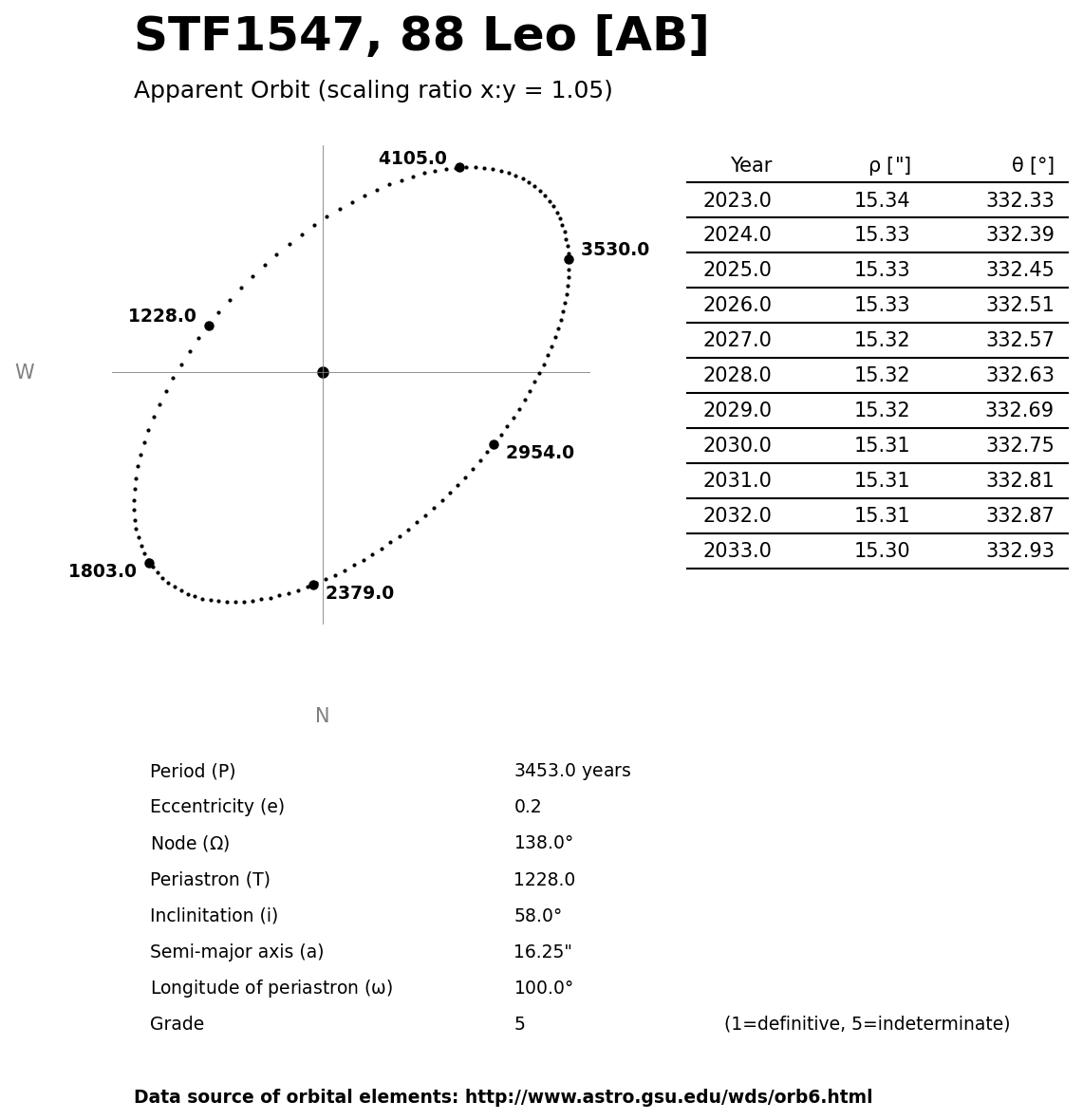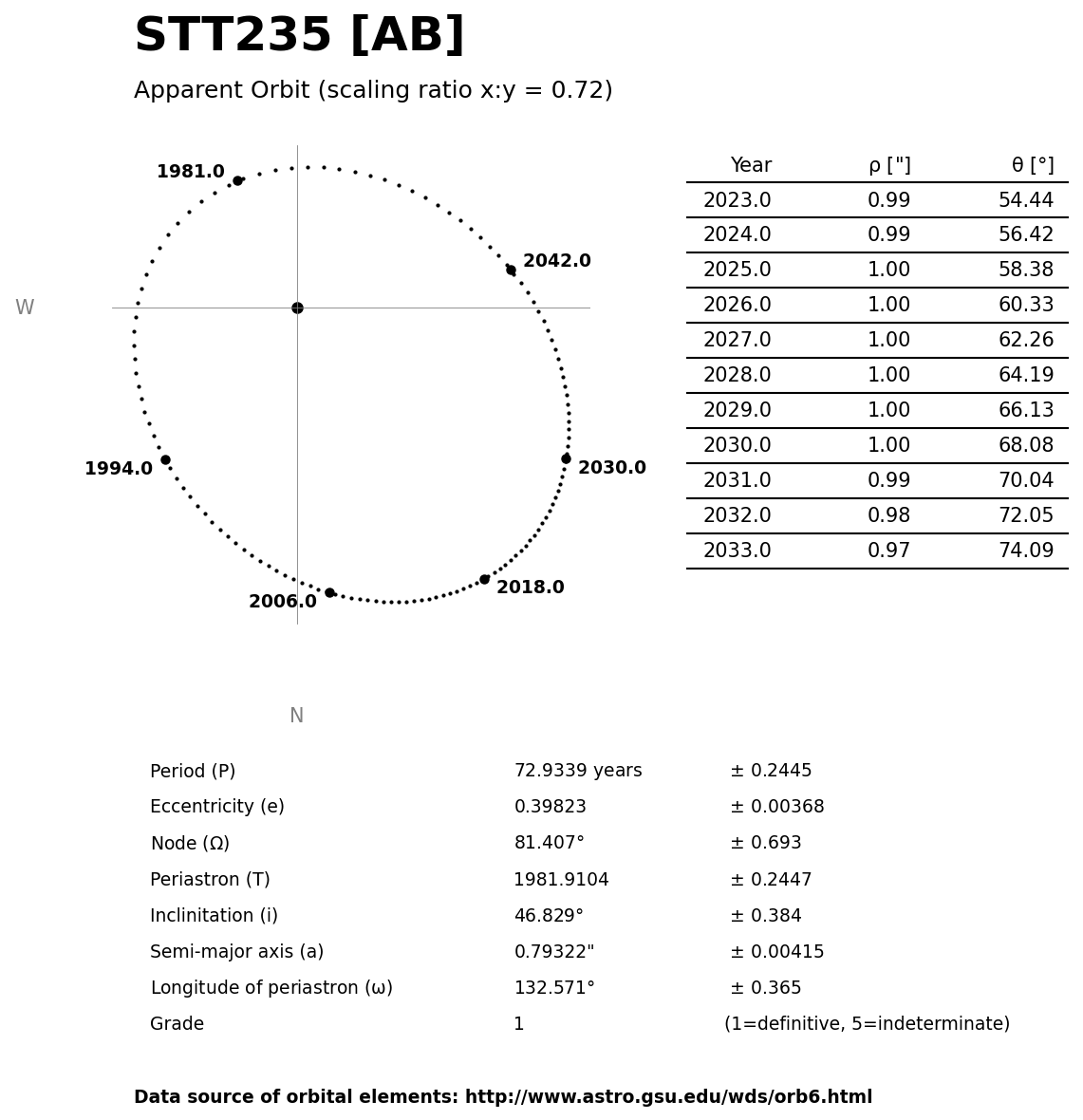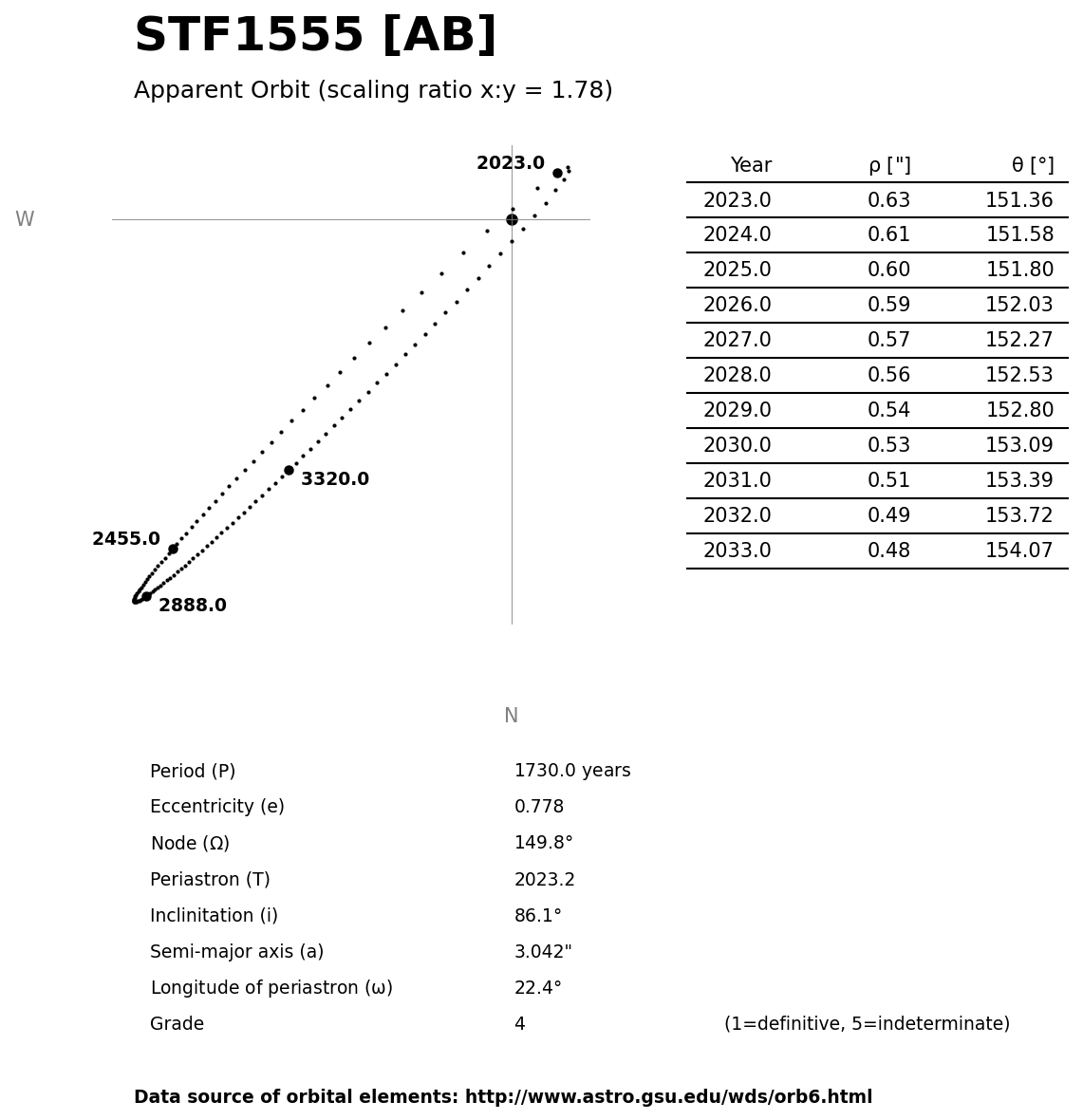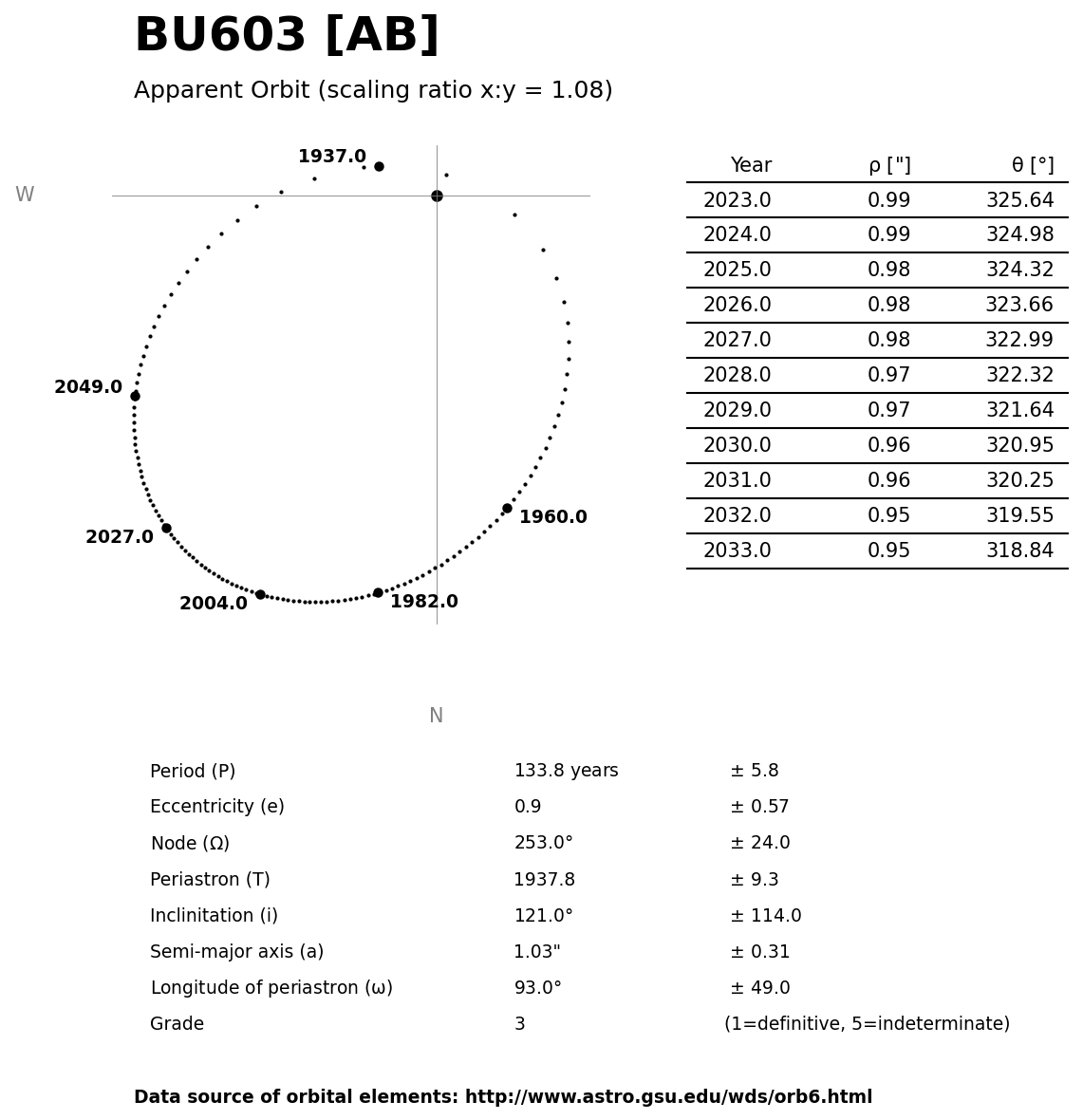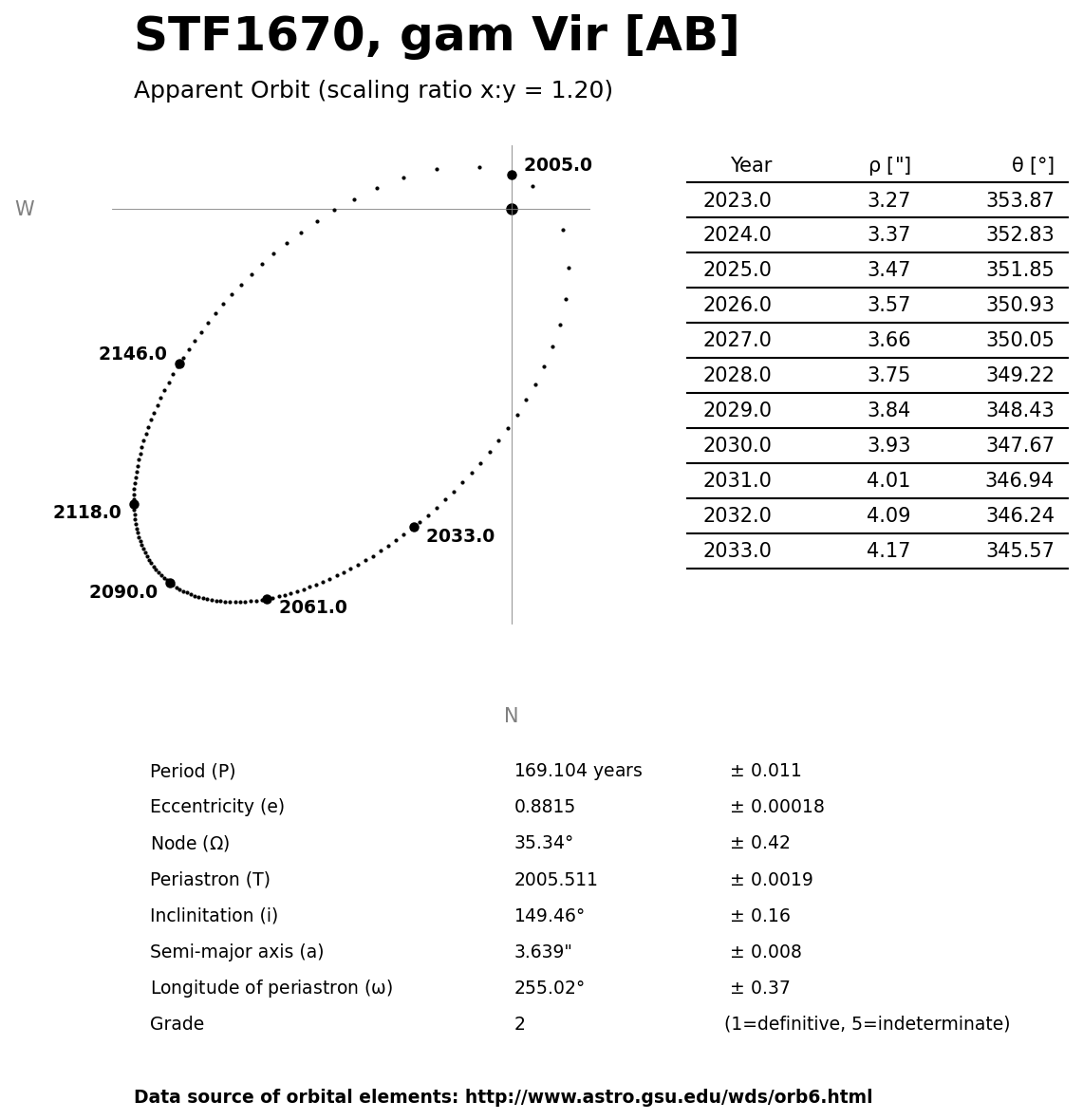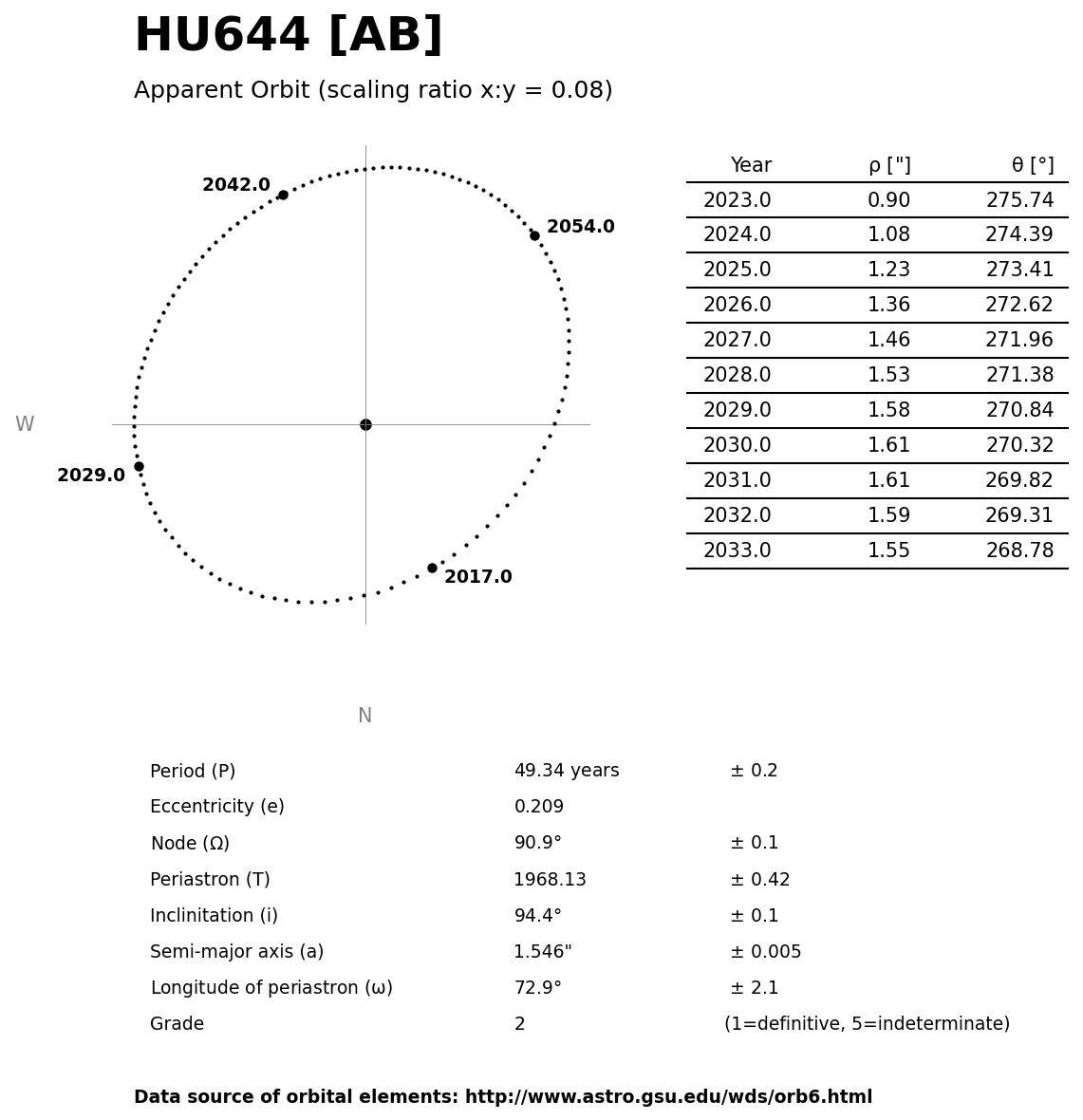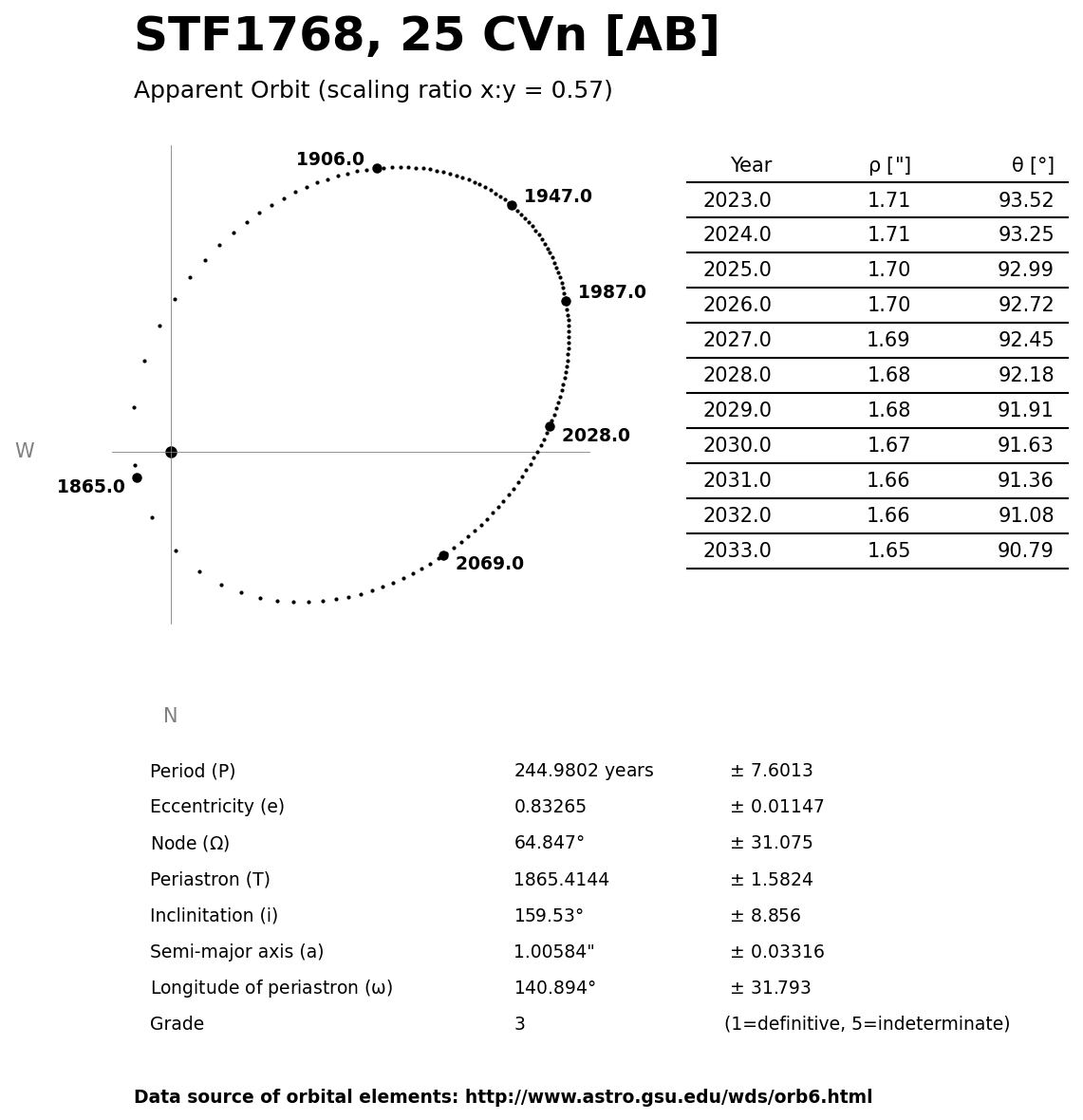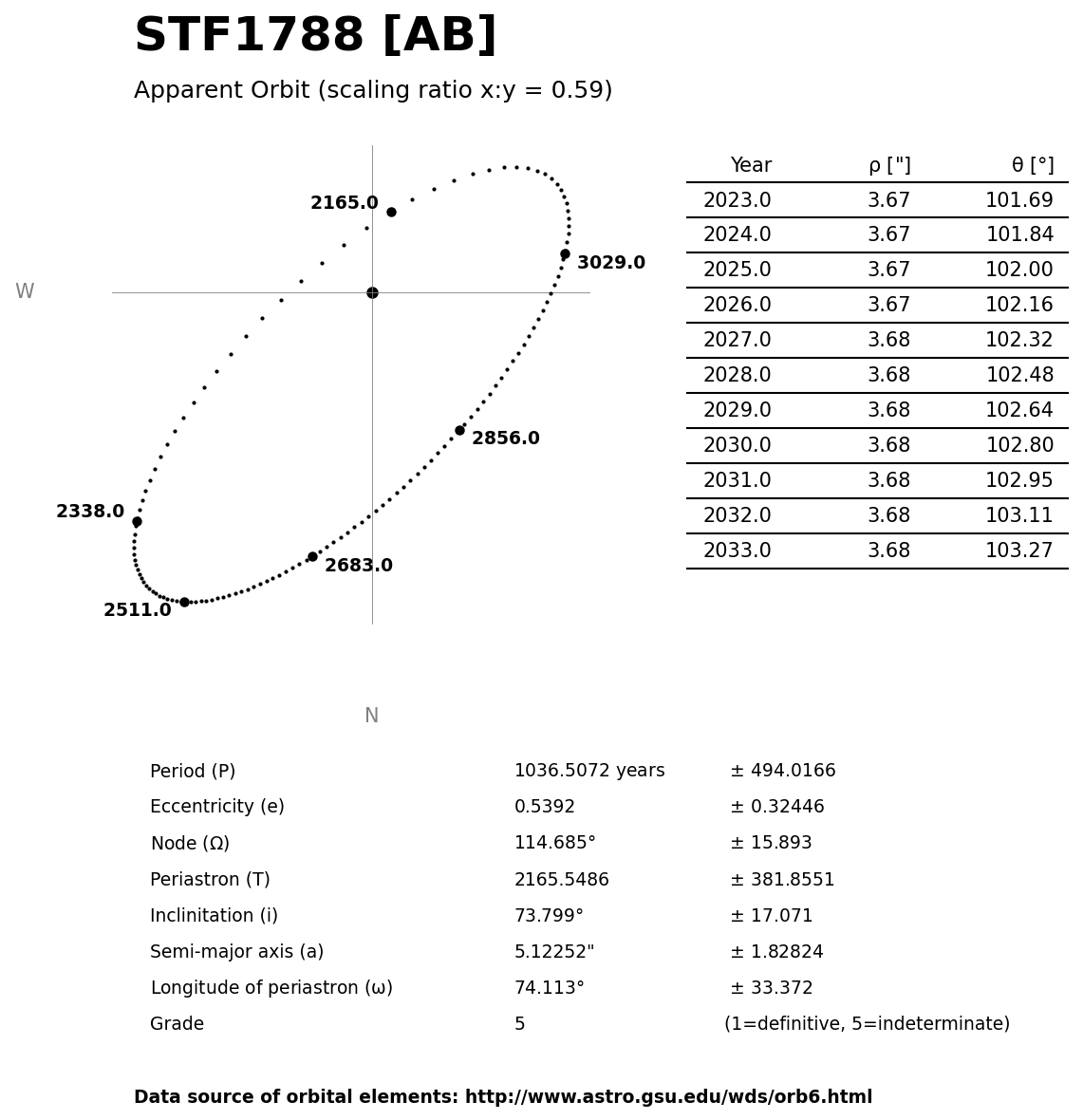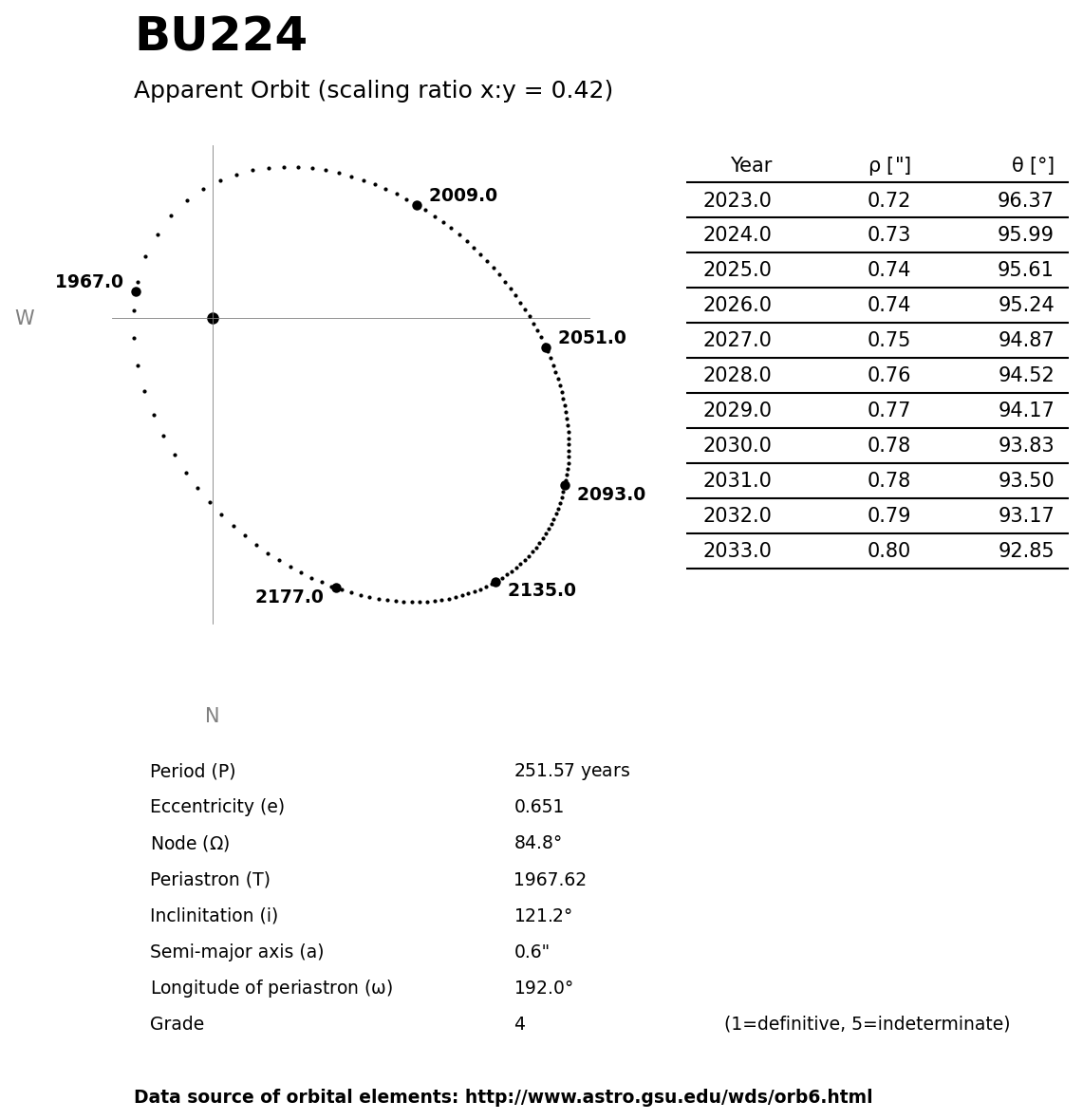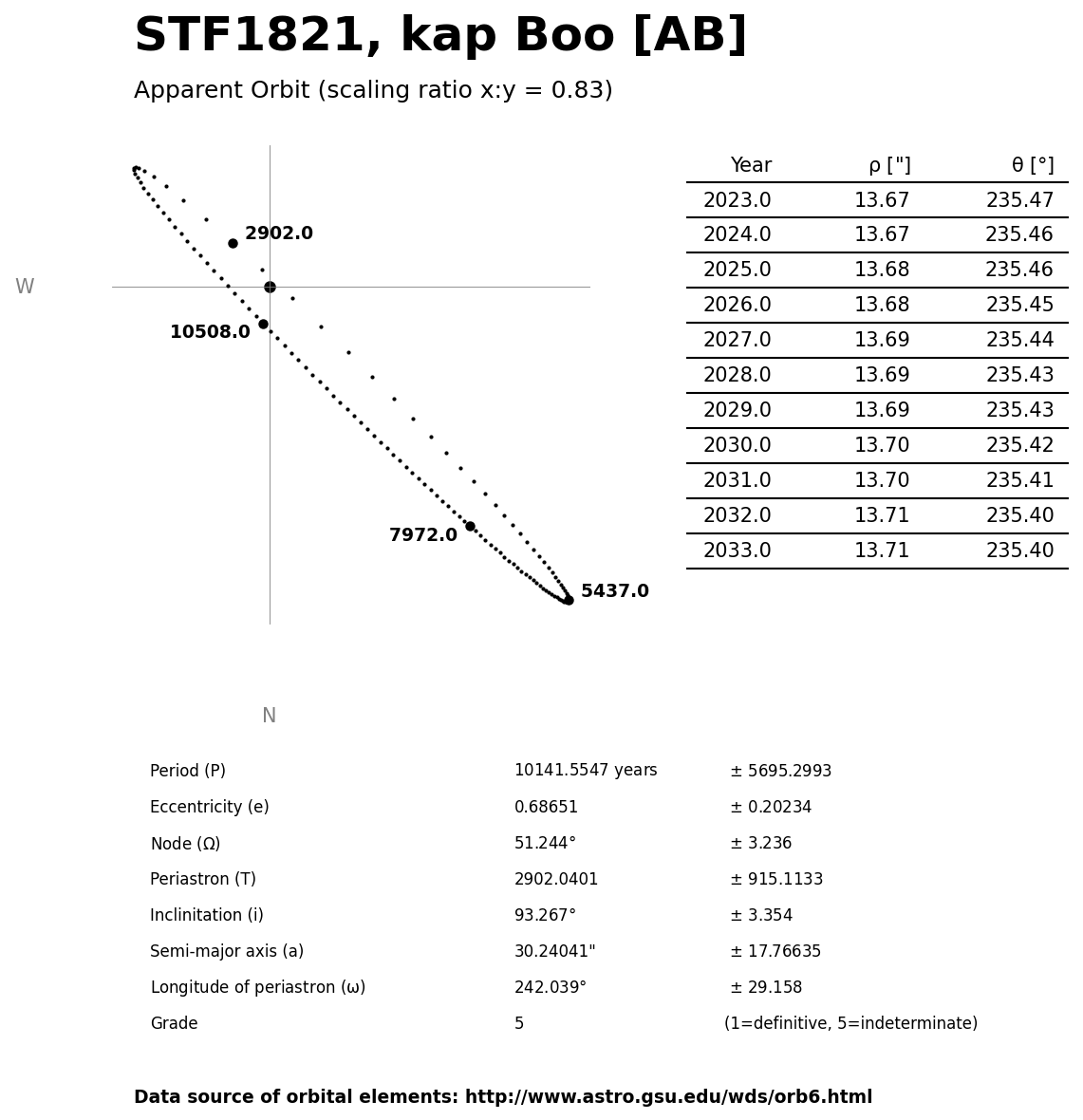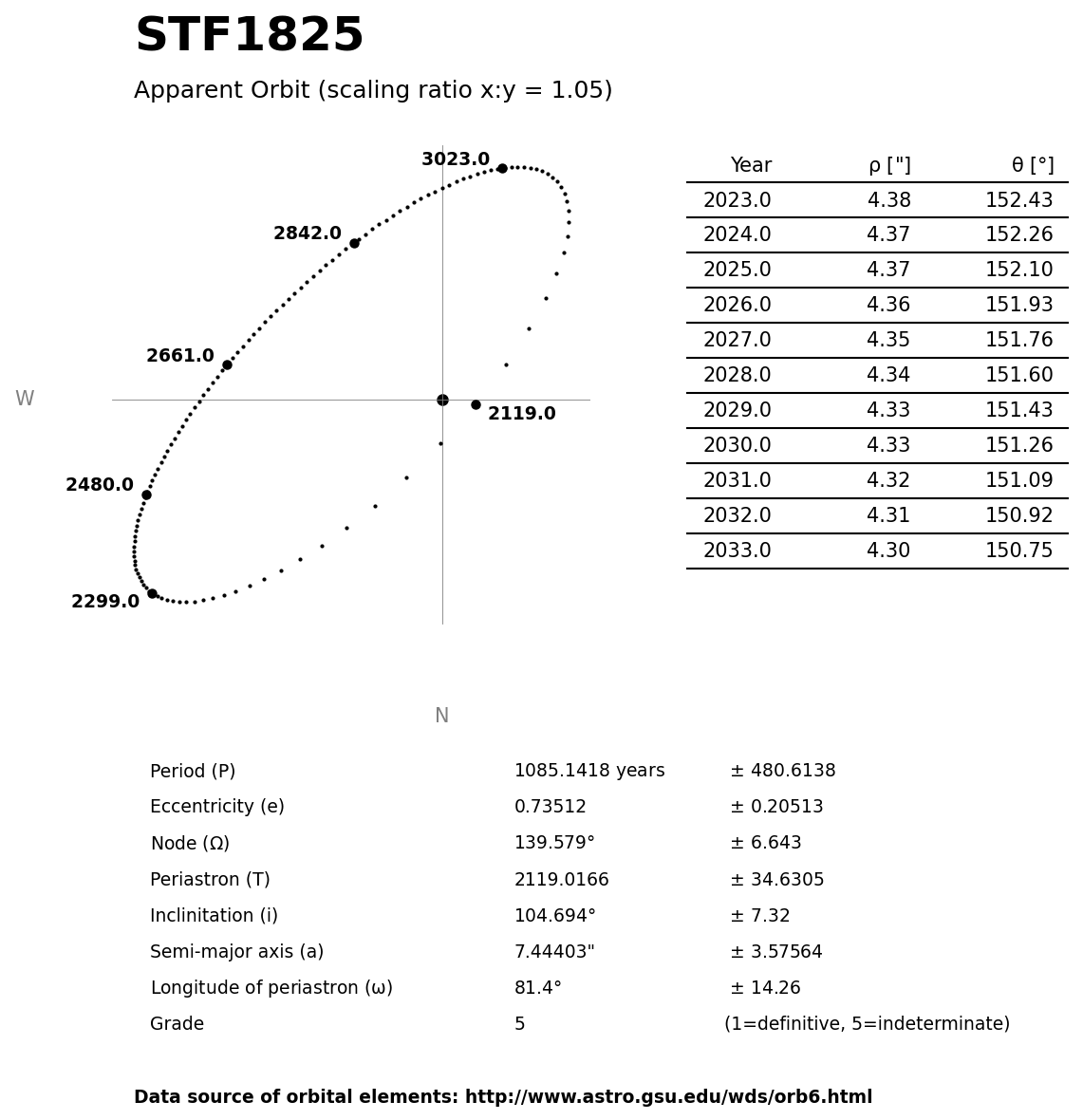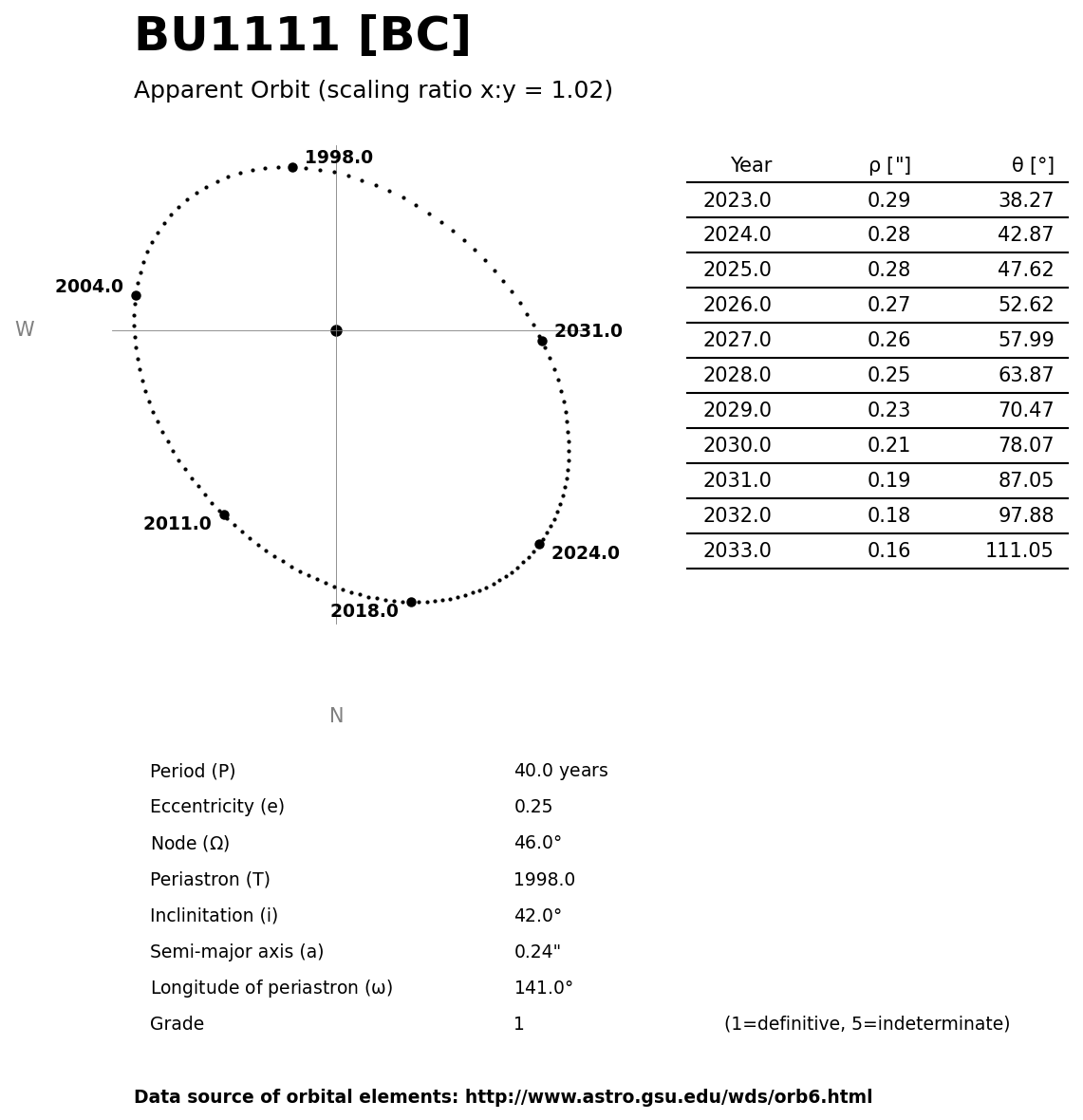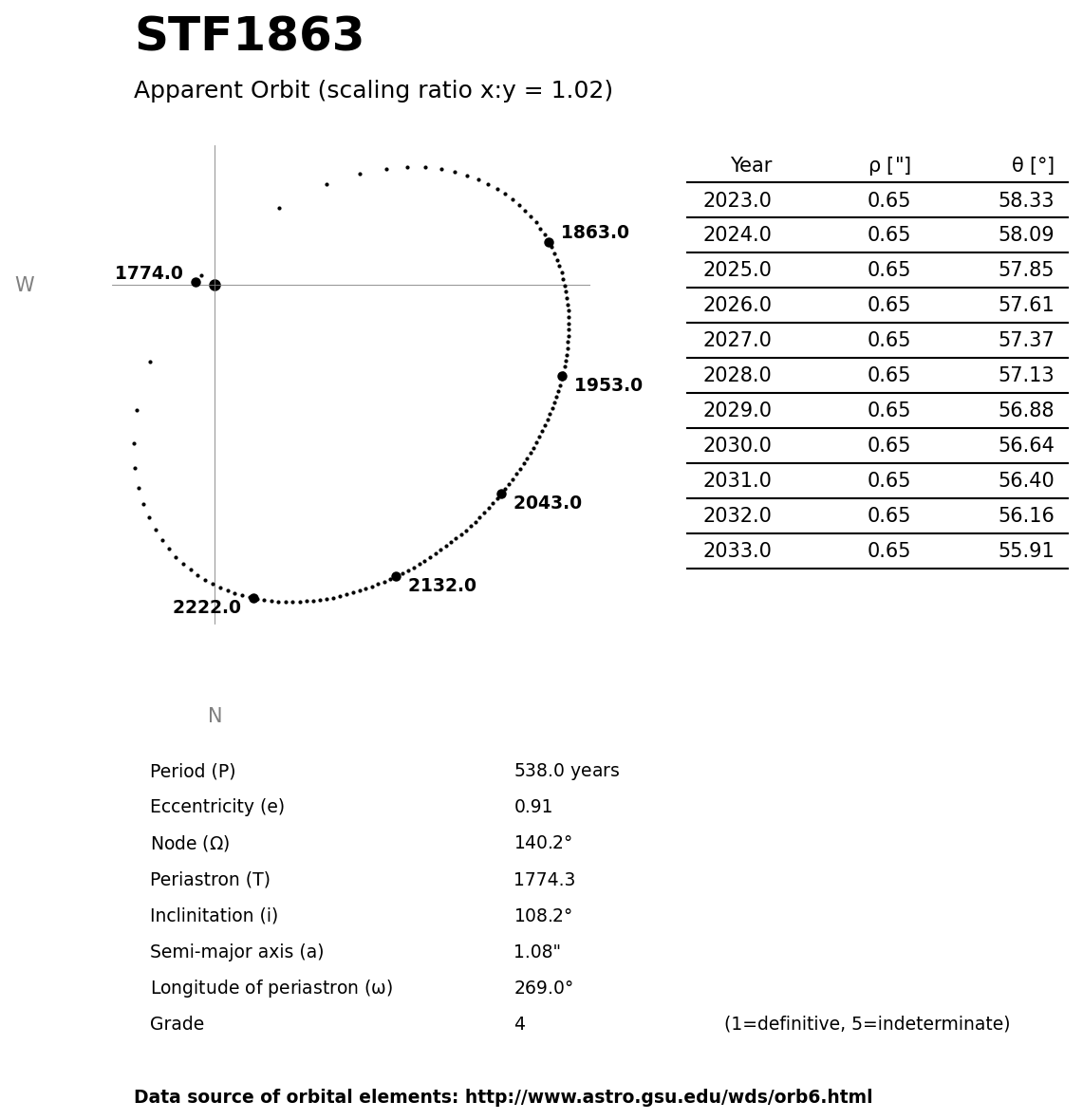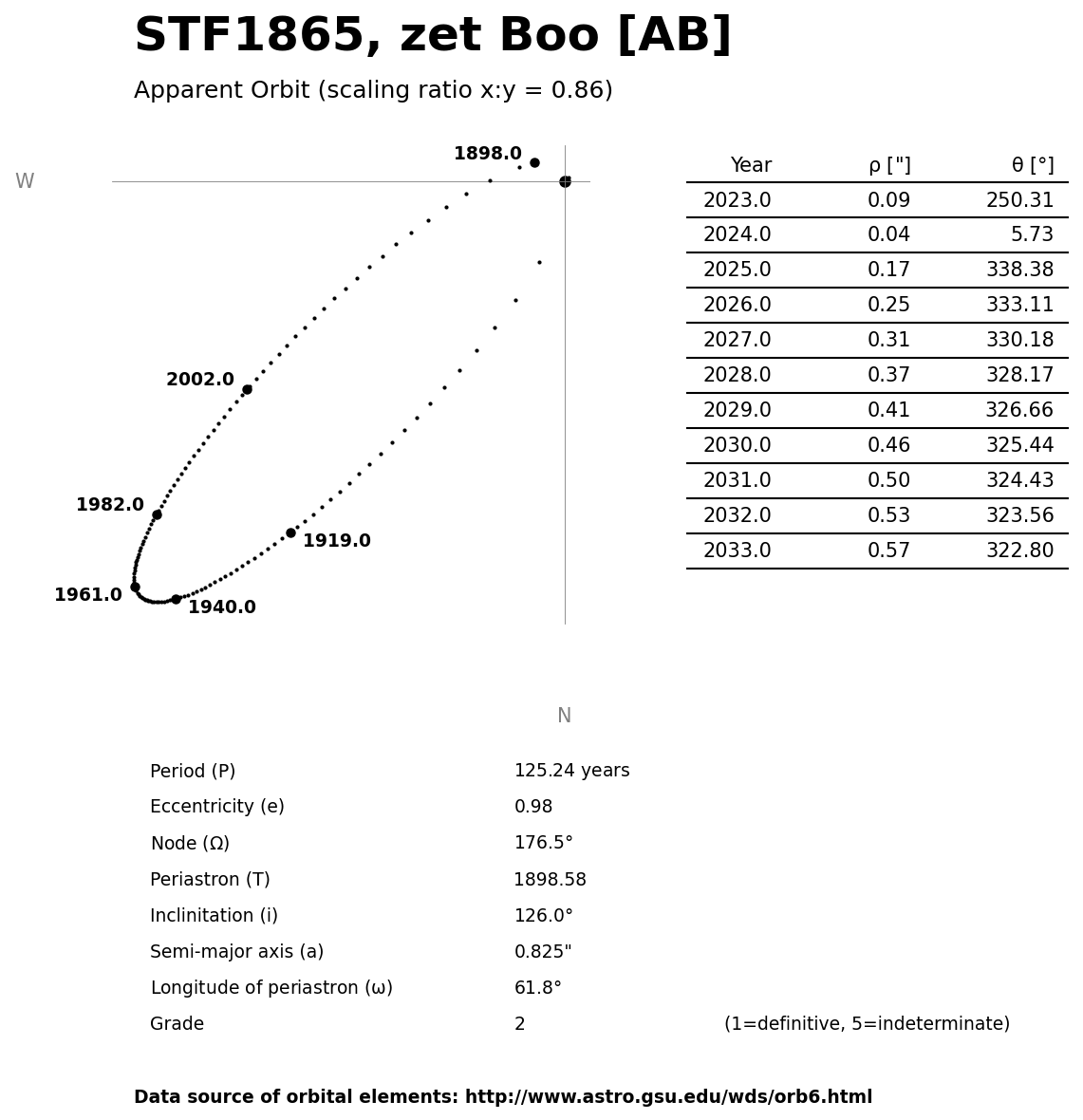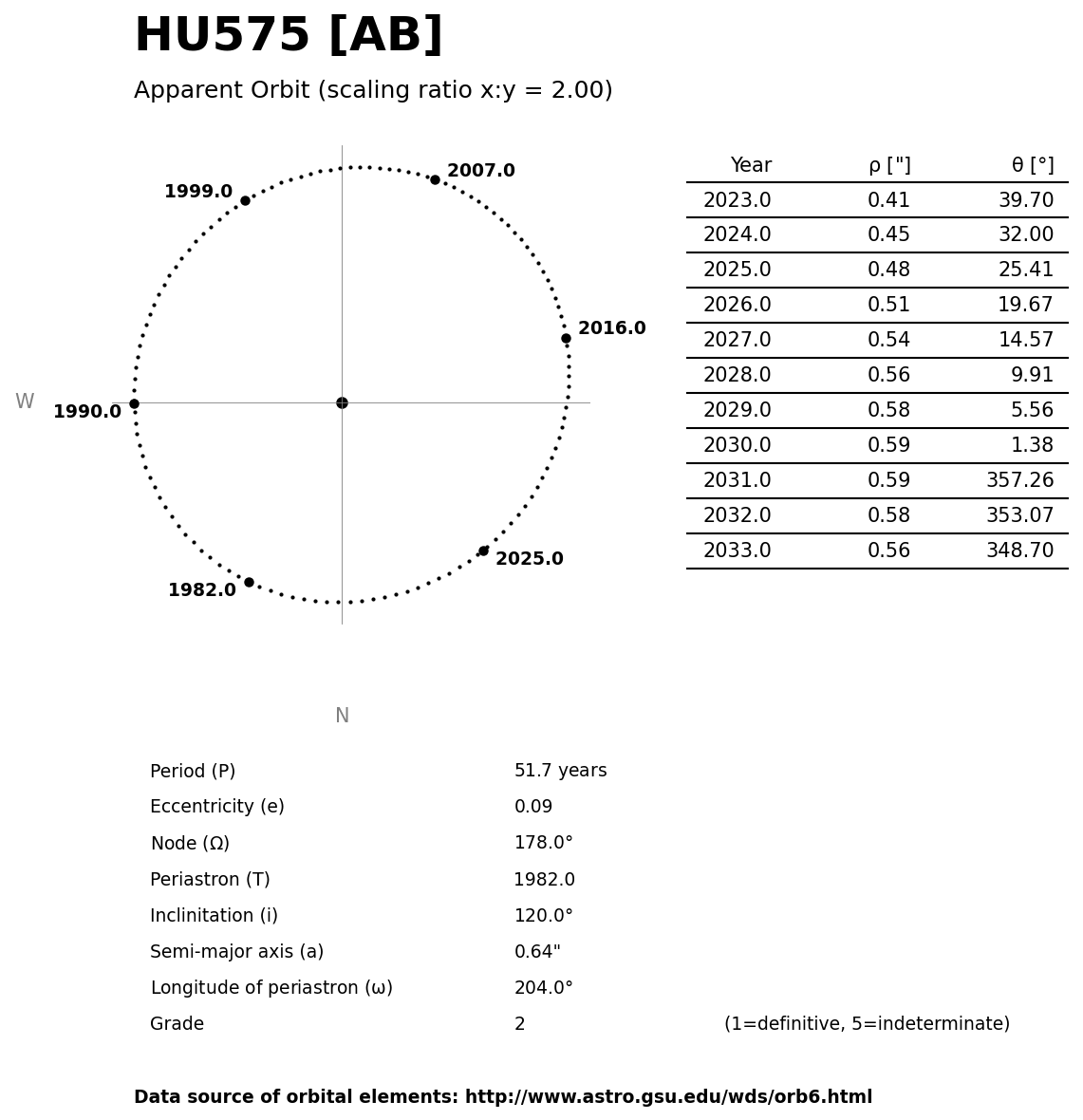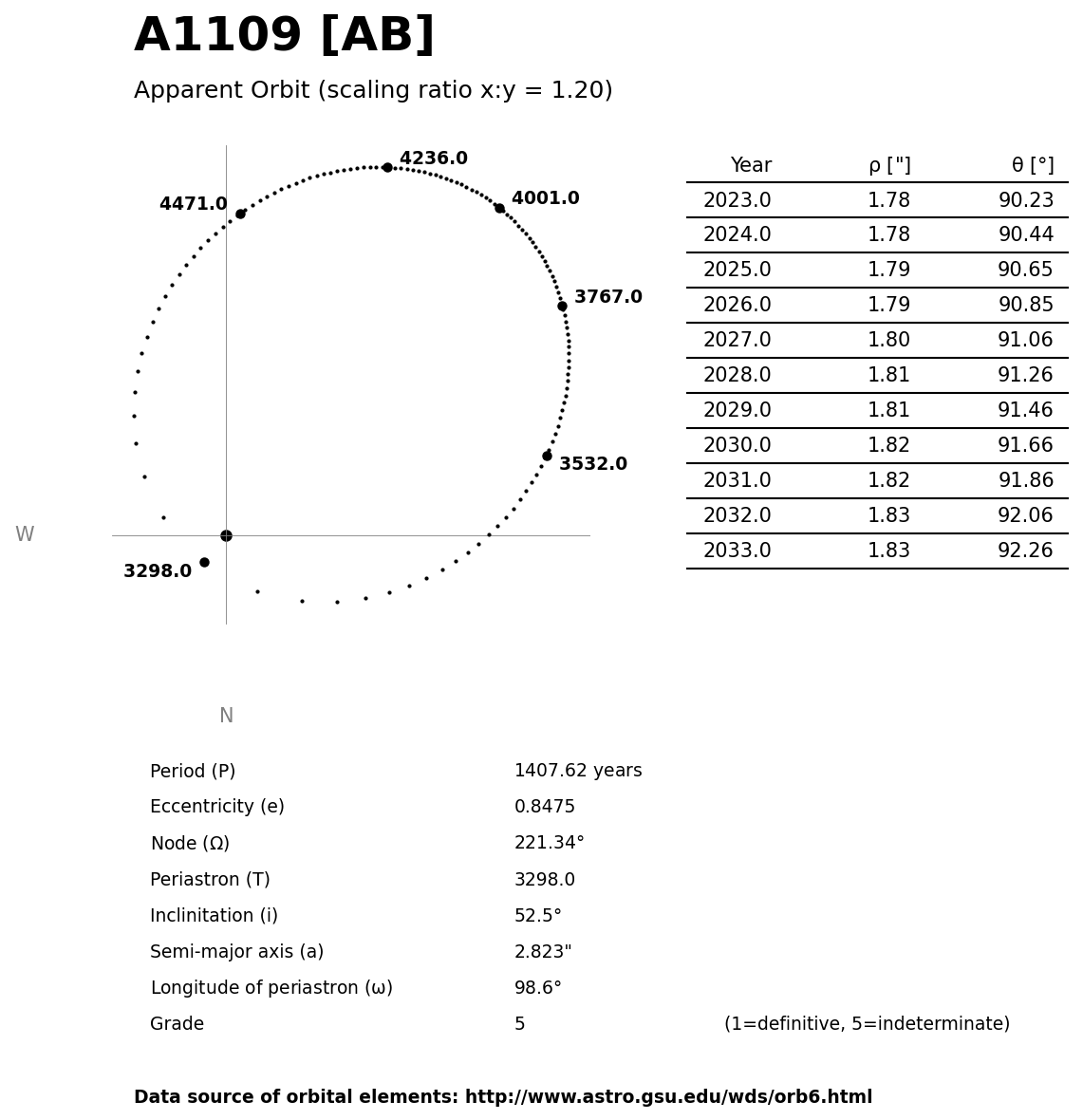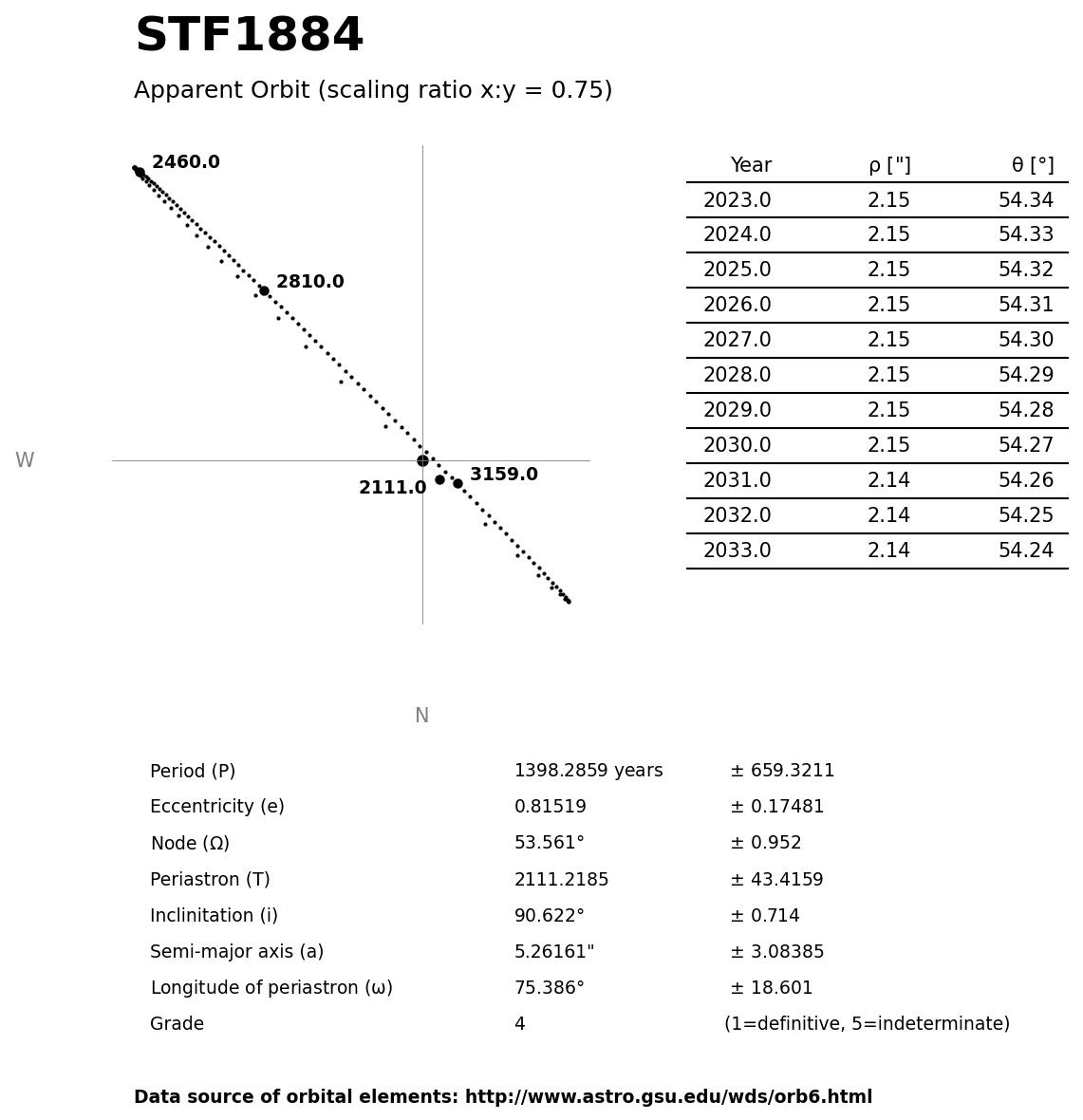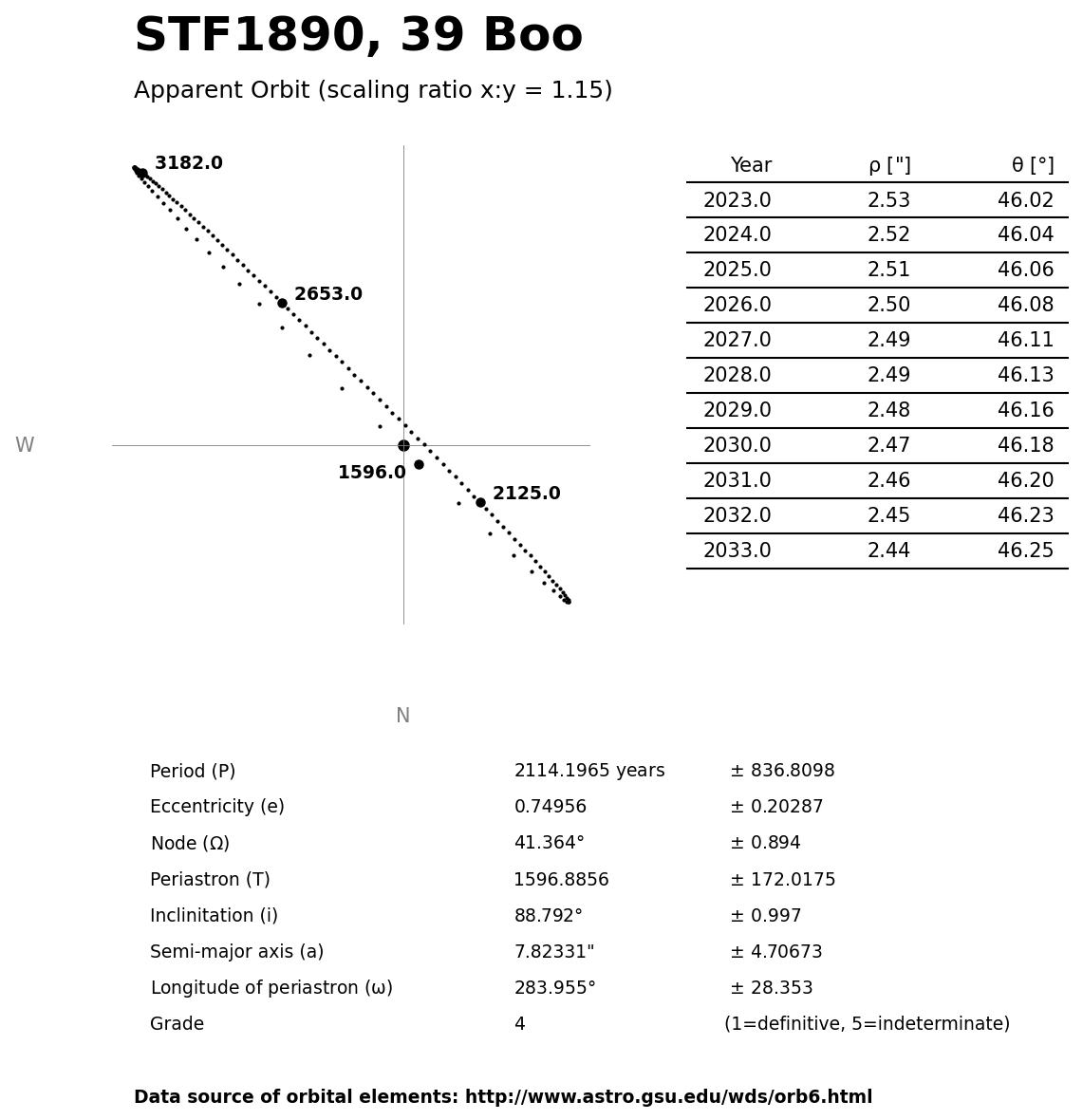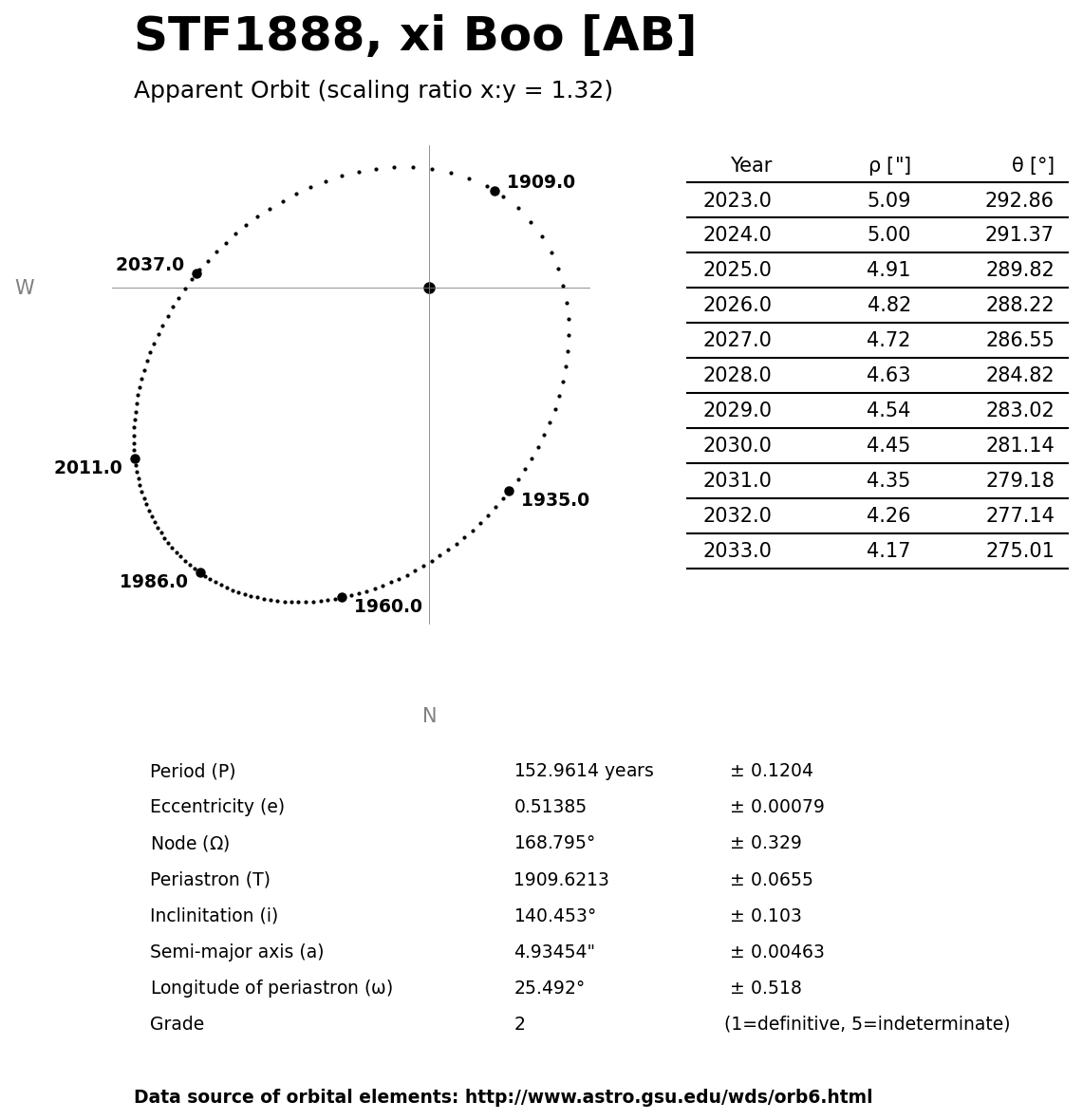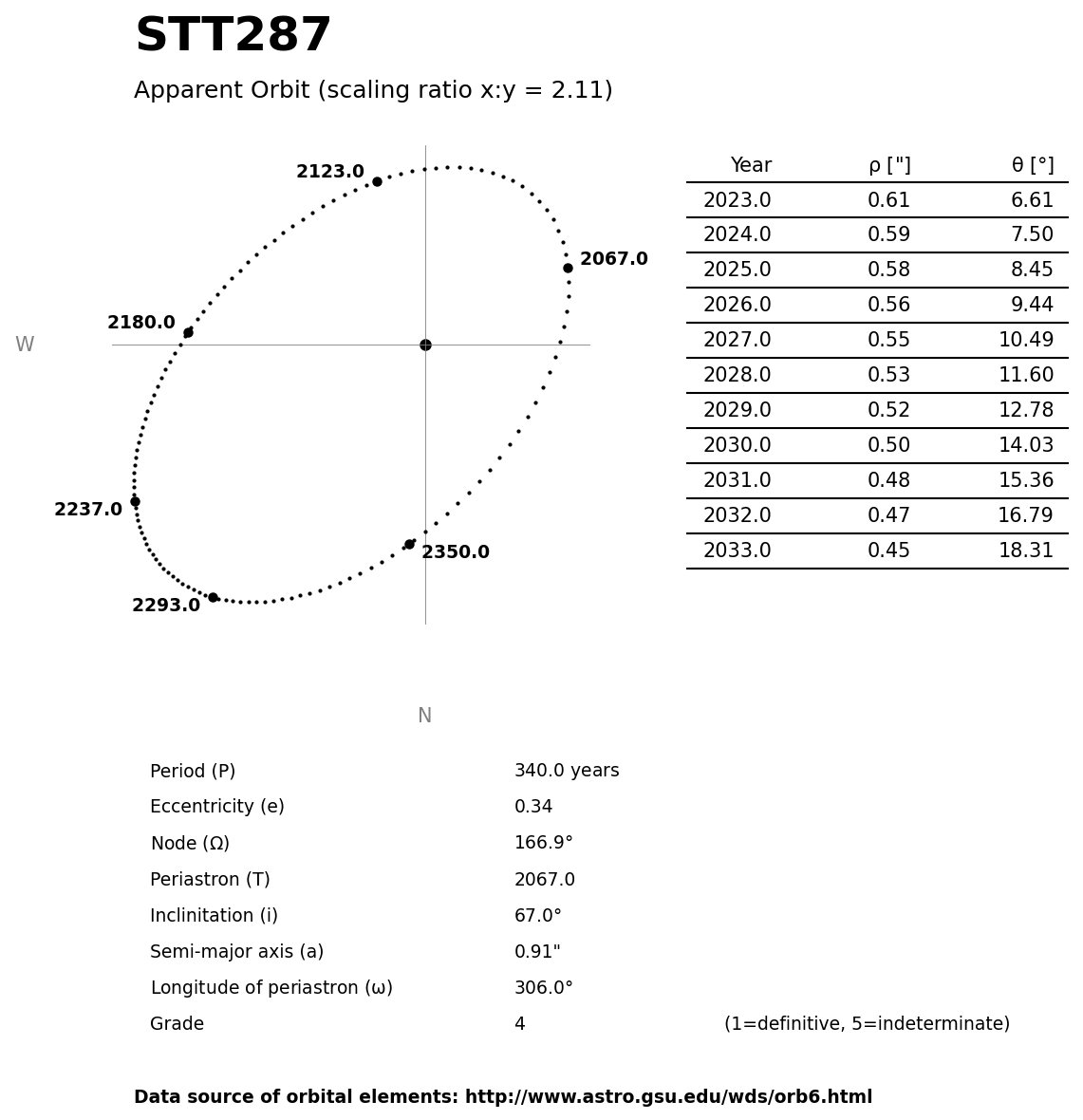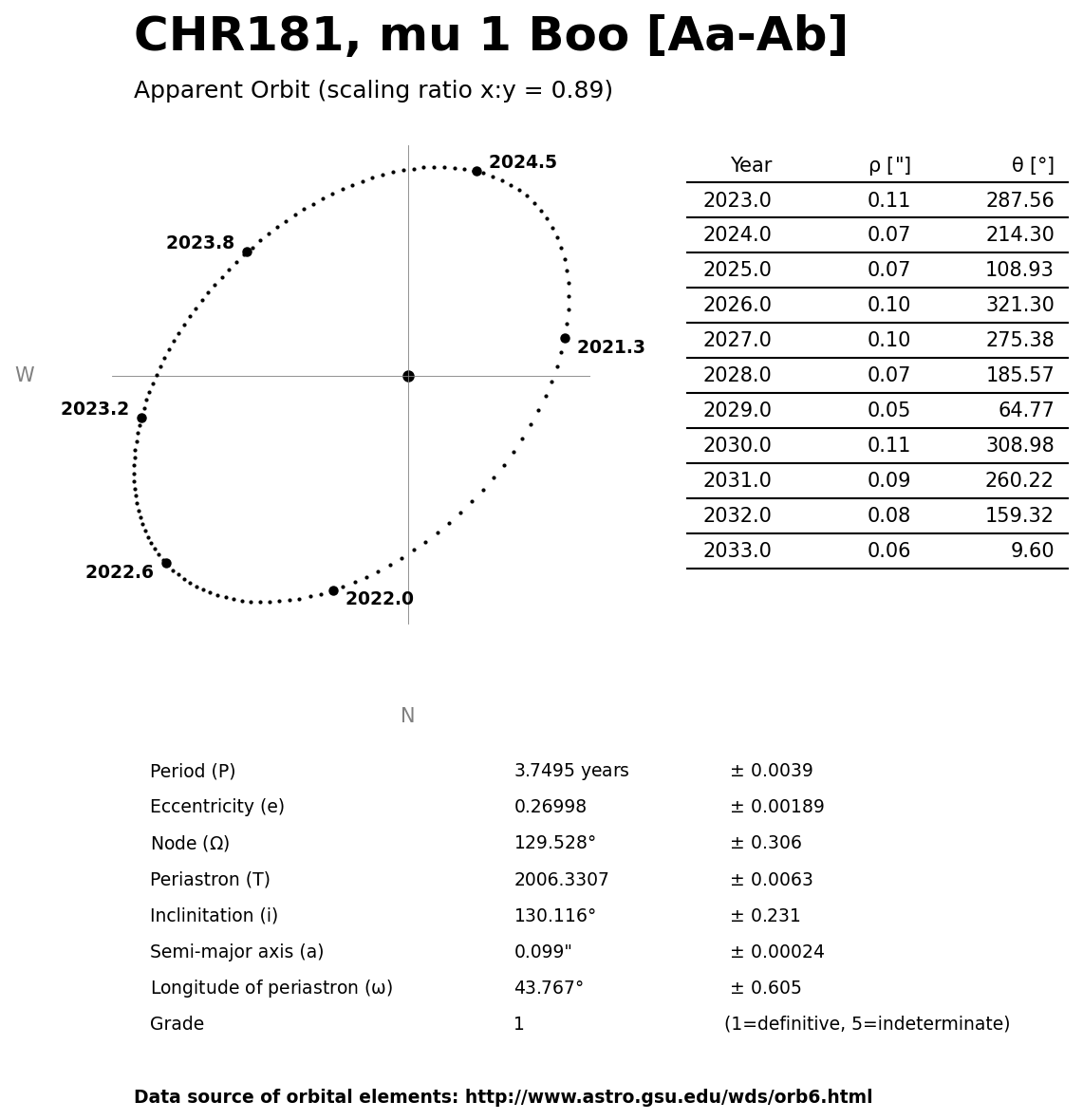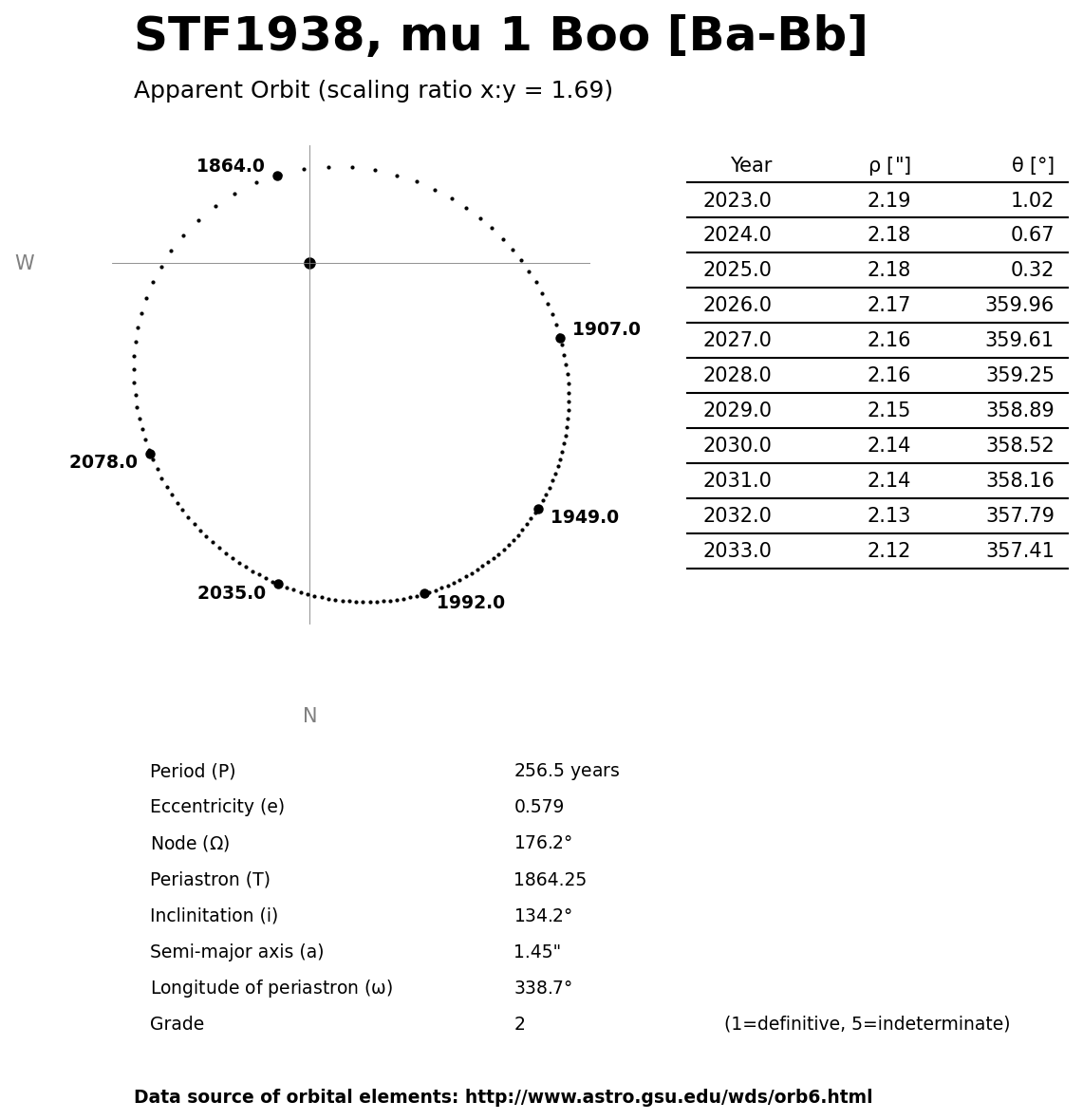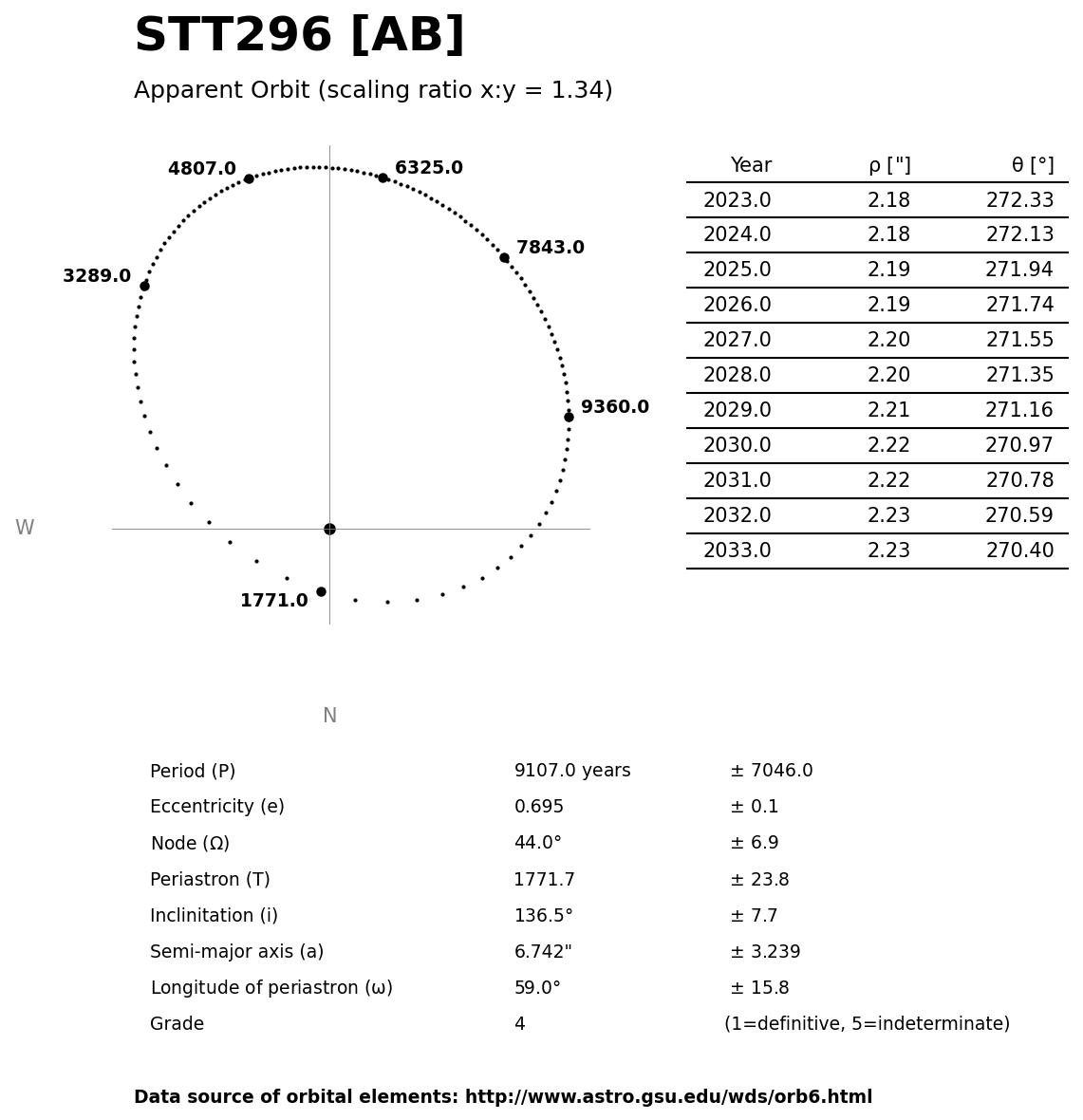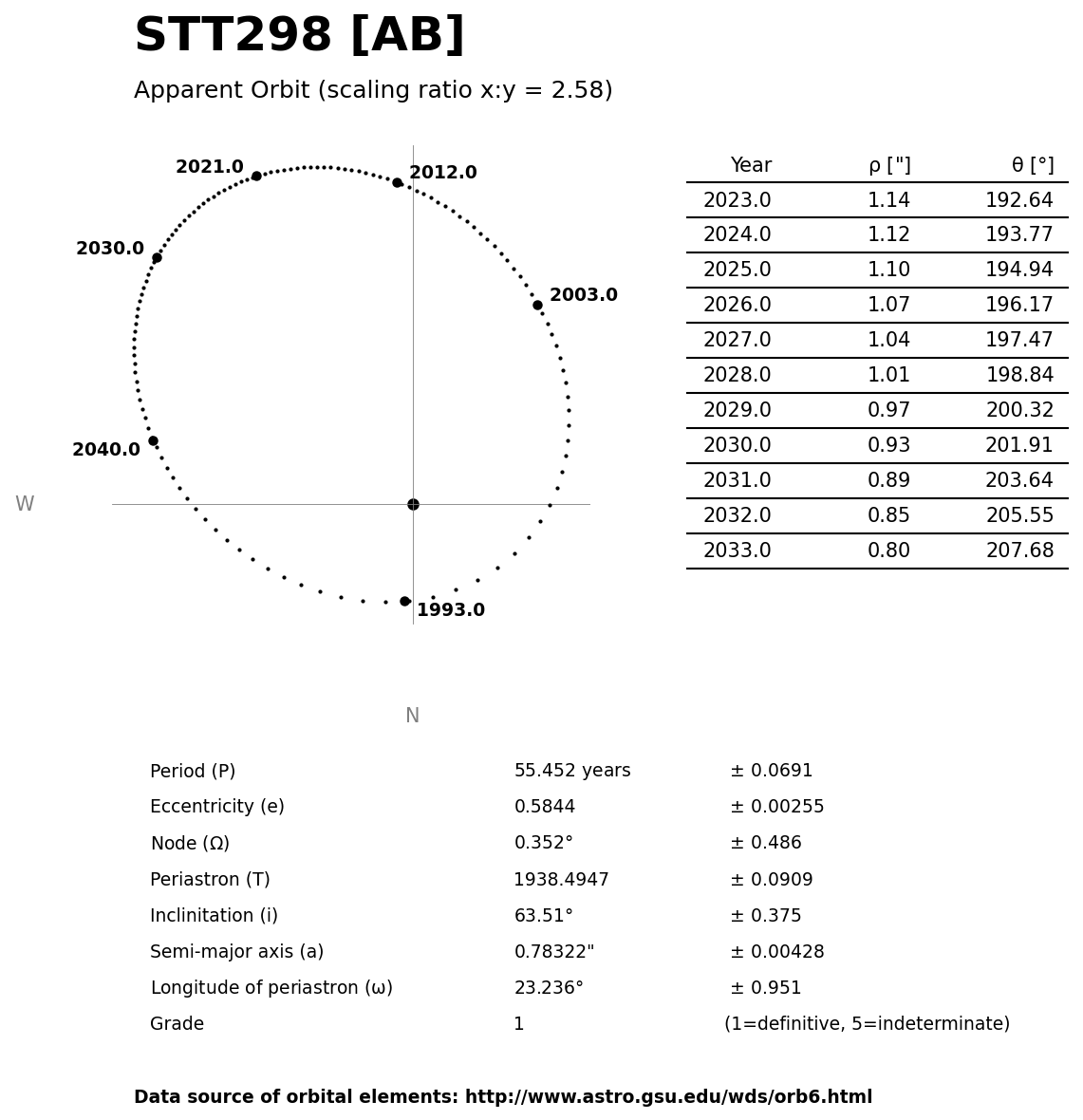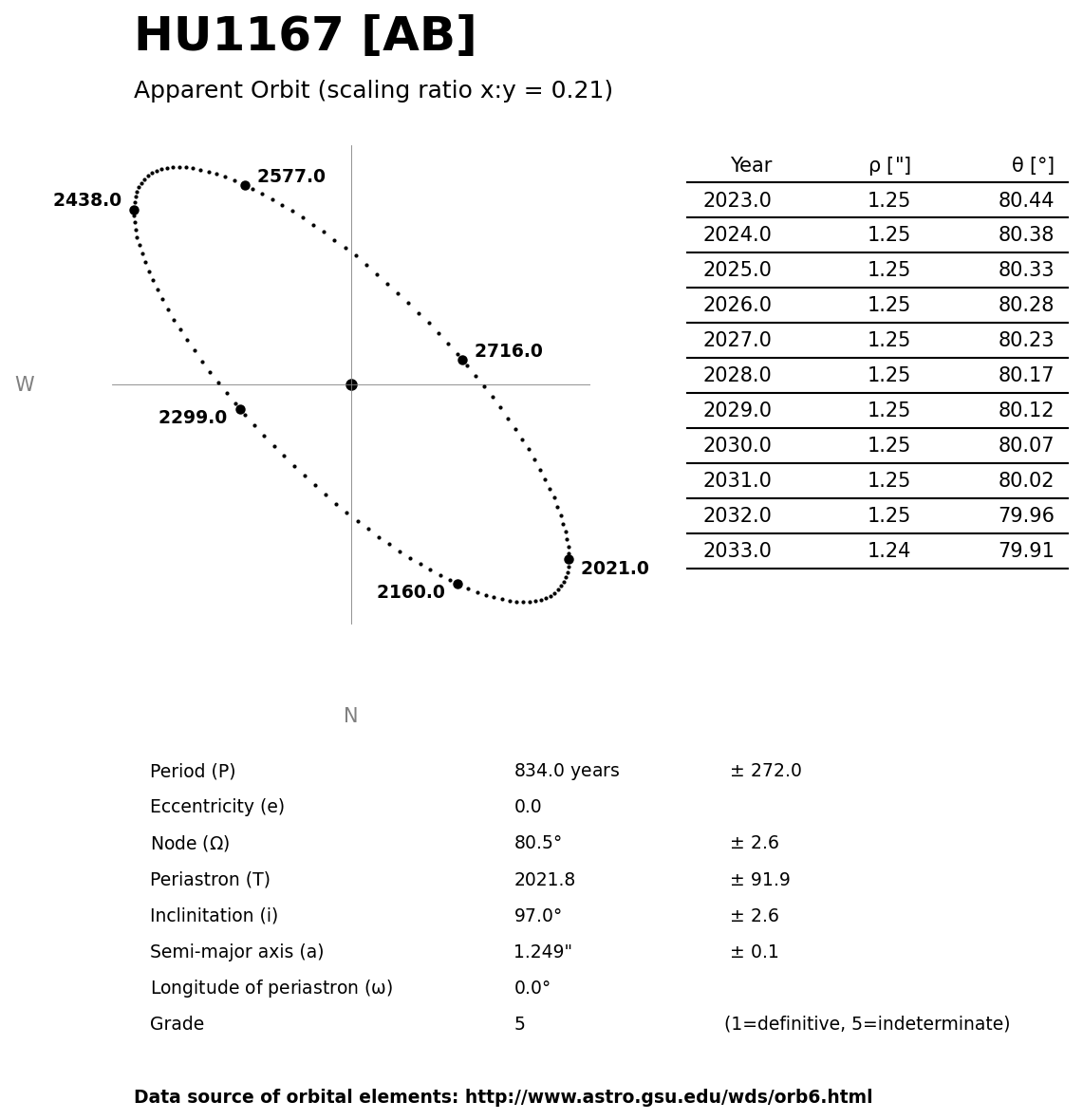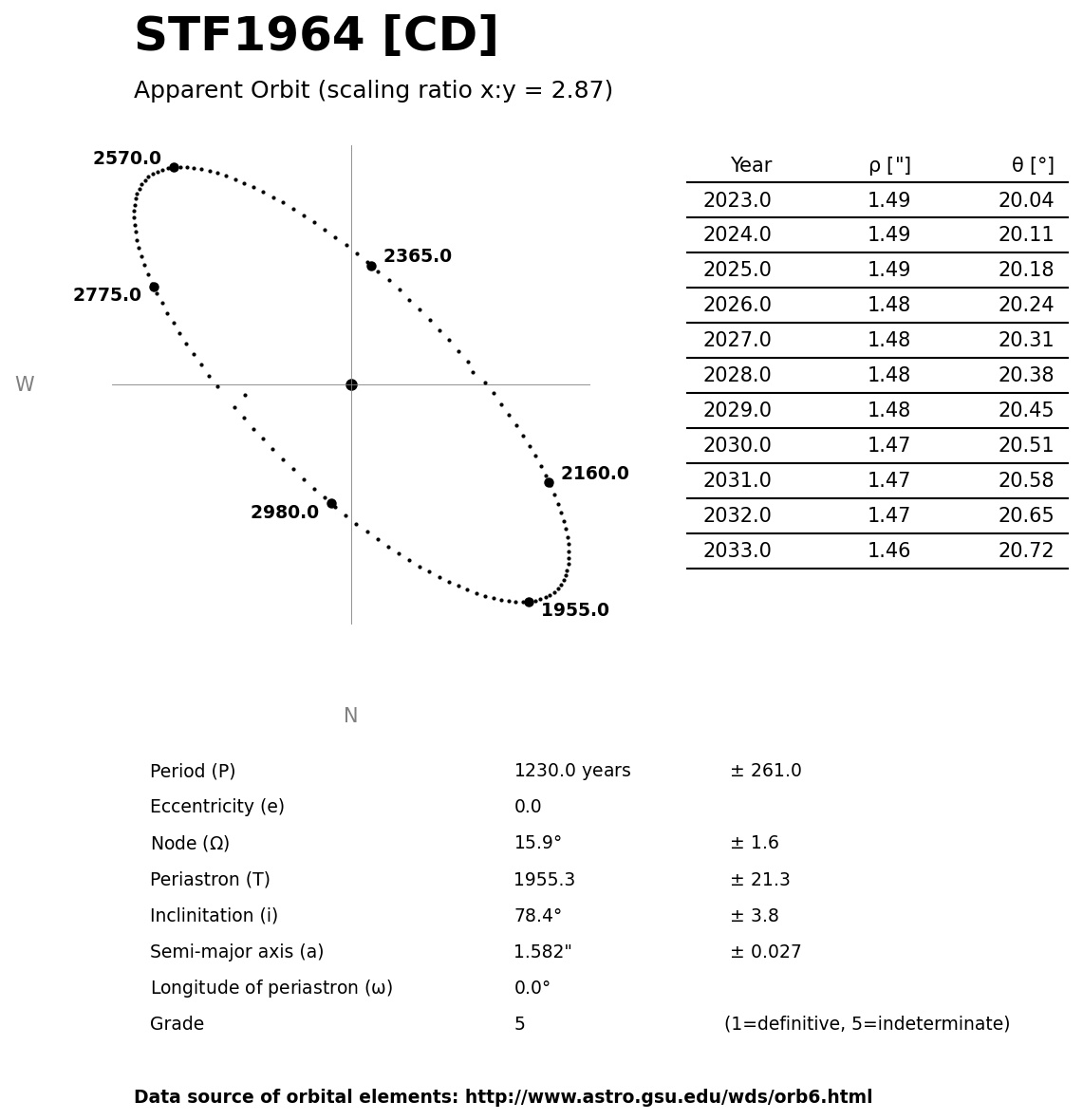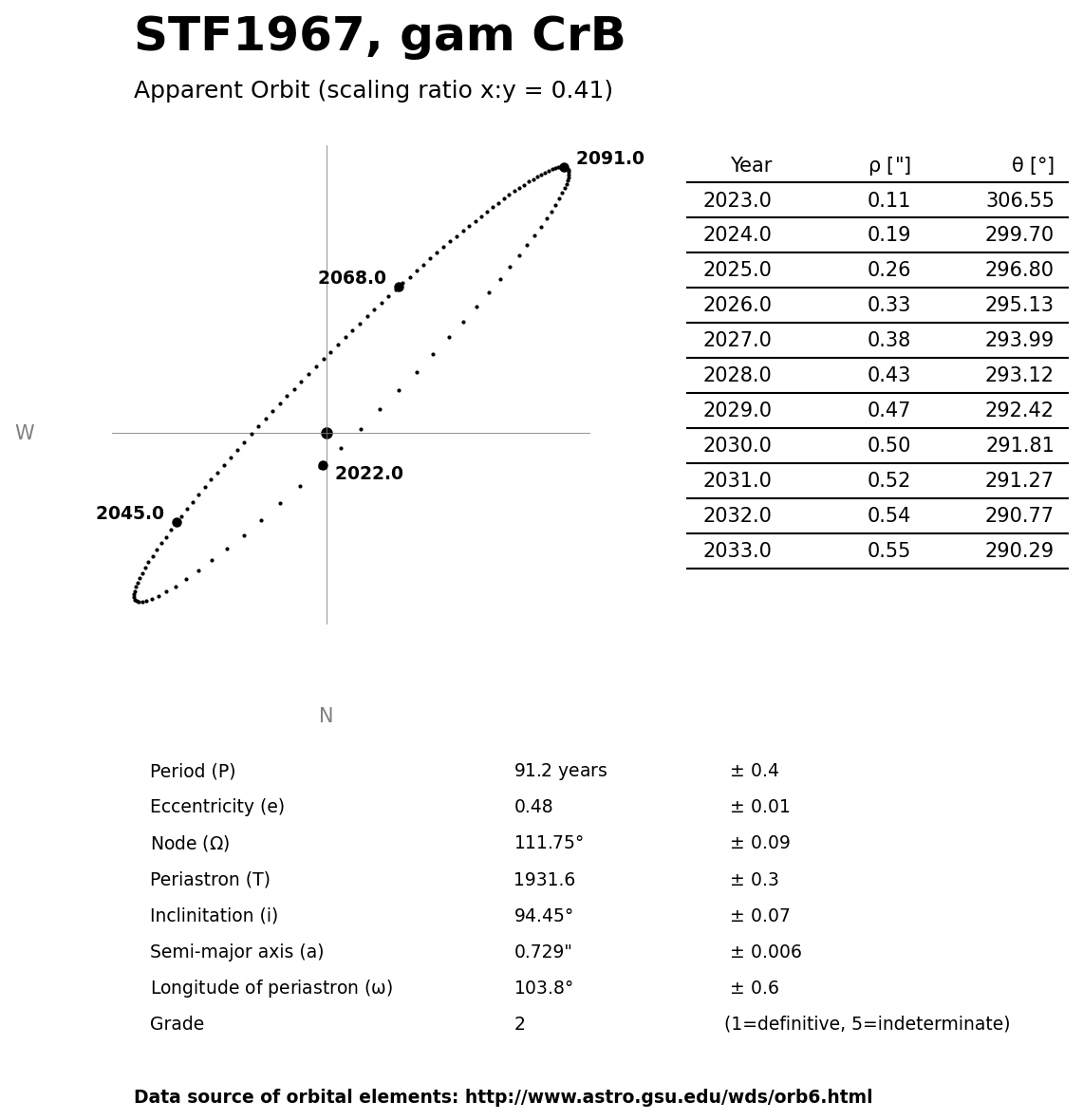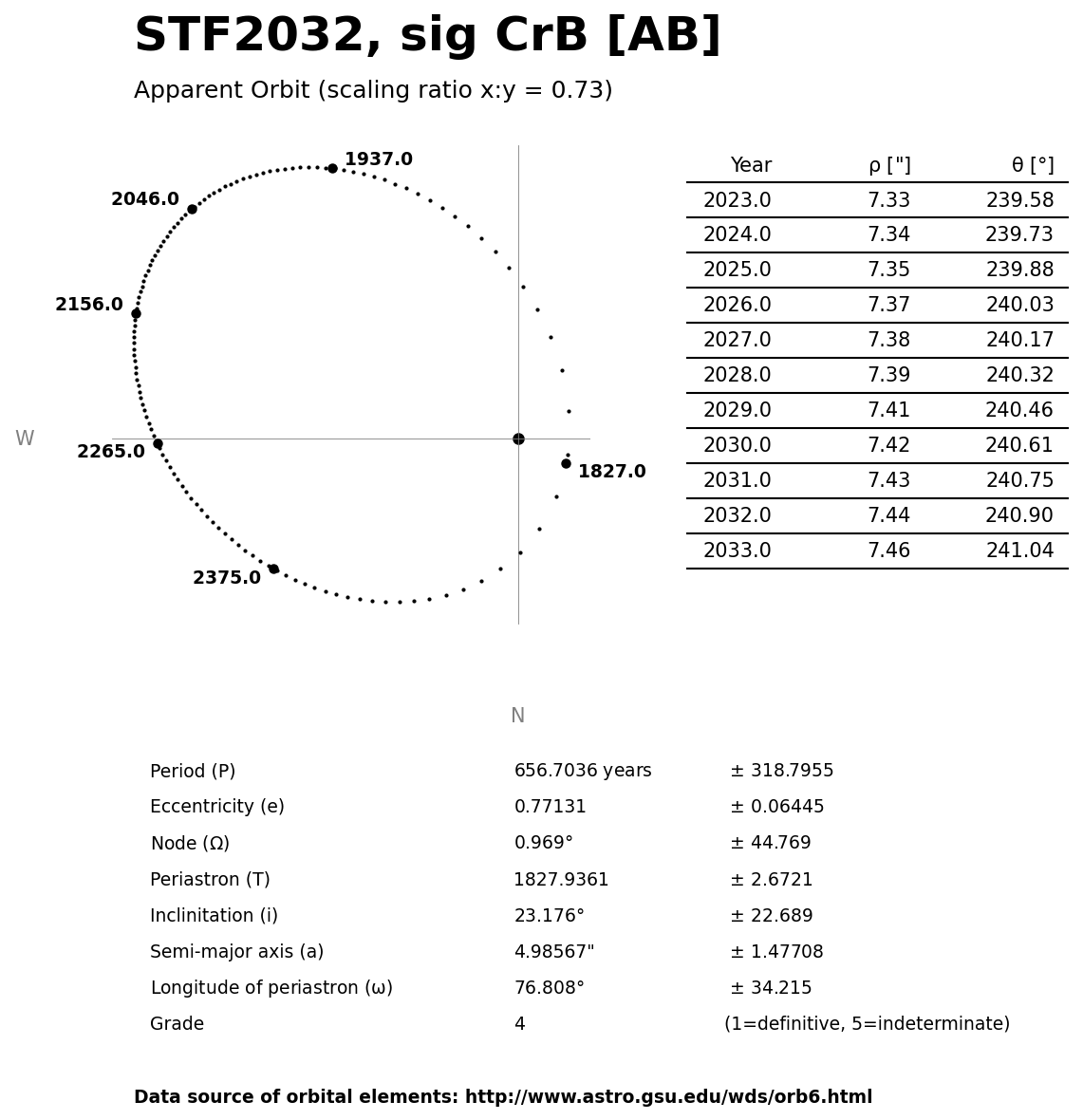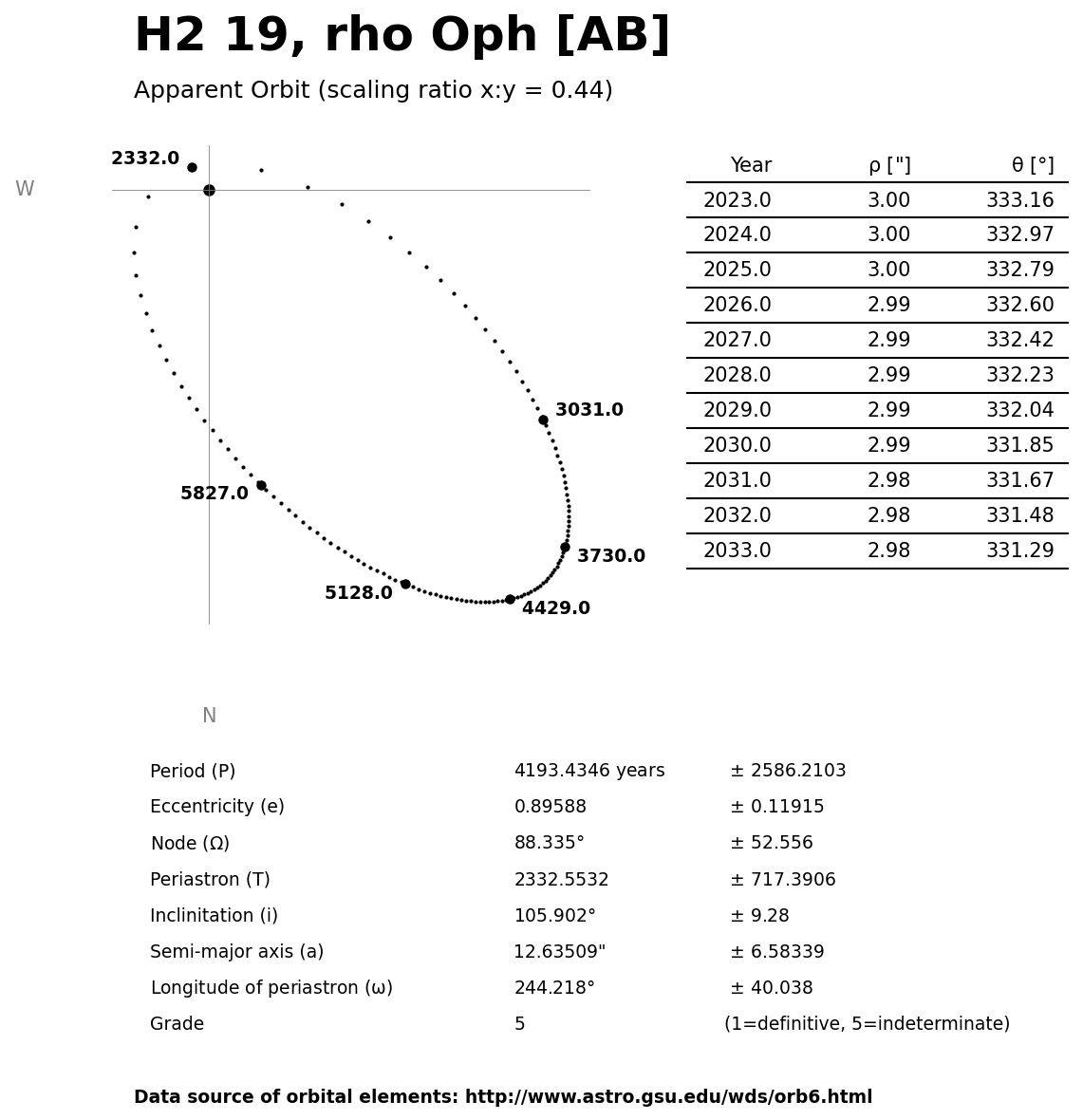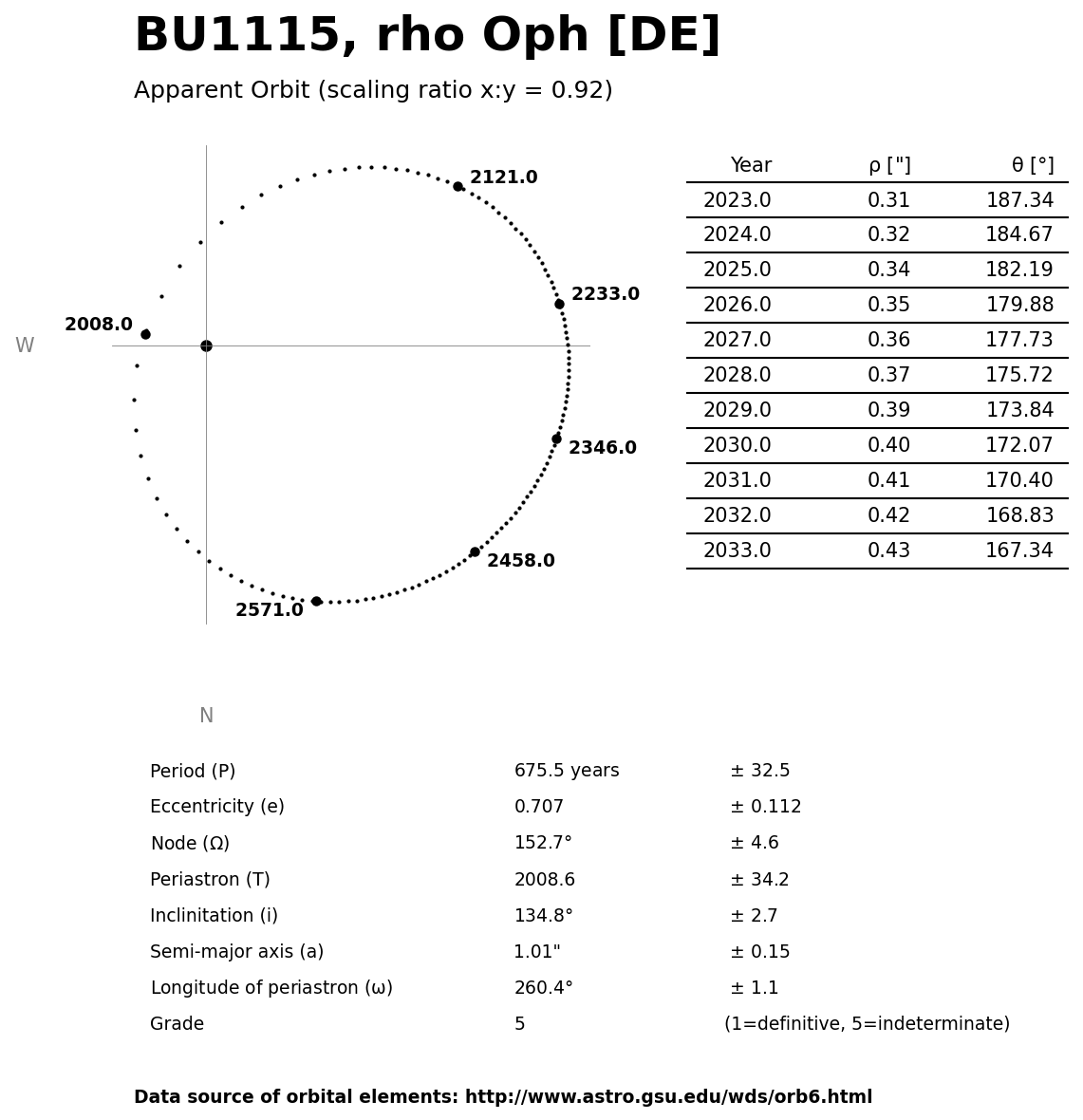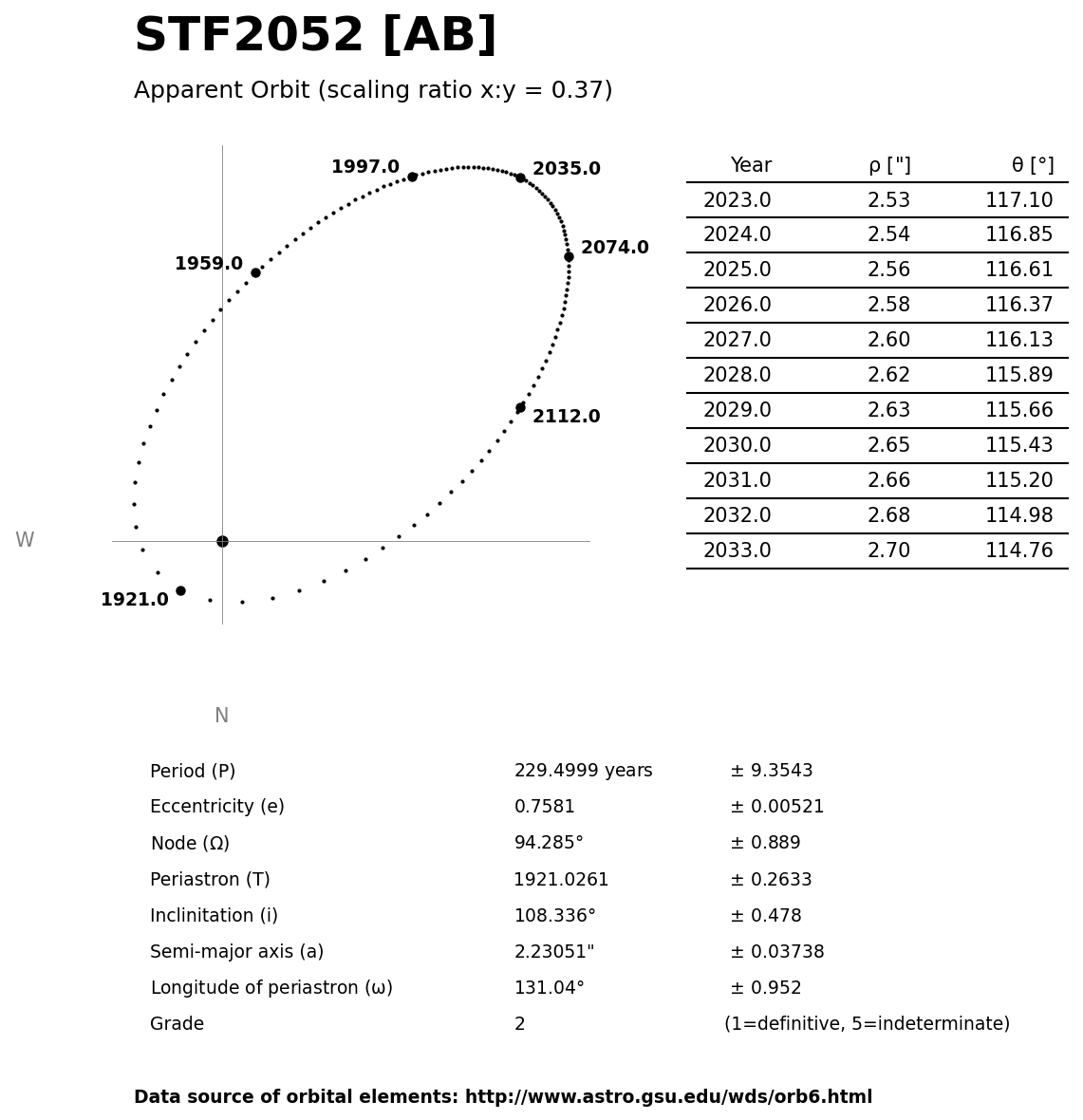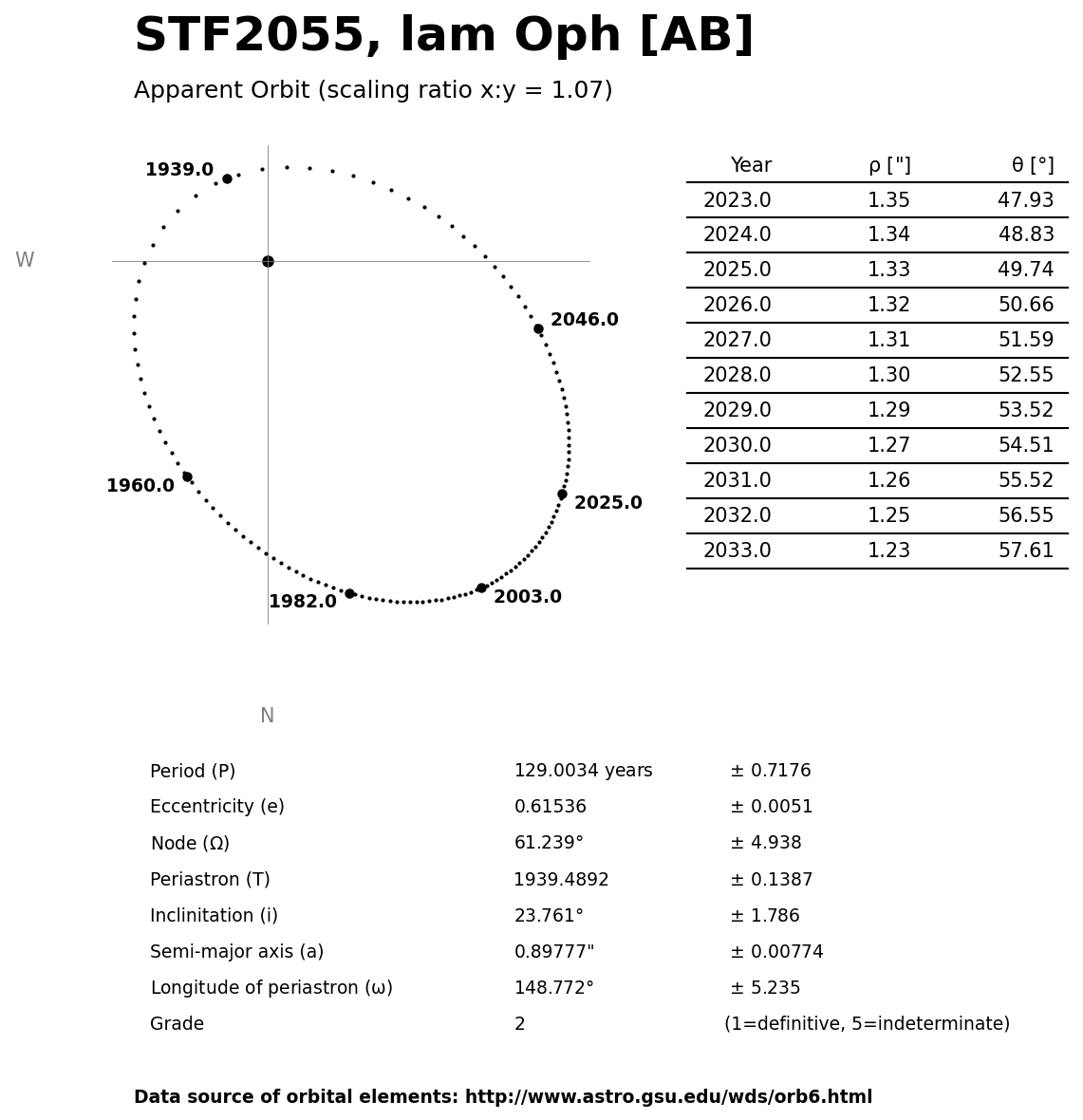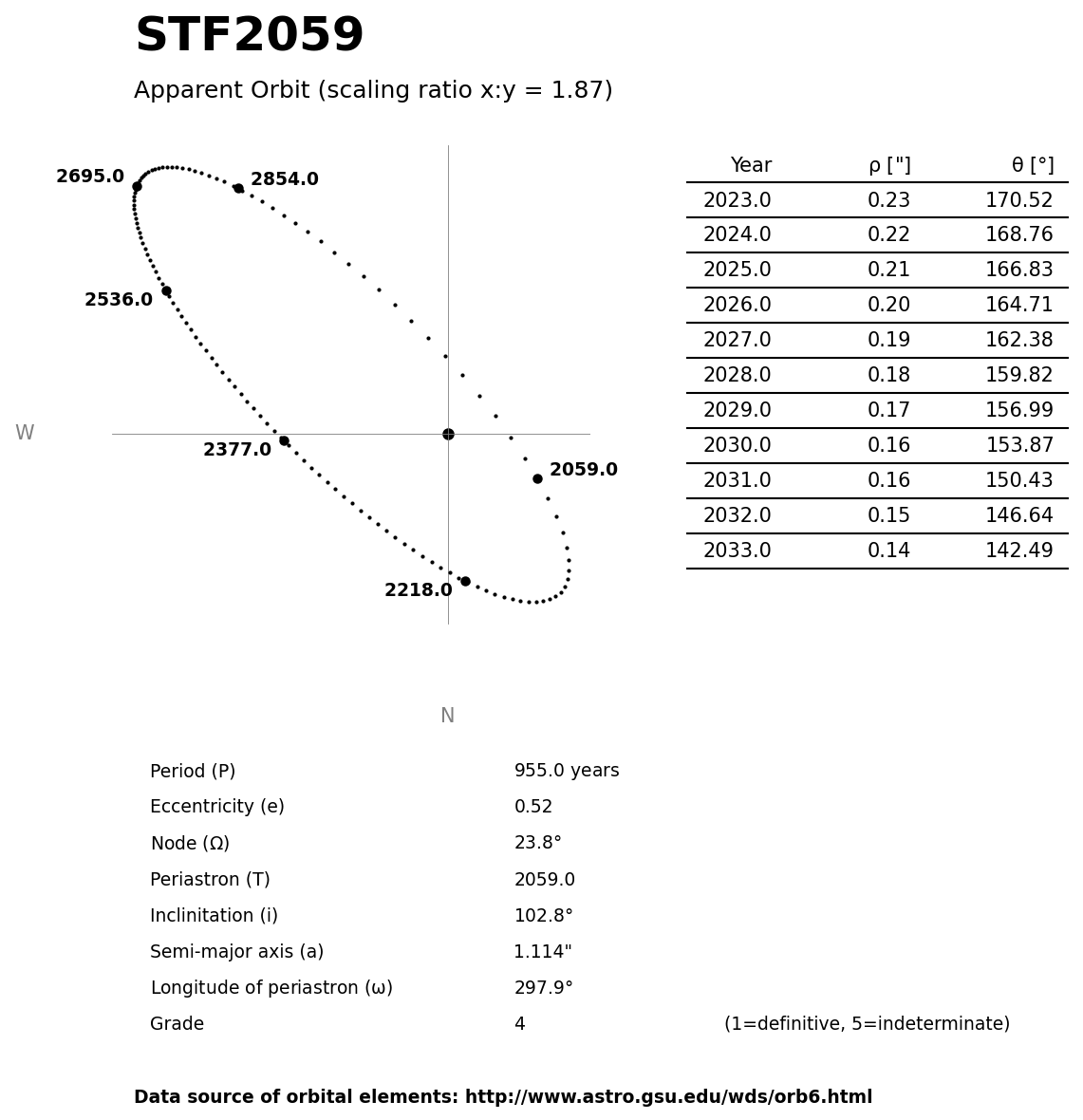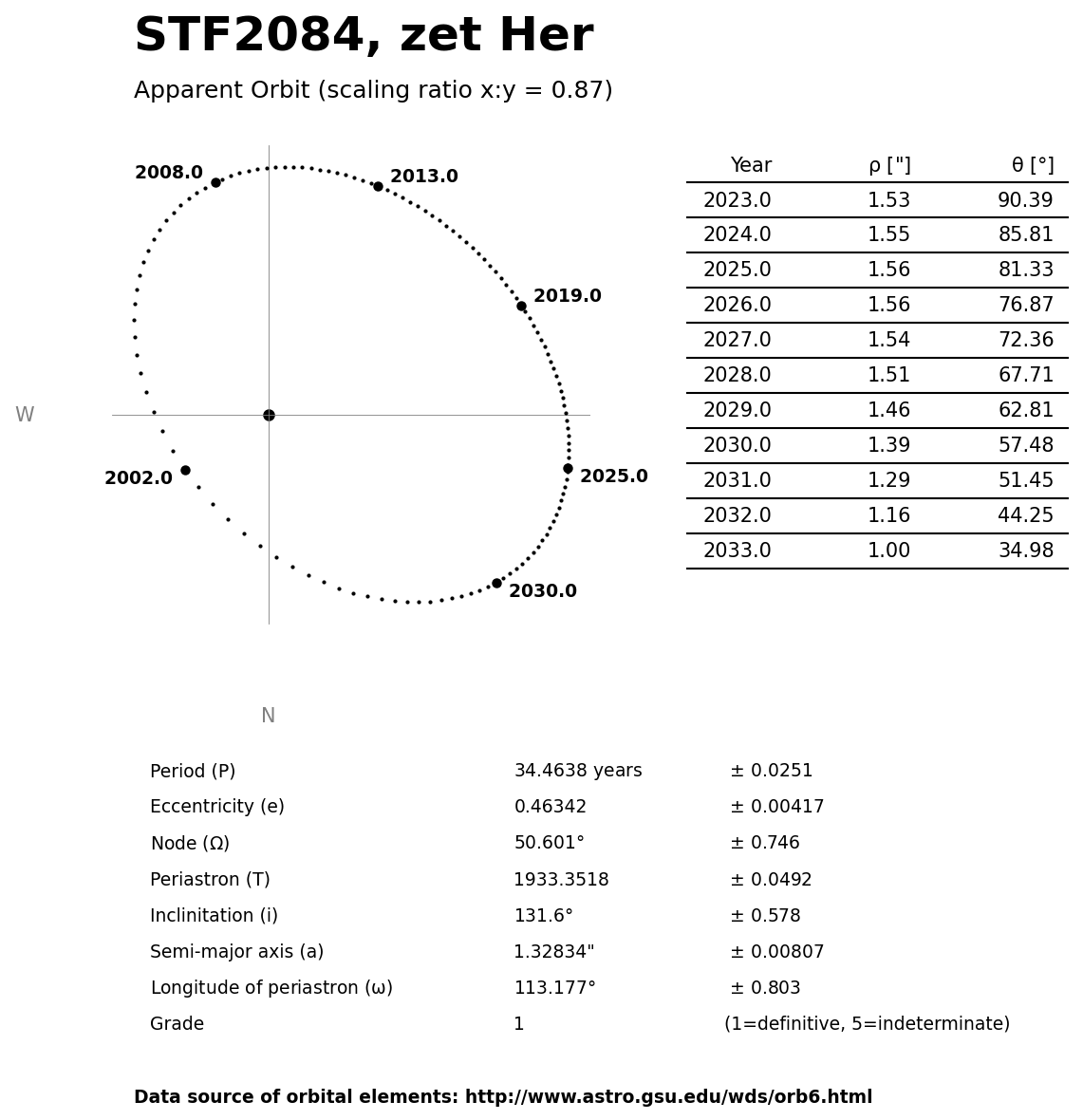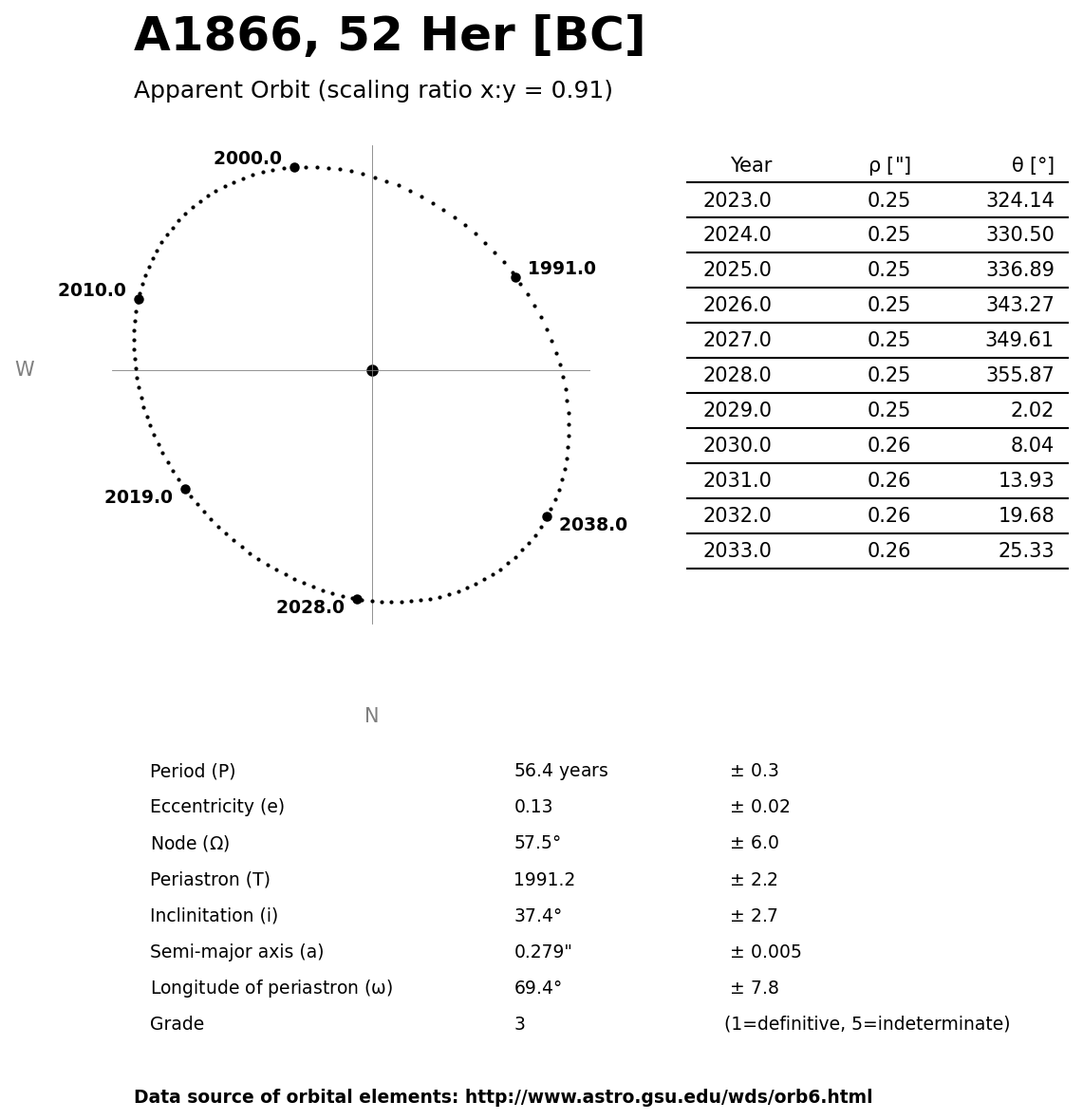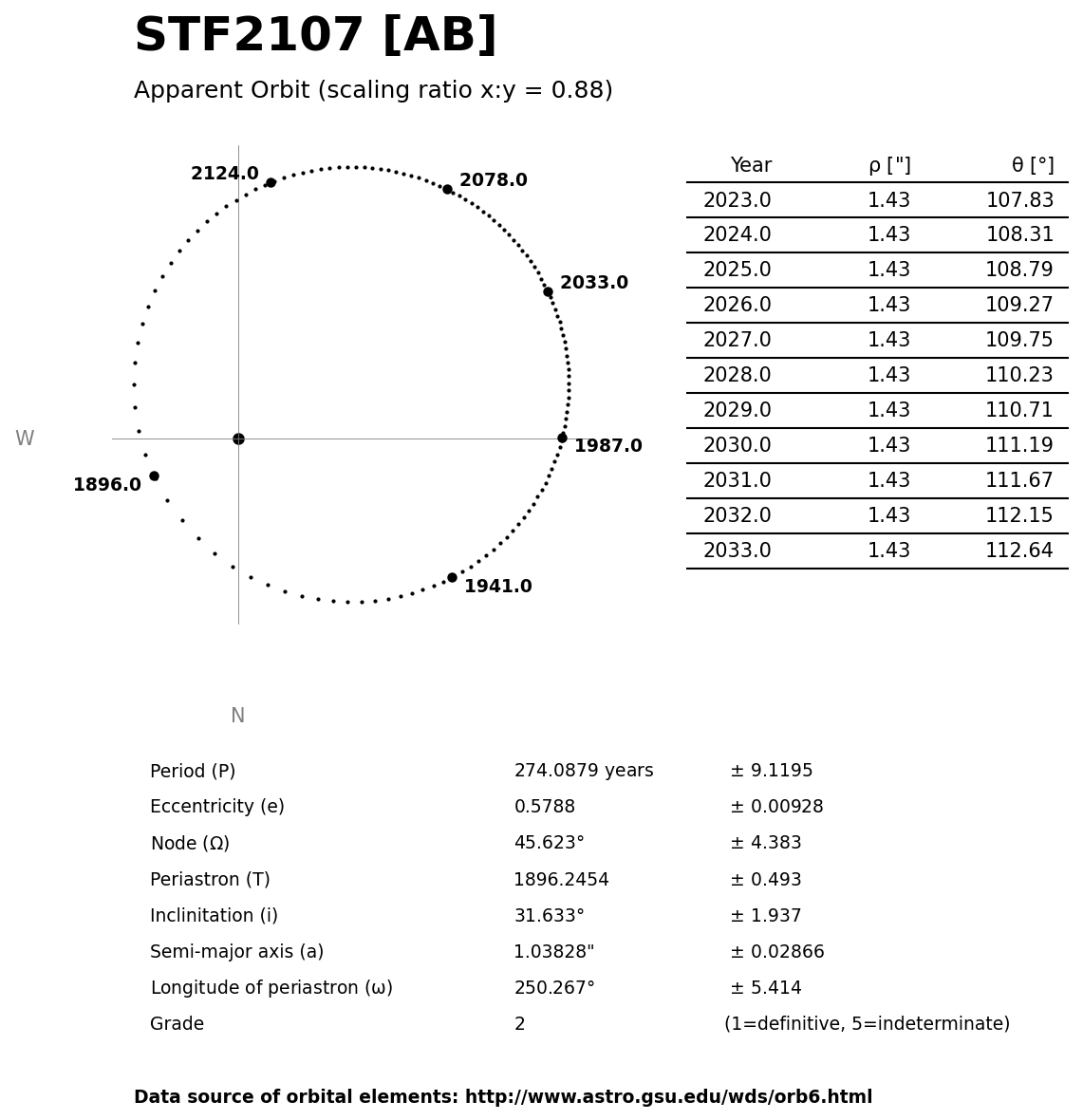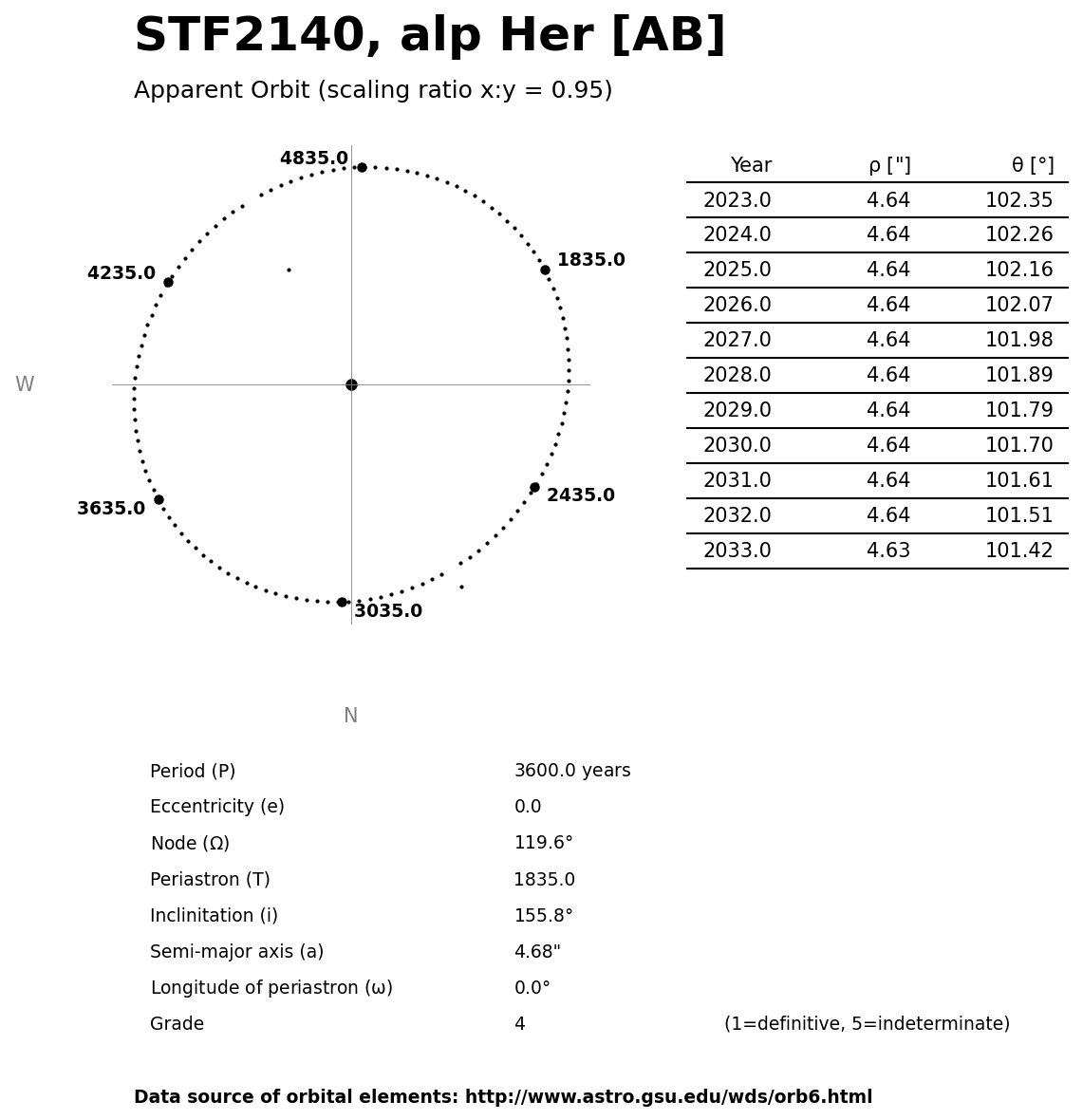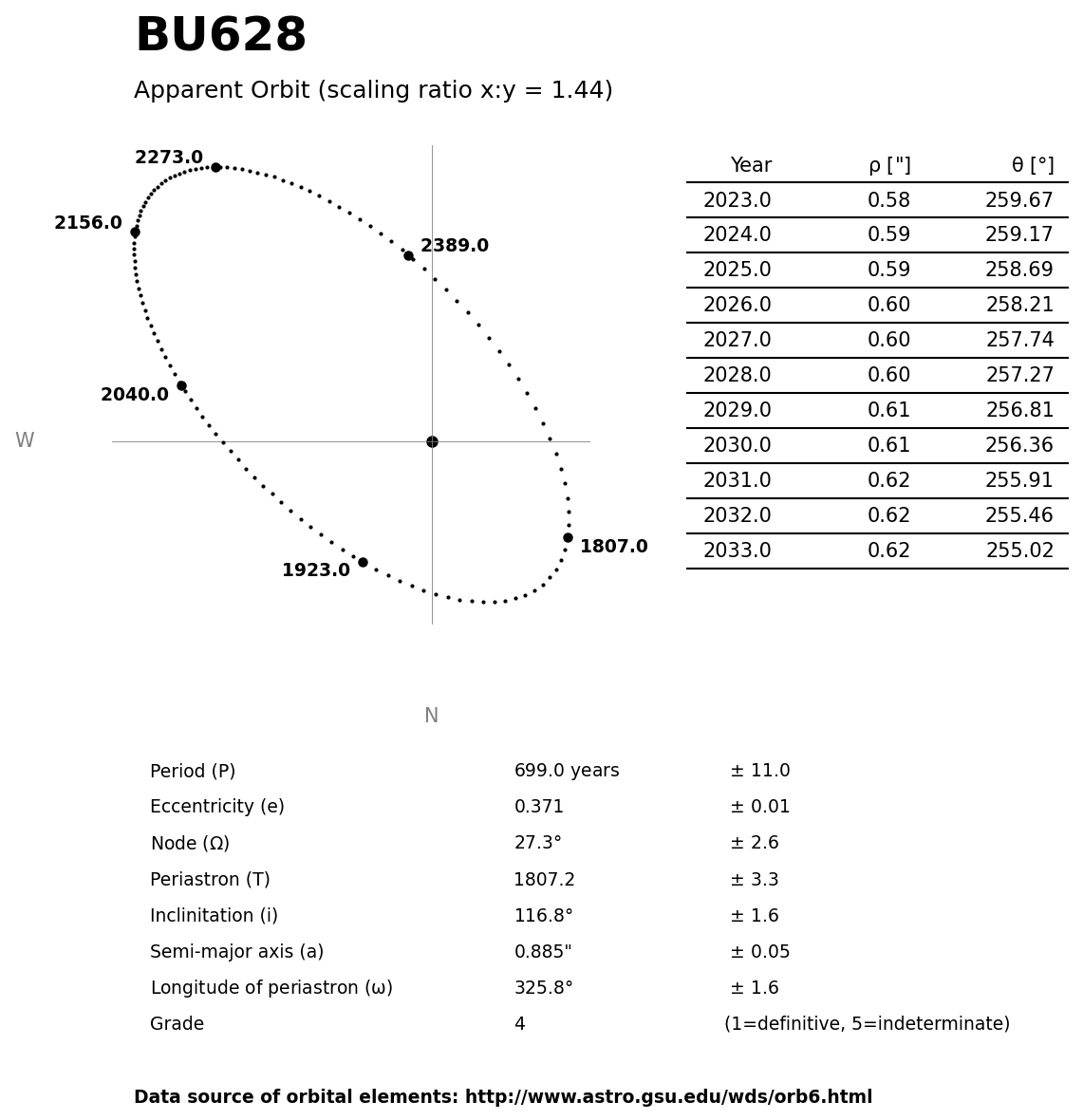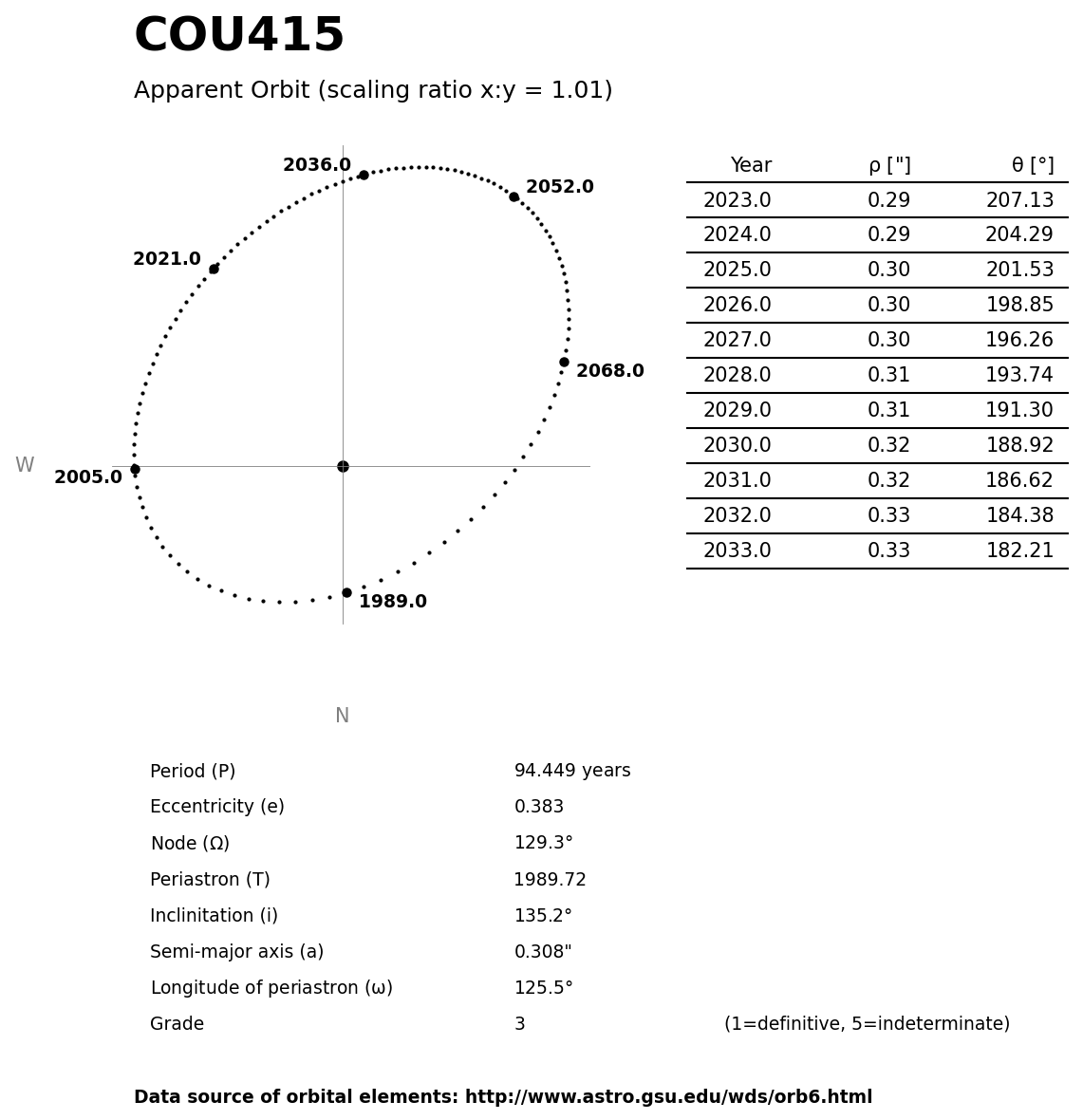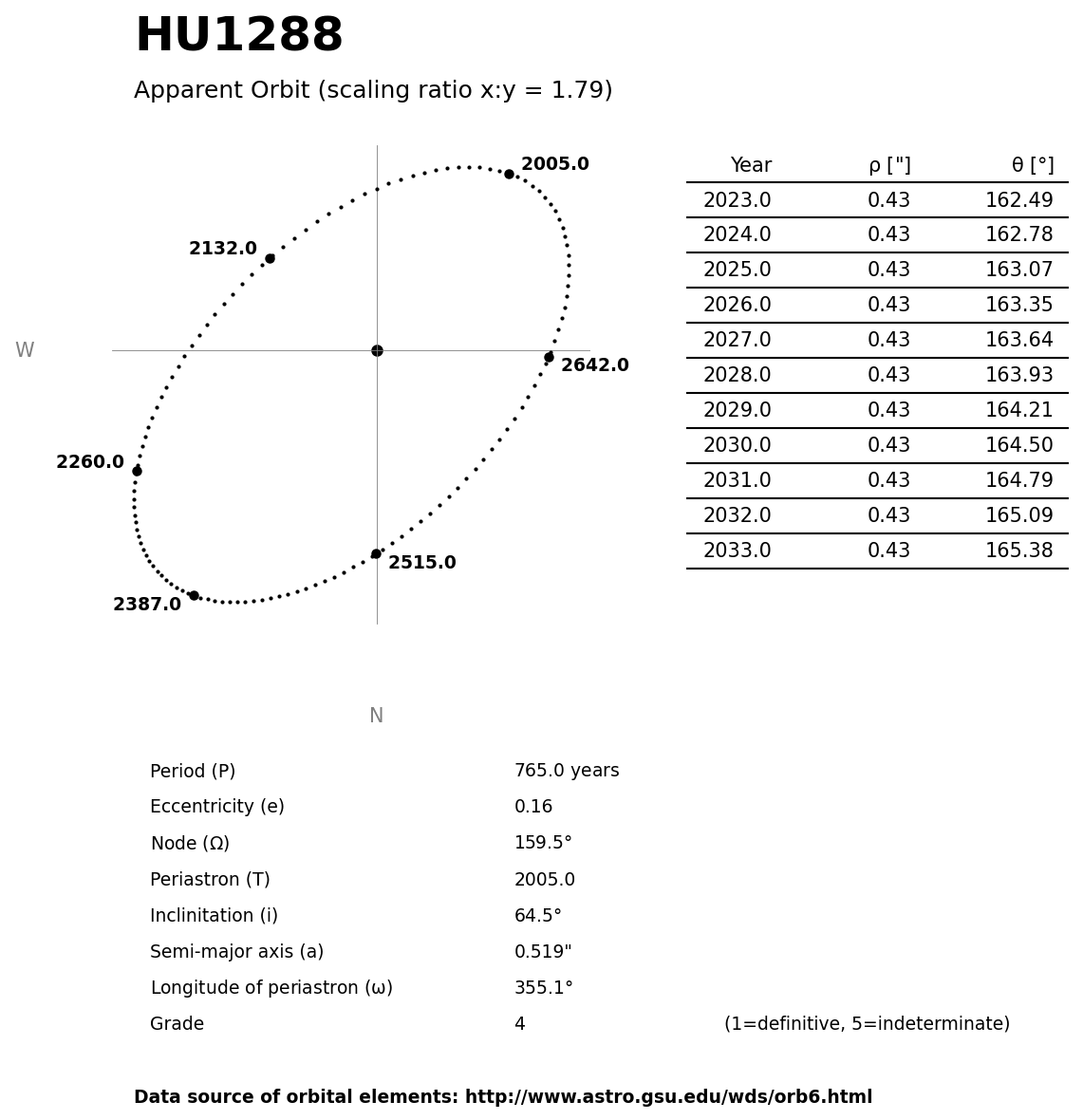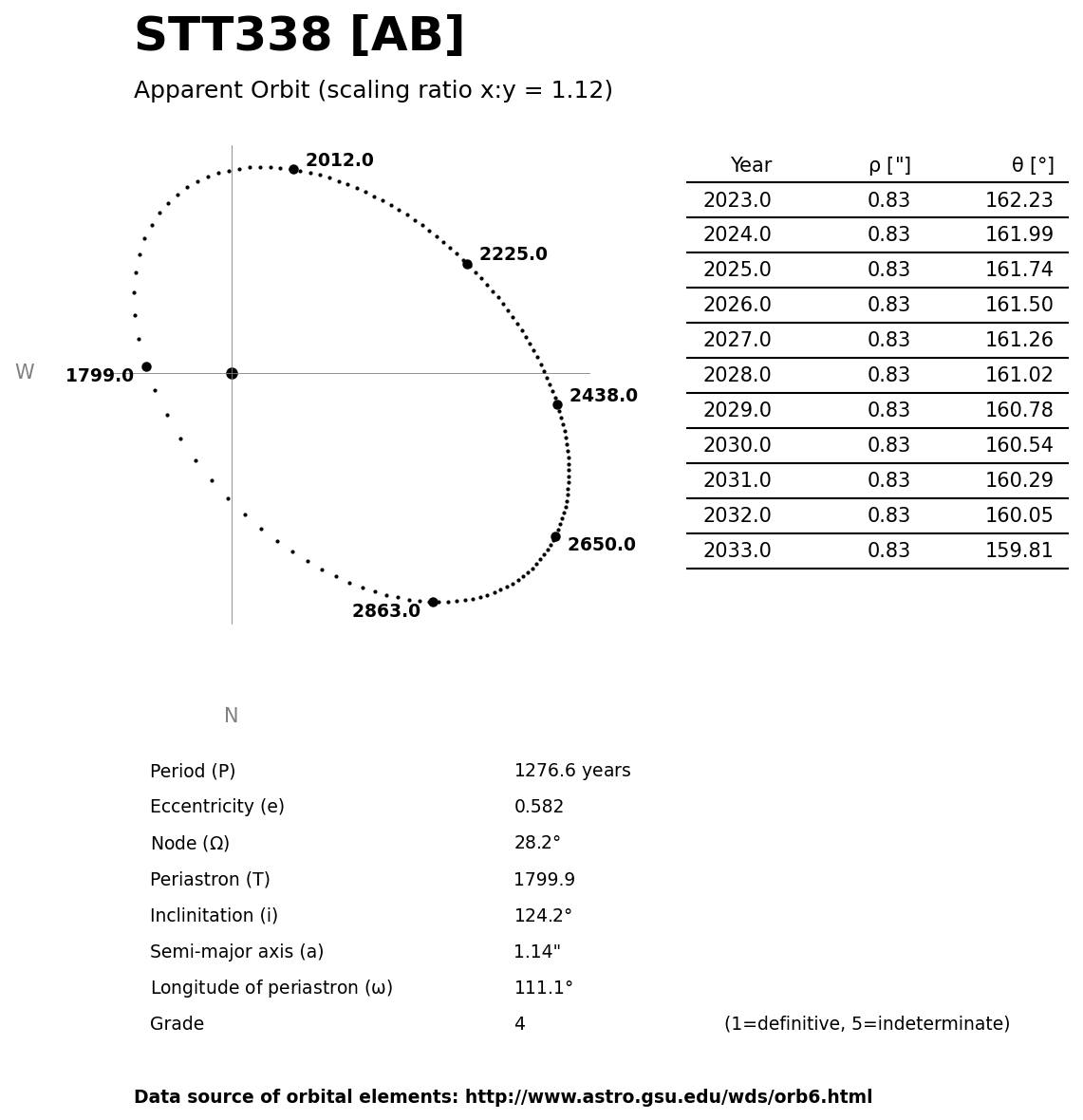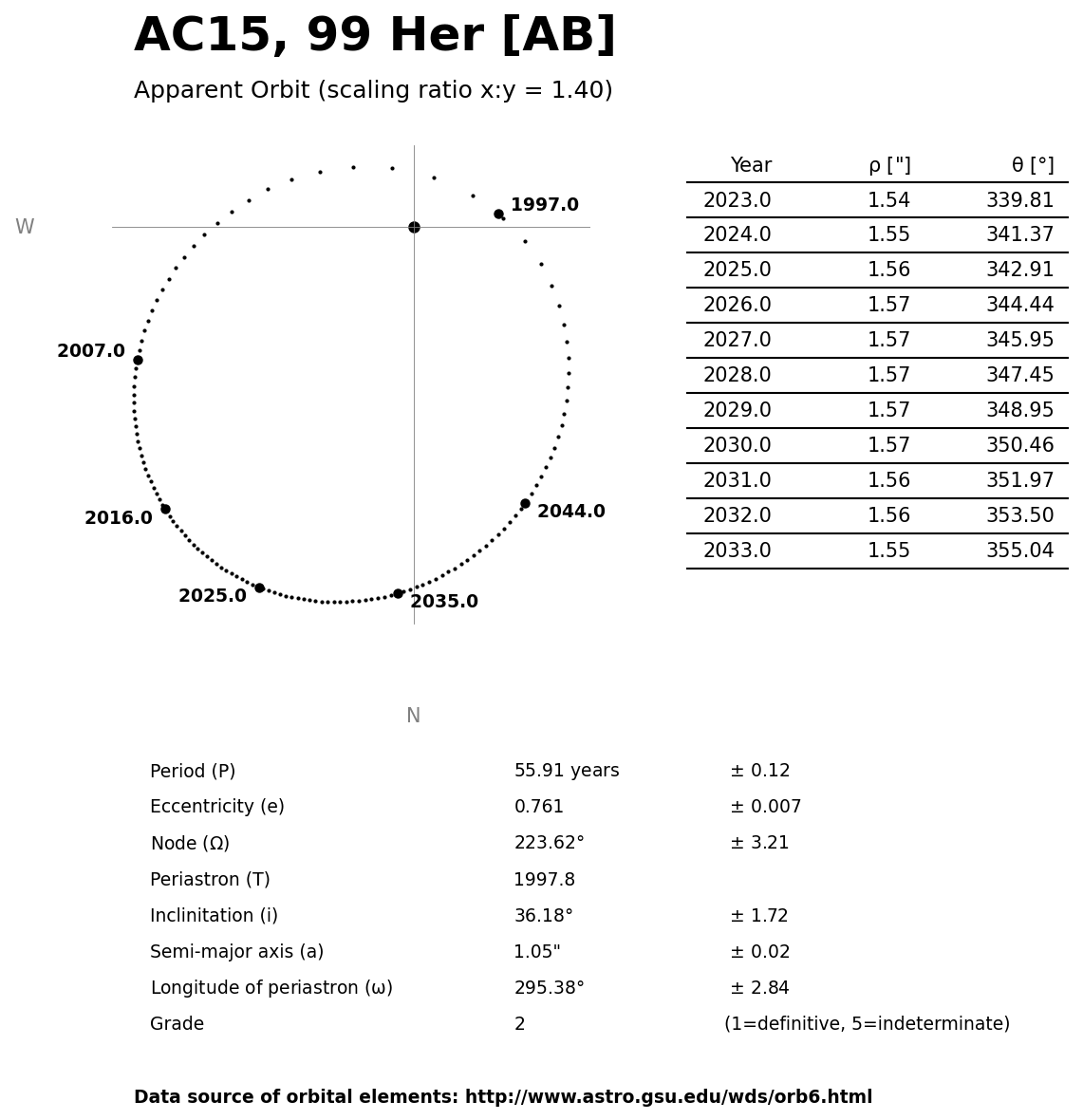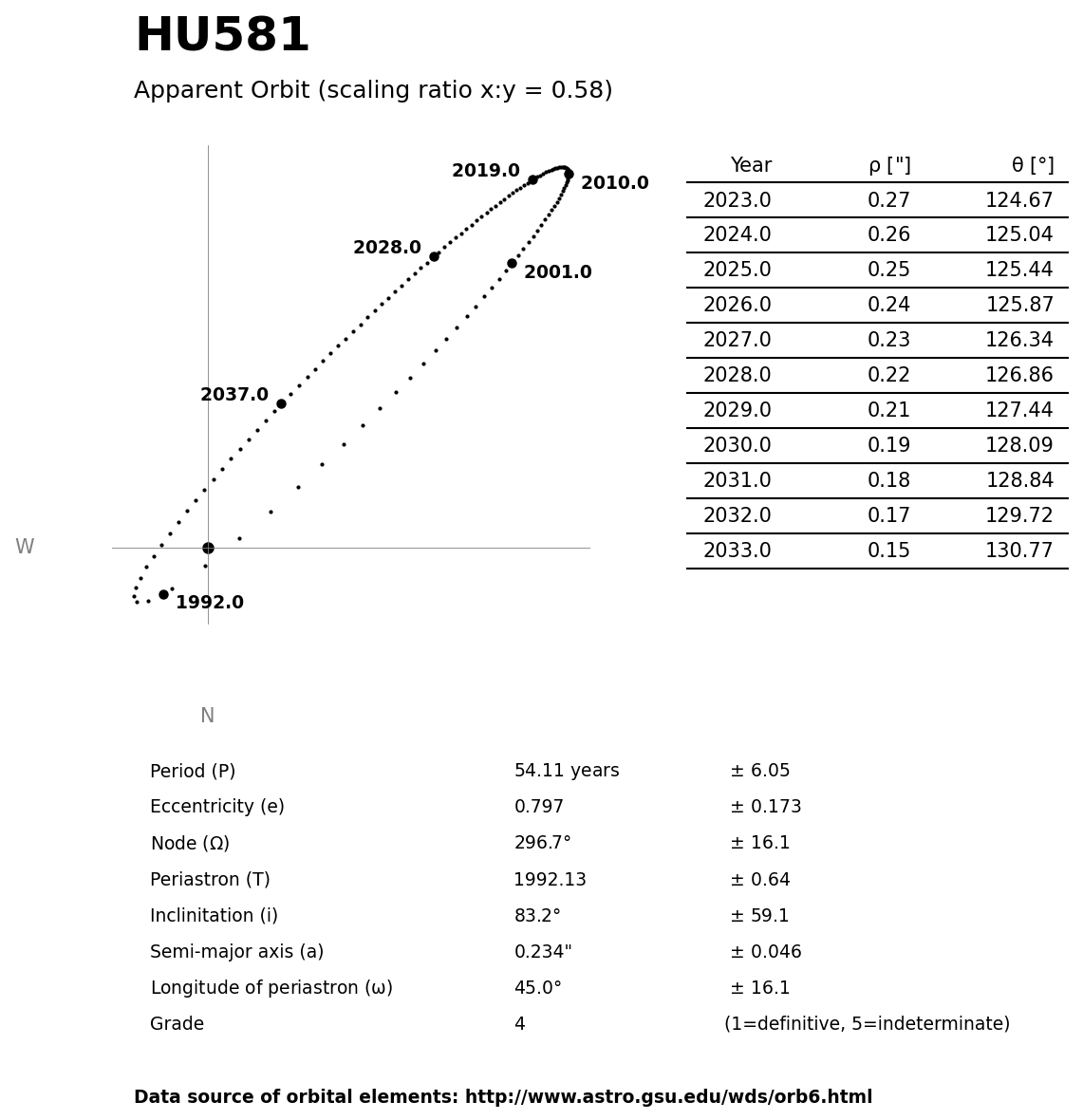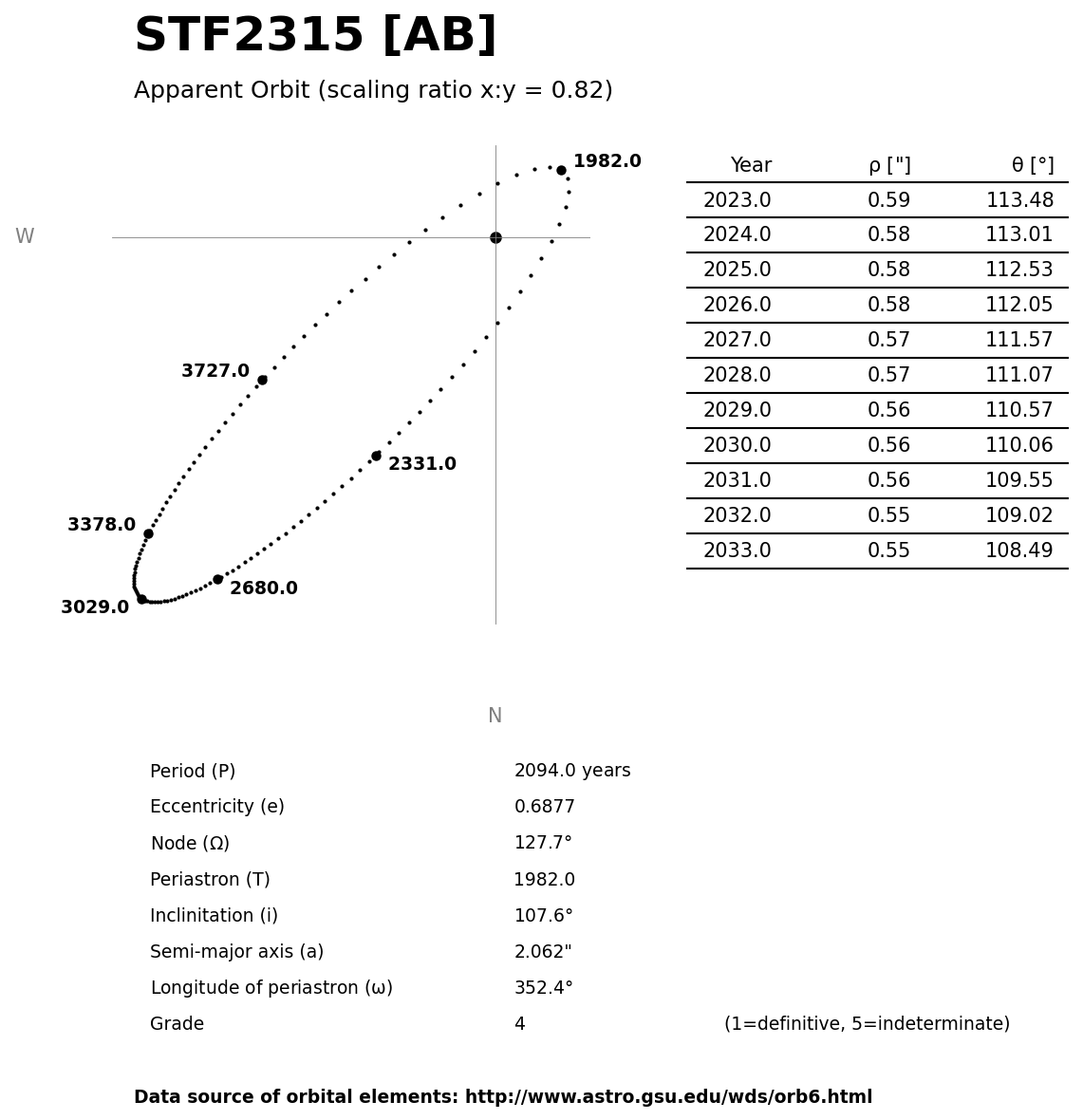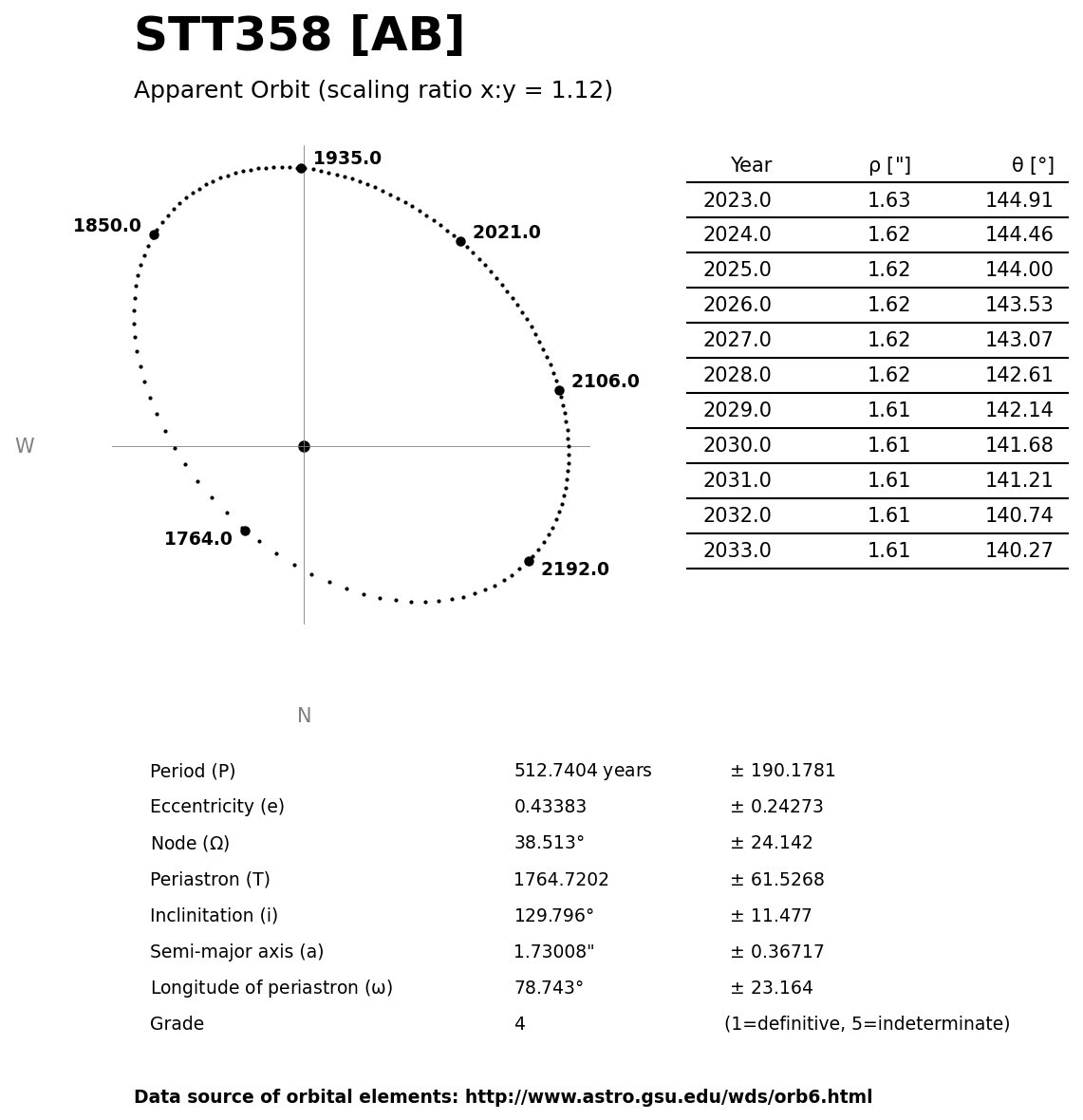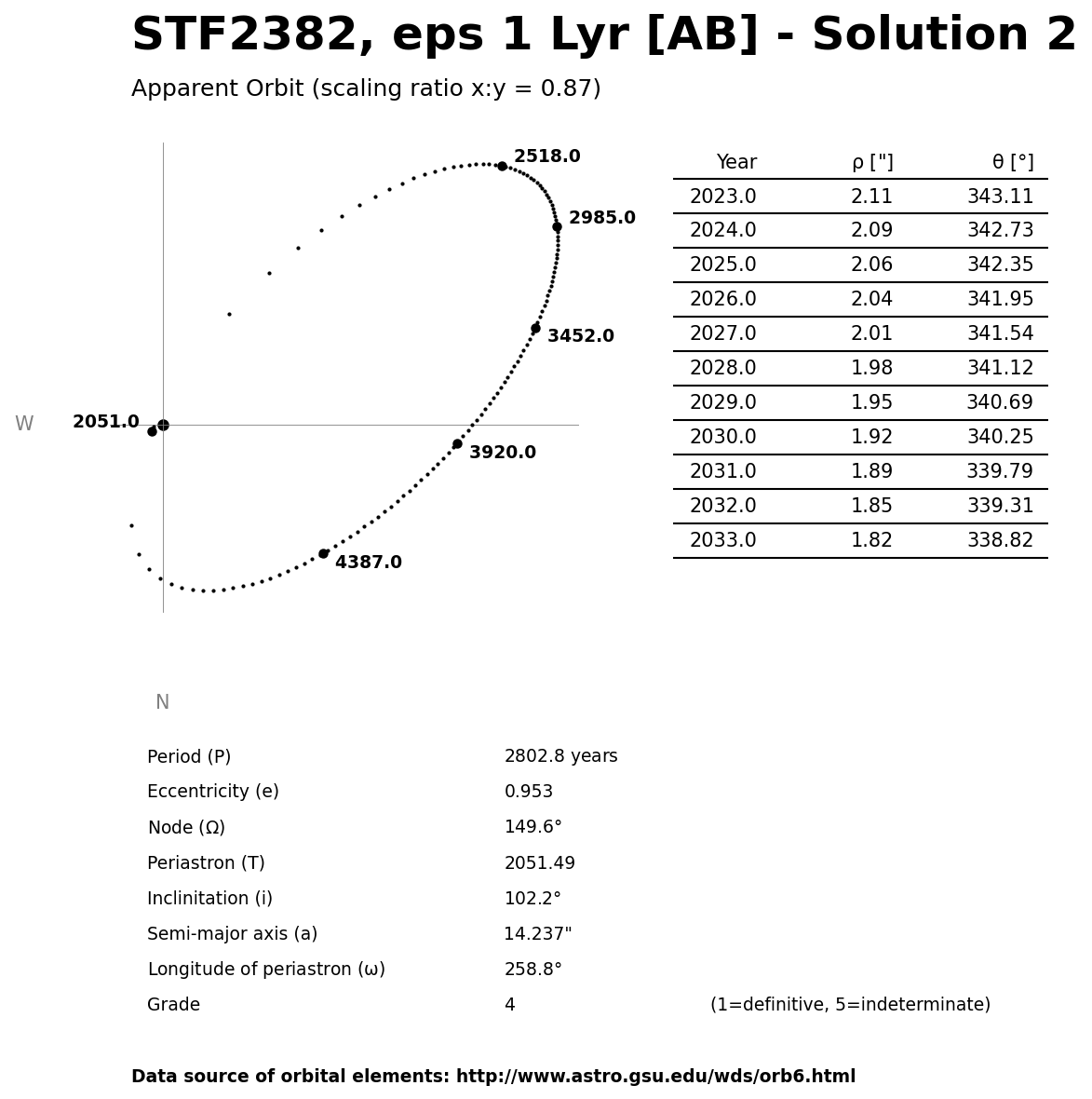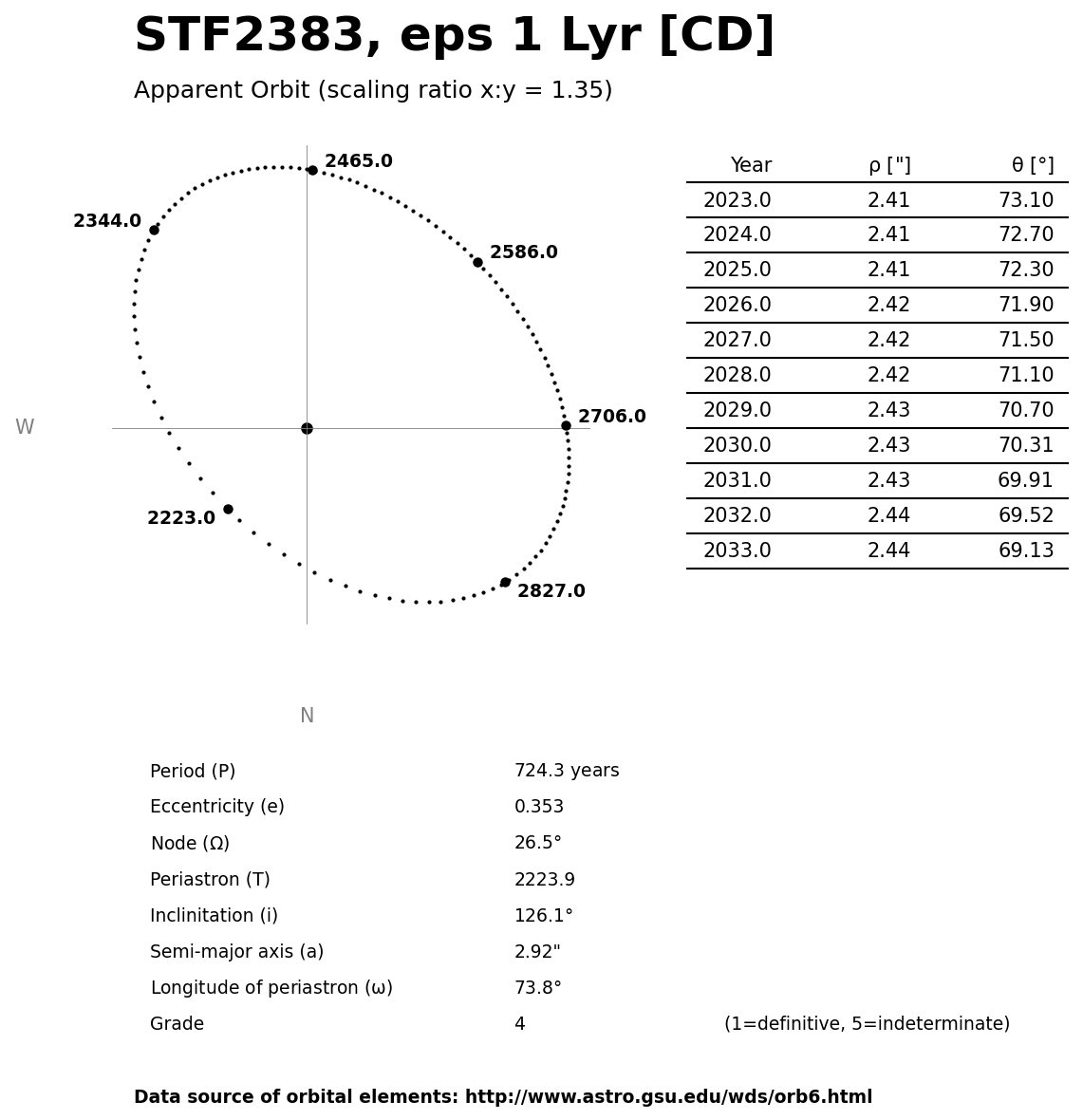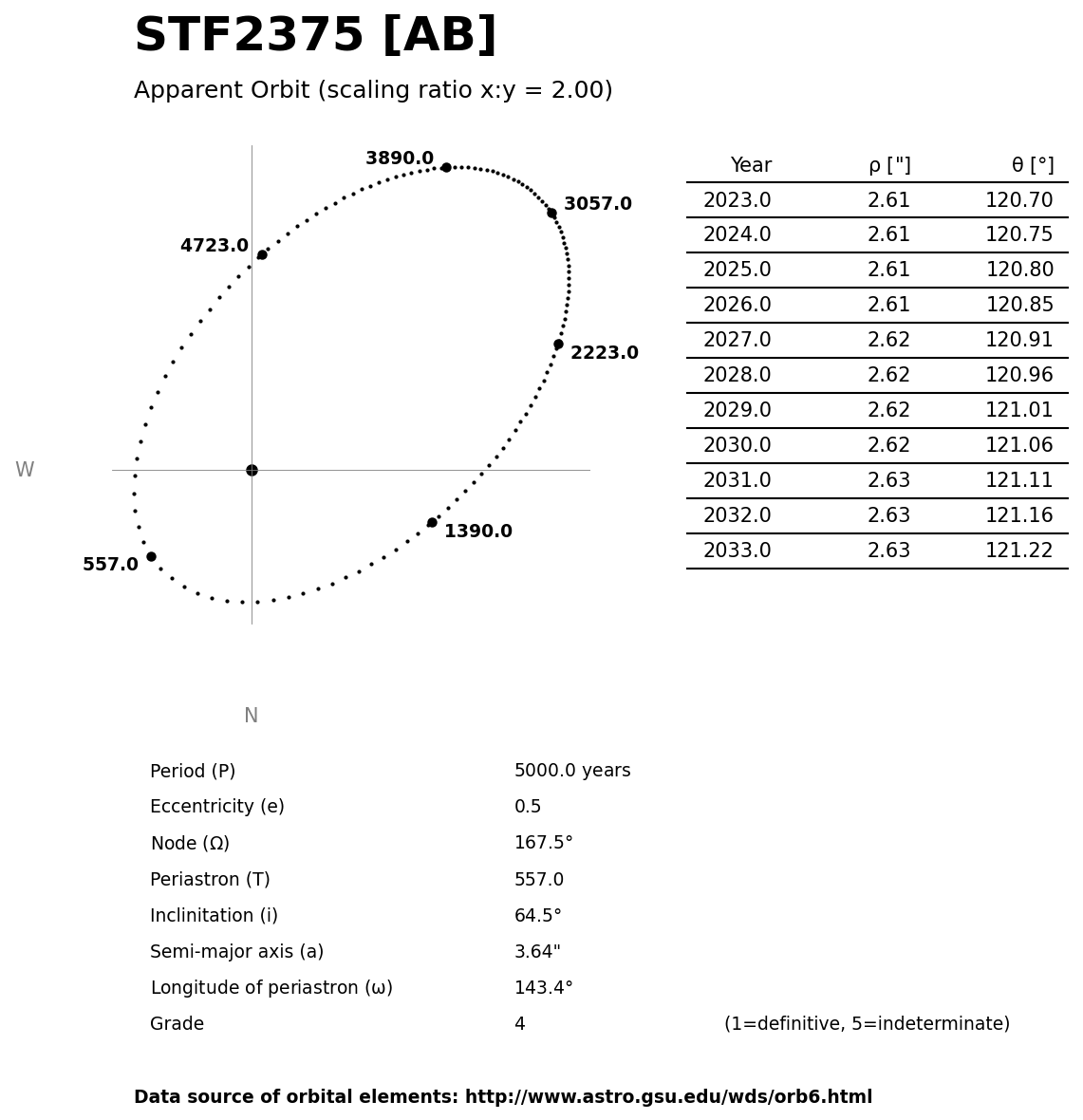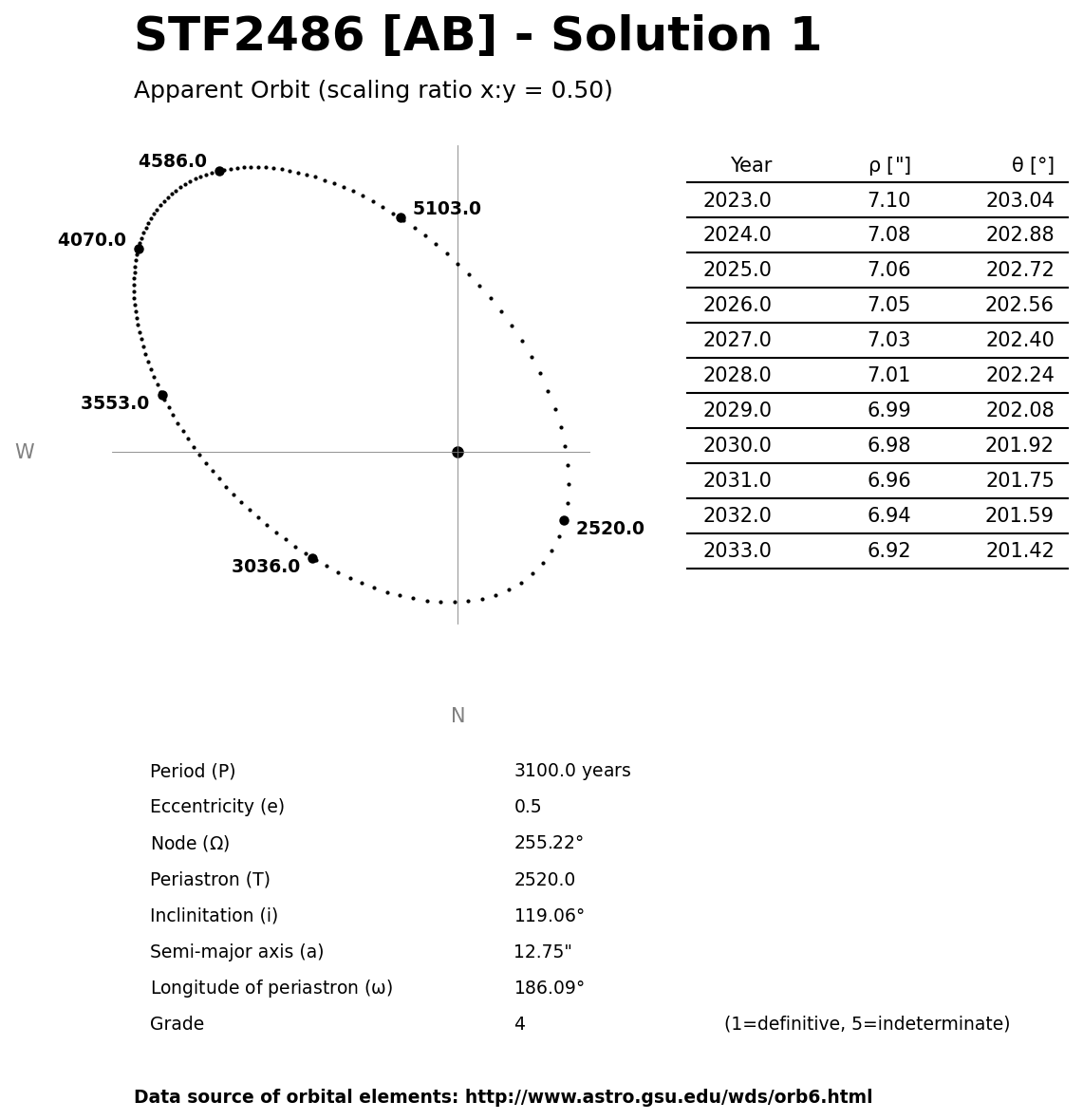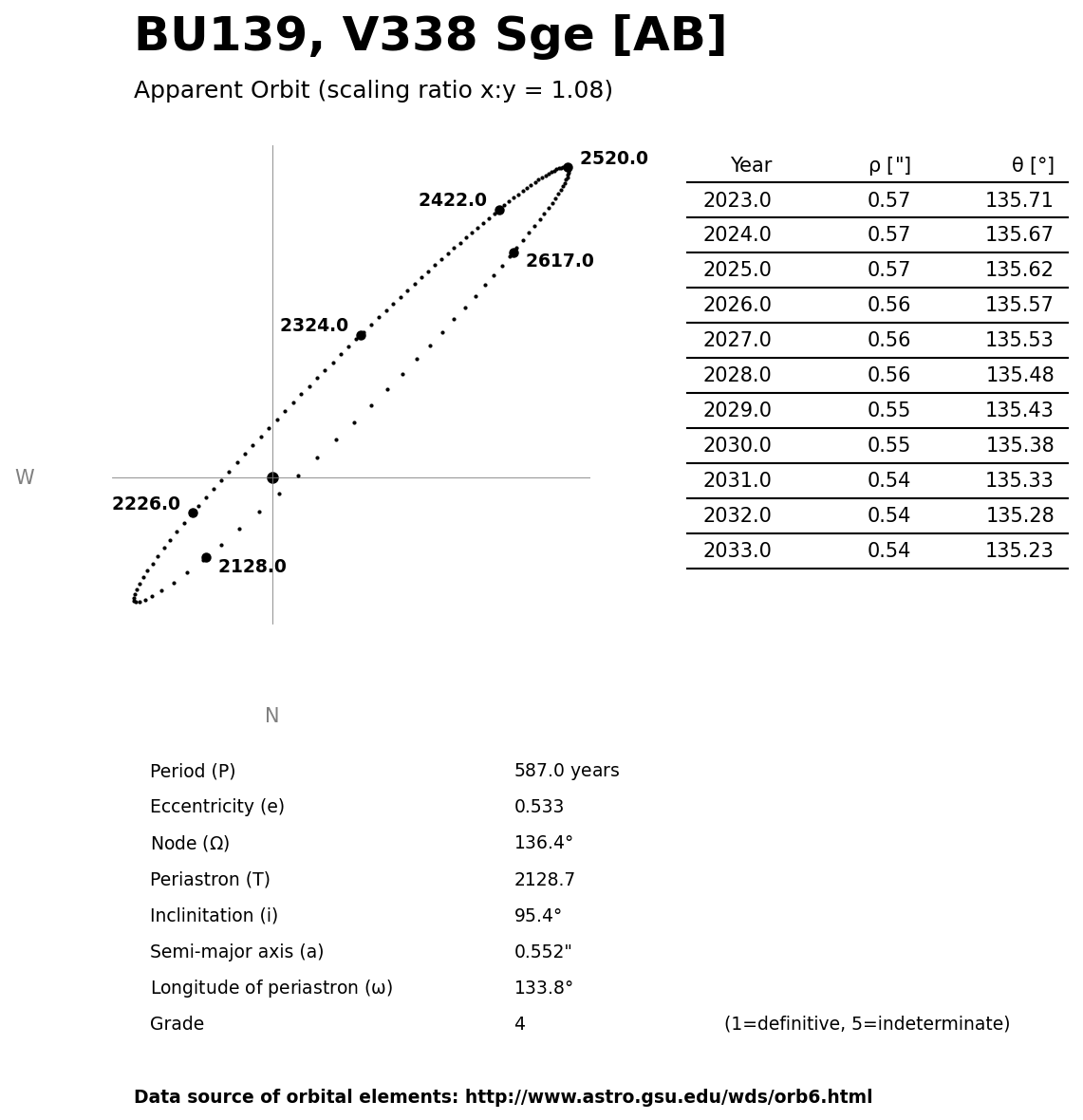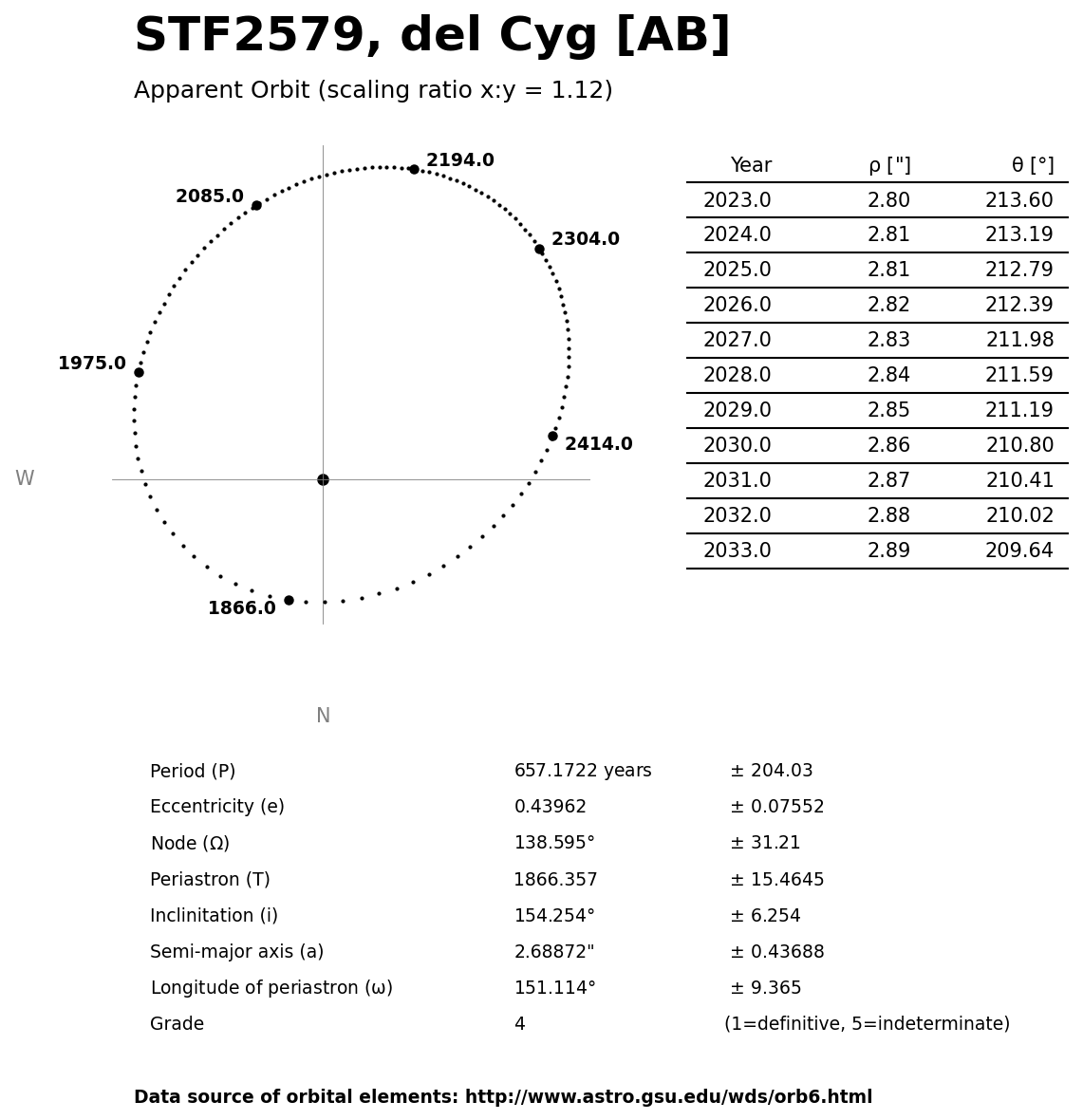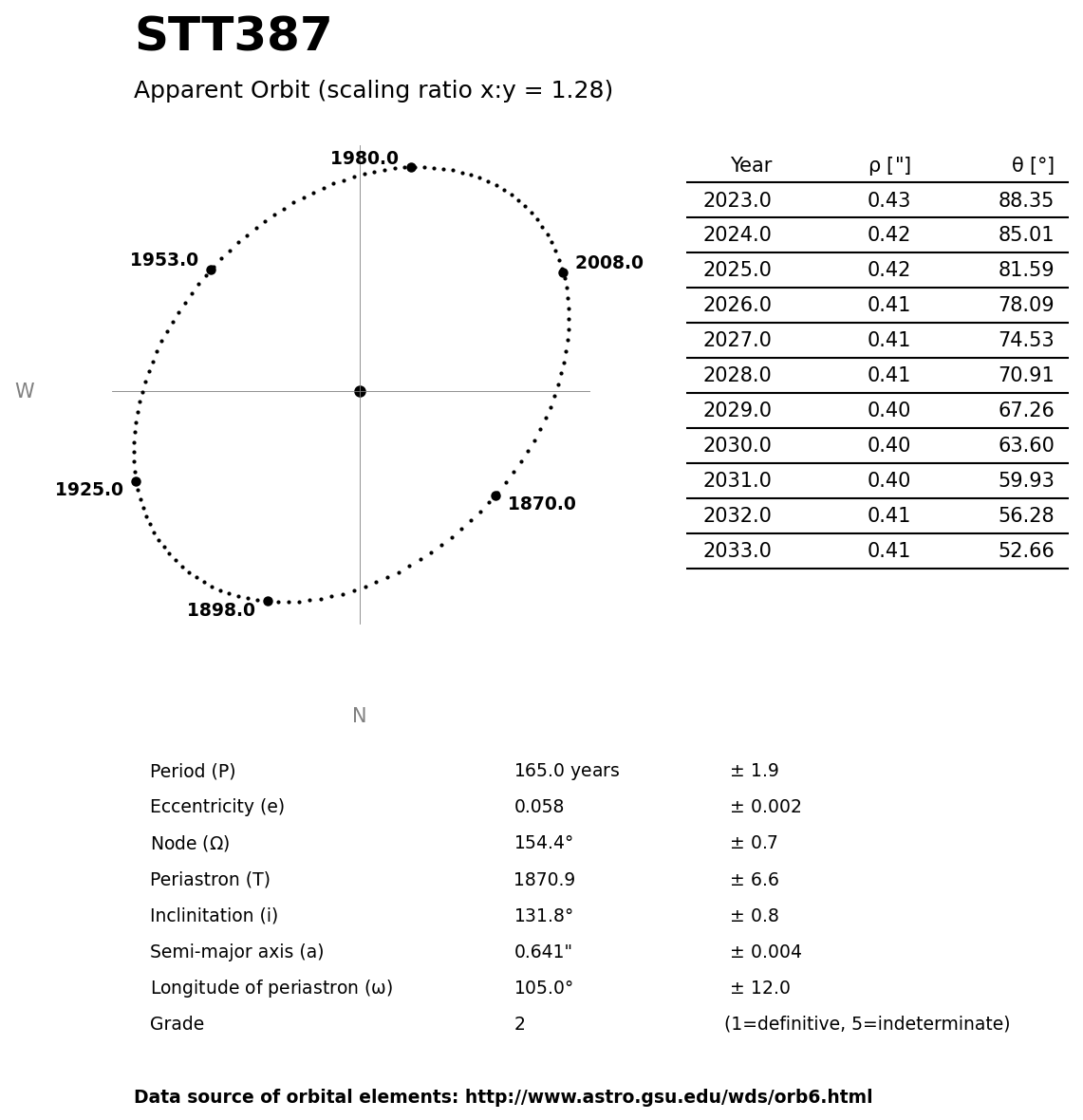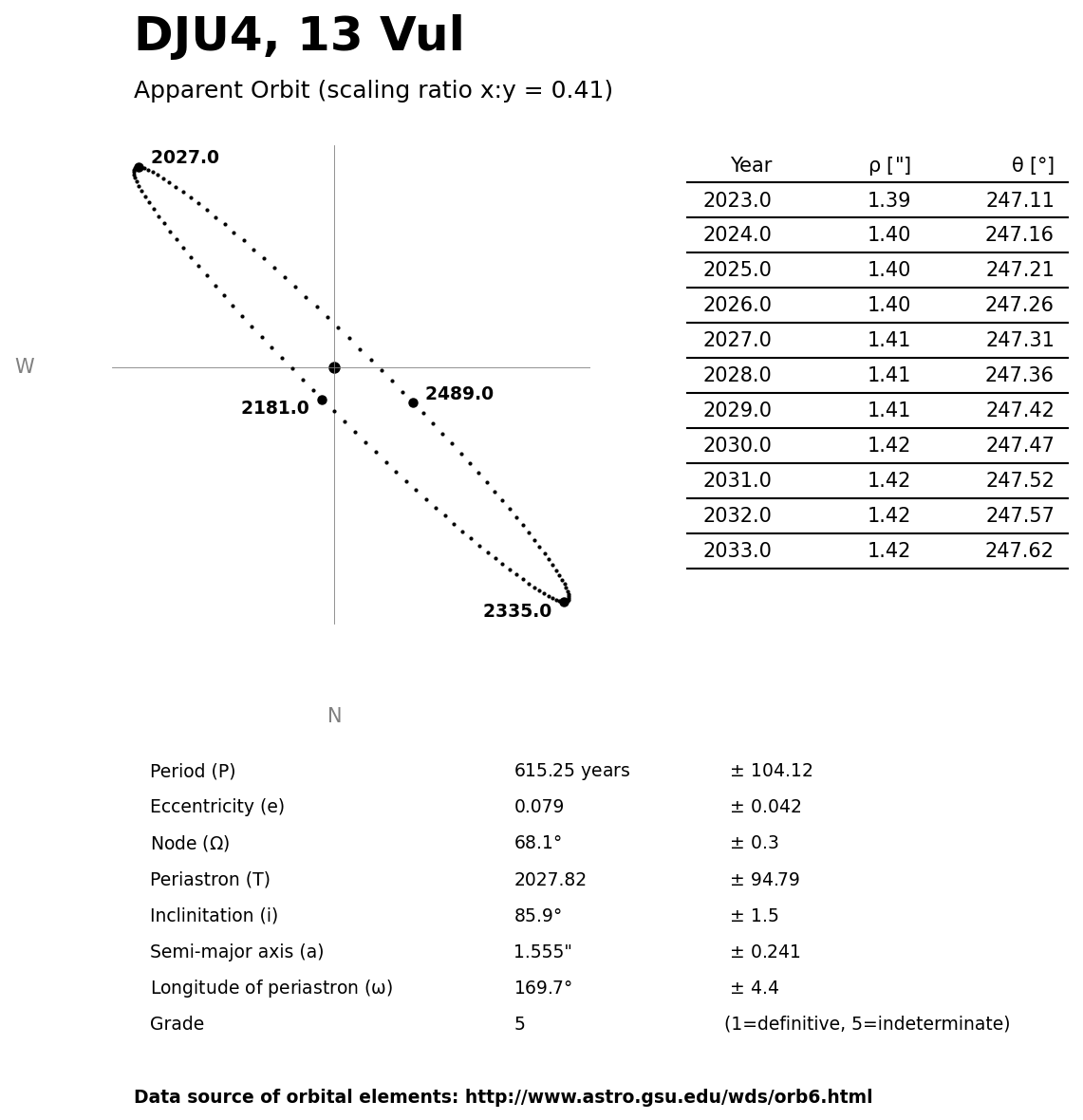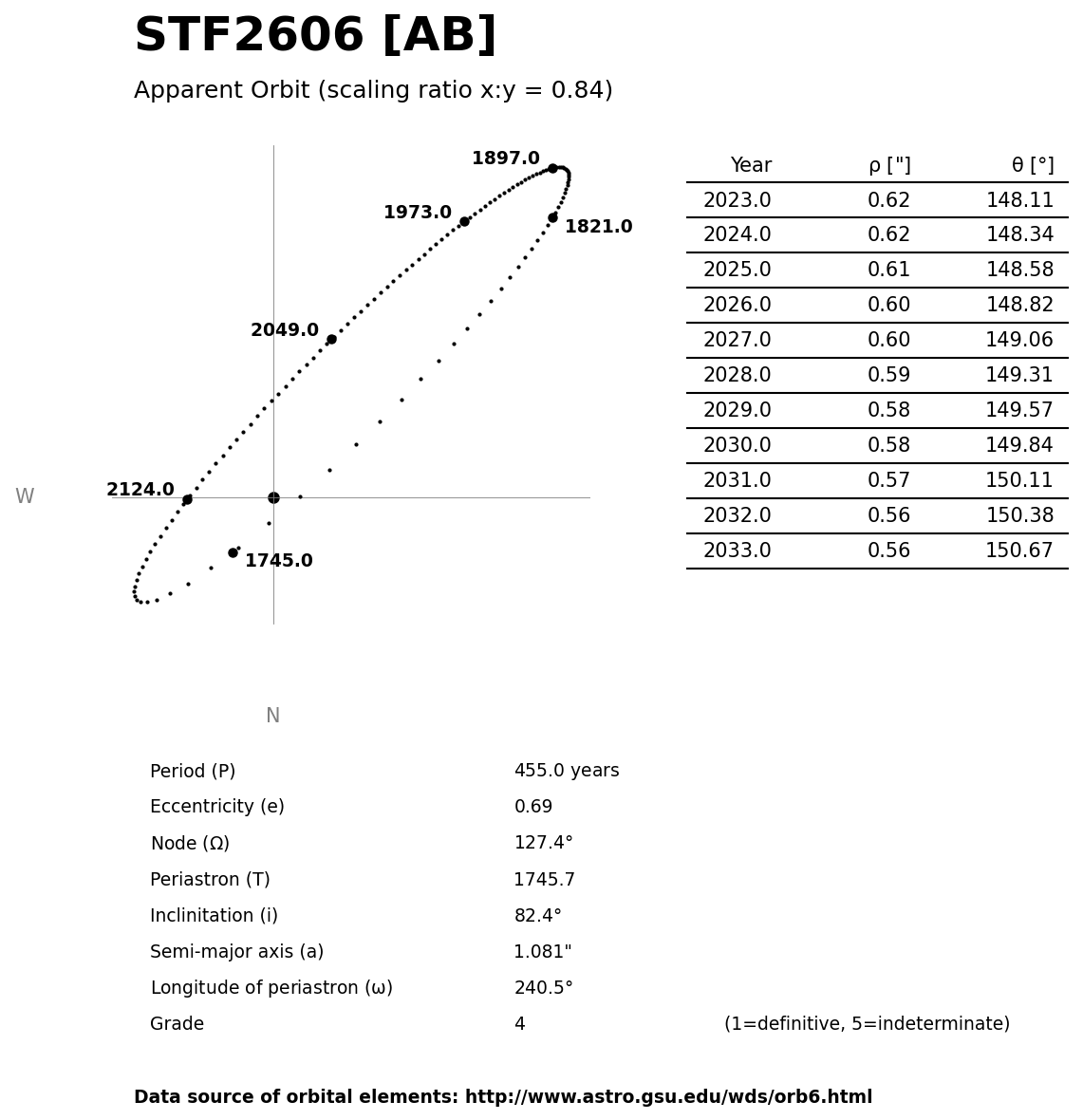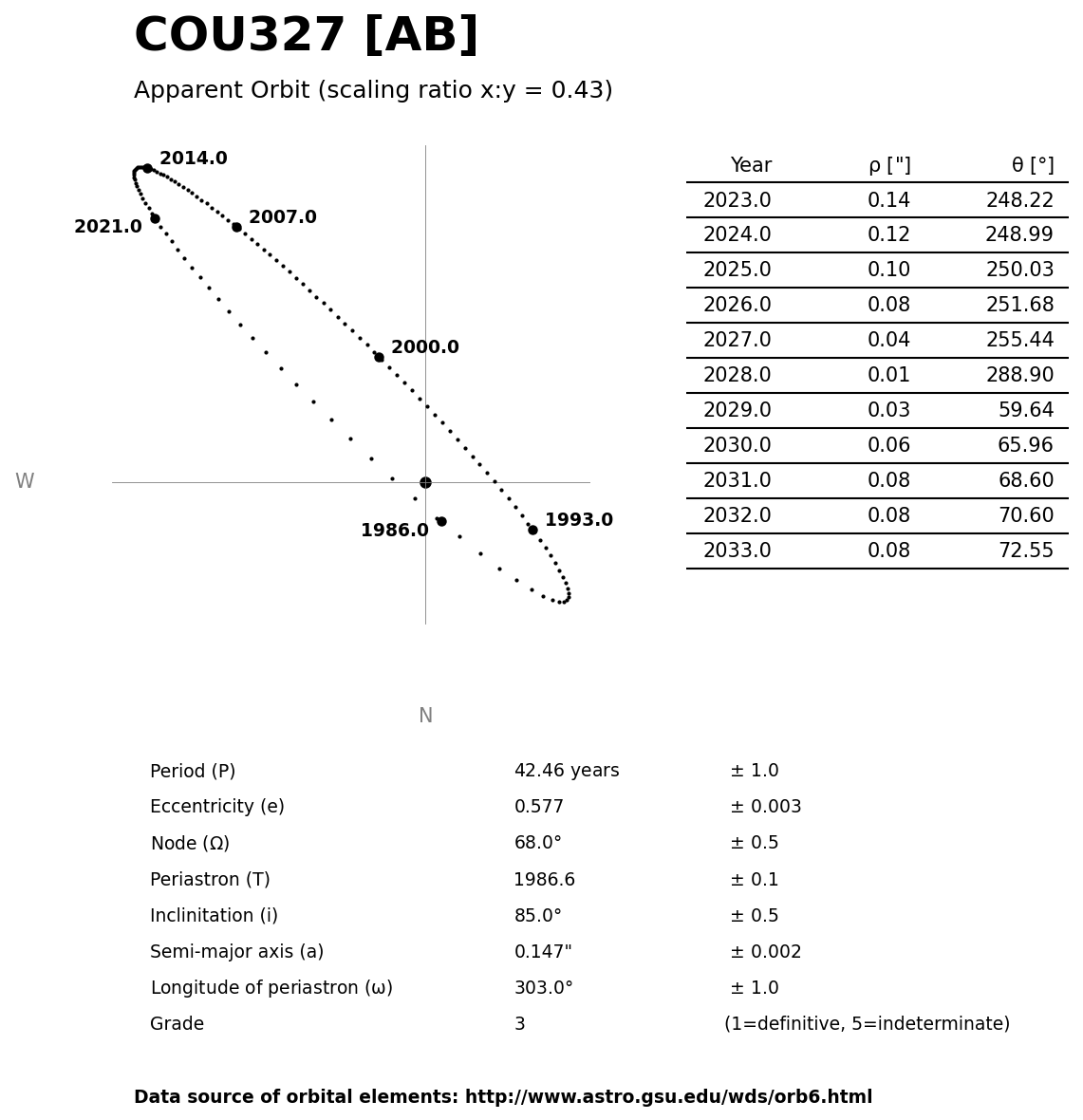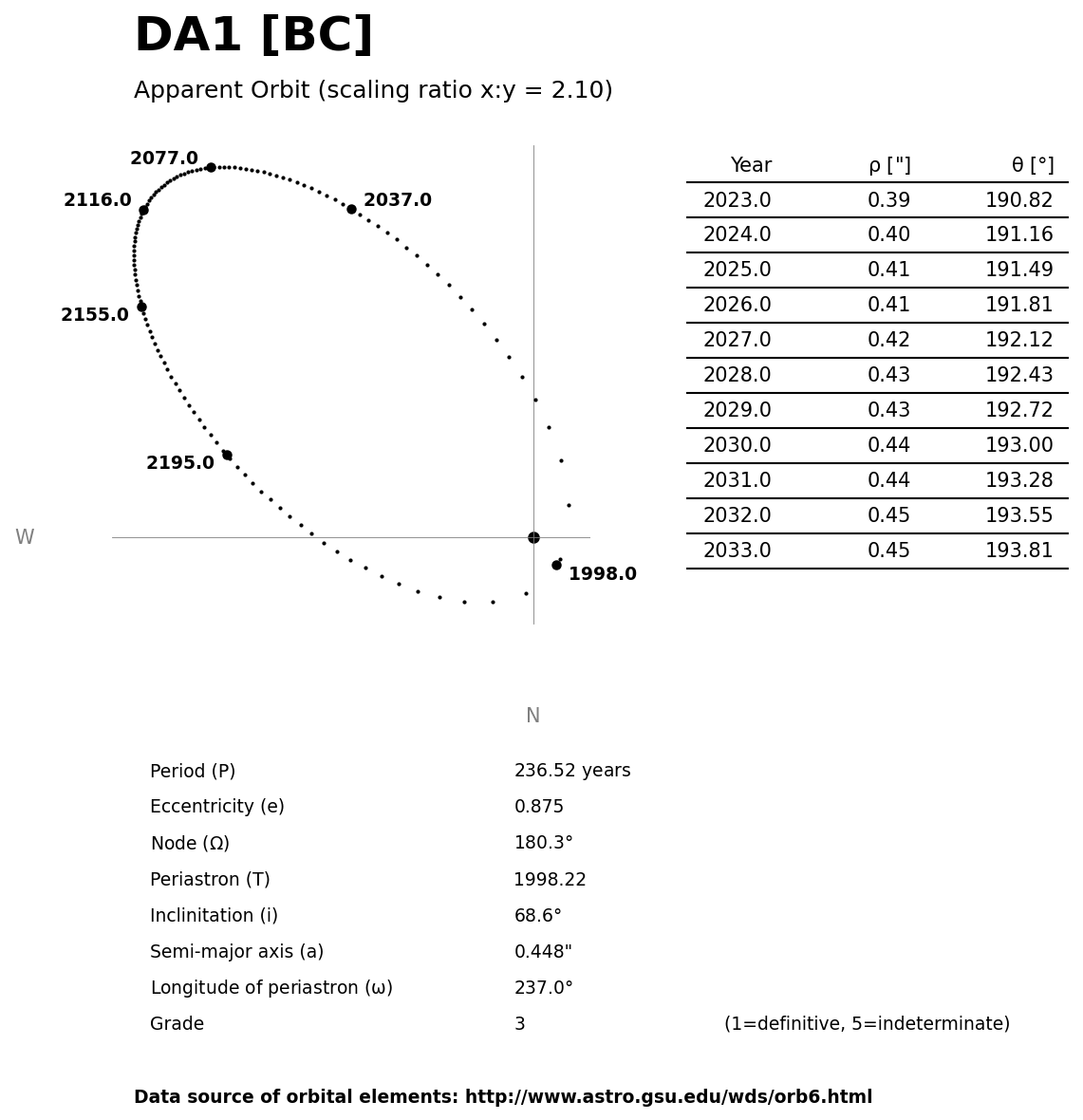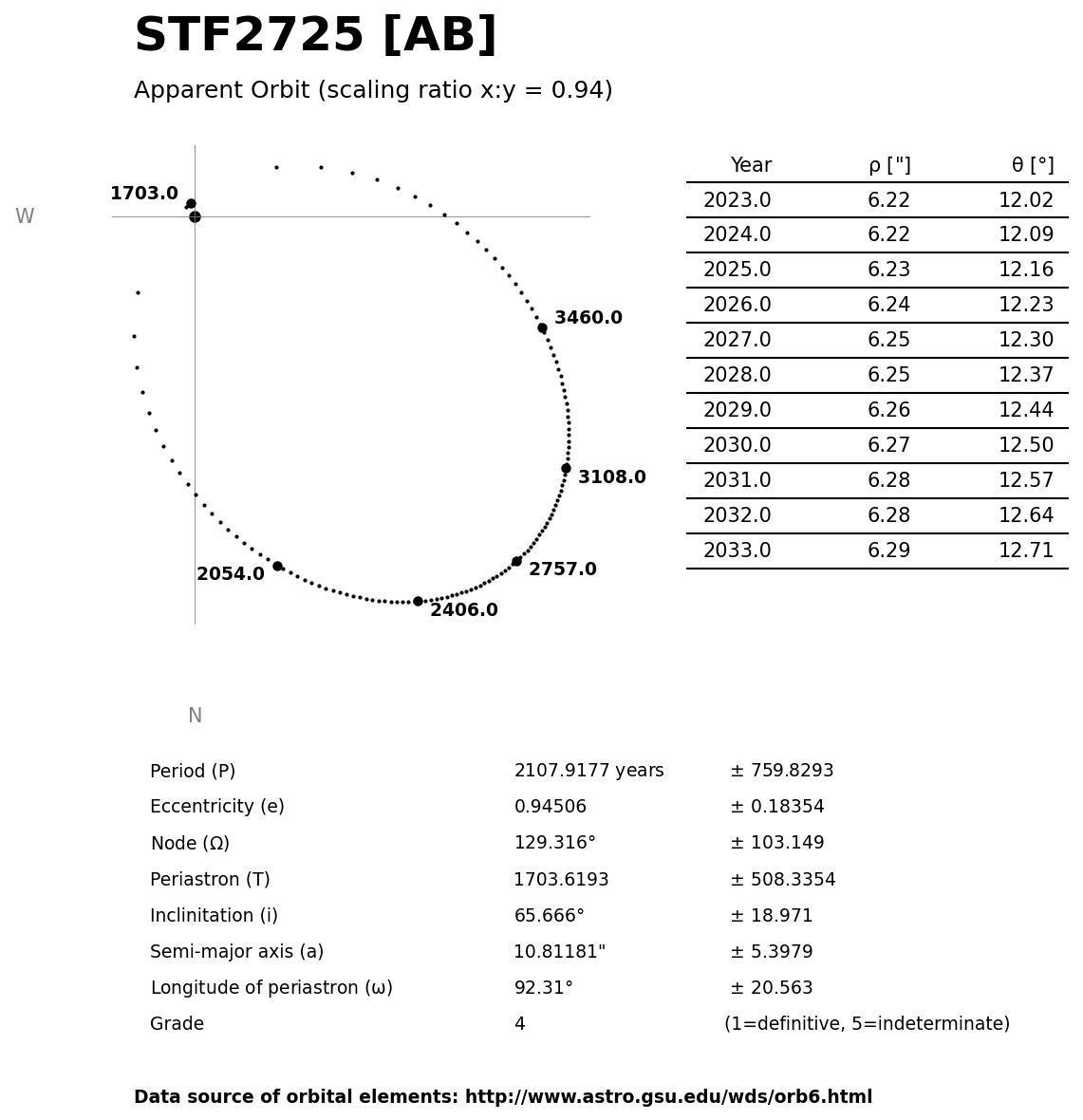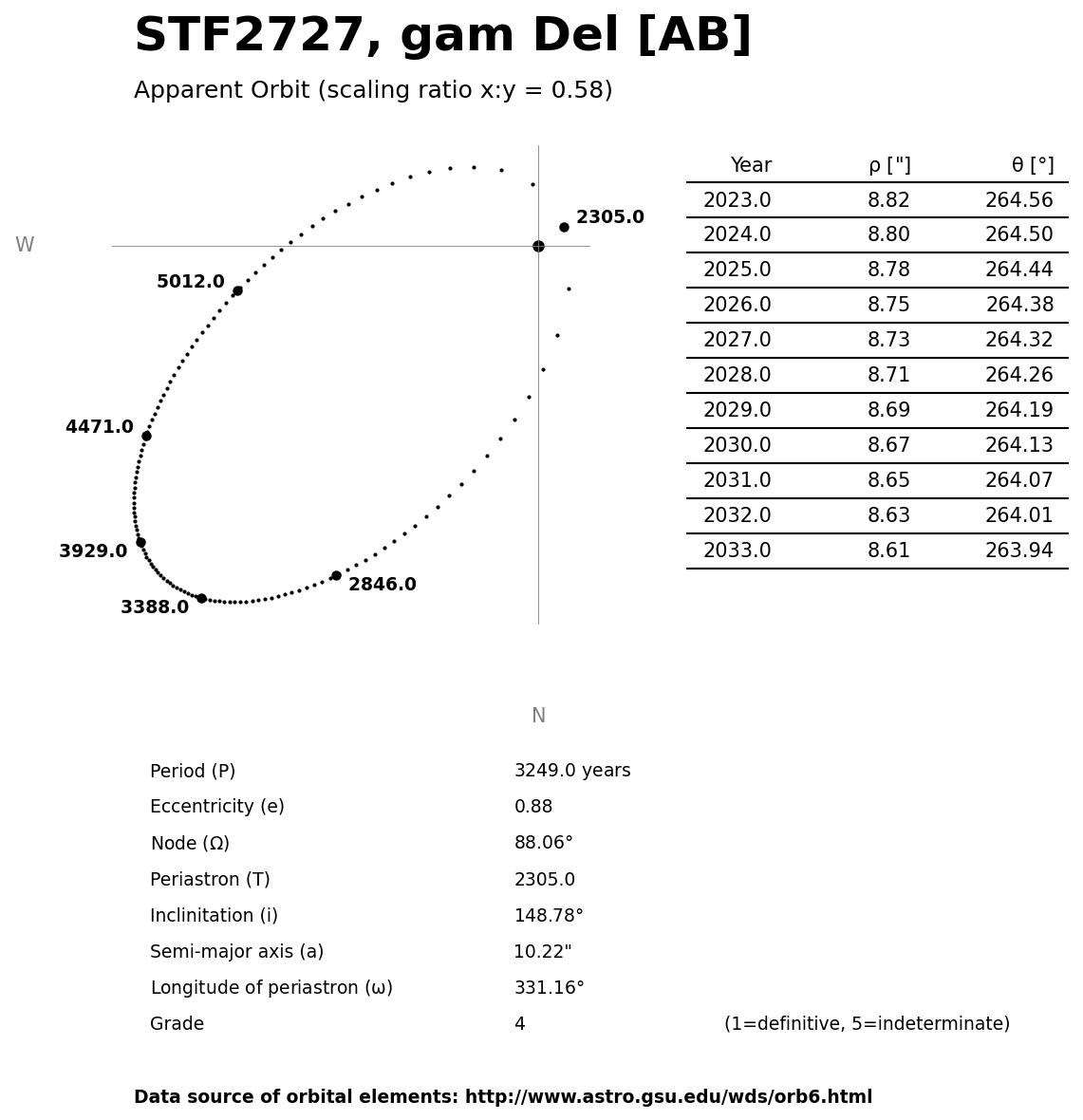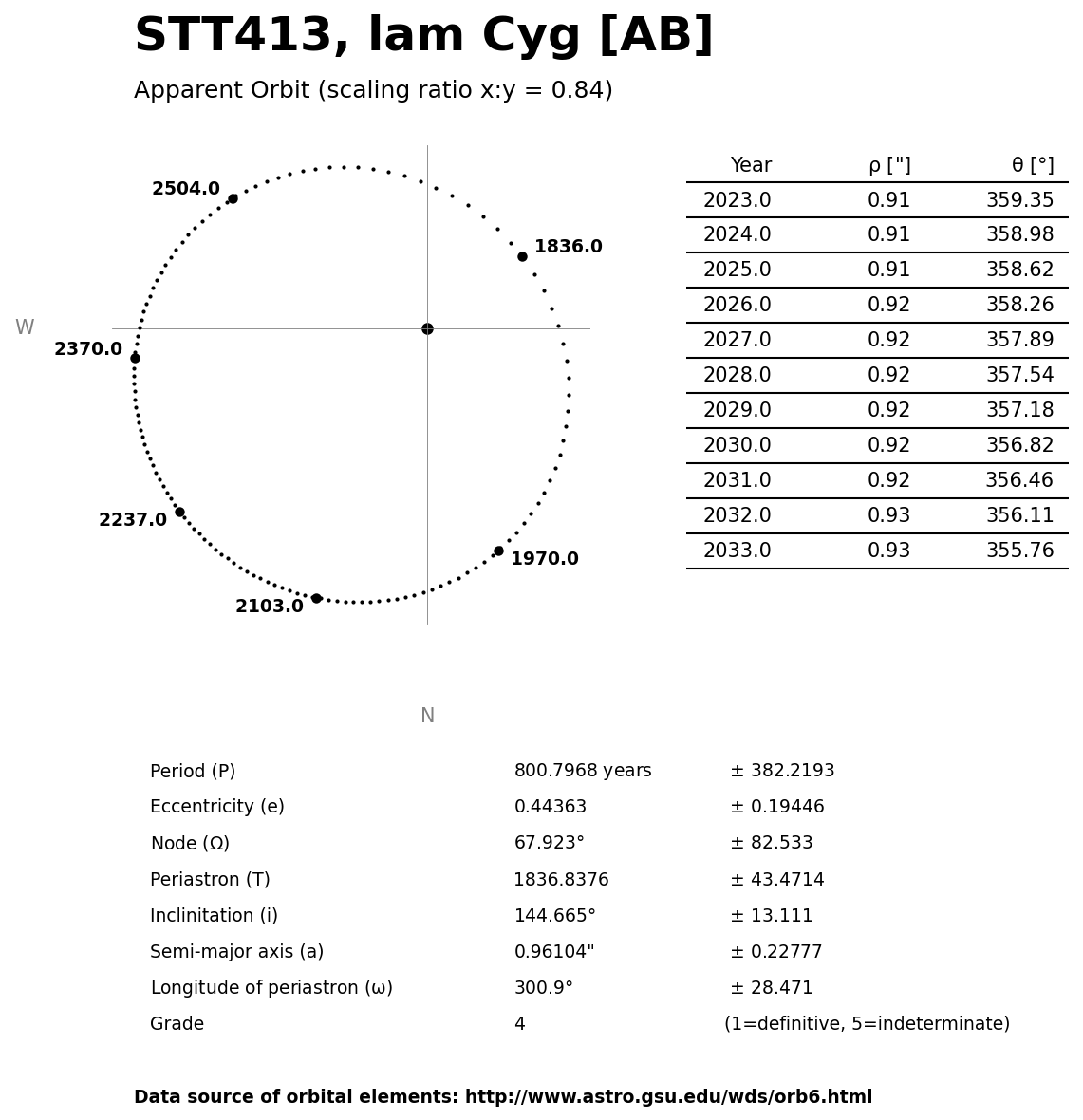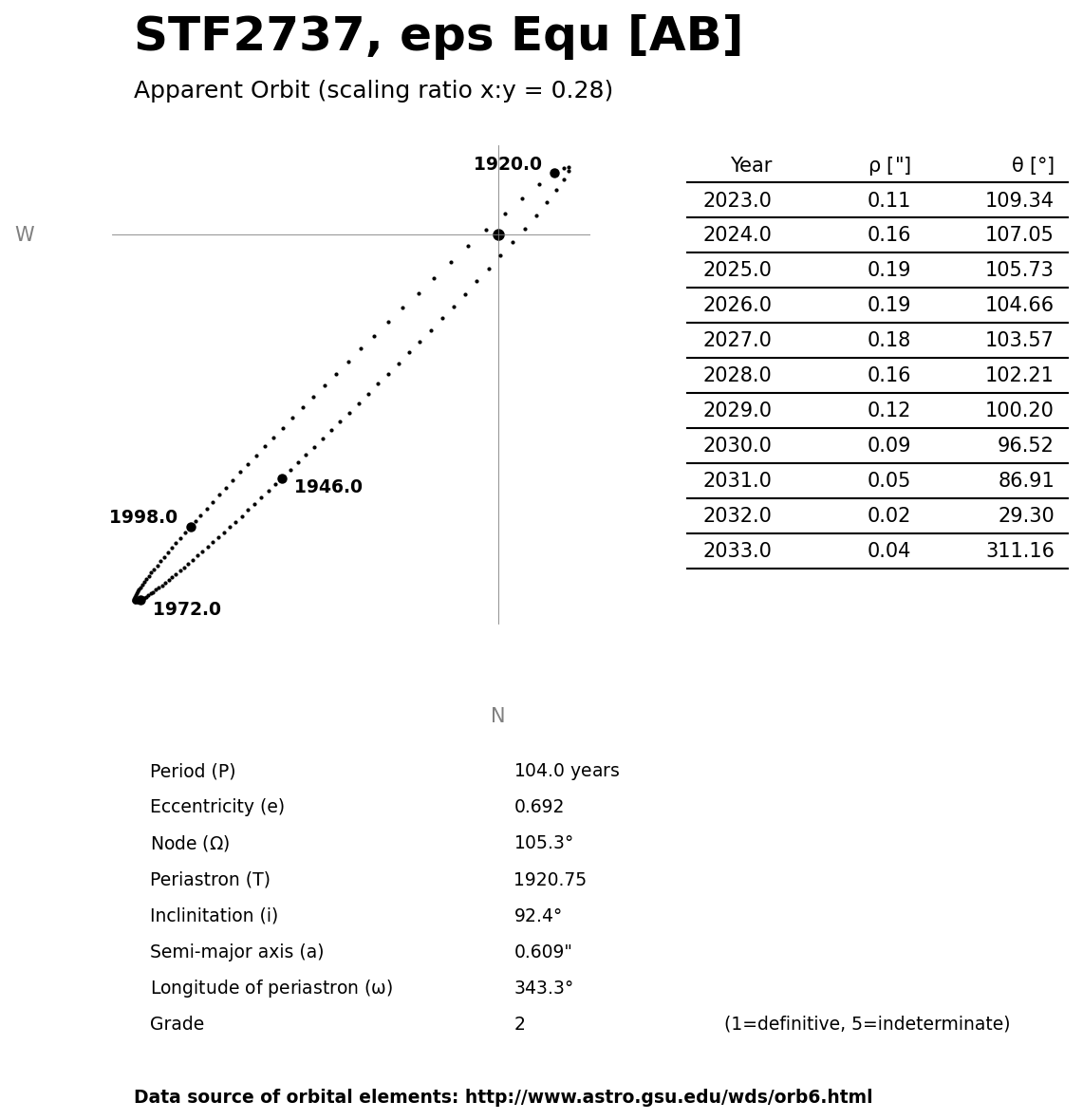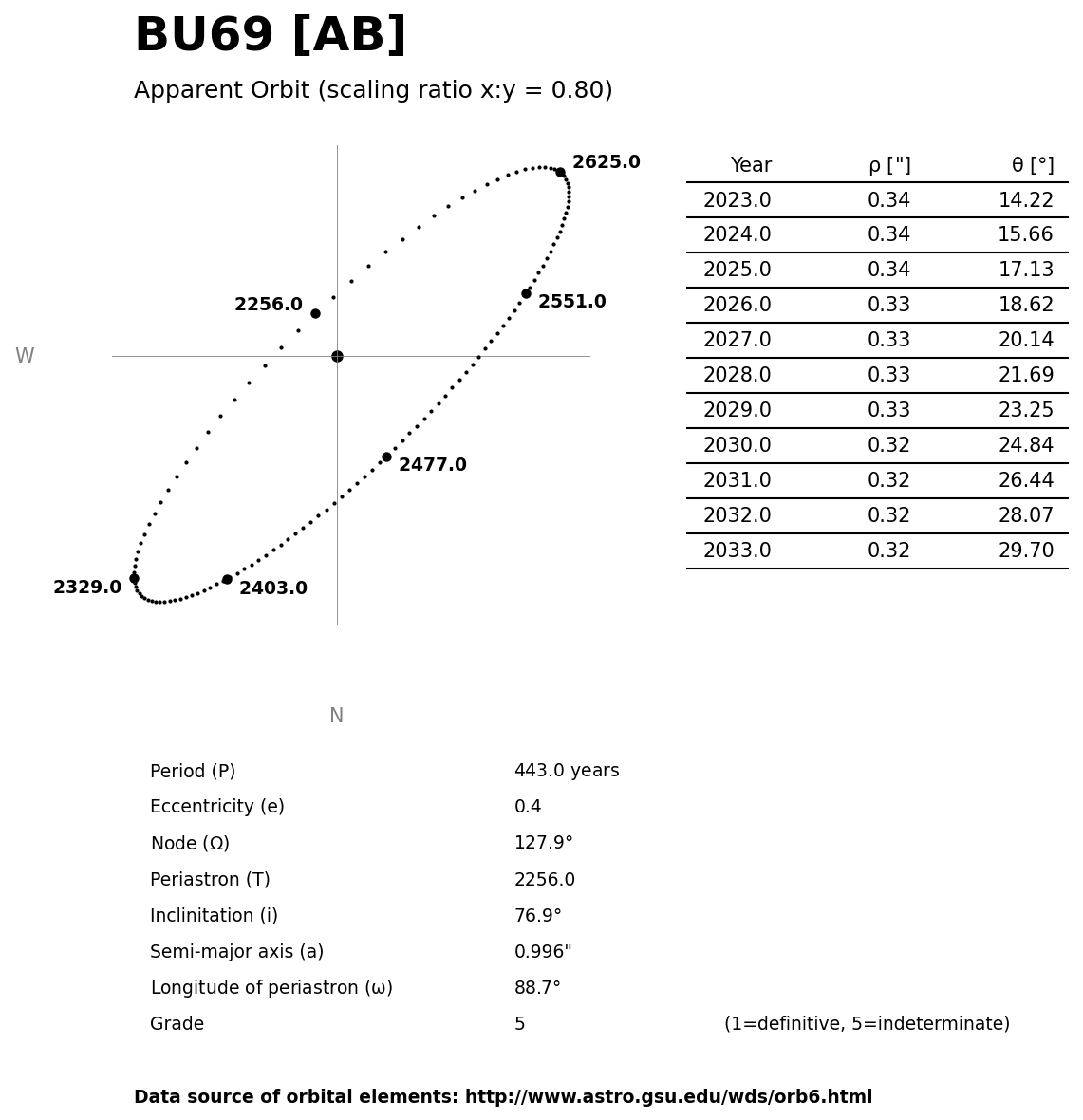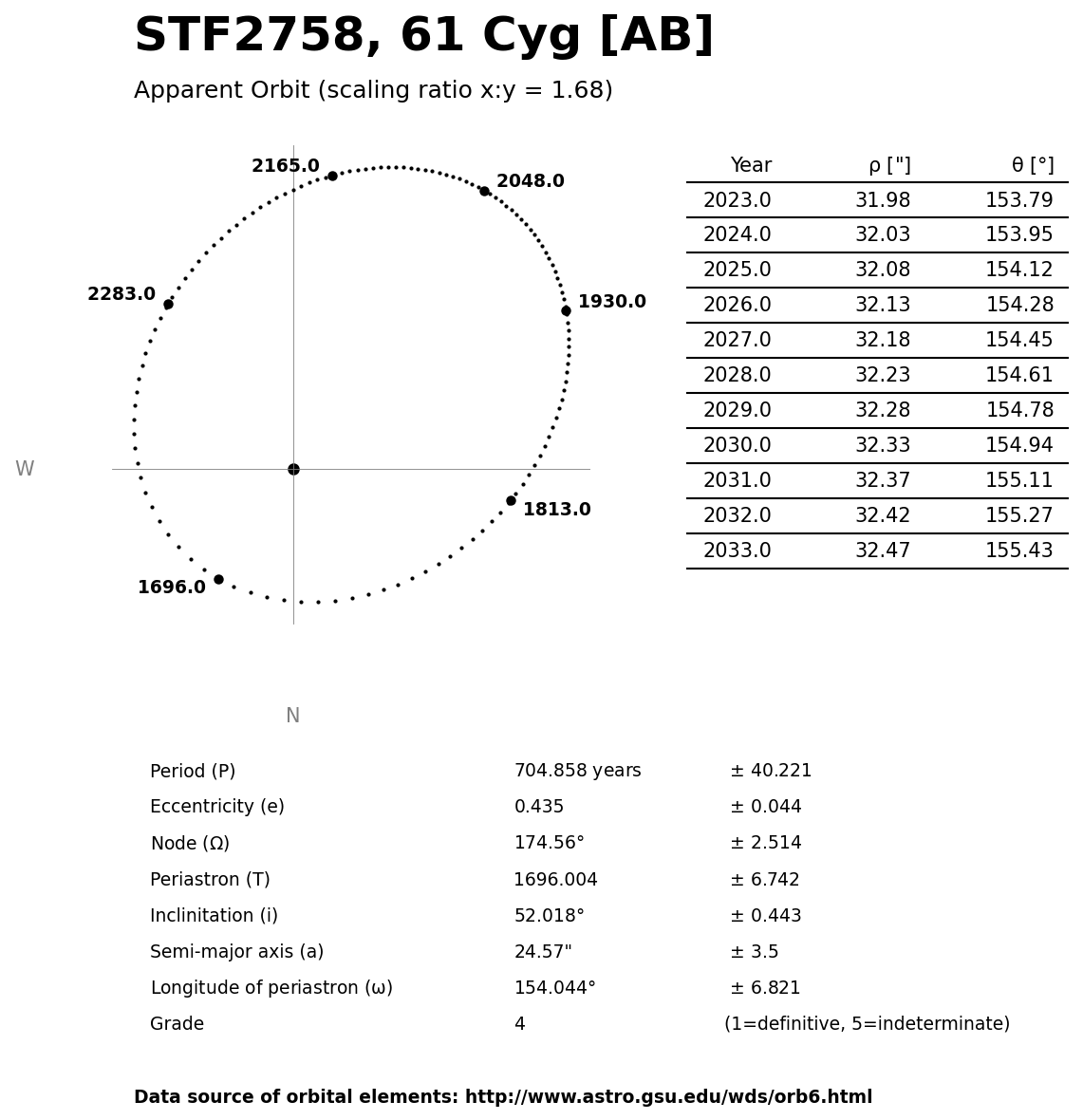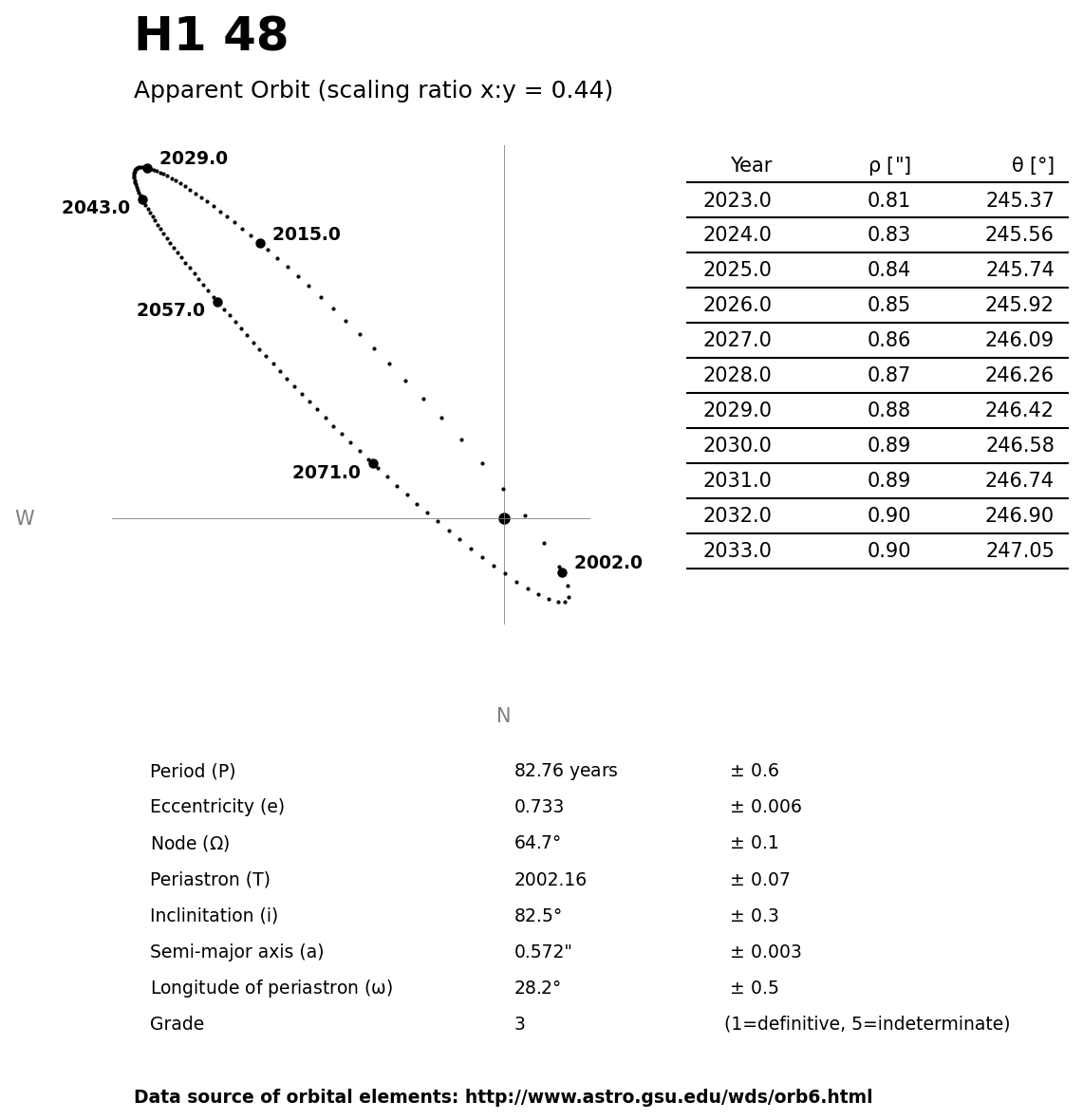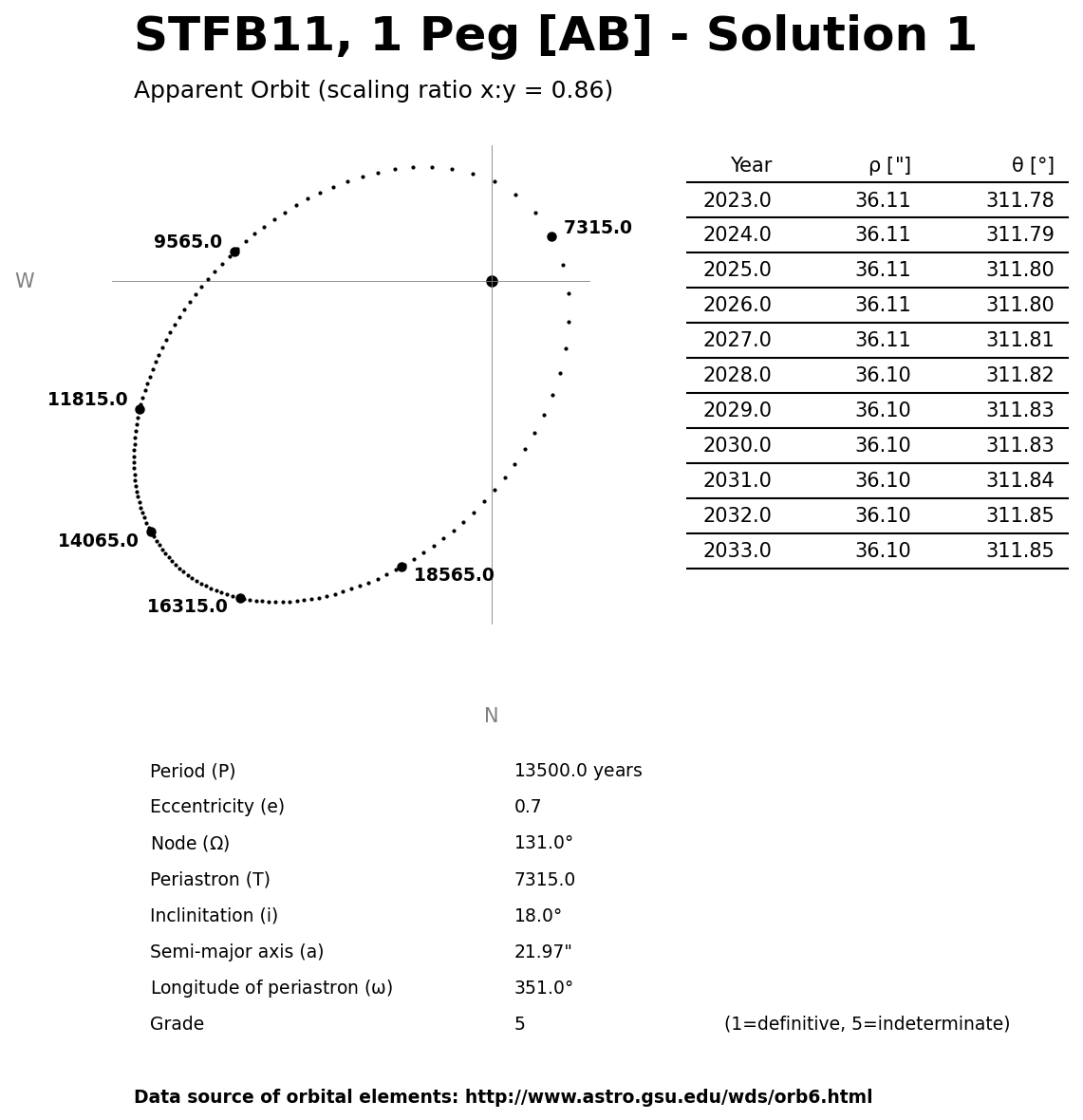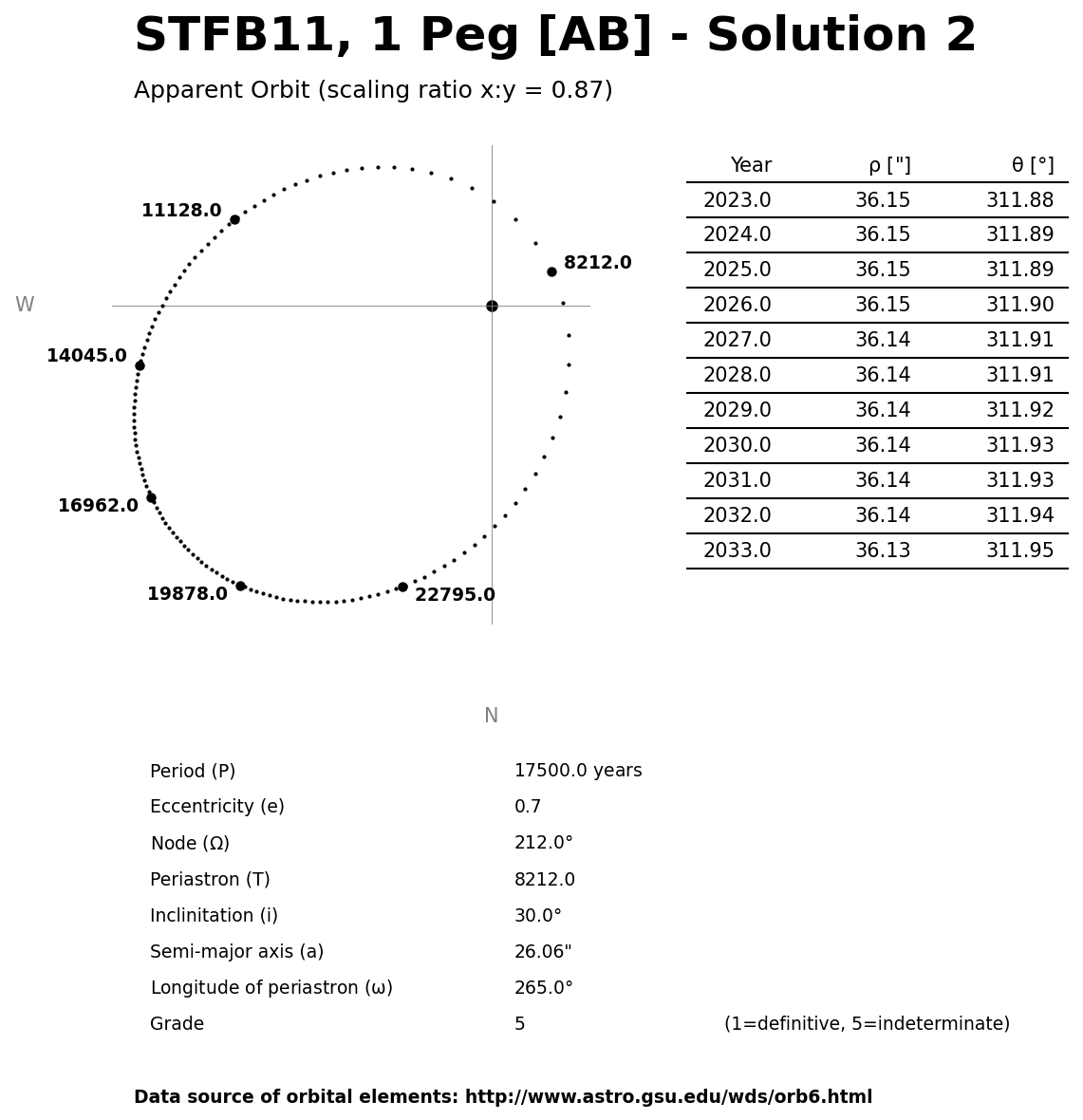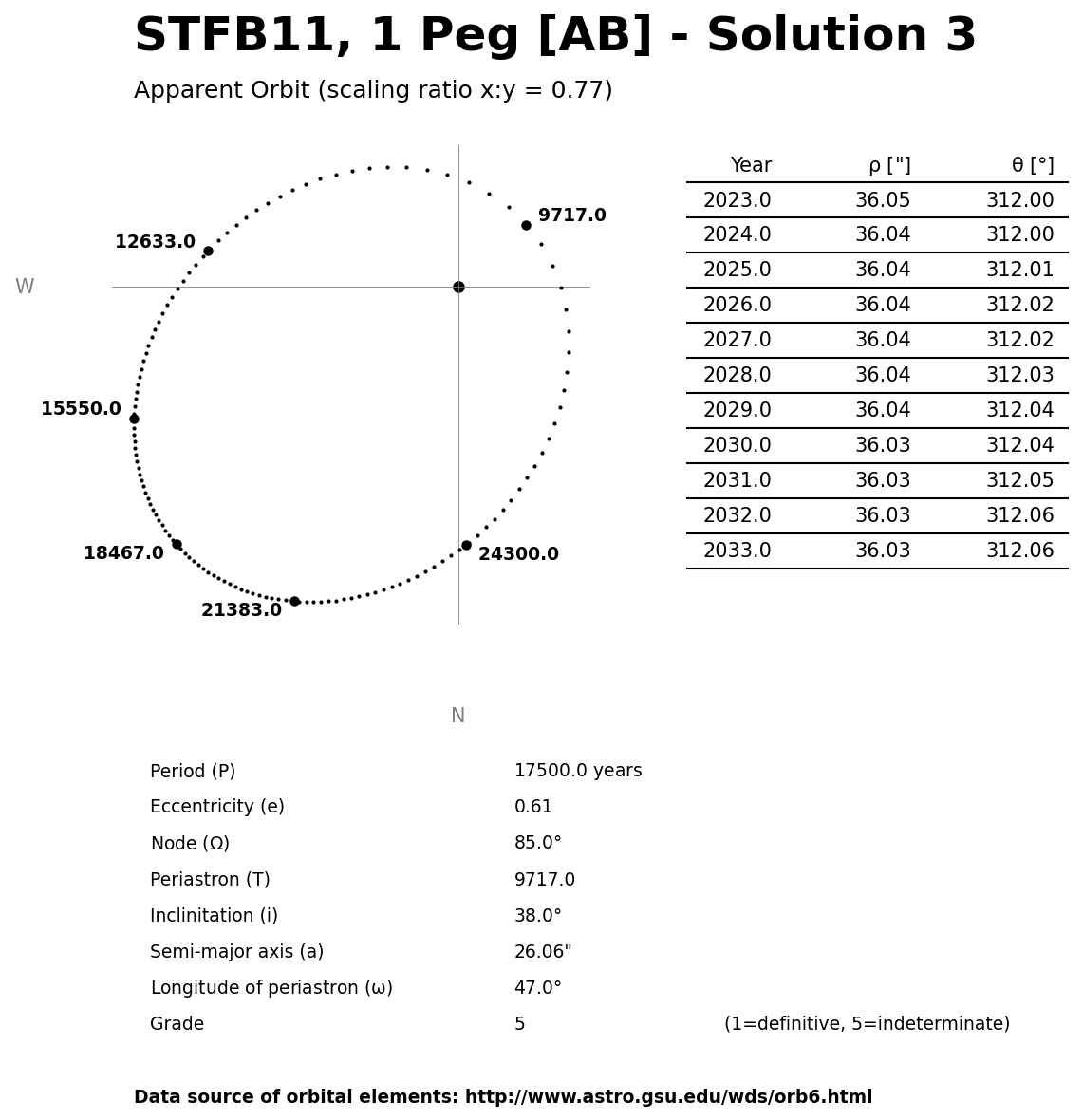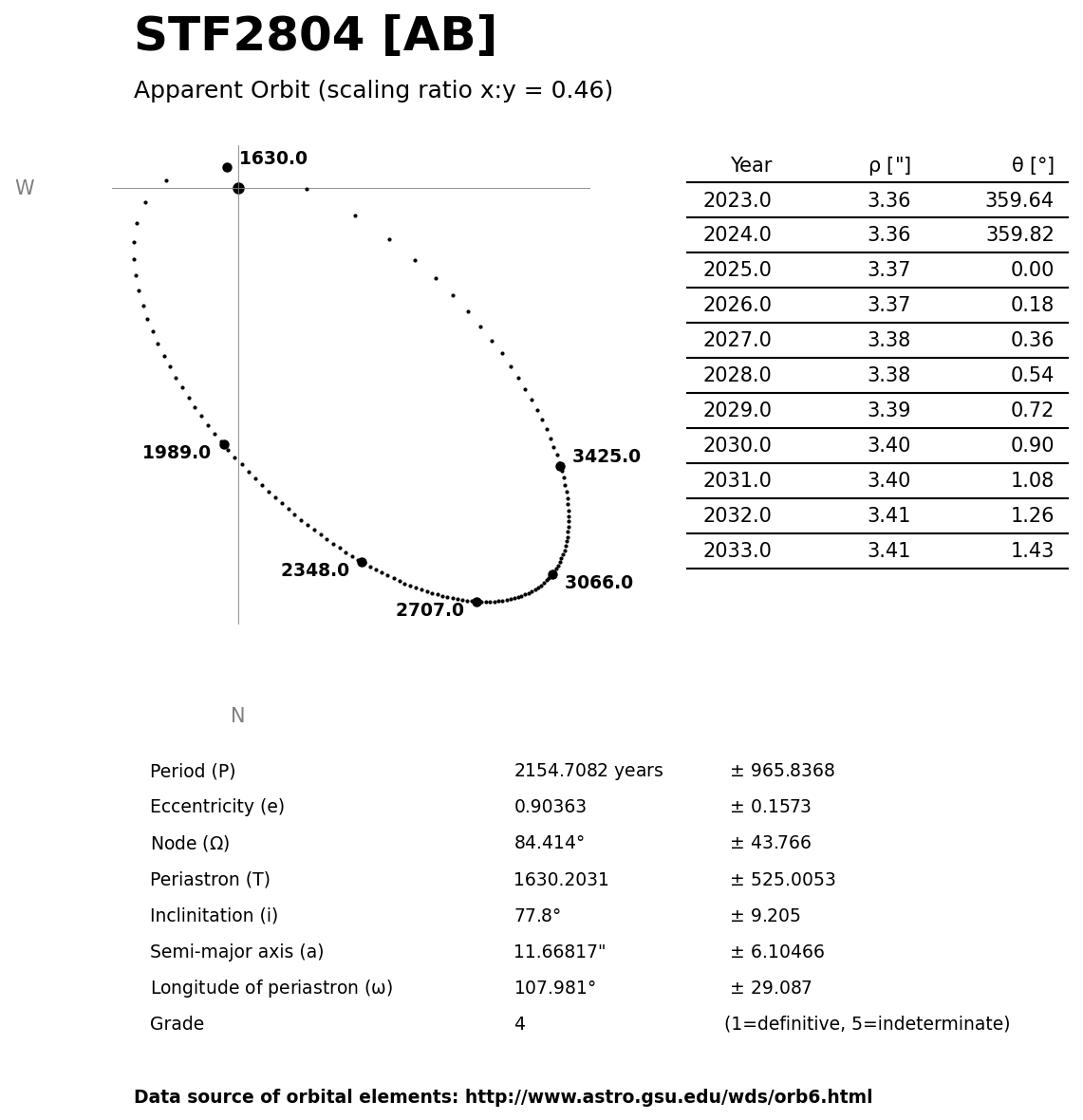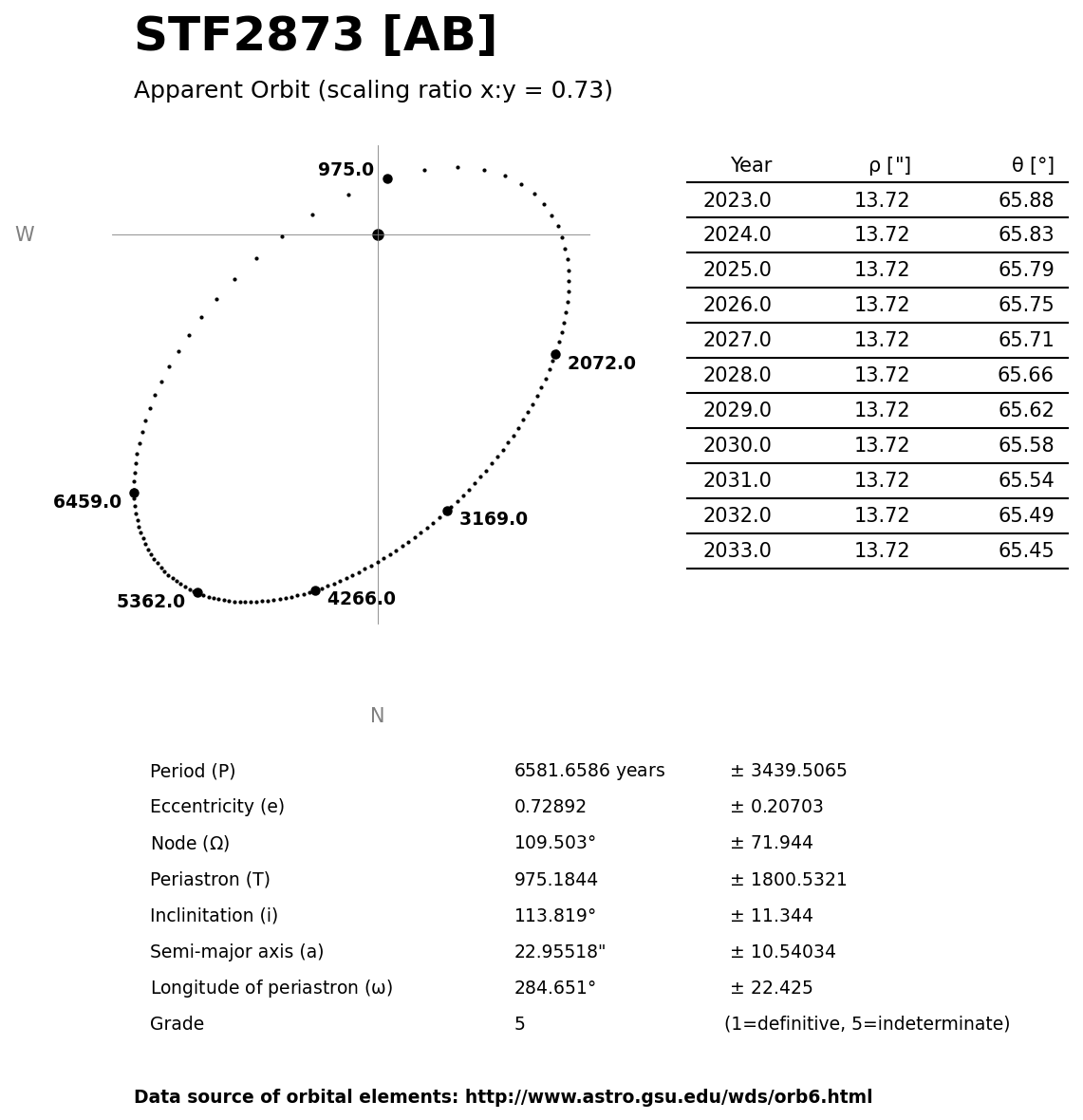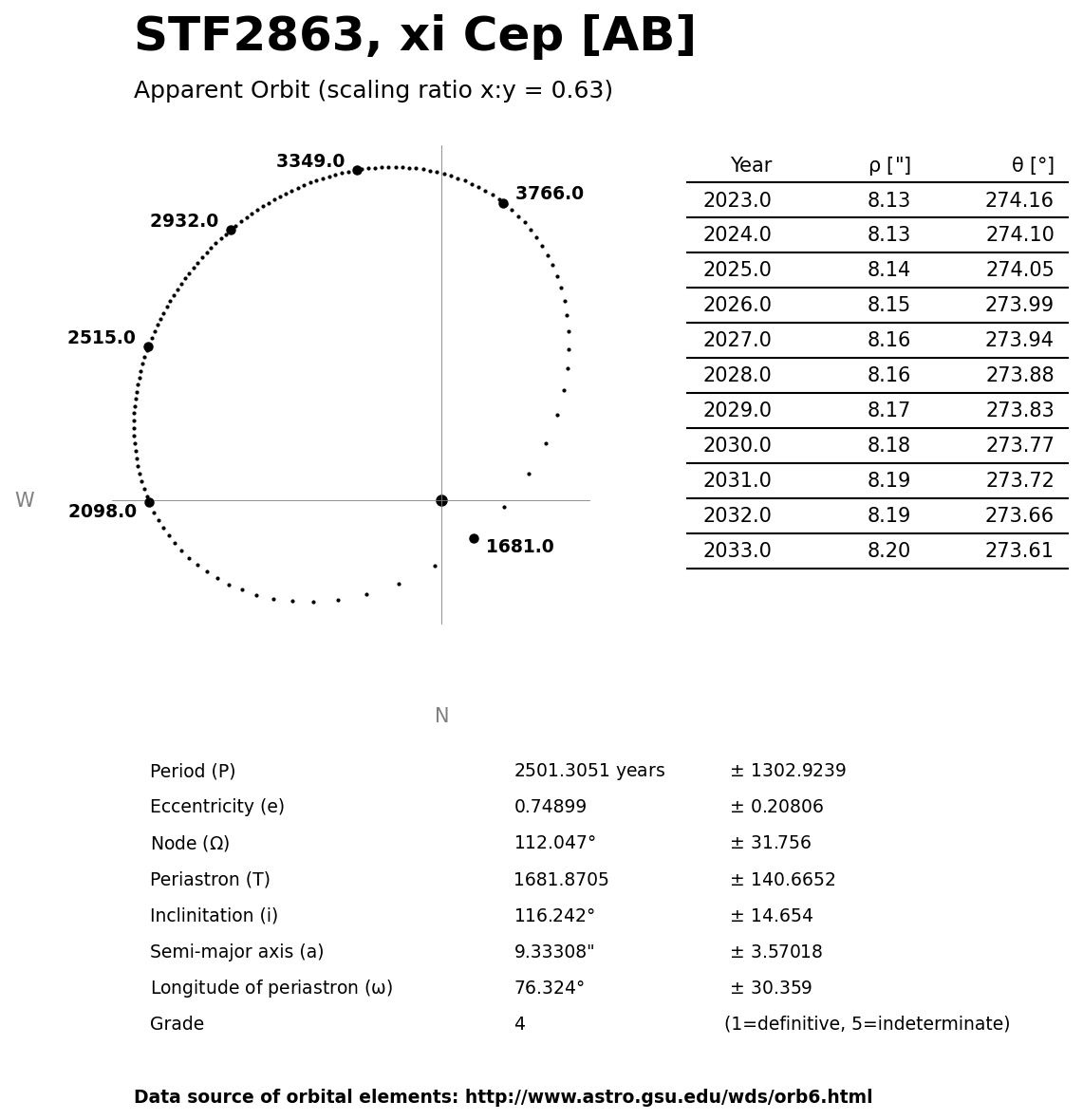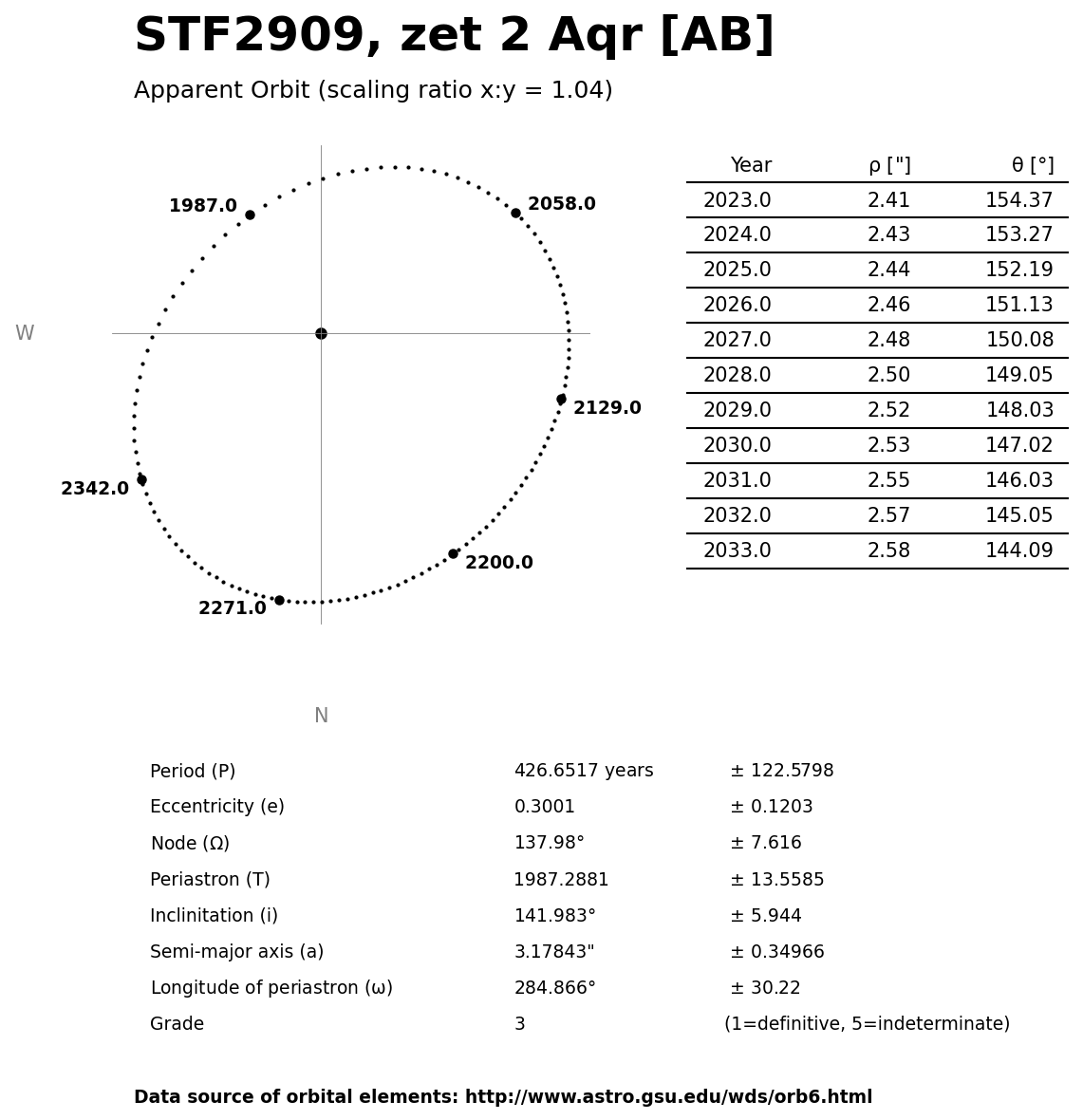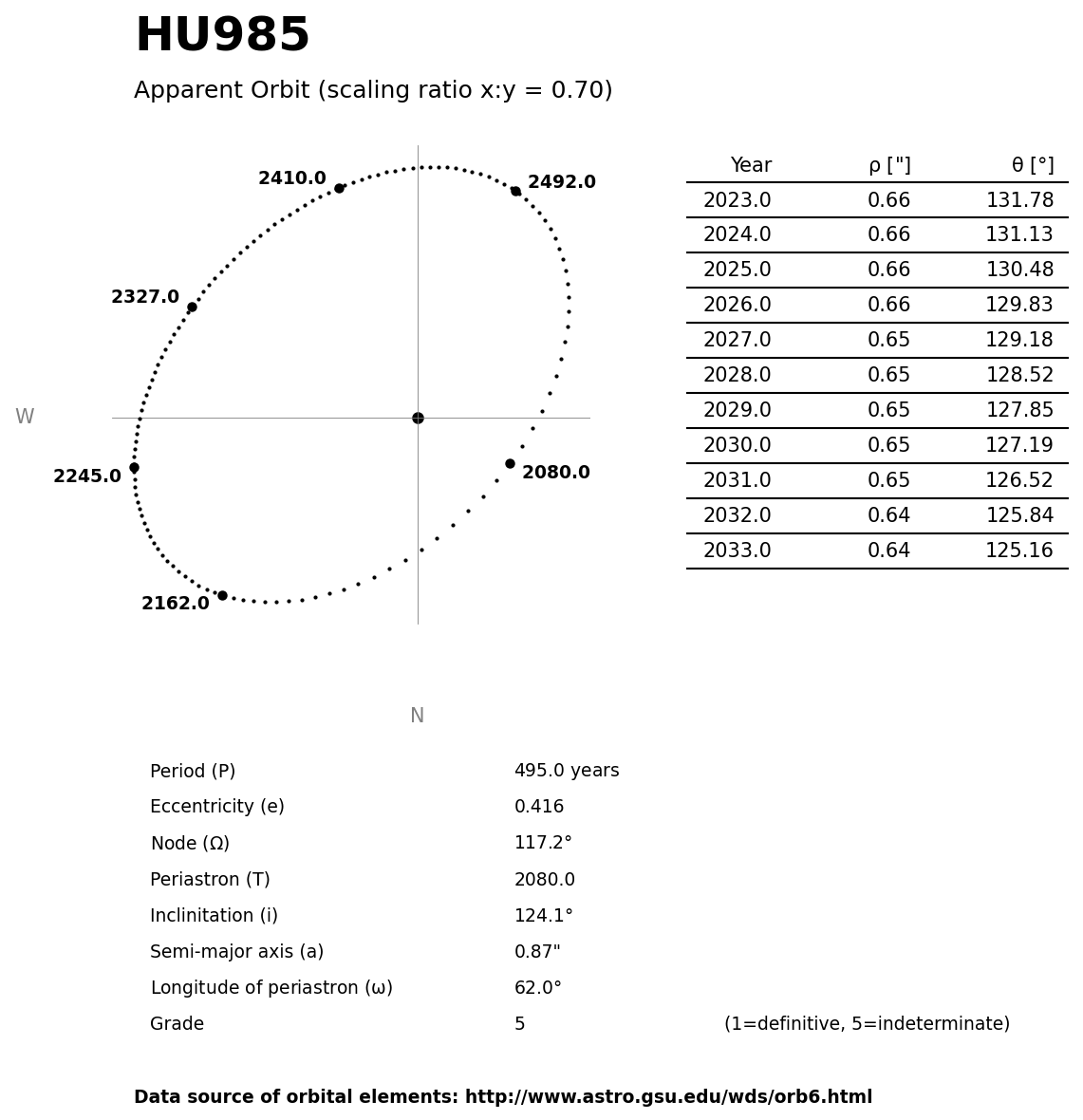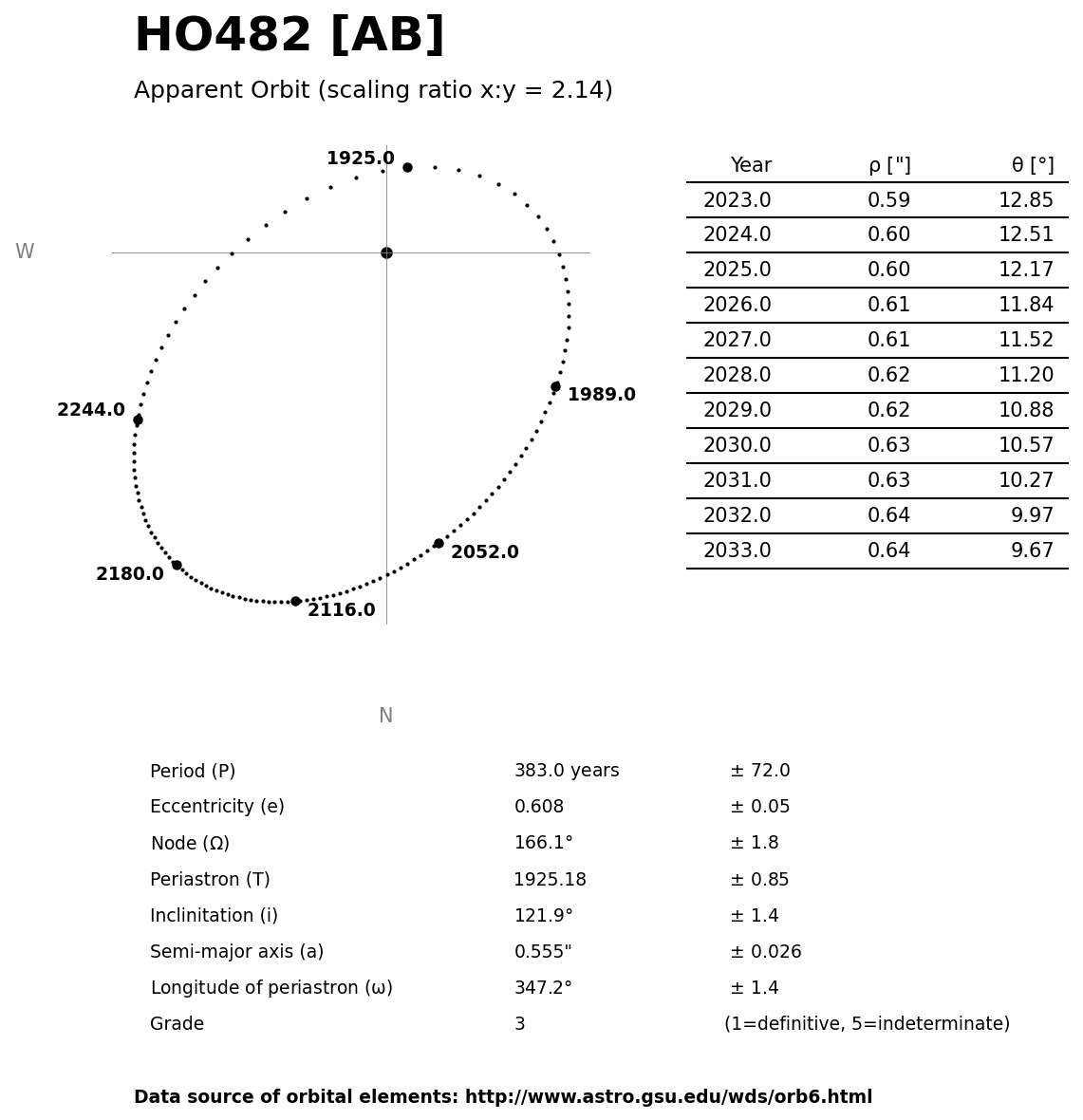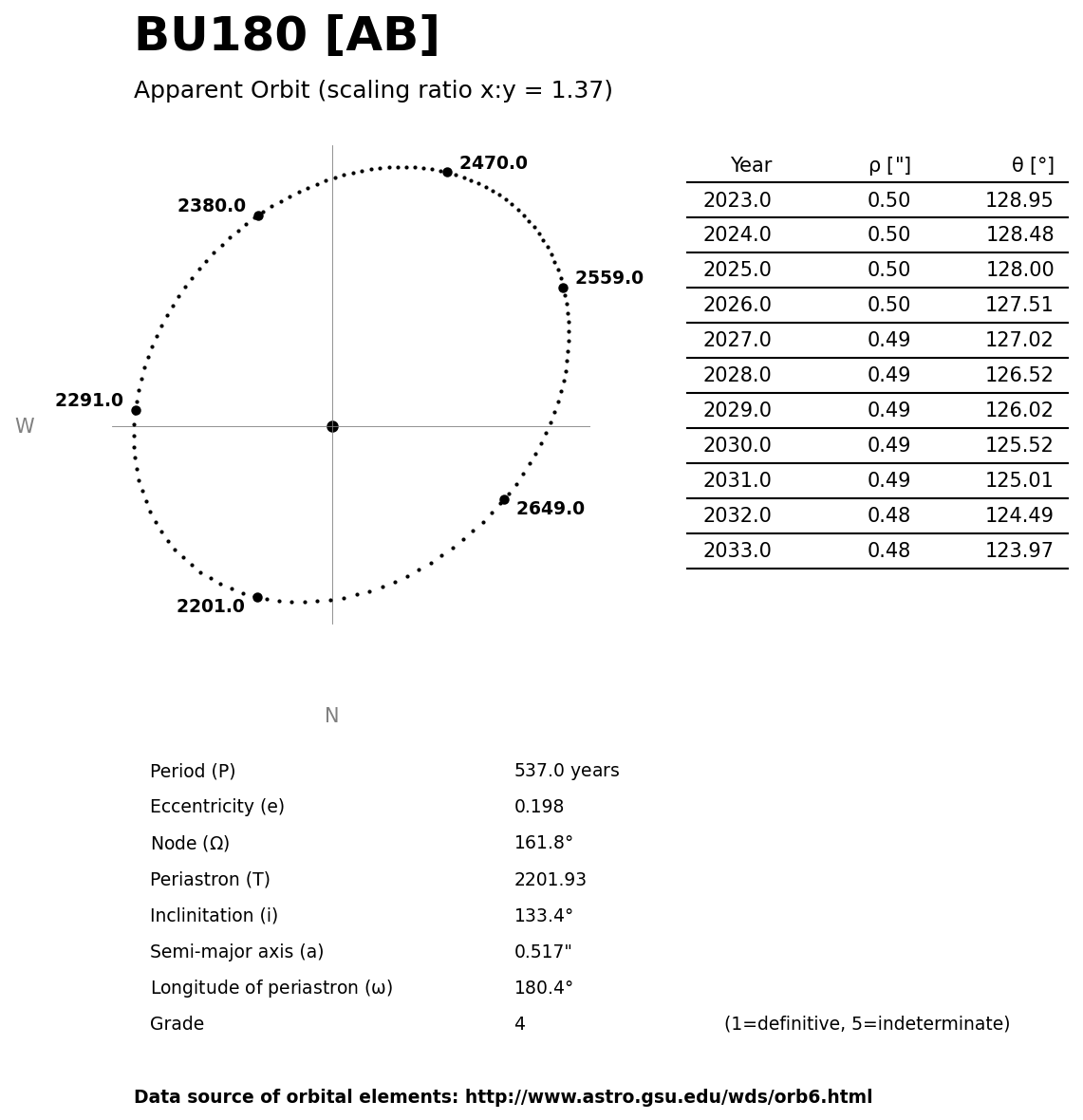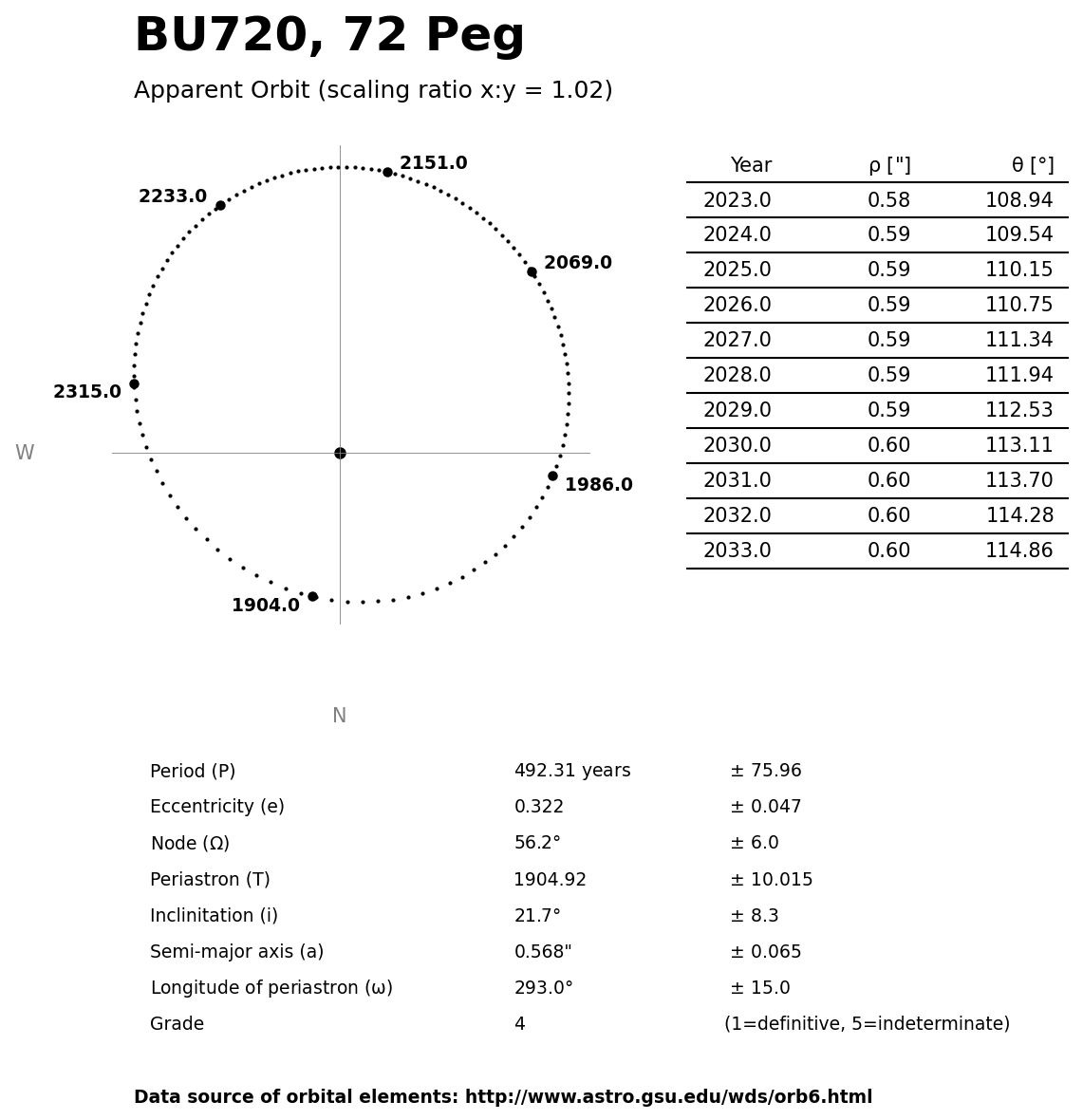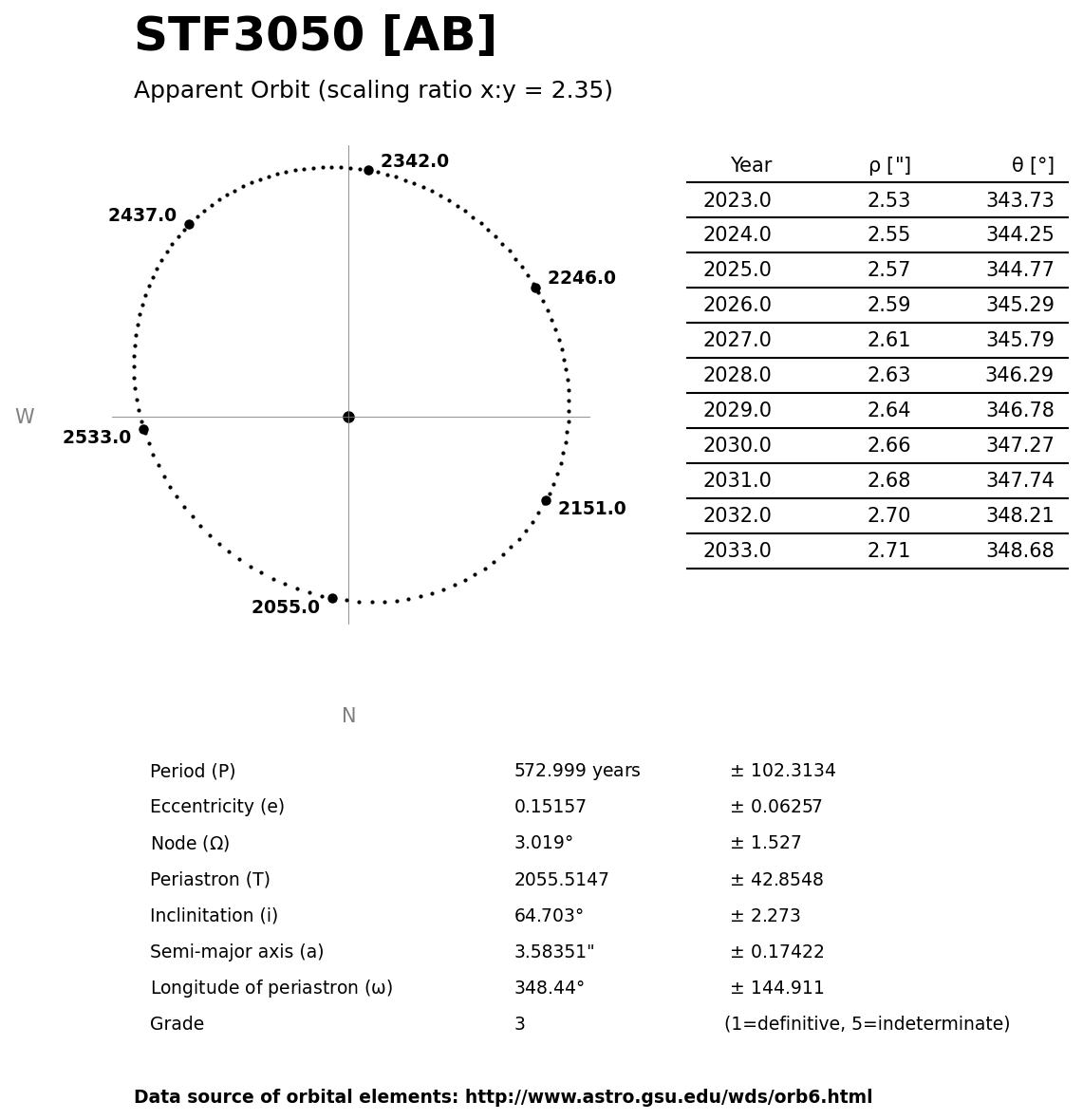|
m1 |
m2 |
ρ |
θ |
Year |
|
Coordinates (J2000.0) |
|
★★★
|
STTA254, WZ Cas |
|
AB |
7m.4 |
8m.3 |
57.8" |
89° |
2019 |
Cas |
00h01m15.85s / +60°21'19.00" |
|
|
|
|
AC |
7m.4 |
9m.6 |
155.4" |
324° |
2015 |
|
|
|
|
|
|
AD |
7m.4 |
10m.3 |
181.4" |
118° |
2016 |
|
|
Christopher Hay
Seeheim (Germany) |
6x24 |
AB: Clearly split. A definitely brighter than B. Under a NELM 5m5 sky both components appear weak in these mini-binoculars and no colour impression arises.;
WZ Cas is the variable designation of component A of STTA254. This semiregular carbon star has a mean brightness range of 6m8 to 7m7, and can reach extreme values of 6m3 at one end and 8m8 at the other. Perhaps it was too deep in a minimum at the time of observation to show colour with 1 inch of aperture? 15x45 binoculars revealed colour in this night, see observation below. |
|
Christopher Hay
Seeheim (Germany) |
15x45 |
AB: Wide split. A orange-red, B no particular colour. NELM 5m5, same night as 6x24 observation above. |
|
René Merting
Drachhausen (Germany) |
15x56 |
AB: einfach - beide Sterne zeigen sich komfortabel getrennt - Komponente A strahlt gelblich - Komponente B südöstlich wirkt dagegen grau und ist 1.5 bis 2 Größenklassen schwächer |
|
Robert Zebahl
Leipzig (Germany) |
16x70 |
AB: 2020-08-19: Intense orange & bluish. Very striking. |
|
René Merting
Drachhausen (Germany) |
16x70 |
AB: ein schöner Fernglas-Doppelstern - Komponente A im Westen präsentiert sich dunkelgelb (noch nicht orange), B im Osten ist eher weißlich |
|
René Merting
Drachhausen (Germany) |
18x70 |
AB: ein sehr auffälliger Doppelstern mit einem schönen Farbkontrast - A strahlt gelb, das kurz davor steht, ins Orange über zu gleiten - B wirkt im Kontrast aquamarin, so dezent wie eine typische PN-Farbe |
|
René Merting
Drachhausen (Germany) |
76mm (29x) |
AB: bei 29x ein wunderschönes Sternpaar mit einem auffälligen Farbkontrast, weit getrennt - Komponente B wirkt weißgrau bis weißblau gegen die gelborange strahlende A-Komponente - Helligkeitsunterschied eine Größenklasse |
|
René Merting
Drachhausen (Germany) |
76mm (29x) |
AB: Mondscheinbeobachtung - bei 29x ein weit getrenntes Pärchen, bei dem die A-Komponente nicht durch Strahlkraft, sondern durch seine auffallende Farbe besticht, ein sehr kräftiges Kupferorange - es gibt hellere Sterne im Umfeld, aber diese Komponente fällt besonders auf - die B-Komponente ist gut 1.5 mag schwächer und wirkt grau bis graublau |

|
Robert Zebahl
Leipzig (Germany) |
80mm (33x) |
AB: Nice double star. Brighter component appeared orange, the fainter more bluish. |
|
René Merting
Drachhausen (Germany) |
100mm (20x) |
AB: 20x reicht zwar schon für eine klare Trennung, aber Komponente B im Osten ist nur dumpf grau-blau und noch zu schwach für den schönen Farbkontrast, der sich bei 32x offenbart - Komponente A strahlt dann in einem satten Bernsteingelb, B im Osten gibt sich unterkühlt bläulich - Helligkeitsunterschied 1 bis 1.5 Größenklassen, schwierig abschätzbar wegen der Farben |
|
Sarah Gebauer
Germany |
100mm (49x) |
AB: sticht sofort ins Auge aufgrund des stärksten kupferroten Farbtons, den ich seit langem gesehen habe - der Begleiter strahlt bei 49-fach schon weit abgesetzt in einem graublauen, ganz kühlen Farbton |

|
Robert Zebahl
Leipzig (Germany) |
102mm (28x) |
AB: 2019-08-22: Splendid view. Primary component clearly orange, secondary blue. |
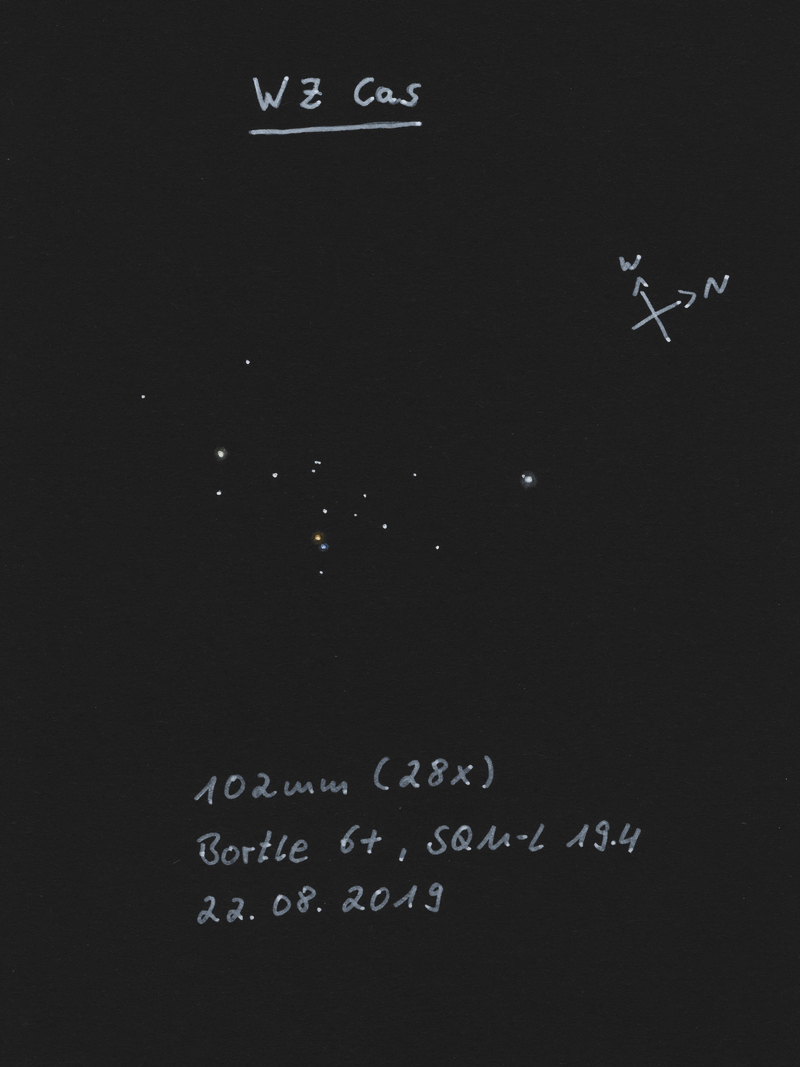
|
Jörg S. Schlimmer
Germany |
127mm (136x) |
Sehr schöner Farbkontrast |
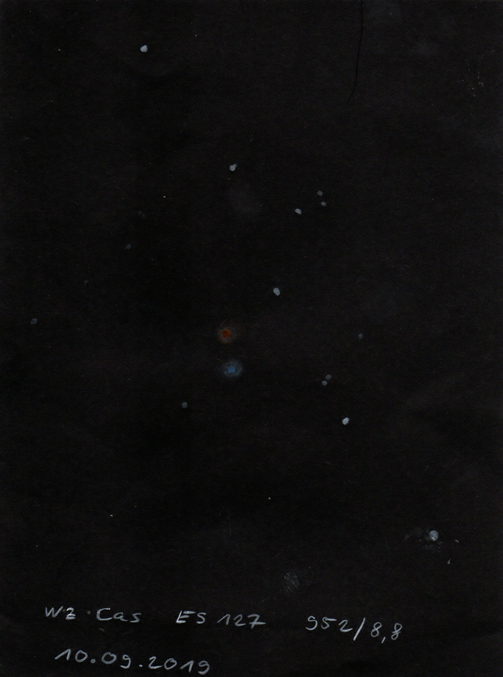
|
Mark McCarthy
Fremont (California/USA) |
317mm (553x) |
AB: WZ Cas: Pretty, deep orange A and very wide half delta mag B, white. |
|
René Merting
Drachhausen (Germany) |
320mm (45x) |
AB: bei 45x ein weit getrenntes Pärchen mit wunderschönen Farbkontrast, Komponente A im Westen ist grell-orange und die gut 1.5 Magnituden schwächere Komponente B ist aquamarin-grau |
|
|
Robert Zebahl
Leipzig (Germany) |
102mm |
|
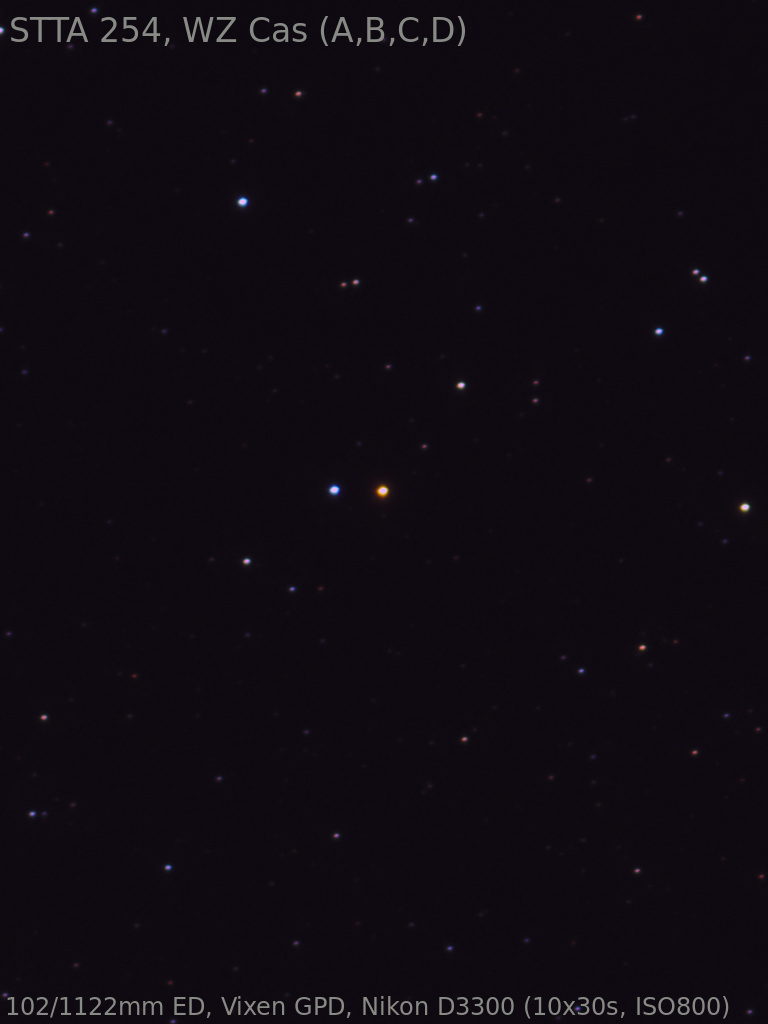
|
|
|
★
|
STF3053 |
|
AB |
6m.0 |
7m.2 |
15.2" |
70° |
2018 |
Cas |
00h02m36.08s / +66°05'56.30" |
Christopher Hay
Seeheim (Germany) |
15x45 |
Binoculars with internal stabilisation, handheld. Fine split with black in-between. A-component slightly orange. Colour of B-component hard to determine because of proximity to and glare of A-component, but does tend towards blue. |
|
Robert Zebahl
Leipzig (Germany) |
63mm (46x) |
Easy to split with noticeable difference in brightness. Brighter component appeared slightly orange, fainter one bluish. |
|
René Merting
Drachhausen (Germany) |
76mm (57x) |
bei 29x ein wunderschönes, gut getrenntes Sternpaar - Komponente B im Nordosten schimmert kühlweiß, die A-Komponente zart weißgelblich, dadurch ein dezenter Farbkontrast - bei 57x wird der Farbkontrast deutlicher, B ist etwas mehr als eine Magnitude schwächer und wirkt nun blau-grau, Komponente A strahlt deutlich hellgelb |
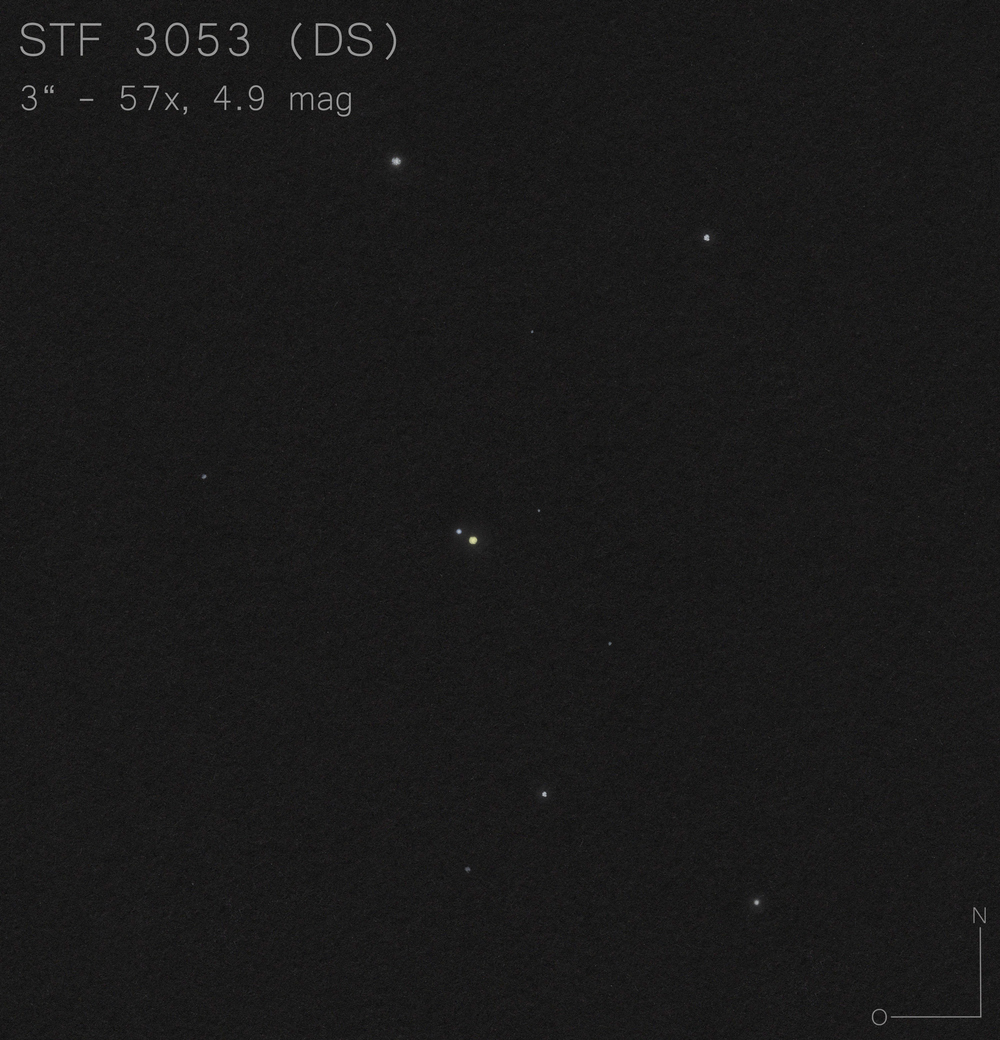
|
René Merting
Drachhausen (Germany) |
100mm (20x) |
bei 20x knapp getrennt, Komponente B östlich ist halb so hell wie A - während Komponente A weiß-gelblich strahlt, zeigt B sich weiß mit einem leichten Stich ins bläuliche |
|
Sarah Gebauer
Germany |
100mm (21x) |
schon in Aufsuchvergrößerung ganz leicht gelblich zu sehen und ist hauchfein getrennt - bei 49-fach dann nah, aber deutlich getrennt - die Hauptkomponente strahlt richtig schön goldgelb, der Begleiter zeigt ein schmutziges Gelb |
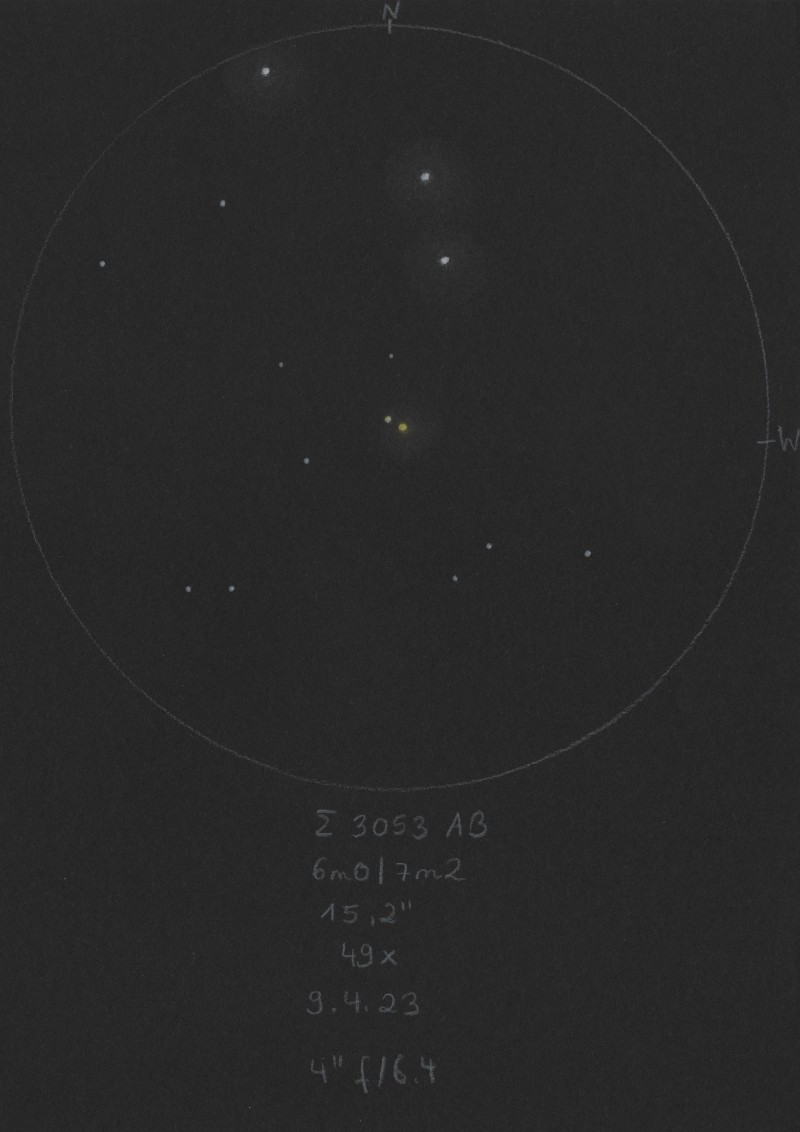
|
Sarah Gebauer
Germany |
100mm (49x) |
26.09.23: bei 49-fach ein ganz klassisch schönes, schmales Farbkontrastpaar - die westliche Komponente zeigt ein helles Orangegold, die östliche Grau mit einem Hauch hell leuchtendem Leinblütenblau |
|
Axel Tute
Küssaberg (Germany) |
200mm (77x) |
26.10.2006: Beautiful pair of stars in an interesting star field. Easy to separate in the C8 with the 26mm Plössl eyepiece. A is slightly orange, B is slightly greenish. Also very nice in the Comet Catcher (140/500mm Schmidt-Newton) at 50x in the 10mm Plössl. |
|
Mark McCarthy
Fremont (California/USA) |
317mm (553x) |
Pretty, orange and blue like Alberio. ~1.5 delta mag. |
|
|
|
★
|
GIC2 |
|
AB |
7m.8 |
11m.5 |
29.7" |
236° |
2018 |
Peg |
00h09m15.74s / +25°16'55.00" |
Mark McCarthy
Fremont (California/USA) |
317mm (277x) |
New designation to me: Harry Giclas, Lowell proper motion survey -- the man who hired Robert Burnham! Faint yellow-orange star with fainter and very wide companion. Possible 3rd to make a triangle. (AB seen, 4 stars in system) |
|
|
|
★
|
STF2 |
|
|
6m.7 |
6m.9 |
0.9" |
15° |
2019 |
Cep |
00h09m20.18s / +79°42'52.40" |
|
|
Uwe Pilz
Leipzig (Germany) |
105mm (198x) |
Schneemann-Figur. Abstand 0“91 |

|
Mark McCarthy
Fremont (California/USA) |
152mm (175x) |
Light orange stars, very tight, hairline split, near equal mag. Physical with a 540-year period it is to slowly widen. 22% parallax overlap, only 82 AU weighted separation, 2.16/2.10 solar mass |
|
Frederik Wanink
Itterbeck (Germany) |
254mm (640x) |
getrennt |

|
|
|
★
|
STF7 |
|
|
8m.0 |
8m.5 |
1.3" |
210° |
2017 |
Cas |
00h11m38.91s / +55°57'40.90" |
Mark McCarthy
Fremont (California/USA) |
152mm (175x) |
Very fine white stars, <1 delta mag, very closely split. WDS is uncertain, but there is 86% overlap of parallax ranges, only 546 AU weighted separation, 3.14/2.78 solar mass, so likely gravitational |
|
Robert Zebahl
Leipzig (Germany) |
152mm (210x) |
Clearly separated with rather close components. Slightly unequal. Pretty double. |
|
Axel Tute
Küssaberg (Germany) |
200mm (250x) |
12.10.2006: Difficult pair. Observation was made with 12mm RKE (167x) and the 8mm RKE (250x) with the C8. Most of the time the stars were not separated, but clearly showed an 8. However, in moments of better air quietness a gap could be observed for a short time. The PA was estimated to be 220°. |
|
René Merting
Drachhausen (Germany) |
320mm (240x) |
bei 240x sind beide Sterne in guten Momenten knapp getrennt erkennbar - A und B wirken gleich hell |
|
|
|
★
|
STF12, 35 Psc |
|
|
6m.1 |
7m.5 |
11.2" |
148° |
2019 |
Psc |
00h14m58.84s / +08°49'15.50" |
Robert Zebahl
Leipzig (Germany) |
70mm (22x) |
At 22x pretty bright but uneven pair with relatively close components. At 44x the brighter component looked slightly yellowish, the fainter one slightly bluish. The double star could be observed together with STF22 (38 Psc) in the same field of view and stands in nice contrast to it. |
|
Sarah Gebauer
Germany |
100mm (49x) |
24.09.23: mit 49x sauber getrennt, ein schmales Paar - auf den ersten Blick wenig Farbe zu sehen, doch dann zeigt sich spontan "gelb-blau", ab dann taucht die Farbe mal auf und verschwindet wieder - die Hauptkomponente zeigt ein dunkles Gelb mit einem Hauch Orange, der Begleiter ein glänzendes Hellblau |
|
Mark McCarthy
Fremont (California/USA) |
317mm (553x) |
Yellow and white, ~1 delta mag, PA to S. |
|
Mark McCarthy
Fremont (California/USA) |
508mm (205x) |
Very bright A, white, wide, 1 delta mag. [Spectral type A9V+F3V (white/yellow-white)]. WDS says physical, but the parallax ranges do not overlap (-17%), so they are not gravitational |
|
|
|
★
|
STF13 |
|
|
7m.0 |
7m.1 |
1.0" |
49° |
2018 |
Cep |
00h16m14.02s / +76°57'03.00" |
|
|
Mark McCarthy
Fremont (California/USA) |
152mm (175x) |
Equal white stars, hairline split. Nice! Physical with a 1245-year period. 69% parallax range overlap, 173 AU weighted separation, 2.63/2.47 Msol |
|
|
|
★
|
STF19 |
|
|
7m.1 |
9m.5 |
2.3" |
140° |
2016 |
And |
00h16m43.02s / +36°37'47.40" |
Mark McCarthy
Fremont (California/USA) |
152mm (175x) |
Exceptional! White A, B is very faint and only 1" separated, seen direct vision but just barely. WDS uncertain, but there is 44% parallax overlap, only 312 AU weighted separation, and 2.15/1.29 stellar mass |
|
René Merting
Drachhausen (Germany) |
320mm (144x) |
bei 144x ist die B-Komponente ganz knapp getrennt abgesetzt von der hell strahlenden A-Komponente zu erkennen - B ist mindestens 2 Magnituden schwächer |
|
|
|
★
|
BU392 |
|
|
5m.7 |
12m.5 |
19.5" |
71° |
2007 |
Cas |
00h16m57.05s / +61°31'59.50" |
Mark McCarthy
Fremont (California/USA) |
317mm (553x) |
Yellow A star. 12th mag B swims into view with averted vision and seeing, then can hold it direct as a bluish point. |
|
|
|
★
|
STF22, 38 Psc |
|
AB-C |
7m.1 |
7m.7 |
3.9" |
234° |
2020 |
Psc |
00h17m24.50s / +08°52'34.80" |
|
|
|
|
AB-D |
7m.1 |
11m.5 |
66.8" |
151° |
2005 |
|
|
Robert Zebahl
Leipzig (Germany) |
70mm (44x) |
AB-C: At 44x separated with almost touching diffraction disks and small difference in brightness. At 57x clearly separated, but still quite close together. It stands in beautiful contrast to the nearby double star STF12 (35 Psc). |
|
Mark McCarthy
Fremont (California/USA) |
317mm (553x) |
AB-C: near equal white pair, well split, B ~1/2 delta mag, PA to SW. |
|
Mark McCarthy
Fremont (California/USA) |
508mm (205x) |
AB-C: Wide pair, easy, one delta mag. WDS uncertain, however there is no overlap of parallax ranges (-94%) |
|
|
|
★
|
ES41 |
|
|
8m.0 |
11m.2 |
6.7" |
218° |
2016 |
Cas |
00h18m21.55s / +49°30'35.10" |
Mark McCarthy
Fremont (California/USA) |
317mm (553x) |
B appeared while putting my eye to the eyepiece -- then disappeared. B needs averted vision to see -- can barely hold it direct vision. Wide, 4 delta mag. |
|
|
|
★
|
AC1 |
|
|
7m.3 |
8m.3 |
1.9" |
291° |
2020 |
And |
00h20m54.10s / +32°58'40.90" |
|
|
Robert Zebahl
Leipzig (Germany) |
102mm (125x) |
Very attractive, relatively close with a clearly visible difference in brightness. In the immediate vicinity a brighter star shines in a lovely orange. Very nice contrast! |
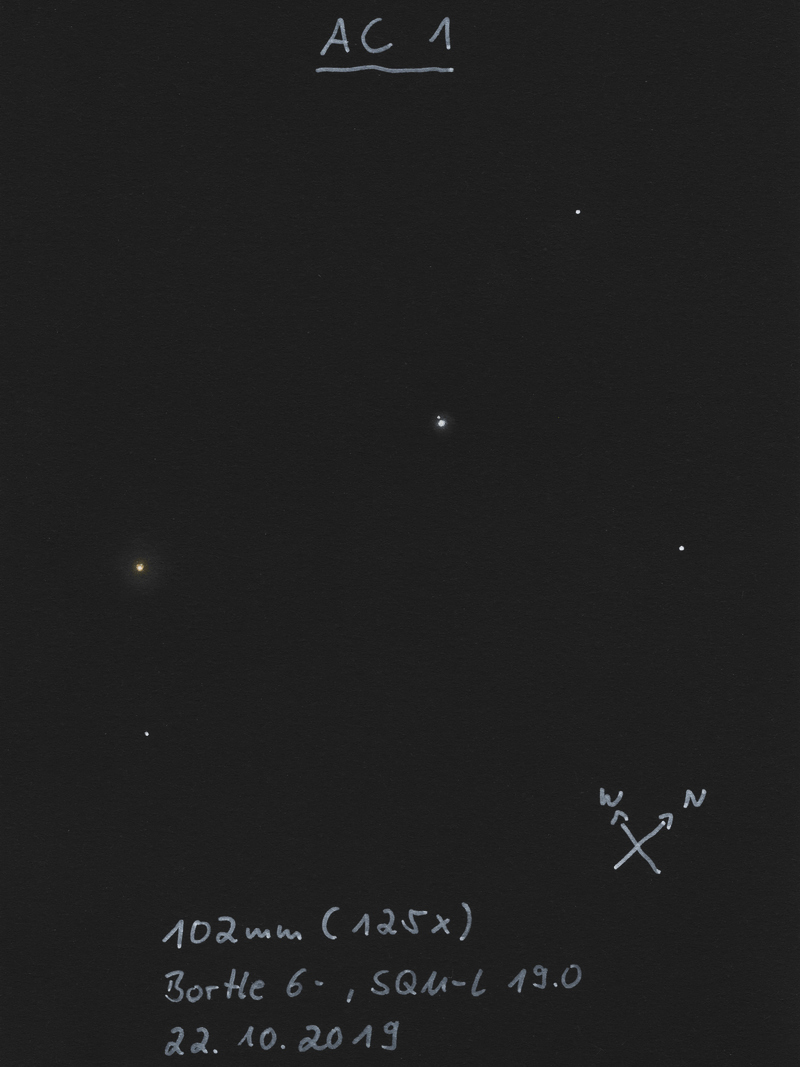
|
Uwe Pilz
Leipzig (Germany) |
105mm (200x) |
orange. Leuchtend gelber Stern in 5' Abstand |
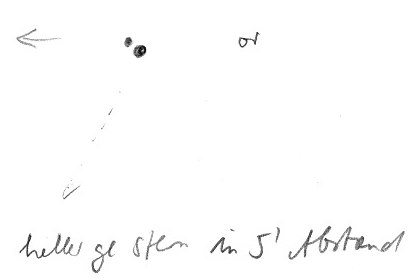
|
Mark McCarthy
Fremont (California/USA) |
152mm (175x) |
Around half a delta mag, nice and close split. Physical with a 525-year period. At apastron |
|
|
|
★
|
BU1095, 28 And |
|
AB |
5m.2 |
13m.1 |
2.0" |
16° |
2008 |
And |
00h30m07.34s / +29°45'06.10" |
Mark McCarthy
Fremont (California/USA) |
317mm (553x) |
Very bright yellow- white A. B is a very faint but consistent point resolved just beyond the first diffraction ring when seeing stills. |
|
|
|
★
|
BU394 |
|
AB |
8m.5 |
8m.8 |
0.8" |
278° |
2018 |
Cas |
00h30m45.56s / +47°31'47.50" |
|
|
Mark McCarthy
Fremont (California/USA) |
317mm (553x) |
Very fine, pop split with seeing, near equal. |
|
|
|
★
|
BU1227 |
|
AB |
7m.2 |
10m.6 |
2.8" |
194° |
2016 |
Cas |
00h32m21.78s / +58°20'19.10" |
|
|
|
|
AC |
7m.2 |
11m.8 |
22.4" |
80° |
2015 |
|
|
|
|
|
|
AD |
7m.2 |
11m.7 |
30.9" |
112° |
2015 |
|
|
Mark McCarthy
Fremont (California/USA) |
317mm (553x) |
AB: Yellow and 3 delta mag B, orange, comes into view direct vision but only with seeing, 2-3". |
|
Mark McCarthy
Fremont (California/USA) |
317mm (553x) |
AC: Faint star, 1 delta mag fainter than B, widely separated, PA 90 degrees from AD |
|
Mark McCarthy
Fremont (California/USA) |
317mm (553x) |
AD: Faint star, 1 delta mag fainter than B, more widely separated than C, at 90 degrees PA from C |
|
|
|
★
|
STF46, 55 Psc |
|
|
5m.6 |
8m.5 |
6.6" |
195° |
2016 |
Psc |
00h39m55.57s / +21°26'18.60" |
Robert Zebahl
Leipzig (Germany) |
70mm (44x) |
Clearly separated, but large difference in brightness. The companion appeared only as a tiny, faint star. The primary component sparkled in light orange. |
|
Sarah Gebauer
Germany |
100mm (80x) |
24.09.23: das vermutlich kleinste Doppelsternpaar, das ich je gesehen habe, mit 80x getrennt zu sehen - A im Norden strahlt aprikosengoldfarben, B im Südosten erscheint so viel schwächer, dass selbst mausgrau übertrieben wäre, er kommt eher wie ein winziger, dunkelgrauer Tupfen daher, der sich hinter A verstecken möchte |
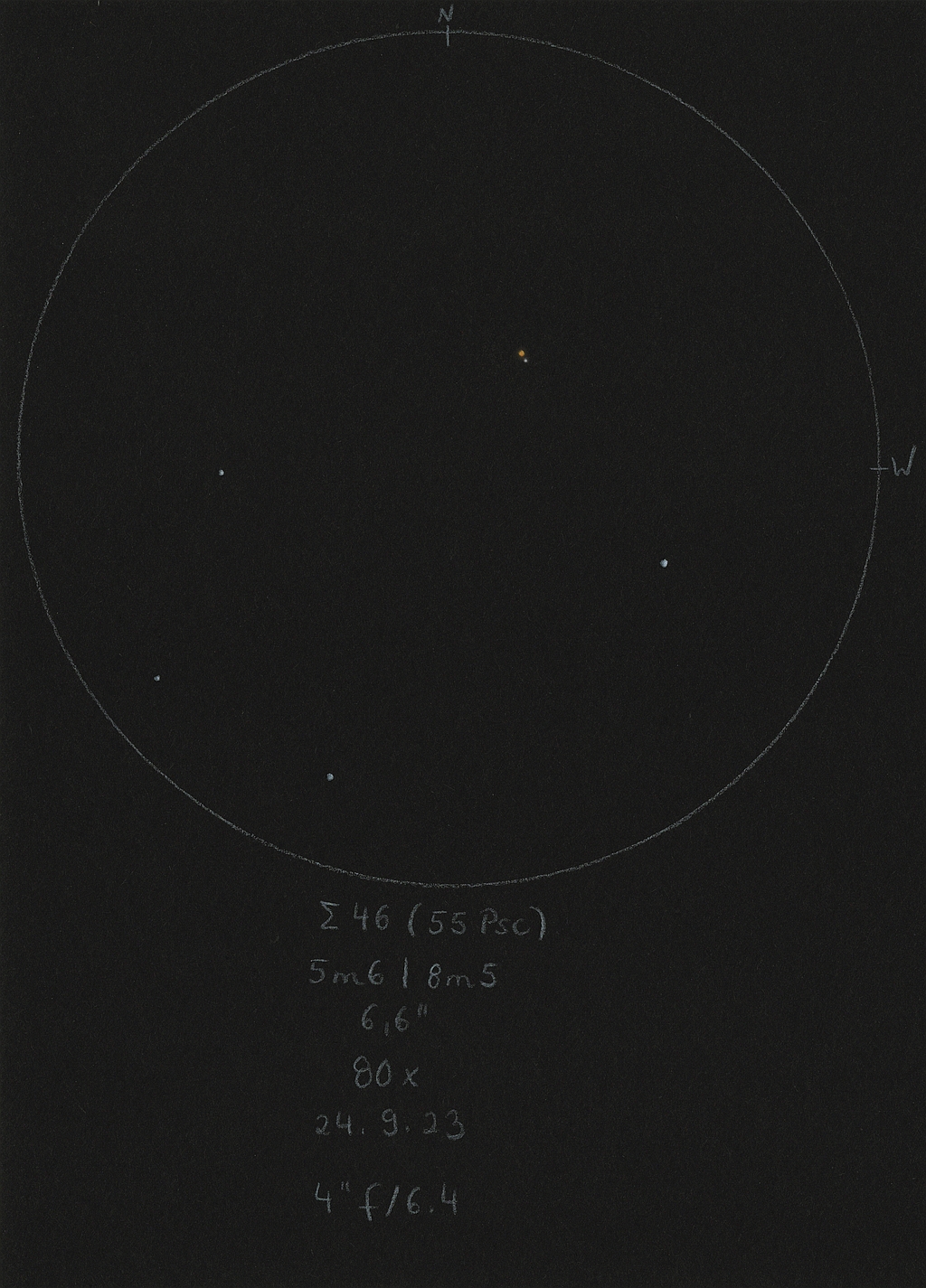
|
Mark McCarthy
Fremont (California/USA) |
317mm (553x) |
Orange with wide separated blue B. |
|
René Merting
Drachhausen (Germany) |
320mm (103x) |
|

|
|
|
★★
|
eta Cas, 24 Cas |
STF60 |
AB |
3m.5 |
7m.4 |
13.6" |
326° |
2020 |
Cas |
00h49m06.29s / +57°48'54.70" |
|
|
|
STF60 |
AC |
3m.5 |
11m.4 |
225.0" |
260° |
2000 |
|
|
|
|
|
STF60 |
AD |
3m.5 |
12m.8 |
189.4" |
354° |
2011 |
|
|
|
|
|
STF60 |
AE |
3m.5 |
10m.2 |
75.6" |
126° |
2015 |
|
|
|
|
|
STF60 |
AF |
3m.5 |
11m.5 |
378.3" |
276° |
2000 |
|
|
|
|
|
STF60 |
AG |
3m.5 |
9m.5 |
419.7" |
259° |
2012 |
|
|
|
|
|
STF60 |
AH |
3m.5 |
8m.4 |
701.1" |
355° |
2012 |
|
|
|
|
|
SMR2 |
AI |
3m.5 |
11m.6 |
90.3" |
73° |
2012 |
|
|
|
|
|
SMR2 |
AJ |
3m.5 |
12m.3 |
237.1" |
262° |
2012 |
|
|
|
|
Robert Zebahl
Leipzig (Germany) |
70mm (57x) |
AB: Easy to split with big difference in brightness. Fainter component appeared deep orange to slightly red colored, brighter component tends to be more slightly yellowish. |
|
René Merting
Drachhausen (Germany) |
76mm (29x) |
AB: Mondscheinbeobachtung - bei 29x zeigt sich Komponente A in einem schönen hellen und doch intensiven Gelb - Komponente B ist knapp getrennt nordwestlich von A erkennbar, das wirkt aber noch nicht richtig souverän - riesiger, nicht abschätzbarer Helligkeitsunterschied - B wirkt kupferbraun, manchmal auch nur grau - bei 57x sind beide Sterne etwas mehr als knapp getrennt zu erkennen und das kupferbraun bei B setzt sich durch |
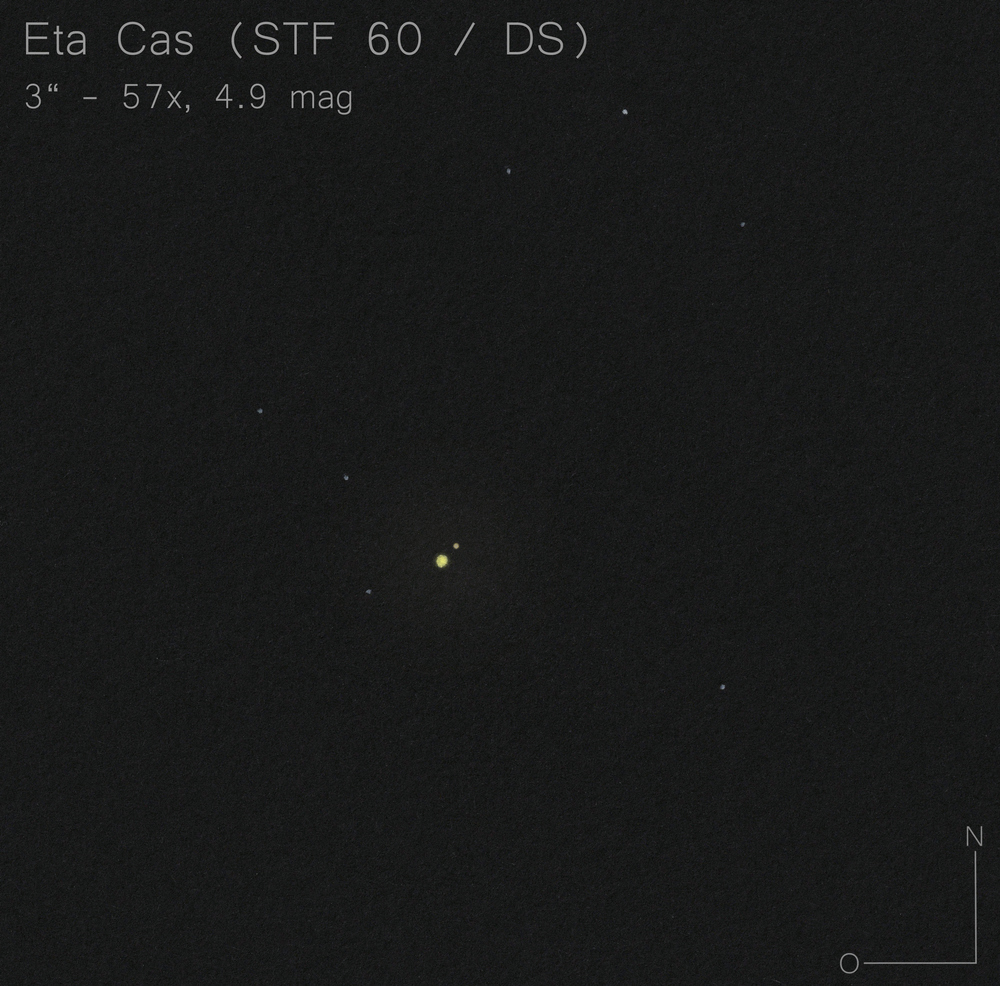
|
René Merting
Drachhausen (Germany) |
100mm (32x) |
AB: bei 32x ist Komponente A so hell, dass B trotz des augenscheinlich großen Abstandes von 13,4" nur knapp getrennt zu sehen ist - Komponente A ist gleißend hell-gelb, B dürfte mindestens 3 Größenklassen schwächer sein und wirkt dadurch dumpfer |
|
Sarah Gebauer
Germany |
100mm (49x) |
AB: bei 49-fach schmal und schön getrennt - so ein starker, warmgoldener Farbton, der richtig leuchtkräftig ist, ein echter Blickfang - der Begleiter zeigt eine ähnliche Farbe, aber doch matter und bräunlicher |
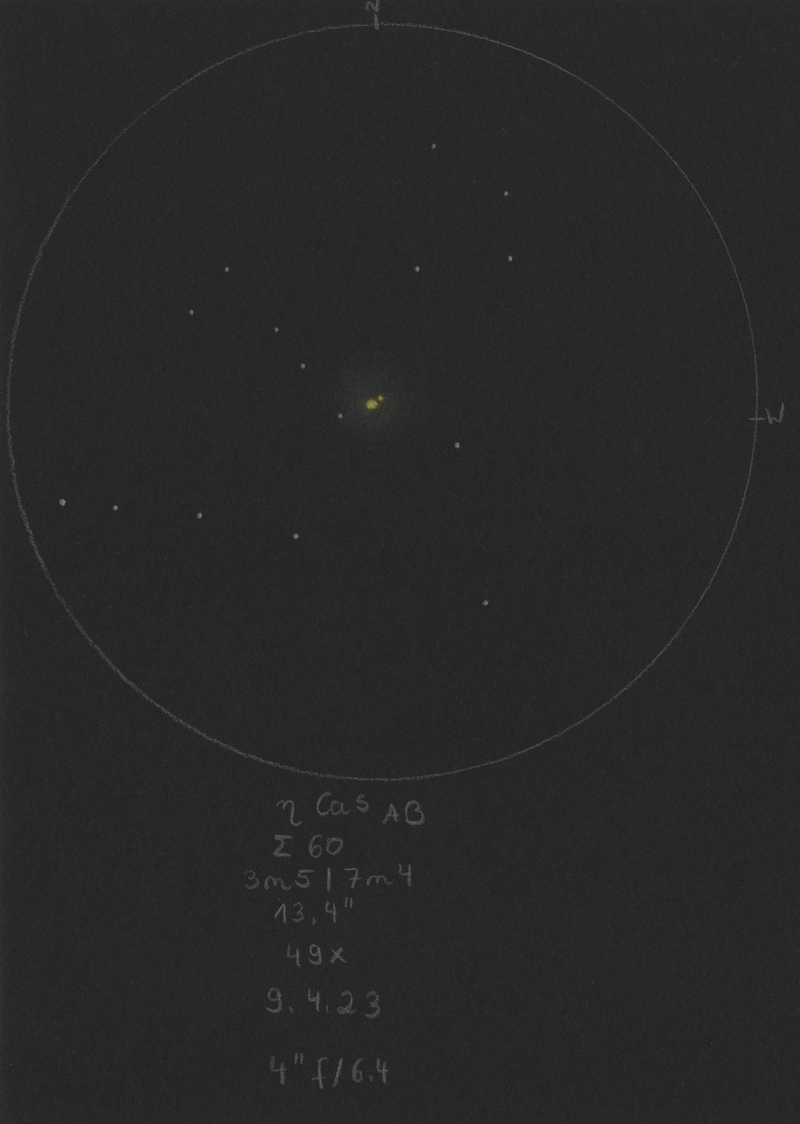
|
Uwe Pilz
Leipzig (Germany) |
105mm (53x) |
AB: leicht |
|
Uwe Pilz
Leipzig (Germany) |
105mm (288x) |
kein Sternentstehungsgebiet! |

|
Sarah Gebauer
Germany |
150mm (54x) |
AB: bei 54x erst nur einen Stern gesehen, doch da, ganz schwach darunter doch die wesentlich schwächere, zweite Komponente entdeckt |
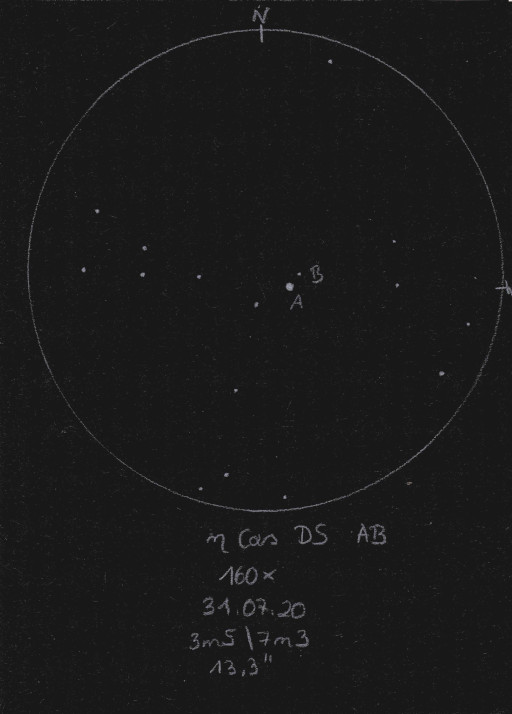
|
Robert Zebahl
Leipzig (Germany) |
152mm (30x) |
AB: 2021-09-11: Light yellow & red-brownish. |
|
Winfried Kräling
Marburg (Germany) |
152mm (175x) |
|
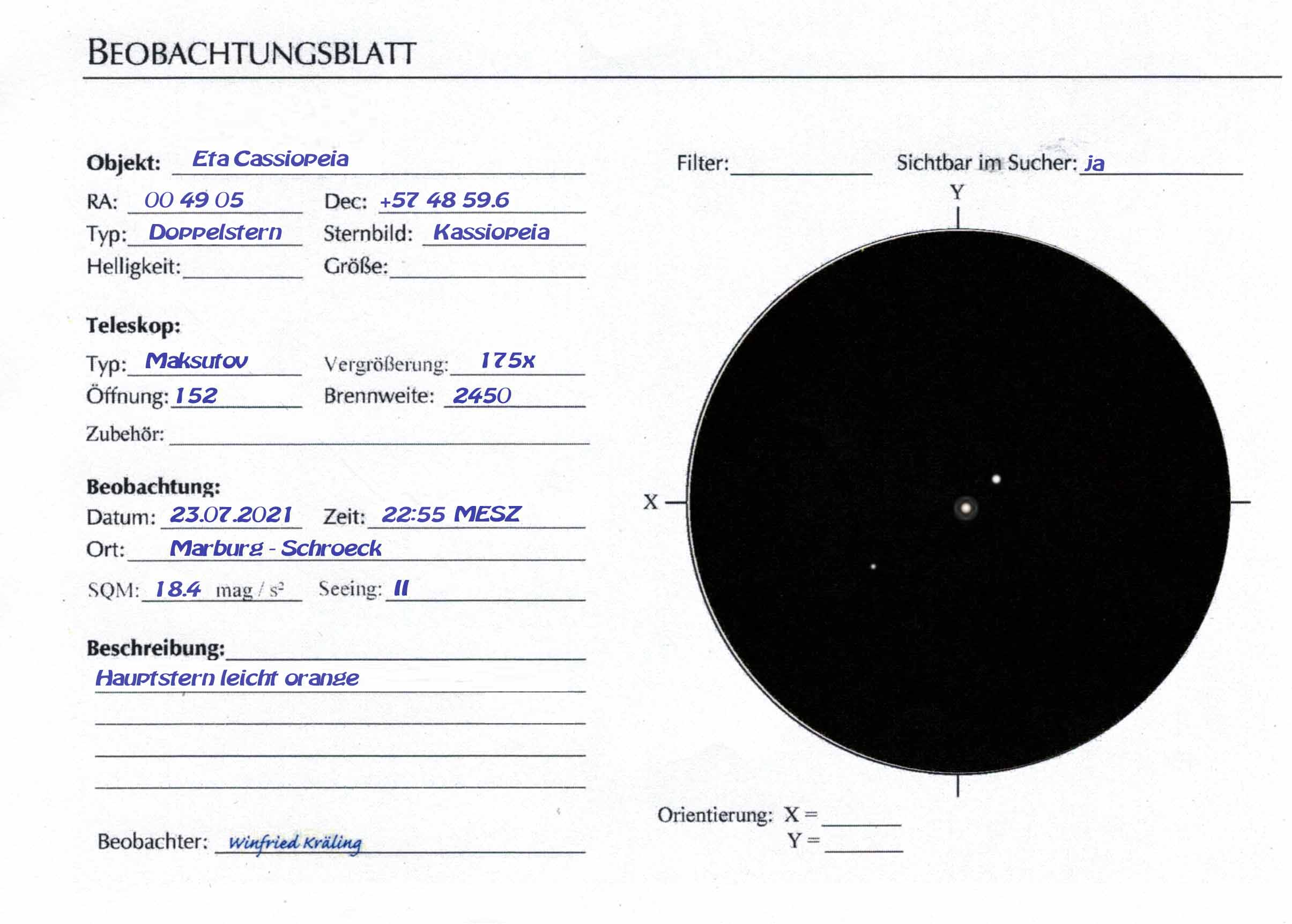
|
Axel Tute
Küssaberg (Germany) |
200mm (77x) |
AB: 30.10.2006: Easy to separate in the C8 with the 26mm Plössl eyepiece. A is bluish. B is reddish. PA estimated 300°. |
|
Mark McCarthy
Fremont (California/USA) |
317mm (553x) |
AB: Nice yellow pair. A is a red tainted yellow, B is cleaner. |
|
René Merting
Drachhausen (Germany) |
320mm (72x) |
AB: bei 72x ein echt fetter Farbkontrast, Komponente A ist gleißend hell und zitronengelb, B zeigt sich knallig orange - beide Sterne sind gut getrennt voneinander zu beobachten - sehenswert |
|
|
|
★
|
65 Psc, STF61 |
|
|
6m.3 |
6m.3 |
4.4" |
115° |
2020 |
Psc |
00h49m52.88s / +27°42'38.90" |
Robert Zebahl
Leipzig (Germany) |
56mm (17x) |
2024-10-31: Clearly separated with equally bright components without visible color difference. The double star is quite isolated and therefore stands out in the field. |
|
Mark McCarthy
Fremont (California/USA) |
317mm (277x) |
Bright orange pair, 6-7" |
|
|
|
★
|
BU232 |
|
AB |
8m.5 |
8m.8 |
0.9" |
256° |
2018 |
Cas |
00h50m25.10s / +50°37'49.60" |
|
|
|
|
AB-C |
8m.5 |
10m.1 |
24.5" |
299° |
2018 |
|
|
|
|
Mark McCarthy
Fremont (California/USA) |
203mm (533x) |
AB: Nice, well split, near equal. Part of a triple, the next one much wider in same PA and two delta mag. [AB-C is 10.06 24.5"] |
|
Mark McCarthy
Fremont (California/USA) |
317mm (553x) |
AB: Neat near equal orange and yellow. Split with seeing, 1". |
|
Mark McCarthy
Fremont (California/USA) |
317mm (553x) |
AB-C: C 2 delta mag fainter than B, about 25" separated, is the +1 star with BU232AB |
|
|
|
★
|
MLR27 |
|
|
10m.2 |
10m.2 |
0.5" |
212° |
2008 |
Cas |
00h51m10.71s / +60°18'54.20" |
Mark McCarthy
Fremont (California/USA) |
508mm (1067x) |
Split with seeing, tremulous in turbulence but does split when settled. Noticeable delta mag. |
|
|
|
★
|
STF65 |
|
|
8m.0 |
8m.0 |
3.2" |
221° |
2020 |
Cas |
00h52m45.61s / +68°51'59.30" |
Robert Zebahl
Leipzig (Germany) |
70mm (57x) |
Clearly split with equally bright components. |
|
René Merting
Drachhausen (Germany) |
76mm (95x) |
bei 57x ist eine kleine, feine 8 zu erkennen - 95x trennen die beiden gleich hellen Protagonisten ganz knapp |
|
Mark McCarthy
Fremont (California/USA) |
152mm (175x) |
Near equal, white, well separated. WDS uncertain, but they probably are gravitational with 73% parallax range overlap, 656 AU weighted separation, 2.22/2.24 Msol |
|
Mark McCarthy
Fremont (California/USA) |
317mm (553x) |
Equal pair, white-yellow. Wide and pretty bright |
|
|
|
★★
|
BU1 |
|
AB |
8m.6 |
9m.3 |
1.5" |
82° |
2018 |
Cas |
00h52m49.22s / +56°37'39.50" |
|
|
|
|
AC |
8m.6 |
8m.9 |
3.9" |
134° |
2020 |
|
|
|
|
|
|
AD |
8m.6 |
9m.7 |
8.9" |
195° |
2020 |
|
|
|
|
|
|
AE |
8m.6 |
12m.1 |
15.8" |
333° |
2015 |
|
|
|
|
|
|
CD |
8m.9 |
9m.7 |
7.8" |
220° |
2020 |
|
|
Robert Zebahl
Leipzig (Germany) |
70mm (57x) |
AC: Easy to split with little difference in brightness. |
|
Robert Zebahl
Leipzig (Germany) |
70mm (57x) |
AD: Relatively large angular distance with obviously fainter component. |
|
Mark McCarthy
Fremont (California/USA) |
317mm (553x) |
AB: In the finder there is a right triangle of equal stars, the foot star has a very faint, 2-3 delta mag star very close ~1", faint split. Some fainter stars wreathed about it. AC and AD appear to be the other triangle stars. 17 stars visible in the system, which I suppose ought to be called an open cluster |
|
René Merting
Drachhausen (Germany) |
320mm (111x) |
bei 72x sind im Zentrum des Haufens IC 1590 vier Sterne in einer Reihe auszumachen - bei 111x zeigt sich, dass der vormals hellste Stern in der Sternkette aus drei Komponenten (AB, C , D) besteht, was für eine Überraschung |
|
|
|
★
|
A1258 |
|
|
9m.7 |
9m.9 |
0.6" |
200° |
2020 |
Cas |
00h54m23.37s / +54°31'41.00" |
Mark McCarthy
Fremont (California/USA) |
508mm (1067x) |
Yes! I got it split, what a sight! Suspected at 533x. Reddish A, 1 delta mag brighter than blue B. Perfect star images. Nice color pair |
|
|
|
★
|
HU802 |
|
|
7m.8 |
10m.0 |
0.3" |
220° |
2009 |
Cas |
00h54m53.84s / +49°24'18.90" |
Mark McCarthy
Fremont (California/USA) |
508mm (1067x) |
Hairline split to overlapping, 1 delta mag, super fine |
|
|
|
★★
|
STF73, 36 And |
|
AB |
6m.1 |
6m.5 |
1.2" |
335° |
2020 |
And |
00h54m58.02s / +23°37'42.40" |
Sarah Gebauer
Germany |
100mm (136x) |
beide Sterne tanzen wild umeinander herum, blickweise ist er kurz getrennt |
|
Robert Zebahl
Leipzig (Germany) |
102mm (125x) |
Clearly visible as figure '8' with a rather small difference in brightness. |
|
Uwe Pilz
Leipzig (Germany) |
105mm (198x) |
ganz einfach |
|
Uwe Pilz
Leipzig (Germany) |
105mm (240x) |
gelb und weiß |
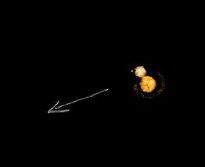
|
Mark McCarthy
Fremont (California/USA) |
152mm (175x) |
Superfine near equal yellow-orange stars, nice! Binary with 167.5-year period. It is nearly at apastron and will widen very slightly by 2040 |
|
Robert Zebahl
Leipzig (Germany) |
152mm (300x) |
Split with little gap in between and little difference in brightness. Seeing was not really good. |
|
Frederik Wanink
Itterbeck (Germany) |
254mm (640x) |
hell |
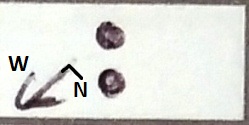
|
|
|
★
|
TDS1665 |
|
|
10m.5 |
10m.5 |
0.6" |
29° |
2016 |
Cas |
00h55m08.24s / +57°13'30.80" |
Mark McCarthy
Fremont (California/USA) |
508mm (1067x) |
Can tell is double, elongated, and I got one split in ten seconds, seeing needs to be perfect |
|
|
|
★
|
TDS1670 |
|
|
11m.6 |
11m.6 |
0.7" |
26° |
2015 |
Cas |
00h55m57.82s / +58°32'38.90" |
Mark McCarthy
Fremont (California/USA) |
508mm (1067x) |
Rather wide, well split with seeing, bluish stars due to faintness. Very nice pair |
|
|
|
★
|
MAD1 |
|
|
7m.7 |
9m.1 |
0.9" |
0° |
2020 |
And |
01h00m35.58s / +47°19'14.60" |
|
|
Mark McCarthy
Fremont (California/USA) |
508mm (533x) |
Exceptionally fine split with 333x, obvious with 533x, getting really nice airy disks. ~2 delta mag, <1", pale yellow A and very light green B. Physical pair with a 925 year period. |
|
|
|
★
|
ES45 |
|
|
6m.6 |
10m.8 |
7.9" |
244° |
2016 |
Cas |
01h01m27.04s / +49°32'39.10" |
Mark McCarthy
Fremont (California/USA) |
317mm (553x) |
Orange-yellow A, need averted vision to flash B out, barely hold with direct vision. |
|
|
|
★
|
A2901 |
|
|
7m.1 |
7m.8 |
0.4" |
64° |
2018 |
Cas |
01h01m30.15s / +69°21'30.70" |
|
|
Mark McCarthy
Fremont (California/USA) |
152mm (285x) |
Seems a very subtle out of round, but not certain. Physical with a 1517-year orbit, will not significantly widen in my lifetime. Discovered at 0.2", 0.4" now. No Gaia data |
|
Mark McCarthy
Fremont (California/USA) |
317mm (885x) |
Elongated to notched with seeing |
|
|
|
★
|
BU396 |
|
|
6m.1 |
8m.6 |
1.3" |
67° |
2007 |
Cas |
01h03m37.01s / +61°04'29.40" |
Mark McCarthy
Fremont (California/USA) |
152mm (285x) |
Subtly notched snowman, unequal. Burnham discovered with the 6-inch at 1.2", obviously on a better night. WDS uncertain, no Gaia data on the secondary |
|
Mark McCarthy
Fremont (California/USA) |
317mm (553x) |
Suspected in 277x, confirmed split with 553x, Small much fainter blue B in A's diffraction -- yellow-white, ~1", ~3 delta mag. |
|
|
|
★★
|
STF88, psi 1 Psc, 74 Psc |
|
AB |
5m.3 |
5m.5 |
29.9" |
159° |
2020 |
Psc |
01h05m40.93s / +21°28'23.60" |
|
|
|
|
AC |
5m.3 |
10m.7 |
90.4" |
124° |
2017 |
|
|
|
|
|
|
BC |
5m.5 |
10m.7 |
68.5" |
109° |
2017 |
|
|
Christopher Hay
Seeheim (Germany) |
7x45 |
AB: Very tight but definitely split, binoculars handheld. Component A is very slightly brighter than B. |
|
Robert Zebahl
Leipzig (Germany) |
8x44 |
AB: 2020-11-25: Beautiful! Very nicely separated with little difference in brightness. White-yellowish & white-bluish. Separable even without using a tripod, but difficult. |
|
René Merting
Drachhausen (Germany) |
10x50 |
AB: ein etwas mehr als knapp getrenntes Pärchen zweier gleichheller Sterne |
|
Christopher Hay
Seeheim (Germany) |
15x45 |
AB: Well split, binoculars with internal stabilisation. Component A appears at first to be more orange than component B, but after about ten seconds the orange impression flips to component B, and from there on goes back and forth. Visited Psi1 Psc several times, taking breaks of a few minutes in-between, and each time the same effect occurred, with A initially appearing to be on the orange side. |
|
René Merting
Drachhausen (Germany) |
16x70 |
AB: ein ordentlich getrenntes helles Sternpaar, die südliche B-Komponente wirkt etwas weniger weiß - schöner Anblick |
|
Christopher Hay
Seeheim (Germany) |
18x80 |
AB: Psi1 Psc is well separated. Very strong visual presence in this instrument. Components almost identically bright, colourless. Strongly supplemented to the south in 4° field of view by Psi2, Psi3 and Chi. Field relatively empty to the north, which gives the field further tension. According to Stelledoppie a true physical double 275 light years distant. |
|
Mark McCarthy
Fremont (California/USA) |
152mm (175x) |
AB: Spot-on equal white stars, wide. WDS says physical, and they likely are binary: 29% parallax range overlap, 2,704 AU weighted separation and 2.76/2.52 Msol |
|
|
|
★
|
AC13 |
|
AB |
8m.1 |
9m.5 |
0.6" |
265° |
2018 |
And |
01h08m53.15s / +45°12'26.90" |
Mark McCarthy
Fremont (California/USA) |
508mm (533x) |
! AB is paired with a widely separated 11th magnitude C star forming HJ 2018. A splits beautifully at 533x, ~0.5", nearly 2 delta mag. |
|
|
|
★
|
BU235 |
|
Aa-Ab |
7m.5 |
7m.8 |
0.8" |
142° |
2018 |
Cas |
01h10m34.31s / +51°00'47.80" |
|
|
Frederik Wanink
Itterbeck (Germany) |
254mm (640x) |
Mehrfachsystem |
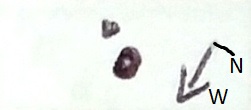
|
Mark McCarthy
Fremont (California/USA) |
508mm (333x) |
Amazing system with five faint pairings, but the main attraction is Aa-Ab, near equal bright A, hairline at 205x and and a nice clean split at 333x, light yellow stars, slight magnitude difference. Seeing giving me nice round disks. Terrific. Physical pair with a 278 year period. Amazingly, Burnham discovered this with his 6-inch |
|
|
|
★
|
STF96 |
|
|
7m.9 |
8m.9 |
0.9" |
287° |
2018 |
Cas |
01h12m41.24s / +65°00'32.90" |
Frederik Wanink
Itterbeck (Germany) |
254mm (640x) |
scheint enger als 0,9" |
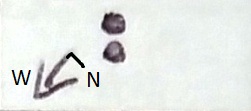
|
Mark McCarthy
Fremont (California/USA) |
317mm (553x) |
Mostly notched but moments of hairline split with seeing 1.5 delta mag. Very tough! Yellow-orange stars. |
|
|
|
★
|
BU258 |
|
AB |
6m.5 |
8m.8 |
1.6" |
263° |
2015 |
Cas |
01h13m09.82s / +61°42'22.30" |
Mark McCarthy
Fremont (California/USA) |
152mm (175x) |
Very fine, 2 delta mag, just split. WDS uncertain, Burnham discovered with his 6-inch at 0.8"! Sadly there is no parallax range overlap (-72%) |
|
Mark McCarthy
Fremont (California/USA) |
317mm (553x) |
Barely split at 340x, a brightening in the first diffraction. Wanted more certainty so went to 553x, clean split, 2" 3 detla mag. |
|
|
|
★★
|
zeta Psc, 86 Psc, STF100 |
|
AB |
5m.2 |
6m.3 |
23.1" |
64° |
2020 |
Psc |
01h13m43.80s / +07°34'31.80" |
Christopher Hay
Seeheim (Germany) |
7x50 |
On tripod. Fine split with a sliver of black between the components. No particular colour. |
|
Christopher Hay
Seeheim (Germany) |
15x45 |
Cleanly split. Western component distinctly brighter, no colour impression. |
|
Sarah Gebauer
Germany |
100mm (21x) |
24.09.23: mit 21x ein gut getrenntes Murmelpaar, die südwestliche, hellere Komponente strahlt schön warmweiß, die nordöstliche ist eine exakt verkleinerter Sterntupfen mit einem kühleren Farbton - zusammen sind sie ein sehr dominantes und durchdringendes Paar |
|
Christopher Hay
Seeheim (Germany) |
180mm (110x) |
Despite the wide separation the pair holds together visually very strongly, and dominates the FOV. And indeed, Stelledoppie states it is a true physical pair at 174 light years from us. Component A is ice-blue. I probably wouldn't have any strong colour impression coming across component B on its own, but standing next to A it seems a washed-out orange. |
|
Robert Zebahl
Leipzig (Germany) |
200mm (37x) |
Visually evident as double star and easy to find. Well split with slight difference in brightness. |
|
|
|
★
|
STF115 |
|
AB |
7m.1 |
7m.3 |
0.5" |
156° |
2020 |
Cas |
01h23m21.27s / +58°08'35.60" |
|
|
Mark McCarthy
Fremont (California/USA) |
317mm (553x) |
Peanut, near equal. in nearly the same FOV with Detla Cas, V 465 pretty orange star, and NGC 457, a loose moderately rich open cluster |
|
Mark McCarthy
Fremont (California/USA) |
508mm (533x) |
Wonderful split, more than hairline, white stars, near equal. Nice airy disks. Physical with 222 year period, Struve discovered at 0.7" approaching apastron |
|
|
|
★
|
STTA17 & BKO10 |
STTA17 |
AB |
8m.0 |
9m.8 |
35.4" |
101° |
2015 |
And |
01h24m30.85s / +39°01'30.30" |
|
|
|
STTA17 |
AC |
8m.0 |
8m.5 |
134.9" |
347° |
2014 |
|
|
|
|
|
BKO10 |
AF |
8m.0 |
11m.2 |
141.7" |
270° |
2015 |
|
|
|
|
|
STTA17 |
CD |
8m.5 |
9m.8 |
68.9" |
279° |
2015 |
|
|
|
|
|
STTA17 |
CE |
8m.5 |
13m.3 |
81.2" |
14° |
2015 |
|
|
Christopher Hay
Seeheim (Germany) |
18x80 |
The group of stars strikes the eye while sweeping from Mirach to Tau/Upsilon TRI. First thought I'd found an open cluster. Two pairs with practically opposite PAs. Southern pair AB much closer than northern CD, but brightnesses within the pairs very similar. A nice double-double. |
|
Robert Zebahl
Leipzig (Germany) |
152mm (22x) |
The components A-D and F easily visible as a rather conspicuous group with comparatively large distances. I didn't pay attention to the component E. No brighter stars in the immediate vicinity. The pair AB and CD are very similar; CD a bit wider with opposite position angle. Very nice multiple star also for smaller telescopes. |
|
René Merting
Drachhausen (Germany) |
320mm (72x) |
AB: bei 72x weit getrennt - A im Westen wirkt gelblich, B ist gut 1.5 Größenklassen schwächer und erscheint grau
CD: bei 72x sind diese beiden Compañeros ebenfalls mit etwas mehr Abstand im Norden erkennbar, sie stehen beide etwas weiter auseinander als AB - das Gesamtbild wirkt wie ein verzogenes, längliches Parallelogramm |
|
|
|
★★
|
S398 |
|
AB |
6m.3 |
8m.0 |
68.9" |
100° |
2018 |
Psc |
01h28m22.92s / +07°57'40.90" |
Christopher Hay
Seeheim (Germany) |
7x50 |
On tripod. Wide split. A orange-red, B a tiny pinprick of light. Attractive sight in 7.3° field of view, with Zeta Psc neatly on western edge of FOV.
Physical double according to Stelledoppie.
Three-star rating awarded because this is a physical double that can be resolved at 7x, while dominating the field of view with more power and presenting a strong colour contrast with more aperture (see 20x80 observation below). As an added bonus, S398 is just half a degree south of the ecliptic and is thus visited regularly by planets and the moon. |
|
Christopher Hay
Seeheim (Germany) |
20x80 |
Wide split. A reddish-white, B blue-white. Very strong visual presence with no competition in 2.5° field of view, accentuated nicely by 6-mag 96 Psc about 2/3° to the south. |
|
Sarah Gebauer
Germany |
100mm (49x) |
24.09.23: bei 49x ein sehr weit getrenntes Paar in einem beinahe gänzlich leeren Gesichtsfeld, auf den ersten Blick nur ein inneres Fragezeichen, wo die Farbe ist - auf den zweiten Blick strahlt A auf einmal in einem dunklen Buttergelb mit einem Hauch Orange, B im Südosten manchmal grau und manchmal schwach, aber hell und metallisch azurbläulich - mit ausreichend Geduld zeigt sich ein zurückhaltendes, schönes Perlchen! |
|
Mark McCarthy
Fremont (California/USA) |
317mm (553x) |
orange with 1 delta mag white to east. |
|
|
|
★
|
STT33 & DOB2 |
STT33 |
AB |
7m.3 |
9m.0 |
26.9" |
77° |
2015 |
Cas |
01h37m22.87s / +58°38'14.70" |
|
|
|
DOB2 |
AC |
7m.3 |
10m.3 |
107.0" |
109° |
2015 |
|
|
René Merting
Drachhausen (Germany) |
12x42 |
STT33 (AB): B ist relativ schwach östlich von A erkennbar, getrennt und relativ dicht stehend - Helligkeitsunterschied zwei Größenklassen |
|
René Merting
Drachhausen (Germany) |
16x70 |
STT33 (AB): ein isoliert stehendes gut getrenntes Pärchen mit schönem Farbkontrast - Komponente B im Osten wirkt rot-braun, weil die weiße Komponente A gut 1.5 Größenklassen heller ist |
|
René Merting
Drachhausen (Germany) |
100mm (20x) |
STT33 (AB): bei 32x stehen beide Komponenten weit auseinander - Komponente B im Osten ist gut 1.5 Größenklassen schwächer als A - Farbkontrast rein weiß (A) vs. orange-braun (B) - südöstlich von A in 4-facher Entfernung AB steht ein weiterer schwacher Stern (Komponente C mit 10.29 mag/ AC mit eigener Bezeichnung: DOB 2) - zurück auf 20x bilden A und B ein schönes enges Paar, Komponente C ist auch noch knapp erkennbar |
|
René Merting
Drachhausen (Germany) |
100mm (32x) |
DOB2 (AC): Komponente C als Anhängsel von STT33 - Komponente C ist bei 32x sehr weit südöstlich von A erkennbar, vierfacher Abstand AB (STT33) - zurück auf 20x sind alle drei Komponenten ebenfalls noch zu erkennen |
|
Mark McCarthy
Fremont (California/USA) |
317mm (340x) |
STT33 (AB): Pretty yellow-white and red-orange pair, wide, 1.5-2 delta mag. Nearby X Cas a very pretty red. |
|
René Merting
Drachhausen (Germany) |
320mm (45x) |
STT33 (AB): ein schönes Farbkontrastpaar - Komponente A strahlt weißgelblich, B dagegen braun-orange - ordentlicher Abstand zwischen beiden |
|
|
|
★
|
BU1103, 44 Cas |
|
AB |
5m.8 |
12m.1 |
1.6" |
0° |
2005 |
Cas |
01h43m19.75s / +60°33'04.80" |
Mark McCarthy
Fremont (California/USA) |
317mm (553x) |
44 Cas. Extremely fine, extremely faint spec consistently in one spot in the diffraction, 1", when seeing perfects. Need a slight averted vision to see it. |
|
|
|
★
|
STF154 |
|
|
8m.6 |
8m.8 |
5.1" |
127° |
2020 |
And |
01h45m02.50s / +43°42'22.80" |
Robert Zebahl
Leipzig (Germany) |
102mm (62x) |
2020-11-02: At 28x clearly elongated, at 62x very finely separated with similar bright components. Pale orange & pale blue. At 125x similar color impression. |
|
Uwe Pilz
Leipzig (Germany) |
120mm (128x) |
|

|
|
|
★★
|
1 Ari, STF174 |
|
|
6m.3 |
7m.2 |
2.9" |
164° |
2018 |
Ari |
01h50m08.60s / +22°16'29.50" |
Robert Zebahl
Leipzig (Germany) |
63mm (46x) |
Clearly split, but tight with noticeable difference in brightness. |
|
Robert Zebahl
Leipzig (Germany) |
70mm (80x) |
At 67x pretty tight pair, but separated with a clear difference in brightness. The primary component appeared in a hint of orange. At 80x easy to separate. |
|
Christopher Hay
Seeheim (Germany) |
76mm (83x) |
1 Arietis is clearly orange (not split) in 12x42 finder. In 3-inch at 83x fine split, primary fiery orange. At 100x split becomes more obvious, at 125x easy, but at expense of loss of colour. |
|
Sarah Gebauer
Germany |
100mm (80x) |
25.09.23: mit 80-fach blickweise getrennt, ein extrem enges Pärchen - der Farbeindruck ist sehr strohgelb mit einem strahlend hellen, weiß getupften Sternzentrum - bei 128-fach ist die Trennung einfacher zu halten, durch die Farbe und den sehr geringen Abstand machen dieses Paar zu einem besonders reizvollen Farbdoppelstern |
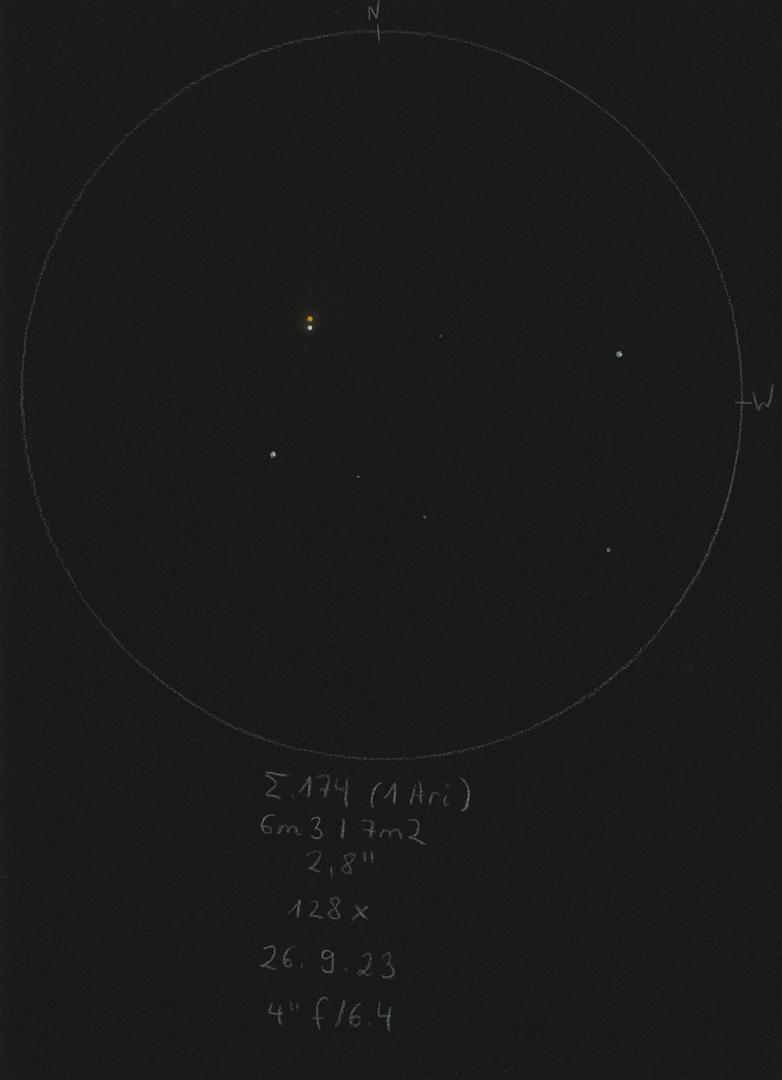
|
Stefan Loibl
Rosenheim (Germany) |
102mm (102x) |
slight color difference, A orange, B blueish |
|
Sarah Gebauer
Germany |
150mm (27x) |
im Dezember 2019 nicht getrennt |

|
Axel Tute
Küssaberg (Germany) |
200mm (77x) |
26.10.2005: STF 174 could be separated with the C8 already with the 26mm Plössl (77x). Better with the 12mm RKE (167x). |
|
Robert Zebahl
Leipzig (Germany) |
200mm (100x) |
Conditions in the target region: SQM-L 20.8
Nice double star with big difference in brightness. |
|
Mark McCarthy
Fremont (California/USA) |
203mm (533x) |
1 Ari. ! Very beautiful yellow-orange A and robin's egg blue B, 3", one delta mag. probably one of the best color pairs |
|
Mark McCarthy
Fremont (California/USA) |
317mm (553x) |
Pretty orange and blue pair, ~2 delta mag, ~2". |
|
Karsten Kopp
Köln (Germany) |
600mm (180x) |
Gut zu trennender Doppelstern mit schon auffälligem Helligkeitsunterschied. Der hellere leuchtet gelblich und der schwächere geht ins bläuliche. Schöner Doppelstern. |
|
|
|
★
|
STF179 |
|
|
7m.6 |
8m.1 |
3.5" |
160° |
2018 |
And |
01h53m10.72s / +37°19'16.30" |
Robert Zebahl
Leipzig (Germany) |
102mm (62x) |
2020-11-02: At 62x very nice sight! Finely separated pair of almost equally bright components. At 125x a small difference in brightness is visible. Pale orange & slightly bluish. |
|
Uwe Pilz
Leipzig (Germany) |
120mm (150x) |
|

|
Mark McCarthy
Fremont (California/USA) |
317mm (553x) |
Near equal magnitude, 4", nice orange-yellow color. |
|
René Merting
Drachhausen (Germany) |
320mm (144x) |
bei 144x zeigt sich ein knapp getrenntes Pärchen - A im Norden mit leichtem Gelbstich, B ist eine halbe Magnitude schwächer und strahlt blau-weiß |
|
|
|
★★
|
gamma Ari, STF180 |
|
AB |
4m.5 |
4m.6 |
7.4" |
1° |
2020 |
Ari |
01h53m31.76s / +19°17'38.60" |
Christopher Hay
Seeheim (Germany) |
15x60 |
In brief moments definitely split with a hair's breadth of black in-between. The rest of the time tantalisingly close to popping apart. Brightness difference distinct enough at all times to identify the southern star as the A component. Both components pure white.\A physical pair 164 light years distant from us. Also known in ancient times as the "First Star in Aries", as it was closest then to the vernal equinoctial point on the ecliptic |
|
Christopher Hay
Seeheim (Germany) |
42mm (12x) |
Clearly elongated, slightly notched in middle. |
|
Christopher Hay
Seeheim (Germany) |
76mm (83x) |
A strong matched pair. Both white. 1st diffraction rings just touching. |
|
Stefan Loibl
Rosenheim (Germany) |
102mm (41x) |
easily split at 41x, no color difference, nice view with 8m star HD11557 in the same FOV |
|
Axel Tute
Küssaberg (Germany) |
200mm (77x) |
13.10.2005; Single pair. Clearly separated in 26mm Plössl (77x). |
|
Robert Zebahl
Leipzig (Germany) |
200mm (80x) |
Nice, obvious double star. Both components have similar brightness and appeared white. |
|
Mark McCarthy
Fremont (California/USA) |
203mm (533x) |
Gamma Arietis = Mesarthim: Perfectly equal pair, wide, very white |
|
Mark McCarthy
Fremont (California/USA) |
317mm (277x) |
Gamma Ari. Equal yellow-white, wide, bright. |
|
Karsten Kopp
Köln (Germany) |
600mm (180x) |
Einfacher Doppelstern, mit fast identischer Helligkeit. |
|
|
|
★
|
COU453 |
|
|
10m.4 |
10m.8 |
0.7" |
282° |
2016 |
Ari |
01h56m19.96s / +25°20'24.00" |
Mark McCarthy
Fremont (California/USA) |
508mm (533x) |
I get clean split, the B star is very faint and just within A's diffraction ring, but it's there. Great! |
|
|
|
★
|
STF182 |
|
AB |
8m.3 |
8m.3 |
3.6" |
124° |
2016 |
Cas |
01h56m23.56s / +61°16'52.00" |
Robert Zebahl
Leipzig (Germany) |
70mm (57x) |
At 44x almost split. At 57x equally bright components visible. |
|
|
|
★
|
A1920 |
|
|
9m.5 |
10m.1 |
1.8" |
236° |
2018 |
Tri |
01h57m52.62s / +33°10'19.60" |
Mark McCarthy
Fremont (California/USA) |
203mm (205x) |
Nice clean split, very pretty white stars, seems a bit more than half delta mag |
|
Karsten Kopp
Köln (Germany) |
600mm (257x) |
Doppelstern war nur sehr knapp zu trennen. Der Helligkeitsunterschied liegt bei knapp 1,5 mag, eventuell auch leicht mehr. |
|
|
|
★★
|
H5 12, 9 Ari, lambda Ari |
|
AB |
4m.8 |
6m.7 |
37.3" |
48° |
2020 |
Ari |
01h57m55.71s / +23°35'45.80" |
Robert Zebahl
Leipzig (Germany) |
8x44 |
2020-11-25: Easily separable with noticeable difference in brightness. Primary component appeared slightly yellowish with dim companion. |
|
Robert Zebahl
Leipzig (Germany) |
70mm (15x) |
Easy to split with large distance and difference in brightness. |
|
Stefan Loibl
Rosenheim (Germany) |
102mm (41x) |
easily split, both components white, no color difference |
|
Uwe Pilz
Leipzig (Germany) |
105mm (200x) |
der helle Stern ist blauweiß |

|
Christopher Hay
Seeheim (Germany) |
180mm (113x) |
AB: A strong pair dominating the 0.6° field of view. B presents a weak ochre colour tone, in charming contrast to pearly-white component A.
According to Stelledoppie a physical pair at a distance to us of 129 light years. |
|
René Merting
Drachhausen (Germany) |
320mm (45x) |
bei 45x ein wunderschönes, sehr helles Farbkontrastpaar, A ist gelb-weiß, B im Nordosten ist gut 1.5 Magnituden schwächer und grau-weiß - Trennung mehr als komfortabel |
|
|
|
★★
|
STF201, eps Tri |
|
|
5m.5 |
11m.4 |
4.2" |
119° |
1990 |
Tri |
02h02m57.97s / +33°17'02.90" |
Mark McCarthy
Fremont (California/USA) |
203mm (205x) |
Epsilon Tri. Very nice! Bright A star is a white blaze, and outside of its glow is very small point of the B star, very fine. Very nice indeed |
|
Karsten Kopp
Köln (Germany) |
600mm (180x) |
Doppelstern ist an sich gut zu trennen, hier liegt der große Reiz in dem Helligkeitsunterschied von knapp 6 mag. Der helle Stern erstrahlt bläulich weiß. |
|
|
|
★
|
STF208, 10 Ari |
|
AB |
5m.8 |
7m.9 |
1.3" |
349° |
2018 |
Ari |
02h03m39.26s / +25°56'07.60" |
|
|
Uwe Pilz
Leipzig (Germany) |
105mm (200x) |
helle Stelle im ersten Ring |
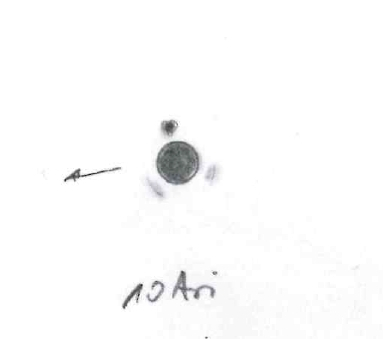
|
Mark McCarthy
Fremont (California/USA) |
317mm (553x) |
~2 delta mag, ~1" very nice. ~1 disk split. Nice! |
|
|
|
★★★
|
gamma And, 57 And, Alamak |
STF205 |
A-BC |
2m.3 |
5m.0 |
9.5" |
63° |
2021 |
And |
02h03m53.92s / +42°19'47.50" |
|
|
|
BAR22 |
AD |
2m.3 |
15m.0 |
27.9" |
245° |
1898 |
|
|
|
|
|
STT38 |
BC |
5m.3 |
6m.5 |
0.3" |
120° |
2021 |
|
|
|
|
Robert Zebahl
Leipzig (Germany) |
56mm (40x) |
A-BC: 2024-10-31: Nicely separated with a clear difference in brightness. Component A appeared in a bright yellow-orange. |
|
Robert Zebahl
Leipzig (Germany) |
63mm (42x) |
A-BC: Easy to split with quite large difference in brightness. |
|
Christopher Hay
Seeheim (Germany) |
71mm (32x) |
Fine split. A is mandarine orange. BC has trouble displaying its colour due to the overpowering light of A, but in good moments is clearly blue.
A-BC is a physical double at a distance to us of 393 light years.
BC is also physical, with a relatively short period of 63 years for C to circle B and a very tight periastron. Unobservable in 2013 at periastron with 0.1". Since then the angular separation has been widening rapidly and will reach 0.4" in 2029. B-C will then become observable in large amateur telescopes for three decades, after which C will fall quickly back to B. |
|
René Merting
Drachhausen (Germany) |
76mm (29x) |
A-BC: bei 29x äußerst knapp getrennt - Komponente A strahlt buttergelb, BC schmiegt sich im Nordosten an |
|
Uwe Pilz
Leipzig (Germany) |
105mm (52x) |
A-BC: einfach |
|
Uwe Pilz
Leipzig (Germany) |
120mm (128x) |
A-BC |

|
Robert Zebahl
Leipzig (Germany) |
152mm (100x) |
A-BC: Very easy. A: orange, BC: rather white. |
|
Christopher Hay
Seeheim (Germany) |
180mm (110x) |
A very strong pair in 0.6° FOV with powerful colour contrast, A yellow, BC ice blue. |
|
Sarah Gebauer
Germany |
254mm (96x) |
A-BC: in Dänemark als Startstern für die Suche nach der Galaxie NGC 891 gewählt und ohne Vorwissen spontan als sehr schönen Doppelstern erkannt: die Hauptkomponente strahlt richtig schön goldgelb, der Begleiter nordöstlich davon ist richtiggehend reinweiß und klein, wirklich toll! |
|
René Merting
Drachhausen (Germany) |
320mm (45x) |
A-BC: bei 45x ein knapp getrenntes Pärchen - Komponente A knallgelb mit einem Anhängsel nordöstlich - Komponente BC strahlt 3 Größenklassen schwächer - bei 144x wirkt BC grün-weiß, bei 45x war der Eindruck noch leicht gelblich |
|
Mark McCarthy
Fremont (California/USA) |
508mm (667x) |
BC: Component of STF 205, of which A is a brilliant orange and BC bright blue. In BC I can only see elongation through the speckle at 667x and 1067x. Short 62.63 year period which will get "easier" to about 0.2" by 2045 |
|
Mark McCarthy
Fremont (California/USA) |
508mm (1067x) |
BC: I spent a good long while on this one, and tried hard to nail down the position angle. At 1067x, both with and without an apodising mask, but both times with a #80A light blue filter, which did seem to calm the diffraction a little, I had a clear view of the elongation with a strong sense of the weaker end being to the East or to the ESE. I also tried a 78% central obstruction mask, and while the diffraction became a grid, and the disks much smaller, I could clearly see the same elongation and weaker end, though at a much smaller scale. To my delight the current orbital solution puts the PA at 120.6-degrees, 0.179" separation, so I think I have detected it. I can't wait until 2033 when this becomes an easy pair! |
|
|
Winfried Kräling
Marburg (Germany) |
127mm |
A-BC: Aufnahme vom 11.09.2020 am 127/1200mm Refraktor mit Barlowlinse (~2.5x)
Weit getrennt, Komponente A: goldgelb bis orange, Komponente BC: weißlich blau |

|
Werner E. Celnik
Rheinberg (Germany) |
150mm |
A-BC |
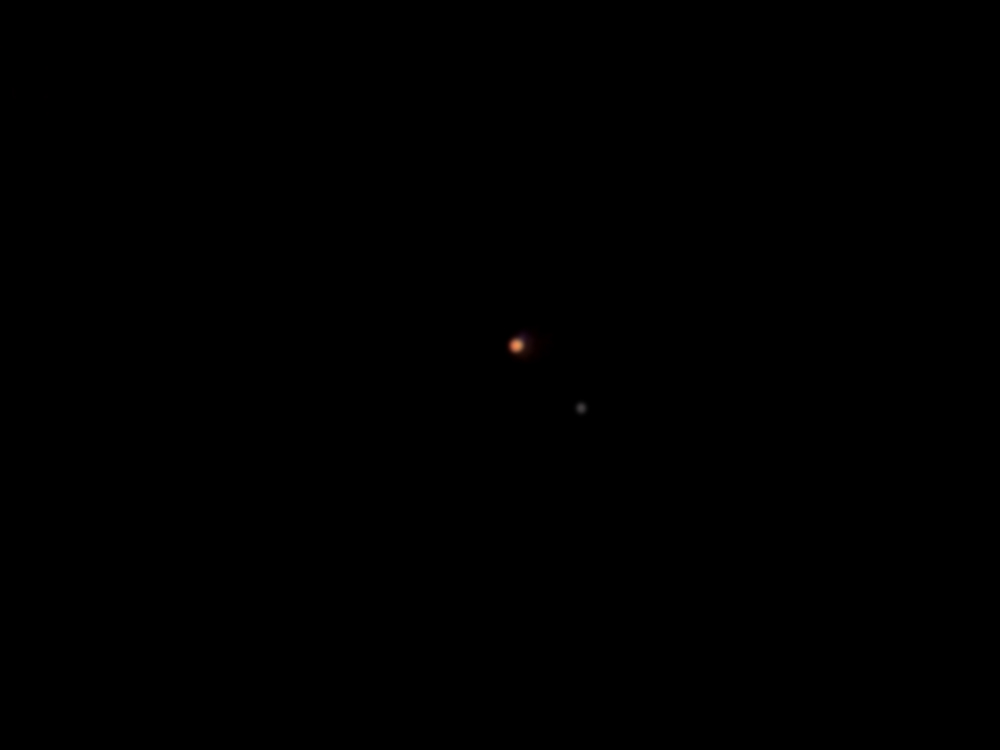
|
|
|
★
|
STI1797 |
|
|
7m.5 |
11m.8 |
8.6" |
142° |
2015 |
Per |
02h10m24.05s / +56°17'49.60" |
Mark McCarthy
Fremont (California/USA) |
317mm (553x) |
Pretty orange and blue stars, 2-3 delta mag, well separated 10" |
|
|
|
★★
|
59 And, STF222 |
|
|
6m.0 |
6m.7 |
16.6" |
36° |
2019 |
And |
02h10m52.83s / +39°02'22.40" |
Robert Zebahl
Leipzig (Germany) |
8x44 |
2020-11-25: Just separated with visible difference in brightness. |
|
René Merting
Drachhausen (Germany) |
16x70 |
ein sehr dichtes Sternpaar, ganz knapp getrennt sichtbar - Komponente B im NO ist eine halbe Größenklasse schwächer - leichter Farbunterschied und das Phänomen, dass der Farbkontrast zwischen beiden Sternen immer hin und her springt - ich kann nicht genau sagen, welcher Stern das kühlere oder wärmere Weiß hat |
|
Christopher Hay
Seeheim (Germany) |
71mm (32x) |
Widely separated. Primary slightly orange, secondary blueish. Very attractive and without visual competition in 2.5° FOV.
A physical double at a distance to us of 456 light years. |
|
René Merting
Drachhausen (Germany) |
100mm (32x) |
bei 32x ein auffälliges Sternpaar - gut getrennt mit leichtem Farbkontrast, Komponente A im SW ist weiß, die Komponente B zwar auch, aber mit einem Stich ins orange, eigenartig - Helligkeitsunterschied eine halbe Magnitude |
|
Robert Zebahl
Leipzig (Germany) |
120mm (18x) |
Well split with noticeable difference in brightness. |
|
Robert Zebahl
Leipzig (Germany) |
200mm (100x) |
Conditions in the target region: SQM-L 20.4
Nice and evident double star, easy to split. About 12 arcminutes NE there is NGC828 (v12.3m), |
|
René Merting
Drachhausen (Germany) |
320mm (45x) |
bei 45x ein schönes, helles Sternpaar, sehr auffällig im Umfeld, ordentlich getrennt - Helligkeitsunterschied eine viertel bis eine halbe Größenklasse - leichter, aber schwer greifbarer Farbkontrast |
|
|
|
★★★
|
STF227, iota Tri, 6 Tri |
|
|
5m.3 |
6m.7 |
4.0" |
68° |
2019 |
Tri |
02h12m22.28s / +30°18'11.10" |
|
|
Robert Zebahl
Leipzig (Germany) |
70mm (57x) |
At 44x even separable with a clear difference in brightness, whereby the companion is almost outshone by the primary component. At 57x easy to separate. Primary component shines in bright orange, companion slightly orange. Beautiful sight together with STF232 in one field of view! |
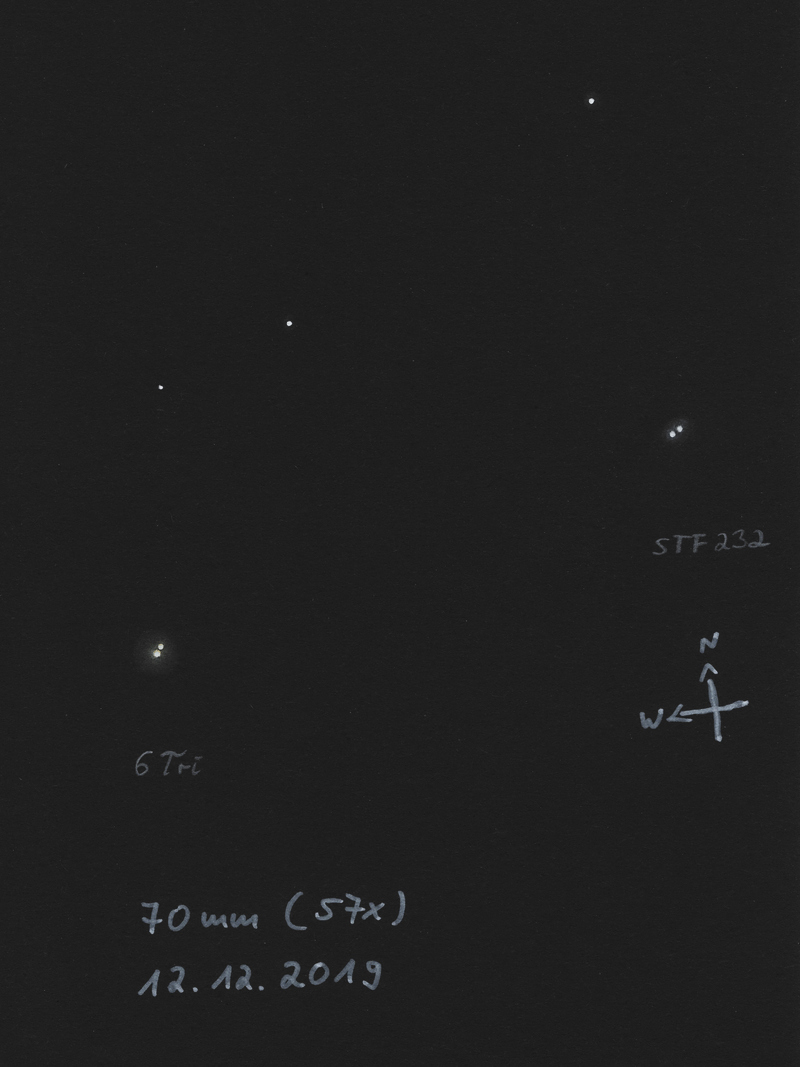
|
Sarah Gebauer
Germany |
100mm (80x) |
25.09.23: mit 49-fach ist dieser noch nicht getrennte Farbdoppelstern eindeutig die Kommandozentrale des imperialen TIE-Jägers - bei 80-fach zeigt die A-Komponente einen sehr dunklen, gelbgoldenen Farbton und die sehr dicht stehende B-Komponente einen weißgoldenen Farbton |
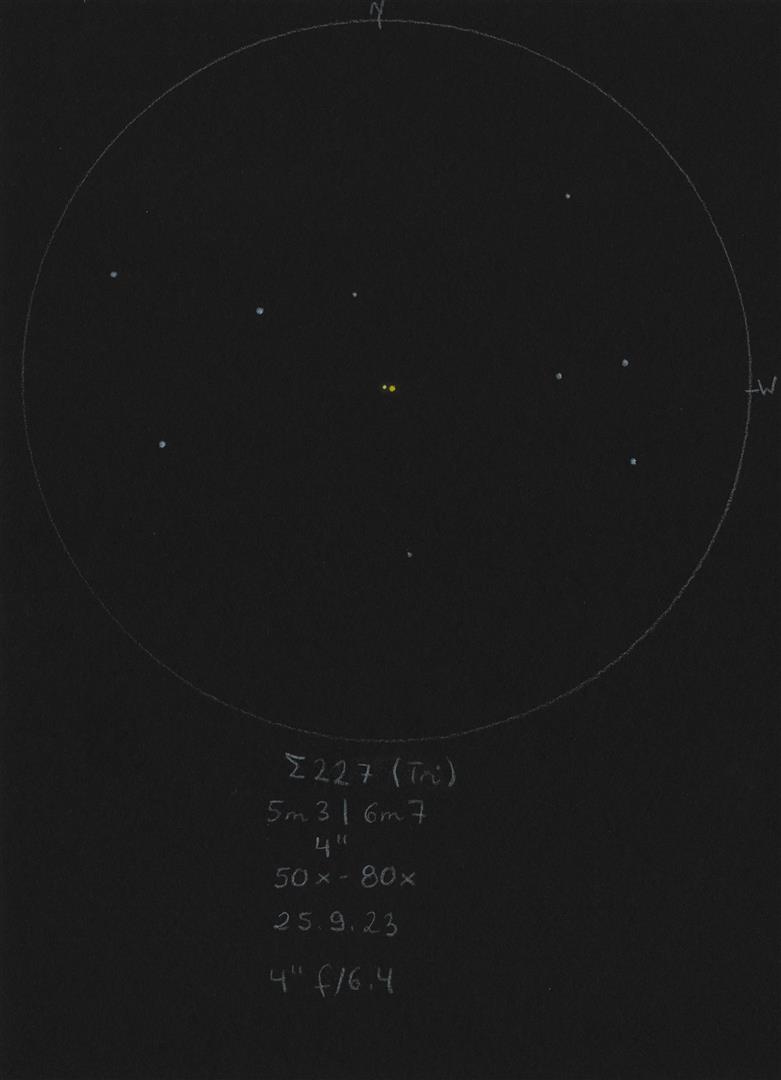
|
Uwe Pilz
Leipzig (Germany) |
105mm (88x) |
weiß und blau |

|
Christopher Hay
Seeheim (Germany) |
180mm (110x) |
Well separated. Primary yellowish, secondary light blue. When 6 Tri drifts out of 0.6° FOV, STF232 drifts in.
6 Tri is a physical double at a distance to us of 291 light years. |
|
Mark McCarthy
Fremont (California/USA) |
203mm (205x) |
6 Tri. Yellow A, white b, pretty. Wide, about two delta mag |
|
Frederik Wanink
Itterbeck (Germany) |
254mm (200x) |
Helligkeitsunterschied deutlich |
|
René Merting
Drachhausen (Germany) |
320mm (103x) |
bei 103x zeigt A sich hellgelb, B ist getrennt, steht sehr dicht und ist auch noch sehr hell - Helligkeitsunterschied 1.5 Größenklassen, B ist grauweiß |
|
Karsten Kopp
Köln (Germany) |
600mm (180x) |
Doppelstern ist noch gut zu trennen und der Helligkeitsunterschied ist mit gut 1,5 mag schon sehr auffällig. Der hellere Stern erstrahlt schön gelblich, der schwächer weiß. In den Momenten der wirklich ruhigen Luft, ein sehr schöner Doppelstern |
|
|
|
★★★
|
STF231, 66 Cet |
|
AB |
5m.7 |
7m.7 |
16.8" |
235° |
2019 |
Cet |
02h12m47.54s / -02°23'37.10" |
|
|
|
|
AC |
5m.7 |
11m.5 |
147.0" |
53° |
1998 |
|
|
Christopher Hay
Seeheim (Germany) |
30x80 |
AB: Wide split. A is cream-white, B of indeterminate colour. Attractive pair in 1.7° FOV, scenery accentuated by 63 Psc about 3/4° to northwest.
While pleasant with 30x80, the pair becomes suprisingly difficult to split with 20x80, presumably due to the cumulative effect of 2m delta-mag and the red colour of the companion, which makes it stand out less than if it were blue (colour not seen, but stressed by Uwe Pilz in his 105mm observation, see below). |
|
René Merting
Drachhausen (Germany) |
76mm (29x) |
AB: bei 29x zeigt sich B südwestlich von A relativ schwach, gut 1.5 Magnituden schwächer - Komponente A wirkt weiß-gelblich, B dagegen nur grau-weiß, aber dennoch ein schöner Farbkontrast zwischen den beiden |
|
Uwe Pilz
Leipzig (Germany) |
105mm (88x) |
AB: weiß und leuchtend rot! |

|
Sarah Gebauer
Germany |
254mm (96x) |
AB: bei 96-fach ist der DS schön weit getrennt, ein unterschiedlich helles Paar – die Hauptkomponente strahlt warmweiß mit einem allerkleinsten Ansatz eines Hauches von Gelblich – der DS erhält zudem Konkurrenz durch einen benachbarten, nördlichen Stern, der sehr schön roségoldfarben strahlt und sogar einen „Begleitstern“ hat |
|
|
|
★
|
S405 |
|
AB |
6m.5 |
7m.2 |
55.7" |
277° |
2019 |
Cep |
02h12m49.98s / +79°41'29.30" |
|
|
|
|
BC |
7m.2 |
13m.9 |
51.2" |
224° |
2015 |
|
|
Christopher Hay
Seeheim (Germany) |
10x42 |
AB: B well set off from A.
South 405 (aka STTA 22 and H5 84) is a physical double at a distance to us of 121 light years. |
|
Christopher Hay
Seeheim (Germany) |
15x60 |
AB: Wide pair. A seems a little yellowish. |
|
Christopher Hay
Seeheim (Germany) |
71mm (32x) |
AB: Wide apart. A distinctly brighter and distinctly more yellowish than B. |
|
René Merting
Drachhausen (Germany) |
100mm (20x) |
AB: bei 20x weit auseinander stehendes helles Pärchen - beide Sterne sind etwa gleich hell (laut Stelle Doppie 0.68 mag Helligkeitsunterschied) |
|
|
|
★★★
|
STF232 |
|
|
7m.8 |
7m.9 |
6.7" |
69° |
2019 |
Tri |
02h14m42.16s / +30°23'41.20" |
Robert Zebahl
Leipzig (Germany) |
70mm (22x) |
Very beautiful view! With all used magnifications together with iota Tri (6 Tri) in one field of view. Separable at 22x, but the components are still quite close together and appear similarly bright. At 44x easy to separate with little difference in brightness. At 57x a very small color difference is visible without being able to clearly name the colors. STF232 was sketched together with 6 Tri. |

|
Christopher Hay
Seeheim (Germany) |
180mm (110x) |
Wide separation. Very even brightness. Northeast secondary appears slightly bluish compared to primary. |
|
Mark McCarthy
Fremont (California/USA) |
203mm (205x) |
Pretty white stars, only a slight delta mag, well split |
|
René Merting
Drachhausen (Germany) |
320mm (45x) |
bei 45x knapp getrennt, zwei gleich helle Sterne - bei 103x zeigt der Doppelstern einen schönen, zarten Farbkontrast - der östliche Stern wirkt blauweiß, der westliche warmweiß |
|
Karsten Kopp
Köln (Germany) |
600mm (180x) |
Doppelstern einfach zu trennen und beide Sterne haben die gleiche Hellgkeit. Da beide weißlich strahlen, habe ich den Eindruck, als würden zwei Scheinwerfer aus dem All in unsere Richtung leuchten. |
|
|
|
★
|
STF234 |
|
AB |
8m.7 |
9m.4 |
0.6" |
222° |
2012 |
Cas |
02h17m23.00s / +61°21'06.50" |
|
|
Mark McCarthy
Fremont (California/USA) |
317mm (885x) |
Light orange star, definitely elongated, maybe notched, but no convincing split. Tough little Struve. |
|
|
|
★★
|
iota Cas, STF262 & CHR6 |
CHR6 |
Aa-Ab |
4m.6 |
8m.5 |
0.6" |
42° |
2010 |
Cas |
02h29m03.96s / +67°24'08.70" |
|
|
|
STF262 |
AB |
4m.6 |
6m.9 |
2.9" |
230° |
2017 |
|
|
|
|
|
STF262 |
AC |
4m.6 |
9m.1 |
6.7" |
117° |
2015 |
|
|
|
|
|
STF262 |
AD |
4m.6 |
8m.5 |
210.9" |
60° |
2016 |
|
|
|
|
Robert Zebahl
Leipzig (Germany) |
55mm (27x) |
Only the D component was well visible. The components B & C were not visible even at magnifications up to 167x. The sky was clearly brightened (Bortle 7). |
|
Robert Zebahl
Leipzig (Germany) |
70mm (120x) |
Components A, B and C pretty close together, D far apart. Component B appeared slightly elongated on the first diffraction ring of the primary component. Rewarding! |
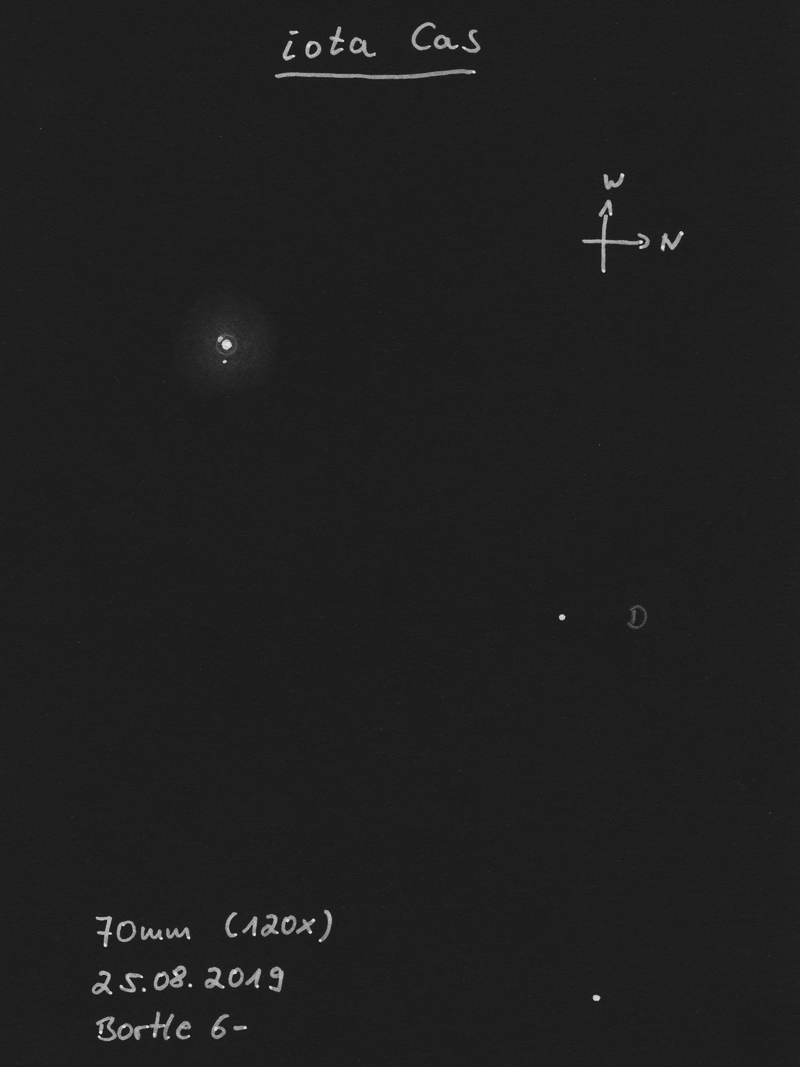
|
René Merting
Drachhausen (Germany) |
76mm (127x) |
AB: bei 95x zeigt sich Komponente B im SW im Beugungsring von A - bei 127x wird die Trennung dann eindeutiger, ein schönes Bild, B steht mitten im Beugungsring, der nur einen Bogen von 180° beschreibt, so sieht B aus wie ein Komet, der um A kreist
AC: bei 57x knapp getrennt, C zeigt sich östlich von A und ist ganz schwach
AD: leider nicht darauf geachtet |
|
Sarah Gebauer
Germany |
100mm (80x) |
bei 49-fach schon warmgelb als ein Stern zu sehen, bei 80-fach taucht dann östlich eine super schwache, sehr dicht stehende Komponente auf - südlich schmiegt sich noch eine sichelförmige Ausbuchtung an, die bei 136-fach zu einem haarfein getrennten Sternchen wird |

|
René Merting
Drachhausen (Germany) |
100mm (142x) |
AB: bei 142x zeigt sich Komponente B im SW mit gut einem Drittel das Abstandes AC, Helligkeitsunterschied 1.5 bis 2 Größenklassen
AC: bei 64x getrennt, schöner Farbkontrast, Komponente A ist weiß mit einem Stich ins Gelbe, C leicht bräunlich
AD: bei 32x extrem weiter Abstand zwischen A und D, Helligkeitsunterschied mehr als 2 Größenklassen (laut Stelle Doppie sogar 3.85 mag) |
|
Uwe Pilz
Leipzig (Germany) |
105mm (200x) |
Dreifachstern lohnend |

|
Sarah Gebauer
Germany |
150mm (160x) |
bei 160x sind die Komponenten AC getrennt, B leider nicht, die schwache Komponente C versinkt fast im Strahlen der hellen Komponente A, ein sehr reizvoller Anblick! Von Komponente D wusste ich während der Beobachtung noch nichts, sie taucht unter den Feldsternen der Zeichnung auch auf |
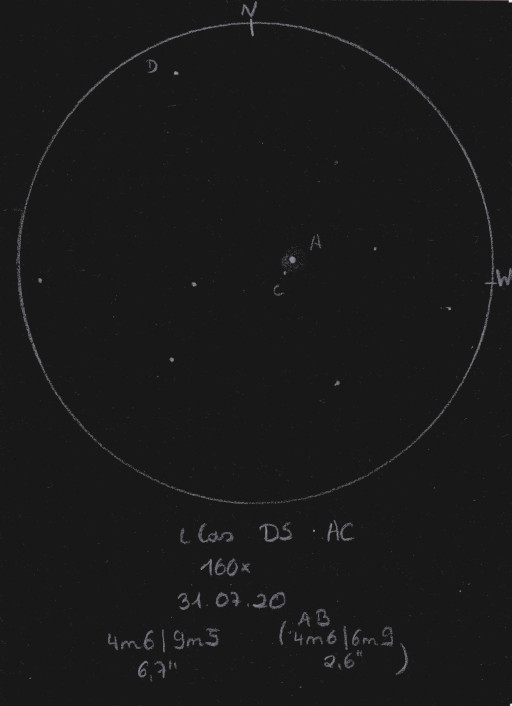
|
Robert Zebahl
Leipzig (Germany) |
152mm (129x) |
Component D easy to see even at lowest magnification. Component C is also easily visible at 49x. At 69x the component B is indicated, at 100x clearly visible. C appears slightly grey-bluish and obviously fainter than B. Grand sight at 129x! |
|
Mark McCarthy
Fremont (California/USA) |
508mm (1067x) |
CHR6 (Aa-Ab): This is a component of Iota Cas, STF 262 (which is a really pretty triple). CHR 6 at 1067x and seeing through the speckle image, I get elongation with a suspected blunter end which I assume is the B side, PA to the north [it's actually to the south -- my general orientation is correct but mis-interpret the brighter end]. Physical with 47 year period, currently at periastron and will tighten to 0.2" by 2036 |
|
|
|
★★★
|
STF93, alpha UMi, 1 UMi, Polaris |
|
AB |
2m.0 |
9m.1 |
18.4" |
236° |
2016 |
UMi |
02h31m49.09s / +89°15'50.70" |
|
|
|
|
AC |
2m.0 |
13m.8 |
39.0" |
103° |
2016 |
|
|
|
|
|
|
AD |
2m.0 |
14m.3 |
83.2" |
194° |
2016 |
|
|
Christopher Hay
Seeheim (Germany) |
71mm (32x) |
B well separated, a fine blue pinprick next to luminous yellow A.
Alpha UMi, Polaris, is a physical double at a distance to us of 433 light years. |
|
René Merting
Drachhausen (Germany) |
76mm (29x) |
AB: Mondscheinnacht - bei 29x zeigt sich ein schönes Sternpaar, knapp getrennt - B ist sehr schwach, aber noch gut zu erkennen - Helligkeitsunterschied enorm - das Paar ist dennoch sehr ansehnlich, zumal A in einem schönem Gelb strahlt |
|
Christopher Hay
Seeheim (Germany) |
76mm (40x) |
B well set off from A. Glare from A is an issue, consciously trying to ignore A helps. Very slight yellowish tone of A. Seeing the difficulty makes it clear why attempts in other nights to split the pair with 25x80 binoculars failed. |
|
René Merting
Drachhausen (Germany) |
100mm (32x) |
AB: bei 32x knallt die Hauptkomponente A schön hellgelb rein, Komponente B ist als feiner zarter Lichtpunkt knapp daneben erkennbar - Größenklassenunterschied nicht abschätzbar, auf jeden Fall riesig |
|
Sarah Gebauer
Germany |
100mm (49x) |
AB: bei 49-fach sauber getrennt, A ist sehr hell, warmweiß und erzeugt einen feinen Spike im Amiciprisma, B steht ausreichend weit entfernt, durch die Helligkeit von A aber doch wieder nicht ganz so weit abgesetzt und scheint mausgrau - bei 80-fach gewinnt A einen wesentlich gelblicheren Farbton und wirkt nun mittig weiß und ansonsten goldorange |
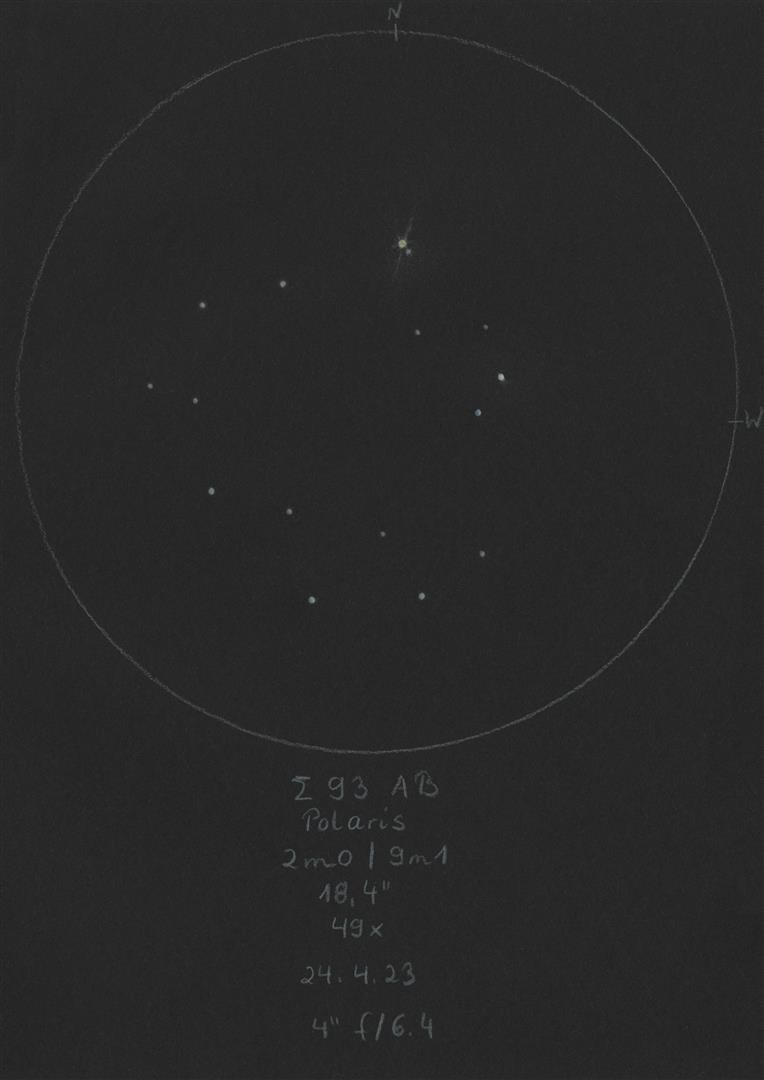
|
Christopher Hay
Seeheim (Germany) |
180mm (113x) |
B widely separated from A. A has definite yellowish hue. B luminous aquamarine blue, very attractive. |
|
René Merting
Drachhausen (Germany) |
320mm (45x) |
AB: bei 45x ist B sehr knapp getrennt von A erkennbar - Komponente A strahlt auf den ersten Blick weiß, bei genauerem Hinsehen mischt sich ein zartes Gelb unter |
|
|
|
★★★
|
AG304, 15 Tri |
|
|
5m.6 |
6m.8 |
142.4" |
16° |
2013 |
Tri |
02h35m46.82s / +34°41'15.20" |
Christopher Hay
Seeheim (Germany) |
7x50 |
Well split. Main star yellow-orange, secondary an ice-blue pinprick. With overall brightness of 5m1 just visible to naked eye under my suburban sky. Interesting star field with a line of 5 stars pointing S-SW away from 15 Tri and a further striking star chain to the west. Placing Gamma-Delta-7 Tri within 7.5° FOV makes a very attractive overall field. Mira variable R Tri just ½ degree to the S-SE was around maximum at time of observation and presented a much paler orange than 15 Tri A. Charming colour contrast ensemble with the two components of the double plus the variable. |
|
René Merting
Drachhausen (Germany) |
18x70 |
ein extrem komfortabel getrenntes Sternpaar - Komponente A im Süden strahlt weißgelb, B ist 1.5 Größenklassen schwächer und wirkt kupfergrau - interessant: parallel zu den beiden Sternen stehen westlich zwei deutlich schwächere Sterne in gleichem Abstand und Positionswinkel wie die Komponenten von 15 Tri - alle 4 Sterne bilden ein Parallelogramm |
|
Christopher Hay
Seeheim (Germany) |
80mm (30x) |
A beautiful, wide pair. Main star orangish yellow, secondary ice-blue. Attractive star field in 2.7° FOV: several similarly-separated pairs to the north and east, and two striking star chains to the south and west. |
|
Sarah Gebauer
Germany |
100mm (21x) |
ein wirklich schönes, farbiges Pärchen, das schon bei geringster Vergrößerung deutlich getrennt und in einem Eisblau und leichtem Orange strahlt, zudem bildet es mit der markanten Sternkette östlich davon, die im Refraktor mit Amiciprisma ein auf dem Kopf stehendes T bildet, ein tolles Gesamtbild |
|
Sarah Gebauer
Germany |
100mm (21x) |
25.09.23: mit 21-fach erinnert dieser Doppelstern fast an das Farbkontrastdoppel Delta Cephei, er ist weit getrennt und zeigt eine ganz klassisch warm gelbgoldene A-Komponente und in sehr weitem Abstand eine metallisch azurblau leuchtende B-Komponente |
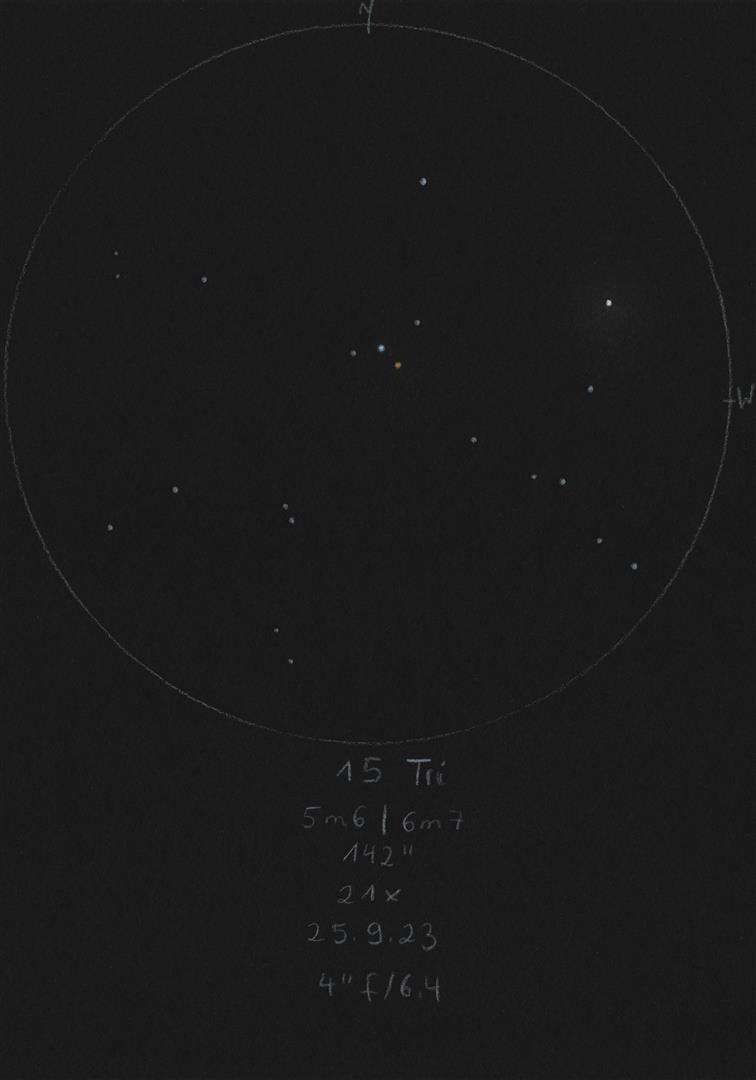
|
René Merting
Drachhausen (Germany) |
320mm (45x) |
bei 45x weit auseinanderstehend, aber dennoch schön anzusehen - A ist rapsgelb, B im Norden wirkt unterkühlt weiß bis graublau |
|
|
|
★★
|
30 Ari |
STFA5 |
AB |
6m.5 |
7m.0 |
37.9" |
275° |
2019 |
Ari |
02h37m00.52s / +24°38'50.00" |
|
|
|
RAO8 |
BC |
7m.0 |
11m.0 |
0.6" |
282° |
2018 |
|
|
Robert Zebahl
Leipzig (Germany) |
8x44 |
AB: 2020-11-25: Easy to split at still quite small separation and visible difference in brightness. The primary component appeared white-yellowish, the companion darker. |
|
Robert Zebahl
Leipzig (Germany) |
12x42 |
AB: 2022-10-19: Easy to split at moderate separation and small difference in brightness. Well visible color difference, although it is difficult to assign the color to the components: white-bluish & yellow-orange. |
|
Robert Zebahl
Leipzig (Germany) |
70mm (22x) |
AB: At 22x widely separated, striking with a rather small difference in brightness. A seemed a bit warmer in color compared to B with a hint of orange. At 44x, both seemed slightly orange with very little difference in color. |
|
Sarah Gebauer
Germany |
100mm (21x) |
AB: 25.09.23: mit 21-fach und 49-fach ein allenfalls warmweißes, weit getrenntes Paar in einem mageren Sternumfeld - nach konzentrierter Beobachtung zeigt sich ein ganz zarter Goldhauch über den weißen Sternen |
|
Uwe Pilz
Leipzig (Germany) |
105mm (88x) |
AB: trennbar bei 22x. Weiß und blau |
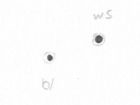
|
Mark McCarthy
Fremont (California/USA) |
317mm (277x) |
AB: Near equal light orange, very wide. B has a C pair 0.6" and 4 delta mag. |
|
Mark McCarthy
Fremont (California/USA) |
317mm (553x) |
AB: Near equal magnitude, wide separated, PA to WSW |
|
René Merting
Drachhausen (Germany) |
320mm (45x) |
AB: bei 45x ein wunderschöner Doppelstern mit leichtem Farbkontrast - A im Osten ist minimal heller und strahlt Buttergelb, B ist unterkühlt Weiß bis Türkisweiß - beide Sterne funkeln wie Diamanten |
|
|
|
★
|
A1279 |
|
|
10m.1 |
10m.1 |
2.1" |
306° |
2016 |
Per |
02h40m25.95s / +55°18'33.40" |
Mark McCarthy
Fremont (California/USA) |
317mm (553x) |
Can just see the faint star in the 80mm finder. In the scope it is a hazy elongated smear which resolves to two equal points with seeing, 2", Very nice! |
|
|
|
★
|
STF291 |
|
AB |
7m.7 |
7m.5 |
3.4" |
117° |
2020 |
Ari |
02h41m06.59s / +18°48'00.70" |
|
|
|
|
AC |
7m.7 |
9m.5 |
65.5" |
242° |
2015 |
|
|
Robert Zebahl
Leipzig (Germany) |
70mm (57x) |
AB: At 44x almost, at 57x clearly split, but still very tight with rather small difference in brightness. |
|
René Merting
Drachhausen (Germany) |
76mm (95x) |
AB: bei 57x zeigt B sich südöstlich von A und klebt noch an diesem, die Trennung gelingt dann äußerst knapp bei 95x
AC: bei 29x zeigt sich C ganz schwach weit abgesetzt südwestlich von A - Helligkeitsunterschied mehr als zwei Größenklassen |
|
Uwe Pilz
Leipzig (Germany) |
105mm (88x) |
hellster Stern gelb, andere Farben nicht erkennbar |

|
Mark McCarthy
Fremont (California/USA) |
203mm (205x) |
AB: White stars, near equal, close but well split, makes a 2+1 with a ~2 delta mag, very wide C |
|
|
|
★★
|
STT44 |
|
AB |
8m.5 |
9m.0 |
1.4" |
56° |
2018 |
Per |
02h42m13.13s / +42°41'57.20" |
|
|
|
|
AC |
8m.5 |
8m.3 |
87.2" |
290° |
2017 |
|
|
Uwe Pilz
Leipzig (Germany) |
105mm (288x) |
AB ist schwierig. Selbst bei 144x war fast der gesamte Sternhaufen M34 zu überblicken |
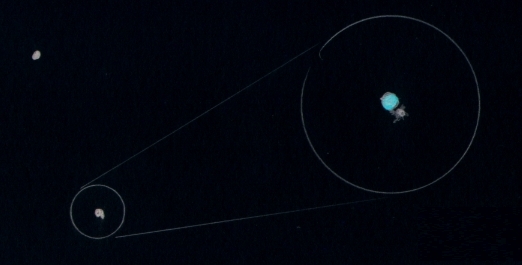
|
Robert Zebahl
Leipzig (Germany) |
152mm (129x) |
AB: At 129x barely separable, at 150x separated quite clearly with a noticeable difference in brightness. The double star is located within Messier 34! |
|
Mark McCarthy
Fremont (California/USA) |
317mm (553x) |
AB: In M34 open cluster! Close near equal pair, 1.5", very nice! The cluster is pretty, loose, and jangly with stars of varying magnitudes. What a treat. |
|
|
|
★
|
BU306 |
|
AB |
6m.4 |
10m.4 |
2.9" |
19° |
2016 |
Ari |
02h43m51.25s / +25°38'18.00" |
Mark McCarthy
Fremont (California/USA) |
317mm (277x) |
Very nice white and 3 delta mag bluish B, nicely seen 4". |
|
|
|
★
|
STF301 |
|
|
7m.8 |
8m.7 |
8.2" |
17° |
2016 |
Per |
02h47m38.75s / +53°56'35.80" |
René Merting
Drachhausen (Germany) |
12x42 |
der Stern wirkt auf den ersten Blick unförmig - in guten Momenten erkennt man eine Ameise mit mal mehr und mal weniger großer Einschnürung - Komponente B im Norden wirkt eine halbe Größenklasse schwächer |
|
Robert Zebahl
Leipzig (Germany) |
70mm (22x) |
Rather faint double star with a handful of other stars in the immediate vicinity. At 22x clearly separated, but still close together with visible difference in brightness. At 31x the primary component looked slightly orange. |
|
René Merting
Drachhausen (Germany) |
76mm (29x) |
bei 29x zeigen sich sehr knapp getrennt eine große und eine kleine Murmel - Helligkeitsunterschied 0.5 mag - beide Sterne wirken nicht ganz weiß, eher haben sie einen kleinen Stich ins gelbgoldene |
|
René Merting
Drachhausen (Germany) |
100mm (32x) |
bei 32x ganz knapp getrenntes Pärchen - Komponente B im Norden ist eine halbe Größenklasse schwächer - nett anzusehen |
|
Sarah Gebauer
Germany |
100mm (45x) |
bei 45x ganz knapp schon getrennt und täuscht einen Farbunterschied vor: die südwestliche Komponente wirkt leicht orange, die nordöstliche etwas bläulich |
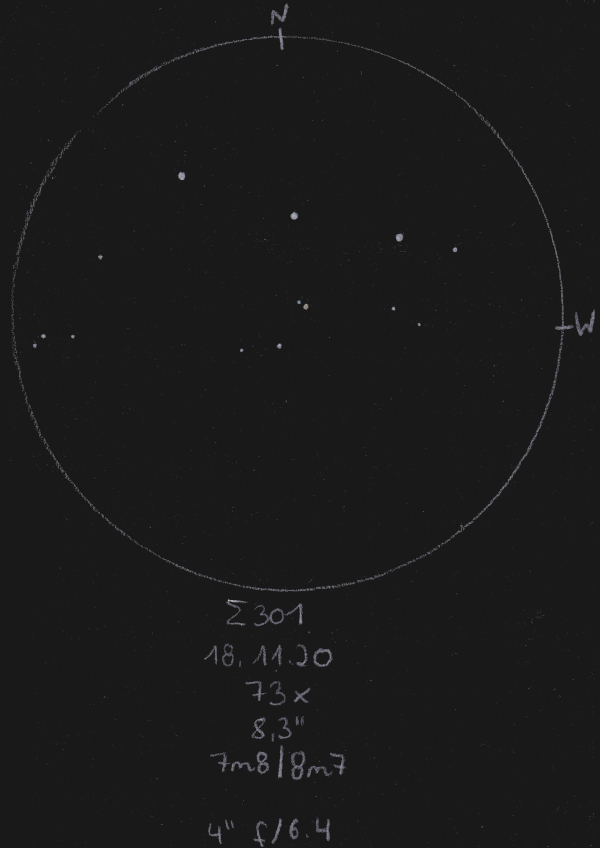
|
Sarah Gebauer
Germany |
100mm (49x) |
01.10.23: bei 49-fach ein extrem filigranes, dünnes Farbkontrastpaar, das als nördlicher Stern in einem geknickten T-Strich zu finden ist - die südwestliche A-Komponente strahlt ganz zart pfirsichfarben, die nordöstliche ganz zart bläulich |
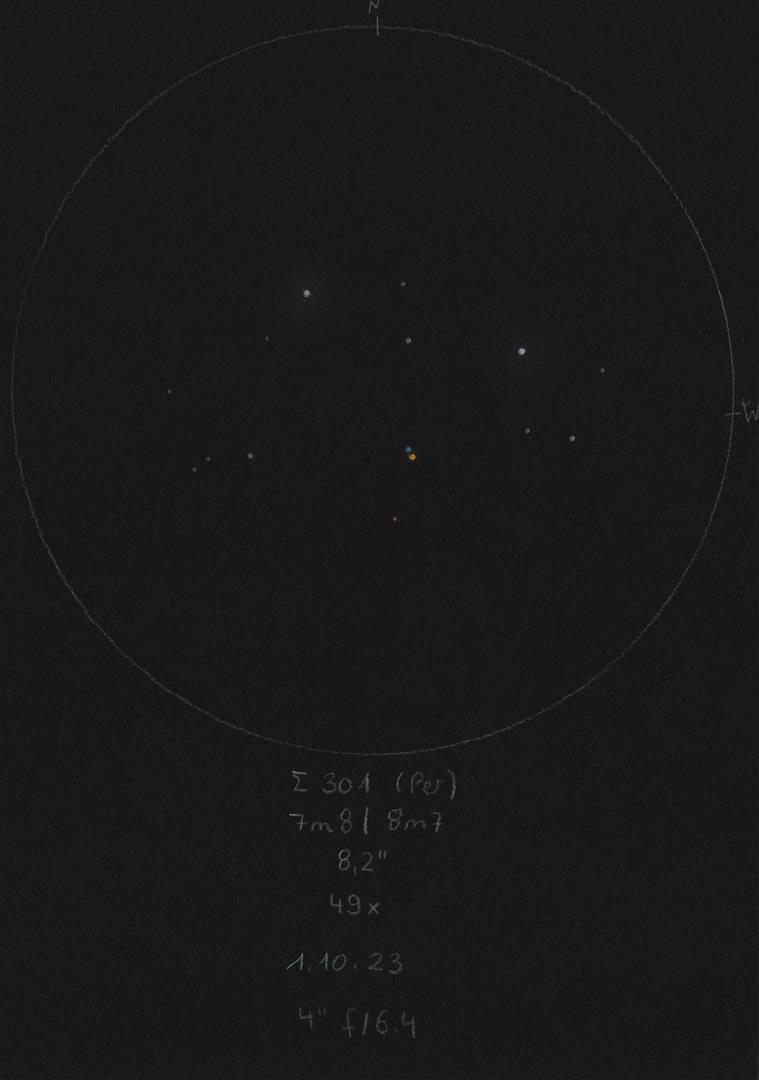
|
|
|
★
|
eta Per, 15 Per, Miram |
STF307 |
AB |
3m.8 |
8m.5 |
28.7" |
301° |
2018 |
Per |
02h50m41.81s / +55°53'43.80" |
|
|
|
STF307 |
AC |
3m.8 |
11m.6 |
64.0" |
269° |
2014 |
|
|
|
|
|
SHJ34 |
AE |
3m.8 |
9m.2 |
242.9" |
297° |
2012 |
|
|
|
|
|
WAL19 |
AF |
3m.8 |
11m.4 |
57.7" |
25° |
2013 |
|
|
|
|
|
WRD1 |
CD |
11m.6 |
12m.7 |
5.2" |
116° |
2015 |
|
|
|
|
|
FYM161 |
CG |
11m.6 |
14m.0 |
15.8" |
229° |
2015 |
|
|
René Merting
Drachhausen (Germany) |
16x70 |
STF307 (AB): Miram, die Komponente A ist satt gelb und bildet ein flaches Dreieck mit zwei Sternen westlich und nordwestlich, die 1,8' und 3,9' entfernt stehen - dazwischen wird alles vom Glanz von Miram überstrahlt - im Fernglas hat B mit den eigentlich ordentlichen Daten wie Abstand 30,4" und Helligkeit 8.5 mag (andere Quellen sagen 10.7 mag) trotzdem keine Chance auf Erleuchtung |
|
René Merting
Drachhausen (Germany) |
76mm (29x) |
STF307 (AB): bei 29x zeigt Miram sich in einem wunderschönen Bernsteingelb - die B-Komponente steht leicht abgesetzt westlich von A und ist deutlich schwächer, wie ein zartes Anhängsel |
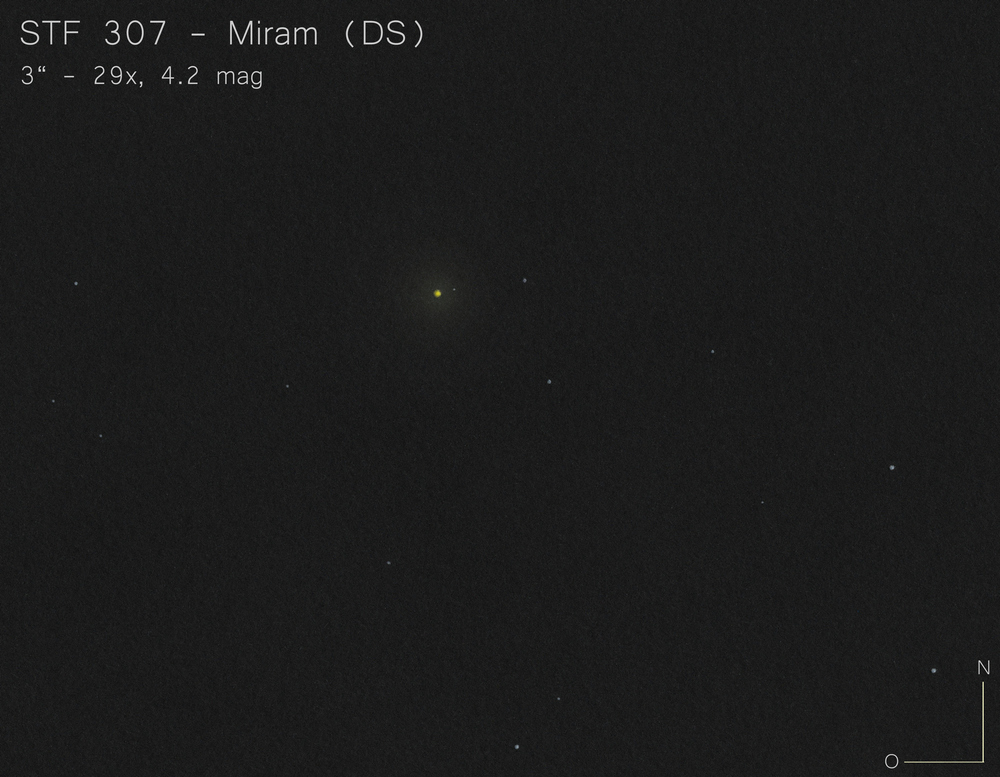
|
René Merting
Drachhausen (Germany) |
100mm (32x) |
STF307 (AB): bei 32x sehr ansehnlich - Komponente B steht gut getrennt nordwestlich vom signal-gelben Eta Persei - Helligkeitsunterschied sehr groß, nicht abschätzbar |
|
Uwe Pilz
Leipzig (Germany) |
105mm (88x) |
Dreifachsystem, nahe Komponente: PW und Abstand stimmt, is aber viel zu dunkel (10m statt 8m5). Ein Mysterium |
|
Sarah Gebauer
Germany |
254mm (96x) |
STF307 (AB): eine große, goldgelbe Komponente und nordwestlich davon ein kleiner, sehr blauer Begleiter |
|
Mark McCarthy
Fremont (California/USA) |
317mm (553x) |
STF307 (AB): Orange with faint, bluish, widely separated B. |
|
|
|
★
|
A2906 & STF314 |
A2906 |
AB |
7m.3 |
8m.8 |
0.3" |
115° |
2018 |
Per |
02h52m52.03s / +52°59'50.60" |
|
|
|
STF314 |
AB-C |
7m.0 |
7m.3 |
1.6" |
316° |
2018 |
|
|
|
|
Robert Zebahl
Leipzig (Germany) |
152mm (129x) |
STF314 (AB-C): Beautifully separated, quite close together. Difference in brightness visible, but rather small. Easy to find and bright. Very nice. |
|
Frederik Wanink
Itterbeck (Germany) |
254mm (460x) |
STF314 (AB-C): ähnlich hell |
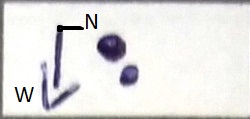
|
Mark McCarthy
Fremont (California/USA) |
317mm (553x) |
A2906 (AB): This is the brighter of the STF 314 pair. I have a feeling it is slightly elongated but nothing certain. |
|
Mark McCarthy
Fremont (California/USA) |
317mm (553x) |
STF314 (AB-C): near equal brightness, AB more yellow yellow-white of the two, ~2 disk separation |
|
|
|
★
|
STF333, eps Ari |
|
AB |
5m.2 |
5m.6 |
1.4" |
210° |
2020 |
Ari |
02h59m12.73s / +21°20'25.60" |
|
|
Uwe Pilz
Leipzig (Germany) |
120mm (250x) |
|

|
Mark McCarthy
Fremont (California/USA) |
203mm (205x) |
Eps Ari: Beautiful split of white stars, less than 1 delta mag, a little more than 1". Very nice pair. Physical with a 1215 year period |
|
|
|
★
|
STF346, 52 Ari |
|
AB |
6m.2 |
6m.2 |
0.5" |
256° |
2016 |
Ari |
03h05m26.69s / +25°15'18.70" |
|
|
|
|
AB-C |
5m.5 |
10m.8 |
5.1" |
358° |
2005 |
|
|
|
|
|
|
AB-D |
5m.5 |
13m.3 |
102.1" |
83° |
2013 |
|
|
|
|
|
|
AB-E |
5m.5 |
12m.8 |
133.5" |
192° |
2014 |
|
|
|
|
Mark McCarthy
Fremont (California/USA) |
203mm (333x) |
AB: What a great set! The closest are a near equal pair of white stars, elongated with a slight notch, There's a faint C ~5" and slight more than a right angle in PA. Interesting set. Physical with 227 year period |
|
Mark McCarthy
Fremont (California/USA) |
317mm (553x) |
AB-C: Bright yellow-white AB, orange C. ~4-5 delta mag, 5-6" PA to N. Did not notice AB 0.5" |
|
|
|
★★
|
STT51 |
|
|
8m.5 |
8m.7 |
0.6" |
353° |
2019 |
Per |
03h12m57.08s / +44°17'14.70" |
|
|
Mark McCarthy
Fremont (California/USA) |
317mm (553x) |
Very fine clean split at the finest moments, which is once every 10 seconds. 0.5", equal mag. |
|
|
|
★
|
STF379 |
|
|
8m.6 |
8m.8 |
10.5" |
101° |
2016 |
Ari |
03h22m51.83s / +29°49'06.30" |
Christopher Hay
Seeheim (Germany) |
180mm (113x) |
Well separated but very strongly appearing to belong together. This impression is fostered by the almost identical brightnesses and the complete lack of visual competition in 0.6° FOV. Leading star appears at first sight more orange than the other, but after a while this shifts to the other star. The pair is visually very attractive at this power, and a true physical one at 670 light years distance from us. |
|
Mark McCarthy
Fremont (California/USA) |
203mm (205x) |
Very wide, near equal white stars. Physical |
|
|
|
★
|
STF388 |
|
|
8m.0 |
9m.0 |
2.8" |
214° |
2018 |
Per |
03h28m40.39s / +50°26'10.80" |
René Merting
Drachhausen (Germany) |
76mm (95x) |
bei 95x gelingt die Trennung, diese ist dann ganz knapp und mit viel Konzentration in ruhigen Momenten möglich - ein ganz schwaches Pärchen, B zeigt sich südwestlich von A und ist halb so hell |
|
René Merting
Drachhausen (Germany) |
100mm (107x) |
bei 107x zeigt sich Komponente B südlich von A und nur in guten Momenten sind beide Sterne knapp getrennt zu sehen |
|
René Merting
Drachhausen (Germany) |
107mm (120x) |
bei 120x ist das Paar in ruhen Momenten ganz knapp getrennt, ein relativ schwaches Sternpaar |
|
Mark McCarthy
Fremont (California/USA) |
317mm (553x) |
Pretty blue and a little red pair, 1.5 delta mag. On the northern edge of Stock 1. |
|
|
|
★
|
STF343 |
|
AB |
8m.4 |
9m.8 |
35.3" |
327° |
2015 |
Cep |
03h29m50.94s / +84°02'19.70" |
|
|
|
|
AC |
8m.4 |
12m.9 |
90.5" |
309° |
2015 |
|
|
René Merting
Drachhausen (Germany) |
100mm (20x) |
AB: bei 32x sind zwei schwache Sterne mit ordentlichem Abstand erkennbar - Komponente B ist eine Größenklasse schwächer und leicht grau-braun - zurück auf 20x ist B noch gerade so zu erkennen und wirkt nun etwas weißer |
|
Robert Zebahl
Leipzig (Germany) |
152mm (30x) |
AB: 2022-10-25: Beautiful, wide double star, medium bright with moderate difference in brightness. It is quite isolated and thus conspicuous. The primary component appears white, the companion orange-brownish. |
|
René Merting
Drachhausen (Germany) |
320mm (72x) |
AB: bei 72x üppig getrennt, ein Pärchen mit schönem Farbkontrast, Komponente A strahlt weiß, B orangebraun
AC: bei 72x ist nordwestlich über AB in dreifacher Entfernung Komponente C zu erkennen - C ist nochmal deutlich schwächer als B |
|
|
|
★★
|
STF401 |
|
AB |
6m.6 |
6m.9 |
11.5" |
270° |
2021 |
Tau |
03h31m20.76s / +27°34'18.50" |
Christopher Hay
Seeheim (Germany) |
18x80 |
Cleanly split. Supplemented nicely by the wide pair STFA7 directly north, in very star-poor surroundings in 4° FOV. |
|
Christopher Hay
Seeheim (Germany) |
71mm (13x) |
Just separated. |
|
Uwe Pilz
Leipzig (Germany) |
105mm (21x) |
ein Hauch schwärze dazwischen |
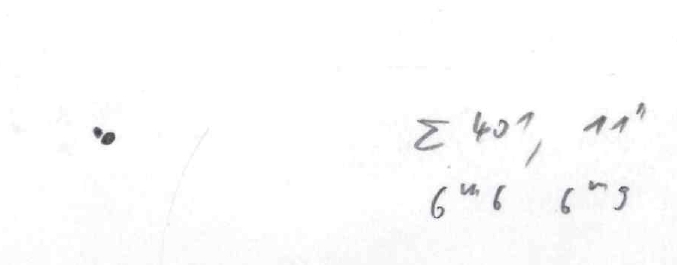
|
Robert Zebahl
Leipzig (Germany) |
120mm (18x) |
Barely split at 18x. At 40x difference in brightness is visible. Nice view together with the double star STFA7 located northwest. |
|
Christopher Hay
Seeheim (Germany) |
180mm (113x) |
Very wide separation. Southern component slightly towards orange compared to the northern one, which is slightly towards blue. Very attractive in 0.6° FOV with STFA7.
A physical pair at 318 light years distance from us. |
|
Mark McCarthy
Fremont (California/USA) |
203mm (205x) |
Slight magnitude difference, brilliant white stars, with another slightly fainter and much wider pair in the field (this is SHY 445 BC). Physical |
|
Mark McCarthy
Fremont (California/USA) |
317mm (553x) |
Near equal white ~7", nice, W-E. Forms a double-double in wider FOV with STF 375. |
|
Karsten Kopp
Köln (Germany) |
600mm (180x) |
Gut zu trennender Doppelstern mit leichtem Helligkeitsunterschied. Beide Komponenten leuchten weiß. |
|
|
|
★★★
|
STF412, 7 Tau |
|
AB |
6m.6 |
6m.9 |
0.8" |
350° |
2019 |
Tau |
03h34m26.62s / +24°27'52.10" |
|
|
|
|
AB-C |
5m.9 |
9m.9 |
22.4" |
53° |
2014 |
|
|
|
|
Uwe Pilz
Leipzig (Germany) |
105mm (260x) |
AB: A-B länglich |
|
Christopher Hay
Seeheim (Germany) |
180mm (110x) |
No definite elongation of AB seen at 110x, seeing is poor. But nice pinprick of light wide off to NE, seems bluish, this is the C component.
AB-C is physical at 429 light years distance from us, and so is A-B, so this is a physical triple system. Very easy to find 3° due west of the Pleiades. |
|
Mark McCarthy
Fremont (California/USA) |
508mm (333x) |
AB: Exciting 2+1 set. AB is brilliant near equal white, nice close split <1". C is a much fainter wider star. I also cleanly split AB with the 8-inch mask, but the dark gap was narrower. Physical with a 522.16-year period |
|
|
|
★★
|
S430 |
|
AB |
7m.2 |
7m.5 |
41.0" |
96° |
2017 |
Per |
03h38m18.83s / +44°48'06.50" |
Christopher Hay
Seeheim (Germany) |
7x50 |
On tripod. Well separated. A evidently brighter than B. A appears to tend towards orange, B rather towards blue.
Most of the Alpha-Persei cluster can be viewed together with S430 in 7.2° FOV. Seen thus, S430 feels likes a distant little echo of the powerfully orange-blue pair Sigma Per in the cluster.
South 430 is a physical double at a distance to us of 498 light years. |
|
Christopher Hay
Seeheim (Germany) |
15x45 |
Binoculars with internal stabilisation, handheld. AB widely separated, greater brightness of A is distinct. The colour hues that were uncertain in 7x50 are now clearer. Colours confirmed in 15x60 on tripod. |
|
Robert Zebahl
Leipzig (Germany) |
16x70 |
2020-11-07: Easily separated at moderate separation, nearly equal in brightness. White-yellowish & white-bluish. |
|
René Merting
Drachhausen (Germany) |
16x70 |
ein schöner Fernglas-Stern - beide Komponenten sind hell genug und stehen weit genug auseinander - sie sind mehr als ordentlich getrennt - die B-Komponente im Osten wirkt ein bisschen wärmer im Farbton |
|
Sarah Gebauer
Germany |
100mm (21x) |
01.10.23: bei 21-fach gut getrennt, zwei nadelfeine Pünktchen, die einen absolut minimalen Farbkontrast zeigen, der fast nicht erkennbar ist - bei 49-fach verschwindet dieser zarte Farbeffekt leider, A und B werden zu zwei warmweißen Pünktchen, |
|
René Merting
Drachhausen (Germany) |
107mm (30x) |
bei 30x ein auffälliges, ordentlich getrenntes Sternpaar, B im Osten strahlt etwa eine viertel Größenklassen schwächer, beide Sterne strahlen weiß, B minimal dunkler |
|
|
|
★
|
WEB2 |
|
AB |
5m.7 |
13m.8 |
23.4" |
98° |
2011 |
Cam |
03h42m42.73s / +59°58'09.80" |
|
|
|
|
AC |
5m.7 |
13m.0 |
34.5" |
303° |
2011 |
|
|
|
|
|
|
AD |
5m.7 |
8m.4 |
54.8" |
36° |
2019 |
|
|
|
|
|
|
AE |
5m.9 |
11m.8 |
168.4" |
162° |
2003 |
|
|
René Merting
Drachhausen (Germany) |
18x70 |
AD: ein komfortabel getrenntes sehr ungleiches Paar - Komponente A im Südwesten ist hell und cremegelb - Komponente D muss mindestens 3 Größenklassen schwächer sein und wirkt dadurch wie eine graue Maus |
|
René Merting
Drachhausen (Germany) |
76mm (29x) |
AD: bei 29x ein komfortabel getrenntes Paar - Bim Nordosten ist mindestens 2 Größenklassen schwächer und wirkt mausgrau gegen die hell strahlende weißgelbliche A-Komponente |
|
Sarah Gebauer
Germany |
100mm (49x) |
AD: 26.09.23: bei 49-fach ein weit getrenntes Farbkontrastpaar - die südliche Komponente strahlt orange, die nördliche grau bis eisblau |
|
|
|
★★
|
STF434 |
|
AB |
7m.8 |
8m.3 |
33.7" |
83° |
2019 |
Per |
03h43m58.92s / +38°22'25.60" |
|
|
|
|
AC |
7m.8 |
13m.6 |
91.9" |
350° |
2015 |
|
|
Robert Zebahl
Leipzig (Germany) |
16x70 |
AB: 2020-11-07: Beautiful sight! Nice separation and color contrast: vivid orange & subtle blue. |
|
Sarah Gebauer
Germany |
100mm (21x) |
AB: schon in Aufsuchvergrößerung sofort farbig zu erkennen - die westliche Komponente ist etwas farbintensiver, ein richtiges Roségold mit einem warmen Rotstich - die zweite Komponente hat eine ähnliche Farbe, wenn auch blasser, kleiner und matter - bei 49-fach ist durch die weitere Trennung die Farbwahrnehmung deutlich einfacher: der westliche Stern bleibt schön Roségold mit Rotstich, der östliche wirkt nun kühl-bläulich, aber nicht durchgehend |

|
Robert Zebahl
Leipzig (Germany) |
102mm (28x) |
AB: 2020-11-08: Easy to separate, beautiful sight! Light orange & light blue. |

|
René Merting
Drachhausen (Germany) |
107mm (30x) |
AB: bei 30x fällt die A-Komponente westlich gleich als mattgelber Stern mit einem orange Tupf auf, B im Osten ist etwa eine halbe Größenklasse schwächer und wirkt ganz zart blaugrün - bei 60x ist A richtig schön dunkelgelb, fast ins Orange gehende, B wirkt immer wieder grüngrau |
|
|
|
★★
|
BU535, omicron Per, 38 Per, Atik |
|
|
3m.9 |
6m.7 |
1.1" |
20° |
2015 |
Per |
03h44m19.13s / +32°17'17.70" |
Uwe Pilz
Leipzig (Germany) |
105mm (88x) |
=omikron Per, in IC348, lohnend! |

|
Mark McCarthy
Fremont (California/USA) |
152mm (285x) |
Strong sense of out of roundness at all powers, but not certain. Burnham discovered with the 18.5-inch at 1.0". WDS uncertain, and I don't find Gaia data for the secondary |
|
Robert Zebahl
Leipzig (Germany) |
152mm (300x) |
In steady moments the faint companion is clearly recognizable as a small brightening in the first diffraction ring of the primary component. |
|
Mark McCarthy
Fremont (California/USA) |
317mm (270x) |
No split at 270x |
|
|
|
★★
|
BU536 & S437, SAO76169 |
BU536 |
AB |
8m.1 |
9m.4 |
1.1" |
178° |
2016 |
Tau |
03h46m16.00s / +24°11'23.50" |
|
|
|
S437 |
AB-C |
8m.1 |
7m.7 |
38.8" |
308° |
2017 |
|
|
|
|
|
BU536 |
CD |
7m.7 |
12m.9 |
18.3" |
5° |
2015 |
|
|
|
|
Christopher Hay
Seeheim (Germany) |
10x42 |
S437 AB-C: A fine, compact pair at the centre of the Pleiades. Not physical, in contrast to AB. |
|
Christopher Hay
Seeheim (Germany) |
71mm (13x) |
S437 AB-C: Well separated. The most double-starish pair in the whole of the Pleiades at this power. |
|
Christopher Hay
Seeheim (Germany) |
76mm (20x) |
S437 AB-C: Well separated. Component C is slightly orange. |
|
Christopher Hay
Seeheim (Germany) |
180mm (200x) |
BU 536: AB seems to plop apart in good moments, but remains uncertain.
S437 AB-C: C is brown-orange, AB blue-white. |
|
Mark McCarthy
Fremont (California/USA) |
203mm (333x) |
BU536 (AB): Wow what a great pair. B is a clean split ~1" right next to A, approximately 1 delta. More amazing to see than I can describe. Aitken had a measure of 0.15" in 1899.70. Burnham discovered with the 18.5-inch at 0.4" and notes "It is important that the close pair should be watched and measured in the near future." Physical, 885.64 year period, now widening |
|
Karsten Kopp
Köln (Germany) |
600mm (180x) |
S437 (AB-C): S437 AB-C: Einfacher Doppelstern mit geringen Helligkeitsunterschied. |
|
Karsten Kopp
Köln (Germany) |
600mm (180x) |
BU536 (CD): BU536 CD: Hier liegt die Schwierigkeit bei Komponente D mit einer Helligkeit von 12,9 mag. Komponente C leuchtet orange. |
|
|
|
★★★
|
STF470, 32 Eri |
|
AB |
4m.8 |
5m.9 |
6.9" |
349° |
2021 |
Eri |
03h54m17.49s / -02°57'17.00" |
Robert Zebahl
Leipzig (Germany) |
55mm (27x) |
At 27x split, but still tight with noticeable difference in brightness. A slight difference in colors could be seen. At 56x the color difference was very evident: The brighter component appeared slightly yellowish, the fainter one slightly bluish. Highly recommended! The sketch was done few days later during another observation. |
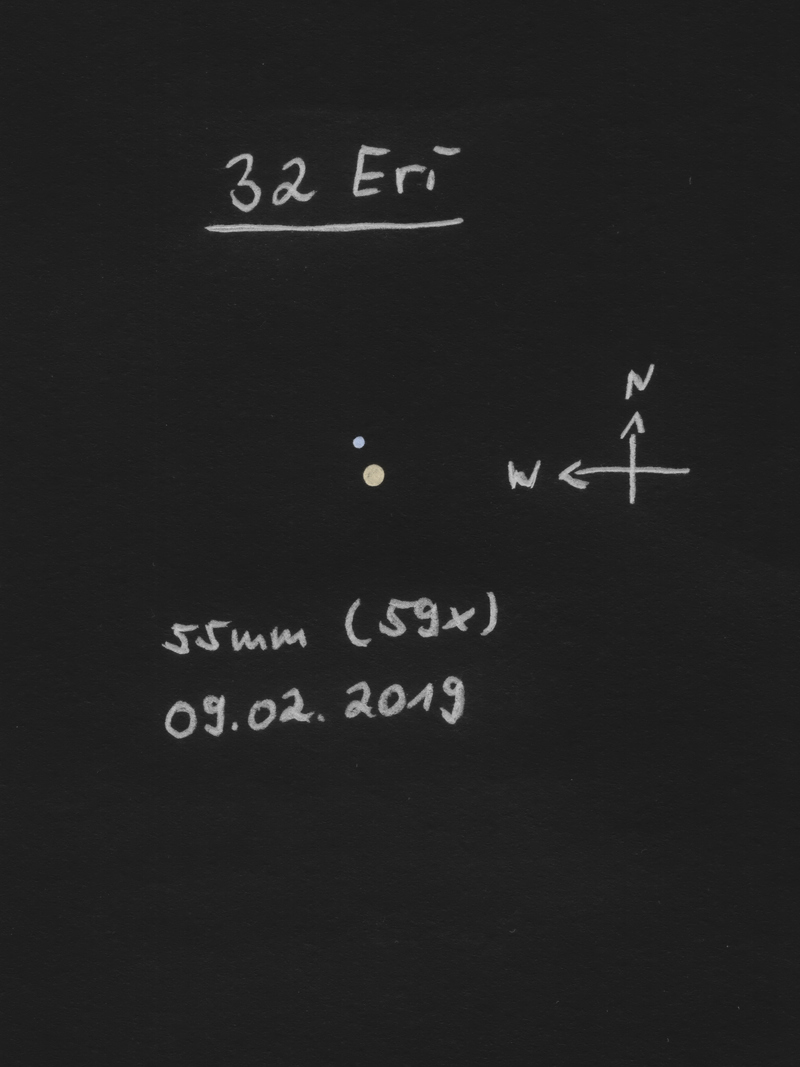
|
Uwe Pilz
Leipzig (Germany) |
105mm (144x) |
ab 26x trennbar |
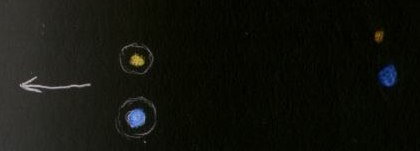
|
Uwe Pilz
Leipzig (Germany) |
105mm (288x) |
Farbkontrast, gelborange-blauweiß |
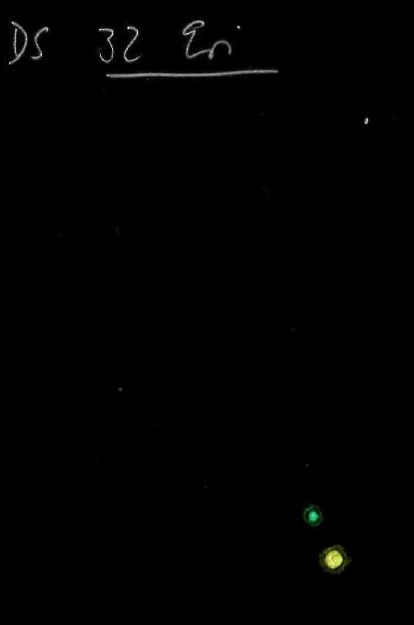
|
|
|
★
|
KU16 |
|
AB |
10m.5 |
11m.2 |
2.4" |
268° |
2015 |
Per |
03h56m18.22s / +51°07'58.70" |
Mark McCarthy
Fremont (California/USA) |
203mm (121x) |
Wow! Very fine pair, slight mag difference, faint ~10th magnitude, well split B resolves with seeing |
|
|
|
★
|
MLB639 |
|
|
8m.1 |
9m.7 |
8.1" |
267° |
2018 |
Tau |
04h00m05.00s / +27°33'18.30" |
Mark McCarthy
Fremont (California/USA) |
178mm (205x) |
B barely seen direct, flashes with averted vision. Very light orange A. Not physical |
|
Karsten Kopp
Köln (Germany) |
600mm (180x) |
Schöne Doppelstern, welcher gut zu trennen ist. Das Highlight ist Komponente A. Der Stern leuchtet schön orange-rot. |
|
|
|
★
|
HLD10 |
|
|
9m.4 |
10m.8 |
4.2" |
91° |
2018 |
Per |
04h02m27.53s / +48°23'43.10" |
Mark McCarthy
Fremont (California/USA) |
203mm (121x) |
Wow! good one. ~2 delta mag, ~4", very fine B. Nice pair -- but not physical! |
|
|
|
★
|
STF494 |
|
|
7m.5 |
7m.7 |
5.5" |
187° |
2021 |
Tau |
04h08m53.50s / +23°05'55.10" |
René Merting
Drachhausen (Germany) |
76mm (57x) |
bei 29x ist eine kleine 8 erkennbar - bei 57x zeigt sich ein etwas mehr als knapp getrenntes Paar zweier gleichheller, weiß strahlender Sterne |
|
Robert Zebahl
Leipzig (Germany) |
102mm (62x) |
At 28x separated, but very tight, similarly bright, both whitish. At 62x easy to separate, little difference in brightness and color: slightly orange; white-bluish. Color impression slightly more intense at 86x. |
|
Robert Zebahl
Leipzig (Germany) |
152mm (49x) |
Easy to separate at 49x with subtle color differences: slightly orange; white-bluish. Color impression slightly more intense at 100x. Beautiful sight. |
|
Mark McCarthy
Fremont (California/USA) |
178mm (205x) |
Near equal white stars, well separated |
|
Karsten Kopp
Köln (Germany) |
600mm (180x) |
Schön zu trennender Doppelstern mit fast identischer Helligkeit. |
|
|
|
★
|
omicron 2 Eri, 40 Eri, STF518 |
|
A-BC |
4m.4 |
9m.3 |
82.7" |
102° |
2019 |
Eri |
04h15m16.32s / -07°39'10.30" |
|
|
|
|
BC |
9m.5 |
11m.2 |
8.2" |
330° |
2019 |
|
|
|
|
Winfried Kräling
Marburg (Germany) |
102mm (178x) |
|
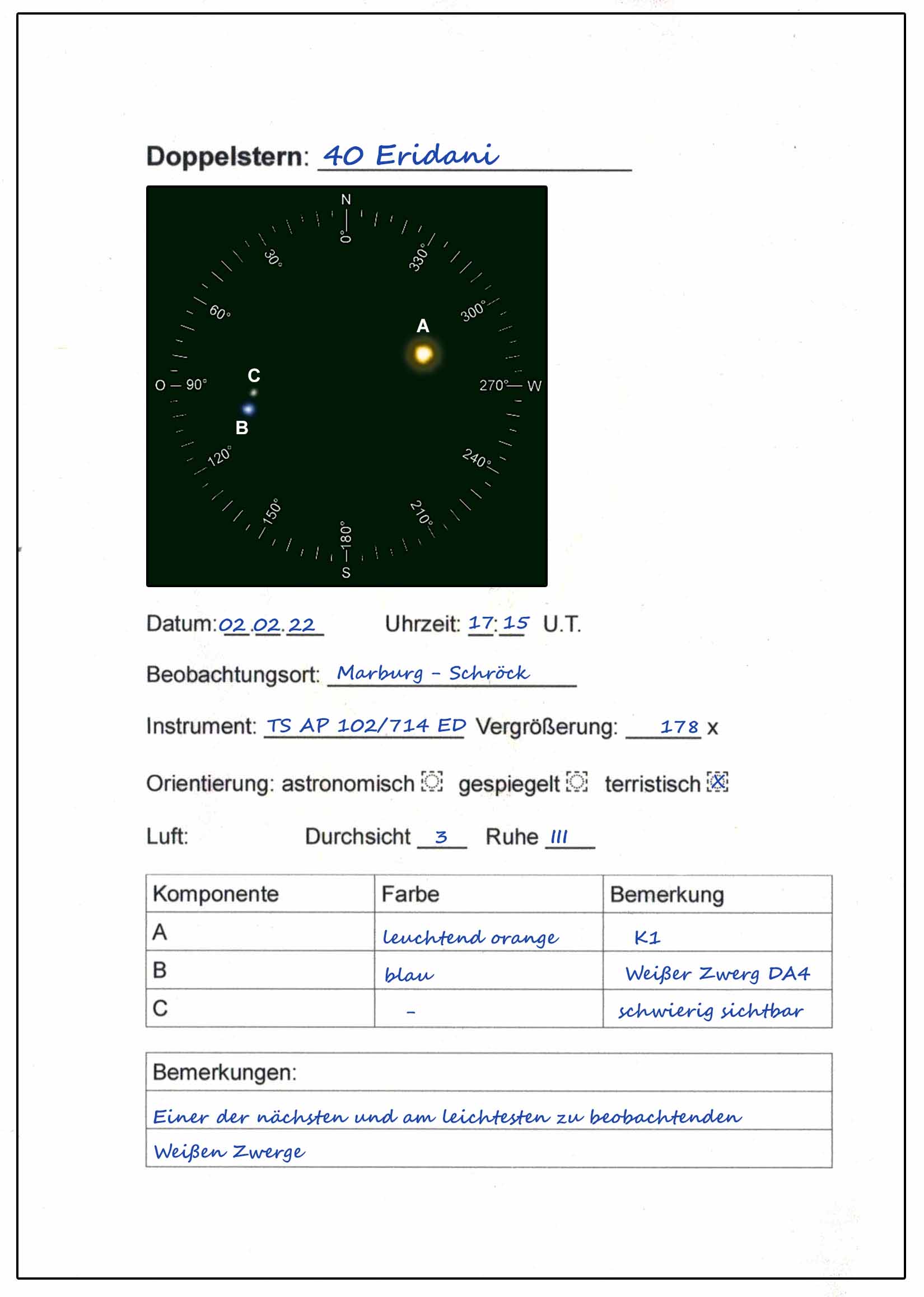
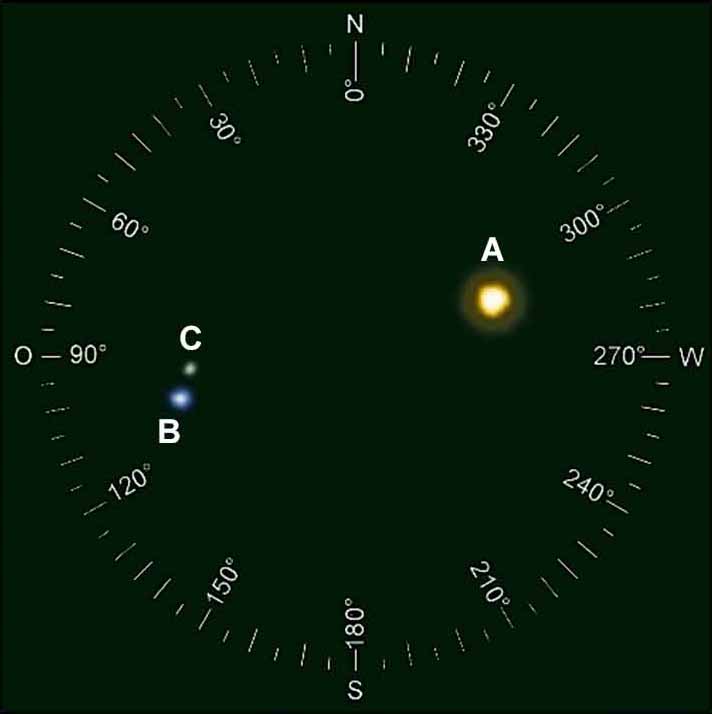
|
Uwe Pilz
Leipzig (Germany) |
105mm (244x) |
A ist gelblich. B fiel sofort ins Auge, auch bei 144x. C war extrem schwierig. A musste außerhalb des Gesichtsfeldes stehen, aber auch dann war er nur indirekt sichtbar. Dann aber überraschte der verhältnismäßig große Abstand B-C. ~ A ist ein Hauptreihenstern ähnlich der Sonne. B ist ein weißer Zwerg, einer der hellsten am Himmel. C ist ein Roter Zwerg, davon gibt es nicht viele in der Reichweite kleiner Instrumente. Insgesamt hat man drei Zwergsterne auf einen Blick: Einen gewöhnlichen (=Hauptreihen-) Zwerg, einen weißen und einen roten. |
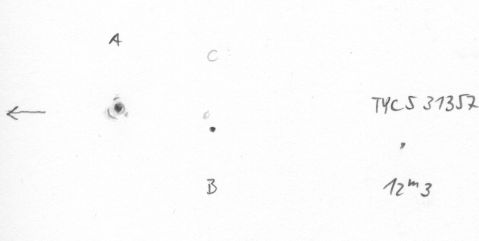
|
|
Berthold Fuchs
Wiesbaden (Germany) |
130mm |
A-BC: Triplesystem with a white Dwarf |
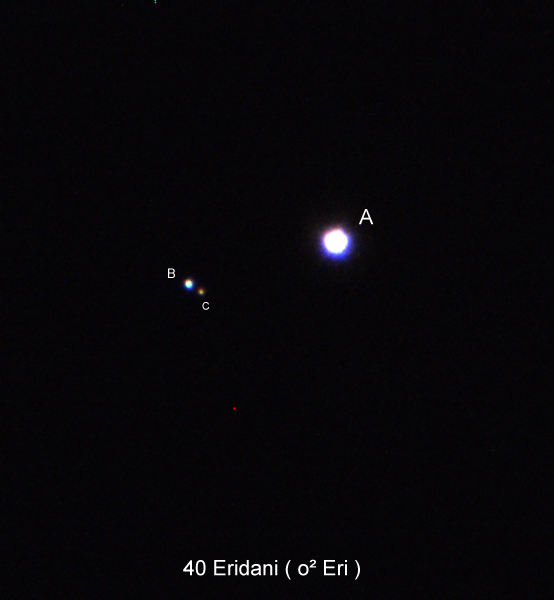
|
|
|
★
|
STTA45, V774 Tau |
|
AB |
6m.4 |
7m.0 |
64.6" |
316° |
2021 |
Tau |
04h15m28.86s / +06°11'13.60" |
René Merting
Drachhausen (Germany) |
12x42 |
ein schickes Sternpaar - Komponente B steht in einigem Abstand nordwestlich von A - leichter Farbkontrast, A leicht gelblich, B wirkt schmutzig braunweiß |
|
René Merting
Drachhausen (Germany) |
76mm (29x) |
bei 29x zwei weit auseinander stehende Sterne - B im Nordwesten ist nicht viel schwächer und wirkt schmutzig weiß gegen die gelblich strahlende A-Komponente |
|
Sarah Gebauer
Germany |
100mm (49x) |
bei 49-fach zwei sehr weit getrennte, helle Pünktchen, beide warmweiß, die südöstliche Komponente einen Hauch gelblicher - nordöstlich davon stehen noch einmal zwei ganz schwache Sterne, die wie eine Kopie aussehen und die Komponenten C und E sein könnten - bei 80-fach ändert sich die Farbe ganz leicht zu einem perlweiß mit einem Hauch Gelb |
|
|
|
★
|
STTA44 |
|
|
7m.1 |
8m.0 |
58.6" |
321° |
2017 |
Per |
04h17m19.77s / +46°13'03.60" |
Robert Zebahl
Leipzig (Germany) |
16x70 |
2020-11-07: Very nice sight, moderate separation & difference in brightness. Slightly yellow-orange & subtle bluish. |
|
René Merting
Drachhausen (Germany) |
107mm (30x) |
bei 30x ein komfortabel getrenntes Paar, B im Nordwesten ist etwa eine halbe Größenklasse schwächer und dennoch schon richtiggehend schmutzig graubraun gegen die weiß strahlende A-Komponente |
|
|
|
★
|
STF520 |
|
|
8m.3 |
8m.4 |
0.6" |
82° |
2019 |
Tau |
04h18m14.55s / +22°48'24.60" |
|
|
Mark McCarthy
Fremont (California/USA) |
317mm (553x) |
Faint elongated to overlapping disks. |
|
|
|
★
|
STF519 & GUI5 |
STF519 |
AB |
7m.8 |
9m.4 |
17.9" |
348° |
2015 |
Per |
04h20m53.71s / +50°22'39.00" |
|
|
|
GUI5 |
AC |
7m.8 |
10m.8 |
108.8" |
193° |
2015 |
|
|
Robert Zebahl
Leipzig (Germany) |
16x70 |
STF519 (AB): 2020-11-07: Beautifully framed by brighter stars! Primary component A appears slightly orange with a much fainter, very close companion. To the south is S445, which forms a prominent triangle of stars of different brightness. The brightest of these three stars also appears orange. |
|
Robert Zebahl
Leipzig (Germany) |
102mm (28x) |
STF519 (AB): 2020-11-08: Well separated with large difference in brightness. Primary component appeared white-yellowish. South very outstanding is the double star S445. Worthwhile due to the beautiful surroundings. |
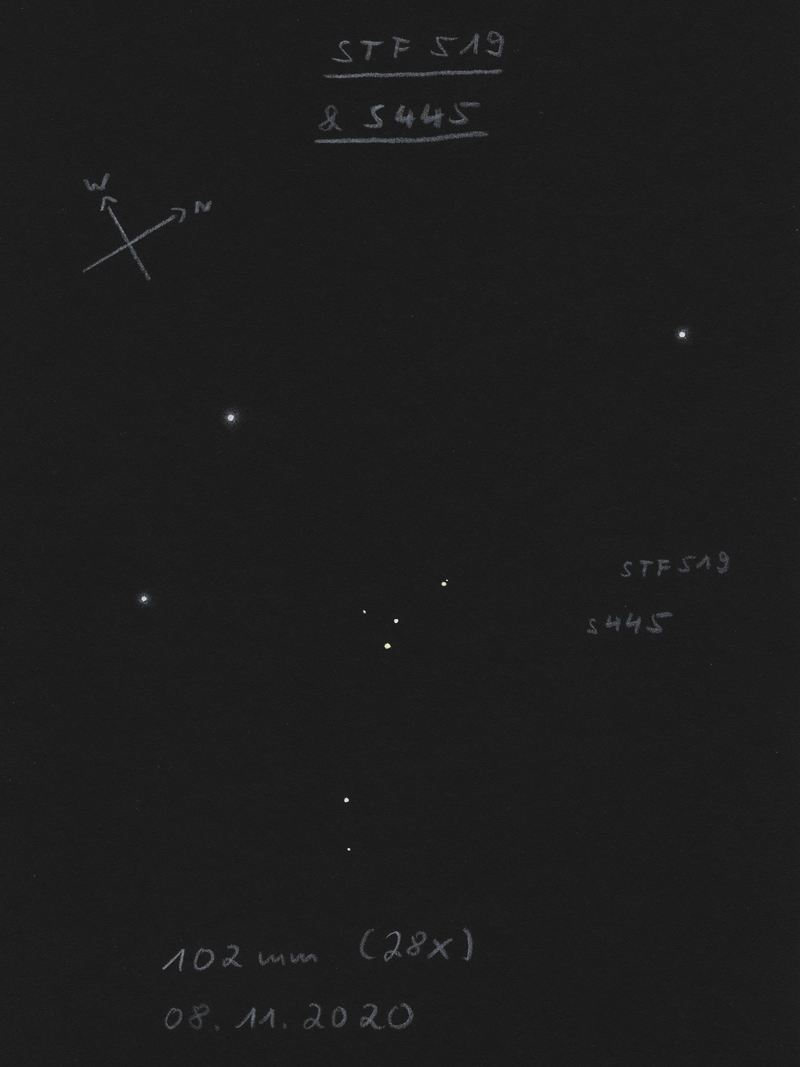
|
|
|
★★★
|
STFA10, theta Tau, theta 1/2 Tau, 77/78 Tau |
|
AB |
3m.4 |
3m.9 |
336.9" |
347° |
2019 |
Tau |
04h28m39.74s / +15°52'15.20" |
Robert Zebahl
Leipzig (Germany) |
naked eye |
2023-02-15: Easy to separate with similar bright components, although colorless. |
|
René Merting
Drachhausen (Germany) |
naked eye |
wunderbar, der Doppelstern kann ich mit bloßem Auge relativ problemlos getrennt erkennen - Nord-Süd-Ausrichtung |
|
Christopher Hay
Seeheim (Germany) |
naked eye |
5 Nov. 2022. In good transparency I notice while casually looking naked-eye at the Hyades that Theta1/2 Tau seem elongated. Looking now with direct concentration, the pair moves clearly apart. Theta2 is visibly slightly brighter than Theta1, PA estimated at 350°.
Following this up directly by looking at Mizar/Alcor in Uma, that pair, which I can always split naked-eye reasonably well if transparency allows, now seems super-wide compared to Theta1/2 Tau. I estimate the separation of Mizar/Alcor as being two-and-a-half times that of Theta1/2 Tau. |
|
René Merting
Drachhausen (Germany) |
2x54 |
einfache, ordentliche Trennung der beiden Sterne, sie sind heller und stehen enger als das Sternpaar Arn 36 (80/81 Tau) im Süden |
|
Christopher Hay
Seeheim (Germany) |
2x54 |
Well separated, luminous orange and ice blue. Gorgeous with entire Hyades and Pleiades in 25° field of view.
Theta Tau is a physical double at a distance to us of 150 light years. |
|
Christopher Hay
Seeheim (Germany) |
7x45 |
Theta Tauri. Luminous orange and blue. Wide apart but very much feeling to belong together, despite the many stars of the Hyades all around.
A physical pair. The data suggest separation with naked eye is possible, something to try in good health under a steady sky. At all events with naked eye Theta Tauri is at the centre of the southern stroke of the Hyades' distinctive "V" shape. In the binoculars, by ignoring Aldebaran, which is not a cluster member but a foreground star, it suddenly becomes apparent that Theta Tauri is in fact at the centre of the Hyades in our sky and is its lucida. This impression is supported very nicely by 7x and 8.6° FOV. Definitely one of the finest doubles for this class of binocular. |
|
Robert Zebahl
Leipzig (Germany) |
16x70 |
2023-02-15: Bright, widely separated. The slightly fainter, northern component B is strikingly bright orange, while A appears rather white. Very beautiful view. |
|
René Merting
Drachhausen (Germany) |
76mm (29x) |
bei 29x ein wunderschönes Sternpaar, natürlich weit auseinander stehend, aber die nördliche Komponente strahlt in einem schönen Ährengelb, B ist weiß, dadurch ein schöner Farbkontrast |
|
Sarah Gebauer
Germany |
100mm (21x) |
schon oft besucht und bestaunt, doch erst jetzt bewusst als farbigen Doppelstern beobachtet - Theta 1 und 2 strahlen in der Stierspitze schön warmgelb, sind sehr weit getrennt und rahmen die Sternformation an der Westseite sehr schön ein |

|
|
|
★
|
STT84 |
|
|
7m.2 |
8m.1 |
9.5" |
255° |
2016 |
Tau |
04h31m04.08s / +06°47'28.70" |
Robert Zebahl
Leipzig (Germany) |
16x70 |
2023-02-15: Beautiful pair, separated but very tight with well visible difference in brightness. I had to look closely for the separation. The components look slightly orange together. |
|
René Merting
Drachhausen (Germany) |
76mm (29x) |
bei 29x ein wunderschön, eng stehendes Sternpaar - Komponente B im Südwesten ist eine dreiviertel Größenklasse schwächer |
|
Sarah Gebauer
Germany |
100mm (49x) |
bei 49-fach knapp, aber deutlich getrennt, der erste Farbeindruck ist bei der helleren Komponente gelblich, die schwächere zeigt auch einen warmgelben Farbton - bei 80-fach bestätigt sich der Farbeindruck, die hellere Komponente zeigt ein sehr warmes, dunkles Gelb, der Begleiter wirkt im Grunde ganz ähnlich, nur dumpfer |
|
|
|
★★
|
STF559 |
|
|
7m.0 |
7m.0 |
3.1" |
275° |
2021 |
Tau |
04h33m33.04s / +18°01'00.20" |
Robert Zebahl
Leipzig (Germany) |
70mm (57x) |
Barely split with similarly bright components. |
|
René Merting
Drachhausen (Germany) |
76mm (95x) |
bei 95x sind zwei sehr eng stehende, knapp getrennte gleich helle Sterne erkennbar - das Sternpaar ist ohne Konkurrenz im unmittelbaren Umfeld |
|
Robert Zebahl
Leipzig (Germany) |
102mm (160x) |
Very nice view! Easy to separate, similarly bright at a nice distance from each other. The colors of the components changed over time: orange and subtle blue. |
|
Uwe Pilz
Leipzig (Germany) |
105mm (144x) |
trennbar mit 88x, westlicher Stern scheint etwas heller und gelb-orange, östlicher Stern orange |

|
Robert Zebahl
Leipzig (Germany) |
152mm (69x) |
Beautiful sight, similar bright components, pretty tight. |
|
Karsten Kopp
Köln (Germany) |
600mm (180x) |
Gut zu trennender Doppelstern, wo beide Komponenten die gleiche Helligkeit haben und schön weißlich strahlen. |
|
|
|
★★
|
STF572 |
|
AB |
7m.4 |
7m.2 |
4.5" |
188° |
2021 |
Tau |
04h38m29.58s / +26°56'25.60" |
|
|
Christopher Hay
Seeheim (Germany) |
42mm (12x) |
Slightly elongated. PA seen definitely without prior knowledge, confirmed in 3-inch. |
|
Robert Zebahl
Leipzig (Germany) |
70mm (57x) |
Clearly separated, easy with beautiful color contrast: A slightly orange, B white. |
|
Christopher Hay
Seeheim (Germany) |
76mm (83x) |
Well separated, very even matched pair. |
|
Karsten Kopp
Köln (Germany) |
600mm (180x) |
Schöner Doppelstern mit nur minimalen Helligkeitsunterschied. Beide Komponente leuchten gelblich weiß. |
|
|
|
★★
|
STF616, omega Aur, 4 Aur |
|
AB |
5m.0 |
8m.2 |
4.7" |
5° |
2019 |
Aur |
04h59m15.41s / +37°53'24.90" |
Robert Zebahl
Leipzig (Germany) |
70mm (57x) |
Easy, still relatively tight with a large difference in brightness. Component A appeared pretty bright and white-yellowish, while B appeared only as a tiny star. Very nice sight. |
|
Uwe Pilz
Leipzig (Germany) |
105mm (88x) |
blau und weiß |

|
Uwe Pilz
Leipzig (Germany) |
105mm (144x) |
gelb. Schöner Helligkeitskontrast, dabei aber einfach. Auch bei 88x trennbar |
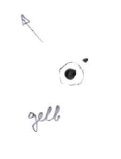
|
Mark McCarthy
Fremont (California/USA) |
178mm (205x) |
Most beautiful light blue A and light orange B, wide around 5", 3 delta mag. |
|
Mark McCarthy
Fremont (California/USA) |
203mm (113x) |
Omega Aurigae. The A was a surprising sickly blue-green color, and the B was a tawny brown, nicely split 5" away. |
|
|
|
★★
|
S459, beta Cam, 10 Cam |
|
AB |
4m.1 |
7m.4 |
84.2" |
209° |
2017 |
Cam |
05h03m25.10s / +60°26'32.20" |
René Merting
Drachhausen (Germany) |
76mm (29x) |
bei 29x ein weit auseinanderstehendes Pärchen zweier relativ heller Sterne - Komponente A wirkt gelblich, B ist gut 1.5 Magnituden schwächer (wieder total unterschätzt) und wirkt grau, dadurch ein schöner Farbkontrast |
|
Sarah Gebauer
Germany |
100mm (21x) |
26.09.23: bei 21-fach ein weit getrenntes doppeltes Farbdoppel zusammen mit STFA 13 im Süden - die hellste Komponente A im Bild strahlt in einem hellen Gelbgold, der etwas schwächere Begleiter B zeigt einen grauen bis leicht leinblütenblauen Farbeindruck |

|
René Merting
Drachhausen (Germany) |
107mm (30x) |
bei 30x zeigt sich eine satt und wunderschön gelb leuchtende A-Komponente, B im Süden ist komfortabel abgesetzt und wirkt nur weißgrau - besonders interessant ist der Anblick zusammen mit STFA13 zusammen in einem Gesichtsfeld |

|
René Merting
Drachhausen (Germany) |
320mm (45x) |
bei 45x eine wunderschöne A-Komponente, ein strahlendes Mais- Gelb - die B-Komponente weit abgesetzt im SW ist mindestens 2 Größenklassen schwächer (3.32 mag lt. Stelle Doppie), Farbeindruck weißgrau |
|
|
|
★★
|
STFA13, 11 Cam |
|
AB |
5m.2 |
6m.2 |
177.7" |
10° |
2017 |
Cam |
05h06m08.46s / +58°58'20.60" |
|
|
|
|
BC |
6m.2 |
10m.2 |
177.8" |
19° |
2012 |
|
|
|
|
|
|
CD |
10m.2 |
13m.2 |
10.3" |
12° |
2015 |
|
|
René Merting
Drachhausen (Germany) |
76mm (29x) |
AB: bei 29x sehe ich zwei helle Sterne weit auseinanderstehend - A im Süden schätze ich eine dreiviertel Magnitude heller ein
AC: bei 29x sehe ich weiter in Richtung Norden (nur leicht nach Osten geknickt) in gleichem Abstand zu B wie der Abstand AB einen weiteren ganz schwachen Stern, das ist Komponente C |
|
Sarah Gebauer
Germany |
100mm (21x) |
AB: 26.09.23: bei 21-fach zusammen mit S 459 nördlich im Gesichtsfeld, ein doppeltes Farbdoppel - die beiden Komponenten sind etwa gleich hell, die nördliche zeigt einen metallisch kupferfarbenen, die südliche einen zart cremegelben Farbeindruck |

|
René Merting
Drachhausen (Germany) |
107mm (30x) |
AB: bei 30x sind beide Sterne sehr schön erkennbar, die B-Komponente im Norden strahlt schön gelb und etwa eine halbe Größenklasse schwächer als die südliche A-Komponente, die goldweiß strahlt
AC: in der Verlängerung der Linie von A zu B ist die C-Komponente in doppelter Entfernung im Nordosten erkennbar |

|
|
|
★
|
STF645 & BU1047 |
STF645 |
A-BC |
6m.0 |
9m.1 |
11.3" |
29° |
2017 |
Tau |
05h09m45.06s / +28°01'50.20" |
|
|
|
BU1047 |
BC |
9m.1 |
9m.7 |
0.3" |
90° |
2014 |
|
|
|
|
Uwe Pilz
Leipzig (Germany) |
105mm (88x) |
STF645 (A-BC) |

|
Mark McCarthy
Fremont (California/USA) |
317mm (270x) |
STF645 (A-BC): White and grey, 2 delta mag, wide. BC is BU 1047 0.3" near equal, but not seen |
|
Mark McCarthy
Fremont (California/USA) |
508mm (667x) |
BU1047 (BC): Component of STF 645. Awesome flex on Struve. Near equal BC stars suspected at 533x, hairline split at 667x. A really fine little blue pair near bright white A. Physical with a 32.1-year period, it is at apastron now and will get impossibly close in the 2030s, becoming visually detectible again in the later part of that decade. Burnham discovered in 1889 with the Lick 36-inch, and recorded 0.4" separation |
|
Karsten Kopp
Köln (Germany) |
600mm (180x) |
STF645 (A-BC): Gut zu trennender Doppelstern mit einem großen Helligkeitsunterschied von 3,0 mag. |
|
|
|
★★
|
STF644 |
|
AB |
7m.0 |
6m.8 |
1.6" |
221° |
2019 |
Aur |
05h10m18.81s / +37°18'06.70" |
Robert Zebahl
Leipzig (Germany) |
70mm (100x) |
At 57x slightly elongated with a partially visible notching. At 100x & 133x two clearly overlapping diffraction disks are visible as figure '8' with a small difference in brightness. |
|
Robert Zebahl
Leipzig (Germany) |
102mm (129x) |
Grand sight! Two almost touching diffraction disks, slight difference in brightness, both slightly yellowish. |
|
Uwe Pilz
Leipzig (Germany) |
105mm (200x) |
Beide Orange, mit schwarzem Zwischenraum. Lohnend |

|
Robert Zebahl
Leipzig (Germany) |
152mm (129x) |
Great view, easy to separate, but still quite close together with low difference in brightness. Both components appeared slightly orange. |
|
|
|
★★★
|
STF668, 19 Ori, beta Ori, Rigel |
|
A-BC |
0m.3 |
6m.8 |
9.4" |
204° |
2021 |
Ori |
05h14m32.27s / -08°12'05.90" |
Robert Zebahl
Leipzig (Germany) |
55mm (83x) |
The second component was immediately seen as faint companion. |

|
Robert Zebahl
Leipzig (Germany) |
70mm (67x) |
First attempt at 133x: much fainter component clearly visible as a tiny star at a relatively large distance. After that the visibility was easy even at 67x. At 44x the faint component could only be guessed. |
|
Robert Zebahl
Leipzig (Germany) |
102mm (160x) |
Much fainter companion immediately visible as tiny star far outside the diffraction pattern of the primary component. |
|
Uwe Pilz
Leipzig (Germany) |
105mm (288x) |
zwei Ringe und zahlreiche radiale Strahlen um den Hauptstern |
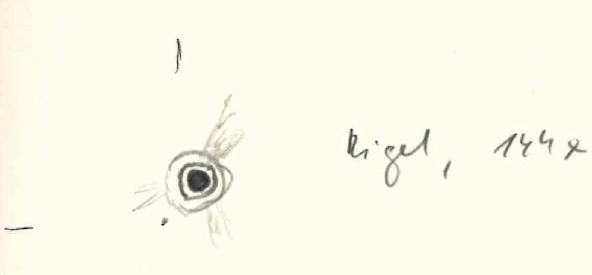
|
Jörg S. Schlimmer
Germany |
127mm (108x) |
high contrast |

|
Jörg S. Schlimmer
Germany |
305mm (170x) |
high contrast |

|
|
|
★★
|
STF653, 14 Aur |
|
AB |
5m.0 |
10m.9 |
8.9" |
11° |
2017 |
Aur |
05h15m24.39s / +32°41'15.30" |
|
|
|
|
AC |
5m.0 |
7m.3 |
14.3" |
225° |
2019 |
|
|
|
|
|
|
AD |
5m.0 |
10m.8 |
179.7" |
322° |
2010 |
|
|
Sarah Gebauer
Germany |
100mm (45x) |
AC: schon bei geringer Vergrößerung erkennt man beim zweiten Hinsehen, dass es sich um ein Sternpärchen handelt; ein schönes Doppelsternbeispiel für die Kategorie "ein heller und ein sehr schwacher nah daneben" |
|
Uwe Pilz
Leipzig (Germany) |
105mm (88x) |
AC: heller Stern gelblich weiß |
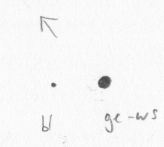
|
Mark McCarthy
Fremont (California/USA) |
317mm (270x) |
AB: Triple, one of which is one delta mag fainter than the other equal pair. All well separated. [AC is the brighter pair, AB fainter.] |
|
Mark McCarthy
Fremont (California/USA) |
317mm (270x) |
AC: Triple, one of which is one delta mag fainter than the other equal pair. All well separated. [AC is the brighter pair, AB fainter.] |
|
|
|
★
|
STF666 |
|
|
7m.8 |
7m.9 |
3.2" |
75° |
2019 |
Aur |
05h17m05.80s / +33°19'47.20" |
Robert Zebahl
Leipzig (Germany) |
55mm (83x) |
At 40x slightly elongated, at 38x separated, but tight. Overall faint with components of similar brightness. |
|
Robert Zebahl
Leipzig (Germany) |
70mm (57x) |
Split, no difference in brightness and color. Very nice! |
|
Sarah Gebauer
Germany |
100mm (136x) |
eine Grenzbeobachtung mit dem Vierzöller, aber die Trennung des eher schwachen Pärchens gelingt ganz knapp |
|
|
|
★★
|
STF696, 23 Ori |
|
|
5m.0 |
6m.8 |
32.0" |
29° |
2019 |
Ori |
05h22m50.00s / +03°32'40.00" |
René Merting
Drachhausen (Germany) |
12x42 |
ein schönes Paar - Komponente A strahlt weißblau, Komponente B nördlich ist gut 1.5 Größenklassen schwächer und wirkt grauweiß |
|
Sarah Gebauer
Germany |
12x42 |
ein DS zum Zwei-Mal-Hinschauen! Die B-Komponente ist nordöstlich und sehr viel kleiner und schwächer zu sehen, sehr niedlich! Noch dazu bekommt man ein paar schöne Dreier-Sternbögen mit ins Bild, z.B. mit 21 Ori und dem westlichen Rand von ASCC21 |
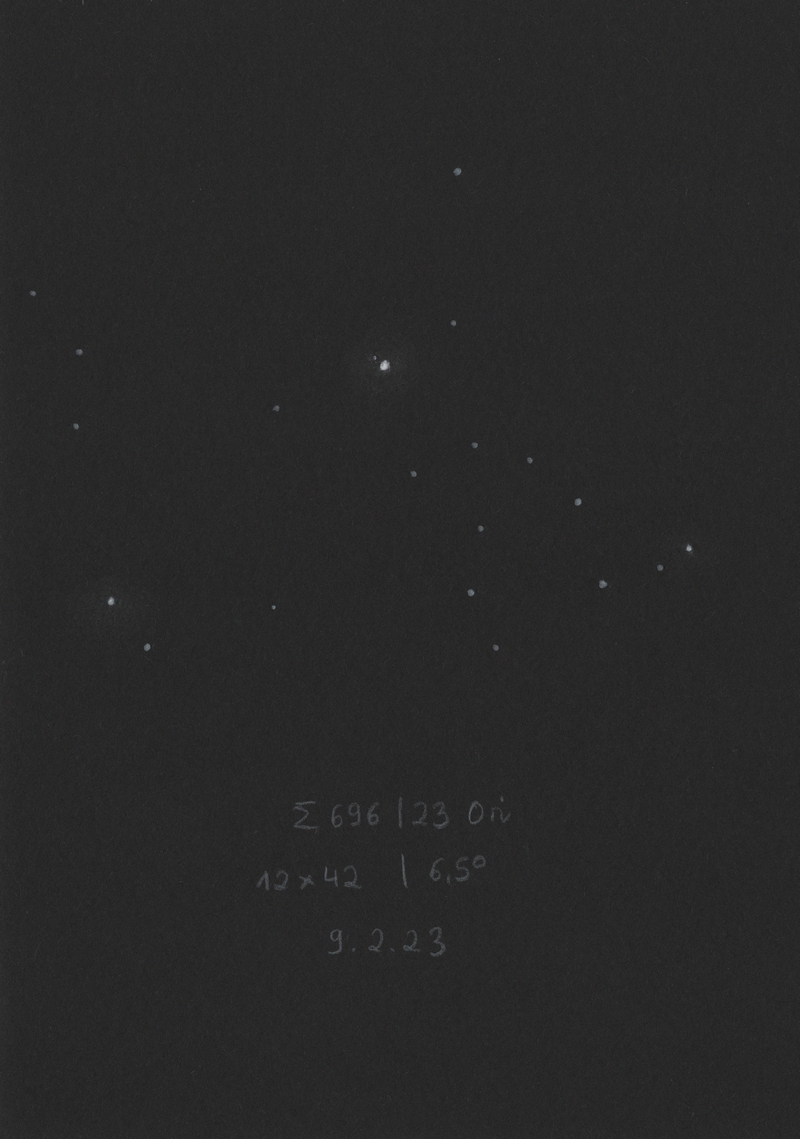
|
Christopher Hay
Seeheim (Germany) |
15x45 |
Widely separated but still a little difficult to hold due to large delta-mag.
A physical double at a distance to us of 1553 light years, which is practically the same as Theta 2 Ori in the great Orion Nebula M42. |
|
René Merting
Drachhausen (Germany) |
18x70 |
ein auffälliges gut getrenntes Paar - Komponente B im Norden ist 1.5 Größenklassen schwächer |
|
Sarah Gebauer
Germany |
254mm (96x) |
wie schon im Fernglas sehr schön und einfach getrennt |
|
|
|
★
|
HU1225 |
|
|
7m.8 |
11m.0 |
3.4" |
320° |
2016 |
Ori |
05h22m56.87s / +14°21'40.00" |
Mark McCarthy
Fremont (California/USA) |
508mm (333x) |
Visible with 20" only, the B star is too faint for the 8" in these conditions. A is light orange, B a deeper orange compared with A, 4 delta mag and ~3.5" |
|
|
|
★
|
A2703 |
|
|
8m.4 |
9m.0 |
0.1" |
1° |
2013 |
Ori |
05h24m33.14s / +09°10'15.10" |
Mark McCarthy
Fremont (California/USA) |
508mm (1067x) |
Definite notch at best moments, slight magnitude difference, tough |
|
|
|
★
|
STF698 |
|
AB |
6m.7 |
8m.3 |
31.4" |
348° |
2019 |
Aur |
05h25m12.94s / +34°51'18.60" |
Robert Zebahl
Leipzig (Germany) |
102mm (62x) |
Beautiful double star, easy to separate and quite striking. Primary component appeared in clear orange, the companion was too faint to identify the color. |
|
Uwe Pilz
Leipzig (Germany) |
105mm (88x) |
rot-orange und blaugrau, lohnend |

|
Robert Zebahl
Leipzig (Germany) |
152mm (22x) |
Easy with a attractive separation and a clear difference in brightness. A: pale yellow; B: creamy white with a touch of blue. At 49x the color impression was a bit more intense. Located in beautiful field of stars. |
|
Mark McCarthy
Fremont (California/USA) |
317mm (270x) |
Orange-yellow A and lilac B, wide, finder split, 1 delta mag. Pretty. |
|
|
|
★
|
STF699 |
|
AB |
7m.9 |
8m.6 |
8.9" |
345° |
2018 |
Aur |
05h25m38.50s / +38°02'41.10" |
Robert Zebahl
Leipzig (Germany) |
55mm (25x) |
Well separated with slightly fainter companion. |
|
Robert Zebahl
Leipzig (Germany) |
70mm (22x) |
Separated at 22x, but still a relatively tight pair with a moderate difference in brightness. Together with sigma Aur in one field of view. Overall rather dim double star. At 57x very nice view! A: pale orange, B: slightly bluish |
|
Uwe Pilz
Leipzig (Germany) |
105mm (88x) |
schwach, aber lohnend. Orange und blau |
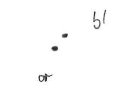
|
Mark McCarthy
Fremont (California/USA) |
317mm (270x) |
Wide yellow and blue-white, half delta mag. |
|
|
|
★
|
TDS3201 |
|
|
9m.5 |
9m.7 |
0.4" |
237° |
1991 |
Ori |
05h27m40.03s / +14°08'08.40" |
Mark McCarthy
Fremont (California/USA) |
508mm (533x) |
super fine but split, more than half delta mag, fine focus needed to remove any glare. What a nice pair, ice blue color stars |
|
|
|
★
|
HU1228 |
|
|
9m.8 |
9m.8 |
0.3" |
16° |
2007 |
Ori |
05h29m48.07s / +13°34'57.30" |
Mark McCarthy
Fremont (California/USA) |
508mm (1067x) |
Snowman overlapping disks at best moments, one second out of ten. Slightly orange stars and slight mag difference |
|
|
|
★★
|
STF719 |
|
AB |
7m.5 |
8m.8 |
1.4" |
336° |
2016 |
Aur |
05h30m06.14s / +29°32'55.30" |
|
|
|
|
AC |
7m.5 |
9m.4 |
15.0" |
353° |
2020 |
|
|
Robert Zebahl
Leipzig (Germany) |
70mm (22x) |
AC: At 22x clearly visible difference in brightness at moderate separation. The companion appears only as a dim star. At 57x the color contrast is also quite noticeable. A: light orange, C: silvery blue |
|
Robert Zebahl
Leipzig (Germany) |
102mm (62x) |
AC: Easy with a rather dim companion. The color seemed a bit more intense than in the 6-inch refractor. A: lovely pale orange; B: grey-bluish. |
|
Uwe Pilz
Leipzig (Germany) |
105mm (200x) |
AC: der helle Stern ist weiß. |
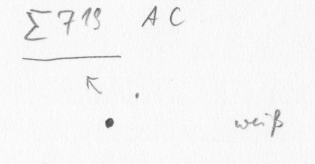
|
Uwe Pilz
Leipzig (Germany) |
105mm (288x) |
AB waren schwieriger, als es die Daten vermuten ließen. C ist schwach und erforderte indirektes Sehen |
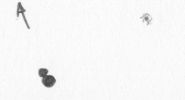
|
Robert Zebahl
Leipzig (Germany) |
152mm (49x) |
AC: Easy to separate with a significant difference in brightness. A appeared in bright orange, B appeared greyish-blue. |
|
Robert Zebahl
Leipzig (Germany) |
152mm (129x) |
AB: At 129x clearly elongated. Difference in brightness visible. The seeing was mediocre (3/5), so that the diffraction disks were only occasionally visible. At 180x no better. |
|
Mark McCarthy
Fremont (California/USA) |
317mm (277x) |
AB: widely separated with an orange A and bluish B |
|
|
|
★
|
delta Ori, Mintaka |
BU558 |
AB |
2m.4 |
14m.2 |
33.4" |
229° |
2016 |
Ori |
05h32m00.40s / -00°17'56.70" |
|
|
|
STFA14 |
AC |
2m.4 |
6m.8 |
56.2" |
4° |
2017 |
|
|
René Merting
Drachhausen (Germany) |
10x50 |
AC: Komponente C zeigt sich gut abgesetzt im NW von A - Helligkeitsunterschied enorm, mindestens 3 Größenklassen |
|
René Merting
Drachhausen (Germany) |
12x42 |
AC: Komponente C ist schwach mit ordentlich Abstand nördlich von A zu erkennen - der Stern wirkt farblos gegen die strahlend weiße A-Komponente |
|
René Merting
Drachhausen (Germany) |
18x70 |
AC: total leicht - Komponente C thront gut getrennt nördlich über A (Mintaka) und ist gut 2 bis 3 Größenklassen schwächer (sogar 4.42 mag laut Stelle Doppie) und trotzdem noch ein mittelheller Stern - A ist gleißend weiß, C weißgrau |
|
Christopher Hay
Seeheim (Germany) |
60mm (16x) |
AC: Wide pair, secondary a very mild blue. Too much power, really, less would suffice. Either way very attractive in 4° FOV together with Orion’s belt stars and the Collinder 70 cluster around them. |
|
Christopher Hay
Seeheim (Germany) |
76mm (25x) |
AC: C set off well from A. A pure white, C steel blue. Although in the middle of Orion the pair dominates the 3.1° FOV. |
|
René Merting
Drachhausen (Germany) |
76mm (29x) |
AC: bei 29x ein weit auseinander stehendes Pärchen - C im Norden ist mindestens 2 Größenklassen schwächer und wirkt weißgelblich gegen die strahlend weiße A-Komponente |
|
Sarah Gebauer
Germany |
100mm (49x) |
AC: die Hauptkomponente erscheint mir in reinstem Weiß mit einem leichten Farbstich in einem kalten Farbton, nordwestlich davon, deutlich schwächer, die zweite Komponente auch in einem Weißton |
|
Uwe Pilz
Leipzig (Germany) |
105mm (22x) |
AC: blau und violett |

|
Uwe Pilz
Leipzig (Germany) |
105mm (200x) |
AC: sehr weit in reichem Sternfeld |

|
Uwe Pilz
Leipzig (Germany) |
105mm (288x) |
AC: reinweiß-violett |
|
|
|
★
|
STF730 |
|
AB |
6m.1 |
6m.4 |
9.7" |
141° |
2019 |
Tau |
05h32m14.14s / +17°03'29.30" |
Christopher Hay
Seeheim (Germany) |
10x56 |
On tripod. A very stretched figure-8. Clear brightness difference between the two ends of the 8. |
|
Christopher Hay
Seeheim (Germany) |
15x45 |
Momentary split, coming and going, a fascinating sight. Quite white, nice together with Ruby Star 119 Tau in 4.5° FOV, and to southwest the fine star field of Collinder 65 |
|
Robert Zebahl
Leipzig (Germany) |
70mm (22x) |
At 22x beautiful sight, easy to separate with little difference in brightness. A appeared slightly yellowish. At 57x moderate, but still very nice color contrast: A yellowish, B rather white. |
|
Christopher Hay
Seeheim (Germany) |
76mm (23x) |
Fine split. Attractive in 3.5° field of view together with luminous red Ruby Star 119 Tau. |
|
René Merting
Drachhausen (Germany) |
76mm (29x) |
bei der Öffnung und 29x präsentiert sich der Doppelstern als ganz feines Pärchen - ich sehe zwei mittelhelle Sterne dicht zusammen, knapp getrennt - bei der knapp schwächeren Komponente B im Südosten ist ein kleiner farbiger Schimmer mit enthalten, sie wirkt nicht ganz so weiß wie A |
|
Mark McCarthy
Fremont (California/USA) |
203mm (333x) |
Wide white stars, around 1 delta |
|
Karsten Kopp
Köln (Germany) |
600mm (180x) |
Gut zu trennender Doppelstern mit leichten Helligkeitsunterschied von vielleicht 0,3 mag. Beide Sterne leuchten weißlich. |
|
|
|
★
|
STF747 & CLL22 & HDS742 |
STF747 |
AB |
4m.7 |
5m.5 |
36.3" |
224° |
2019 |
Ori |
05h35m02.68s / -06°00'07.20" |
|
|
|
CLL22 |
AC |
4m.7 |
8m.9 |
68.2" |
12° |
2000 |
|
|
|
|
|
HDS742 |
Ba-Bb |
5m.6 |
8m.5 |
0.5" |
111° |
2021 |
|
|
Christopher Hay
Seeheim (Germany) |
7x45 |
STF747 (AB): Clearly split, with very distinct magnitude difference between A and B components. Hand tremor prevents detection of colour contrast, if there is one at all. A very pleasing tip to Orion’s Sword.
A true physical pair according to Stelledoppie. Distance to us of 1610 light years could indicate membership of stellar association Orion OB1 and thus physical relationship to Orion nebula complex. |
|
René Merting
Drachhausen (Germany) |
8x30 |
STF747 (AB): zwei helle Sterne knapp getrennt, Komponente B im Südwesten nur knapp schwächer |
|
Christopher Hay
Seeheim (Germany) |
76mm (25x) |
CLL22 (AC): Comellas (CLL) 22 is the C component of STF 747 AB. C is a fine pinprick of light, a little less than twice as far from A as B is. Knowing that this is a physical triple system makes a big difference in perceiving it as such at the eyepiece. |
|
René Merting
Drachhausen (Germany) |
76mm (95x) |
STF747 (AB): bei 95x ein weit getrenntes, helles Pärchen - leichter Farbkontrast erkennbar, B im Südwesten wirkt blauweiß, A dagegen warmweiß, leicht weißgelblich - Helligkeitsunterschied gering, vielleicht eine halbe Magnitude |
|
René Merting
Drachhausen (Germany) |
100mm (20x) |
STF747 (AB): bei 32x zeigt sich B südwestlich von A gut eine halbe Größenklasse schwächer - B wirkt ein wenig kühler, bläulicher - zurück auf 20x, weiterhin leichte Trennung und Sichtbarkeit |
|
Sarah Gebauer
Germany |
100mm (49x) |
STF747 (AB): zusammen mit STF745, 752 und 754 im GF, ein wahres Doppelsterngewimmel! STF747 ist ein sehr leuchtstarkes Pärchen in deutlichem Abstand |
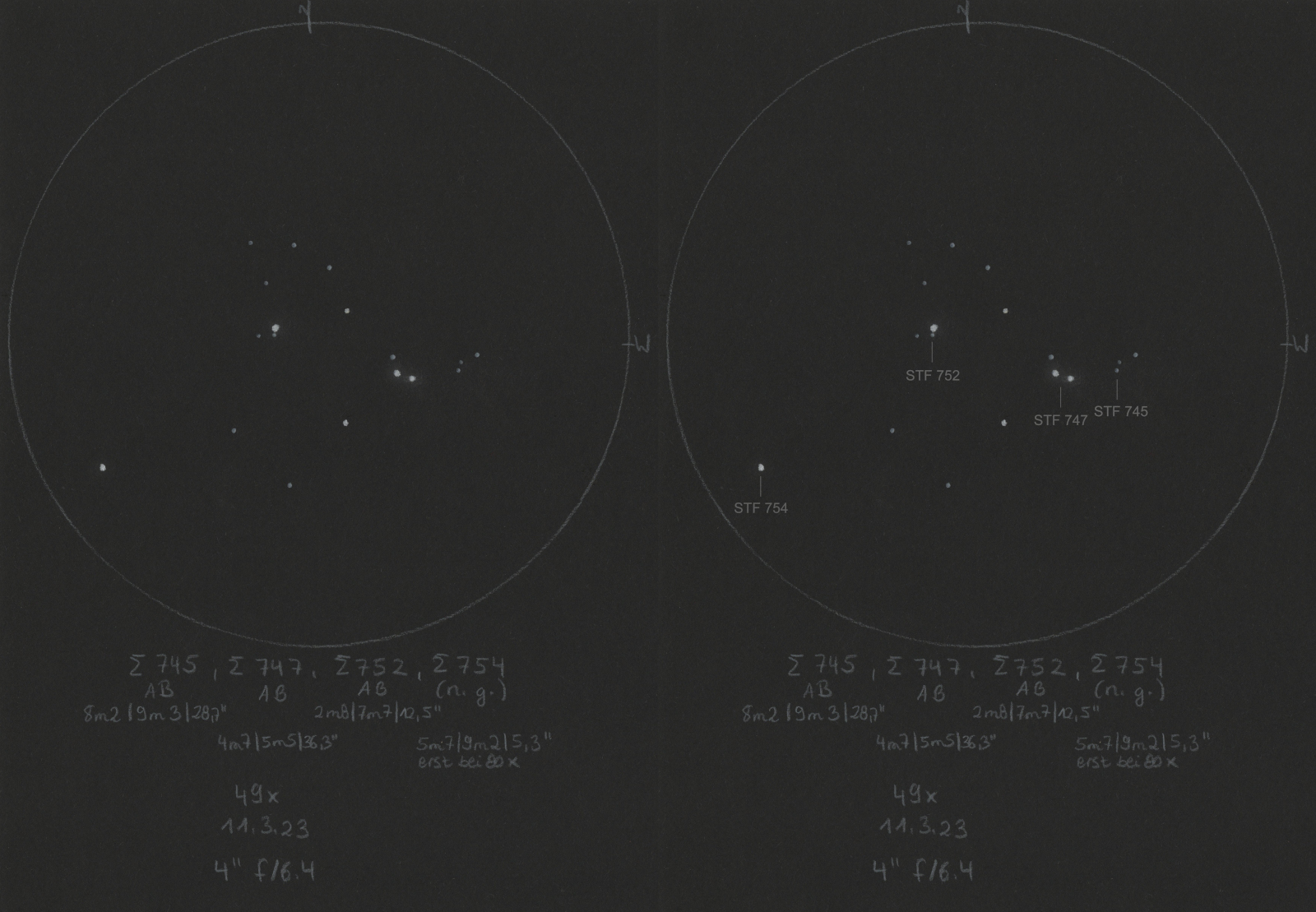
|
|
|
★★★
|
theta 1 Ori, Trapezium, 41 Ori |
|
AB |
6m.5 |
7m.5 |
8.7" |
32° |
2021 |
Ori |
05h35m15.82s / -05°23'14.30" |
|
|
|
|
AC |
6m.5 |
5m.1 |
12.8" |
132° |
2021 |
|
|
|
|
|
|
AE |
6m.5 |
11m.1 |
4.4" |
354° |
2021 |
|
|
|
|
|
|
BD |
7m.5 |
6m.4 |
19.4" |
120° |
2019 |
|
|
|
|
|
|
CD |
5m.1 |
6m.4 |
13.4" |
62° |
2019 |
|
|
|
|
|
|
CF |
5m.1 |
11m.5 |
4.5" |
121° |
2021 |
|
|
Robert Zebahl
Leipzig (Germany) |
16x70 |
2021-02-24: Components A, C & D are clearly separable from each other. The fainter B component is almost completely outshone by A. The pair AB appears clearly elongated and is with concentrated observation in a few moments even visible separated. |
|
Robert Zebahl
Leipzig (Germany) |
70mm (22x) |
2021-02-24: The different bright components A-D are clearly visible separated from each other. |
|
Christopher Hay
Seeheim (Germany) |
71mm (32x) |
13x: CD definitely split, A uncertain, B not present.
18x: A, C and D definite, B uncertain.
32x: A, B, C and D present and clear.
Mediocre seeing but good transparency with strong M42 and an inkling of M43 at 32x. B is an eclipsing variable with a period of 6.5 days and an amplitude of 0.6mag, presumably obervation was at minimum, which would explain the difficulty in seeing it at lowest powers. C is the main source of excitation of the great Orion Nebula M42/43. |
|
René Merting
Drachhausen (Germany) |
76mm (190x) |
bei 29x und 57x sind die vier Komponenten A-D schön einzeln zu erkennen - für F braucht es 190x und ruhige Momente, dann ist die Komponente knapp abgesetzt südöstlich von C erkennbar - bei E (eigentlich leichter als F) wusste ich nicht, wo ich schauen sollte |
|
Winfried Kräling
Marburg (Germany) |
102mm (178x) |
|
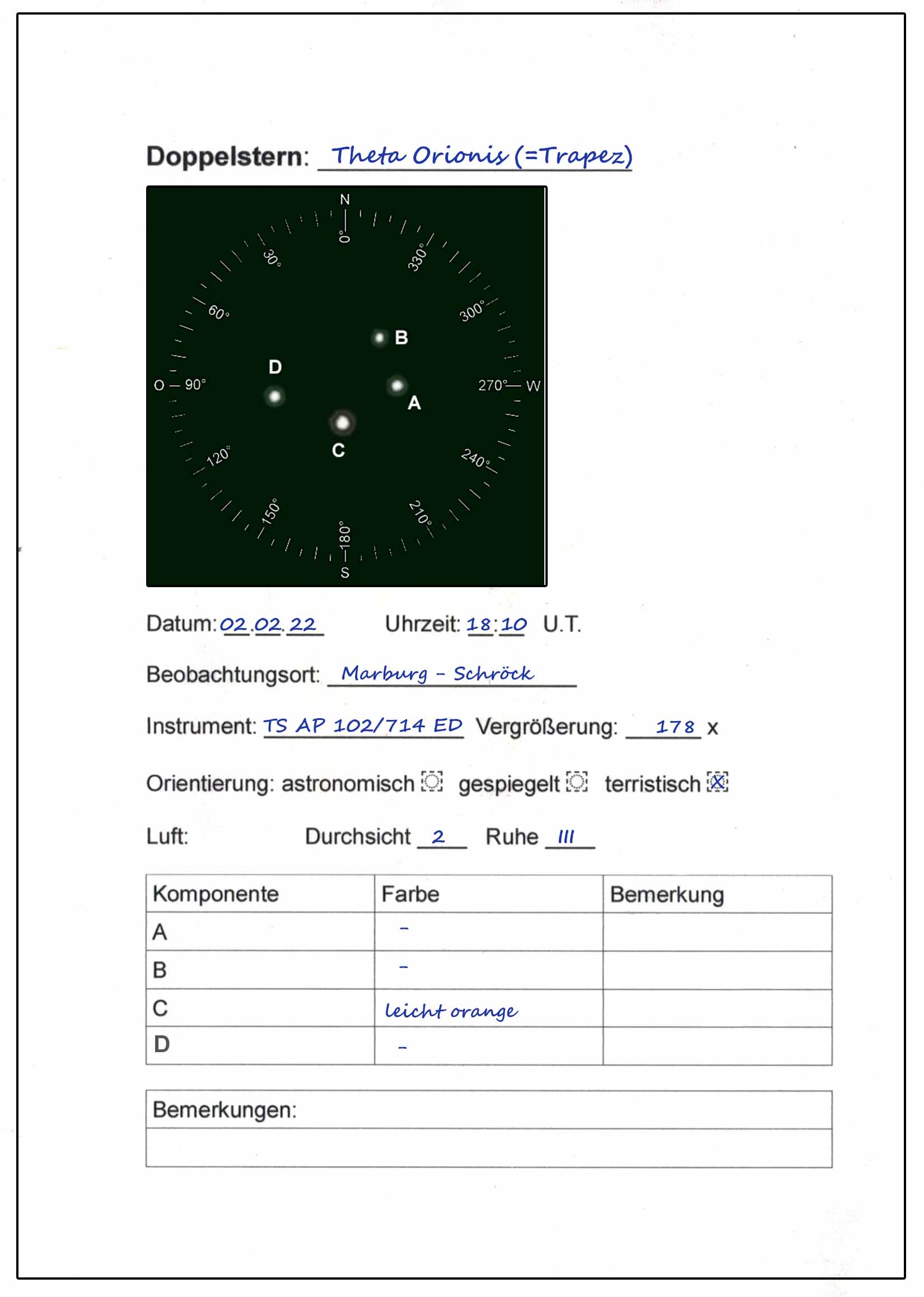
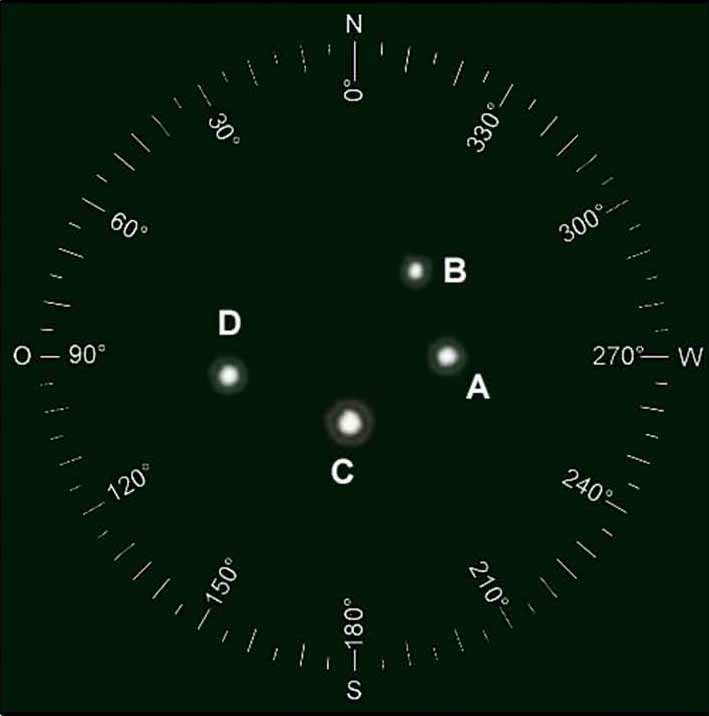
|
Jörg S. Schlimmer
Germany |
127mm (108x) |
A-E split |

|
Jörg S. Schlimmer
Germany |
305mm (170x) |
A-F split |
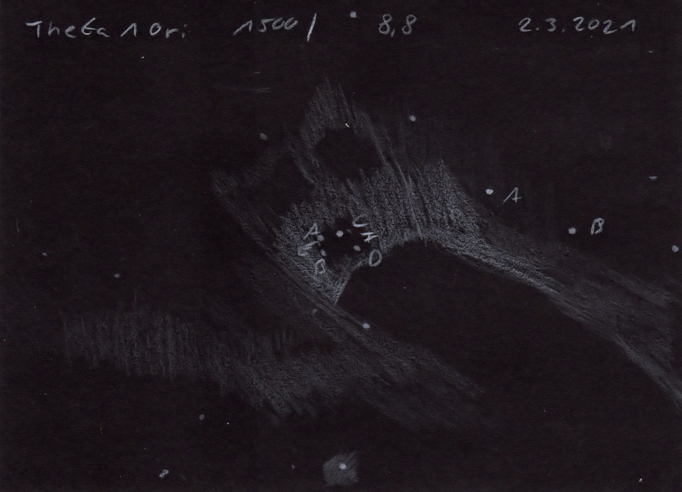
|
|
|
★★
|
STFA16, theta 2 Ori, 43 Ori |
|
AB |
5m.0 |
6m.2 |
52.3" |
93° |
2019 |
Ori |
05h35m22.88s / -05°24'57.70" |
|
|
|
|
AC |
5m.0 |
8m.5 |
128.5" |
98° |
2019 |
|
|
|
|
|
|
BC |
6m.2 |
8m.5 |
76.5" |
102° |
2019 |
|
|
Christopher Hay
Seeheim (Germany) |
7x45 |
AB: On tripod. AB distinctly separate, very double-star-ish. Slightly wider separation than STF 747 AB two degrees to the south. Embedded in glow of M42. Theta 1 Ori (Trapezium) A/C/D appears slightly box-like without resolution.
Theta2 Ori is a physical double at a distance to us of 1546 light years. |
|
|
|
★
|
STF752, 44 Ori, iota Ori, Nair Al Saif, Hatysa |
|
AB |
2m.8 |
7m.7 |
11.2" |
141° |
2021 |
Ori |
05h35m25.98s / -05°54'35.60" |
|
|
|
|
AC |
2m.8 |
9m.8 |
49.4" |
103° |
2002 |
|
|
|
|
|
|
BC |
7m.7 |
9m.8 |
41.1" |
94° |
2015 |
|
|
Christopher Hay
Seeheim (Germany) |
71mm (32x) |
AB: Tight but clearly split, very large delta-mag. No success at 18x.
Iota Ori is thought to be the original home of the runaway star AE Aurigae which currently excites the Flaming Star Nebula. |
|
René Merting
Drachhausen (Germany) |
76mm (95x) |
AB: bei 95x wirkt Komponente A leicht warmweiß bis gelb, Komponente B steht gut getrennt südöstlich und ist massiv schwächer
AC: bei 95x zeigt C sich östlich weit entfernt von A und ist nochmal viel schwächer als B - der Lichthof von A scheint bis an C heran zu reichen |
|
René Merting
Drachhausen (Germany) |
100mm (32x) |
AB: bei 64x tritt Komponente B gut getrennt aus dem Glanz von Komponente A hervor - mindestens 3 Magnituden Helligkeitsunterschied - A leicht gelblich, B braunorange - zurück auf 32x ist B in guten Momenten ganz knapp getrennt von A erkennbar
AC: bei 64x zeigt sich Komponente C südöstlich von A - der Abstand von AC ist gut 4 bis 5x so groß wie Abstand AB - C ist dabei nochmal deutlich schwächer als B - zurück auf 32x ist C auch zu erkennen |
|
Sarah Gebauer
Germany |
100mm (49x) |
AB: zusammen mit STF745, 747 und 754 im GF, ein wahres Doppelsterngewimmel! STF752 ist der wohl schönste Doppelstern von allen vieren, die strahlende Komponente A im Norden spielt klar die Hauptrolle, die deutlichst schwächere Komponente B schmiegt sich trotz eindeutiger Trennung regelrecht an ihren Partner an |

|
|
|
★
|
STF742 |
|
|
7m.1 |
7m.5 |
4.1" |
275° |
2019 |
Tau |
05h36m26.38s / +21°59'35.10" |
|
|
Christopher Hay
Seeheim (Germany) |
76mm (83x) |
Just split. A little difficult. Suprisingly more difficult than STF572 about 15° to the northwest, although the numbers are very similar and the two systems are standing at identical elevation above horizon. At 40x STF742 is no longer definitely split, but M1 half a degree to the west is strong in 2° FOV by way of compensation. |
|
Robert Zebahl
Leipzig (Germany) |
102mm (62x) |
Beautifully separated, relatively tight with well visible difference in brightness. Points directly toward Messier 1 and can be observed with it in one field of view. Very nice! |
|
Robert Zebahl
Leipzig (Germany) |
120mm (48x) |
Nice, evident double near Messier 1. Easy to split with almost equally bright components. |
|
Robert Zebahl
Leipzig (Germany) |
152mm (69x) |
At 49x just so, at 69x easily separable. The fainter component appeared a little warmer in terms of color. Great view together with Messier 1 in the field of view. |
|
Robert Zebahl
Leipzig (Germany) |
200mm (80x) |
Nice double star with nearly equally bright components. |
|
Mark McCarthy
Fremont (California/USA) |
203mm (333x) |
Well separated, ~1 delta mag white stars. Physical with 2959-year period |
|
Karsten Kopp
Köln (Germany) |
600mm (180x) |
Gut zu trennender Doppelstern mit leichten Helligkeitsunterschied von vielleicht 0,3 mag. Beide Sterne leuchten weißlich. |
|
|
|
★★
|
STF757 & STF758 & S493 |
STF757 |
AB |
8m.0 |
8m.3 |
1.5" |
241° |
2018 |
Ori |
05h38m06.52s / -00°11'03.50" |
|
|
|
STF758 |
AC |
8m.0 |
8m.7 |
51.4" |
88° |
2015 |
|
|
|
|
|
STF758 |
AD |
8m.0 |
8m.5 |
41.7" |
80° |
2015 |
|
|
|
|
|
S493 |
AE |
8m.0 |
8m.7 |
138.3" |
263° |
2015 |
|
|
|
|
|
STF758 |
CD |
8m.7 |
8m.5 |
11.4" |
298° |
2015 |
|
|
René Merting
Drachhausen (Germany) |
76mm (29x) |
AC: bei 29x steht Komponente A weit westlich von C (und D) - Abstand AC ungefähr viermal soviel wie CD
CD: bei 29x ein schön eng stehendes Sternpaar, ein wenig mehr als knapp getrennt - beide Sterne sind gleich hell |
|
René Merting
Drachhausen (Germany) |
76mm (95x) |
STF757 (AB): STF 757 ist ein Teil von STF 758, hier die Komponenten AB von insgesamt 5 Komponenten - bis 95x vergrößert, aber eine Trennung von AB hätte höhere Vergrößerung und ggf. auch Öffnung bedurft |
|
Uwe Pilz
Leipzig (Germany) |
120mm (250x) |
|

|
Mark McCarthy
Fremont (California/USA) |
317mm (553x) |
STF757 (AB): Pretty double-double system. AB is close ~1.5" near equal 8th magnitude stars. A-AC widely separated near equal to the east. AD also to the east about 10" separated from A-AC |
|
Mark McCarthy
Fremont (California/USA) |
317mm (553x) |
STF757 (AB): Pretty double-double system. AB is close ~1.5" near equal 8th magnitude stars. A-AC widely separated near equal to the east. AD also to the east about 10" separated from A-AC |
|
Mark McCarthy
Fremont (California/USA) |
317mm (553x) |
STF757 (AB): Pretty double-double system. AB is close ~1.5" near equal 8th magnitude stars. A-AC widely separated near equal to the east. AD also to the east about 10" separated from A-AC |
|
|
|
★★
|
STF761 |
|
AB |
7m.9 |
8m.4 |
68.1" |
202° |
2016 |
Ori |
05h38m36.54s / -02°33'12.70" |
|
|
|
|
AC |
7m.9 |
8m.6 |
72.1" |
209° |
2016 |
|
|
|
|
|
|
AD |
7m.9 |
11m.8 |
32.7" |
308° |
2016 |
|
|
|
|
|
|
BC |
8m.4 |
8m.6 |
8.5" |
269° |
2015 |
|
|
René Merting
Drachhausen (Germany) |
12x42 |
A-BC: A und BC sind getrennt voneinander zu erkennen - A im Norden und BC im Süden ist in etwas gleich hell - Bund C können nicht getrennt gesehen werden |
|
Christopher Hay
Seeheim (Germany) |
30x80 |
B-C fine split, C appears slightly weaker than B. Component A is too far away at this power from BC to feel that it belongs. Very attractive ensemble overall in the same field of view with Sigma Ori, which also presents three of its components. |
|
René Merting
Drachhausen (Germany) |
100mm (32x) |
A-BC: bei 32x stehen südlich von Komponente A in ordentlichem Abstand die Komponenten B (und C)
BC: bei 32x sehe ich zwei dicht zusammen stehende gleich schwache Sterne, knapp getrennt |
|
Uwe Pilz
Leipzig (Germany) |
320mm (80x) |
B und C sind deutlich orange. In der Zeichnung ist STF 961 fälschlicherweise mit STF 791 bezeichnet. Im selben Feld wie Sigma Orionis |

|
|
|
★
|
26 Aur, STF753 |
|
AB-C |
5m.5 |
8m.4 |
12.4" |
269° |
2019 |
Aur |
05h38m38.10s / +30°29'32.80" |
Christopher Hay
Seeheim (Germany) |
15x60 |
On tripod. Very stretched figure-8, does not actually resolve. Essential to focus the binoculars on some other star. |
|
Robert Zebahl
Leipzig (Germany) |
70mm (22x) |
Separable at 22x, but quite close together and pretty uneven. Primary component appeared in bright orange. At 57x easy to separate. The faint companion appeared silvery-blue. |
|
Christopher Hay
Seeheim (Germany) |
76mm (40x) |
C clearly set off from AB. AB is yellow, no particular colour seen on C.
AB (also known as BU 1240) is a physical double at 566 light years distance to us. So is AB-C according to Stelledoppie, making this a physical triple system. |
|
Uwe Pilz
Leipzig (Germany) |
105mm (88x) |
heller Stern blauweiß |

|
Christopher Hay
Seeheim (Germany) |
180mm (113x) |
Wide split. Yellow-blue collour contrast of AB to C. Neither of the two colours very strong on its own, but in fine contrast to the other. Reminiscent of the way Polaris appears in a 3-inch at 40x, with less delta-mag, making it easier, but lacking Polaris' dramatic blue of the companion. |
|
Mark McCarthy
Fremont (California/USA) |
317mm (277x) |
Bright yellow AB and a fainter yellow white C. |
|
|
|
★★★
|
sigma Ori, 48 Ori |
BU1032 |
AB |
4m.1 |
5m.3 |
0.3" |
70° |
2018 |
Ori |
05h38m44.77s / -02°36'00.20" |
|
|
|
STF762 |
AB-C |
3m.8 |
8m.8 |
11.4" |
239° |
2019 |
|
|
|
|
|
STF762 |
AB-D |
3m.8 |
6m.6 |
12.9" |
83° |
2019 |
|
|
|
|
|
STF762 |
AB-E |
3m.8 |
6m.3 |
41.4" |
62° |
2019 |
|
|
|
|
|
STF3135 |
AB-F |
3m.8 |
7m.9 |
208.0" |
324° |
2016 |
|
|
|
|
|
STF762 |
DC |
6m.6 |
8m.8 |
23.8" |
252° |
2019 |
|
|
|
|
|
STF762 |
EC |
6m.3 |
8m.8 |
52.9" |
241° |
2019 |
|
|
|
|
|
STF762 |
ED |
6m.3 |
6m.6 |
29.8" |
232° |
2019 |
|
|
Christopher Hay
Seeheim (Germany) |
10x42 |
Binoculars with internal stabilisation, handheld.
AB-D: No split, nor any elongation of AB towards D seen.
AB-E: E is set off well from AB but harder to split than the numbers would suggest. This is partly due to the major delta-mag, and partly to the circumstance that D effectively reduces the "free" stretch of sky to 29".
STF761 is a nice complement a few minutes of arc to the west and makes the visual impression of possibly belonging to the Sigma Ori complex, but Stelledoppie doesn't confirm this. |
|
René Merting
Drachhausen (Germany) |
12x42 |
AB-E: Komponente E ist nordöstlich abgesetzt von AB zu erkennen
AB-H: die relativ helle Komponente H steht in weitem Abstand im Südosten von AB |
|
Christopher Hay
Seeheim (Germany) |
15x45 |
Binoculars with internal stabilisation, handheld.
AB-D: No split acheived. However, focussing on AB feels uncertain, presumably due to disturbance by D. Also not split with 15x60 on tripod.
AB-E: E is set off well from AB. |
|
Christopher Hay
Seeheim (Germany) |
25x80 |
AB-D: D is set off nicely from AB and appears very slightly on the orange side, particularly in contrast to E. |
|
Christopher Hay
Seeheim (Germany) |
60mm (50x) |
AB-D: wide split, D is reddish. C not seen, perhaps seeing is too poor at time of observation. |
|
René Merting
Drachhausen (Germany) |
100mm (64x) |
AB-C: bei 64x zeigt sich Komponente C ganz schwach südwestlich von AB
AB-D: bei 32x schließt sich an die zartgelbe Komponente AB unmittelbar im Osten dicht stehend D weißorange an - ein schickes Trio zusammen mit E weiter östlich
AB-E: bei 32x zeigt sich in vierfacher Entfernung von AB-D die Komponente E weiter östlich in einer Linie - E ist ähnlich hell wie D |
|
Sarah Gebauer
Germany |
150mm (125x) |
ein sehr schönes Muster des Mehrfachsystems, auch wenn längst nicht alle Komponenten getrennt zu sehen waren, AB-C, AB-D und AB-E getrennt, A und B nicht |
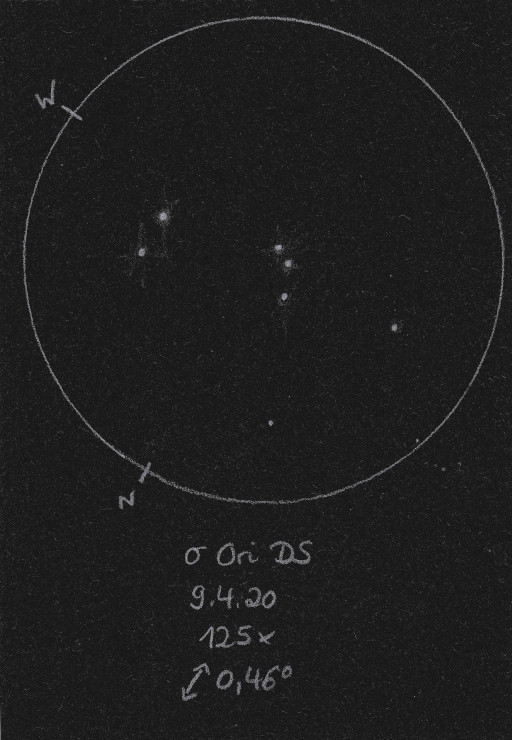
|
Uwe Pilz
Leipzig (Germany) |
320mm (80x) |
AB-C-D schon im Aufsuchokular sichtbar. Sehr lebhafte Farben, einer der schönsten Mehrfachsterne überhaupt. Im selben Feld mit STF761 |

|
|
|
★★
|
STF764 |
|
|
6m.4 |
7m.1 |
25.8" |
15° |
2019 |
Aur |
05h41m20.98s / +29°29'14.70" |
Christopher Hay
Seeheim (Germany) |
7x50 |
On tripod. PA very clear and the pair splits apart in good moments. Keeping Alnath (Beta Tau) out of the FOV helps. Chi Aur is in a nice little arc of stars on north-western edge of FOV, enhances the aesthetics of the field of view. |
|
Robert Zebahl
Leipzig (Germany) |
8x44 |
2020-11-25: Cleanly split, rather close together. In beautiful star field together with beta Tauri. |
|
Christopher Hay
Seeheim (Germany) |
15x60 |
On tripod. Distinctly split, attractive sight in light orange and light blue, a visually strong pair. 26 Aur (STF753, not quite split) in same 3.3° field of view. |
|
Christopher Hay
Seeheim (Germany) |
25x80 |
Well split. Brighter star honey-yellow, companion ice-blue. Very similar brightnesses. A visually strong, compact pair at this power in 3.2° field of view. |
|
Robert Zebahl
Leipzig (Germany) |
55mm (25x) |
Easy to split with large distance and noticeable difference in brightness. |
|
Robert Zebahl
Leipzig (Germany) |
70mm (22x) |
Very easy and bright, pretty wide apart with a small difference in brightness; whitish and slightly yellowish. |
|
Christopher Hay
Seeheim (Germany) |
76mm (40x) |
Well separated, even brightness of components. A appears immediately orangish, B bluish, but after a minute of observation this impression fades to colourlessness. |
|
Uwe Pilz
Leipzig (Germany) |
105mm (88x) |
blauweiß und orange, kleiner aber gut sichtbarer Helligkeitsunterschied. Schon bei 21x sichtbar, sehr lohnend. |

|
Christopher Hay
Seeheim (Germany) |
180mm (113x) |
Wide apart but a strong pair with slight delta-mag. Mild orange-to-blue colour contrast of A to B that remains stable in contrast to 76mm observation in same night. |
|
Mark McCarthy
Fremont (California/USA) |
317mm (277x) |
two bright whites widely separated |
|
|
|
★
|
gamma Lep, 13 Lep |
H6 40 |
AB |
3m.6 |
6m.3 |
95.5" |
349° |
2019 |
Lep |
05h44m27.79s / -22°26'54.20" |
|
|
|
H5 50 |
BC |
6m.3 |
11m.4 |
112.1" |
8° |
1999 |
|
|
Christopher Hay
Seeheim (Germany) |
6x30 |
On tripod. Clearly separated. B appears bluish. |
|
Christopher Hay
Seeheim (Germany) |
7x45 |
On tripod. Clearly separated. Large delta-mag plus scintillation of primary prevent colour perception of B. The 6x30 binoculars show the colour better in the same night. Interesting to note that the 7x45 is at a disadvantage in this regard while the 10x56, however, is superior. |
|
Christopher Hay
Seeheim (Germany) |
10x56 |
On tripod. Widely separated. Rather charming. B distinctly blue. Scintillation plus atmospheric dispersion of A (15° above horizon) prevent determination of any particular hue of A.
A physical double at a distance to us of only 29 light years, which means Gamma Leporis is in our immediate galactic neighbourhood. |
|
René Merting
Drachhausen (Germany) |
12x42 |
ein Augenöffner und sehr imposanter, heller Doppelstern - B steht weit abgesetzt im Norden von A und ist gut 1.5 Magnituden schwächer (2.64 mag laut Stelle Doppie) - B wirkt bräunlich weiß gegen die strahlend weißgelbe Komponente A |
|
René Merting
Drachhausen (Germany) |
100mm (32x) |
bei 32x wunderschön - Komponente A strahlt gleißend gelb, Komponente B extrem weit im NNW ist gut 2 Größenklassen schwächer - viele schwächere Sterne im unmittelbaren Umfeld, sie gehören aber nicht mit zum System |
|
|
|
★★
|
STT117 |
|
|
7m.1 |
10m.0 |
11.7" |
31° |
2015 |
Aur |
05h48m11.46s / +30°32'06.70" |
Mark McCarthy
Fremont (California/USA) |
317mm (277x) |
bright yellow A and a small faint B. Carbon star to the west in FOV. Lovely, colorful field. |
|
|
|
★
|
STF805 |
|
|
8m.4 |
8m.9 |
12.1" |
50° |
2015 |
Tau |
05h51m48.20s / +28°26'59.60" |
René Merting
Drachhausen (Germany) |
100mm (32x) |
bei 32x ein schwaches Paar - Komponente B zeigt sich knapp abgesetzt im NO von A und ist eine halbe Größenklasse schwächer - unauffällig trotz scheinbarer Sternarmut im Umfeld |
|
Uwe Pilz
Leipzig (Germany) |
105mm (88x) |
schwach, aber lohnend, gelb und blaugrau |

|
Karsten Kopp
Köln (Germany) |
600mm (180x) |
Gut zu trennender Doppelstern mit einem Helligkeitsunterschied von etwa 0,5 mag. |
|
|
|
★★
|
BU1053 |
|
|
6m.9 |
8m.8 |
1.9" |
0° |
2019 |
Aur |
05h53m28.64s / +37°20'20.70" |
|
|
Robert Zebahl
Leipzig (Germany) |
70mm (133x) |
Border observation! Companion is temporarily visible in the correct position angle as an extremely dim brightening of the first diffraction ring of the primary component. |
|
Mark McCarthy
Fremont (California/USA) |
317mm (270x) |
Nice!! Blazing white and close but nicely split light blue B, 2 delta mag. |
|
|
|
★
|
TDS3427 |
|
|
11m.0 |
11m.3 |
1.3" |
43° |
2016 |
Ori |
05h55m34.58s / +18°44'56.80" |
Mark McCarthy
Fremont (California/USA) |
508mm (333x) |
Wow! very fine, near equal faint pair, nicely split. I'm really surprised it wasn't discovered before since any one of the greats could have seen it -- I wonder if it is a physical binary and was at periastron 75-150 years ago, and only now coming to view? |
|
|
|
★★
|
STT120 |
|
|
7m.6 |
8m.8 |
48.9" |
143° |
2020 |
Aur |
05h55m37.56s / +53°27'35.50" |
Sarah Gebauer
Germany |
100mm (21x) |
02.10.23: horizontnahe Beobachtung - bei 21-fach getrennt zu sehen, die nordwestliche A-Komponente bildet den rechten Winkel mit zwei weiteren, ähnlich schwachen Sternen - die westliche Komponente strahlt schon matt orangefarben, die östliche zeigt einen Farbkontrast zu grau-petrolblau |
|
René Merting
Drachhausen (Germany) |
107mm (30x) |
bei 30x fällt spontan die schöne, gelbe Farbe der A-Komponente auf, B scheint ordentlich abgesetzt, 2.5 Größenklassen schwächer und weißgrau - bei 60x sind beide Sterne mehr als ordentlich getrennt, A zeigt sich nun Roséweiß mit einem Hauch Orange, B ist einfach nur "da" und wirkt blaugrau |
|
|
|
★★★
|
59 Ori |
H5 100 |
AB |
5m.9 |
10m.4 |
36.7" |
206° |
2015 |
Ori |
05h58m24.44s / +01°50'13.60" |
|
|
|
ARN37 |
AC |
5m.9 |
6m.9 |
177.8" |
293° |
2015 |
|
|
Christopher Hay
Seeheim (Germany) |
7x45 |
AC: Handheld: AC wide apart and immediately striking as double star.
On tripod: Wide apart but still very double-star-ish. C appears light blue.
Arnold 37 is a physical double at a distance to us of 364 light years. |
|
Christopher Hay
Seeheim (Germany) |
15x45 |
AC: AC wide apart but holding together visually as strong pair in 4.5° FOV. C distinctly blue, A appears slightly orange in contrast. |
|
Christopher Hay
Seeheim (Germany) |
42mm (12x) |
AC: AC makes very much a double-star impression despite the major separation. Western component slightly bluish, eastern component faintly orange. |
|
|
|
★
|
STT125 |
|
|
7m.9 |
8m.9 |
1.4" |
0° |
2016 |
Ori |
05h59m42.46s / +22°28'15.00" |
Mark McCarthy
Fremont (California/USA) |
203mm (205x) |
Yes, I have the split! White stars, a half delta mag, close but very clean separation. Nice |
|
|
|
★
|
STT131 |
|
|
7m.0 |
9m.4 |
1.5" |
277° |
2012 |
Aur |
06h07m25.84s / +36°16'28.70" |
Mark McCarthy
Fremont (California/USA) |
178mm (410x) |
It begins to resolve better with 300x, obvious with 410x with seeing. A is a greenish blue and B is very faint, 1", very close, an excellent pair |
|
Mark McCarthy
Fremont (California/USA) |
317mm (270x) |
Very close, need seeing to resolve 2 delta mag white A and light blue B |
|
|
|
★
|
STF848 |
|
AB |
7m.3 |
8m.2 |
2.6" |
110° |
2019 |
Ori |
06h08m30.36s / +13°58'15.80" |
|
|
|
|
AC |
7m.3 |
11m.7 |
18.1" |
295° |
2019 |
|
|
|
|
|
|
AD |
7m.3 |
8m.3 |
28.3" |
122° |
2019 |
|
|
|
|
|
|
AE |
7m.3 |
9m.0 |
42.6" |
187° |
2019 |
|
|
|
|
|
|
DH |
8m.3 |
10m.0 |
54.0" |
110° |
2019 |
|
|
René Merting
Drachhausen (Germany) |
18x70 |
AD: Komponente D ist mit etwas Abstand östlich von Komponente A zu erkennen
AE: Komponente E ist schwächer als D und steht südöstlich von A in doppeltem Abstand wie AD
DH: Komponente H ist noch schwächer als D und steht östlich in dreifachem Abstand wie AD |
|
Robert Zebahl
Leipzig (Germany) |
70mm (100x) |
AB: Well split with obvious difference in brightness. |
|
René Merting
Drachhausen (Germany) |
76mm (95x) |
AB: bei 95x wird B südwestlich von A sichtbar, knapp getrennt - B ist eine halbe Größenklasse schwächer
AC: bei 95x zeigt C sich westlich in etwas Abstand, C ist sehr schwach
AD: bei 29x ist D einfach mit etwas Abstand südöstlich von A erkennbar, der Stern ist etwa halb so hell
AE: bei 29x ist E südlich von A sichtbar, weiter weg als D und auch nur halb so hell
DH: bei 29x ist H noch weiter südöstlich in einer Linie mit AD erkennbar |
|
Christopher Hay
Seeheim (Germany) |
125mm (100x) |
AB: When idly viewing NGC 2169, the “37 Cluster” or “IC37”, I noticed that the brightest star in the 37, namely the one at the NW corner of the 3, is a nicely split double with a thin slice of darkness between the components. PA matches the top bar of the figure-3 well. Stelledoppie lists components of STF848 from A to K, but notes that all are either not physical or uncertain. To my eye only the A-B pair appears double-like. |
|
Mark McCarthy
Fremont (California/USA) |
203mm (205x) |
AB: The "37" cluster. This pair is the star at the tip of the upper part of the three where it turns down to the center. Fine white pair, close but nicely split, two delta mag, busy field |
|
Mark McCarthy
Fremont (California/USA) |
317mm (170x) |
AB: Close bluish pair near the center of the open cluster NGC 2169 |
|
|
|
★★
|
STT134 & WAL42 |
STT134 |
AB |
7m.5 |
9m.1 |
31.2" |
189° |
2016 |
Gem |
06h09m15.94s / +24°25'40.30" |
|
|
|
WAL42 |
AD |
7m.5 |
12m.6 |
43.8" |
251° |
2015 |
|
|
|
|
René Merting
Drachhausen (Germany) |
100mm (32x) |
STT134 (AB): bei 32x zeigt sich südlich von A ein gut 1.5 Magnituden schwächerer Begleiter - ein ordentlich getrenntes Pärchen - im Umfeld nicht sehr auffällig (logisch bei einem Doppelstern in M 35) |
|
Sarah Gebauer
Germany |
100mm (49x) |
STT134 (AB): im nördlichen Teil des wunderschönen Sternhaufens M 35 strahlen auf den ersten Blick zwei komplementär gefärbte Sternpünktchen auf - ein leuchtend orangefarbener und südlich darunter ein meist bläulich strahlender, zeitweise verliert er seine Farbe und wirkt eher grau |
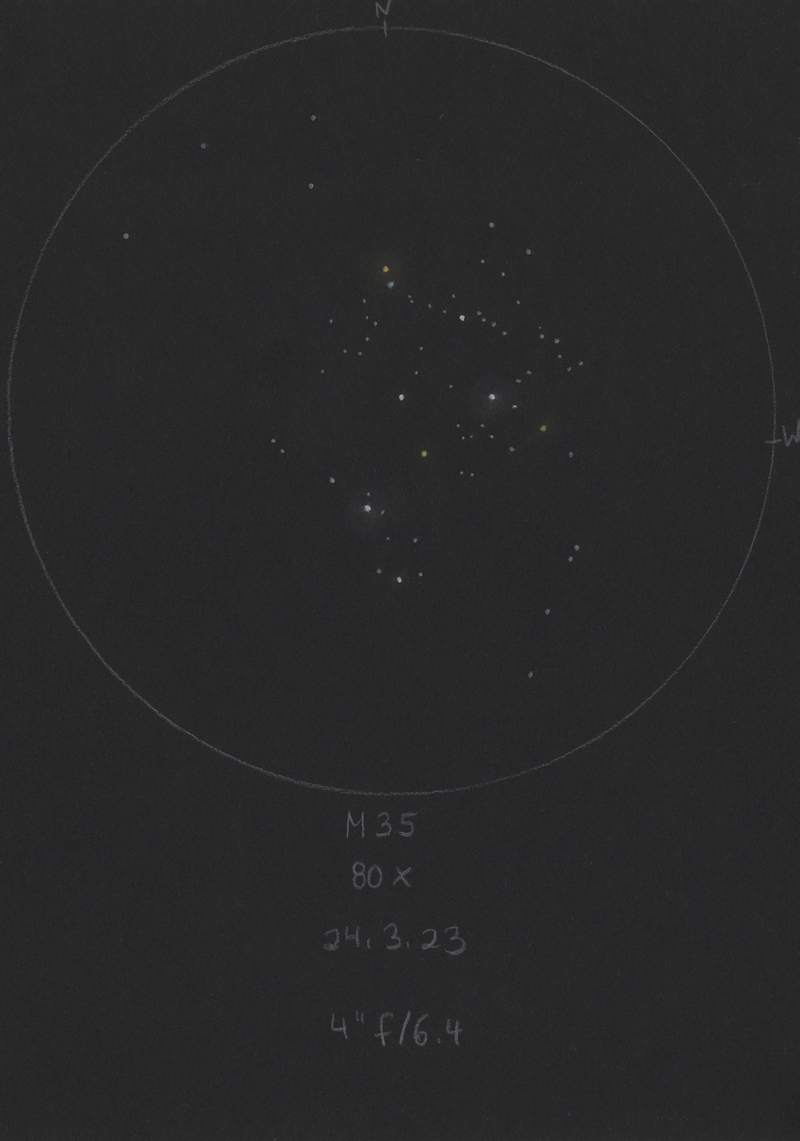
|
Uwe Pilz
Leipzig (Germany) |
120mm (360x) |
STT134 (AB): in M35 |
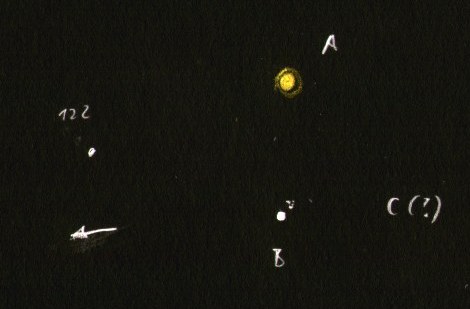
|
Robert Zebahl
Leipzig (Germany) |
152mm (92x) |
2022-02-27: At 30x the uneven pair AB appears widely separated. A shines in a glaring bright orange, B in the south appears slightly bluish. Then at 92x component D is also very faintly visible. All three components form an acute-angled, nearly isosceles triangle. Also at this magnification A appears bright orange, B gray-bluish. At 171x D still remains pretty faint. |
|
Sarah Gebauer
Germany |
254mm (96x) |
STT134 (AB): bei 96-fach zeigt sich die nördliche Komponente sehr schön orange, der Begleiter verliert seine Blaufärbung |
|
|
|
★
|
HO23 |
|
BC |
8m.0 |
11m.5 |
3.1" |
245° |
1991 |
Ori |
06h14m14.70s / +14°26'55.00" |
Mark McCarthy
Fremont (California/USA) |
508mm (333x) |
Excellent! BC is very delicate, very close to bright C, very faint and just appears with direct vision. Part of the widely separated S 509 AB |
|
|
|
★
|
STF883 |
|
AB |
9m.3 |
9m.7 |
3.5" |
265° |
2019 |
Aur |
06h19m08.03s / +39°46'28.70" |
Mark McCarthy
Fremont (California/USA) |
178mm (148x) |
Very fine 2+1 all nearly in a line. The two closest white stars are near equal, about 3" separated, nice. Physical |
|
|
|
★
|
AG323 |
|
AB |
9m.0 |
10m.2 |
1.8" |
49° |
2015 |
Gem |
06h19m45.23s / +22°06'38.80" |
Mark McCarthy
Fremont (California/USA) |
203mm (333x) |
Wow! pops with seeing, 1 delta mag, ~2". Very nice. Two other stars much fainter on the outer reaches likely part of system [these are AC and AD] |
|
|
|
★
|
STF900, epsilon Mon, 8 Mon |
|
AB |
4m.4 |
6m.6 |
12.2" |
29° |
2019 |
Mon |
06h23m46.10s / +04°35'34.20" |
Robert Zebahl
Leipzig (Germany) |
55mm (42x) |
Relatively large distance and clear difference in brightness. The lighter component seemed white-yellowish, the weaker one slightly greenish-blue. The color contrast, however, was not particularly conspicuous. |
|
Uwe Pilz
Leipzig (Germany) |
105mm (288x) |
Blau-rot |

|
Sarah Gebauer
Germany |
254mm (96x) |
ein ganz strahlendes Prachtexemplar, bei 96x schön getrennt, die Hauptkomponente im SW sehr reinweiß und strahlend, die schwächere im NO ebenfalls warmweiß, das Pärchen ziert den OS Dolidze 22 |

|
|
|
★
|
A2356 |
|
|
8m.9 |
9m.0 |
0.8" |
263° |
2016 |
Aur |
06h24m59.81s / +42°32'45.90" |
Mark McCarthy
Fremont (California/USA) |
178mm (410x) |
I can tell is double with 148x, it appears as a near equal notched elongation. The notch gets stronger with each magnification jump, until 410x when it hairline splits at the best moments and best focus |
|
|
|
★
|
SHJ70, 15 Gem |
|
AB |
6m.7 |
8m.2 |
24.7" |
202° |
2019 |
Gem |
06h27m46.58s / +20°47'22.60" |
|
|
|
|
AC |
6m.7 |
12m.7 |
85.6" |
35° |
2015 |
|
|
Robert Zebahl
Leipzig (Germany) |
16x70 |
AB: 2021-02-22: Clearly split with noticeable difference in brightness. Pale orange with much fainter companion. Together with Nu Gem & 16 Gem in a nice curved star chain. |
|
René Merting
Drachhausen (Germany) |
18x70 |
AB: ein schönes enges Sternpaar, Komponente B ist SW ist ordentlich getrennt von A zu erkennen - etwas über eine Größenklasse Helligkeitsunterschied, dadurch leichter Farbkontrast |
|
René Merting
Drachhausen (Germany) |
76mm (57x) |
AB: bei 29x ist ein gut getrenntes Sternpaar zu erkennen, bei dem B gut 1.5 Magnituden schwächer ist - schöner Farbkontrast, A wirkt gelbweiß, B blauweiß - bei 57x verstärkt sich der Farbkontrast, hellgelb und silbergrau |
|
Sarah Gebauer
Germany |
100mm (49x) |
AB: sehr leicht zu finden, deutlich getrennt, die nördliche, helle Komponente zeigt einen sehr schönen, warmen Farbton in Richtung kupferorange, B dagegen südwestlich davon erscheint beinahe grau |
|
Uwe Pilz
Leipzig (Germany) |
105mm (88x) |
AB: Auch bei 21x trennbar |

|
Mark McCarthy
Fremont (California/USA) |
317mm (553x) |
AB: Very pretty orange A, with a brown B, ~1.5 delta mag. |
|
|
|
★★★
|
beta Mon, 11 Mon |
STF919 |
AB |
4m.6 |
5m.0 |
7.2" |
133° |
2021 |
Mon |
06h28m49.07s / -07°01'59.00" |
|
|
|
STF919 |
AC |
4m.6 |
5m.4 |
9.7" |
125° |
2021 |
|
|
|
|
|
BU570 |
AD |
4m.6 |
12m.1 |
26.5" |
56° |
2014 |
|
|
|
|
|
STF919 |
BC |
5m.0 |
5m.3 |
2.6" |
112° |
2021 |
|
|
René Merting
Drachhausen (Germany) |
18x70 |
Conditions in the target region: SQM-L 20.5
das Mehrfachsystem ist als 8 erkennbar, eine extrem knappe Berührung, wobei die Komponenten B und C im SO nur als ein Stern gesehen werden können - BC ist gleich hell wie A allein |
|
René Merting
Drachhausen (Germany) |
76mm (29x) |
Conditions in the target region: SQM-L 20.2
A-BC: bei 29x ein heller, knapp getrennter Doppelstern - BC im SO wirkt etwas heller als A
BC: bei 95x zeigen sich BC wie eine Ameise, noch berühren sich beide - bei 127x dann in ruhigen Momenten gelingt dir Trennung - sie haben fast den gleichen Positionswinkel wie A-BC - beide Komponenten B und C sind gleich hell und einzeln betrachtet jeweils etwa mehr als eine halbe Größenklasse schwächer als A |
|
René Merting
Drachhausen (Germany) |
100mm (32x) |
Conditions in the target region: SQM-L 20.5
A-BC: bei 32x ein wunderschöner eng stehender Doppelstern - die bei dieser Vergrößerung noch nicht trennbare Komponenten B und C im SO wirken leicht gelblich und ist leicht heller als A - die Komponenten A und BC wollen sich berühren, schaffen es aber nicht ;-)
BC: bei 64x wirkt BC leicht länglich wie ein Stäbchen - bei 107x dann der Aha-Effekt, es sind zwei Sterne, knapp getrennt und mit gleichem Positionswinkel wie A-BC - beide Komponenten B und C sind gleich hell und einzeln jeweils etwa eine halbe Größenklasse schwächer als A im NW |
|
Uwe Pilz
Leipzig (Germany) |
105mm (137x) |
Dreifachsystem, drei fast gleichhelle Sterne. Alle blau-weiß |
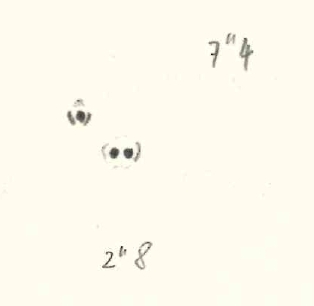
|
Sarah Gebauer
Germany |
254mm (96x) |
STF919 (AB): ein wirklich toller DS, zwei ganz schmale, leuchtstarke Pünktchen |
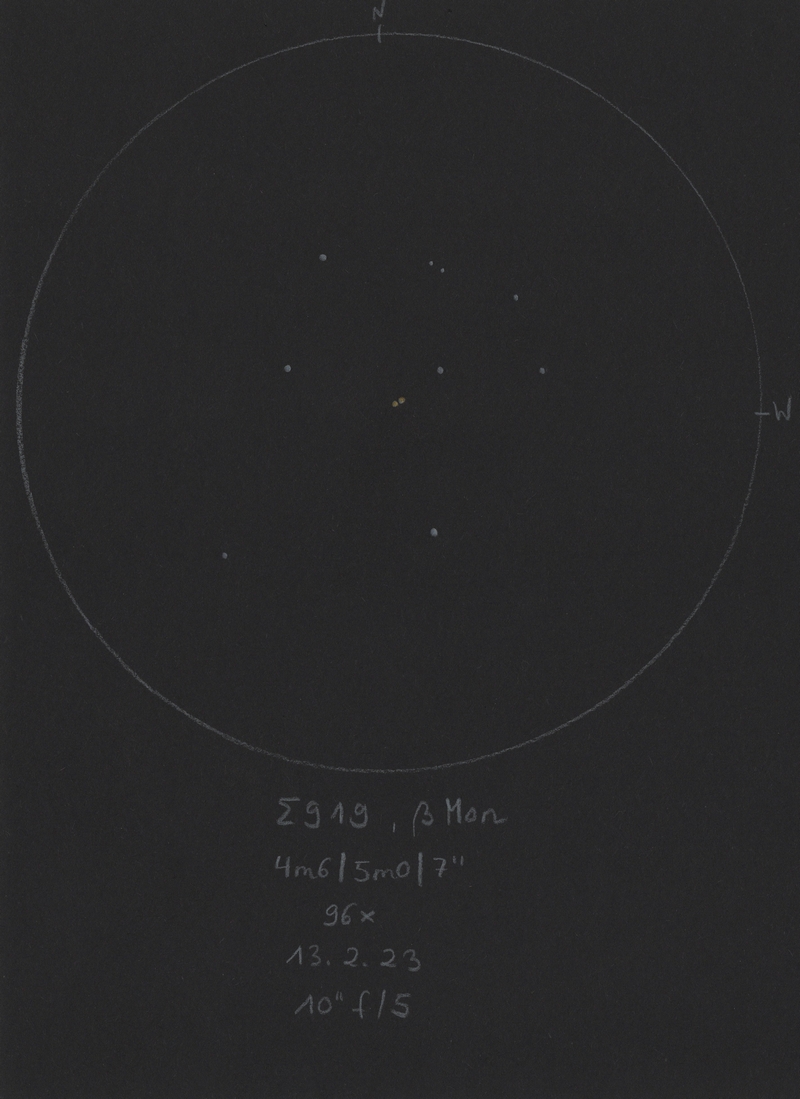
|
|
|
★
|
STF905 |
|
AB |
8m.2 |
9m.9 |
1.7" |
130° |
2016 |
Aur |
06h28m53.76s / +40°07'11.10" |
Mark McCarthy
Fremont (California/USA) |
178mm (148x) |
Excellent, superfine pair, 2 delta mag and 2" sep |
|
|
|
★
|
STTA77, nu Gem, 18 Gem |
|
AB |
4m.1 |
8m.0 |
112.8" |
330° |
2017 |
Gem |
06h28m57.79s / +20°12'43.80" |
Christopher Hay
Seeheim (Germany) |
15x45 |
Binoculars with internal stabilisation, handheld. AB are wide apart. Large brightness difference. A pure white, B possibly slightly blue.
A physical double at a distance to us of 545 light years. |
|
Axel Tute
Küssaberg (Germany) |
200mm (77x) |
13.03.2007: Very easy in the C8 with the 26mm Plössl. A is greenish, B is blue-greenish. The PA was estimated at 290°. |
|
|
|
★
|
STF921 |
|
|
6m.1 |
9m.1 |
16.2" |
3° |
2019 |
Mon |
06h31m09.56s / +11°15'05.00" |
Sarah Gebauer
Germany |
254mm (42x) |
die hellere Komponente strahlt im Süden, die schwächere, beinahe blaugraue im Norden mit einem ganz deutlichen Helligkeitsunterschied; bei 42x sind sie bereits haarscharf und fein getrennt und stehen dann zusammen mit den drei hellen Sternen nordöstlich zusammen im Bild |
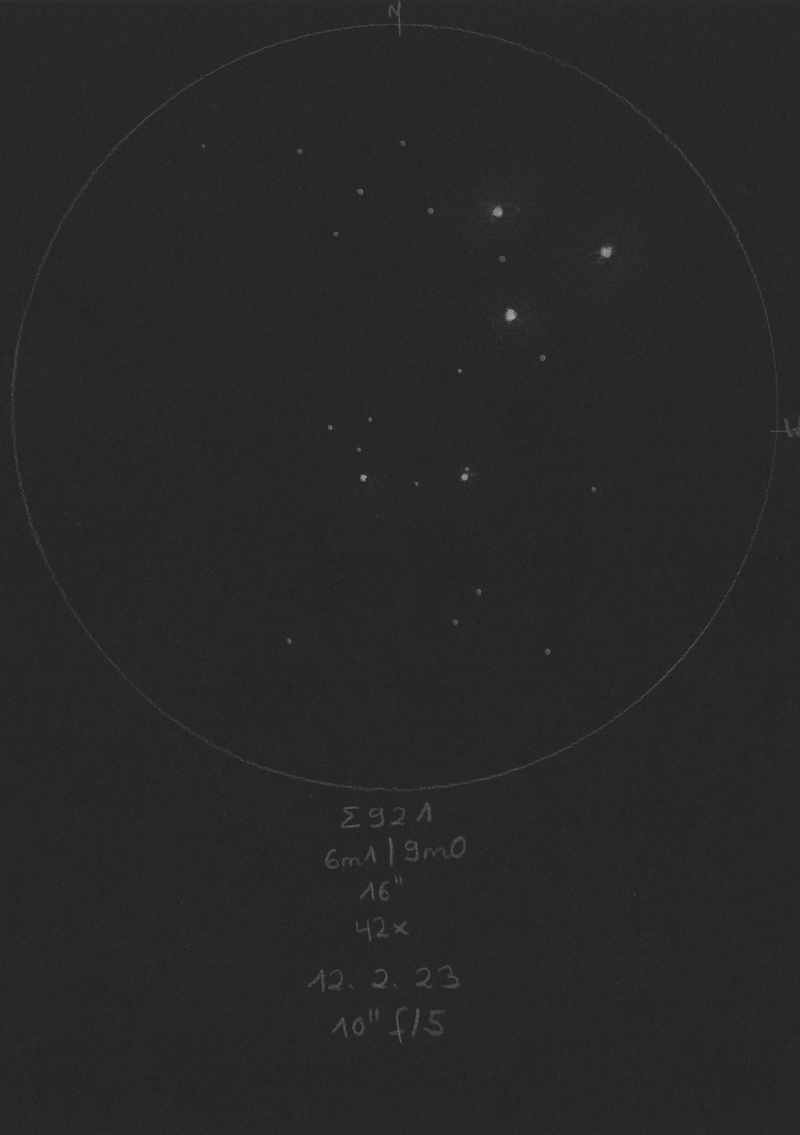
|
|
|
★
|
FAB5 & STF926 |
FAB5 |
Aa-Ab |
7m.2 |
9m.6 |
0.9" |
18° |
1991 |
Mon |
06h31m40.54s / +05°46'08.80" |
|
|
|
STF926 |
AB |
7m.2 |
8m.6 |
10.8" |
287° |
2017 |
|
|
Mark McCarthy
Fremont (California/USA) |
317mm (170x) |
STF926 (AB): In a triangle of stars which points toward the Rosette Nebula. Blue-white A star and slightly red B, 1 delta mag, wide. The A star is FAB 5 |
|
Mark McCarthy
Fremont (California/USA) |
317mm (553x) |
FAB5 (Aa-Ab): Misshapen disk at best moments, very difficult |
|
|
|
★★
|
STF924, 20 Gem |
|
AB |
6m.3 |
6m.9 |
19.9" |
211° |
2019 |
Gem |
06h32m18.52s / +17°47'03.40" |
|
|
|
|
BC |
6m.9 |
13m.0 |
47.8" |
144° |
2014 |
|
|
Robert Zebahl
Leipzig (Germany) |
16x70 |
AB: 2021-02-22: Easy to separate with small difference in brightness. Conspicuous double star. White-yellowish & white-bluish. |
|
René Merting
Drachhausen (Germany) |
18x70 |
AB: das dicht stehende Paar fällt sofort ins Auge - Komponente A im Norden ist vielleicht eine halbe Magnitude heller als Komponente B, die leicht gräulich strahlt |
|
Robert Zebahl
Leipzig (Germany) |
70mm (22x) |
AB: At 22x bright, immediately conspicuous, although in a relatively star-rich surrounding. Moderate but beautiful color contrast: bright orange, subtle blue. Also at 44x very beautiful sight. |
|
René Merting
Drachhausen (Germany) |
76mm (29x) |
AB: bei 29x ein Paar mit auffälligem Farbkontrast - Komponente B steht ordentlich abgesetzt südlich von A und wirkt silbrig bis blaugrau gegen die gelbweiße A-Komponente im Norden |
|
Sarah Gebauer
Germany |
100mm (49x) |
AB: die beiden Sternen im Norden und Südwesten sind fast gleich hell, deutlich getrennt, die nördliche Komponente empfinde ich leicht gelb, die südwestliche macht eher einen weißen Eindruck |
|
Robert Zebahl
Leipzig (Germany) |
152mm (69x) |
AB: Easy, bright, moderately uneven. Nice contrast in color: slight orange, white-bluish. |
|
Axel Tute
Küssaberg (Germany) |
200mm (77x) |
AB: 14.03.2006; Single pair. No colours observed. Estimated PA 190°. |
|
|
|
★★
|
STT147 |
|
A-CD |
6m.8 |
9m.8 |
44.5" |
119° |
2016 |
Aur |
06h34m19.37s / +38°04'33.60" |
|
|
|
|
AB |
6m.8 |
8m.7 |
42.7" |
74° |
2016 |
|
|
|
|
|
|
CD |
10m.6 |
11m.0 |
0.5" |
109° |
1957 |
|
|
Uwe Pilz
Leipzig (Germany) |
105mm (200x) |
|
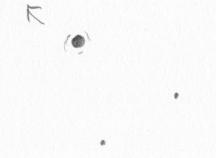
|
Robert Zebahl
Leipzig (Germany) |
152mm (69x) |
At 22x, the components A, B and CD are immediately conspicuous, where A dominates. They form a beautiful, acute-angled triangle. At 69x, color differences are also visible. A: subtle orange; B: grey-bluish; CD: tendency to orange. Rewarding, because the double stars STF 928 & STF 929 as well as the very conspicuous carbon star UU Aur are in close proximity and can partly be observed together in one field of view! |
|
|
|
★★
|
STF928 |
|
AB |
7m.9 |
8m.6 |
3.4" |
131° |
2019 |
Aur |
06h34m41.81s / +38°32'24.50" |
|
|
|
|
AC |
7m.9 |
12m.4 |
130.9" |
124° |
2002 |
|
|
|
|
|
|
BC |
8m.6 |
12m.4 |
127.3" |
124° |
2015 |
|
|
Robert Zebahl
Leipzig (Germany) |
102mm (62x) |
AB: At 28x the double star already appeared elongated, at 62x beautifully separated, with component A shining in a warm, subtle orange. At 125x A appeared orange, B grey-bluish. |
|
Uwe Pilz
Leipzig (Germany) |
105mm (200x) |
AB: kühl-weiß und lila |
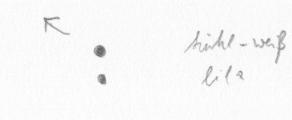
|
Robert Zebahl
Leipzig (Germany) |
152mm (69x) |
AB: Clearly separated, but tight. Moderate difference in brightness. Nice view with the nearby double stars STT147 & STF 929 and the carbon star UU Aur! |
|
Mark McCarthy
Fremont (California/USA) |
178mm (148x) |
AB: Classic Struve, very lightly yellow-white stars, about 1 delta, well separated |
|
|
|
★
|
STF929 |
|
|
7m.3 |
8m.4 |
6.5" |
24° |
2016 |
Aur |
06h35m22.03s / +37°42'55.10" |
Robert Zebahl
Leipzig (Germany) |
152mm (69x) |
Easy to separate, clear difference in brightness, slight color contrast. Primary component showed a slight orange color, the color of the companion was not clearly defineable. Nice view with the nearby double stars STT147 & STF 928 and the carbon star UU Aur! |
|
|
|
★
|
BU194 |
|
|
8m.6 |
8m.9 |
1.6" |
278° |
2019 |
Aur |
06h36m17.41s / +37°59'31.40" |
Mark McCarthy
Fremont (California/USA) |
178mm (148x) |
Very fine pair of near equal light orange stars, 1" separation very good |
|
|
|
★
|
SHJ73, nu 1 CMa |
|
|
5m.8 |
7m.4 |
17.4" |
264° |
2019 |
CMa |
06h36m22.85s / -18°39'35.60" |
Christopher Hay
Seeheim (Germany) |
10x56 |
On tripod. Finely split. Attractive 6.3° field of view together with Nu2 and Nu3.
A physical double at a distance to us of 351 light years. |
|
Uwe Pilz
Leipzig (Germany) |
105mm (88x) |
|
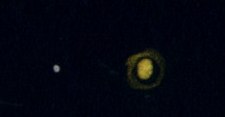
|
|
|
★
|
S529 |
|
AB |
6m.9 |
9m.3 |
52.7" |
129° |
2019 |
Gem |
06h37m33.90s / +12°10'50.00" |
|
|
|
|
AC |
6m.9 |
8m.1 |
143.5" |
165° |
2012 |
|
|
René Merting
Drachhausen (Germany) |
18x70 |
AB: ein weit getrenntes Sternpaar - Komponente B im SO ist kupferbraun, die gut 2 bis 2.5 Größenklassen hellere Komponente A strahlt weiß |
|
Sarah Gebauer
Germany |
254mm (96x) |
der nördlichste der drei Sterne strahlt besonders hell, südwestlich darunter befindet sich ein besonders schwacher Begleiter und direkt südlich darunter mit gut doppeltem Abstand strahlt nochmal ein etwas hellerer Stern |
|
|
|
★
|
STF941 |
|
AB |
7m.2 |
8m.2 |
2.0" |
83° |
2019 |
Aur |
06h38m40.76s / +41°34'53.40" |
|
|
|
|
AC |
7m.2 |
10m.5 |
83.9" |
135° |
2015 |
|
|
Robert Zebahl
Leipzig (Germany) |
102mm (28x) |
AC: Distant, faint companion that is less attracting attention. Used magnifications between 28x and 125x. |
|
Robert Zebahl
Leipzig (Germany) |
102mm (86x) |
AB: At 62x only visible as figure '8'. The difference in brightness is hardly noticeable. At 86x barely separated, obvious. Clearly separated at 125x, but still tight with a moderate brightness difference. |
|
Mark McCarthy
Fremont (California/USA) |
178mm (148x) |
AB: Wow, great pair. White A and light blue B, >1 delta mag and about 2", such a fine pair |
|
|
|
★★
|
STF946 |
|
|
7m.3 |
9m.1 |
4.0" |
129° |
2019 |
Lyn |
06h44m51.62s / +59°26'57.40" |
Robert Zebahl
Leipzig (Germany) |
102mm (86x) |
Easy to split with noticeable difference in brightness. Very nice view together with the triple system STF 948 in one field of view! |
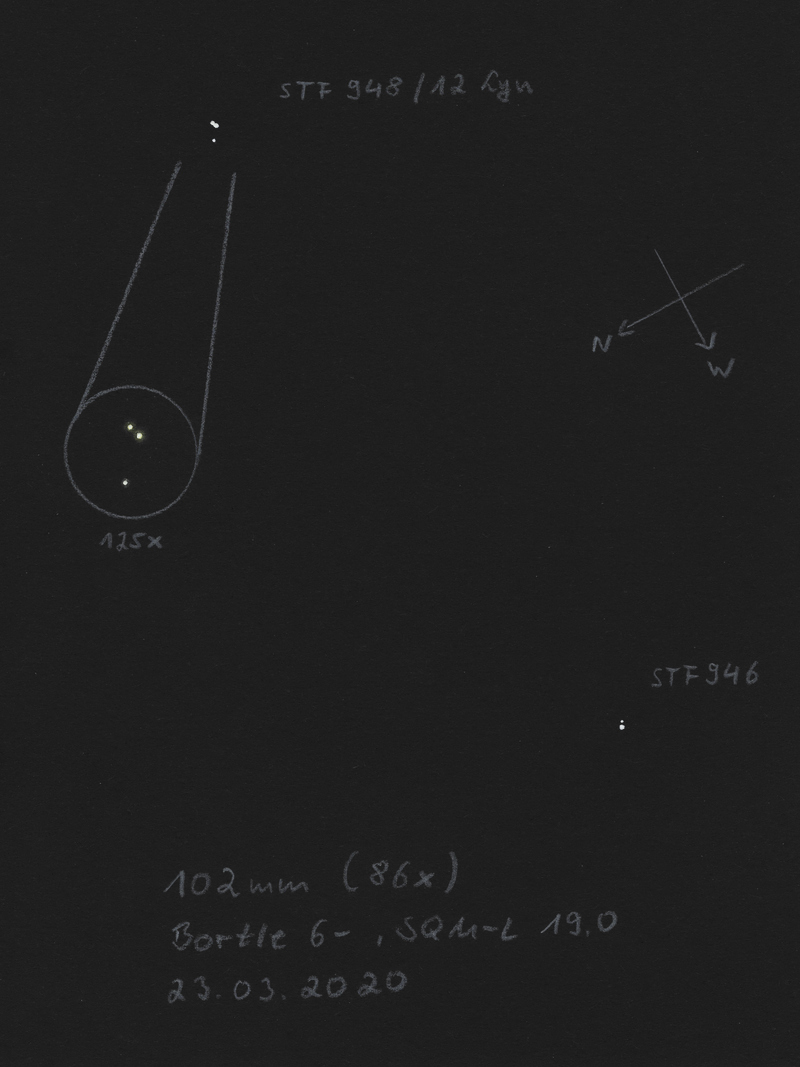
|
Uwe Pilz
Leipzig (Germany) |
105mm (88x) |
im selben Feld mit 12 Lyn |
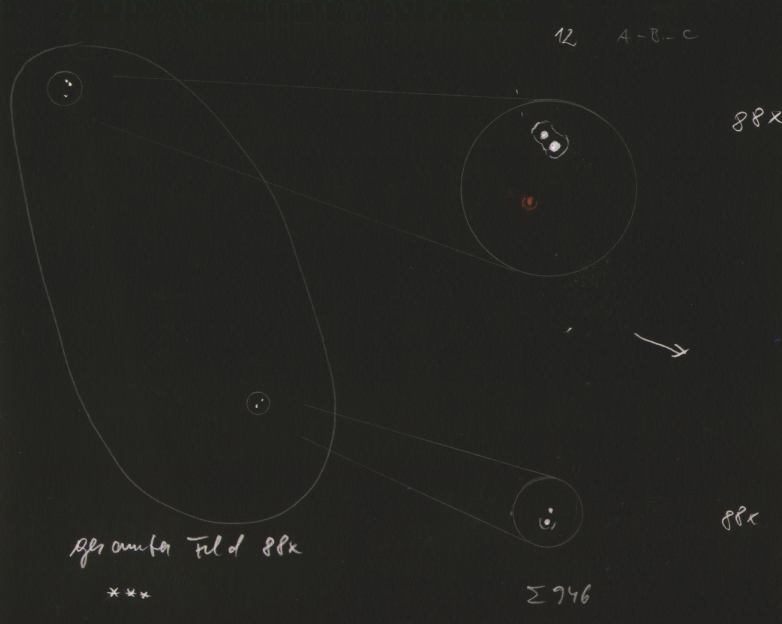
|
Robert Zebahl
Leipzig (Germany) |
152mm (100x) |
At 100x and 129x easy to separate, quite uneven. Primary component appeared yellowish, the fainter one rather greyish. Fantastic view together with 12 Lyn (STF 948) in one field of view! |
|
|
|
★★★
|
AGC1, 9 CMa, alpha CMa, Sirius |
|
AB |
-1m.5 |
8m.4 |
11.3" |
67° |
2021 |
CMa |
06h45m08.92s / -16°42'58.00" |
|
|
Robert Zebahl
Leipzig (Germany) |
102mm (86x) |
2023-02-14: In a steady phase, the companion is clearly visible within the halo of the primary component, but very faint. |
|
Uwe Pilz
Leipzig (Germany) |
105mm (198x) |
mit ADV, ohne nicht trennbar. Eindeutig |
|
Robert Zebahl
Leipzig (Germany) |
120mm (150x) |
2021-03-02: Used magnifications from 86x to 200x using a Baader yellow filter. The diffraction disk was relatively good visible, but the diffraction rings were noticeably in movement (Seeing 3/5). |
|
Jörg S. Schlimmer
Germany |
127mm (136x) |
not split |
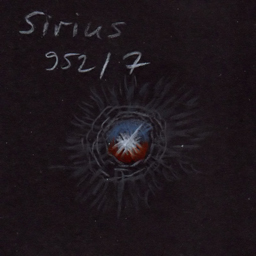
|
Mark McCarthy
Fremont (California/USA) |
203mm (368x) |
Small disk formed on diffraction spike at correct separation and PA (Feb. 2016) |
|
Mark McCarthy
Fremont (California/USA) |
317mm (443x) |
A faint yellow-orange disk, to the edge of Sirius A's diffraction and just below my spider's diffraction spike. I let Sirius pass beyond the field stop, and for an instant there was Sirius B, clearly separated, before it too passed beyond the field stop. |
|
|
Jörg S. Schlimmer
Germany |
305mm |
hard to split with CMOS Camera |

|
|
|
★
|
A2680 |
|
|
9m.6 |
9m.7 |
1.5" |
159° |
2016 |
Mon |
06h45m51.88s / +03°24'01.30" |
Mark McCarthy
Fremont (California/USA) |
178mm (205x) |
Nice! Very fine, with seeing, close less than 2", around 1 delta mag, light orange A and white B. A really fine pair |
|
|
|
★
|
COU472 |
|
|
11m.4 |
11m.3 |
1.9" |
83° |
2016 |
Gem |
06h46m07.21s / +22°33'06.80" |
Mark McCarthy
Fremont (California/USA) |
508mm (333x) |
Faint but very fine pair, really pretty in the field, a little blue, half delta mag, ~1.5" Nice |
|
|
|
★★★
|
STF948, 12 Lyn |
|
AB |
5m.4 |
6m.0 |
1.9" |
65° |
2020 |
Lyn |
06h46m14.15s / +59°26'30.10" |
|
|
|
|
AC |
5m.4 |
7m.0 |
8.9" |
309° |
2019 |
|
|
|
|
Robert Zebahl
Leipzig (Germany) |
55mm (27x) |
AC: Components A/B and C well separated, but tight. Significant difference in brightness. The fainter C companion appeared slightly orange, the brighter one white-bluish. |
|
Robert Zebahl
Leipzig (Germany) |
55mm (167x) |
AB: Components A and B separated, whereby the Airy disks slightly overlap. The difference in brightness was well visible. |

|
Robert Zebahl
Leipzig (Germany) |
63mm (140x) |
AB: Components A and B split with almost no space in between. The difference in brightness was visible. |
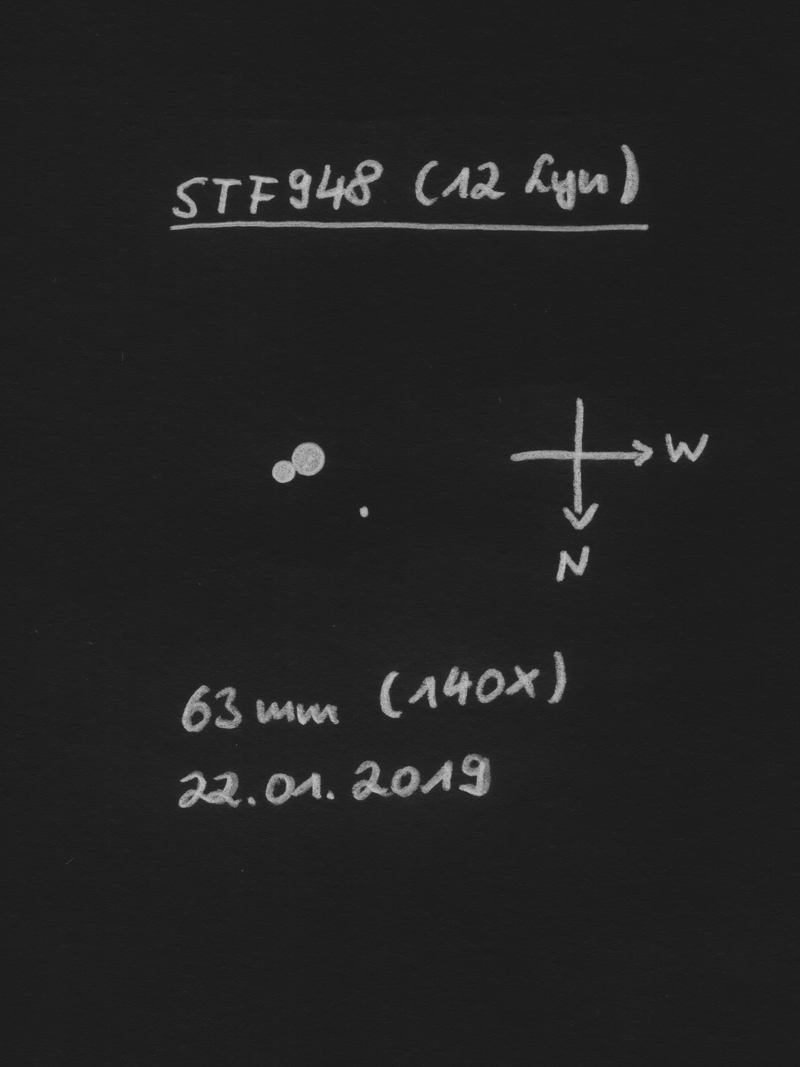
|
Robert Zebahl
Leipzig (Germany) |
70mm (22x) |
AC: Well split, relatively close together with significant difference in brightness. |
|
Robert Zebahl
Leipzig (Germany) |
70mm (133x) |
AB: Both components A + B clearly split, whereby the diffraction rings where merged together. A very nice view together with component C. I sketched this triplet, which reflects my impression well. Unfortunately, the distance and position angle are not particularly well observed. Also the difference in brightness I didn't noticed during my observation. |
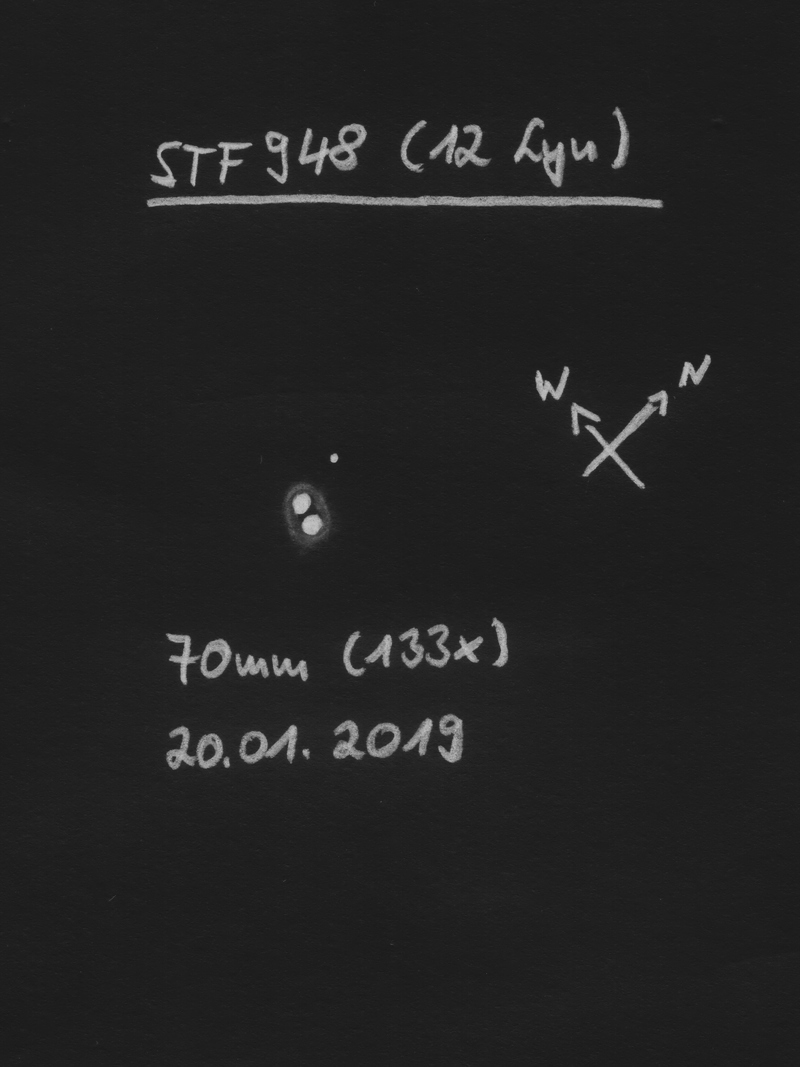
|
Robert Zebahl
Leipzig (Germany) |
102mm (129x) |
At 28x the pair AC is nicely separated without any problems. The close pair AB is already recognizable at 86x as a clear figure '8', at 125x wonderfully separated. The components A & B appear yellowish. Very nice view together with STF 946 in one field of view! |

|
Uwe Pilz
Leipzig (Germany) |
105mm (88x) |
im selben Feld mit STF 946 |

|
Robert Zebahl
Leipzig (Germany) |
152mm (129x) |
At 49x the pair AC is beautifully separated with a significant difference in brightness. At 100x, the close pair AB is also separated, although still very close together. A slight difference in brightness is noticeable. At 129x, the view is magnificent. The two bright components A & B present themselves yellowish, the fainter component C rather greyish. STF 948 can be well observed in a field of view with the neighbouring double star STF 946. Both show a nice overall scenery. |
|
Mark McCarthy
Fremont (California/USA) |
178mm (148x) |
AB: Gorgeous triple star, pale yellow A and B, and 1 delta blue C. really stunning. AB physical with a 733-year period |
|
|
|
★
|
HO238 |
|
|
8m.9 |
9m.1 |
0.3" |
174° |
2013 |
Gem |
06h46m20.91s / +18°12'08.20" |
Mark McCarthy
Fremont (California/USA) |
508mm (1067x) |
Barely hairline split at best moments, but conditions have a lot of haze and bloating. A half delta mag is noticeable. I can tell the star is a pair at 333x, but no where near resolvable |
|
|
|
★
|
STF958 |
|
AB |
6m.3 |
6m.3 |
4.5" |
77° |
2021 |
Lyn |
06h48m12.29s / +55°42'15.10" |
|
|
Robert Zebahl
Leipzig (Germany) |
70mm (33x) |
Clearly split, equally bright, close together. Nice view. |
|
Robert Zebahl
Leipzig (Germany) |
102mm (62x) |
Very nicely split. Both components appear similarly bright and white-yellowish. |
|
Mark McCarthy
Fremont (California/USA) |
178mm (148x) |
Near equal dull white typical Struve. Not much to look at but it's physical with a 2023 year period, with not much movement now but will whip around the A star pretty quickly when it reaches periastron 150 years from now |
|
|
|
★
|
STF964 |
|
|
8m.9 |
9m.7 |
1.6" |
183° |
2019 |
Aur |
06h50m21.58s / +43°45'15.20" |
Mark McCarthy
Fremont (California/USA) |
178mm (148x) |
Exceptionally fine at this magnification. The pair is in one corner of an equilateral triangle of near same magnitude stars. B is half delta mag and very close about 2". Very nice |
|
|
|
★
|
H5 108 |
|
A-BC |
5m.8 |
7m.7 |
42.7" |
66° |
2015 |
CMa |
06h50m23.34s / -31°42'21.80" |
Christopher Hay
Seeheim (Germany) |
10x56 |
On tripod. A-BC wide apart. Only 3° above my horizon shortly after meridian passage. A pulsates mysteriously in the flat air, while Kappa CMa 1° to the south, at the southern fringe of the constellation, pulsates equally mysteriously in a slightly shifted tact.
H5 108 is a physical double at a distance to us of 650 light years. |
|
|
|
★★
|
STF985 |
|
|
7m.8 |
8m.4 |
32.6" |
323° |
2017 |
Mon |
06h53m56.06s / -04°23'32.80" |
René Merting
Drachhausen (Germany) |
18x70 |
leicht (bequem getrennt) und schön mit Farbkontrast - Komponente A im Südwesten ist leicht gelblich, B wirkt dagegen grau - ein paar schwächere Sterne im Umfeld sorgen dafür, dass der Doppelstern noch etwas mehr hervor gehoben erscheint |
|
René Merting
Drachhausen (Germany) |
100mm (20x) |
bei 32x ein weite Trennung - ein schöner Farbkontrast, Komponente A südöstlich ist weißgelb, B im NW dagegen ist zartorange - zurück auf 20x ordentliche Trennung |
|
Sarah Gebauer
Germany |
100mm (21x) |
schon in Aufsuchvergrößerung getrennt und direkt mit warmrotem Farbeindruck zu sehen - die südöstliche Komponente ist einen Hauch kupferfarbener - bei 49-fach ist die Trennung schon sehr weit und der Farbeindruck schwächer, obwohl nach wie vor warm ins Rotorange gehende - zwei roségoldene Steckerchen, sehr schön |
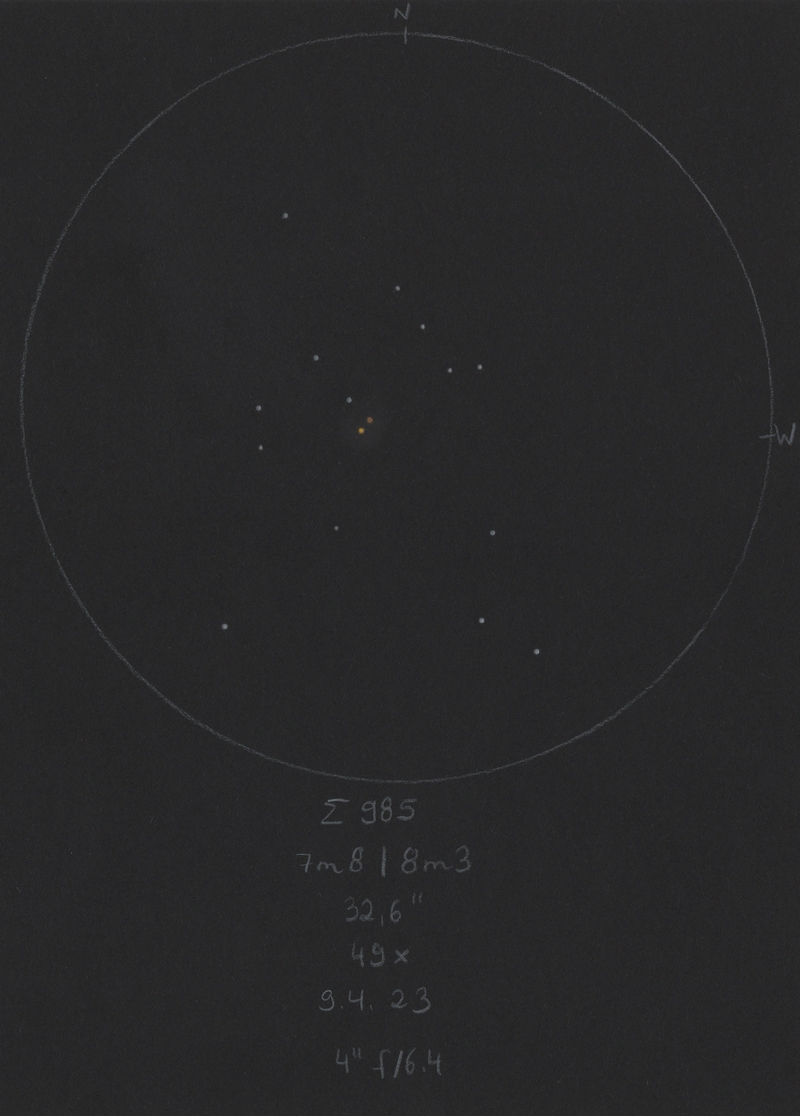
|
|
|
★
|
STF982, 38 Gem |
|
AB |
4m.8 |
7m.8 |
7.3" |
145° |
2018 |
Gem |
06h54m38.63s / +13°10'40.10" |
|
|
Robert Zebahl
Leipzig (Germany) |
55mm (27x) |
At 27x pretty tight with much fainter component. At 71x clearly separated with clear difference in brightness. Brighter component appeared slightly yellowish, the weaker one slightly bluish. |
|
Robert Zebahl
Leipzig (Germany) |
70mm (33x) |
Easy to separated with noticeable difference in brightness. The fainter component appeared slightly orange, the brighter one rather white. |
|
René Merting
Drachhausen (Germany) |
76mm (29x) |
AB: bei 29x ist die B-Komponente im Südosten von A angedeutet erkennbar - bei 57x dann ist die Trennung etwas mehr als knapp - B wirkt bräunlich gegen die buttergelb strahlende A-Komponente - ein schön enges, ungleiches Pärchen
AC: bei 57x ist C schwach und weit abgesetzt westlich von A zu erkennen - C liegt außerhalb des relativ großen Halos von A |
|
Sarah Gebauer
Germany |
100mm (49x) |
das Doppel ist freiäugig trotz aufgehellten Himmels sehr gut als ein Stern zu sehen, die B-Komponente ist bei 49x sichtbar getrennt, deutlich schwächer und versteckt sich beinahe hinter der A-Komponente, diese erscheint sehr warmweiß im Farbton |
|
Uwe Pilz
Leipzig (Germany) |
105mm (92x) |
|

|
Uwe Pilz
Leipzig (Germany) |
105mm (130x) |
recht attraktiv |
|
Mark McCarthy
Fremont (California/USA) |
203mm (333x) |
38 Gem. Light yellow A and blue B, quite wide, very pretty. AC much wider separation much fainter not noticed |
|
Mark McCarthy
Fremont (California/USA) |
317mm (553x) |
Bright orange and slightly red star, 2-3 delta mag. |
|
Mark McCarthy
Fremont (California/USA) |
317mm (553x) |
Pretty yellow and orange, 2 delta mag, wide separation |
|
|
|
★
|
A2459 |
|
AB |
9m.8 |
9m.8 |
0.4" |
270° |
2014 |
Gem |
06h57m39.64s / +19°35'04.10" |
Mark McCarthy
Fremont (California/USA) |
508mm (1067x) |
Notched near equal at best moments |
|
|
|
★★
|
STTA80 |
|
AB |
7m.2 |
7m.4 |
124.1" |
53° |
2015 |
Gem |
06h58m06.59s / +14°13'43.40" |
|
|
|
|
AC |
7m.2 |
8m.4 |
81.2" |
112° |
2015 |
|
|
Christopher Hay
Seeheim (Germany) |
7x45 |
Handheld. AB are a well separated, matching pair. Immediately striking in field. |
|
Christopher Hay
Seeheim (Germany) |
15x45 |
Binoculars with internal stabilisation, handheld. AB are a widely separated pair, and joined by a third, weaker, point of light, which is C, well separated. A charming little triangle.
Involved in (or making up?) Monti 4 asterism. |
|
Robert Zebahl
Leipzig (Germany) |
70mm (22x) |
All 3 components form a striking triangle and are slightly different in color. A (western component): white-bluish; B (northern component): white-yellowish; C (southern component): orange, partly slightly reddish. |

|
|
|
★
|
CPO7, eps CMa |
|
|
1m.5 |
7m.5 |
7.9" |
162° |
2008 |
CMa |
06h58m37.55s / -28°58'19.50" |
Mark McCarthy
Fremont (California/USA) |
203mm (113x) |
Adhara, epsilon Canis Majoris: Wow! Bright (+1.5 magnitude) and large A with small and much fainter close B (magnitude +7.5) to the south. Lovely double |
|
|
|
★★
|
STF1007 |
|
AB |
7m.4 |
11m.4 |
14.6" |
300° |
2015 |
Gem |
07h00m37.12s / +12°43'24.20" |
|
|
|
|
AC |
7m.4 |
10m.0 |
21.9" |
244° |
2015 |
|
|
|
|
|
|
AD |
7m.4 |
7m.7 |
67.7" |
28° |
2016 |
|
|
Christopher Hay
Seeheim (Germany) |
7x45 |
AD: Handheld. Stands out immediately as double with clear PA in field of several similarly bright single stars. Unsupported, hand tremor prevents actually seeing each component singly, but by bracing arms in reclining chair the well-matched pair is clearly split.
A physical double at a distance to us of 914 light years. |
|
Christopher Hay
Seeheim (Germany) |
15x45 |
Binoculars with internal stabilisation, handheld. AD well split. A is distinctly brighter and seems bluish. Nice in 4.5° FOV together with STTA80 ABC. |
|
Robert Zebahl
Leipzig (Germany) |
70mm (22x) |
AD: Wide separation, small difference in brightness. Slight difference in color, but difficult to describe. Component A at least seemed rather white. South of STF1007 there is also the double star HJ3288 and the star HD52976, which appears in a bright orange. Together in one field of view a beautiful sight. |

|
|
|
★★
|
BU100 |
|
|
7m.3 |
11m.1 |
3.4" |
259° |
2016 |
Gem |
07h00m56.55s / +12°24'00.40" |
Mark McCarthy
Fremont (California/USA) |
317mm (553x) |
Pretty orange and blue. 4 delta mag, PA to west. Wide separation ~3" B is just seen, a very fine point. |
|
|
|
★
|
ARN66 |
|
AF |
6m.6 |
8m.3 |
172.0" |
301° |
2011 |
Gem |
07h01m17.01s / +32°24'52.40" |
Christopher Hay
Seeheim (Germany) |
7x45 |
Handheld. AF is an immediately striking wide pair. Viewed comfortably in 8.6° FOV together with very wide Rho Gem, a further physical pair.
Arnold 66 AF is a physical double at a distance to us of 462 light years. |
|
|
|
★
|
HJ3288 |
|
|
7m.3 |
8m.7 |
38.5" |
247° |
2015 |
Gem |
07h02m18.43s / +12°34'54.20" |
Robert Zebahl
Leipzig (Germany) |
70mm (22x) |
Easy to separate with moderate angular distance and a significant difference in brightness. Slight difference in color: white-yellowish, slightly orange. Nice view together with the double star STF1007 and HD52976, which appears in a bright orange. Sketched together with STF1007. |

|
|
|
★
|
A2462 |
|
AB |
9m.2 |
9m.0 |
0.2" |
246° |
2020 |
Gem |
07h02m37.42s / +15°58'26.50" |
|
|
Mark McCarthy
Fremont (California/USA) |
508mm (1067x) |
Short period list. Notched, noticeable magnitude difference, B star pointed in direction of apex of right triangle it forms with two other eighth magnitude stars. Light orange stars |
|
|
|
★
|
HO342 |
|
|
8m.0 |
8m.7 |
1.2" |
89° |
2016 |
Gem |
07h02m50.54s / +13°05'21.70" |
Mark McCarthy
Fremont (California/USA) |
317mm (553x) |
Yellow-orange and blue stars, PA to the east, 1 delta mag, tight but well split ~1". |
|
|
|
★★
|
STF1001 |
|
AB |
7m.8 |
9m.4 |
9.1" |
66° |
2019 |
Lyn |
07h03m05.51s / +54°10'26.60" |
|
|
|
|
AC |
7m.8 |
9m.3 |
9.9" |
58° |
2019 |
|
|
|
|
|
|
BC |
9m.4 |
9m.3 |
1.6" |
5° |
2019 |
|
|
Robert Zebahl
Leipzig (Germany) |
102mm (160x) |
2020-03-23: At 28x the pair A-BC is easy to separate. At 160x, the very close pair BC shows split. The component A appears slightly orange. |
|
Uwe Pilz
Leipzig (Germany) |
105mm (88x) |
|

|
Robert Zebahl
Leipzig (Germany) |
152mm (129x) |
2020-03-23: At 22x, the wide pair A-BC already appears separated, but still very tight. At 69x, A appears in a subtle orange. The pair BC shows elongated and rather greenish-bluish. At 100x BC is already visible as figure '8' and almost separated, at 129x clearly separated. Components B and C are still very close together and equally bright. The color impression remains. An interesting and rewarding triple system! |
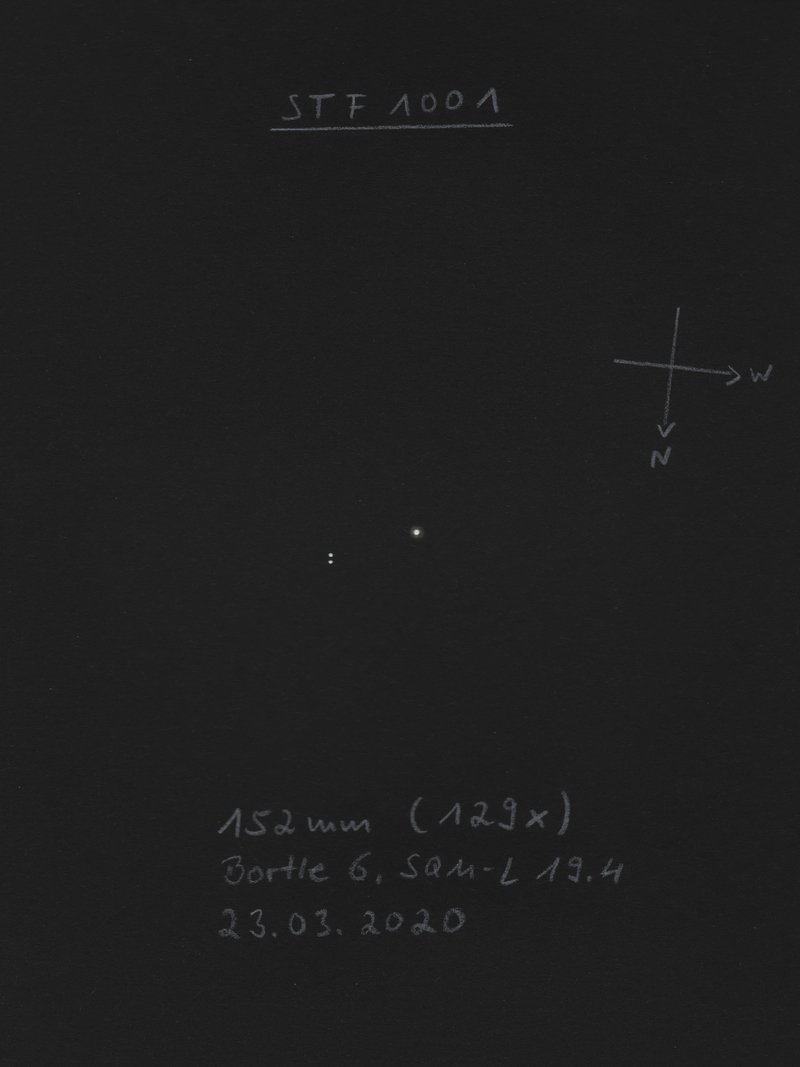
|
Mark McCarthy
Fremont (California/USA) |
178mm (222x) |
BC: Wow excellent 2+1, with a brighter white A and BC is a near equal faint pair about 1" separation. Seen with 148x but better resolved with 222x |
|
|
|
★
|
SHJ77, zeta Gem, 43 Gem, Mekbuda |
|
AB |
4m.0 |
11m.5 |
87.3" |
85° |
2017 |
Gem |
07h04m06.54s / +20°34'13.10" |
|
|
|
|
AC |
4m.0 |
7m.7 |
101.5" |
347° |
2017 |
|
|
|
|
|
|
AD |
4m.0 |
12m.5 |
67.0" |
355° |
2017 |
|
|
Christopher Hay
Seeheim (Germany) |
15x45 |
AC: Binoculars with internal stabilisation, handheld. AC are wide apart and a visually strong (though not physical) pair. |
|
|
|
★★
|
STF1014 |
|
|
9m.9 |
9m.9 |
2.0" |
220° |
2017 |
Gem |
07h05m44.95s / +26°08'25.30" |
Mark McCarthy
Fremont (California/USA) |
203mm (205x) |
Faint pair, noticeable magnitude difference, white, well separated |
|
Mark McCarthy
Fremont (California/USA) |
317mm (553x) |
Very faint near equal brightness pair, ~3", PS to the SW. |
|
|
|
★★★
|
ENG28 |
|
AB |
7m.9 |
7m.7 |
171.9" |
99° |
2015 |
Gem |
07h08m00.24s / +15°31'42.90" |
Christopher Hay
Seeheim (Germany) |
7x45 |
Handheld. Widely split matched pair. Easy to find half a degree south of 45 Gem. Comfortably viewed in 8.6° FOV together with STTA 80 AB and STF 1007, all three systems well-to-wide split, a charming trio of doubles. Alternatively, ENG 28 can also be viewed together with Zeta Gem (Mekbuda) 5° to the north.
Engelmann 28 is a physical double at a distance to us of 152 light years.
There is an interesting quirk about the ENG designation, on which Stelledoppie notes: Some time after publication of the IDS, the designation for Engelmann was changed from EN to ENG and that for Engelhardt from ENG to ENH. This has led to considerable confusion between the two. |
|
Mark McCarthy
Fremont (California/USA) |
80mm (13x) |
Pretty, wide equal finder split, white, nice field. |
|
|
|
★
|
STF1024 |
|
AB |
9m.0 |
9m.2 |
1.4" |
315° |
2019 |
Aur |
07h10m12.99s / +38°07'50.20" |
Mark McCarthy
Fremont (California/USA) |
178mm (148x) |
Wow, superfine pair, about half delta mag, very close but split at low magnification small scale. The split is more obvious with more magnification, but actually the best images with 148x. Great pair, very light yellow-orange stars |
|
|
|
★★
|
145 CMa, Winter Albireo |
HJ3945, Winter Albireo |
AB |
5m.0 |
5m.8 |
26.5" |
50° |
2020 |
CMa |
07h16m36.84s / -23°18'56.10" |
|
|
|
SHY508 |
BC |
5m.8 |
6m.8 |
999.9" |
166° |
2016 |
|
|
Christopher Hay
Seeheim (Germany) |
7x45 |
AB: On tripod. Very tight but definitely split. A tends towards orange. Proximity to A prevents determination of colour of B. |
|
René Merting
Drachhausen (Germany) |
8x30 |
AB: Winter-Albireo - ein eng stehendes Pärchen, ganz knapp getrennt - Komponente A im SW knallig orange, bei B ist schwer eine Farbnuance erkennbar, eher weißlich und deutlich schwächer als A |
|
René Merting
Drachhausen (Germany) |
10x50 |
AB: ein knapp getrenntes Paar (nicht besser als im 8x30) - Komponente A leicht gelblich, B ist kühler, weißlich |
|
Christopher Hay
Seeheim (Germany) |
10x56 |
BC: On tripod. B is set off well from visually distracting A (which in turn is the primary of HJ3945, the Winter Albireo). C seen clearly and well framed in 6.3° field of view with Tau CMa at centre of field.
Shaya 508 BC is a physical double at a distance to us of 303 light years. Reported in E.J. Shaya, R. Olling, 2011: Very Wide Binaries and Other Comoving Stellar Companions: A Bayesian Analysis of the Hipparcos Catalogue. The C component is more than 3° to the south of the B component. Coordinates of C component (= HD 35578) are RA 07h20m32.5s, DEC -26°42'01". |
|
Christopher Hay
Seeheim (Germany) |
10x56 |
AB: On tripod. Immediately striking as well-split pair. A flashing orange. Glare and scintillation of A prevent any definite colour impression of B. |
|
René Merting
Drachhausen (Germany) |
12x42 |
Conditions in the target region: SQM-L 20.5
AB: Conditions in the target region: SQM-L 20.5
ein knapp getrenntes Sternpaar - Komponente A im Südwesten schimmert hellgelb, B wirkt kühlweiß |
|
René Merting
Drachhausen (Germany) |
18x70 |
AB: ein gut getrenntes Pärchen - Komponente A im Südwesten ist apfelsinenorange, B wirkt anfangs eisblau, bei längerer Betrachtung weißgrau |
|
Christopher Hay
Seeheim (Germany) |
42mm (12x) |
AB: Clean split. Orange and blue. |
|
René Merting
Drachhausen (Germany) |
76mm (29x) |
Conditions in the target region: SQM-L 20.0
AB: Conditions in the target region: SQM-L 20.0
bei 29x ein wunderwunderschöner Doppelstern, mehr als ordentlich getrennt, aber die Farben, die machen ihn faszinierend - Komponente A im Südwesten strahlt tieforange und changiert oft ins gelbe (vermutlich dem tiefen Stand über dem Horizont geschuldet), die B-Komponente zeigt sich leicht grünbläulich, so wie man es von manchen PN kennt - Helligkeitsunterschied ist eine Größenklasse |
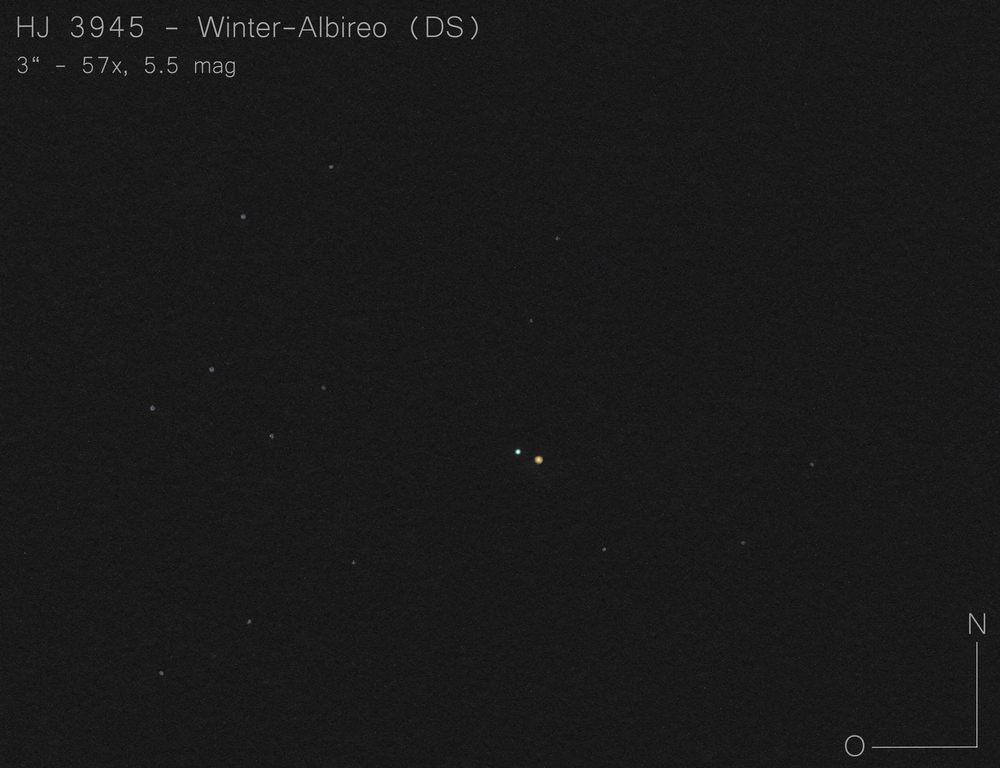
|
René Merting
Drachhausen (Germany) |
100mm (20x) |
AB: bei 32x leuchtet Komponente A goldgelb, B im NO wirkt weiß ohne den erwarteten Farbstich, auch nicht bei 107x und auch nicht, wenn ich die Sterne leicht unscharf stelle - trotzdem sehenswert - auch bei 20x zeigen sich beide Sterne ordentlich voneinander getrennt, A strahlt jetzt noch tiefgelber, fast orange |
|
Uwe Pilz
Leipzig (Germany) |
105mm (37x) |
AB: sofort auffallend, blau-orange |
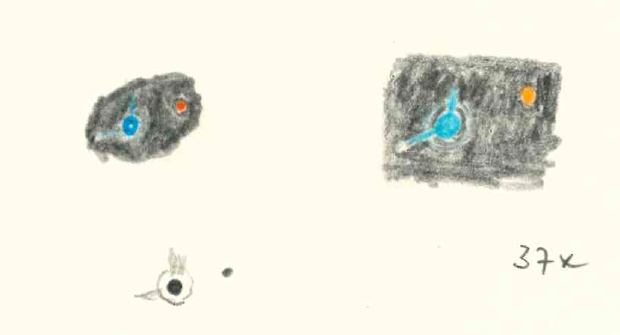
|
Robert Zebahl
Leipzig (Germany) |
120mm (23x) |
AB: Evident, easy to split at large angular distance. Brighter component appeared very orange, fainter one bluish. |
|
Sarah Gebauer
Germany |
254mm (42x) |
AB: ein richtig toll farbiges Pärchen, sauberst und weit getrennt, die südwestliche Komponente ist strahlend hellgold, die östliche leicht bläulich und blickweise manchmal grau, manchmal kobaltblau |
|
|
|
★
|
STF1066, delta Gem, 55 Gem |
|
|
3m.5 |
8m.2 |
5.5" |
229° |
2018 |
Gem |
07h20m07.39s / +21°58'56.40" |
|
|
Robert Zebahl
Leipzig (Germany) |
55mm (71x) |
Large difference in brightness. The fainter component was well separated, but just a very tiny star. |
|
René Merting
Drachhausen (Germany) |
76mm (127x) |
alle Vergrößerungen bis 127x probiert, eine Trennung war nicht möglich - Transparenz und Seeing waren einfach zu schlecht, B hat das Versteckspiel gewonnen |
|
Sarah Gebauer
Germany |
100mm (80x) |
bei 20-fach nicht getrennt, aber schon ein sehr warmgelber Farbeindruck - bei 80-fach getrennt mit einem großen, schönen Halo um den hellen, warmgelben Stern, der winzig kleine, graue Begleiter so dicht dran |
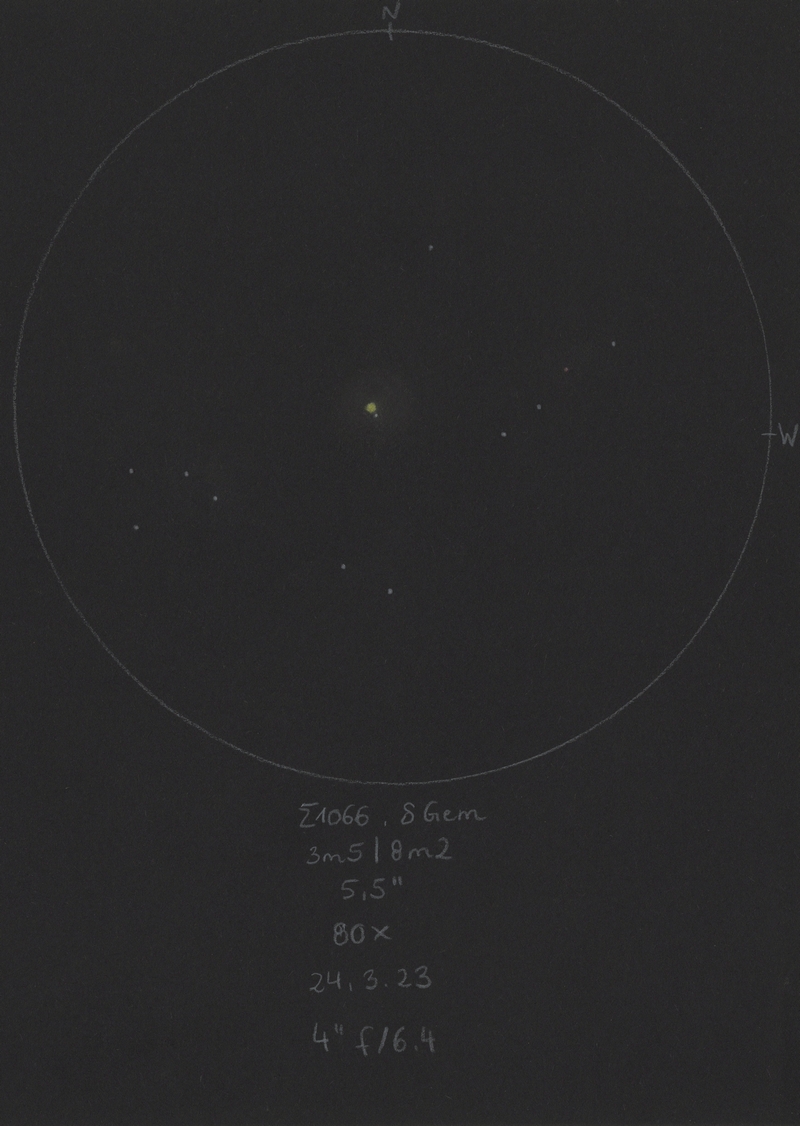
|
Axel Tute
Küssaberg (Germany) |
100mm (271x) |
23.03.2010: Wasat could not be separated with the 12mm RKE (108x) and the 8mm RKE (163x). Only with the 4.8mm Plössl a clear separation was possible. |

|
Robert Zebahl
Leipzig (Germany) |
102mm (160x) |
Easy to separate with relatively large distance. The companion appeared as a tiny, faint star. |
|
Winfried Kräling
Marburg (Germany) |
102mm (178x) |
|
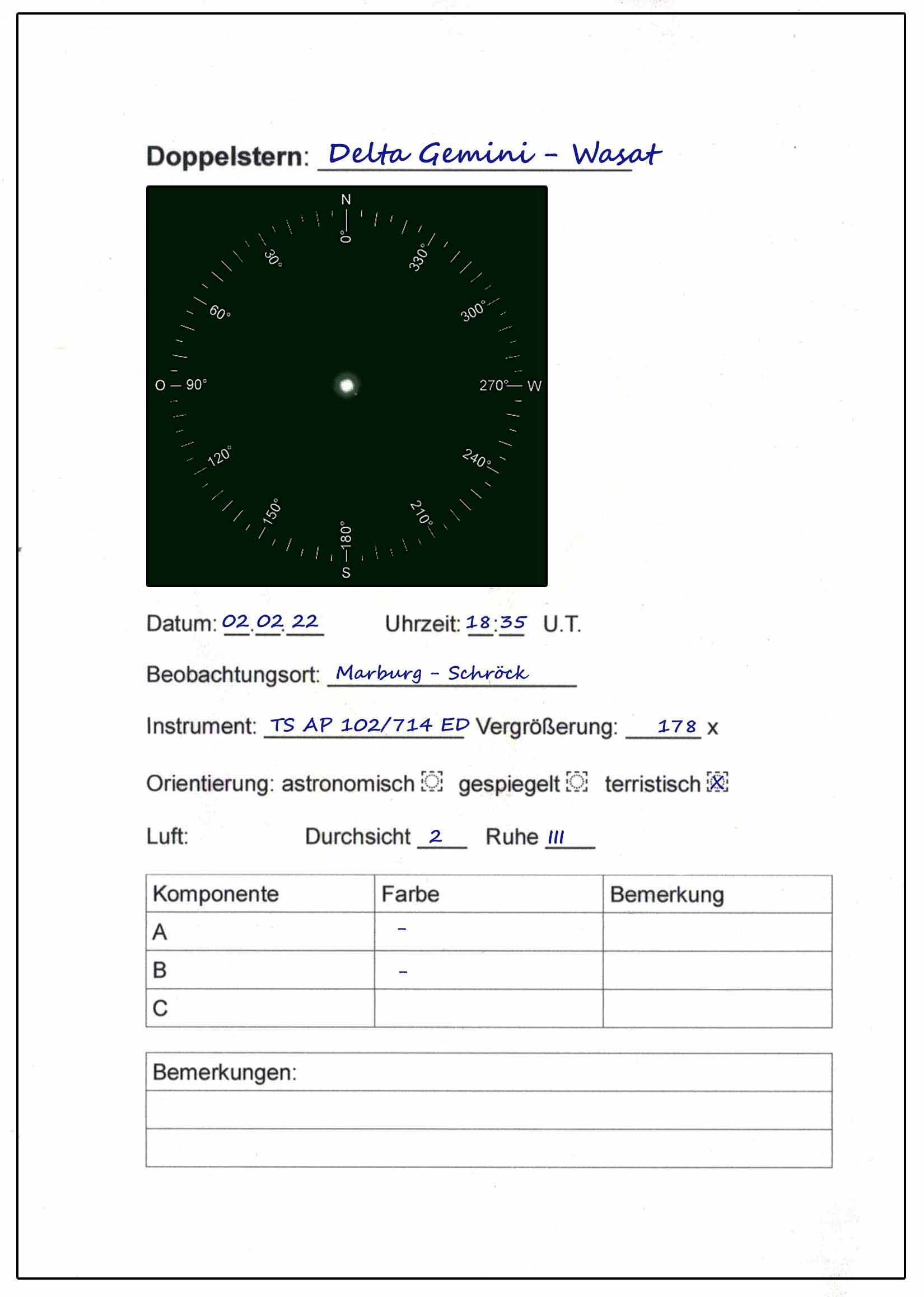
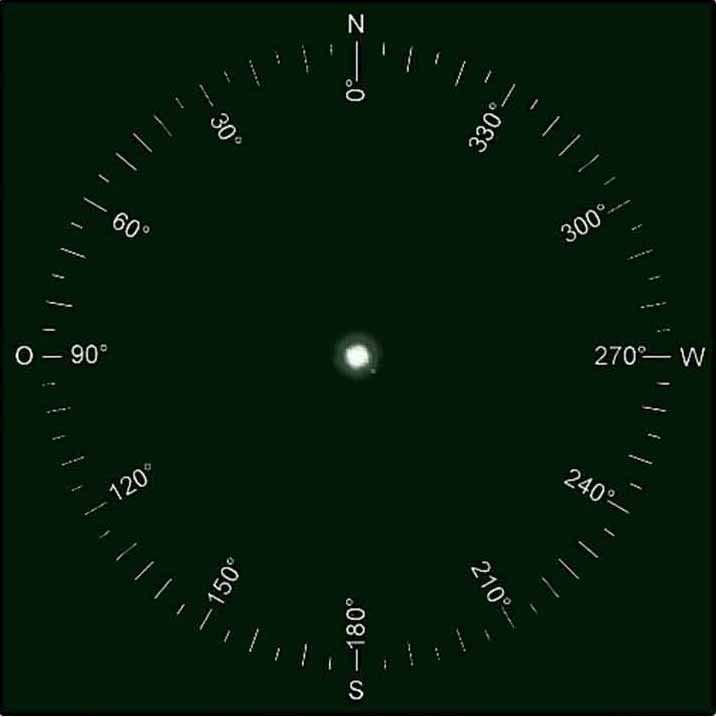
|
Uwe Pilz
Leipzig (Germany) |
105mm (200x) |
Nicht gesehen, wahrscheinlich ist der Begleiter zu schwach für leicht diesigen Himmel |
|
Uwe Pilz
Leipzig (Germany) |
105mm (288x) |
erster Ring in SSW heller, zweiter nur an dieser Stelle sichtbar |
|
Mark McCarthy
Fremont (California/USA) |
178mm (205x) |
Bright light yellow A and much fainter light orange B, wide about 6". Physical |
|
Axel Tute
Küssaberg (Germany) |
200mm (167x) |
13.03.2007: The C8 already needs the 12mm RKE for separation. PA estimated at 180°. A is greenish |
|
Mark McCarthy
Fremont (California/USA) |
317mm (553x) |
Wasat = Delta Geminorum: Pretty white-yellow and red-orange pair, PA to west, ~4". |
|
|
|
★
|
STF1081 |
|
AB |
7m.7 |
8m.5 |
1.9" |
234° |
2019 |
Gem |
07h24m08.94s / +21°27'28.00" |
|
|
|
|
AC |
7m.7 |
9m.9 |
107.0" |
63° |
2017 |
|
|
Robert Zebahl
Leipzig (Germany) |
102mm (28x) |
AC: Rather wide apart from component A with noticeable difference in brightness. Less conspicuous. |
|
Robert Zebahl
Leipzig (Germany) |
102mm (86x) |
AB: At 86x just separated, very close together with moderate difference in brightness. In relation to A, the components B & C are almost opposite each other. At 125x, A & B are easy to split. |
|
Uwe Pilz
Leipzig (Germany) |
120mm (180x) |
|

|
Mark McCarthy
Fremont (California/USA) |
178mm (205x) |
AB: Very pretty blue-white A and slightly orange B, well separated about 2" |
|
|
|
★
|
STF1088 |
|
AB |
7m.4 |
9m.4 |
10.9" |
195° |
2015 |
Gem |
07h26m02.42s / +14°06'10.70" |
|
|
|
|
AC |
7m.4 |
8m.7 |
112.8" |
238° |
2015 |
|
|
|
|
|
|
AD |
7m.4 |
11m.8 |
91.2" |
243° |
2015 |
|
|
|
|
|
|
AE |
7m.4 |
13m.9 |
137.4" |
224° |
1984 |
|
|
René Merting
Drachhausen (Germany) |
76mm (57x) |
AB: bei 57x ist B ganz schwach knapp abgesetzt südlich von A erkennbar
AC: bei 29x habe ich leichtes Spiel mit den beiden Komponenten, sie stehen weit auseinander - C wirkt nur halb so hell wie A und vom Farbeindruck grau gegen die weiß strahlende A-Komponente |
|
Mark McCarthy
Fremont (California/USA) |
178mm (205x) |
AB: White A and two delta mag B, well separated |
|
Sarah Gebauer
Germany |
254mm (42x) |
AB: auf den ersten Blick bei 42x einfach nur ein Trapez aus mehreren Sternen, aber der rechte untere ist auf einmal ein Doppelstern mit einer schwächeren, sehr dicht stehenden Komponente, die Komponente C ist auch Teil des Trapezes |
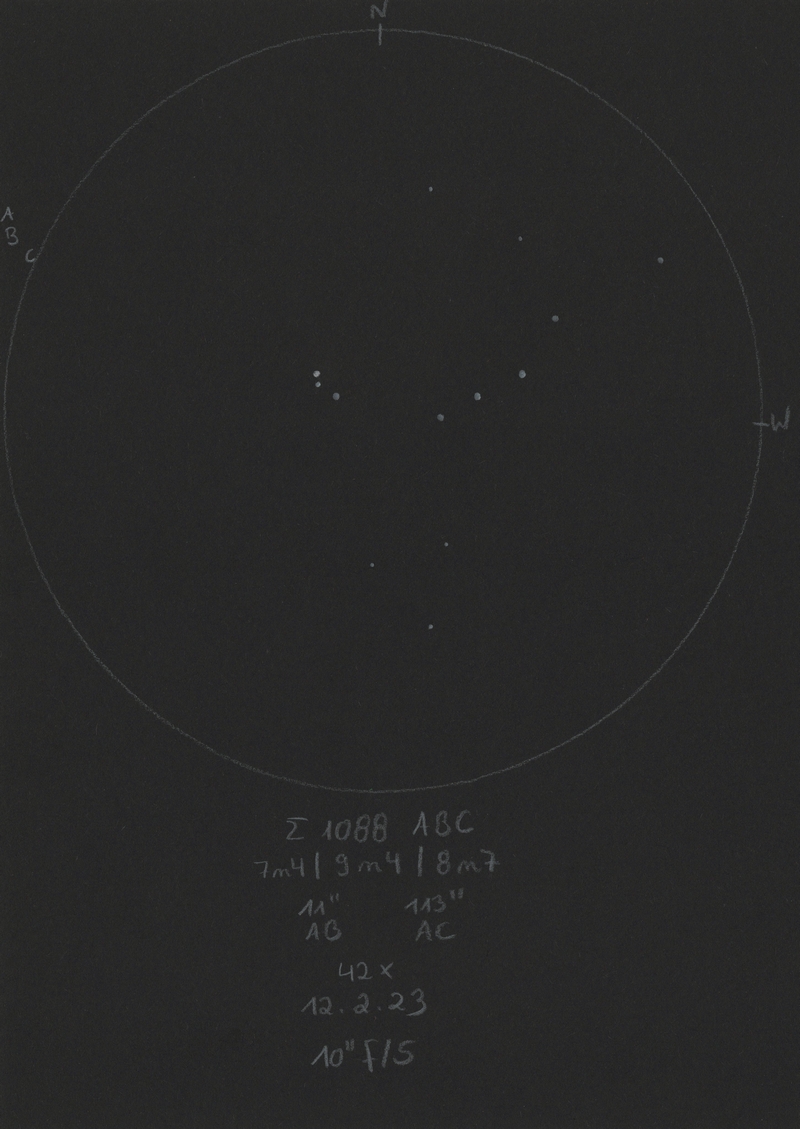
|
|
|
★
|
STF1090 |
|
AB |
7m.3 |
8m.2 |
60.8" |
98° |
2017 |
Gem |
07h26m27.33s / +18°31'00.80" |
|
|
|
|
AC |
7m.3 |
9m.5 |
49.0" |
80° |
2017 |
|
|
|
|
|
|
BC |
8m.2 |
9m.5 |
20.9" |
328° |
2017 |
|
|
Christopher Hay
Seeheim (Germany) |
15x45 |
Binoculars with internal stabilisation, handheld. AB are well split. Substantial delta-mag.
A physical double at a distance to us of 366 light years. |
|
Mark McCarthy
Fremont (California/USA) |
317mm (553x) |
AC: Pretty finder split, equal white. Is a 2+1 with 2x fainter BC. |
|
Mark McCarthy
Fremont (California/USA) |
317mm (553x) |
BC: Is a 2+1 with AC, C is 2 delta mag than fainter B. |
|
|
|
★
|
STT171 |
|
|
7m.4 |
9m.2 |
1.0" |
138° |
2012 |
Gem |
07h26m39.61s / +31°37'11.90" |
Mark McCarthy
Fremont (California/USA) |
178mm (333x) |
! Exceptionally fine, with seeing, white A and bluish B, 2 delta mag, B appears as a very fine point at A's diffraction ring, less than 1". Suspected at 205x, best seen at 333x |
|
|
|
★
|
ES2625 & S548 |
ES2625 |
AB |
7m.0 |
12m.4 |
11.9" |
24° |
2015 |
Gem |
07h27m40.54s / +22°08'29.30" |
|
|
|
S548 |
AC |
7m.0 |
8m.9 |
35.3" |
277° |
2019 |
|
|
Christopher Hay
Seeheim (Germany) |
15x45 |
S548 (AC): Binoculars with internal stabilisation, handheld. Clean split. Secondary very faint. Primary yellowish-orange, a colour impression confirmed (without split) in handheld 7x45. Seen together with Eskimo Nebula (stellar) in 4.5° FOV.
A physical double at a distance to us of 1199 light years. |
|
René Merting
Drachhausen (Germany) |
100mm (20x) |
S548 (AC): bei 32x ein weit getrenntes Paar - Komponente A strahlt schwach gelblich … eher dunkelgelb - Komponente C im Westen von A ist gut 1.5 Magnituden schwächer und dunkelgrau bis lachsorange - der Doppelstern steht isoliert, fällt aber nicht übermäßig auf - zurück auf 20x ist das Paar weiterhin gut getrennt erkennbar |
|
Sarah Gebauer
Germany |
100mm (80x) |
S548 (AC): bei 80-fach weit getrennt, die östliche Komponenten scheint schön gelb, die westliche hauptsächlich grau und flackert nur für einen kurzen Augenblick blau auf - bei 49-fach intensiviert sich der warmgelbe Farbton stark und geht sogar ins Kupferorange, der Begleiter ist blickweise etwas häufiger leuchtend kobaltblau, aber nur selten |
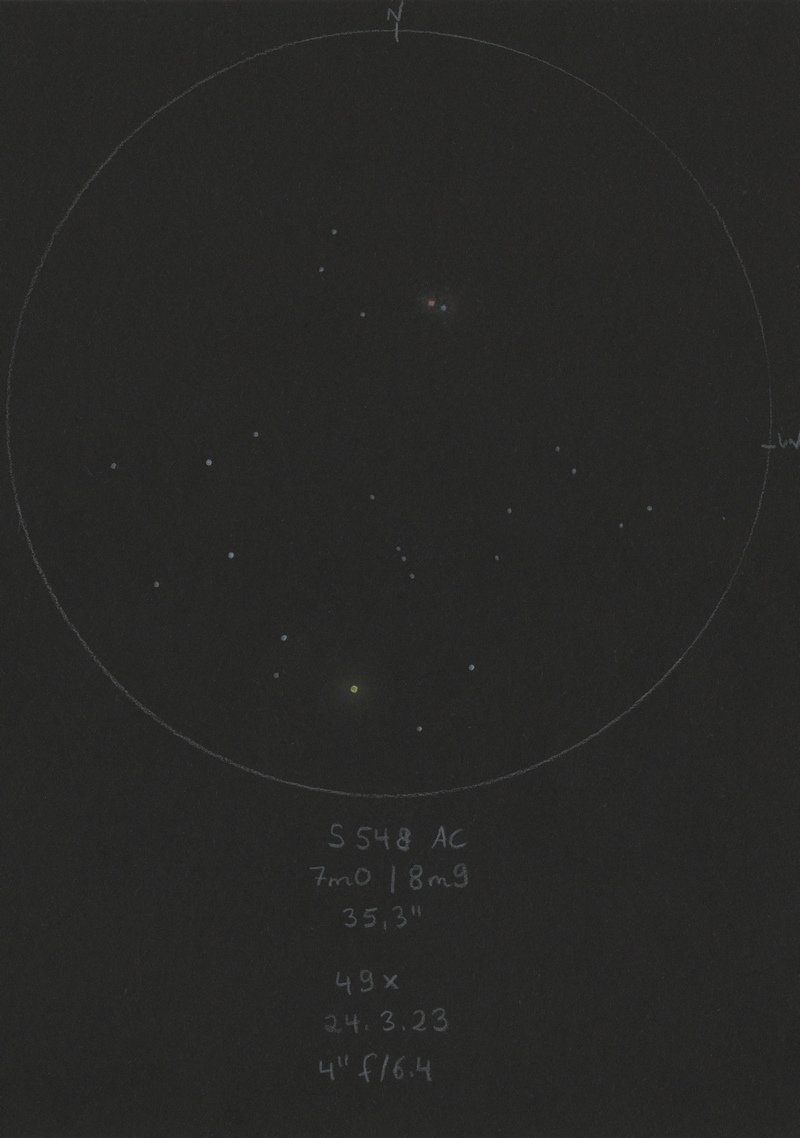
|
Uwe Pilz
Leipzig (Germany) |
105mm (88x) |
S548 (AC): bei 21x trennbar, orange und fahlblau |

|
Mark McCarthy
Fremont (California/USA) |
317mm (553x) |
S548 (AC): Orange with a 2x fainter white star, PA slightly SW. AB is 12th mag and not seen |
|
|
|
★
|
A2868 |
|
|
8m.6 |
9m.0 |
0.7" |
16° |
2019 |
Gem |
07h29m09.44s / +12°52'45.50" |
Mark McCarthy
Fremont (California/USA) |
178mm (333x) |
! Strongly notched to hairline at 205x, steady hairline split at 333x with seeing, very noticeable magnitude difference |
|
|
|
★
|
STF1102 |
|
AB |
7m.4 |
9m.2 |
7.7" |
45° |
2016 |
Gem |
07h30m26.25s / +13°51'54.00" |
|
|
|
|
AC |
7m.4 |
13m.2 |
21.8" |
77° |
2015 |
|
|
|
|
|
|
AD |
7m.4 |
8m.0 |
111.9" |
131° |
2015 |
|
|
|
|
|
|
BC |
9m.2 |
13m.2 |
15.9" |
91° |
2015 |
|
|
|
|
|
|
BE |
9m.2 |
12m.0 |
30.4" |
3° |
2015 |
|
|
Christopher Hay
Seeheim (Germany) |
7x45 |
AD: Handheld. Clear, almost wide, split. Component A distinctly brighter.
A physical double at a distance to us of 148 light years. |
|
Christopher Hay
Seeheim (Germany) |
15x45 |
AD: Binoculars with internal stabilisation, handheld. Wide split. A visually strong pair. |
|
René Merting
Drachhausen (Germany) |
76mm (57x) |
AB: bei 57x kann ich mit ganz viel Konzentration B knapp getrennt östlich von A erkennen - Helligkeitsunterschied 1.5 bis 2 Magnituden n\AD: Komponente D im Südosten habe ich natürlich auch schon bei 29x gesehen, aber mir war nicht bewusst, dass diese zum System dazu gehört |
|
Mark McCarthy
Fremont (California/USA) |
178mm (205x) |
AB: Easy white A and ruddy B, wide, 1 delta. Physical |
|
|
|
★★★
|
STF1110, alpha Gem, 66 Gem, Castor |
|
AB |
1m.9 |
3m.0 |
5.4" |
53° |
2020 |
Gem |
07h34m35.86s / +31°53'17.80" |
|
|
|
|
AC |
1m.9 |
9m.8 |
71.6" |
164° |
2020 |
|
|
|
|
|
|
AD |
1m.9 |
10m.1 |
179.8" |
221° |
2017 |
|
|
|
|
Christopher Hay
Seeheim (Germany) |
20x60 |
AB: Handheld in reclining chair, binoculars with internal stabilisation. 16 April 2022 (5.5" angular distance according to database): Distinctly elongated, like a rectangle at the transition to a figure-8. |
|
Christopher Hay
Seeheim (Germany) |
26x42 |
AB: 13 May 2022 (5.5" angular distance according to database). Moon four-fifths full a few degrees north of Spica in Virgo. 70mm binoculars stopped down to 42mm aperture. Directly after looking the Moon I was able to split Castor AB definitely. Could hold this for a full minute, only then did the split start to become uncertain. Repeated the observation several times, found the split to be definite each time. |
|
Christopher Hay
Seeheim (Germany) |
32x70 |
AB: 13 March 2022 (5.5" angular distance according to database): Moon only 6° away and two-thirds full in the middle of Gemini. After concentrated observation of the Moon I slewed quickly to Castor to exploit the heightened acuity provided by viewing the bright Moon. Castor clearly split with fine black between A and B. After a while the split became more difficult but could still be held.
Followed this up with the same eyepiece previously used in the achromatic 70/400 binoculars now placed in 71/400 fluorite apochromatic telescope, thus again yielding 32x. Again A and B split after observation of the Moon, but harder to hold with the mono apochromat than with the bino achromat. |
|
Christopher Hay
Seeheim (Germany) |
36mm (33x) |
AB: 16 April 2022 (5.5" angular distance according to database): With Käsemann (KSM) polarising filter at 33x two kissing Airy disks which seem to move apart in good moments, but this is uncertain. Without filter at 33x just a squat figure-8 far removed from separation.
With polarising filter at 40x definite separation, fine first diffraction ring of component A. Without filter a stretched figure-8 with no separation.
At 50x clear and stable separation with and without filter. Best view at 66x, a ghostly pair in pitch-black FOV, the first diffraction rings of A and B merging, that of B very faint.
With a Baader Neodymium filter the positive effects are similar to those of the KSM polarising filter, but the clarity of separation is not quite as great as with the polarising filter. |
|
Robert Zebahl
Leipzig (Germany) |
55mm (27x) |
AB: At 27x slight difference in brightness visible. Double star appeared as '8'. At 38x clearly split, but tight. |
|
Robert Zebahl
Leipzig (Germany) |
63mm (26x) |
AB: Experiment to determine the smallest magnification to separate Castor. I observed on 2022-05-09, 2022-05-11 & 2022-05-18.
At 26x and 30x easily seen as a double star, but not clearly separable due to outshining. At 70x of course easily separated. Stopped down to 30mm aperture, Castor appeared partially separated at 26x, but very barely. The right viewing position at the eyepiece was important. At 30x with 30mm aperture, Castor was cleanly separated, but extremely tight.
Following a hint from Christopher Hay, I also used a red filter from Baader to avoid outshining at full aperture. Now also a separation at 26x was possible, whereby the components were extremely close to each other.
For me a magnification of 26x seems to be the minimum to separate Castor cleanly, if the brightness of the components is reduced sufficiently. |
|
Robert Zebahl
Leipzig (Germany) |
70mm (44x) |
AB: At 44x the double star appeared as an '8'. At 100x clearly split with noticeable difference in brightness. Both components appeared white. |
|
Axel Tute
Küssaberg (Germany) |
70mm (146x) |
AB: 11.03.2009: Separated with the 6mm Ortho and the 4.8mm Plössl. A: bluish B: orange |

|
Axel Tute
Küssaberg (Germany) |
70mm (146x) |
AB: 23.03.2010: B with a clear gap. |
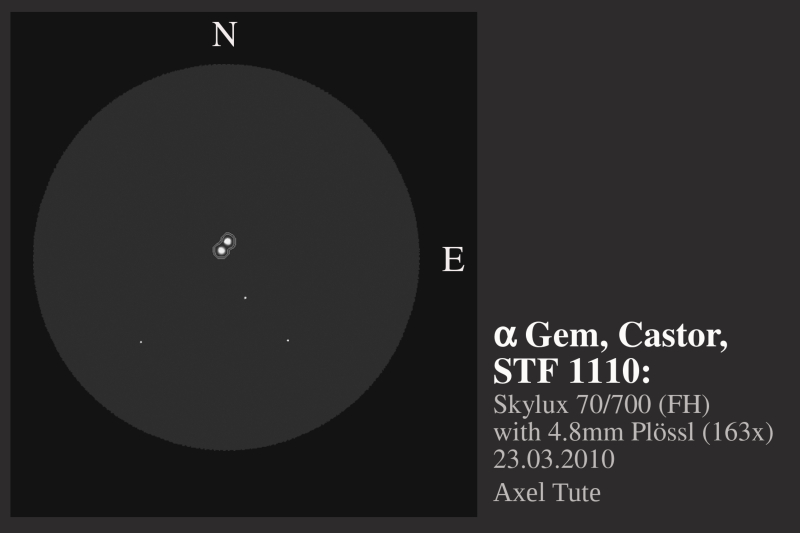
|
Christopher Hay
Seeheim (Germany) |
76mm (50x) |
AB: 18 February 2021: At 23x oval-elongated with clear position of component A. At 50x finely split. At 83x best sight with first diffraction rings slightly overlapping. At 100x nice pattern of the Airy disks and the overlapping first and second diffraction rings of both components. |
|
René Merting
Drachhausen (Germany) |
76mm (81x) |
AB: bei 57x sind zwei Murmeln erkennbar, die noch knappst aneinander kleben - bei 81x dann zeigen sich zwei helle Sterne knapp getrennt mit leichtem Farbkontrast, die A-Komponente im Süden schimmert leicht gelblich, B ist eine dreiviertel Magnitude schwächer und schön weiß |
|
René Merting
Drachhausen (Germany) |
100mm (107x) |
AB: bei 32x wirkt der Stern leicht länglich - bei 107x stehen die beiden Sterne schön eng mit überlagernden Beugungsscheibchen, die Komponenten sind dennoch getrennt erkennbar - Komponente B im Osten ist eine halbe Magnitude schwächer - ganz schwacher Farbkontrast |
|
Axel Tute
Küssaberg (Germany) |
100mm (163x) |
AB: 23.03.2010: Around A and B a diffraction ring each. Between the diffraction rings still a clear gap |
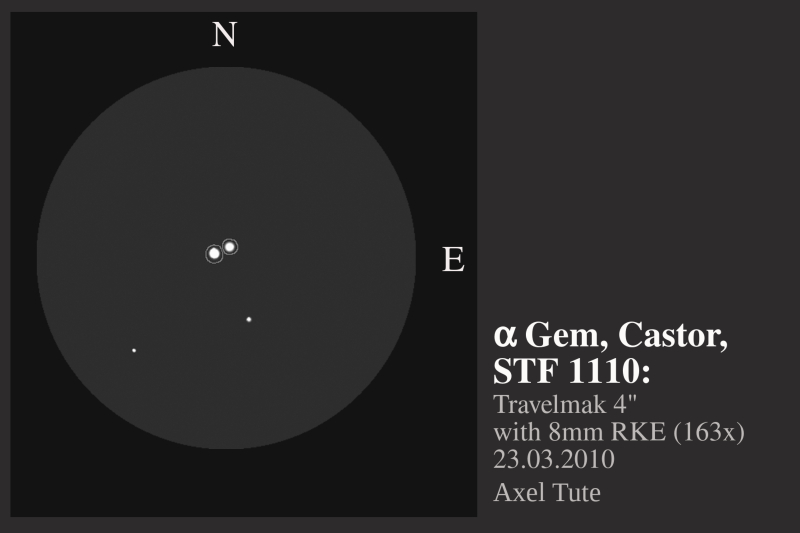
|
Uwe Pilz
Leipzig (Germany) |
105mm (144x) |
AB: blauweiß-weiß |
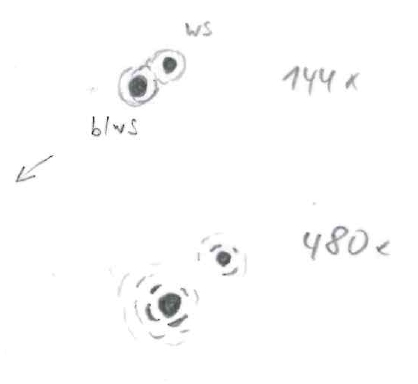
|
Winfried Kräling
Marburg (Germany) |
127mm (250x) |
AB: 13.03.2017: Beide Komponenten gelblich mit geringem Helligkeitsunterschied, bereits bei V=60x getrennt. |

|
Mark McCarthy
Fremont (California/USA) |
178mm (205x) |
AB: Castor. A is a very pale yellow and B is yellow-green, 2 delta mag, very bright, pretty wide, some fainter stars about. Physical with a 459.8-year period |
|
Christopher Hay
Seeheim (Germany) |
180mm (200x) |
AB: Two fat spotlights in space. Component B seems greenish at first sight (using a first-class reflector free of chromatic aberration), and certainly has a different hue than component A. The second diffraction rings of A and B meet. |
|
|
Frederik Wanink
Itterbeck (Germany) |
254mm |
AB |
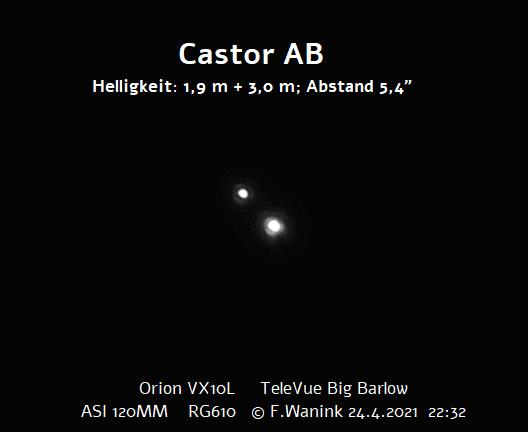
|
Frederik Wanink
Itterbeck (Germany) |
254mm |
AB |

|
|
|
★★
|
STF1121 |
|
AB |
6m.9 |
7m.3 |
7.4" |
305° |
2019 |
Pup |
07h36m36.06s / -14°29'03.70" |
Robert Zebahl
Leipzig (Germany) |
152mm (30x) |
Fantastic view of the double star in the middle of the beautiful star cluster Messier 47! Bright, moderate separation with little difference in brightness. |
|
|
|
★★
|
BRD2 |
|
AB |
9m.2 |
9m.5 |
0.9" |
187° |
2016 |
CMi |
07h39m46.65s / +05°16'25.50" |
Mark McCarthy
Fremont (California/USA) |
203mm (333x) |
Wow! Exceptionally fine pair, white, near equal, nicely split, just outside of Procyon's glare. Great! [AB,C 14th mag not seen] |
|
|
|
★★
|
STF1126 |
|
AB |
6m.5 |
7m.0 |
0.9" |
176° |
2021 |
CMi |
07h40m06.99s / +05°13'51.90" |
|
|
Uwe Pilz
Leipzig (Germany) |
105mm (288x) |
beide gelb. Es war schwierig, die hellere Komponente zu erkennen. Direkt neben Prokyon. |

|
Mark McCarthy
Fremont (California/USA) |
317mm (553x) |
Wow, very close <1" hair-split, near equal brightness |
|
|
|
★
|
STF1122 |
|
|
7m.8 |
7m.8 |
14.9" |
186° |
2019 |
Cam |
07h45m52.47s / +65°09'28.10" |
René Merting
Drachhausen (Germany) |
18x70 |
ein genialer, heller Stern für 18x-Ferngläser - ein wunderschönes enges Sternpaar, wo drei Blatt Papier dazwischen passen |
|
Robert Zebahl
Leipzig (Germany) |
70mm (31x) |
2020-05-15: At 22x immediately apparent with a beautiful separation between the equally bright components. One component appeared slightly bluish, the other light orange. At 44x the subtle color difference can be seen a bit better. The double star is in a nice star field together with 51 Cam. |
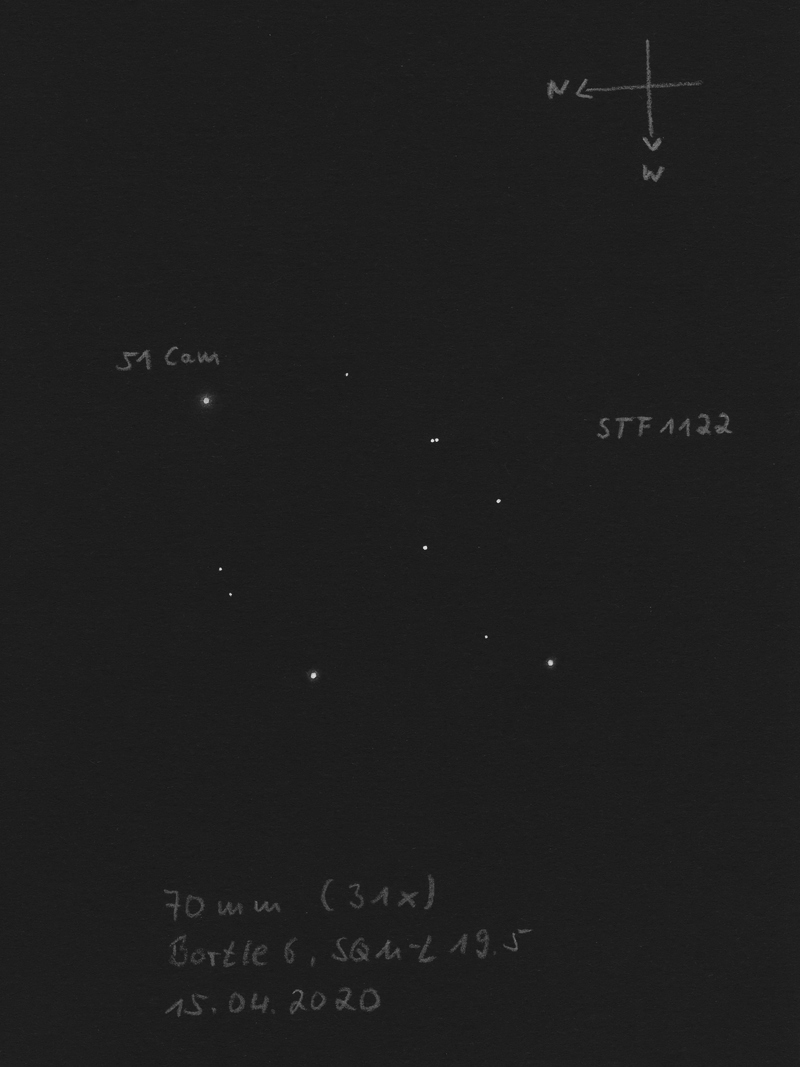
|
René Merting
Drachhausen (Germany) |
107mm (30x) |
bei 30x wunderschön anzusehen - ein Paar gleich heller Sterne, ein klein wenig mehr als knapp getrennt, das klassische Ameisenpärchen - beide Sterne wirken weiß bis warmweiß |
|
René Merting
Drachhausen (Germany) |
320mm (45x) |
bei 72x ein gut getrenntes Pärchen zweier gleich heller Sterne - trotz vieler gleich heller Sterne im Gesichtsfeld wirkt das Doppel gut isoliert |
|
|
|
★
|
COU772 |
|
|
9m.0 |
9m.2 |
0.3" |
73° |
2013 |
Gem |
07h47m07.07s / +18°47'19.20" |
Mark McCarthy
Fremont (California/USA) |
508mm (667x) |
A most excellent, barest hairline split of white stars with significant magnitude. Suspected with 333x, needed 667x for a clean view. Very nice |
|
|
|
★★
|
STF1140 |
|
|
7m.0 |
8m.7 |
6.4" |
273° |
2016 |
Gem |
07h48m22.61s / +18°20'12.40" |
Robert Zebahl
Leipzig (Germany) |
70mm (44x) |
Easy to separate with quite clear difference in brightness. |
|
René Merting
Drachhausen (Germany) |
76mm (57x) |
bei 29x zeigt sich ein länglich wirkendes, gelbliches Sternchen - bei 57x zeigt sich B ganz schwach knapp getrennt westlich von A - Helligkeitsunterschied mindestens 1.5 Magnituden - B wirkt erstaunlich weiß, dafür dass die Komponente so schwach ist - A dagegen strahlt weißgelblich |
|
Sarah Gebauer
Germany |
100mm (49x) |
bei 20-fach schon leicht länglich zu sehen, 81 Gem zeigt auch einen kupfergelben Farbton - bei 49-fach dann haarscharf getrennt, ein wunderschöner Anblick! - richtig kupferorange und westlich davon deutlich schwächer und sehr dicht mit schwarzem Trennstrich in einem grauorange Ton der schwache Begleiter - sogar der Stern HD 63299 südöstlich möchte einen leicht warmweißen Farbton mit einem Hauch Orange zeigen |
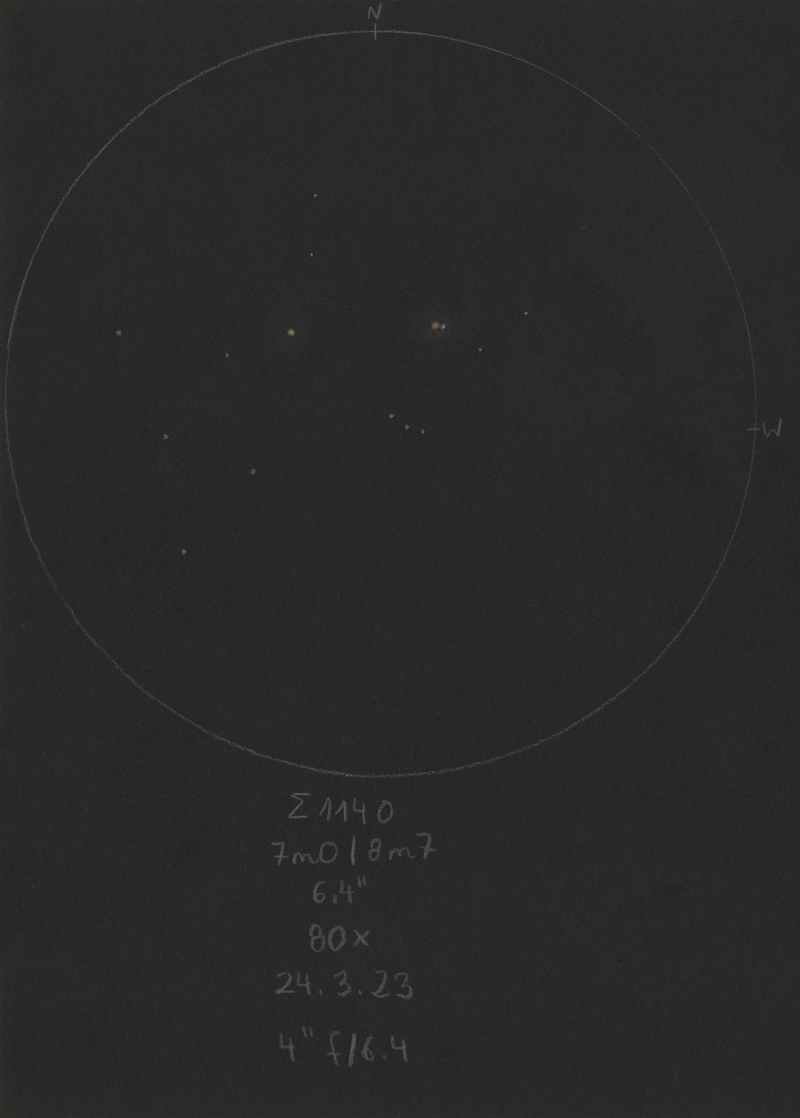
|
Mark McCarthy
Fremont (California/USA) |
508mm (205x) |
Easy pair, light orange A and light blue B, 1 delta mag, wide ~8" |
|
|
|
★
|
COU926 |
|
|
9m.5 |
9m.7 |
0.2" |
250° |
2013 |
Gem |
07h50m38.16s / +19°44'04.20" |
Mark McCarthy
Fremont (California/USA) |
508mm (533x) |
Very tentative notched, noticable mag difference, only with seeing. Can't go to higher mag due to seeing |
|
|
|
★★★
|
STTA89 |
|
|
6m.8 |
7m.7 |
76.6" |
84° |
2017 |
Gem |
07h51m00.20s / +31°36'48.70" |
Christopher Hay
Seeheim (Germany) |
7x45 |
Handheld. Clearly split. Primary distinctly brighter. Rather charming in 8.6° FOV together with Castor and Pollux, with which it forms an almost equilateral triangle.
A physical double at a distance to us of 660 light years. |
|
Christopher Hay
Seeheim (Germany) |
20x60 |
Handheld in reclining chair, binoculars with internal stabilisation. A charming wide pair with a subtle blue/orange colour contrast. |
|
Robert Zebahl
Leipzig (Germany) |
70mm (22x) |
At 22x widely separated with moderate difference in brightness. The primary component appeared whitish, at 44x rather white-yellowish. The companion appeared slightly orange. |
|
|
|
★
|
BU101, 9 Pup |
|
|
5m.6 |
6m.5 |
0.3" |
313° |
2021 |
Pup |
07h51m46.31s / -13°53'52.80" |
|
|
Mark McCarthy
Fremont (California/USA) |
508mm (1067x) |
9 Pup. Elongated to notched, orientation correct, light orange. Very tough. [B is coming off it's furthest orbit and will be exceptionally difficult in 10 years, but easier in 15 years] |
|
|
|
★
|
STT185 |
|
|
7m.1 |
7m.3 |
0.4" |
22° |
2020 |
CMi |
07h57m16.39s / +01°07'37.30" |
|
|
Mark McCarthy
Fremont (California/USA) |
508mm (1067x) |
Without the apodizing mask I get a clean split with seeing but constant split with the mask. Light orange stars, noticeable mag difference |
|
|
|
★
|
STT186 |
|
|
7m.7 |
7m.9 |
1.1" |
75° |
2019 |
Cnc |
08h03m18.52s / +26°16'03.50" |
Mark McCarthy
Fremont (California/USA) |
178mm (205x) |
Beautiful hairline split, white stars, around 1 delta mag and 1". Great pair |
|
Mark McCarthy
Fremont (California/USA) |
317mm (553x) |
Close, 1" but easy split, near equal dull white color. |
|
|
|
★
|
BU581 |
|
AB |
8m.5 |
8m.8 |
0.5" |
242° |
2021 |
Cnc |
08h04m23.10s / +12°17'23.80" |
|
|
Mark McCarthy
Fremont (California/USA) |
317mm (553x) |
Light orange near equal, very small, elongated to notched. |
|
Mark McCarthy
Fremont (California/USA) |
508mm (1067x) |
With apodizing mask. Beautiful clean split, almost wide, light orange stars, slight mag difference. There is a third 2x fainter star further out, might be plus one. Wow. [3rd is AB-C, 8.46/11.78 5.5"] |
|
|
|
★★
|
STF1177, 17 Cnc |
|
|
6m.7 |
7m.4 |
3.5" |
350° |
2019 |
Cnc |
08h05m37.06s / +27°31'46.90" |
Robert Zebahl
Leipzig (Germany) |
70mm (57x) |
Easy to separate, but still relatively close together. Well visible difference in brightness. Color of the components was not clearly visible. Nice view overall. |
|
René Merting
Drachhausen (Germany) |
100mm (64x) |
bei 107x sehe ich ein knapp getrenntes schön eng stehendes Pärchen - Komponente B im Norden ist eine dreiviertel Größenklasse schwächer - das Weiß von A wirkt kühler - zurück auf 64x sehe ich eine Ameise mit dünnem Hals, in ruhigen Momenten zeigen sich beide Sterne sogar getrennt |
|
Uwe Pilz
Leipzig (Germany) |
105mm (144x) |
|
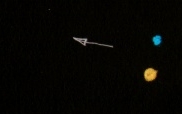
|
Uwe Pilz
Leipzig (Germany) |
105mm (180x) |
Blau und Orange - sehr schöner Farbkontrast, unterstützt durch die ähnliche Helligkeit |

|
Christopher Hay
Seeheim (Germany) |
125mm (160x) |
Well split despite substantial turbulence in the atmosphere. Main component creamy yellow-white, companion pale blue. A very attractive colour contrast warranting a one-star rating. |
|
Mark McCarthy
Fremont (California/USA) |
178mm (205x) |
Excellent, around 1 delta mag and wide, blue-white stars, nicely resolved |
|
Frederik Wanink
Itterbeck (Germany) |
254mm (640x) |
getrennt |

|
Mark McCarthy
Fremont (California/USA) |
317mm (553x) |
Yellowish, 1 delta mag, ~4" |
|
Karsten Kopp
Köln (Germany) |
600mm (180x) |
Gut zu trennender Doppelstern, mit gut erkennbaren Helligkeitsunterschied . Der hellere Stern leuchter weiß-gelblich, während der schwächere leicht bläulich schimmert. Schöner Farbkontrast |
|
|
|
★★★
|
zeta Cnc, 16 Cnc |
STF1196 |
AB |
5m.3 |
6m.2 |
1.1" |
359° |
2021 |
Cnc |
08h12m12.79s / +17°38'51.20" |
|
|
|
STF1196 |
AB-C |
4m.9 |
5m.8 |
6.0" |
64° |
2020 |
|
|
|
|
|
STF1196 |
AC |
5m.3 |
5m.8 |
6.2" |
62° |
2020 |
|
|
|
|
|
HUT1 |
Ca-Cb |
6m.2 |
7m.1 |
0.3" |
344° |
2021 |
|
|
|
|
Robert Zebahl
Leipzig (Germany) |
70mm (133x) |
The wide pair AB-C is already separable at 22x. The pair AB shows at 133x two clearly overlapping diffraction disks with small difference in brightness, but without any notch. |

|
Christopher Hay
Seeheim (Germany) |
71mm (32x) |
AB-C: Finely split. AB yellowish. Substantial delta-mag. |
|
Robert Zebahl
Leipzig (Germany) |
102mm (86x) |
AB-C: Easy to separate. A: light grey, B: pale orange. |
|
Stefan Loibl
Rosenheim (Germany) |
102mm (164x) |
AB-C clearly split, AB obviously elongated but not split |
|
Uwe Pilz
Leipzig (Germany) |
105mm (288x) |
weißblau-gelb-gelb |
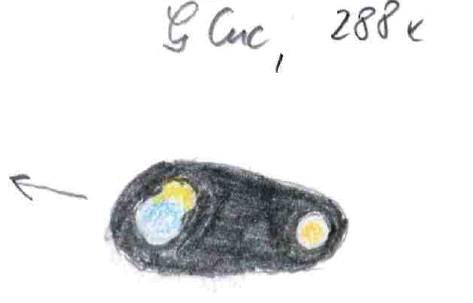
|
Robert Zebahl
Leipzig (Germany) |
120mm (67x) |
AB-C: Evident difference in brightness, easy to split. Both components of similar color. |
|
Robert Zebahl
Leipzig (Germany) |
120mm (200x) |
AB: Very tight. The Airy disks were still touching. Slight difference in brightness. Extremely beautiful triple star! |
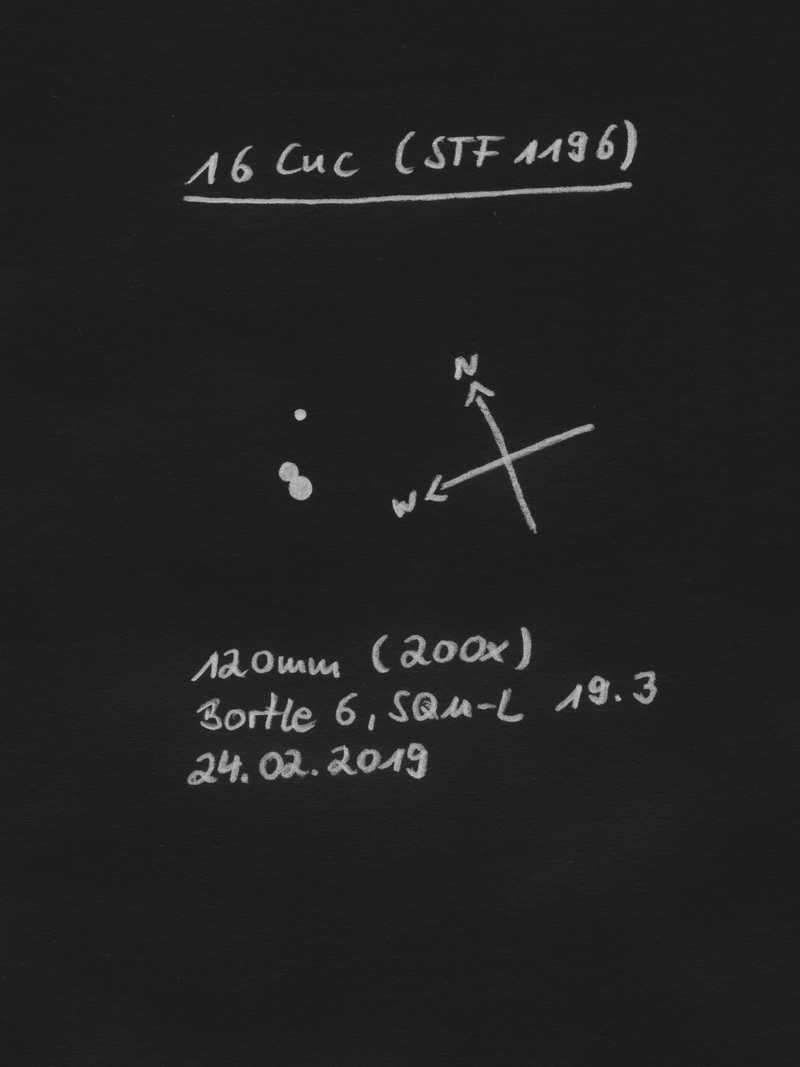
|
Winfried Kräling
Marburg (Germany) |
127mm (250x) |
08.04.2018: Sehr schön, 3-fach Stern, A = weißgelb, B = weißgelb, C = weißgelb |
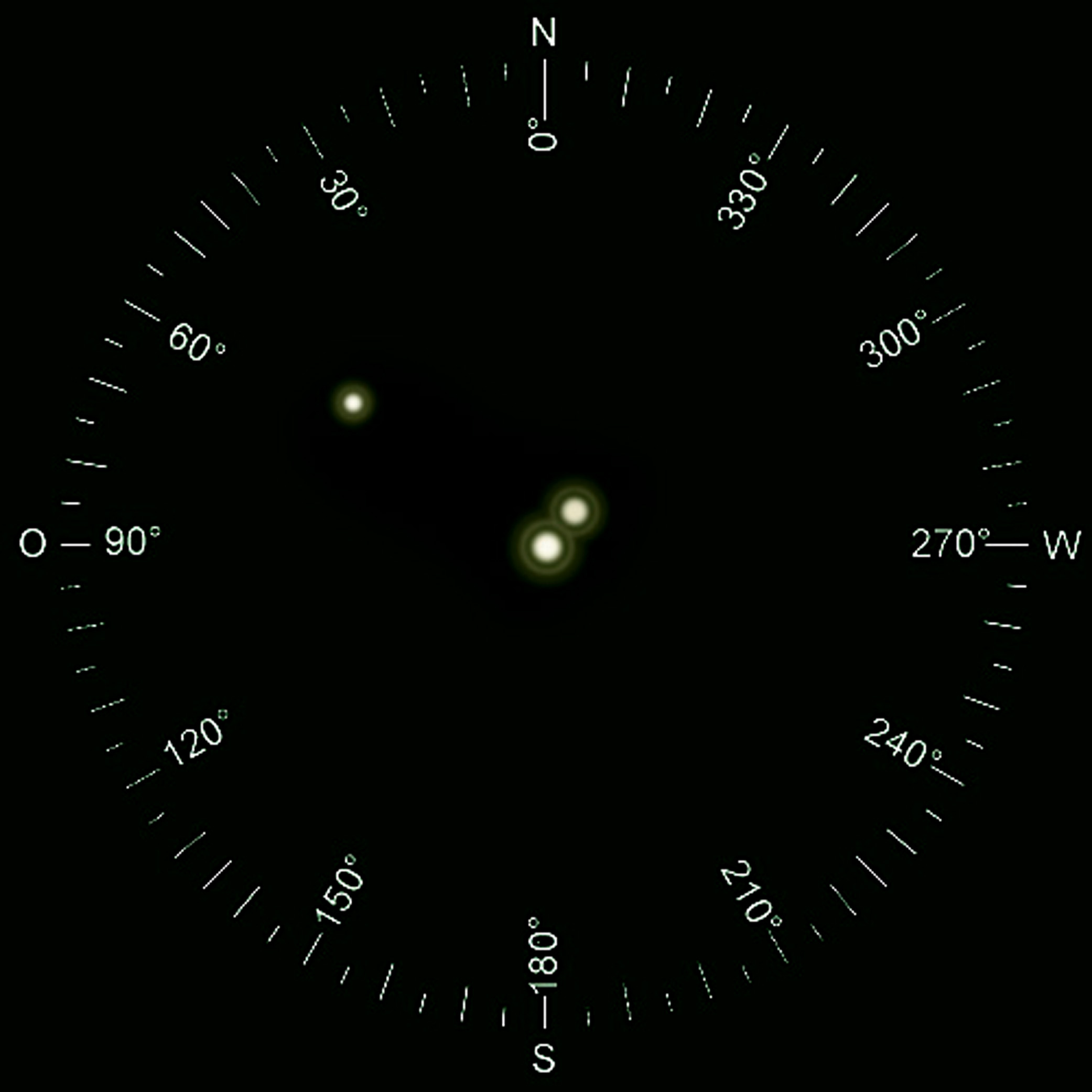
|
Sarah Gebauer
Germany |
150mm (83x) |
AB-C: bei 83x sind AB-C sauber getrennt, laut Atlas 2020 6,1'' Abstand, die Komponenten A und B mit 1,1'' lassen sich nicht trennen, viele schöne Feldsterne dabei |
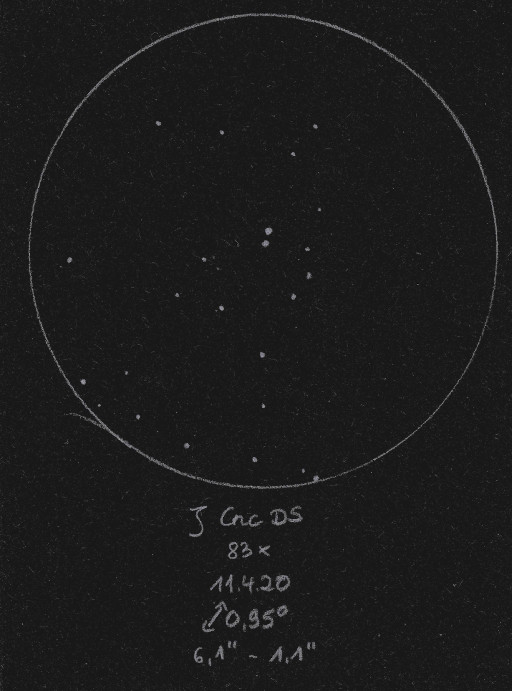
|
Christopher Hay
Seeheim (Germany) |
180mm (200x) |
AB: Hair-fine split. A and B both yellowish-white. C wide from AB, bluish-white, nice colour contrast to AB. |
|
Mark McCarthy
Fremont (California/USA) |
317mm (553x) |
Ca-Cb: not quite round, oval/olive shaped. It is the AB-C of STF 1196. |
|
Mark McCarthy
Fremont (California/USA) |
317mm (553x) |
AB: Triple, all near equal magnitude, yellow-white. AB ~0.8", hair split. |
|
Mark McCarthy
Fremont (California/USA) |
317mm (553x) |
AC: Triple, all near equal magnitude, yellow-white. AC ~6", wide split. |
|
Karsten Kopp
Köln (Germany) |
600mm (257x) |
AB: Die Komponenten AB-C bei etwas größerem Helligkeitsunterschied einfach zu trennen und auch schön anzusehen. Sterne erstrahlen weißlich gelb. Komponente AB war nicht zu trennen. |
|
|
Frederik Wanink
Itterbeck (Germany) |
254mm |
AB-C |

|
|
|
★
|
STF1193 |
|
AB |
6m.2 |
9m.7 |
42.4" |
90° |
2015 |
UMa |
08h20m40.32s / +72°24'26.00" |
|
|
|
|
BC |
9m.8 |
12m.7 |
58.8" |
6° |
2015 |
|
|
Robert Zebahl
Leipzig (Germany) |
70mm (22x) |
AB: 2020-04-21: Beautifully separated with much fainter companion. The primary component shines in a bright, refreshing yellow. Rewarding! |
|
René Merting
Drachhausen (Germany) |
320mm (45x) |
AB: bei 45x … oh wow, was für eine Farbe bei Komponente A - so ein intensives Gelb habe ich noch nirgends gesehen, gleißendes Rapsgelb - die deutlich schwächere Komponente B im Osten in weitem Abstand ist bei der Farbe von A eher uninteressant, B ist ohnehin nur grau schimmernd |
|
|
|
★
|
A1746, 24 Cnc |
|
BC |
8m.5 |
8m.5 |
0.2" |
4° |
2007 |
Cnc |
08h26m39.82s / +24°32'03.70" |
|
|
Mark McCarthy
Fremont (California/USA) |
508mm (1067x) |
Component of STF1224. I see a very subtle notched elongation, PA SSW, noticeable mag difference. Physical with a 21.78-year period, it is a nearly circular orbit and near periastron, it's apastron will be in 2029 at 0.16" |
|
|
|
★★
|
STF1224, 24 Cnc |
|
A-BC |
6m.9 |
7m.5 |
5.7" |
53° |
2019 |
Cnc |
08h26m39.82s / +24°32'03.70" |
Uwe Pilz
Leipzig (Germany) |
105mm (128x) |
fahlviolett und gelb |

|
|
|
★★
|
STF1223, phi 2 Cnc, 23 Cnc |
|
|
6m.2 |
6m.2 |
5.2" |
219° |
2019 |
Cnc |
08h26m47.08s / +26°56'07.80" |
Christopher Hay
Seeheim (Germany) |
25x80 |
Hair-fine, but definite and constantly held split. Charming in 3.3° FOV with Phi1 and Chi Cnc.
Easier than I would have thought at only 25x. This is clearly aided by the very well-matched brightnesses of the components. The 70% full moon nearby in Leo also helps, as its brightness boosts the eyes' acuity. During the observation I gaze intentionally directly into the moon at intervals in order to utilise this effect, a technique honed in earlier binocular observations of planets.
Primary is slightly brighter than the secondary, again surprising considering that delta-mag is only 0m05 (6m16 to 6m21 according to Stelledoppie). Not a physical pair, alas, although it looks so much like one. |
|
Christopher Hay
Seeheim (Germany) |
36mm (33x) |
Hairfine split at 33x, clearer at 40x, quite clear at 50x. |
|
René Merting
Drachhausen (Germany) |
76mm (57x) |
bei 29x zeigen sich zwei Kügelchen dicht zusammen stehend, noch nicht getrennt, aber mit Einschnürung - bei 57x wunderschön, knappe Trennung - beide Sterne sind gleich hell, die südliche Komponente wirkt ein klein wenig warmweißer |
|
Axel Tute
Küssaberg (Germany) |
100mm (58x) |
13,04.2009: Simple. Both white |
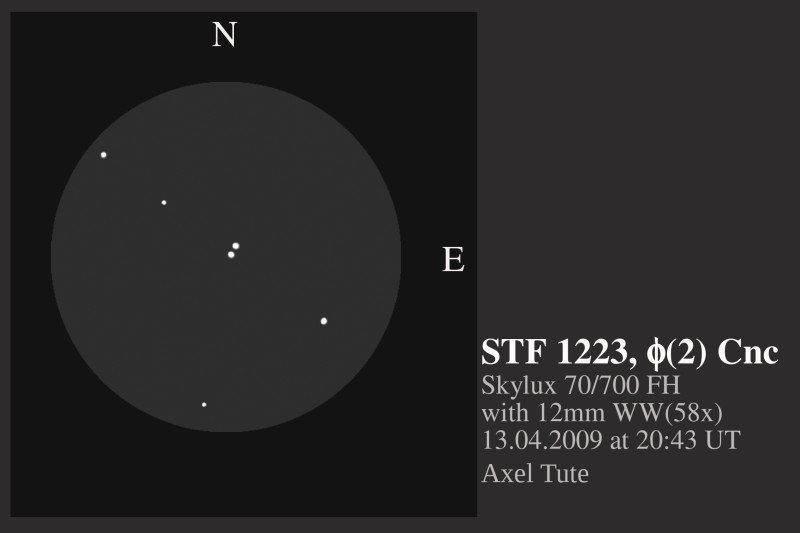
|
Uwe Pilz
Leipzig (Germany) |
105mm (28x) |
weiß und gelb |
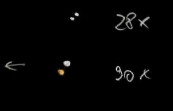
|
Uwe Pilz
Leipzig (Germany) |
105mm (88x) |
sehr schön, blauweiß-gelbweiß |
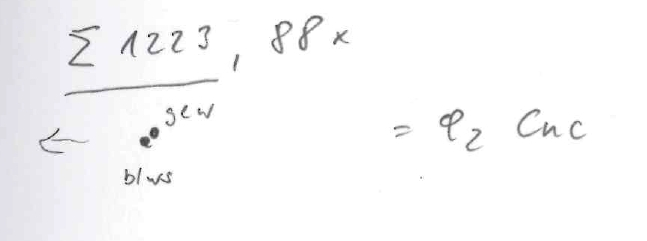
|
Mark McCarthy
Fremont (California/USA) |
508mm (205x) |
Bright white, equal, wide -- dramatic but not much. Not physical |
|
Karsten Kopp
Köln (Germany) |
600mm (180x) |
Schöner und einfach zu trennender Doppelstern, wo beide Sterne dieselbe Helligkeit haben und weißlich strahlen. Wie ein Augenpaar im All |
|
|
|
★
|
A551, LO Hya |
|
AB |
7m.0 |
7m.1 |
0.4" |
63° |
2018 |
Hya |
08h28m29.16s / -02°31'01.60" |
|
|
Mark McCarthy
Fremont (California/USA) |
508mm (1067x) |
LO Hya. With apodizing mask. Easy split, noticeable half delta mag. Another fainter star further out likely +1 [The +1 is STF 1233 AB-C, 6.42/10.49 18.3". AB at furthest extent of orbit, will tighten considerably the next 20 years] |
|
|
|
★★
|
STF1245 |
|
AB |
6m.0 |
7m.2 |
10.1" |
25° |
2020 |
Cnc |
08h35m51.05s / +06°37'13.90" |
|
|
|
|
AC |
6m.0 |
10m.7 |
99.8" |
109° |
2020 |
|
|
|
|
|
|
AD |
6m.0 |
11m.9 |
109.1" |
292° |
2020 |
|
|
|
|
|
|
AE |
6m.0 |
9m.6 |
113.2" |
207° |
2020 |
|
|
Robert Zebahl
Leipzig (Germany) |
70mm (57x) |
AB at 22x separated, but very close, uneven pair. A appeared white-yellowish, B orange, partly reddish. Opposite in a wide separation the fainter component E was visible. At 57x, A appeared white-yellowish, B orange. |

|
Axel Tute
Küssaberg (Germany) |
70mm (58x) |
AB: 13.04.2009: A: light blue, B: slightlyreddish |

|
René Merting
Drachhausen (Germany) |
100mm (32x) |
AB: bei 32x ein sehr enges Pärchen, gerade so getrennt - das Sternpaar ist heller, als viele andere Sterne in der unmittelbaren Umgebung, dadurch ist es sehr auffällig - Komponente A strahlt reinweiß, B steht dem in nichts nach, auch wenn die Komponente gut eine Magnitude schwächer ist |
|
Sarah Gebauer
Germany |
100mm (45x) |
AB: schmal, aber deutlich getrennt, die südliche Komponente sichtbar heller, die nordöstliche schwächer |
|
Axel Tute
Küssaberg (Germany) |
100mm (164x) |
AB: 10.05.2011: Observation at half moon. No colors noted. |
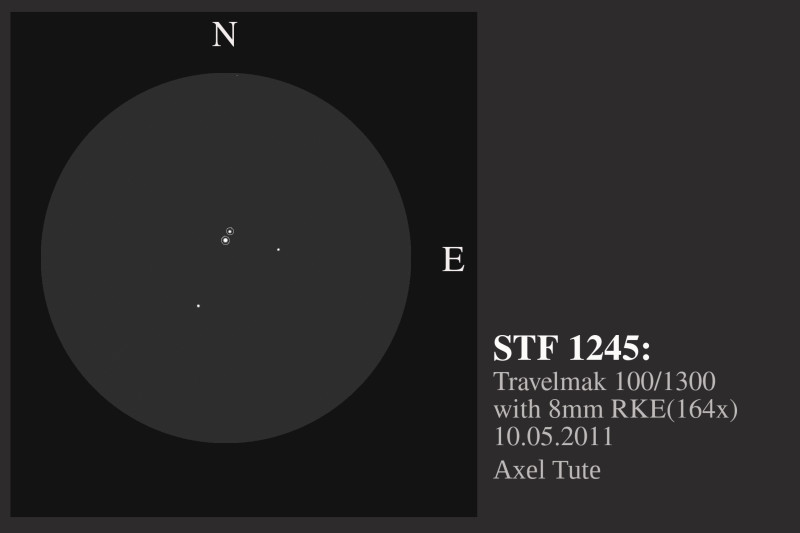
|
Uwe Pilz
Leipzig (Germany) |
105mm (88x) |
AB |

|
Mark McCarthy
Fremont (California/USA) |
508mm (533x) |
AB: Wide and bright pair, light yellow and orange, easy, slight mag difference |
|
Karsten Kopp
Köln (Germany) |
600mm (180x) |
AB: AB: Schöner und einfacher Doppelstern, wobei die Komponente A weißlich gelb und Komponente B gelblich orange leuchtet. Das Sternfeld in direkter Umgebung rundet den schönen Eindruck ab. |
|
|
|
★★
|
STF1254 |
|
AB |
6m.4 |
10m.4 |
20.8" |
55° |
2017 |
Cnc |
08h40m22.11s / +19°40'11.90" |
|
|
|
|
AC |
6m.5 |
7m.6 |
62.5" |
343° |
2018 |
|
|
|
|
|
|
AD |
6m.5 |
9m.2 |
83.5" |
44° |
2017 |
|
|
Stefan Loibl
Rosenheim (Germany) |
102mm (164x) |
septuple, visual quintuple, components A, B, C, and D split, E not visible, B not split, no colour contrast, at northern edge of Messier 44 (Praesepe) |
|
|
|
★
|
CBL32 |
|
|
7m.4 |
10m.7 |
41.0" |
174° |
2015 |
Cnc |
08h46m14.32s / +27°35'41.30" |
Mark McCarthy
Fremont (California/USA) |
317mm (553x) |
Pretty yellow-orange 8th magnitude primary, with 3x fainter blue which can be seen direct vision but blinks like a planetary nebula, so must be 11-12th mag. Wide separation. |
|
|
|
★★
|
STF1268, iota Cnc, 48 Cnc |
|
|
4m.1 |
6m.0 |
30.6" |
308° |
2021 |
Cnc |
08h46m41.82s / +28°45'35.60" |
Christopher Hay
Seeheim (Germany) |
10x42 |
Binoculars with internal stabilisation, handheld. Secondary a pinprick of light directly next to the overpowering primary. Slightly uncertain, but PA as seen confirmed afterwards in database. In stabilised 15x45 binoculars the pair is well split, primary white tending towards yellow, secondary substantially colder.
A physical double at a distance to us of 331 light years. |
|
Christopher Hay
Seeheim (Germany) |
15x60 |
On tripod. Well split. Primary very pale yellow, secondary very pale blue. A most striking pair. |
|
Robert Zebahl
Leipzig (Germany) |
70mm (22x) |
Striking, widely separated with noticeable difference in brightness. Moderate but beautiful color contrast: white-yellowish and grey-bluish. |
|
Christopher Hay
Seeheim (Germany) |
71mm (32x) |
Compact pair. Yellow, pale blue. Totally dominates 2.2° FOV. |
|
René Merting
Drachhausen (Germany) |
76mm (57x) |
bei 29x zeigt sich A strahlend gelb, bei Konzentration auf A zeigt bei einen schönen mintgrünen Farbton - B ist gut 1.5 Magnituden schwächer - bei 57x verstärkt sich der Farbeindruck bei der B-Komponente, aber eher, wenn ich den Stern flüchtig betrachte |
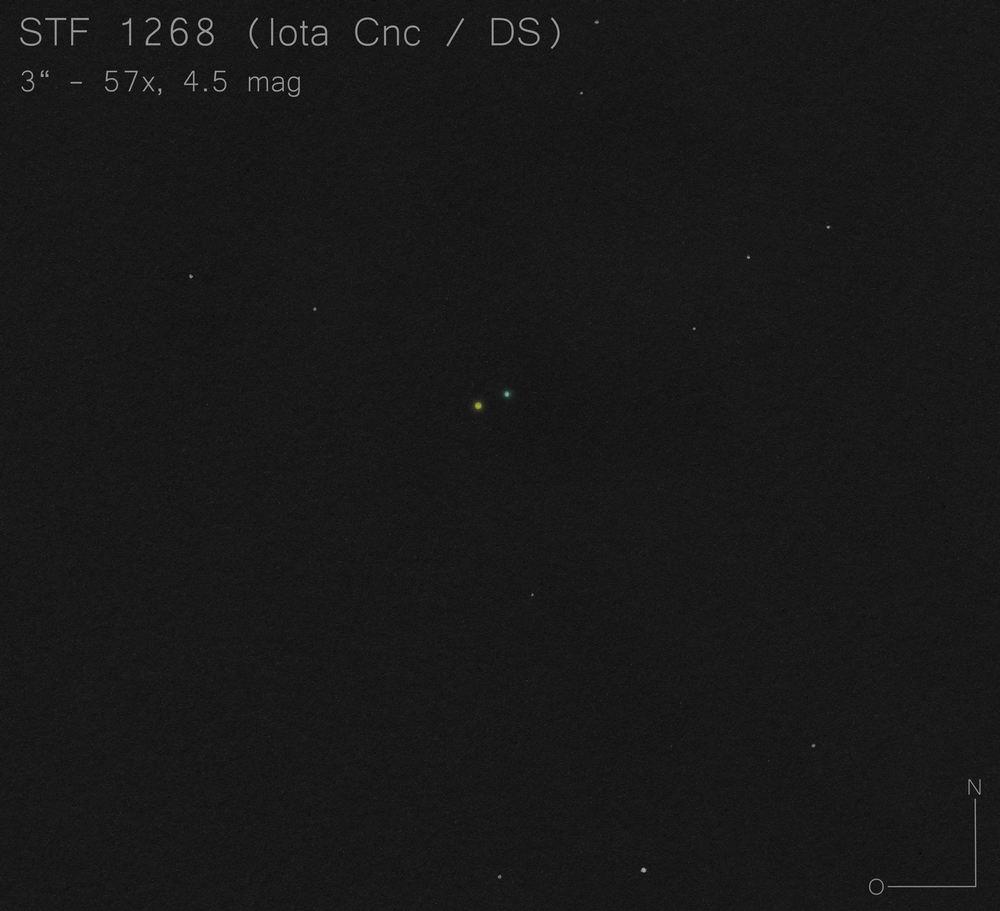
|
Axel Tute
Küssaberg (Germany) |
100mm (19x) |
13.04.2009: A: bluish, B: reddish |
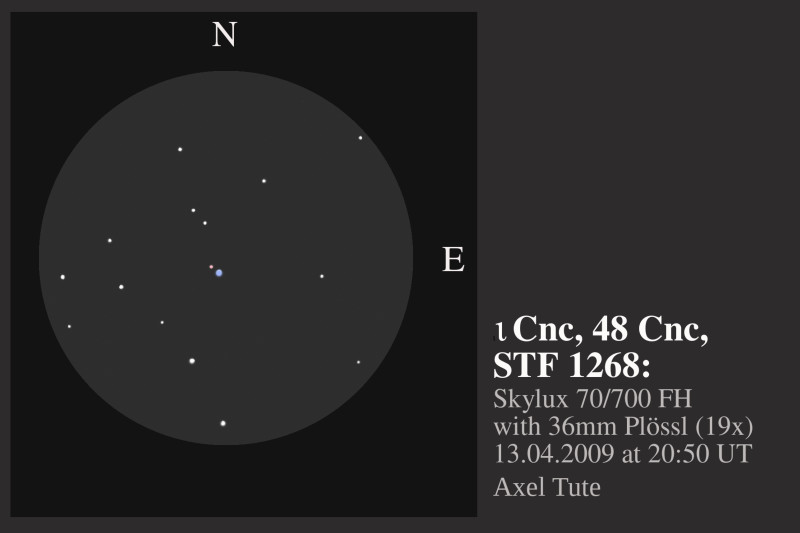
|
Sarah Gebauer
Germany |
100mm (20x) |
schon bei 20-fach schön getrennt mit einem schönen, warmen, gelben Farbton - bei 49-fach zeigt sich dann der Kontrast zu einem leicht hellgrau bis hellblauen Begleiter, während die Hauptkomponente sehr viel heller wird und warmgelb bleibt |

|
Robert Zebahl
Leipzig (Germany) |
102mm (28x) |
Grand sight! Pretty wide apart and unequal. A: mild orange, B: very nice light blue. |
|
Stefan Loibl
Rosenheim (Germany) |
102mm (164x) |
wide pair with nice colour contrast yellow/blue |
|
Uwe Pilz
Leipzig (Germany) |
105mm (28x) |
fahlblau und gelborange |

|
Uwe Pilz
Leipzig (Germany) |
105mm (144x) |
gelb-blaugrau |

|
Sarah Gebauer
Germany |
150mm (125x) |
bei 83x schon deutlich getrennt, der Farbkontrast ist gut zu sehen, er wird bei 125x noch stärker, ein zartes Blau und Gelb sind zu sehen |
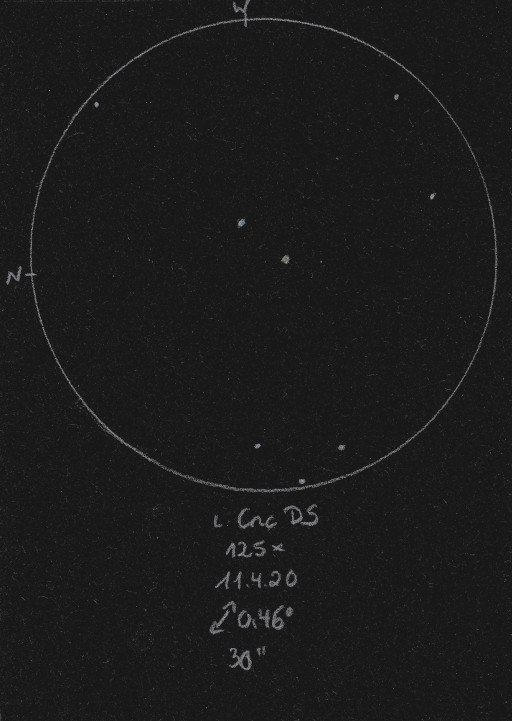
|
Mark McCarthy
Fremont (California/USA) |
317mm (553x) |
Iot Cnc: Pretty orange and pale blue, showpiece object. |
|
|
Frederik Wanink
Itterbeck (Germany) |
254mm |
|
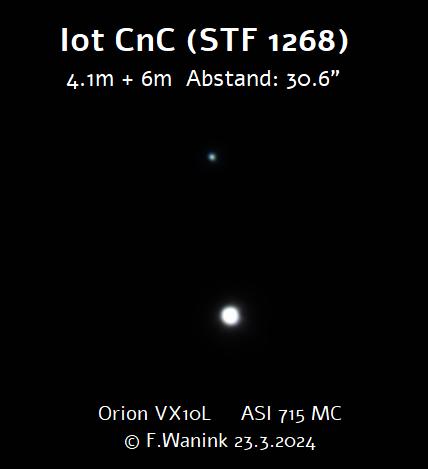
|
|
|
★★★
|
11 Hya, epsilon Hya |
SP1 |
AB |
3m.5 |
5m.0 |
0.1" |
324° |
2021 |
Hya |
08h46m46.51s / +06°25'07.70" |
|
|
|
STF1273 |
AB-C |
3m.5 |
6m.7 |
2.9" |
311° |
2020 |
|
|
|
|
|
STF1273 |
AB-D |
3m.5 |
12m.5 |
18.1" |
201° |
2017 |
|
|
|
|
|
STF1273 |
AB-E |
3m.5 |
10m.8 |
340.5" |
2° |
2015 |
|
|
|
|
|
STF1273 |
AB-F |
3m.5 |
10m.4 |
406.5" |
265° |
2015 |
|
|
|
|
Robert Zebahl
Leipzig (Germany) |
70mm (133x) |
AB-C: Not split. Although a slight brightening was visible in the first diffraction ring, it could also have come from slight coma of the refractor. |
|
Sarah Gebauer
Germany |
100mm (200x) |
AB-C: ist ein heller Stern vom Hydra-Kopf, nicht zu trennen, vermutlich, weil die Komponente AB zu hell strahlt |
|
Robert Zebahl
Leipzig (Germany) |
102mm (160x) |
AB-C: 2020-03-27: The much fainter companion is well visible as an almost round knot directly at the diffraction ring of the primary component. Very nice sight. The seeing was mediocre (3/5). |
|
Uwe Pilz
Leipzig (Germany) |
105mm (200x) |
AB-C: bei 144x schwierig |
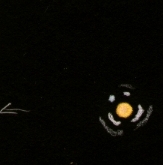
|
Robert Zebahl
Leipzig (Germany) |
152mm (150x) |
AB-C: 2020-03-27: The companion is immediately visible as a tiny star close to the primary component. Due to the chromatic aberration of the achromat, there is a slight tendency to outshine. Nevertheless a nice view. The seeing was mediocre (3/5). |
|
Mark McCarthy
Fremont (California/USA) |
508mm (533x) |
AB-C: Epsilon Hya A is bright orange-yellow, B is much fainter and a little blue, ~3". [SP 1 AB is 3.49/5.00 0.2" not seen] |
|
|
|
★
|
AGC3, rho Hya |
|
|
4m.4 |
11m.9 |
12.1" |
146° |
2016 |
Hya |
08h48m25.98s / +05°50'16.40" |
Mark McCarthy
Fremont (California/USA) |
508mm (533x) |
Rho Hya Bright white A star and much fainter B star, but it's still a hard bluish point very fine. Nice one |
|
|
|
★
|
A2550 |
|
|
9m.5 |
9m.8 |
0.4" |
204° |
1996 |
Hya |
08h48m35.67s / +03°04'05.20" |
Mark McCarthy
Fremont (California/USA) |
508mm (533x) |
Wow exceptionally fine pair. B is very faint but can hold direct vision after flashing it out using averted vision. Very close, hairline split, amazing pair. At 1067x the stars dim a little can still see B but need averted vision all the time |
|
|
|
★
|
A2552 |
|
|
9m.1 |
8m.5 |
0.3" |
208° |
2018 |
Hya |
08h48m40.30s / +00°56'31.00" |
|
|
Mark McCarthy
Fremont (California/USA) |
508mm (533x) |
Wow fine split. Pale yellow A and blue B, about one delta mag. Nice split, amazing [82.4 year period] |
|
|
|
★
|
STTA96 |
|
AB |
7m.7 |
8m.4 |
50.0" |
312° |
2018 |
Cnc |
08h52m00.46s / +25°43'07.40" |
|
|
|
|
AC |
7m.7 |
10m.7 |
35.6" |
267° |
2015 |
|
|
|
|
|
|
BC |
8m.4 |
10m.7 |
36.5" |
179° |
2015 |
|
|
René Merting
Drachhausen (Germany) |
76mm (29x) |
AB: bei 29x ein gut getrenntes Paar - A im Südosten ist eine halbe bis dreiviertel Größenklasse heller - leichter Farbunterschied - bei 57x ist A flüchtig betrachtet hellorange, B wirkt blaugrau
AC: bei 81x kann ich die C-Komponente südwestlich von den beiden Sternen erkenne, sie bildet ein flaches Dreieck mit A und B |
|
Sarah Gebauer
Germany |
100mm (49x) |
AB: bei 49-fach weit getrennt - das Pärchen stellt für mich die Äuglein eines Mäuschens dar, die sehr viel schwächere Nase befindet sich südwestlich der beiden Komponenten - die südöstliche Doppelsternkomponente scheint etwas heller und etwas wärmer im Farbton, die nordwestliche etwas kühler und dumpfer in einem ganz zarten Hellorange |
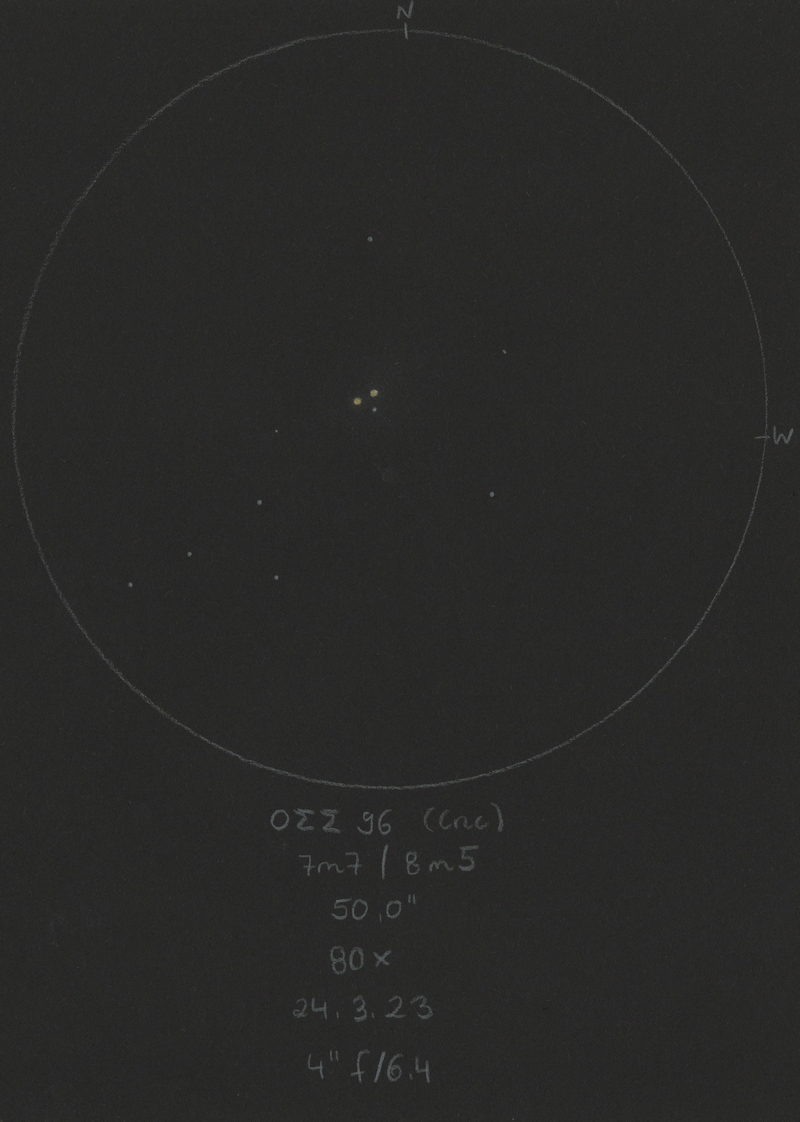
|
|
|
★
|
HJ460, 53 Cnc |
|
AB |
6m.5 |
11m.7 |
43.7" |
335° |
2003 |
Cnc |
08h52m28.60s / +28°15'33.00" |
|
|
|
|
AC |
6m.5 |
6m.0 |
276.8" |
20° |
2011 |
|
|
Christopher Hay
Seeheim (Germany) |
7x45 |
AC: Very wide. C is cold blue, A warmer and weaker.
AC is Rho1 Cnc. C is 55 Cnc, aka Copernicus AB, home to five exoplanets, fairly close to us at a distance of only 41 light years. |
|
Christopher Hay
Seeheim (Germany) |
10x42 |
AC: Binoculars with internal stabilisation, handheld. C is light blue, A brownish-orange. Attractive in 6.5° FOV together with 57 and 61 Cnc and Iota Cnc less than 2° to the west, which is split. |
|
Christopher Hay
Seeheim (Germany) |
15x60 |
AC: On tripod. A wide matching pair. Component A (53 Cnc) seems reddish. Nice together with well-split Iota Cnc in 3.3° FOV. |
|
René Merting
Drachhausen (Germany) |
76mm (57x) |
AC: bei 29x ein weit auseinander stehendes Paar - bei genauer Betrachtung wirkt C im Norden leicht gelblich und A im Süden irgendwie farbiger, dunkler im Farbton als A - interessant wird es dann bei 57x, A erscheint hellgelb und B kommt mit einem Stich ins Orange aber auch roséfarben daher |
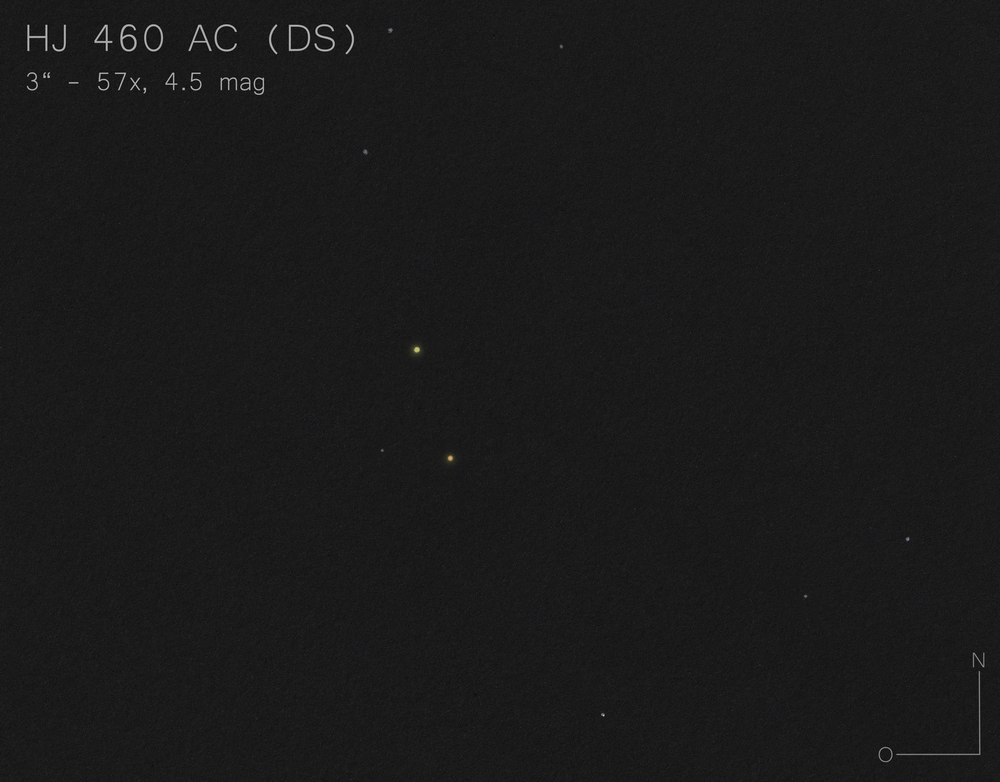
|
Sarah Gebauer
Germany |
100mm (49x) |
AC: bei 49-fach ein gleich helles Pärchen mit riesigem Abstand und einem warmweißen Farbton mit einem Stich ins Gelbliche, vielleicht ganz leicht kupferfarben - bei 20-fach passt er schön zusammen mit dem reizvollen Doppelstern Iota Cnc in ein GF, besonders schön! |
|
Mark McCarthy
Fremont (California/USA) |
317mm (553x) |
AB: 53 Cnc: Orange primary and 2x fainter blue, wide separation (this is AB). There is a second orange-yellow star of about the same magnitude very wide separation (this is AC). |
|
|
|
★
|
STF1291, 57 Cnc |
|
AB |
6m.1 |
6m.4 |
1.5" |
310° |
2019 |
Cnc |
08h54m14.65s / +30°34'45.80" |
|
|
|
|
AB-C |
5m.5 |
9m.2 |
54.6" |
204° |
2015 |
|
|
|
|
Robert Zebahl
Leipzig (Germany) |
70mm (133x) |
AB: Immediately apparent as a double star. Diffraction disks overlapping slightly ('8'). Difference in brightness visible. |
|
Uwe Pilz
Leipzig (Germany) |
105mm (144x) |
gelb |
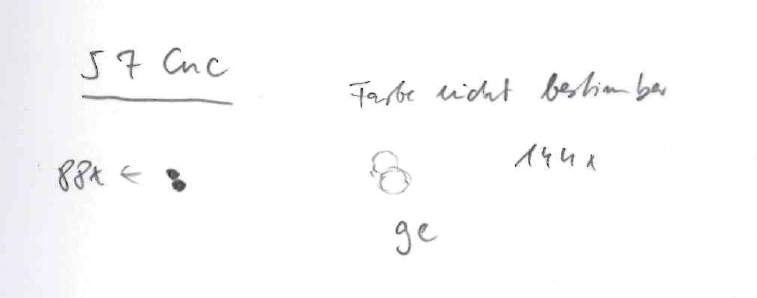
|
Sarah Gebauer
Germany |
150mm (125x) |
AB: sowohl bei 83x als auch bei 125x knapp vorm Trennen |
|
Mark McCarthy
Fremont (California/USA) |
203mm (205x) |
AB: 57 Cnc. Very nice pair, strong orange yellow colors, ~1 delta mag, bright, nice close split |
|
|
|
★
|
SHY204, 62/63 Cnc, omicron Cnc, omicron 1/2 Cnc |
|
|
5m.2 |
5m.7 |
975.6" |
17° |
2016 |
Cnc |
08h57m14.95s / +15°19'21.90" |
René Merting
Drachhausen (Germany) |
naked eye |
anfangs eine länglich schimmernde Lichtquelle - indirekt sind dann zwei schwache Sterne erkennen |
|
Christopher Hay
Seeheim (Germany) |
2x54 |
Wide apart, Omicron clearly brighter than 63 Cnc. Nice together with Praesepe (M 44) and the Head-of-the-Hydra asterism in 25° FOV.
Shaya 204, comprising Omi Cnc and 63 Cnc, is a physical double at a distance to us of 149 light years. Presumably separable naked-eye if NELM allows, the limiting factor being the 5m7 of 63 Cnc. |
|
Christopher Hay
Seeheim (Germany) |
7x45 |
Super-wide, but still holding together as a pair. Both are bluish-white. |
|
René Merting
Drachhausen (Germany) |
12x42 |
ein weit getrenntes Paar - die schwächere Komponente im Norden wirkt kühlweiß, die südlichere warmweiß |
|
Christopher Hay
Seeheim (Germany) |
15x60 |
On tripod. No particular gain anticipated over 7x45 view, but in fact in the tighter 3.3° FOV the pair is quite charming, the field sprinkled liberally with many fainter stars. Both components (i.e. Omi Cnc and 63 Cnc) have an identical bluish-white hue, very pretty. |
|
René Merting
Drachhausen (Germany) |
18x70 |
beide Sterne sind weit getrennt, die südliche Komponente wirkt etwas heller und wirkt warmweiß, die nördliche eher kaltweiß (lt. StelleDoppie aber umgedreht, nämlich A5 und F0) |
|
|
|
★★
|
BU408 |
|
|
7m.3 |
9m.6 |
2.8" |
345° |
2018 |
UMa |
08h59m00.62s / +63°25'42.80" |
René Merting
Drachhausen (Germany) |
100mm (142x) |
bei 107x ist nordöstlich von A ein Helligkeitspeak erkennbar, aber nicht richtig greifbar - bei 142x dann zeigt sich in ruhigen Momenten die schwächere Komponente knapp abgesetzt von A - großer Helligkeitsunterschied, mindestens 2.5 Größenklassen |
|
Mark McCarthy
Fremont (California/USA) |
178mm (205x) |
A fine pair, white bright A and faint B about 3", 3 delta mag |
|
Mark McCarthy
Fremont (California/USA) |
317mm (553x) |
BU 408 is the fainter star in a pair pair of near equal stars in finder view, red-orange color. In the scope the B is a blue star 3" out from the orange star. |
|
|
|
★
|
STF1298, 66 Cnc |
|
AB |
6m.0 |
8m.6 |
4.4" |
137° |
2017 |
Cnc |
09h01m24.13s / +32°15'08.30" |
|
|
|
|
AC |
6m.0 |
12m.0 |
186.8" |
319° |
2017 |
|
|
Robert Zebahl
Leipzig (Germany) |
70mm (80x) |
AB: At 67x and 80x the companion is visible as a very faint star close to the main component. At 133x it is only visible as a slightly blurred tiny star just outside the first diffraction ring of the primary component. |
|
René Merting
Drachhausen (Germany) |
76mm (57x) |
AB: bei 57x schön anzusehen, wie südöstlich der Hauptkomponente eine ganz schwache 3 Magnituden schwächere Murmel erscheint - B wirkt wie ein kleiner Schatten - das Ganze spielt sich in einem schönen Sternumfeld ab |
|
Robert Zebahl
Leipzig (Germany) |
102mm (62x) |
AB: At 62x clearly separated, significant difference in brightness. The companion can be seen well as a faint little star, apart from the primary component. At 125x easy to split. Component A appeared rather white. |
|
Mark McCarthy
Fremont (California/USA) |
203mm (205x) |
AB: 66 Cnc. Excellent pair. A is a pure white, B is much fainter and seems red to purple color, nicely separated |
|
|
|
★
|
A1585, kap UMa |
|
|
4m.2 |
4m.5 |
0.3" |
278° |
2019 |
UMa |
09h03m37.56s / +47°09'24.00" |
Mark McCarthy
Fremont (California/USA) |
508mm (1067x) |
Kappa UMa = Talitha australis: With apodizing mask. Much glare but snowman seen steadily inside the mess. Looks like Eta Carina nebula, with a larger bulge toward us and the smaller bulge pointed up and away. No field stars at this magnification, went down to 533x to notice one for the sketch |
|
|
|
★
|
STF1311 |
|
AB |
6m.9 |
7m.1 |
7.5" |
199° |
2019 |
Cnc |
09h07m27.01s / +22°58'51.10" |
Axel Tute
Küssaberg (Germany) |
70mm (58x) |
13.04.2009: Clear space in between. Both white |
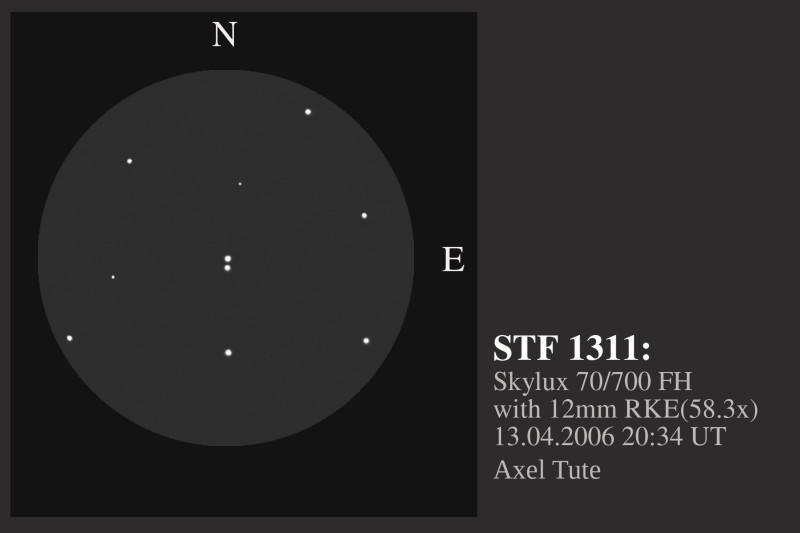
|
Christopher Hay
Seeheim (Germany) |
100mm (44x) |
Well split, very striking pair dominating 1.9° FOV when placed at centre of field.
A common proper motion pair 190 distant to us. |
|
Mark McCarthy
Fremont (California/USA) |
203mm (205x) |
Milk white A and off-white, yellowish B, ~1 delta mag, well separated |
|
|
|
★★
|
STF1306, sigma 2 UMa, 13 UMa |
|
AB |
4m.9 |
8m.8 |
4.4" |
346° |
2020 |
UMa |
09h10m23.53s / +67°08'03.30" |
|
|
|
|
AC |
4m.9 |
10m.3 |
197.8" |
148° |
2003 |
|
|
|
|
Robert Zebahl
Leipzig (Germany) |
70mm (100x) |
AB: Companion almost permanently visible as elongated, non-condensed brightening of the first diffraction ring of the primary component at the correct position angle. |
|
Christopher Hay
Seeheim (Germany) |
76mm (20x) |
AB, April 2021: No luck with AB at all magnifications from 83x to 167x.
AC: Component C very faint and quite distant, not really seeming to belong. |
|
Mark McCarthy
Fremont (California/USA) |
80mm (150x) |
AB: Suspected very close unequal white stars. 920-year period, slowly widening |
|
Uwe Pilz
Leipzig (Germany) |
105mm (144x) |
AB: sehr schwierig bei 88x |

|
|
|
★★
|
STF1321 |
|
AB |
7m.8 |
7m.9 |
16.9" |
99° |
2019 |
UMa |
09h14m22.79s / +52°41'11.80" |
|
|
|
|
AC |
7m.8 |
14m.5 |
145.7" |
64° |
2010 |
|
|
|
|
|
|
AD |
7m.8 |
11m.9 |
136.4" |
129° |
2015 |
|
|
|
|
Robert Zebahl
Leipzig (Germany) |
16x70 |
AB: 2020-07-05: Very nice view, striking, easily separable. A slight difference in brightness is visible. At first glance the double star appeared noticeably orange compared to the surrounding stars, on closer look a color difference of the two components was visible: orange & rather white. |
|
Robert Zebahl
Leipzig (Germany) |
70mm (22x) |
AB: 2020-04-11: At 22x pretty wide pair with equally bright components. Striking colors: slightly orange & white-bluish, but it was a bit difficult to assign the colors to the components. At 44x slightly better color perception. |
|
Robert Zebahl
Leipzig (Germany) |
70mm (31x) |
AB: 2020-04-19: Together with STF1312 in one field of view. At 22x very nice sight, easy to separate, attractive separation. Immediately apparent. A color difference is visible: dark yellow, orange. Also beautiful to see at 44x. Best view at 31x. |
|
Christopher Hay
Seeheim (Germany) |
71mm (32x) |
AB: April 2021: Well split, matched pair. Both orangish.
With 180mm at 200x a wide, even, strong pair. Component A is noticeably slightly brighter. Both of identical pale mandarine-orange colour, rather captivating. |
|
René Merting
Drachhausen (Germany) |
76mm (29x) |
bei 29x ein wunderschön eng stehendes Sternpaar - bei beiden Sternen fällt sofort auf, dass sie nicht weiß sind - der westliche Stern strahlt intensiver, aber ein genauer Farbeindruck lässt sich nicht festmachen |
|
Sarah Gebauer
Germany |
100mm (49x) |
AB: bei 21-fach getrennt - zwei ganz feine Murmelchen, dicht beieinander - zunächst ein spontan warm orangefarbener Eindruck, bei näherem Hinsehen ist B goldorange, A leicht roségold - bei 49-fach verstärkt sich der Farbeindruck deutlich hin zu Orange mit Roségold - steht das Pärchen mittig im Gesichtsfeld, befinden sich ein paar wunderschön versprenkelte Sterne mit im Bild, das Pärchen dominiert jedoch durch seine Helligkeit und Farbe |
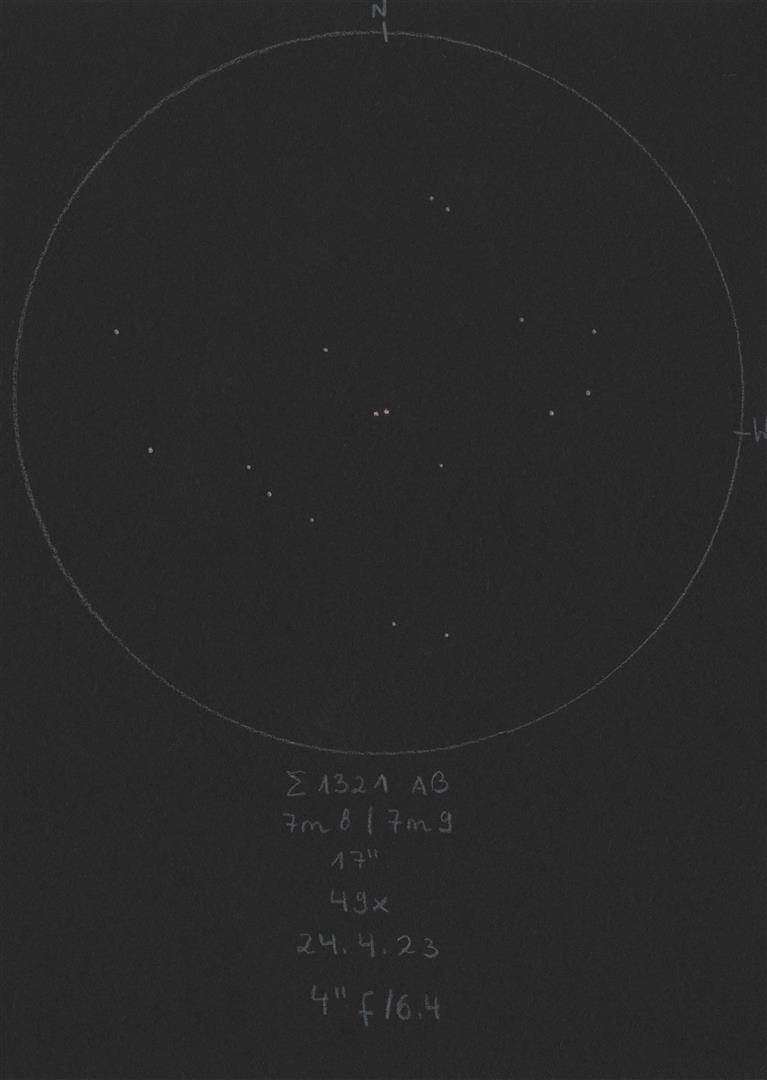
|
|
|
★
|
STF3121 |
|
AB |
7m.9 |
8m.0 |
0.5" |
220° |
2021 |
Cnc |
09h17m53.45s / +28°33'37.70" |
|
|
Mark McCarthy
Fremont (California/USA) |
508mm (533x) |
IP Cnc Split at 533x, used 1067x to recheck orientation. With apodizing mask. Light yellow-orange stars, nice and clean split, very slight mag difference. Real nice |
|
Mark McCarthy
Fremont (California/USA) |
508mm (533x) |
IP Cnc. Light yellow-orange stars, 1 delta mag, clean well split. 34.17-year period, it's coming off apastron and will make a quarter turn by 2030. PA to the NE |
|
|
|
★
|
STF1333 |
|
|
6m.6 |
6m.7 |
1.8" |
50° |
2018 |
Lyn |
09h18m25.97s / +35°21'51.30" |
Robert Zebahl
Leipzig (Germany) |
63mm (120x) |
At 93x seen as '8', at 120x split, but pretty tight with no visible difference in brightness. |
|
Christopher Hay
Seeheim (Germany) |
71mm (32x) |
Elongated with clear PA. |
|
Uwe Pilz
Leipzig (Germany) |
105mm (200x) |
fast gleich hell, beide gelblich, bei 66x schwierig |
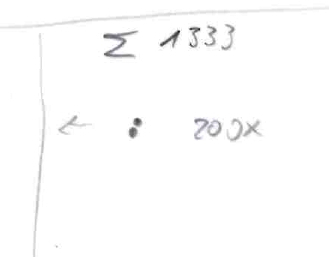
|
Christopher Hay
Seeheim (Germany) |
180mm (113x) |
Hairfine split, evenly matched pair, rather attractive. No particular colour. |
|
Mark McCarthy
Fremont (California/USA) |
508mm (333x) |
Brilliant white pair, near equal, ~2" separation |
|
|
|
★
|
HO43 |
|
|
9m.3 |
9m.5 |
0.6" |
97° |
2017 |
Cnc |
09h18m36.25s / +20°48'49.40" |
|
|
Mark McCarthy
Fremont (California/USA) |
508mm (410x) |
Fine white stars, not quite 1 delta mag, very nice clean split. Wow. Physical with 358.6-year period, it will widen a couple tenths in the next 20 years |
|
|
|
★
|
STF1334, 38 Lyn |
|
AB |
3m.9 |
6m.1 |
2.6" |
224° |
2019 |
Lyn |
09h18m50.64s / +36°48'09.30" |
|
|
Uwe Pilz
Leipzig (Germany) |
60mm (198x) |
Aufhellung im ersten Ring |
|
Robert Zebahl
Leipzig (Germany) |
63mm (140x) |
Fainter companion only seen as permanent brightening on the first diffraction ring. |

|
Christopher Hay
Seeheim (Germany) |
71mm (32x) |
Figure-8 with clear positions and delta-mags of components. Bluish-white. |
|
Uwe Pilz
Leipzig (Germany) |
105mm (288x) |
gelb, trennbar bei 66x |
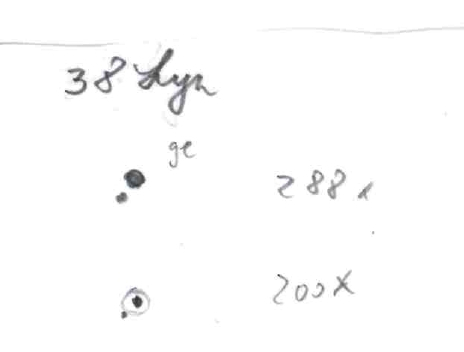
|
Mark McCarthy
Fremont (California/USA) |
178mm (205x) |
Very bright light blue A and 3 delta magnitude greenish B, close, about 3" separation. Physical with 2782 year period |
|
Christopher Hay
Seeheim (Germany) |
180mm (113x) |
Clean split, large delta-mag. Separation ca. 1.5 times that of nearby STF1333. |
|
|
|
★
|
27 Hya |
SHJ105 |
AB |
4m.9 |
7m.0 |
229.1" |
211° |
2015 |
Hya |
09h20m29.03s / -09°33'20.30" |
|
|
|
GUI13 |
AD |
4m.9 |
16m.9 |
122.3" |
227° |
2015 |
|
|
|
|
|
DOO49 |
BC |
7m.0 |
11m.0 |
9.2" |
199° |
2016 |
|
|
Christopher Hay
Seeheim (Germany) |
7x45 |
AB: Handheld. AB wide, very disparate brightnesses. Secondary bluish.
A physical double at a distance to us of 222 light years. |
|
|
|
★★
|
STF1347 |
|
|
7m.3 |
8m.3 |
21.1" |
312° |
2016 |
Hya |
09h23m15.76s / +03°30'05.00" |
Robert Zebahl
Leipzig (Germany) |
70mm (22x) |
2020-04-10: At 22x beautifully separated at moderate separation and difference in brightness. Primary component appeared white-bluish, companion slightly orange. At 44x the primary component looked more white-yellowish, the companion showed a clear tendency to orange. |
|
René Merting
Drachhausen (Germany) |
100mm (20x) |
bei 32x ein auffälliges Sternpaar - Komponente B im Nordwesten ist gut abgesetzt erkennbar und ca. ein 3/4 Größenklasse schwächer - bei 20x rücken die beiden Sterne richtig schön zusammen und sind noch knapp getrennt erkennbar |
|
Uwe Pilz
Leipzig (Germany) |
105mm (88x) |
sehr schöner Farbkontrast |

|
|
|
★★
|
STF1348 |
|
AB |
7m.5 |
7m.6 |
2.0" |
314° |
2018 |
Hya |
09h24m28.48s / +06°21'01.80" |
|
|
Robert Zebahl
Leipzig (Germany) |
70mm (100x) |
2020-04-10: At 67x clearly elongated, at 80x clearly visible as figure '8'. At 100x a very small difference in brightness was to be guessed, at 133x visible. Near the double star STF 1355. |
|
Uwe Pilz
Leipzig (Germany) |
105mm (144x) |
Im selben Aufsuchfeld wie stf1355, ähnliche Erscheinung |
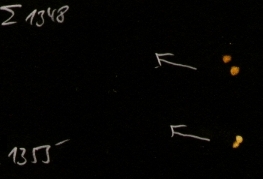
|
Mark McCarthy
Fremont (California/USA) |
203mm (333x) |
Very pretty half delta mag, ~2" pair, white. Sharp despite low declination |
|
|
|
★
|
BU105, kappa Leo, 1 Leo |
|
AB |
4m.6 |
9m.7 |
2.0" |
209° |
2015 |
Leo |
09h24m39.28s / +26°10'56.80" |
|
|
|
|
AC |
4m.6 |
11m.1 |
147.7" |
212° |
2015 |
|
|
Uwe Pilz
Leipzig (Germany) |
105mm (180x) |
AB: Begleiter sitzt im ersten Ring |
|
Robert Zebahl
Leipzig (Germany) |
152mm (300x) |
AB: 2020-04-22: The seeing (2-3/5) was not good enough. The diffraction disk was reasonably well visible, but the diffraction rings smudged. No split. |
|
Robert Zebahl
Leipzig (Germany) |
152mm (300x) |
AB: 2020-04-24: Seeing was mediocre (3/5). The faint companion was partly seen as a distinct brightening in the first diffraction ring of the primary component. Not at all easy. Steady air necessary. |
|
Mark McCarthy
Fremont (California/USA) |
178mm (148x) |
AB: Very tough, B is a very tiny point or fleck very closely split, need low power to reduce flaring from bright light yellow-orange A. Burnham discovered with his 6-inch and says: "A fine pair even with a small aperture." |
|
Mark McCarthy
Fremont (California/USA) |
317mm (553x) |
AB: Kappa Leonis: Very tough but palpable split. Seeing needed to settle to perfection for primary to resolve to just an airy disk without diffraction or flaring, and for a couple of seconds could see the much fainter ~10th magnitude B star as a pin-point, ~2" separation. Fleeting view. |
|
|
|
★★
|
STT200 |
|
|
6m.5 |
8m.6 |
1.2" |
336° |
2019 |
UMa |
09h24m55.67s / +51°34'26.10" |
Mark McCarthy
Fremont (California/USA) |
317mm (553x) |
Light orange A, B a deeper orange, maybe because it's 2-3x fainter. B resolves from within A's diffraction when seeing settles, ~1". Wow! |
|
|
Frederik Wanink
Itterbeck (Germany) |
254mm |
|

|
|
|
★★
|
STF1355 |
|
|
7m.7 |
7m.8 |
1.7" |
356° |
2021 |
Hya |
09h27m16.69s / +06°13'59.00" |
|
|
Robert Zebahl
Leipzig (Germany) |
70mm (100x) |
2020-04-10: At 67x clearly elongated, equally bright. At 80x detectable notch. At 100x and 133x clearly visible as figure '8'. Near the double star STF 1348. |
|
Uwe Pilz
Leipzig (Germany) |
105mm (144x) |
Im selben Aufsuchfeld wie stf1348, ähnliche Erscheinung |

|
Mark McCarthy
Fremont (California/USA) |
203mm (333x) |
Light yellow pair, near equal, very nice, ~2" |
|
|
|
★
|
HJ1167, tau 1 Hya, 31 Hya |
|
|
4m.6 |
7m.3 |
65.7" |
4° |
2016 |
Hya |
09h29m08.84s / -02°46'08.20" |
Christopher Hay
Seeheim (Germany) |
15x45 |
Binoculars with internal stabilisation, handheld. Wide, almost exactly north-south oriented. Primary slightly yellowish.
A physical double at a distance to us of only 57 light years. |
|
|
|
★
|
BU591 |
|
|
7m.8 |
8m.9 |
1.0" |
29° |
2017 |
Hya |
09h29m36.43s / -03°07'20.40" |
Mark McCarthy
Fremont (California/USA) |
203mm (333x) |
Very nice pair. Split with seeing, noticable mag difference, hairline only |
|
|
|
★★
|
STF1360 |
|
AB |
8m.9 |
8m.9 |
13.8" |
242° |
2017 |
Leo |
09h30m35.95s / +10°36'06.40" |
|
|
|
|
AC |
8m.9 |
13m.4 |
104.8" |
76° |
2017 |
|
|
|
|
|
|
AD |
8m.9 |
11m.8 |
176.4" |
61° |
2017 |
|
|
René Merting
Drachhausen (Germany) |
18x70 |
AB: bei genauem Hinsehen zeigen sich zwei ganz schwache Pünktchen, knapp getrennt - beide sind gleich hell |
|
Sarah Gebauer
Germany |
100mm (21x) |
AB: bei 49-fach ganz feine, schwache Pünktchen ohne Farbeindruck - auf den ersten Blick ist auch nur ein dünner Stern zu sehen, nach kurzem, konzentriertem Hinsehen sind es dann doch sehr deutlich zwei besonders feine, gleich helle Sternpünktchen nebeneinander - die Farbwahrnehmung ist nicht einfach - bei 21-fach gelingt die Farbbestimmung besser, die Sterne zeigen einen ganz schwachen kupferroten Farbton - der Reiz liegt im genauen Hinsehen |
|
Mark McCarthy
Fremont (California/USA) |
203mm (205x) |
AB: GS Leo. Wide, light orange-yellow, near equal |
|
Mark McCarthy
Fremont (California/USA) |
317mm (553x) |
AB: Unremarkable wide separation 8th mag stars. |
|
|
|
★
|
STF1349 |
|
|
7m.5 |
9m.0 |
19.2" |
166° |
2015 |
UMa |
09h31m09.89s / +67°32'28.40" |
René Merting
Drachhausen (Germany) |
18x70 |
einfacher als der benachbarte Doppelstern STF 1350 - ordentlich getrennt - Komponente B ist 1 bis 1.5 Größenklassen schwächer |
|
Christopher Hay
Seeheim (Germany) |
60mm (25x) |
At 25x a wide split, substantial difference in brightness, B a fine pinprick of light. B appears light blue at first, but colour impression disappears quickly - an interesting visual effect repeated several times. According to Stelledoppie a true physical pair. Nice together with Struve 1350 in same FOV. A very fine double-double for very small apertures. |
|
Robert Zebahl
Leipzig (Germany) |
70mm (22x) |
2020-04-19: At 22x easy to separate with significant difference in brightness. The primary component appears whitish, the companion darker. At 44x, the primary component looks rather white-yellowish, the companion greyish. |
|
René Merting
Drachhausen (Germany) |
100mm (32x) |
bei 32x stehen beide Sterne bequem getrennt auseinander - Komponente B im Süden ist eine knappe Größenklasse schwächer und kupfergrau - ein schönes Doppel-Doppel zusammen mit STF1350 gut 47' weiter südsüdöstlich |
|
Uwe Pilz
Leipzig (Germany) |
105mm (88x) |
sichtbar bei 21x |

|
René Merting
Drachhausen (Germany) |
320mm (45x) |
bei 45x steht das Pärchen gut auseinander - Komponente B ist eine dreiviertel Größenklasse schwächer und wirkt grauweiß - A ist weiß mit einem zarten Stich ins Gelbe |
|
|
|
★★★
|
SHJ107, 6 Leo |
|
|
5m.2 |
9m.3 |
37.1" |
77° |
2018 |
Leo |
09h31m57.58s / +09°42'56.80" |
René Merting
Drachhausen (Germany) |
10x32 |
B ist ganz schwach westlich von A erkennbar, ein bisschen mehr als knapp abgesetzt - mitunter ist das Erkennen von B ein Geduldsspiel |
|
René Merting
Drachhausen (Germany) |
12x42 |
Komponente B ist sehr schwach und zeigt sich östlich von A ordentlich abgesetzt - ein sehr ungleiches Paar, A ist sehr hell und strahlt warmweiß bis gelbweiß |
|
René Merting
Drachhausen (Germany) |
18x70 |
auch 6 Leo - die A-Komponente strahlt sehr auffällig in einem hellen Gelb, B zeigt sich ganz schwach ost-nordöstlich - Trennung ordentlich - Helligkeitsunterschied nicht abschätzbar |
|
Sarah Gebauer
Germany |
100mm (49x) |
in Aufsuchvergrößerung zeigt der Stern ein schönes Kupferorange, der Begleiter ist extremst schwach dagegen, aber getrennt östlich bei genauem Hinsehen zu erkennen - bei 49-fach ist die Trennung dann weit - die Hauptkomponente bleibt wunderschön Goldorange, der deutlich schwächere Begleiter kommt kaum über einen mausgrauen Farbeindruck hinaus - ein wunderschönes Paar durch die Ungleichheit der Komponenten |
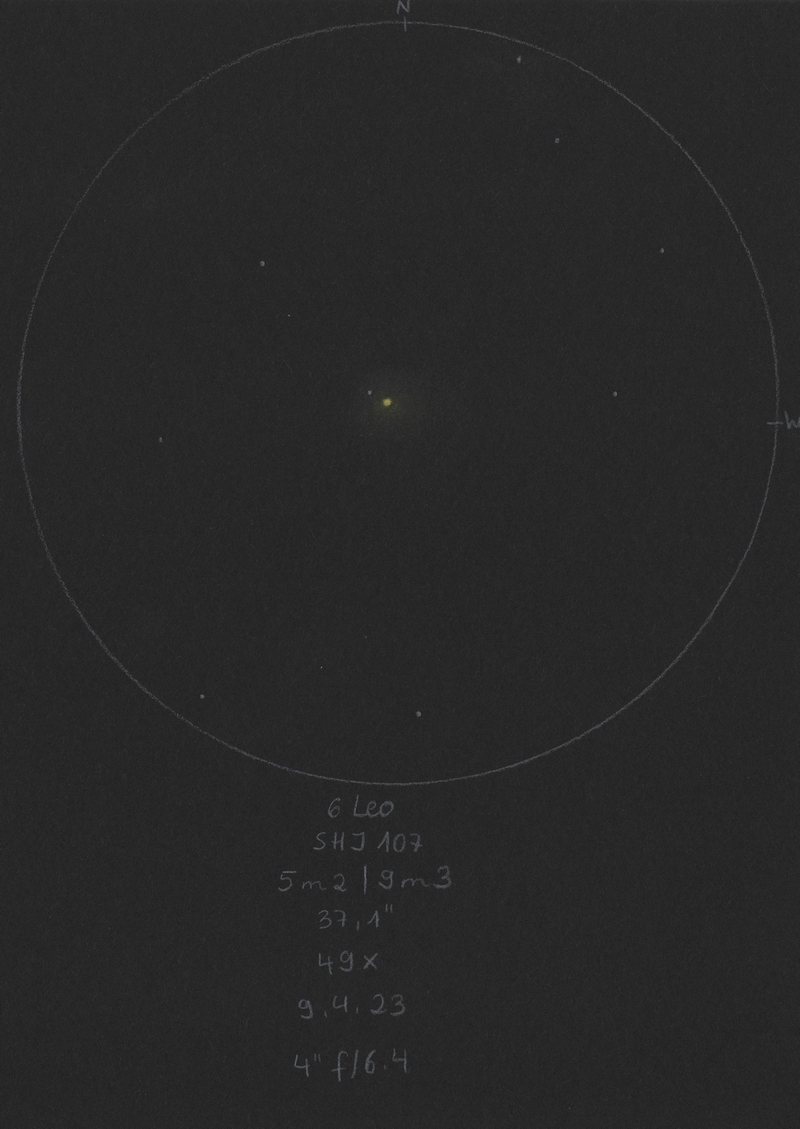
|
Axel Tute
Küssaberg (Germany) |
200mm (80x) |
16.03.2009: Simple with the C8: A is orange. B is bluish. Beautiful colours. |

|
Mark McCarthy
Fremont (California/USA) |
317mm (553x) |
A star is light orange & 3 delta mag to B star which is a white, well separated point |
|
|
|
★★
|
STF1350 |
|
AB |
8m.3 |
8m.3 |
10.2" |
249° |
2015 |
UMa |
09h34m19.56s / +66°47'42.30" |
|
|
|
|
AC |
8m.3 |
9m.2 |
131.0" |
216° |
2015 |
|
|
René Merting
Drachhausen (Germany) |
18x70 |
AB: ein sehr enger Doppelstern, äußerst knapp getrennt … und das auch nur in guten Momenten, ansonsten wirkt das Paar wie eine Ameise - beide Sterne sind gleich hell - ein FG-Tester für 18x |
|
Christopher Hay
Seeheim (Germany) |
60mm (25x) |
AB: Tight but nicely split at 25x. No colour whatsoever seen. A appears brighter than B, whereby the data do not support this – perhaps a product of different (yet not seen) colouration? According to Stelledoppie not a physical pair. Attractive together with Struve 1349 in same field of view. |
|
Robert Zebahl
Leipzig (Germany) |
70mm (22x) |
2020-04-19: At 22x A & B equally bright and still pretty close together. Component C is visible at a much greater distance. At 44x, A & B show a color difference: orange, white-bluish. |
|
René Merting
Drachhausen (Germany) |
100mm (32x) |
AB: bei 32x ein schönes enges Paar zweier gleich heller Sterne, knapp getrennt - STF1350 AB bildet mit vier ähnlich hellen Sternen westlich ein Muster, ähnlich einer Sense
AC: bei 32x bildet STF1350 AB mit vier ähnlich hellen Sternen westlich ein Muster, ähnlich einer Sense - der erste der vier Sterne bzw. der nächststehende Stern südsüdwestlich mit mehr als zehnfachem Abstand AB ist Komponente C, er ist schätzungsweise eine halbe Größenklasse schwächer |
|
Uwe Pilz
Leipzig (Germany) |
105mm (88x) |
AB: trennbar bei 21x. Fast gleichell, aber deutlicher Farbkontrast, lohnend. |
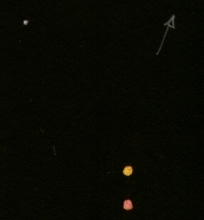
|
Robert Zebahl
Leipzig (Germany) |
152mm (100x) |
At 22x, all three components are already visible, with A & B still standing quite close together. Component C is less prominent. At 69x and 100x, the pair AB shows a nice color contrast: The eastern component mostly appeared in a slightly shiny orange, while the other component appeared more white-bluish. During the observation, however, the colors changed between both components. At the time of observation, the pretty bright comet C/2019 Y4 Atlas was also in the same field of view - a great scene! Note to the sketch: The positions of the stars to each other do not exactly match, also the alignment of the pair AB to C. |
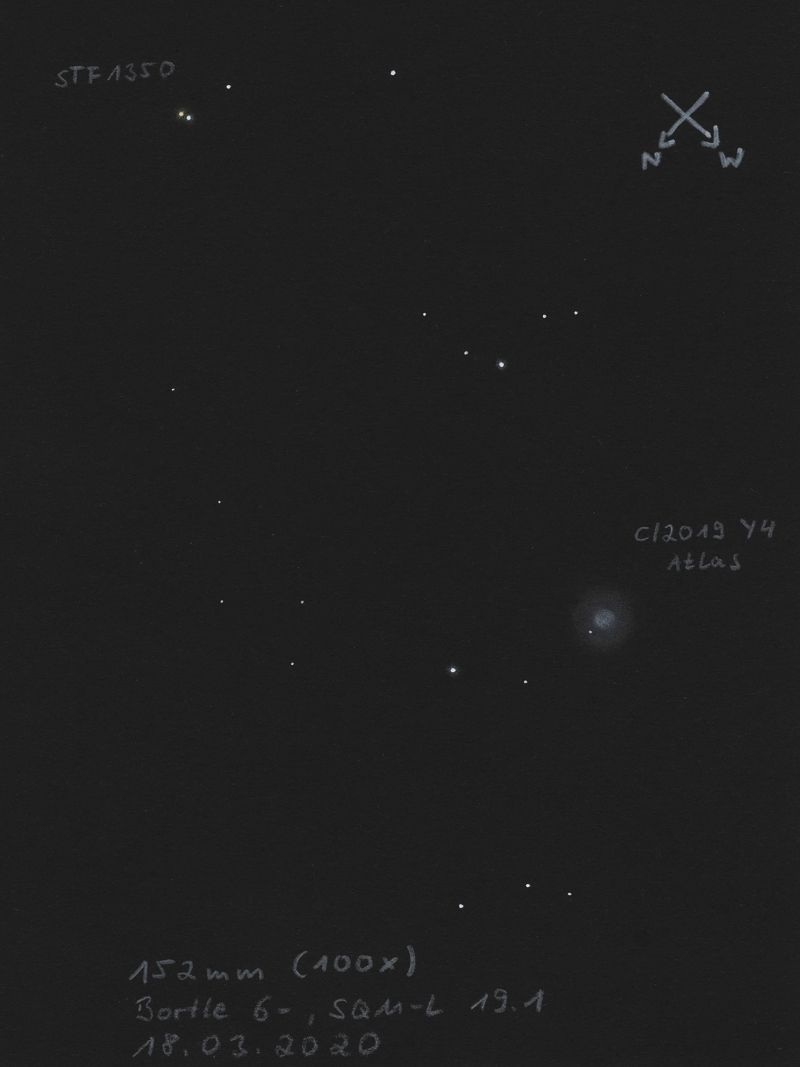
|
Christopher Hay
Seeheim (Germany) |
180mm (113x) |
AB: Immediately striking in 32x71 superfinder wihle panning through the area, a very evenly matched pair well split at that power. Closer inspection with the 7-inch at 113x reveals a fine blue-orange colour contrast between components A and B. |
|
René Merting
Drachhausen (Germany) |
320mm (45x) |
AB: bei 45x ein schönes enges Paar zweier gleich heller Sterne, beide strahlen weiß |
|
|
|
★
|
STF1369, DI Lyn |
|
AB |
7m.0 |
8m.0 |
25.1" |
150° |
2019 |
Lyn |
09h35m22.50s / +39°57'47.70" |
|
|
|
|
AC |
7m.0 |
8m.4 |
116.3" |
323° |
2017 |
|
|
|
|
|
|
BC |
8m.0 |
8m.4 |
141.6" |
324° |
2017 |
|
|
Christopher Hay
Seeheim (Germany) |
15x45 |
AB: Binoculars with internal stabilisation, handheld. Clearly split, a compact little pair. Involved in a nice triangle of 42 and 43 Lyn to the east plus a third bright, orangish star to the south.
AB is a physical double at a distance to us of 278 light years. |
|
Mark McCarthy
Fremont (California/USA) |
508mm (333x) |
AB: DI Lyn Very wide and bright light yellow stars, ~1 delta mag. [did not notice COU 2084 Aa,Ab, 6.98/8.79 0.2"] |
|
|
|
★
|
STF1362 |
|
|
7m.0 |
7m.2 |
4.9" |
125° |
2017 |
Dra |
09h37m56.18s / +73°04'49.50" |
|
|
Robert Zebahl
Leipzig (Germany) |
70mm (31x) |
2020-04-21: At 22x extremely tight, but separable. At 31x very fine separation. Both components appeared white. Very nice sight! At 57x well separated, similarly bright. One component appeared white-yellowish with a hint of orange, the other more white. |
|
|
|
★
|
STF1381 |
|
|
8m.9 |
9m.2 |
0.8" |
187° |
2017 |
UMa |
09h51m15.22s / +60°37'00.10" |
|
|
Mark McCarthy
Fremont (California/USA) |
178mm (205x) |
Finest split with seeing, very small scale at this magnification, light orange star, very significant magnitude difference. Physical with a 1787.6479-year period, this is actually one to watch because it is rapidly nearing periastron and will tighten over the next couple of decades |
|
|
|
★
|
STT208, phi UMa |
|
|
5m.3 |
5m.4 |
0.5" |
317° |
2022 |
UMa |
09h52m06.36s / +54°03'51.40" |
|
|
Uwe Pilz
Leipzig (Germany) |
105mm (260x) |
länglich, schwierig |
|
Mark McCarthy
Fremont (California/USA) |
178mm (333x) |
Tough in poor seeing and transparency. Bright white A, significant delta magnitude, B's PA a little north of west. There are three stars in a wide triangle in the field, B points to base line. Physical with 104.6-year period, it will widen slightly and will reach apastron by 2040 |
|
Christopher Hay
Seeheim (Germany) |
180mm (290x) |
4 April 2021 (0.43" angular distance according to database at time of observation): At 200x seems oval. At 290x definite elongation and clear position angle. My personal record for double-star detection and PA perception with the seven-inch telescope. |
|
|
Frederik Wanink
Itterbeck (Germany) |
254mm |
|
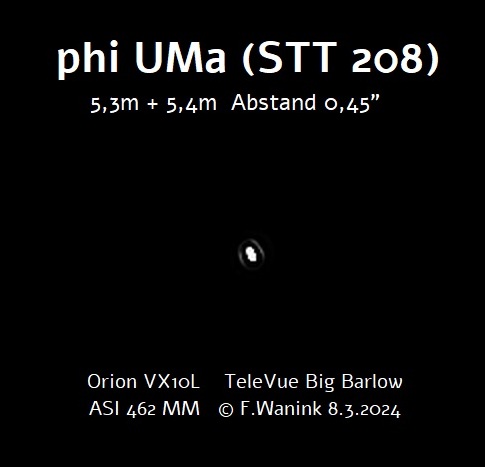
|
|
|
★
|
STT209 |
|
|
7m.4 |
10m.3 |
4.9" |
309° |
2019 |
UMa |
09h53m17.23s / +50°37'16.30" |
Mark McCarthy
Fremont (California/USA) |
178mm (205x) |
Light yellow-orange A, B is very much fainter about 3 delta mag, wide about 5". Physical |
|
Mark McCarthy
Fremont (California/USA) |
317mm (553x) |
Light orange-yellow disk with faint diffraction ring. Extremely faint blue B ~4" can see it direct vision but it flashes forth with averted. |
|
|
|
★
|
STF1399 |
|
|
7m.7 |
8m.4 |
30.2" |
176° |
2017 |
Leo |
09h57m02.21s / +19°45'44.60" |
Robert Zebahl
Leipzig (Germany) |
70mm (22x) |
Easy to split with nice distance and obviously unequal. A conspicuous group of fainter stars is nearby. Main component appeared in a warm-white, fainter somehow darker (partly bluish, partly slightly orange). |
|
Uwe Pilz
Leipzig (Germany) |
105mm (53x) |
wie ein Schlangenbiß |
|
Mark McCarthy
Fremont (California/USA) |
317mm (553x) |
Faint pair, tough find dense with stars. 1 delta magnitude, wide separation. |
|
|
Berthold Fuchs
Wiesbaden (Germany) |
130mm |
easy DS |

|
|
|
★★
|
STT210 |
|
|
8m.5 |
9m.1 |
1.3" |
257° |
2016 |
UMa |
10h02m35.64s / +46°21'42.50" |
Mark McCarthy
Fremont (California/USA) |
178mm (205x) |
Excellent fine pair, with seeing, light yellow-orange, 1 delta mag, split but very close |
|
Mark McCarthy
Fremont (California/USA) |
317mm (553x) |
Yellow A and white B, very tight. Faint, seeing needs to be perfect to see B in the diffraction. |
|
|
|
★★
|
A2142 |
|
|
8m.0 |
8m.8 |
1.0" |
293° |
2021 |
LMi |
10h05m43.55s / +41°02'42.70" |
Mark McCarthy
Fremont (California/USA) |
317mm (553x) |
Very fine, split, ~1-1.5". 8th magnitude and 1.5 delta mag B, close split, very nice pair. In the 80mm finder this is one of a triangle of equal magnitude stars. |
|
|
|
★★
|
alpha Leo, 32 Leo, Regulus |
STFB6 |
AB |
1m.4 |
8m.2 |
179.2" |
304° |
2019 |
Leo |
10h08m22.31s / +11°58'01.90" |
|
|
|
HDO127 |
AD |
1m.4 |
12m.1 |
195.3" |
274° |
2015 |
|
|
|
|
|
HDO127 |
BC |
8m.2 |
13m.2 |
2.2" |
94° |
2019 |
|
|
René Merting
Drachhausen (Germany) |
10x32 |
AB: Regulus strahlt weiß, B im Westnordwesten ist schwach, grau und mit großem Abstand zu erkennen, der Stern befindet sich im Halo von Regulus |
|
Christopher Hay
Seeheim (Germany) |
10x56 |
AB: On tripod. B immediately pops out from the glare of A, thanks to its substantial distance. B is a vivid blue.
Emboldened by the unexpected ease with which the pair can be seen in the 10x56, I launch an attempt with 7x50 bins on the tripod. This is thwarted by the many rays emanating from A in the image. Too much exit pupil?
AB is a physical double at a distance to us of only 79 light years. |
|
René Merting
Drachhausen (Germany) |
12x42 |
AB: Regulus präsentiert sich als strahlend weißer Persil-Riese mit einem mächtigen Halo, die B-Komponente ist weit abgesetzt aber noch immer im Halo von Regulus erkennbar, schwach, aber doch gut sichtbar - Helligkeitsunterschied enorm |
|
René Merting
Drachhausen (Germany) |
15x56 |
AB: Regulus wirkt eigenartig, er strahlt er klarweiß, mitunter mit einem Goldrand - B steht ordentlich abgesetzt im Nordwesten, gut erkennbar und doch megaschwach gegen die A-Komponente |
|
Christopher Hay
Seeheim (Germany) |
15x60 |
AB: On tripod. B is a fine pinprick of light, seems bluish. An attractive unevenly matched pair. |
|
René Merting
Drachhausen (Germany) |
18x70 |
AB: ein einfacher Doppelstern - Komponente B steht weitab nordwestlich vom gleißend weiß strahlenden Stern Regulus - B ist bedeutend schwächer als A und wirkt grau |
|
René Merting
Drachhausen (Germany) |
100mm (32x) |
AB: bei 32x ist B weit abgesetzt von A erkennbar - Regulus präsentiert sich strahlend weiß - B ist nur schwach weiß - kein echtes Doppelsternfeeling |
|
Sarah Gebauer
Germany |
100mm (49x) |
AB: bei 49-fach ein sehr weites, ungleiches Paar, gerade noch so als Doppelstern wahrnehmbar, Komponente A strahlt so hell, dass sie im Amiciprisma einen langen Spike erzeugt, wirkt sehr reinweiß - Komponente B erscheint warmbraun - bei 20-fach ist B auch noch gut zu erkennen, der Farbeindruck ist nun jedoch schwächer und B wird zu einem mausgrauen Punkt |

|
Uwe Pilz
Leipzig (Germany) |
105mm (288x) |
AB: sehr weit; einfach |
|
Sarah Gebauer
Germany |
150mm (30x) |
AB: relativ dicht beieinander, ein Stern sehr hell und groß, der zweite schwach und klein |
|
Gerd Kohler
Langenzenn (Germany) |
254mm (76x) |
AB: Bläulich-weiß - leicht rötlich. Großer Helligkeitsunterschied. |
|
Gerd Kohler
Langenzenn (Germany) |
254mm (76x) |
AD: Beim Begleiter von Regulus steht im fast gleichen Abstand, etwas nach Westen versetzt, ein sehr schwacher Stern. |
|
René Merting
Drachhausen (Germany) |
320mm (72x) |
AB: bei 72x extrem weit getrennt erkennbar - Komponente A ist weißblau, die wesentlich schwächere Komponente B strahlt weißgrau |
|
René Merting
Drachhausen (Germany) |
320mm (72x) |
AD: Komponente D ist südwestlich von B (STFB6) erkennbar, etwas weiter von A entfernt als B, klein und unscheinbar |
|
|
|
★
|
L10 |
|
|
10m.0 |
10m.5 |
1.1" |
352° |
2017 |
Leo |
10h14m33.75s / +17°53'24.40" |
Mark McCarthy
Fremont (California/USA) |
178mm (205x) |
Unbelievably fine split with 205x! Very small scale, the dim stars are small disks so the separation is clean. Very slight magnitude difference, white stars, really fine. Higher magnification hazes the image too much. T. Lewis of Greenwich Observatory |
|
|
|
★
|
STT523, 39 Leo |
|
|
5m.8 |
11m.3 |
7.9" |
300° |
2017 |
Leo |
10h17m14.53s / +23°06'22.30" |
René Merting
Drachhausen (Germany) |
100mm (213x) |
bei 142x habe ich das Gefühl, Komponente B ab und an westlich von A ganz schwach im ersten Beugungsring ausmachen zu können, aber noch unsicher - bei 213x dann zeigt B sich eindeutig und kann ab und an auch mal länger gesehen werden |
|
Mark McCarthy
Fremont (California/USA) |
508mm (333x) |
39 Leo. ! Nice bright light yellow-orange A star. B is very small, very faint, ~8" separation, a single little point, barely has its own light |
|
|
|
★
|
A2369 |
|
|
8m.5 |
9m.7 |
1.0" |
296° |
2017 |
Leo |
10h17m59.92s / +17°11'11.90" |
Mark McCarthy
Fremont (California/USA) |
508mm (533x) |
Needed higher magnification to get it. Orange star with a faint but nice star in first diffraction ring, much fainter, ~1". Nice |
|
|
|
★
|
STF1423 |
|
|
9m.4 |
10m.1 |
0.7" |
308° |
2018 |
Leo |
10h19m10.64s / +20°33'48.10" |
|
|
Mark McCarthy
Fremont (California/USA) |
317mm (553x) |
Tough! Elongated to hairline split. |
|
Mark McCarthy
Fremont (California/USA) |
508mm (533x) |
Split with seeing, light orange A and very faint, ~3 delta mag B, very close, within diffraction ring <1" |
|
|
|
★★
|
STF1424, gamma Leo, 41 Leo, Algieba |
|
AB |
2m.4 |
3m.6 |
4.7" |
127° |
2020 |
Leo |
10h19m58.35s / +19°50'29.40" |
|
|
René Merting
Drachhausen (Germany) |
12x42 |
ein unheimlich schöner, rapsgelber Stern - an eine Trennung ist natürlich nicht zu denken, aber das Gelb hat mich so fasziniert |
|
Christopher Hay
Seeheim (Germany) |
20x60 |
Handheld in reclining chair, binoculars with internal stabilisation. 14 May 2022 (4.7" angular distance according to database): Pear-shaped. Strong orange-lemon yellow, a fruity affair. PA estimated 140° without prior knowledge, a good enough match, considering the low magnification, to the database figure of 127° ascertained post-observation. |
|
Christopher Hay
Seeheim (Germany) |
44x100 |
21 May 2022 (4.7" angular distance according to database): Hairfine split, slightly difficult due to bloated stars in these achromatic (not apochromatic) binoculars. Both components orange, with secondary going into yellow. Thin cloud moving through tightens up the star images and makes the split much clearer. Clearest shortly before clouds become so dense as to swallow the pair. |
|
Christopher Hay
Seeheim (Germany) |
36mm (50x) |
21 May 2022 (4.7" angular distance according to database): At 40x deeply notched, at 50x tenuously split, at 66x cleanly and clearly split. |
|
Robert Zebahl
Leipzig (Germany) |
55mm (38x) |
At 38x split, but very tight with noticeable difference in brightness. At 56x and higher beautiful view of both components, which seemed to have similar colors. |

|
Robert Zebahl
Leipzig (Germany) |
55mm (59x) |
Very nice unequal double. A appeared yellow-orange, B rather white-bluish. |
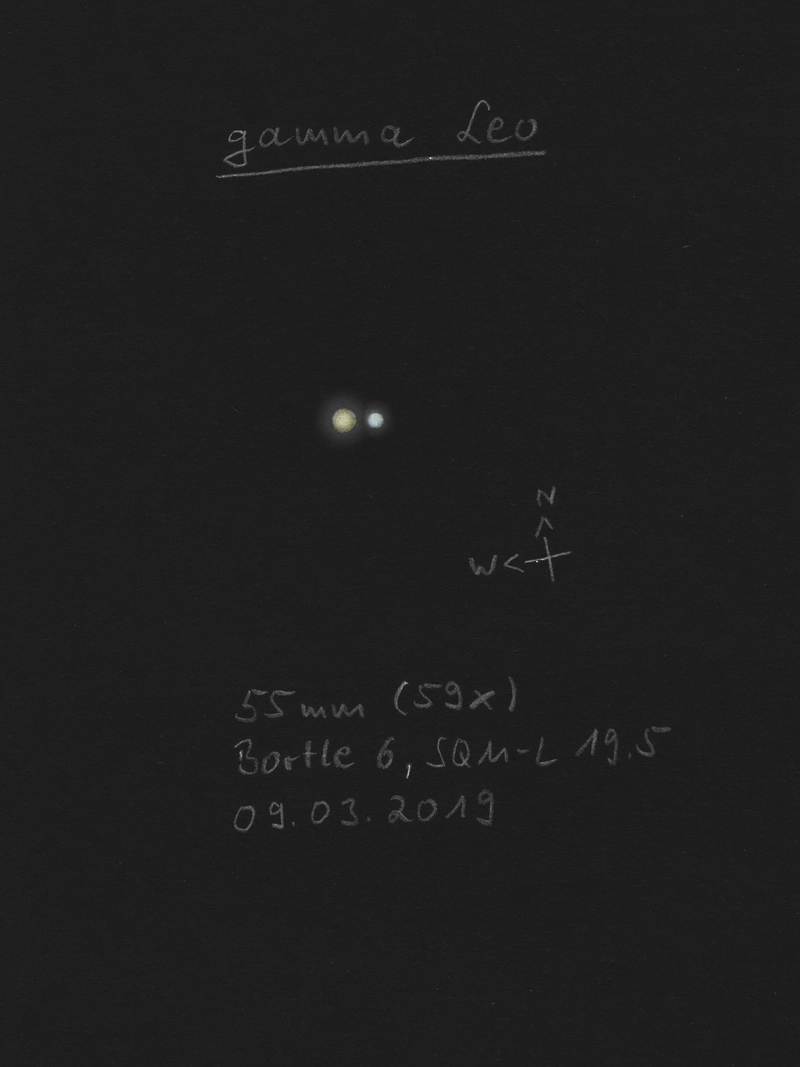
|
Christopher Hay
Seeheim (Germany) |
60mm (58x) |
At 25x Algieba is already very elongated. At 58x a sliver of dark between the components, with clear brightness difference. At 70x split becomes more stable, but view not so pleasing as at 58x. Both components display vivid orange. |
|
Axel Tute
Küssaberg (Germany) |
70mm (88x) |
07.03.2009: At 88x magnification the stars are still coherent. At 117x magnification they are clearly separated. A & B have a slightly yellow colour. |
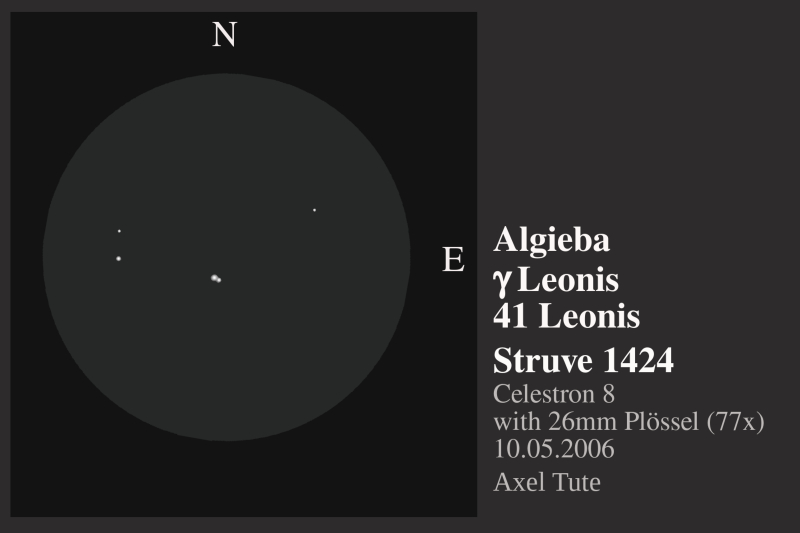
|
Robert Zebahl
Leipzig (Germany) |
70mm (100x) |
At 67x still a relatively close pair, but well separated with quite a clear difference in brightness. At 100x easy to separate and visible color difference: A yellowish to slightly orange, B white-yellowish. |
|
René Merting
Drachhausen (Germany) |
76mm (95x) |
Mondscheinnacht - bei 57x zwei goldgelbe Murmeln, die dicht aneinander kleben, die südöstliche, schwächere Murmel strahlt etwas tiefgelber - bei 95x dann zeigen sich beide Sterne mit unregelmäßig verlaufenden Beugungsringen und einem fetten gemeinsamen Halo - sie sind knapp getrennt erkennbar - B ist vielleicht eine Größenklasse schwächer - sehenswert |
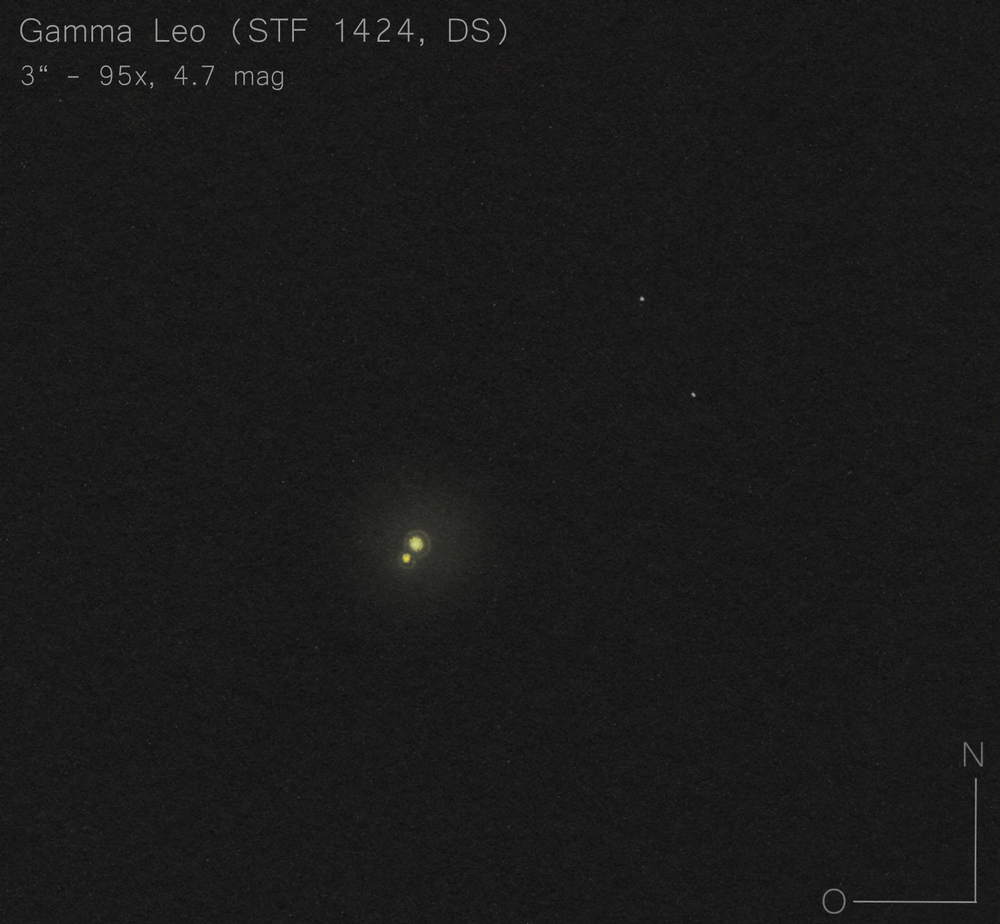
|
Sarah Gebauer
Germany |
100mm (80x) |
bei 80-fach fein, aber schön getrennt - Komponente A funkelt in einem warmen Goldgelb, die feinere und nur leicht schwächere Komponente B dicht östlich daneben zeigt einen ähnlichen Farbton, entsprechend ein bisschen weniger intensiv |
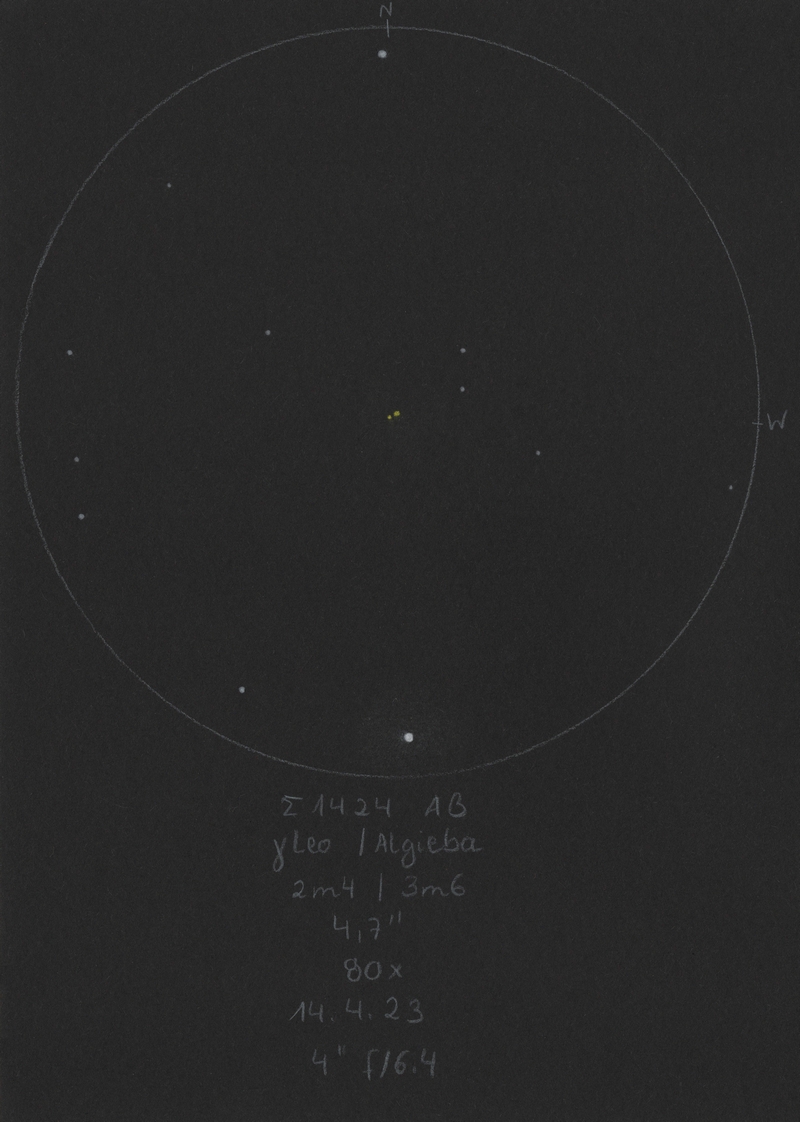
|
Robert Zebahl
Leipzig (Germany) |
102mm (125x) |
Very nicely separated with wonderful contrast in brightness and color. Primary component slightly orange, companion yellowish. |
|
Stefan Loibl
Rosenheim (Germany) |
102mm (164x) |
very bright double star, slight colour contrast |
|
Uwe Pilz
Leipzig (Germany) |
105mm (120x) |
schon bei 37x sehenswert; trennbar bei 55x; orange-blauweiß |
|
Robert Zebahl
Leipzig (Germany) |
120mm (66x) |
At 48x easily seen as double star. It appeared as '8'. At 66x pretty tight with visible difference in brightness. |
|
Winfried Kräling
Marburg (Germany) |
127mm (250x) |
08.04.2018: merklicher Helligkeitsunterschied, A = gelb-orange, B = gelb-orange |

|
Sarah Gebauer
Germany |
150mm (83x) |
bei 83x sauber getrennt, ein leichter Farbunterschied (Weiß und helles Gelb) sichtbar |

|
Axel Tute
Küssaberg (Germany) |
200mm (77x) |
11.05.2006: At 77x you can clearly see that it is a double star. An 8 but without a gap. At 167x a clear gap can be seen. A is slightly bluish. |
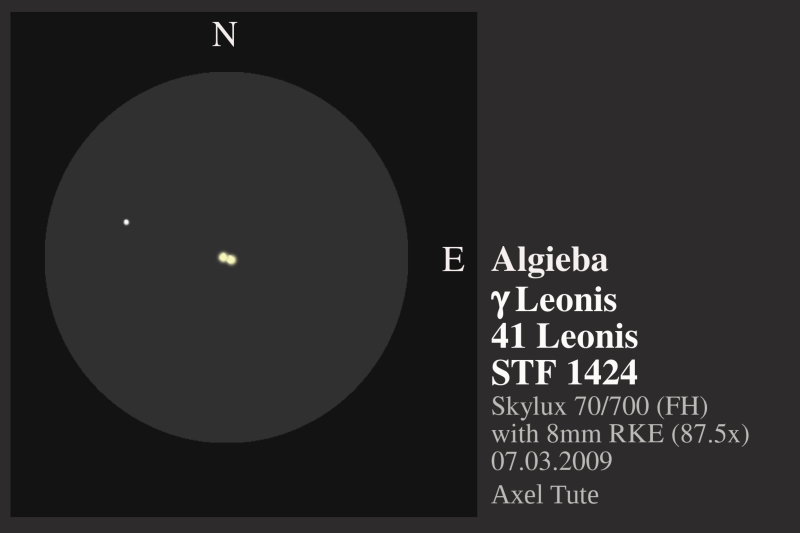
|
Mark McCarthy
Fremont (California/USA) |
317mm (277x) |
Algieba: Bright yellow and yellow-orange pair, 1 delta mag, 4-6" |
|
René Merting
Drachhausen (Germany) |
320mm (144x) |
bei 72x ist ein Stäbchen erkennbar - bei 144x zeigen sich zwei gelbe Murmeln, knapp getrennt |
|
René Merting
Drachhausen (Germany) |
320mm (240x) |
bei 240x sehe ich zwei ordentlich getrennte Sterne (naja, nicht wirklich Sterne, sondern wild zappelnde Glitzerbällchen) - Komponente A strahlt in einem zarten Gelb, B ist weiß - zurück auf 144x sehe ich nur ein Stäbchen mit leichter Einschnürung, so wild tanzen die Sterne |
|
Mark McCarthy
Fremont (California/USA) |
508mm (333x) |
Algieba. Very bright, A is yellow-orange and B is a blazing white orange, like a fire |
|
|
Frederik Wanink
Itterbeck (Germany) |
254mm |
|

|
|
|
★
|
STF1426 |
|
AB |
8m.0 |
8m.3 |
0.9" |
315° |
2022 |
Leo |
10h20m32.32s / +06°25'47.60" |
|
|
|
|
AB-C |
7m.3 |
9m.4 |
7.9" |
9° |
2022 |
|
|
|
|
René Merting
Drachhausen (Germany) |
100mm (107x) |
AB: bei 213x in guten Momenten als Stäbchen erkennbar
AB-C: bei 107x ist nördlich vom Hauptstern AB eine gut 2 Größenklassen schwächere Komponente erkennbar - AB ist weiß, C ist grau |
|
Robert Zebahl
Leipzig (Germany) |
102mm (160x) |
AB: At first glance elongated, on closer look visible as '8'. |
|
Robert Zebahl
Leipzig (Germany) |
102mm (160x) |
AB-C: Quite large angular distance and therefor easy to separate. The C component was pretty faint. |
|
Stefan Loibl
Rosenheim (Germany) |
102mm (164x) |
AB-C easily split, A-B not detectable as double |
|
Uwe Pilz
Leipzig (Germany) |
105mm (288x) |
A-B länglich, C weit |
|
Mark McCarthy
Fremont (California/USA) |
203mm (333x) |
AB: Split with seeing, white, very close, near equal. Part of plus one, a two delta mag not far away |
|
|
|
★
|
STF1425 |
|
|
9m.9 |
10m.7 |
4.8" |
358° |
2017 |
UMa |
10h21m34.14s / +46°09'07.60" |
Mark McCarthy
Fremont (California/USA) |
178mm (205x) |
Faint pair, about 1 delta, wide about 5". Physical |
|
Mark McCarthy
Fremont (California/USA) |
317mm (553x) |
Very faint pair, ~4-5" orange and blue, 0.5 delta mag. |
|
|
|
★★
|
STT216 |
|
|
7m.4 |
10m.3 |
2.5" |
228° |
2021 |
Leo |
10h22m43.81s / +15°20'39.70" |
|
|
Mark McCarthy
Fremont (California/USA) |
317mm (277x) |
A white and bright (7.3), B red & much fainter (10.3), a close split (2"). |
|
Mark McCarthy
Fremont (California/USA) |
508mm (333x) |
Yellow and very much fainter orange B, 1 delta mag, ~4" separated |
|
|
|
★
|
HJ2530 |
|
AC |
6m.4 |
6m.7 |
201.6" |
63° |
2015 |
Sex |
10h24m13.15s / +02°22'05.10" |
Christopher Hay
Seeheim (Germany) |
7x45 |
Handheld. Wide, strong, well-matched pair. Component A slightly orange, C colder. Nice in 8.6° FOV with Alpha and Beta Sextantis. |
|
Christopher Hay
Seeheim (Germany) |
12x36 |
Binoculars with internal stabilisation, handheld. Wide, very evenly matched pair, strong at this magnification in 5.6° FOV. Component A slightly orange, C slightly blue. |
|
|
|
★
|
STTA104 |
|
|
7m.2 |
7m.3 |
209.0" |
287° |
2013 |
LMi |
10h24m22.19s / +34°10'35.00" |
Christopher Hay
Seeheim (Germany) |
7x45 |
Handheld. Wide, striking matched pair. Nice together with triangle of 27/28/30 LMi, and thus also easy to find. HJL1057 also in field to southwest.
Delicate colour contrast in the triangle makes this a very attractive field: 30 LMi is yellowish-white, 28 reddish-white, 27 LMi colder.
In 15x45 binoculars STTA104 becomes almost too wide to feel it is a double, but the colour contrasts in the triangle become clearer. |
|
René Merting
Drachhausen (Germany) |
18x70 |
ein schöner Fernglasstern - die beiden gleichhellen Protagonisten sind relativ hell und stehen weit auseinander, sie werden zudem von drei noch helleren Sternen im Süden flankiert - die östliche Komponente strahlt roséweiß, B im Westen warmweiß |
|
Robert Zebahl
Leipzig (Germany) |
70mm (22x) |
2020-04-11: Very wide pair of similarly bright components, unremarkable color. The double star stands close to the stars 27, 28 & 30 LMi and is probably more appealing in smaller binoculars. |
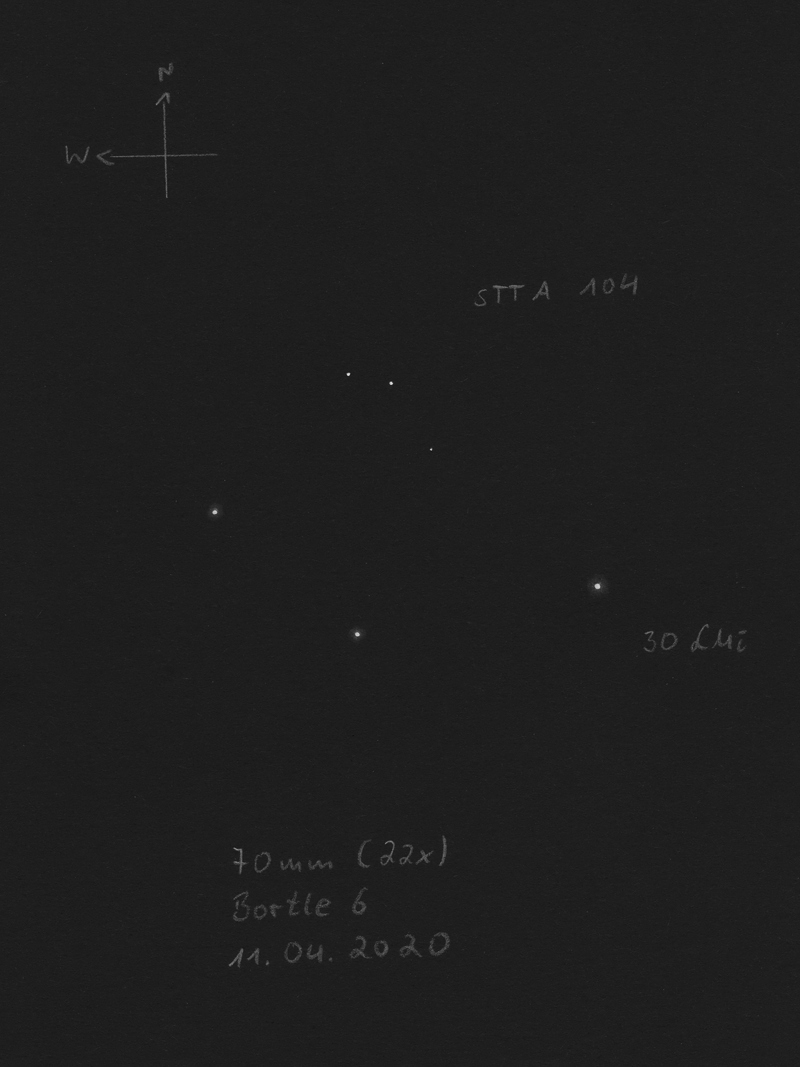
|
|
|
★
|
STF1429 |
|
|
9m.1 |
9m.3 |
0.8" |
155° |
2017 |
Leo |
10h25m01.79s / +24°36'44.10" |
|
|
Mark McCarthy
Fremont (California/USA) |
317mm (553x) |
Very tough. Faint, need averted vision to brighten and sharpen. Elongated to clean split in the best moments with seeing, near equal magnitude |
|
Mark McCarthy
Fremont (California/USA) |
508mm (533x) |
Elongated to hairline at 333x, split at 533x. Light orange stars, near equal |
|
|
|
★
|
STT217 |
|
|
7m.8 |
8m.6 |
0.8" |
150° |
2019 |
Leo |
10h26m53.01s / +17°13'09.90" |
|
|
Mark McCarthy
Fremont (California/USA) |
508mm (333x) |
Just split cleanly, ~1 delta mag, yellow-tinged white stars. Nice close pair |
|
|
|
★
|
HU879, bet LMi |
|
|
4m.6 |
6m.0 |
0.5" |
226° |
2018 |
LMi |
10h27m53.09s / +36°42'26.90" |
Mark McCarthy
Fremont (California/USA) |
508mm (533x) |
Beta LMi. With apodizing mask I see an out of roundness / olive shape, too much glare to tell orientation, no other field stars |
|
|
|
★
|
STF1439 |
|
|
8m.3 |
8m.9 |
1.4" |
73° |
2019 |
Leo |
10h30m06.42s / +20°48'04.30" |
|
|
Mark McCarthy
Fremont (California/USA) |
508mm (333x) |
Very clean images, light yellow-orange stars, ~1 delta mag, well split, very pretty |
|
|
|
★
|
HU880 |
|
|
10m.1 |
10m.4 |
0.9" |
144° |
2017 |
LMi |
10h31m14.44s / +37°07'27.40" |
Mark McCarthy
Fremont (California/USA) |
508mm (333x) |
Exceptionally fine split, white stars |
|
|
|
★
|
HDS1511 |
|
|
7m.5 |
9m.1 |
0.1" |
19° |
2012 |
Leo |
10h32m17.36s / +24°26'32.10" |
Mark McCarthy
Fremont (California/USA) |
508mm (1067x) |
Out of round olive, airy disk swimming in diffraction |
|
|
|
★
|
HU1338 & STF1448 |
HU1338 |
AB |
7m.5 |
13m.6 |
3.5" |
184° |
1920 |
Leo |
10h34m23.24s / +21°35'36.40" |
|
|
|
STF1448 |
AC |
7m.5 |
9m.6 |
11.0" |
260° |
2017 |
|
|
Robert Zebahl
Leipzig (Germany) |
70mm (44x) |
STF1448 (AC): 2020-04-10: Moderate separation, significant difference in brightness. A shows a beautiful bright orange, C as a faint greyish companion. |
|
René Merting
Drachhausen (Germany) |
100mm (32x) |
STF1448 (AC): bei 32x zeigt sich Komponente C im NW von A knapp getrennt - C ist nur ein Hauch von einem Stern - Helligkeitsunterschied enorm, ich schätze 3 Größenklassen (nur 2 mag laut Stelle Doppie) |
|
Axel Tute
Küssaberg (Germany) |
200mm (77x) |
STF1448 (AC): 11.05.2006: Easy to separate at 77x. A is slightly reddish. |
|
Mark McCarthy
Fremont (California/USA) |
317mm (277x) |
STF1448 (AC): Pretty orange and blue pair, 2 delta mag, ~10" |
|
Mark McCarthy
Fremont (California/USA) |
317mm (277x) |
STF1448 (AC): An orange and blue pair. Fainter than Alberio but just as pretty. |
|
|
|
★
|
STF1450, 49 Leo |
|
|
5m.8 |
7m.9 |
2.0" |
157° |
2019 |
Leo |
10h35m02.16s / +08°39'01.60" |
Robert Zebahl
Leipzig (Germany) |
70mm (133x) |
B component appeared as clear brightening on the first diffraction ring of the primary component in the correct position angle. |
|
Uwe Pilz
Leipzig (Germany) |
105mm (200x) |
Begleiter klebt am ersten Ring |
|
Mark McCarthy
Fremont (California/USA) |
317mm (277x) |
White and slight yellow, ~6-7", nice pair. |
|
Mark McCarthy
Fremont (California/USA) |
508mm (333x) |
49 Leo. Striking pair, light yellow A and a richer orange-yellow B, ~2.5 delta mag, well split |
|
|
|
★
|
STF1454 |
|
|
9m.0 |
11m.0 |
1.3" |
358° |
2016 |
LMi |
10h38m11.10s / +26°36'24.80" |
|
|
Mark McCarthy
Fremont (California/USA) |
317mm (553x) |
Quite tough: averted vision only, very tight, similar magnitude, when seeing stills. |
|
|
|
★
|
J79 |
|
|
9m.0 |
10m.1 |
1.4" |
135° |
2018 |
Leo |
10h38m54.93s / +07°21'26.00" |
Mark McCarthy
Fremont (California/USA) |
508mm (333x) |
Very nice, ~2 delta mag, close ~2" separation, blue-white stars |
|
|
|
★
|
STT227 |
|
|
8m.3 |
8m.8 |
0.9" |
2° |
2017 |
Leo |
10h41m41.58s / +10°44'22.30" |
Mark McCarthy
Fremont (California/USA) |
317mm (277x) |
Faint reddish pair, near equal, just split but hazy, poor view. |
|
Mark McCarthy
Fremont (California/USA) |
508mm (333x) |
Pure white stars, ~1" separation, ~2 delta mag, very fine and striking |
|
|
|
★
|
A2483 |
|
AB |
9m.4 |
11m.4 |
2.1" |
223° |
2022 |
Leo |
10h42m08.09s / +16°17'03.60" |
Mark McCarthy
Fremont (California/USA) |
508mm (333x) |
Wow, very fine ~2 delta mag, ~2" separation. Very much fainter B about as faint as can be before needing averted vision |
|
|
|
★★
|
STF1466, 35 Sex |
|
AB |
6m.2 |
7m.1 |
6.8" |
239° |
2019 |
Sex |
10h43m20.91s / +04°44'51.60" |
René Merting
Drachhausen (Germany) |
100mm (32x) |
bei 32x ein wunderschönes dicht stehendes Pärchen, knapp getrennt - Helligkeitsunterschied eine halbe Größenklasse - leichter Farbkontrast, A leicht gelblich |
|
Sarah Gebauer
Germany |
100mm (49x) |
bei 49-fach ganz knapp getrennt, sieht wunderschön aus - die A-Komponente strahlt sehr schön gelb, der Begleiter zeigt einen ähnlichen Farbton, jedoch schwächer und matter - das Pärchen leuchtet trotz seiner filigranen Erscheinung sehr schön |

|
Robert Zebahl
Leipzig (Germany) |
102mm (28x) |
Very nice view. At 28x obviously unequal and easy to split. A appeared slightly orange. At 86x B appeared grey-blue. |
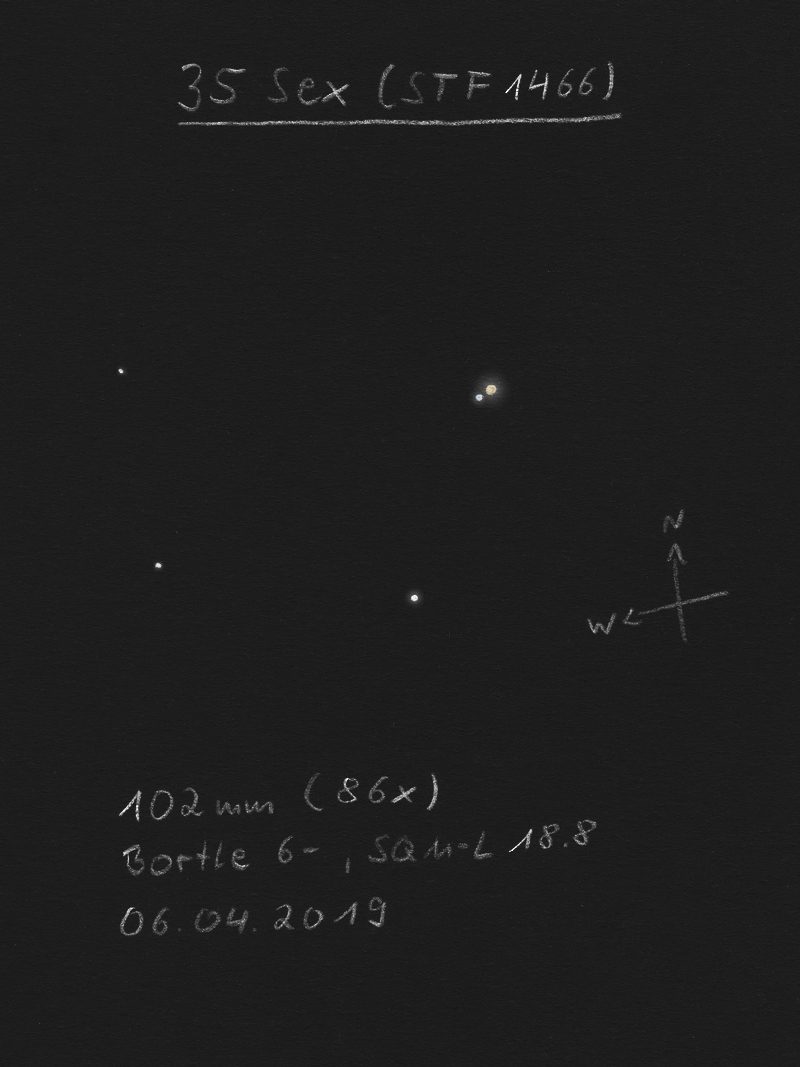
|
Mark McCarthy
Fremont (California/USA) |
317mm (277x) |
Orange and a little blue, wide separation, bright, half a delta mag. |
|
Mark McCarthy
Fremont (California/USA) |
508mm (333x) |
35 Sex. Easy, wide, yellow-orange pair, ~2 delta mag. AC much further separated and 1 delta mag. [SkyTools showed a close CD pair: Hint of elongation with 533x, elongation is larger but more hazy at 1067x, but not resolved into stars -- but this one not in Stelle Doppie.] |
|
|
|
★
|
SMA75 |
|
AB |
5m.2 |
7m.3 |
288.0" |
88° |
2018 |
UMa |
10h43m32.89s / +46°12'13.90" |
|
|
|
|
AC |
5m.2 |
11m.1 |
152.0" |
16° |
2018 |
|
|
|
|
|
|
AD |
5m.2 |
9m.2 |
381.6" |
45° |
2018 |
|
|
|
|
|
|
BD |
7m.3 |
9m.2 |
259.2" |
357° |
2018 |
|
|
Christopher Hay
Seeheim (Germany) |
7x45 |
AB: Wide apart and large delta-mag, but still very much belonging together. No particular colour impression.
Smart 75 AB (also known as Shaya (SHY) 216) is a physical double at a distance to us of 121 light years. This is incidentally almost exactly the same distance to us as Alpha UMa AC, a further wide binocular pair in UMa. |
|
Mark McCarthy
Fremont (California/USA) |
317mm (553x) |
AB: Wide 80mm finder pair, white and slight yellow. In the scope there are some more faint stars about, so it is likely a small cluster -- 7 stars in the system. |
|
|
|
★
|
STF1467 |
|
|
8m.6 |
10m.8 |
3.9" |
288° |
2018 |
UMa |
10h45m15.60s / +44°58'11.20" |
Mark McCarthy
Fremont (California/USA) |
178mm (205x) |
Nice! Very faint B, around 2 delta mag, pretty wide. I can just see B with direct vision and hold it in poor transparency. Physical |
|
Mark McCarthy
Fremont (California/USA) |
317mm (553x) |
Orange star with extremely faint wide split B. Needed averted vision to notice it as a smudge but could see it with direct vision as a small blue point when seeing stills. ~2 delta mag. |
|
|
|
★
|
42 LMi |
S612 |
AB |
5m.3 |
7m.8 |
196.4" |
174° |
2019 |
LMi |
10h45m51.91s / +30°40'56.60" |
|
|
|
ARN3 |
AC |
5m.3 |
8m.3 |
424.6" |
94° |
2013 |
|
|
Christopher Hay
Seeheim (Germany) |
15x45 |
Binoculars with internal stabilisation, handheld. Panning around in the area the triangle of ABC is immediately striking. Component A cold-white, B reddish, C no particular colour. |
|
Robert Zebahl
Leipzig (Germany) |
70mm (22x) |
2020-04-11: Wide, striking triple system, which can be well observed with binoculars. A: quite bright, rather white, B: slightly orange, C: tending to orange. |

|
Mark McCarthy
Fremont (California/USA) |
80mm (13x) |
AB: Very widely separated, split in finder (196"!). white A with a slightly red B |
|
|
|
★★
|
STT229 |
|
|
7m.6 |
7m.9 |
0.7" |
256° |
2020 |
UMa |
10h48m02.55s / +41°06'35.80" |
|
|
Mark McCarthy
Fremont (California/USA) |
317mm (553x) |
Just wider than a thin hair split of equal white stars, ~8th mag. 0.63"! in 40 years it will be 0.2" |
|
|
Frederik Wanink
Itterbeck (Germany) |
254mm |
|

|
|
|
★
|
BU597 |
|
|
9m.2 |
10m.1 |
1.0" |
45° |
2016 |
Leo |
10h54m49.70s / +23°45'20.70" |
Mark McCarthy
Fremont (California/USA) |
508mm (333x) |
~2 delta mag and ~1" separation, light orange stars, very steady images. Really nice |
|
|
|
★
|
STF1487, 54 Leo |
|
|
4m.5 |
6m.3 |
6.6" |
112° |
2020 |
Leo |
10h55m36.80s / +24°44'59.00" |
Robert Zebahl
Leipzig (Germany) |
55mm (27x) |
At 27x split, but very tight with noticeable difference in brightness. At 71x easy to separate. No visible color difference. |
|
Robert Zebahl
Leipzig (Germany) |
70mm (67x) |
2021-04-13: At 67x beautifully separated with clearly visible difference in brightness. Very attractive is the subtle color difference: light yellow & light blue. At 133x the color of the companion is a bit more pale: grey-blue. The primary component still shines in a beautiful light yellow. |
|
Axel Tute
Küssaberg (Germany) |
70mm (88x) |
07.03.2009: Separated at 88x magnification. A is slightly bluish. B is white. |
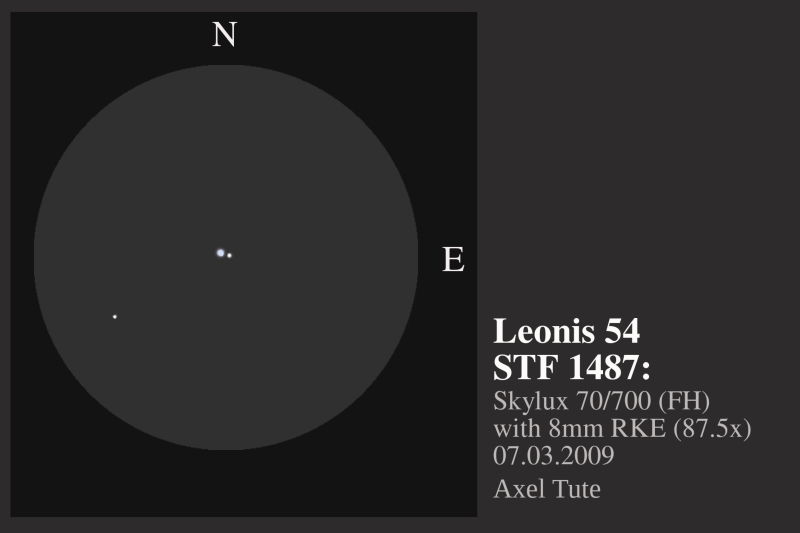
|
René Merting
Drachhausen (Germany) |
76mm (57x) |
Mondscheinnacht - bei 57x knapp getrennt - Komponente B steht im Südosten - A wirkt weißgelblich bis hellgelb, B ist mindestens 1.5 mag schwächer und wirkt stahlgrau, dadurch ein schöner Farbkontrast |
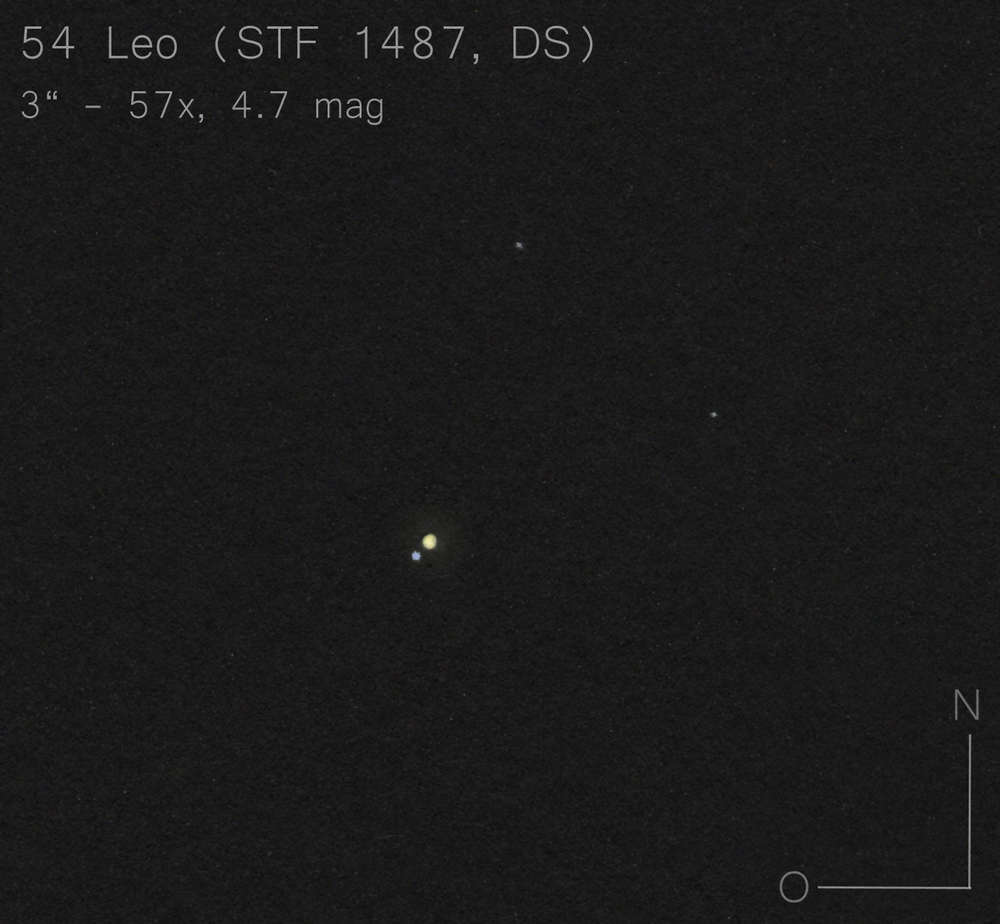
|
Sarah Gebauer
Germany |
100mm (80x) |
bei 49-fach haarscharf getrennt, die Hauptkomponente zeigt ein sehr klares, reines Weiß, der Begleiter als sehr dünner Punkt südöstlich davon wirkt etwas wärmer - bei 80-fach erscheint die Trennung geringfügig weiter, die Hauptkomponente hat nun einen schön warmgelben Farbhauch, der Begleiter wirkt dagegen kühl-weißlicher |
|
Winfried Kräling
Marburg (Germany) |
127mm (250x) |
13.03.2017: Hauptkomponente gelblich, Begleiter bläulich, deutlicher Helligkeitsunterschied. Ebenfalls bei V=60x getrennt. |
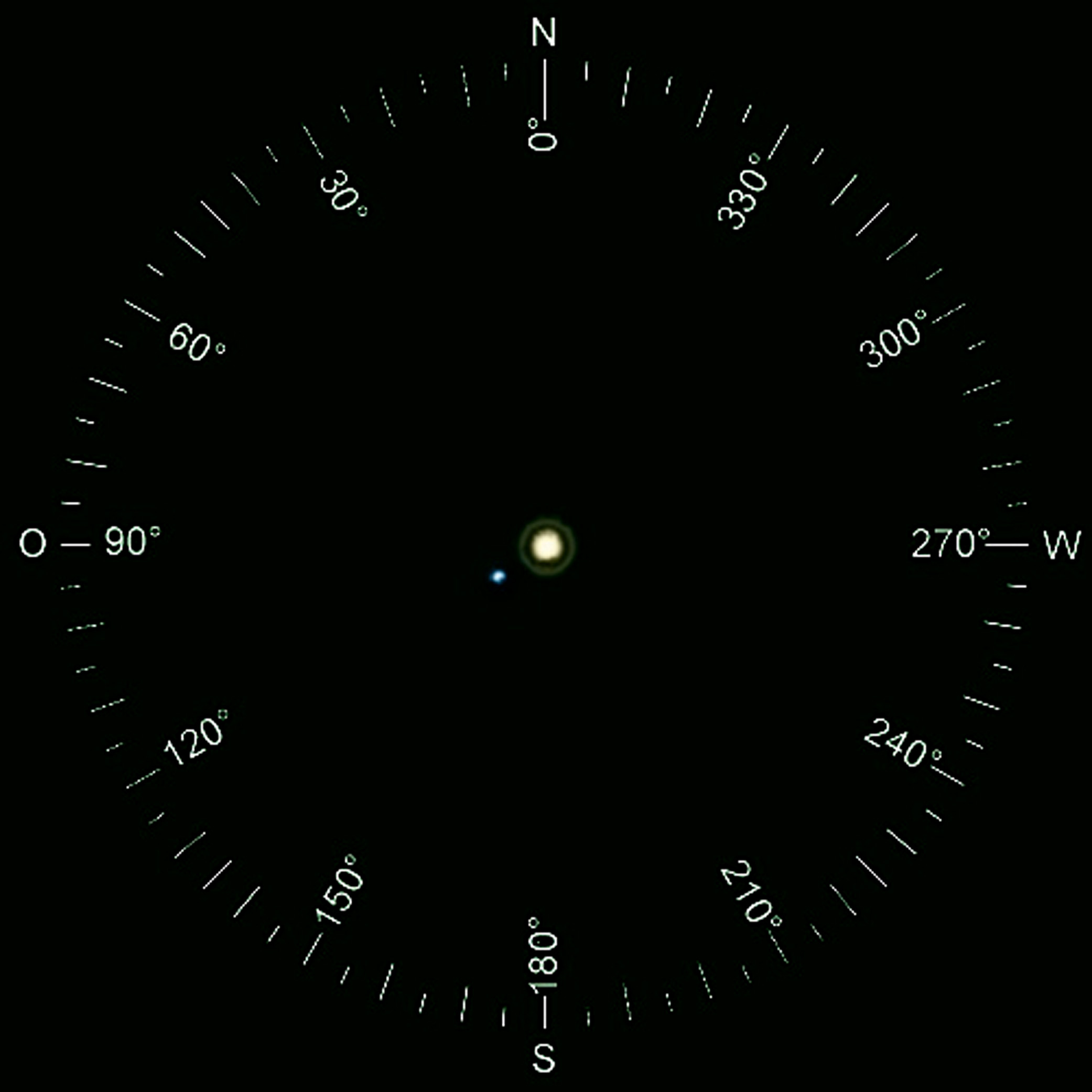
|
Axel Tute
Küssaberg (Germany) |
200mm (77x) |
07.04.2006: Separated at 77x magnification. But better at 167x. |
|
Mark McCarthy
Fremont (California/USA) |
317mm (277x) |
Bright white pair (4.5, 6.3) wide sep (6") |
|
Mark McCarthy
Fremont (California/USA) |
508mm (333x) |
54 Leo. Brilliant pair, light white-yellow stars, ~2 delta mag, wide |
|
|
Frederik Wanink
Itterbeck (Germany) |
254mm |
|
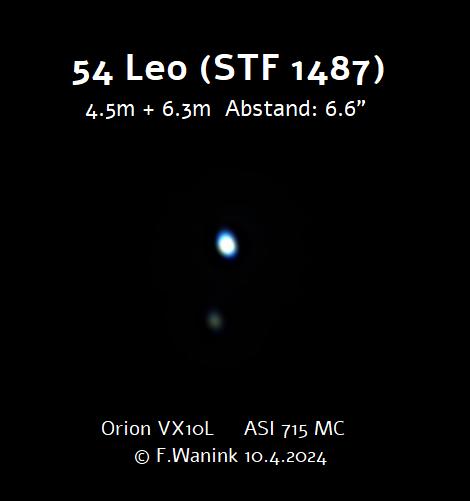
|
|
|
★
|
UC2059 & HDS1574 & COU1422 |
HDS1574 |
Aa-Ab |
7m.6 |
11m.1 |
0.3" |
99° |
2019 |
UMa |
11h01m45.73s / +36°40'41.60" |
|
|
|
UC2059 |
AB |
7m.5 |
10m.7 |
46.6" |
46° |
2015 |
|
|
|
|
|
COU1422 |
Ba-Bb |
11m.2 |
11m.5 |
0.7" |
47° |
2016 |
|
|
|
|
Mark McCarthy
Fremont (California/USA) |
317mm (553x) |
UC2059 (AB): Pretty well separated, 1.5 delta mag, not remarkable as I hoped given the odd designation. |
|
Mark McCarthy
Fremont (California/USA) |
762mm (1219x) |
COU1422 (Ba-Bb): Cou 1422 is a pair of 11th magnitude stars very close to UC 2059 -- best I could get of Cou 1422 was an elongation with the seeing. Tried 1219x without improving the elongation. |
|
|
|
★
|
A1590 |
|
|
8m.9 |
9m.6 |
1.5" |
327° |
2017 |
UMa |
11h03m27.91s / +54°31'33.00" |
|
|
Mark McCarthy
Fremont (California/USA) |
178mm (205x) |
Light orange A and blue-green B, >1" separation, half delta mag. Physical with 163-year period, it's not at apastron and won't make significant change for several decades |
|
|
|
★★
|
BU1077, alpha UMa, 50 UMa, Dubhe |
|
AB |
2m.0 |
5m.0 |
0.8" |
342° |
2017 |
UMa |
11h03m43.84s / +61°45'04.00" |
|
|
|
|
AC |
2m.0 |
7m.2 |
384.5" |
206° |
2020 |
|
|
|
|
Christopher Hay
Seeheim (Germany) |
7x45 |
AC: AC: Very wide apart but still feel as if belonging together. A golden-yellow, C seems blue, a very attractive pair.
A, B and C are a physical triple system at a distance to us of 123 light years. This is incidentally almost exactly the same distance to us as SMA75 AB, a further wide binocular pair in UMa. |
|
René Merting
Drachhausen (Germany) |
18x70 |
AC: Dubhe oder Alpha Ursae Majoris - hm, naja - C zeigt sich im Süden in Riesenabstand zum intensivgelbem A - Komponente C wirkt dagegen wie eine graue Maus und der Helligkeitsunterschied ist so enorm, dass er nicht abschätzbar ist |
|
Christopher Hay
Seeheim (Germany) |
36mm (8x) |
A wide pair but still appearing visually to belong together. Component A is a creamy gold-white. Component C is pale blue, but the colour impression fades after looking for a while. In parallel observation with 3-inch at 32x and 7-inch at 67x I see no particular colour of C, an interesting difference to observation with one-and-a-half-inch. I take a look with 7x42 binoculars and the blue impression is there again, as always with binoculars of all kinds. |
|
Robert Zebahl
Leipzig (Germany) |
70mm (22x) |
AC: 2020-04-07: Very wide, uneven & inconspicuous pair. A appeared white-yellowish, for C I could not detect any color. |
|
René Merting
Drachhausen (Germany) |
76mm (29x) |
AC: die A-Komponente präsentiert sich bei 29x als wunderschön sattgelb strahlender Stern mit ordentlichem Halo - die B-Komponente steht weit entfernt im Süden, wirkt mehr als drei Größenklassen schwächer und wirkt weißgrau |
|
René Merting
Drachhausen (Germany) |
107mm (30x) |
AC: bei 30x weit, ach was, sehr weit auseinander stehend - Komponente B ist 3 Magnituden schwächer (nein, sogar 5 Magnituden lt. Stelle Doppie) - besonders imposant ist die Farbe von A, die sehr klar wirkt, champagnergelb würde ich sagen |
|
Uwe Pilz
Leipzig (Germany) |
120mm (120x) |
|
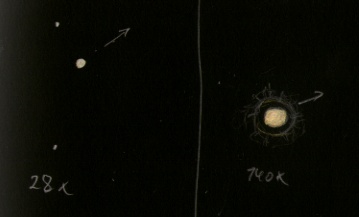
|
Robert Zebahl
Leipzig (Germany) |
152mm (43x) |
AC: 2022-04-12: Very wide and uneven pair. Component A shines in a bright, brilliant orange, companion C looks rather white. |
|
Robert Zebahl
Leipzig (Germany) |
152mm (200x) |
AB: 2022-04-12: At magnifications between 200x and 400x, there was nothing even close to a double star to be seen. The air was simply too turbulent. |
|
|
|
★★
|
HO378 |
|
AB |
8m.2 |
9m.1 |
1.1" |
234° |
2020 |
UMa |
11h04m57.29s / +38°24'38.20" |
|
|
Mark McCarthy
Fremont (California/USA) |
317mm (553x) |
In a pretty cluster in the finder (~ 12 stars loose and poor, wide magnitude range, triangle shape). Pair is a fine split 1 delta mag 1", ice blue A and slightly yellow B. |
|
|
Frederik Wanink
Itterbeck (Germany) |
254mm |
|
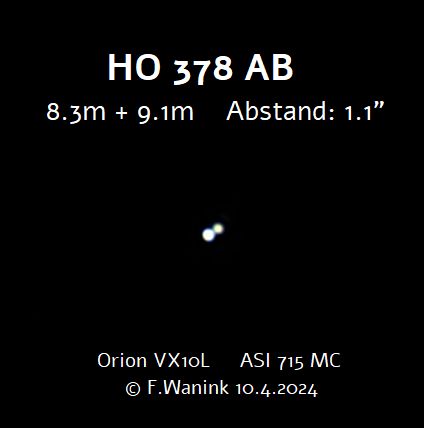
|
|
|
★
|
KUI54, chi Leo |
|
AB |
4m.7 |
11m.0 |
4.9" |
268° |
2018 |
Leo |
11h05m01.02s / +07°20'09.60" |
Mark McCarthy
Fremont (California/USA) |
178mm (205x) |
Nice! B is a tiny sharp point separated pretty well from bright A |
|
|
|
★★
|
BU599, 65 Leo |
|
|
5m.7 |
9m.7 |
2.8" |
107° |
2016 |
Leo |
11h06m54.20s / +01°57'19.90" |
Mark McCarthy
Fremont (California/USA) |
178mm (333x) |
A is a very light orange, and when seeing stills and the diffraction rings are steady, B appears as the tiniest fleck, well outside the first ring about 3", a deeper duller orange color. Physical. Burnham discovered with the 18.5-inch Washburn refractor at 1.8" -- his extra aperture helped as mine is wider but with just a 7-inch, and explains why Struve never saw it. He wrote: "It is obvious from the measures that this belongs also to the small star, and they must form a physical system." |
|
Mark McCarthy
Fremont (California/USA) |
317mm (553x) |
Bright light orange star. As seeing resolves it to a disk and eliminates the diffraction, a tiny, faint star appears, planet-like, (~3") from the star. Only at the best moments, visibility of B star helped by averted vision. |
|
|
|
★
|
STF1514 |
|
|
9m.5 |
10m.6 |
1.3" |
342° |
2016 |
UMa |
11h11m38.55s / +66°06'48.00" |
Mark McCarthy
Fremont (California/USA) |
317mm (553x) |
Extremely fine! It is at the base of a kite asterism, the fainter star of four. The three arcing the top of the kite are equal magnitude. STF 1514 is a very tight 1.5" but clean split, 1 delta mag. Nice! |
|
|
|
★
|
HO50 |
|
|
6m.5 |
8m.4 |
3.0" |
35° |
2017 |
UMa |
11h13m40.09s / +41°05'19.80" |
Mark McCarthy
Fremont (California/USA) |
178mm (205x) |
Cream white A and can see B nicely separated, about 3". Used averted vision at first to see B, then could hold direct after foveal coaxing |
|
Mark McCarthy
Fremont (California/USA) |
762mm (457x) |
The pair split immediately at 457x. A little diffraction but no doubt a small blue point just outside the first ring. Using the 8-inch aperture mask (effectively 8-inch f/18!) had a nice star image of A but B disappeared -- it became an averted vision, threshold object. Barlow here was no help to show it better. I think Ho 50B is fainter than the current data, and if the older data say it should be fainter, then it may well be variable. However, later in the night, I estimated Ho 50B to be as bright as STF 1964D, which is 9.02 |
|
|
|
★
|
STF1517 & BU1431 |
STF1517 |
AB |
7m.5 |
8m.0 |
0.7" |
313° |
2018 |
Leo |
11h13m40.99s / +20°07'43.30" |
|
|
|
BU1431 |
AB-C |
7m.5 |
10m.8 |
246.1" |
97° |
2015 |
|
|
|
|
Sarah Gebauer
Germany |
100mm (200x) |
STF1517 (AB): die Komponenten AB und C lassen sich natürlich problemlos bei geringer Vergrößerung trennen, für A und B reichen auch 200x nicht aus (Beobachtungsversuch erfolgte ohne vorherige Recherche, denn 0,7'' schafft mein Refraktor nicht) |
|
Robert Zebahl
Leipzig (Germany) |
102mm (187x) |
STF1517 (AB): 2020-03-28: At 187x the double star immediately appears elongated, but without notching. On closer observation, the slight difference in brightness could be detected. Not better at higher magnifications. Observation at quite good seeing (4/5). |
|
Uwe Pilz
Leipzig (Germany) |
105mm (200x) |
STF1517 (AB): länglich |
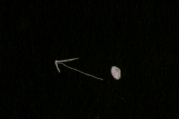
|
Robert Zebahl
Leipzig (Germany) |
152mm (225x) |
STF1517 (AB): 2020-03-27: Clearly elongated. In some moments the double star appeared notched with a small difference in brightness. Observation at moderate seeing (3/5). |
|
Mark McCarthy
Fremont (California/USA) |
317mm (340x) |
STF1517 (AB): Very tight, hair split small orange stars of equal magnitude. Wow! |
|
Mark McCarthy
Fremont (California/USA) |
508mm (533x) |
STF1517 (AB): Touching disks with 333x, clean slit with 533x, ~0.5" separation, Yellow-orange stars, near equal |
|
|
|
★
|
BU1283 |
|
|
9m.8 |
10m.4 |
0.3" |
182° |
2012 |
Leo |
11h14m24.68s / +15°30'51.80" |
Mark McCarthy
Fremont (California/USA) |
508mm (533x) |
Elongated at 533x, but the sky is too hazy, and this pair is a bright star's glare. BU 1283 looks like a piece of debris from an exploding bright star. [Theta Leo, 3.33v, to the SW] |
|
|
|
★★
|
STF1519 |
|
|
9m.0 |
9m.9 |
1.5" |
289° |
2017 |
UMa |
11h15m36.65s / +59°46'43.40" |
Mark McCarthy
Fremont (California/USA) |
317mm (553x) |
1 delta mag, tight 1.5" faint yellow stars. |
|
|
|
★★
|
STF1523, xi UMa, 53 UMa, Alula Australis |
|
AB |
4m.3 |
4m.8 |
2.3" |
152° |
2020 |
UMa |
11h18m10.90s / +31°31'45.00" |
|
|
Robert Zebahl
Leipzig (Germany) |
55mm (83x) |
2019-02-09: Already seen as '8' at 83x. At 125x the overlapping of both Airy disks was visible, but also a slight difference in brightness. |

|
Robert Zebahl
Leipzig (Germany) |
70mm (100x) |
2018-02-18: Very close together with similar brightness. At first glance seen as an '8', looking closer I partly split both components. Similar view also at 128x. |
|
Robert Zebahl
Leipzig (Germany) |
70mm (133x) |
2020-03-15: Splendid sight! Beautifully separated with almost touching diffraction disks. The rather small difference in brightness was well visible. The diffraction rings of both components coalesced. |
|
Mark McCarthy
Fremont (California/USA) |
80mm (150x) |
Alula australis. Slight magnitude difference, hairline split, light yellow A and darker yellow B. |
|
Sarah Gebauer
Germany |
100mm (136x) |
zwei gleich helle Murmelchen ganz dicht aneinander, sehr unruhiges Bild, beide Sterne strahlen warmweiß, ins Hellgoldene gehend, ohne Farbkontrast |
|
Robert Zebahl
Leipzig (Germany) |
102mm (160x) |
2020-03-16: Awesome! Bright with lovely, subtle diffraction rings. The distance between both components is a smaller than the diameter of the diffraction disk of the fainter component. |
|
Uwe Pilz
Leipzig (Germany) |
105mm (288x) |
Gemessen: 162° |
|
Robert Zebahl
Leipzig (Germany) |
120mm (168x) |
2018-02-14: Well split with slight difference in brightness. |
|
Robert Zebahl
Leipzig (Germany) |
152mm (129x) |
2019-02-06: Well split with visible difference in brightness. The colors of both components appeared equal. |
|
Mark McCarthy
Fremont (California/USA) |
508mm (333x) |
Alula Australis. Short period. Pretty orange-yellow stars, ~half delta mag, ~2" separation |
|
|
Frederik Wanink
Itterbeck (Germany) |
254mm |
|
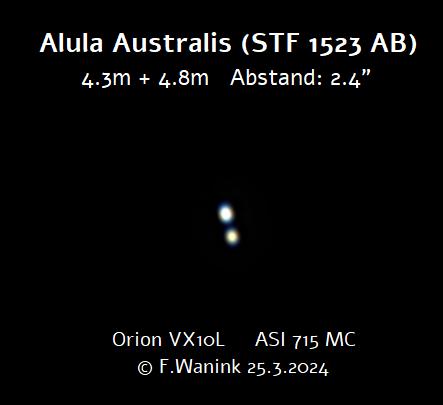
|
|
|
★
|
STF1529 |
|
|
7m.1 |
7m.9 |
9.3" |
254° |
2017 |
Leo |
11h19m22.64s / -01°39'17.60" |
Robert Zebahl
Leipzig (Germany) |
16x70 |
2021-03-02: Very nice view, medium bright, very finely separated with little difference in brightness. However, the double star was too faint for detecting color. |
|
Axel Tute
Küssaberg (Germany) |
200mm (80x) |
17.03.2009: Single. B reddish. A slightly blue. |

|
Mark McCarthy
Fremont (California/USA) |
508mm (205x) |
Easy bright yellow ~1 delta wide |
|
|
|
★
|
STF1536, iota Leo, 78 Leo |
|
AB |
4m.1 |
6m.7 |
2.3" |
92° |
2021 |
Leo |
11h23m55.37s / +10°31'46.90" |
|
|
|
|
AB-C |
4m.1 |
11m.1 |
332.1" |
346° |
2015 |
|
|
|
|
Robert Zebahl
Leipzig (Germany) |
70mm (133x) |
AB: 2020-03-28: The companion was well visible as brightening on the diffraction ring of the primary component. Sketch see observation with my 102mm refractor. |
|
Sarah Gebauer
Germany |
100mm (136x) |
AB: Iota Leo ist mit bloßem Auge schon zu erkennen - bei 49-fach taucht zunächst nur ein recht heller Stern in einem warmweißen Farbton auf - bei 80-fach wird die Farbe etwas gelblicher - bei 136-fach zeigt sich ostsüdöstlich eine Verdickung der Hauptkomponente |
|
Sarah Gebauer
Germany |
100mm (200x) |
AB: selbst bei 200x nur manchmal getrennt, eher schwierig mit Amiciprisma |
|
Robert Zebahl
Leipzig (Germany) |
102mm (125x) |
AB: 2020-03-28: At 125x clearly separated. A very beautiful sight! The companion was visible as almost round brightening close to the first diffraction ring of the primary component. The diffraction ring itself appeared very fine. At 224x also a very nice sight with a clear diffraction ring and the companion, which now appeared roundish. |
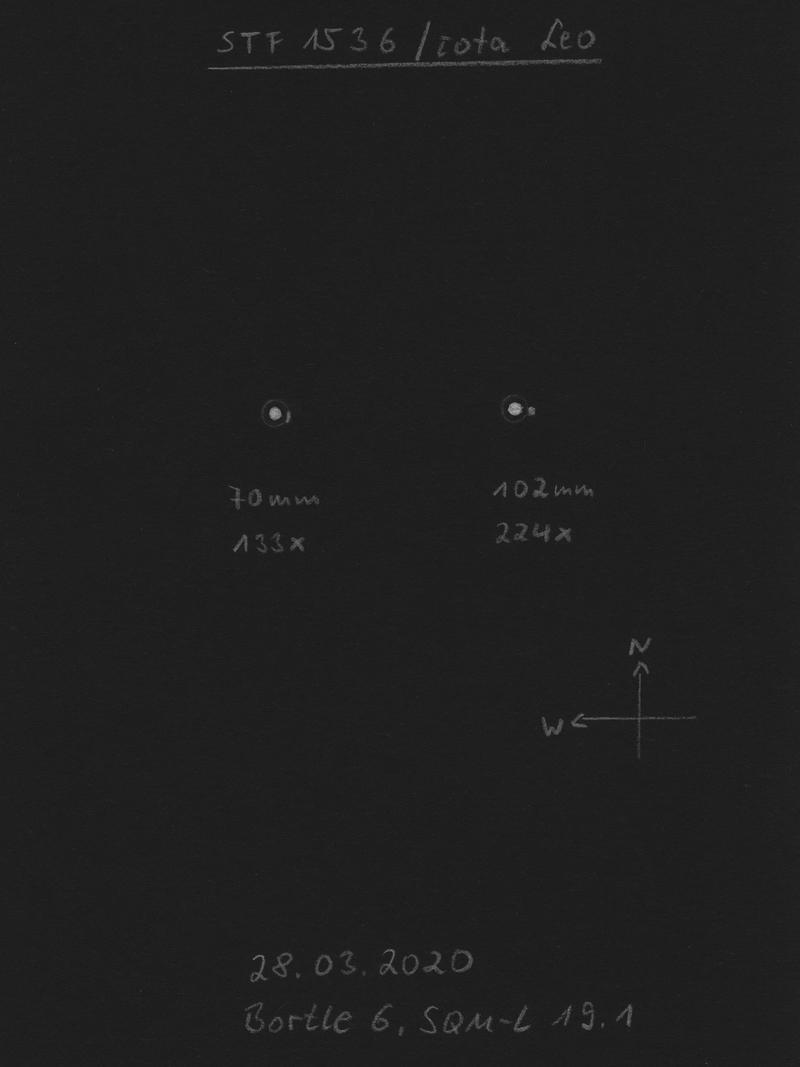
|
Sarah Gebauer
Germany |
254mm (96x) |
AB: bei 96-fach zeigen die Sterne einen warmweißen Farbton mit einem warmgelben Farbhauch |
|
Mark McCarthy
Fremont (California/USA) |
317mm (340x) |
AB: Quite close, very bright yellow white A and brownish B, split in A's diffraction ring |
|
Mark McCarthy
Fremont (California/USA) |
508mm (333x) |
AB: Iota Leo. Light orange A and a richer orange B, ~2 delta mag, ~2" separation |
|
|
|
★★
|
81 Leo |
HJ4433 |
AB |
5m.6 |
10m.8 |
55.4" |
6° |
2018 |
Leo |
11h25m36.37s / +16°27'23.50" |
|
|
|
SHY224 |
AC |
5m.6 |
7m.2 |
999.9" |
207° |
1998 |
|
|
Christopher Hay
Seeheim (Germany) |
10x56 |
AC: Handheld. Components A and C, making up Shaya 224, are well framed in 6.3° FOV. Component A is cold blue.
Component C (= HIP 55262) is about three-and-a-half degrees south-southwest of component A (= 81 Leo) and is close to the Leo Triplet of galaxies. Two galaxies of the Triplet present themselves (sky quality: NELM 5m0 in target area), M66 is an elongated little nebula with its main axis pointing roughly towards C, while M65 is a faint but definite nebular presence with direct vision, closer to C than M66 is.
Shaya 224 is a physical double at a distance to us of 143 light years. |
|
René Merting
Drachhausen (Germany) |
100mm (64x) |
AB: bei 64x ploppt Komponente B weit getrennt nördlich von A auf, vorher war sie unsichtbar - B versteckt sich halb im Glanz von A - schönes Versteckspiel |
|
Mark McCarthy
Fremont (California/USA) |
317mm (170x) |
AB: bright orange-yellow A with a much fainter blue B, widely separated, a beautiful sight. |
|
René Merting
Drachhausen (Germany) |
320mm (45x) |
AB: bei 45x strahlt Komponente A gleißend hell und leicht gelblich - B zeigt sich gut abgesetzt ganz schwach im NO von A - kein echtes Doppelstern-Feeling - bei 72x verliert A ein wenig Farbe, B ist ein graues Pünktchen |
|
|
|
★★
|
STF1540, 83 Leo |
|
AB |
6m.5 |
7m.5 |
28.6" |
146° |
2019 |
Leo |
11h26m45.32s / +03°00'47.20" |
Stefan Loibl
Rosenheim (Germany) |
10x50 |
clearly split, little difference in magnitude |
|
Christopher Hay
Seeheim (Germany) |
10x56 |
On tripod. Neat split. Attractive 6.3° FOV with a sprinkling of several 5- to 7-mag stars to the south. Tau Leo widely split directly to southeast.
In 15x60 on tripod well split, component A slightly orange, forms a fine double-double with Tau Leo.
83 Leo is a physical double at a distance to us of only 58 light years. |
|
Robert Zebahl
Leipzig (Germany) |
16x70 |
2021-03-02: Splendid sight together with the double star tau Leo as well as 82 Leo. Beautiful star field. 83 Leo very nicely separated with moderate difference in brightness. Yellowish orange & slightly orange. |
|
René Merting
Drachhausen (Germany) |
18x70 |
ein ordentlich getrenntes und dennoch schön eng stehendes Pärchen - Komponente A ist leicht gelblich, Komponente B im SO ist eine dreiviertel Magnitude schwächer und grauweiß |
|
Robert Zebahl
Leipzig (Germany) |
55mm (16x) |
Wonderful double with slight color contrast in a very nice field. Together with tau Leo stunning view. Slightly unequal. A appeared white-yellowish, B rather grey-bluish. |
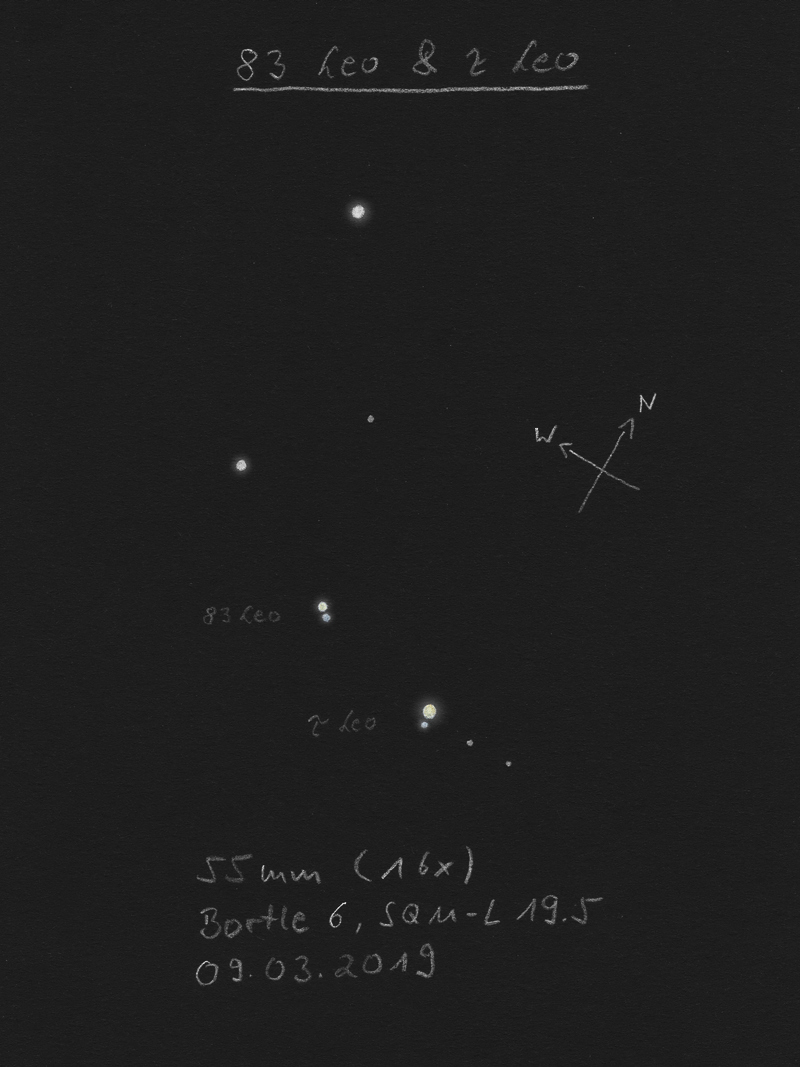
|
René Merting
Drachhausen (Germany) |
76mm (29x) |
Mondscheinnacht - bei 29x ein schönes Doppel-Doppel zusammen mit Tau Leo (STFA19) weiter östlich - beide Sterne von STF 1540 sind etwas mehr als ordentlich getrennt sichtbar - die B-Komponente im Südosten ist gut eine Größenklasse schwächer und wirkt grau gegen die warmweiß-gelblich strahlende A-Komponente, dadurch ein leichter Farbkontrast |
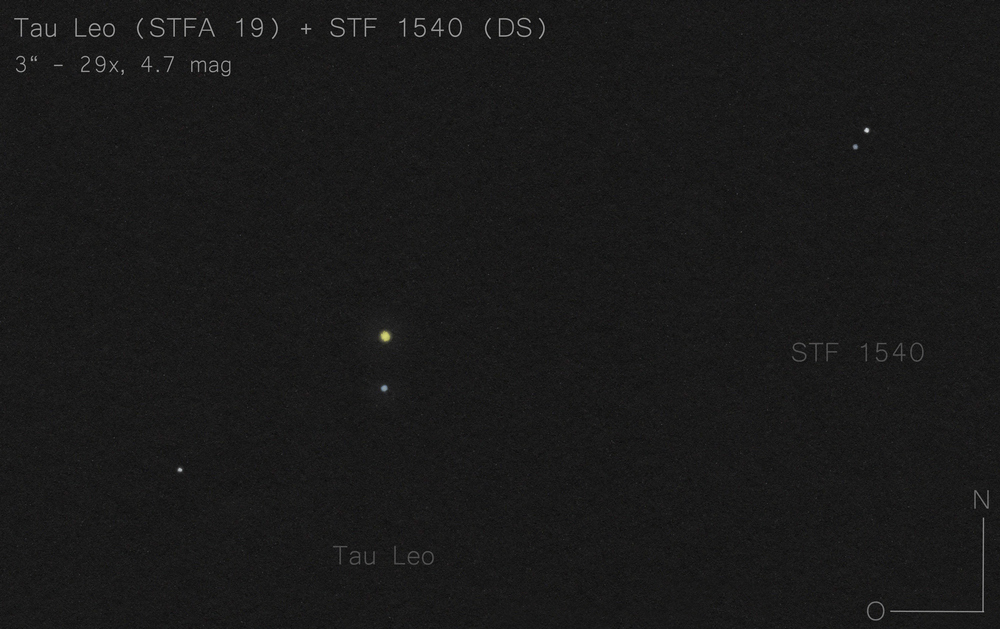
|
Mark McCarthy
Fremont (California/USA) |
80mm (13x) |
Finder split, in same field as Tau. |
|
Sarah Gebauer
Germany |
100mm (21x) |
bei 20-fach gut getrennt, ein wesentlich schwächeres, kleineres und engeres Paar als STFA 19 im selben GF - die nördliche Komponente strahlt warmgold, die südöstliche ähnlich, jedoch schwächer und matter |

|
Mark McCarthy
Fremont (California/USA) |
178mm (205x) |
Light orange-yellow A and light blue B, >1 delta mag, very wide. Physical with 32,000-year period. Running this through the Plot Tool with EDR3 data, it confirms it is physical, only 18 parsecs / 58 light years away (which is why it has such a high proper motion) and 520 AU separation |
|
Mark McCarthy
Fremont (California/USA) |
317mm (340x) |
Yellow A and reddish B wide separation. |
|
René Merting
Drachhausen (Germany) |
320mm (72x) |
bei 72x steht das Paar zwar weit auseinander, es wirkt aber trotzdem gut zusammengehörend - Komponente B im SO ist eine dreiviertel Magnitude schwächer |
|
|
|
★★
|
STFA19, 84 Leo, tau Leo |
|
AB |
5m.0 |
7m.5 |
89.2" |
181° |
2019 |
Leo |
11h27m56.23s / +02°51'22.50" |
Christopher Hay
Seeheim (Germany) |
7x50 |
On tripod. Comfortably split. Component A is mildly orangish-yellow.
Can't quite eke out 83 Leo's secondary (NELM 5m0, elevation 40°). |
|
Christopher Hay
Seeheim (Germany) |
15x45 |
Binoculars with internal stabilisation, handheld. Wide pair. Component A dull golden-yellow, component B seems bluish. Attractive.
In 15x60 on tripod very wide. Component A very mild orange, B grey-blue. Fine sight in 3.3° FOV together with well-split 83 Leo. |
|
Robert Zebahl
Leipzig (Germany) |
16x70 |
2021-03-02: Splendid sight together with the double star 83 Leo as well as 82 Leo. Beautiful star field. Tau Leo beautifully separated with significant difference in brightness. Yellowish & bluish. |
|
Robert Zebahl
Leipzig (Germany) |
55mm (16x) |
Wonderful double with slight color contrast in a very nice field. Together with 83 Leo stunning view. Noticeable unequal. A appeared white-yellowish with a hint of orange, B grey-bluish. |

|
René Merting
Drachhausen (Germany) |
76mm (29x) |
Mondscheinnacht - bei 29x ein schönes Doppel-Doppel zusammen mit STF 1540 weiter westlich - Tau Leo ist komfortabel getrennt erkennbar - Komponente A strahlt Ampelgelb, Komponente B ist 2 Größenklassen schwächer und strahlt stahlgrau mit einem Stich ins Blaue |

|
Mark McCarthy
Fremont (California/USA) |
80mm (13x) |
Finder split, the A star is prismatic in color effects, bluish B |
|
Sarah Gebauer
Germany |
100mm (21x) |
bei 20-fach zeigt die nördliche A-Komponente einen schön warmgoldenen Farbton, die südliche B-Komponente dagegen erscheint deutlich schwächer und in einem kühlen Grau mit einem Hauch von Blau - ein schöner Farbkontrast und zudem mit STF 1540 zusammen in einem GF |

|
Mark McCarthy
Fremont (California/USA) |
317mm (340x) |
Bright yellow A, bluish B, very widely separated |
|
|
|
★
|
STF1547, 88 Leo |
|
AB |
6m.3 |
9m.1 |
15.7" |
330° |
2020 |
Leo |
11h31m44.94s / +14°21'52.20" |
|
|
Robert Zebahl
Leipzig (Germany) |
55mm (42x) |
Well split with moderate distance. Primary component appeared white-yellowish. Pretty unequal pair. |
|
René Merting
Drachhausen (Germany) |
100mm (32x) |
bei 32x erscheint Komponente B nordwestlich von A etwas mehr als knapp getrennt ganz schwach, bestimmt 3 Größenklassen Helligkeitsunterschied - Komponente A warmweiß, B ist grau |
|
Sarah Gebauer
Germany |
100mm (45x) |
fein, aber gut getrennt, die südliche Komponente ist deutlich heller, die nordwestliche zeigt sich als ganz schwacher Punkt |
|
Sarah Gebauer
Germany |
100mm (49x) |
bei 49-fach ein gut getrenntes, schwaches Pärchen - die nordöstliche Komponente zeigt ein ganz zartes Orange, die südwestliche zeigt einen ähnlichen, lediglich abgeschwächten, dunklen und matten Farbton |
|
Uwe Pilz
Leipzig (Germany) |
105mm (88x) |
gelb und violett |

|
Mark McCarthy
Fremont (California/USA) |
178mm (205x) |
Very light yellow and 2 delta, very wide B. Physical, with a 3453-year period, it is also close-by at 23.33 pc |
|
Axel Tute
Küssaberg (Germany) |
200mm (80x) |
18.05.2007: Simple. A is slightly yellowish. B is slightly reddish. |
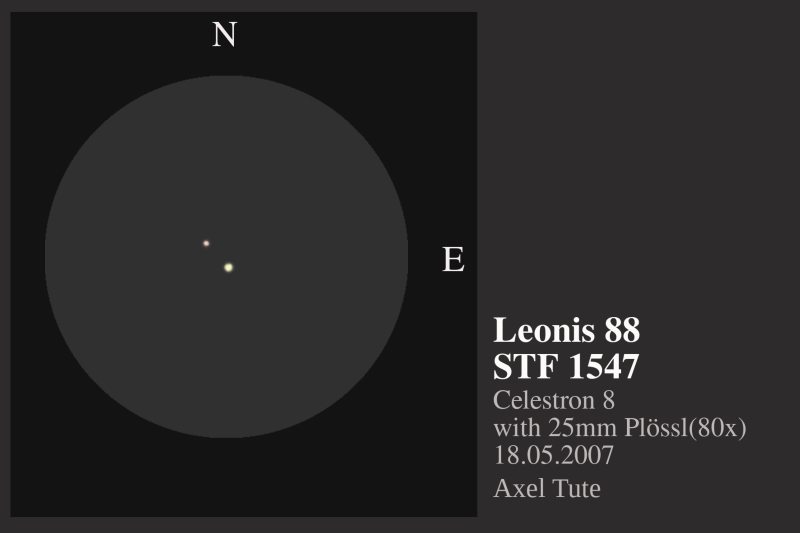
|
Gerd Kohler
Langenzenn (Germany) |
254mm (76x) |
Der Doppelstern ist getrennt.Bläulich-weiß - orange-leicht rötlich. Etwas schwächerer Begleiter. |
|
Mark McCarthy
Fremont (California/USA) |
317mm (340x) |
88 Leonis: A favorite! Yellow and blue pair, wide |
|
René Merting
Drachhausen (Germany) |
320mm (45x) |
bei 45x ein schönes enges Sternpaar, ordentlich getrennt - Komponente A strahlt hellgelb, B ist deutlich schwächer und empfiehlt sich mit einem Kupferton - ein schöner Farbkontrast |
|
|
|
★★
|
STT235 |
|
AB |
5m.7 |
7m.5 |
0.9" |
43° |
2017 |
UMa |
11h32m20.76s / +61°04'57.90" |
|
|
Mark McCarthy
Fremont (California/USA) |
317mm (553x) |
Nice! Yellow and orange, 1.5 delta mag, split when seeing shows perfect disks. The stars both show albedo effects, look like suns / globes with shadowing. |
|
Mark McCarthy
Fremont (California/USA) |
508mm (533x) |
Short period. Pretty yellow A, orange B, ~1" ~2 delta mag |
|
|
|
★★★
|
STF1552, 90 Leo |
|
AB |
6m.3 |
7m.3 |
3.1" |
209° |
2018 |
Leo |
11h34m42.50s / +16°47'48.90" |
|
|
|
|
AC |
6m.3 |
9m.8 |
63.4" |
235° |
2018 |
|
|
Robert Zebahl
Leipzig (Germany) |
55mm (42x) |
AB: A and B very tight and unequal. Much fainter component C very wide apart. All components almost in line. Very nice view. |
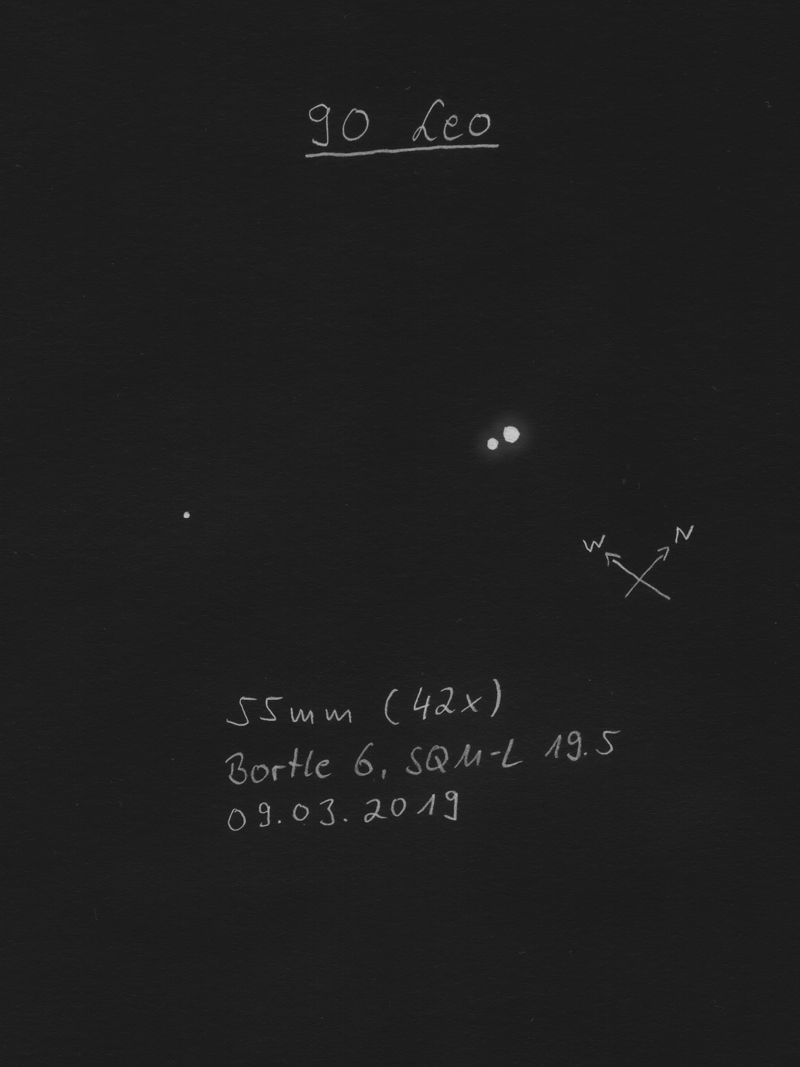
|
Axel Tute
Küssaberg (Germany) |
70mm (117x) |
AB: 07.03.2009: Separation requires 117x. A & B are white. |

|
Sarah Gebauer
Germany |
100mm (136x) |
lange Zeit nach der ersten Beobachtung nun auch die Komponenten A und B getrennt, was bei 136x gut gelingt |
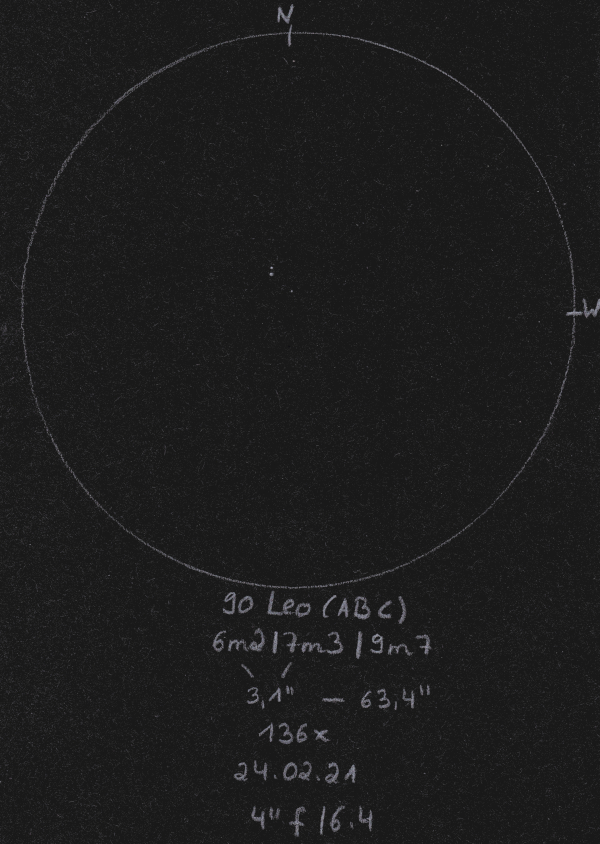
|
René Merting
Drachhausen (Germany) |
100mm (142x) |
AB: bei 64x wirken die Komponenten A und B wie eine 8 - bei 142x dann die Gewissheit, B ist jetzt allein erkennbar, vom Positionswinkel südwestlich, aber etwas südlicher als C - Helligkeitsunterschied eine dreiviertel Größenklasse - B wirkt hellorange gegen die weiße Komponente A
AC: bei 32x ist Komponente C ziemlich weit südwestlich von A erkennbar - Helligkeitsunterschied mindestens 2.5 Größenklassen |
|
Uwe Pilz
Leipzig (Germany) |
105mm (88x) |
bläulich und violett |

|
Sarah Gebauer
Germany |
150mm (30x) |
AB: einfach zu trennen, erst bei 83x, dann auch bei 30x, sehr feine Punkte mit sichtbarem Helligkeitsunterschied |
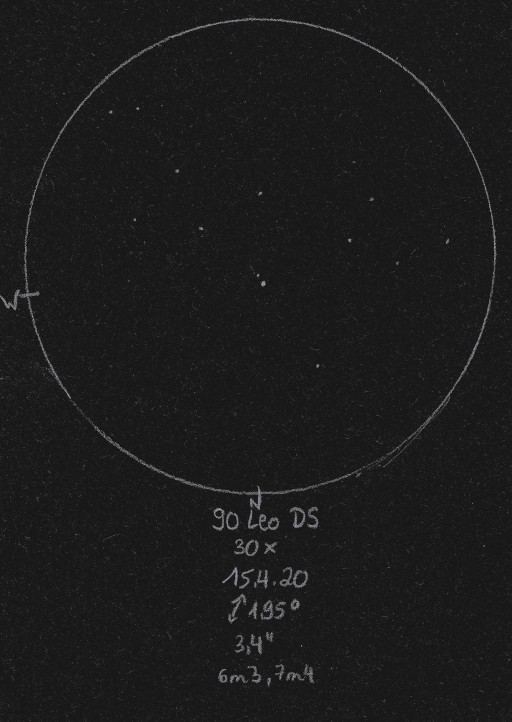
|
Axel Tute
Küssaberg (Germany) |
200mm (167x) |
18.05.2007: Simple with the C8 at 167x. No colours |
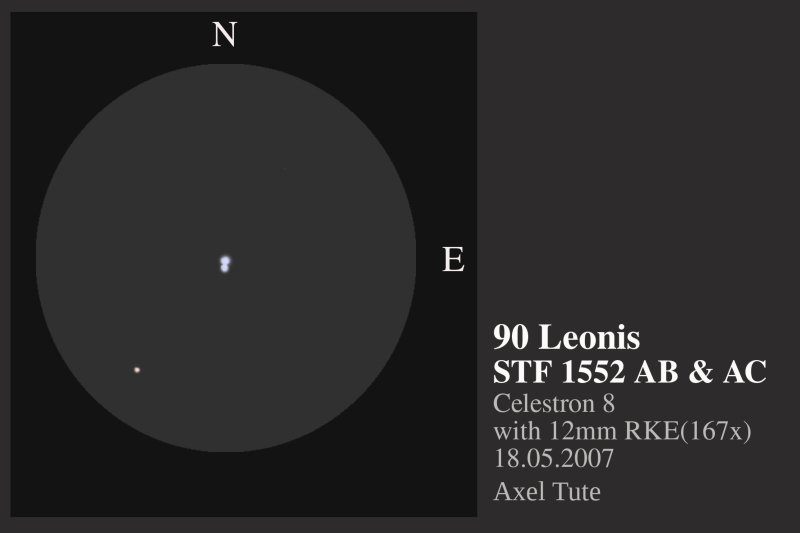
|
Mark McCarthy
Fremont (California/USA) |
317mm (170x) |
AB: 90 Leonis, a close but easily split pair at 170x, a yellow-white A and a bluish-white B. |
|
Mark McCarthy
Fremont (California/USA) |
508mm (333x) |
AB: 90 Leo. Blazing white pair, ~1 delta mag, ~3" |
|
|
|
★
|
STF1555 & HJ503 |
STF1555 |
AB |
6m.4 |
6m.8 |
0.7" |
151° |
2022 |
Leo |
11h36m17.94s / +27°46'52.70" |
|
|
|
HJ503 |
AB-C |
5m.8 |
11m.2 |
22.5" |
156° |
2016 |
|
|
|
|
Frederik Wanink
Itterbeck (Germany) |
254mm (640x) |
STF1555 (AB): blickweise gerade eben trennbar |
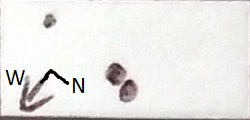
|
Mark McCarthy
Fremont (California/USA) |
317mm (443x) |
STF1555 (AB): Nice! AB tight hair-split white pair, with fainter & wide separated AB-C in a row to the east. |
|
Mark McCarthy
Fremont (California/USA) |
317mm (443x) |
HJ503 (AB-C): Nice! STF 1555AB tight hair-split white pair, with fainter & wide separated C in a row to the east. |
|
Mark McCarthy
Fremont (California/USA) |
508mm (553x) |
STF1555 (AB): Hairline split at 333x, clear split with 533x, very close ~0.5", bright. Part of plus one |
|
|
|
★★
|
STF1559 |
|
|
6m.8 |
8m.0 |
2.0" |
326° |
2019 |
UMa |
11h38m49.11s / +64°20'49.40" |
Robert Zebahl
Leipzig (Germany) |
70mm (133x) |
2020-04-14: Two clearly visible, slightly touching diffraction disks. The fainter companion appeared somewhat more diffuse. Occasionally the double star appeared separated. |
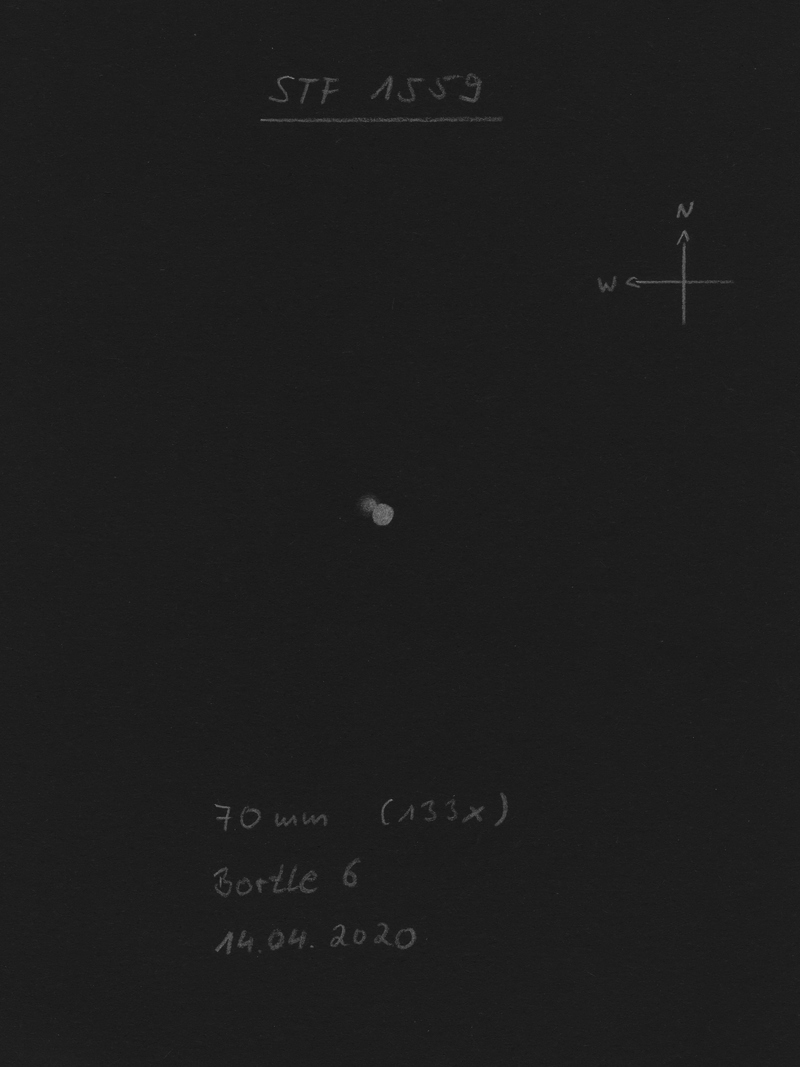
|
Mark McCarthy
Fremont (California/USA) |
178mm (205x) |
Very striking colors, A is a strong blue-white, and 2 delta mag B is a reddish orange color, about 3" separation, a very great pair! |
|
|
|
★
|
BU603 |
|
AB |
6m.0 |
8m.5 |
1.0" |
329° |
2019 |
Leo |
11h48m38.71s / +14°17'03.20" |
|
|
Mark McCarthy
Fremont (California/USA) |
80mm (150x) |
Elongated but not split. 129-year period |
|
Uwe Pilz
Leipzig (Germany) |
105mm (200x) |
sehr schwierig |

|
Uwe Pilz
Leipzig (Germany) |
105mm (288x) |
nicht getrennt |
|
Mark McCarthy
Fremont (California/USA) |
203mm (533x) |
Suspected at 205x and 333x but needed higher magnification to see it. B is a very small point, with seeing, in the first diffraction ring. ~1" and ~3 delta mag |
|
|
|
★
|
STF1575 |
|
|
7m.4 |
7m.9 |
30.5" |
210° |
2021 |
Vir |
11h51m57.57s / +08°49'48.00" |
Robert Zebahl
Leipzig (Germany) |
16x70 |
2021-03-02: Very nice view! Very striking in the field together with xi Vir, 4 & 6 Vir. Fairly bright with moderate separation. Slightly orange & grey-bluish. |
|
René Merting
Drachhausen (Germany) |
18x70 |
ein sehr komfortabel getrenntes Sternpaar - B im Südwesten ist eine halbe Größenklasse schwächer - A weißorange, B weißbläulich - ein ansehnlicher FG-Stern |
|
René Merting
Drachhausen (Germany) |
100mm (32x) |
bei 32x ein schön getrenntes Sternpaar mit zwei ähnlich hellen Sternen - Komponente B im SW ist maximal eine halbe Größenklasse schwächer - deutlich wahrnehmbarer Farbkontrast, A ist weißgelb, B dagegen wirkt blaugrau |
|
Sarah Gebauer
Germany |
100mm (49x) |
schon bei 20-fach getrennt als zwei dünne Lichtpünktchen zu sehen - die nordöstliche A-Komponente hat einen warmorange Farbton, der südwestliche wirkt etwas farbloser, schwächer und matter - bei 49-fach ordentlich getrennt, A strahlt nun etwas intensiver orangegold, B wirkt nun bräunlich |
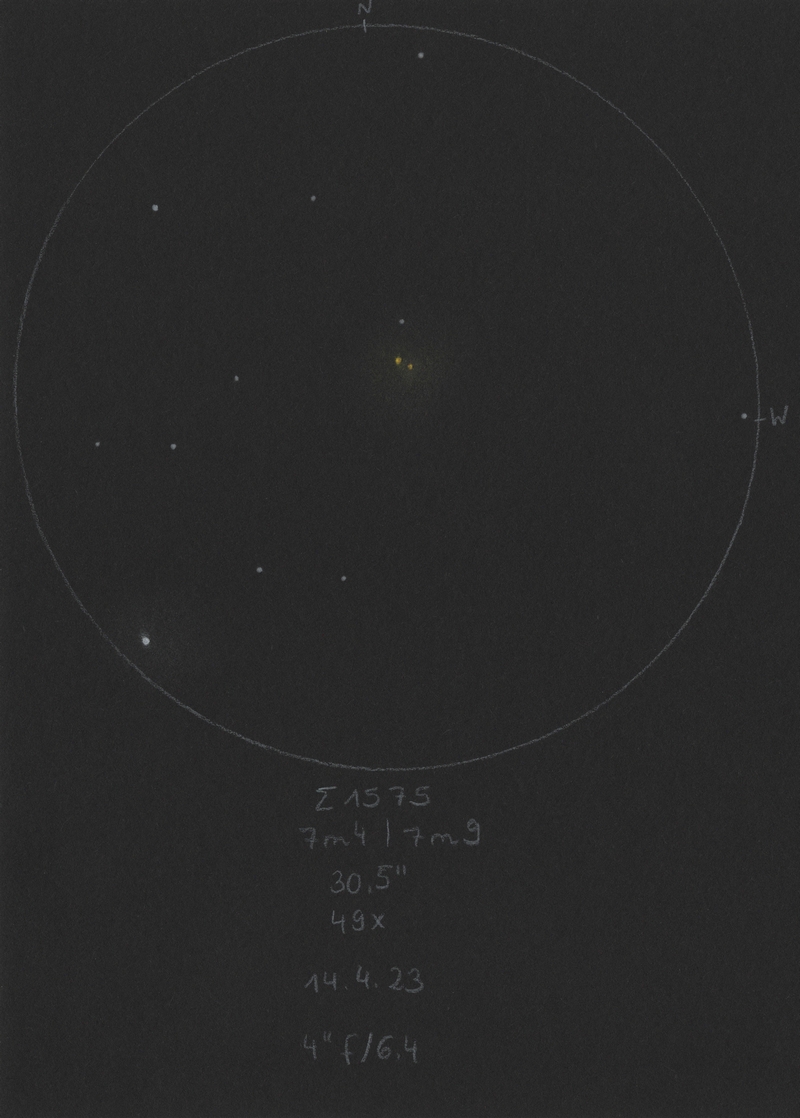
|
René Merting
Drachhausen (Germany) |
320mm (72x) |
bei 72x zwei gleichhelle Sterne, die weit getrennt auseinander stehen - A im NO ist leicht gelblich, B mit einem leichten Schlag ins Blaue, sprich weißblau - dadurch zarter Farbkontrast - beide Sterne sind schön hell und auffällig im Umfeld |
|
|
Berthold Fuchs
Wiesbaden (Germany) |
130mm |
easy DS |

|
|
|
★
|
STTA112 |
|
AB |
8m.3 |
8m.5 |
73.4" |
36° |
2017 |
Leo |
11h54m32.07s / +19°24'40.40" |
Christopher Hay
Seeheim (Germany) |
7x45 |
Handheld. In good moments well separated, two fine pinpricks of light. Hard to maintain split at 7x handheld under my 5m0 NELM sky. On tripod or under a slightly better sky probably a pleasant matched pair.
A physical double at a distance to us of 132 light years. |
|
Christopher Hay
Seeheim (Germany) |
15x60 |
Wide, very evenly matched pair, dominates the 3.3° FOV. Primary seems more orange than the secondary, but this is uncertain. |
|
|
|
★
|
STF1579, 65 UMa |
|
AB-C |
6m.7 |
8m.3 |
3.7" |
44° |
2021 |
UMa |
11h55m05.74s / +46°28'36.60" |
|
|
|
|
AB-D |
6m.7 |
7m.0 |
62.9" |
114° |
2021 |
|
|
Christopher Hay
Seeheim (Germany) |
7x45 |
AB-D: Handheld. A bit difficult due to hand tremor, but clearly split with definite delta-mag. Nice in 8.6° FOV together with 67 UMa (Forgeren), which for its part has a bluish companion at a separation of about 300".
With 15x45 stabilised binoculars AB-D is an easy wide split, AB warmer, D colder in hue.
A physical pair at a distance to us of 691 light years. |
|
Robert Zebahl
Leipzig (Germany) |
8x40 |
AB-D: 2020-04-05: Immediately conspicuous in the field. Medium bright double star with slightly uneven components. Western component AB appeared slightly orange, component D tended to be bluish. |
|
Robert Zebahl
Leipzig (Germany) |
55mm (27x) |
AB-D: Easy to separate with large distance and very small difference in brightness. The D component showed a bluish tint, the lighter one (AB) a slightly yellowish tint. At higher magnification also the faint C component is visible. |
|
Robert Zebahl
Leipzig (Germany) |
55mm (83x) |
2019-02-09: AB, C & D easy to split, but the faint C component only appeared as a tiny star. To the south there is the brighter D component. |
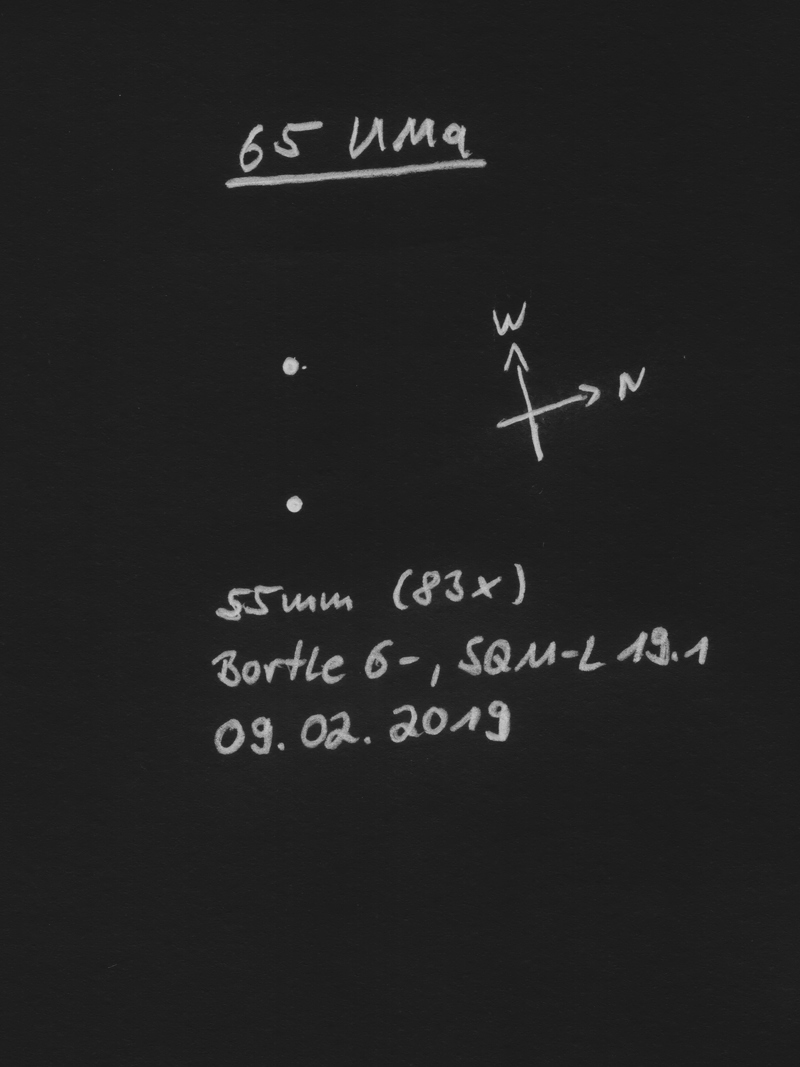
|
|
Robert Zebahl
Leipzig (Germany) |
|
|
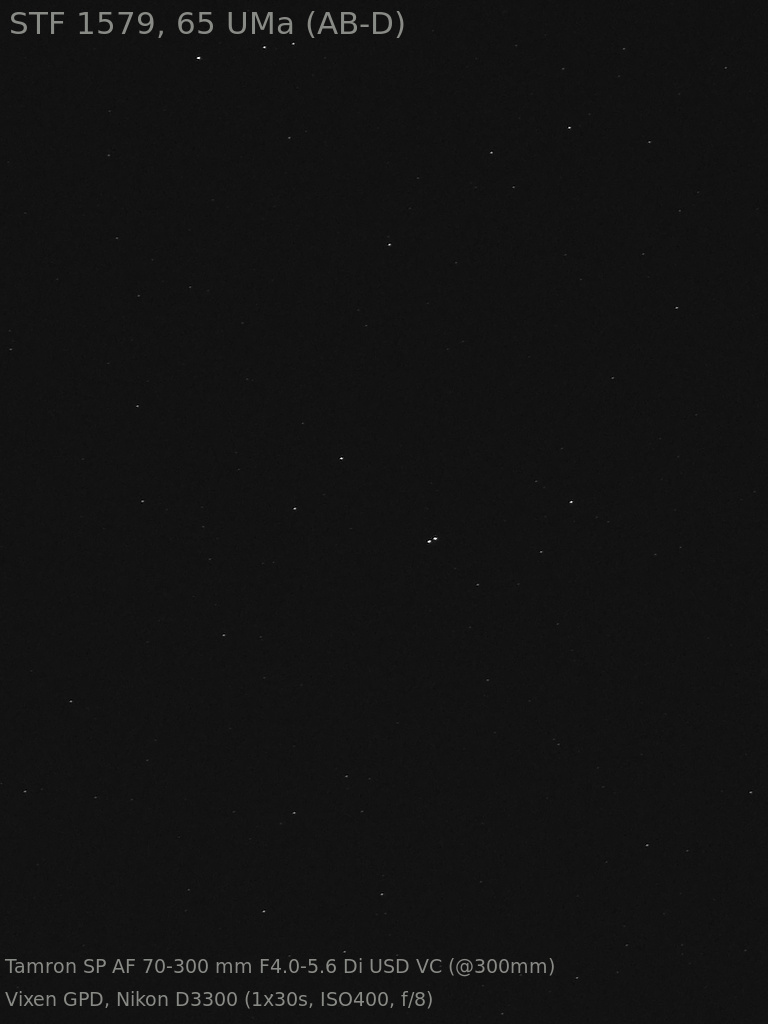
|
|
|
★
|
BRT2289 |
|
|
11m.1 |
11m.1 |
1.6" |
87° |
2015 |
Leo |
11h56m07.55s / +20°15'08.20" |
Mark McCarthy
Fremont (California/USA) |
508mm (333x) |
Very fine near equal white, nice and clean |
|
|
|
★
|
STT243 |
|
|
9m.1 |
9m.7 |
1.2" |
8° |
2017 |
UMa |
11h59m48.70s / +53°23'52.10" |
Mark McCarthy
Fremont (California/USA) |
178mm (205x) |
Wow very good, excellent with seeing, 1 delta mag and 1" separation, more than hairline split |
|
Mark McCarthy
Fremont (California/USA) |
317mm (553x) |
Super tight split ~1", faint, white, 1 delta mag. M109 is nearby just in of FOV. This pair just beneath its core |
|
|
|
★
|
A2163 |
|
|
10m.3 |
10m.4 |
0.7" |
169° |
2016 |
Com |
12h02m12.09s / +21°07'36.90" |
Mark McCarthy
Fremont (California/USA) |
508mm (533x) |
Excellent pair. Hairline split at 333x, nice wide split with 533x. Near equal, >0.5" |
|
|
|
★
|
STF1603 |
|
AB |
7m.8 |
8m.3 |
22.2" |
83° |
2021 |
UMa |
12h08m07.07s / +55°27'50.70" |
Robert Zebahl
Leipzig (Germany) |
16x70 |
2022-03-27: Medium bright at moderate separation and slight difference in brightness. Slight color difference: yellowish & slightly bluish. |
|
René Merting
Drachhausen (Germany) |
18x70 |
ein Sternpaar, das zu gefallen weiß, etwas mehr als knapp getrennt - B im Nordosten wirkt eine viertel Größenklasse schwächer - leichter Farbunterschied, wobei B Zartorange, Braunweiß, Ockergrau oder so wirkt, naja |
|
Robert Zebahl
Leipzig (Germany) |
70mm (22x) |
2020-04-07: At 22x quite apparent double star in rather poor surrounding. Nice separation with little difference in brightness. Primary component appeared slightly orange, companion grey-bluish. At 44x similar view in color appearance. |
|
Sarah Gebauer
Germany |
100mm (45x) |
schwach, sauber getrennt, nahezu gleich hell, die westliche Komponente ist minimal heller |
|
René Merting
Drachhausen (Germany) |
320mm (45x) |
bei 45x gut getrennt - Komponente B im Osten wirkt grauorange gegen die weiß strahlende Komponente A - Helligkeitsunterschied eine halbe Größenklasse - ein schön isoliert stehendes Sternpaar |
|
|
Frederik Wanink
Itterbeck (Germany) |
254mm |
|

|
|
|
★★
|
STF1622, 2 CVn |
|
|
5m.9 |
8m.7 |
11.6" |
260° |
2017 |
CVn |
12h16m07.55s / +40°39'36.60" |
Sarah Gebauer
Germany |
100mm (49x) |
02.10.23: horizontnahe Beobachtung - bei 49-fach knapp, aber gut getrennt zu sehen, durch die Horizontnähe keine weiteren Sterne mit im Bild - A strahlt sehr stark kupfergolden, ein sehr intensiver und seltener Farbton, B wirkt extrem schwach und dunkelgrau daneben |
|
René Merting
Drachhausen (Germany) |
107mm (30x) |
bei 30x ein wunderschöner farbiger, knapp getrennter Doppelstern, A zeigt sich gleißend und strahlend Bernsteingelb, B im Westen ist deutlich schwächer, es fällt mir schwer, die Farbe zu bestimmen - bei 43x ist die Farbe von B Grauweiß |
|
Robert Zebahl
Leipzig (Germany) |
120mm (86x) |
2021-04-04: Beautiful double star with components of very different brightness. Primary component is shining in bright, brilliant orange, the well separated companion appears grey-bluish. |
|
Mark McCarthy
Fremont (California/USA) |
203mm (205x) |
2 CVn Very pretty orange and blue stars, ~3 delta mag, wide. (not physical) |
|
|
|
★
|
BU27 |
|
|
7m.1 |
10m.5 |
3.6" |
104° |
2016 |
Com |
12h20m04.86s / +13°51'18.20" |
Mark McCarthy
Fremont (California/USA) |
317mm (553x) |
Light orange A and very faint bluish B, seen with averted vision at first then can hold direct. ~4" to west. Nice! |
|
|
|
★★
|
STF1636, 17 Vir |
|
|
6m.5 |
9m.3 |
21.0" |
338° |
2017 |
Vir |
12h22m32.14s / +05°18'20.10" |
René Merting
Drachhausen (Germany) |
15x56 |
meist klebt B noch nordwestlich an A, in ruhigen Momenten kann ich beide Komponenten knapp getrennt erkennen - B ist eine Miniperle ggü. A |
|
René Merting
Drachhausen (Germany) |
18x70 |
A und B sind knapp getrennt erkennbar - B sitzt im NW von A - großer, nicht abschätzbarer Helligkeitsunterschied - nett anzusehen, wenn man B erst einmal entdeckt hat |
|
Sarah Gebauer
Germany |
100mm (21x) |
bei 20-fach ganz knapp getrennt mit einem deutlichen Helligkeitsunterschied - für einen Farbeindruck reicht die Vergrößerung nicht aus - bei 49-fach färbt sich die Hauptkomponente sehr schön roségold - der deutlich schwächere Begleiter wirkt nun grau-bräunlich - das Sternumfeld ist dank lose verstreuter Sterne in einem großen Bogen von Norden über Osten nach Süden um den Doppelstern herum besonders schön |
|
Mark McCarthy
Fremont (California/USA) |
317mm (340x) |
17 Virginis, widely separated, large magnitude difference, with a yellow-white A and a ruddy / brownish B |
|
|
Berthold Fuchs
Wiesbaden (Germany) |
130mm |
easy DS |
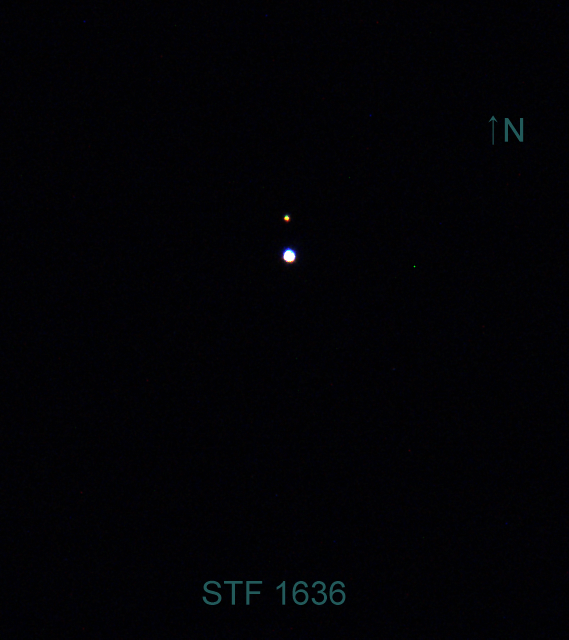
|
|
|
★
|
STT249 |
|
AB |
8m.2 |
9m.2 |
0.4" |
257° |
2016 |
UMa |
12h23m50.80s / +54°09'30.50" |
Mark McCarthy
Fremont (California/USA) |
317mm (738x) |
very slightly notched elongation / overlapped disks. |
|
|
|
★
|
STF1646 |
|
|
10m.3 |
12m.9 |
5.6" |
260° |
2017 |
CVn |
12h28m09.12s / +36°41'02.10" |
Mark McCarthy
Fremont (California/USA) |
178mm (205x) |
Faint, B seen averted vision only, fairly close. WDS claims physical but there is no parallax overlap, with a 2 parsec gap -- too far to be gravitationally bound |
|
Mark McCarthy
Fremont (California/USA) |
317mm (553x) |
Yellow and blue. Need averted vision for B to reveal itself. Pretty! |
|
|
|
★★
|
STFA21, 17 Com, AI Com |
|
AB |
5m.2 |
6m.6 |
146.4" |
251° |
2018 |
Com |
12h28m54.72s / +25°54'46.40" |
Christopher Hay
Seeheim (Germany) |
7x45 |
Handheld. Well split, strong compact pair. Component A seems bluish, B warmer. At this low power 17 Com is the most double-starish pair in Melotte 111, the Coma Star Cluster. Fantastic star-strewn 8.6° FOV with the stars of the cluster.
A physical double at a distance to us of 238 light years. |
|
René Merting
Drachhausen (Germany) |
8x25 |
ein helles, weit getrenntes Sternpaar - Komponente B im Westen ist halb so hell und wirkt grau |
|
René Merting
Drachhausen (Germany) |
320mm (72x) |
bei 72x ein weit auseinander stehendes Paar - schöner Farbkontrast, A weißblau, B im SW leicht gelblich schimmernd |
|
|
|
★
|
J1023 |
|
|
11m.4 |
11m.9 |
5.2" |
173° |
2019 |
CVn |
12h30m46.44s / +36°39'34.50" |
Mark McCarthy
Fremont (California/USA) |
317mm (553x) |
Excessively faint, averted vision required to pick out, well separated. |
|
|
|
★★★
|
SHJ146 |
|
AB |
7m.7 |
8m.7 |
49.5" |
290° |
2017 |
Vir |
12h31m14.61s / +01°19'37.00" |
René Merting
Drachhausen (Germany) |
15x56 |
beide Sterne zeigen sich mit ordentlich Abstand - Komponente A im Osten ist weiß und B ist gut 1.5 Magnituden schwächer und kommt über den graue Maus-Status nicht hinaus |
|
René Merting
Drachhausen (Germany) |
18x70 |
Komponente B ist westlich von A erkennbar - Helligkeitsunterschied 1.5 Magnituden - A weiß, B grau - das Sternpaar fällt auf, weil kaum gleichhelle Sterne in der Umgebung stehen |
|
Robert Zebahl
Leipzig (Germany) |
70mm (33x) |
Visible difference in brightness and color. I couldn't precisely define the colors itself, but A appeared rather orange, B rather bluish. |
|
Robert Zebahl
Leipzig (Germany) |
102mm (28x) |
Pretty wide pair with visible difference in brightness and lovely color contrast. A: pale orange, B: light blue. |
|
|
|
★★
|
WRH12, 23 Com |
|
|
5m.0 |
6m.9 |
0.4" |
8° |
2020 |
Com |
12h34m51.12s / +22°37'45.10" |
|
|
Mark McCarthy
Fremont (California/USA) |
508mm (1067x) |
23 Com. I get a definite snowman and can tell the larger from the smaller star, pointed in a certain direction in relation to a faint field star. Short Period double |
|
|
|
★★
|
STF1657, 24 Com |
|
AB |
5m.1 |
6m.3 |
20.2" |
272° |
2018 |
Com |
12h35m07.76s / +18°22'37.40" |
Christopher Hay
Seeheim (Germany) |
15x45 |
Binoculars with internal stabilisation, handheld. Clean split. Strong pair dominating 4.5° FOV. Primary pale yellow. Secondary too close for clear colour impression but certainly colder.
A physical double at a distance to us of 450 light years. |
|
René Merting
Drachhausen (Germany) |
18x70 |
ein wunderschönes eng stehendes FG-Sternpaar - Komponente B im Westen ist 1.5 Magnituden schwächer - A strahlt weißgelb, B wirkt dagegen etwas unterkühlt |
|
Robert Zebahl
Leipzig (Germany) |
70mm (22x) |
2020-04-04: Splendid sight! Very nice difference in brightness and color: pale orange & grey-blue. |
|
Mark McCarthy
Fremont (California/USA) |
80mm (94x) |
24 Com. Lovely bright orange A and blue B, wide. Very deserving of its showcase reputation |
|
Robert Zebahl
Leipzig (Germany) |
102mm (28x) |
Very beautiful view with moderate distance and difference in brightness. A: glossy, light orange, B: white- bluish. |
|
Christopher Hay
Seeheim (Germany) |
125mm (64x) |
Well apart. Hugely dominant in 1.3° FOV. Primary slightly orangish yellow, secondary ice blue, extremely attractive. |
|
Robert Zebahl
Leipzig (Germany) |
200mm (60x) |
Well split with obvious difference in brightness. Fainter component appeared bluish, the brighter one slightly orange. |
|
Mark McCarthy
Fremont (California/USA) |
203mm (205x) |
Very pretty bright light orange and fainter blue, wide separation. Such a sight! |
|
|
|
★★
|
AG180 |
|
|
7m.8 |
9m.8 |
0.4" |
357° |
2010 |
Com |
12h36m48.74s / +20°14'15.80" |
Mark McCarthy
Fremont (California/USA) |
508mm (1067x) |
Most remarkable. I can see the light orange airy disk of A, though it dances in diffraction. When seeing stills, a very fine, very small point presents itself for a moment before being washed out. Consistently in the same place as I move the eyepiece about |
|
|
|
★★
|
S639 |
|
AB |
6m.8 |
10m.0 |
56.4" |
109° |
2018 |
Vir |
12h38m43.36s / -04°22'24.80" |
Sarah Gebauer
Germany |
100mm (49x) |
bei 49-fach ein sehr warmer, rosé- und orangegoldener Hauptstern - der Begleiter östlich davon und weit abgesetzt erscheint dagegen extrem schwach und ist nicht mehr als eine graublaue Erscheinung - ein interessantes Kontrastpärchen |
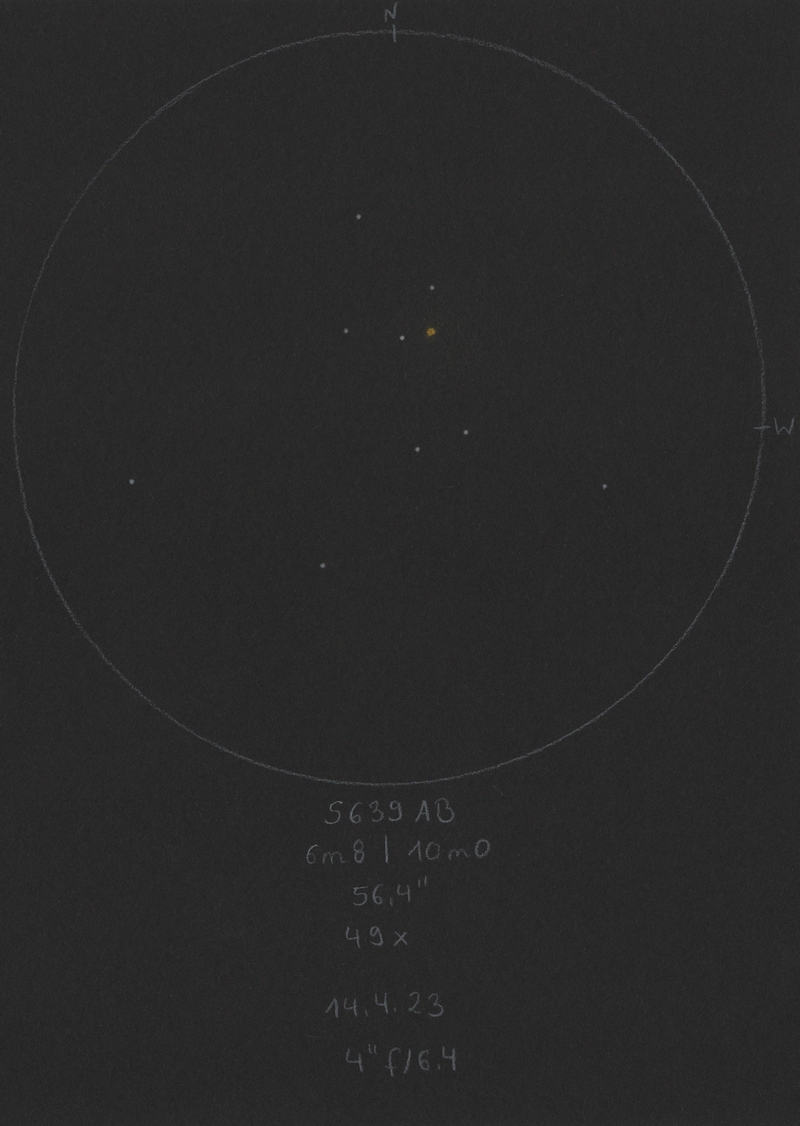
|
René Merting
Drachhausen (Germany) |
320mm (45x) |
bei 144x zeigt sich die A-Komponente schön zitronengelb, B weit im Osten von A strahlt graublau - zurück auf 45x ist ein leichtes blaugrau erkennbar, A strahlt bernsteingelb mit einem Stich ins Orange |
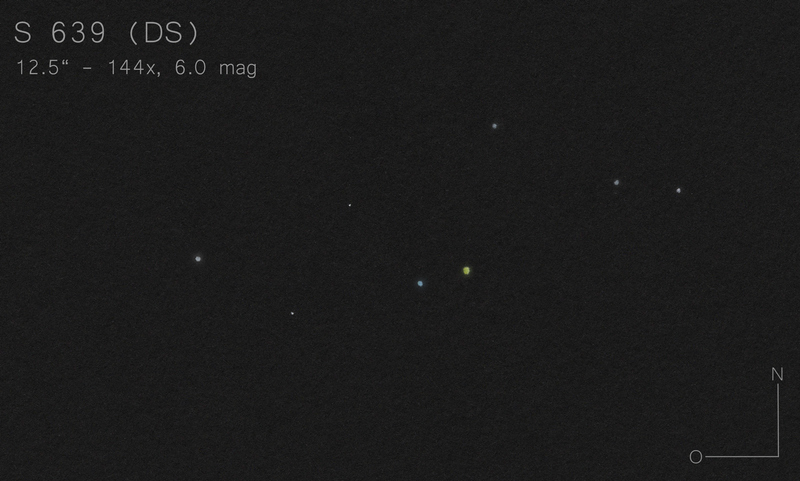
|
|
|
★★★
|
STF1670, gamma Vir, 29 Vir, Porrima |
|
AB |
3m.5 |
3m.5 |
2.9" |
356° |
2021 |
Vir |
12h41m39.60s / -01°26'57.90" |
|
|
Christopher Hay
Seeheim (Germany) |
15x60 |
28 February 2021 at 3" separation: Very slight elongation. PA estimated at 5° (thus only 9° off, which seems fairly precise to me considering the low power of 15x and the minimal elongation, both of which make PA estimation difficult).
Intentionally flashed the eyes on the almost full Moon directly prior to observation in order to enhance acuity. Compared the sight of Porrima repeatedly with that of similarly bright Epsilon Vir (Vindemiatrix) to check whether the elongation is perhaps an artefact of the bincolulars or of my eyes, but no elongation seen there. |
|
Robert Zebahl
Leipzig (Germany) |
16x70 |
2021-05-23: Not even close to appear as a double star. The components are just too bright, the separation too small. |
|
Robert Zebahl
Leipzig (Germany) |
55mm (56x) |
2019-05-18: At 38x slightly elongated. At 56x touching diffraction disks. At 71x clearly separated with very small gap. |
|
Robert Zebahl
Leipzig (Germany) |
70mm (44x) |
2021-05-26: At full aperture Porrima appears almost separated at 44x. The two diffraction disks are well visible. At 31x it is difficult to see any elongation at all.
At 40mm aperture Porrima can be seen clearly elongated already at 31x, from 67x it appears as an '8'. At only 22x Porrima is not visible as a double star. |
|
Robert Zebahl
Leipzig (Germany) |
70mm (104x) |
2019-05-04: At 47x clearly visible as '8', at 73x split with almost touching diffraction disks. At 104x clearly separated, equally bright and pretty close together. The gap was smaller than the diameter of the diffraction disk. |
|
Mark McCarthy
Fremont (California/USA) |
80mm (92x) |
Porrima. Nice and easy, yellow-white equal stars. 169-year period |
|
Robert Zebahl
Leipzig (Germany) |
102mm (125x) |
2019-05-01: Extremely nice double star! Equally bright and relatively close together. Both components appeared yellowish-white. |
|
Uwe Pilz
Leipzig (Germany) |
105mm (200x) |
weiß-weiß, die nördliche Komponente ist eine Winzigkeit heller |
|
Winfried Kräling
Marburg (Germany) |
127mm (146x) |
21.04.2018: Bei V=100x erscheint dieser orangefarbene Doppelstern bereits als „8“. Bei V=146x ist Porrima voll getrennt. |

|
Sarah Gebauer
Germany |
150mm (166x) |
die 2,8'' entfernten Komponenten A und B konnten haarscharf bei 83x und 166x getrennt werden, beide strahlen gleich hell als ganz dichte Glanzpünktchen; Komponenten E und F wurden gesehen, C und D allerdings nicht; bei 83x waren AB ganz knapp nicht mehr voneinander getrennt |

|
Mark McCarthy
Fremont (California/USA) |
178mm (205x) |
Porrima. Bright near equal, dull white, well split about 4". Physical with a 169-year period, I missed my chance to witness the rapid periastron a few years ago |
|
Mark McCarthy
Fremont (California/USA) |
317mm (170x) |
Porrima. Very pretty yellow-white, near equal, close split at 170x. Star disks improved with apodizing mask. |
|
|
|
★★★
|
STF1694 |
|
AB |
5m.3 |
5m.7 |
21.8" |
324° |
2017 |
Cam |
12h49m13.80s / +83°24'46.30" |
Christopher Hay
Seeheim (Germany) |
7x45 |
Handheld. Very elongated with absolutely clear PA, but hand tremor prevents separation. |
|
Christopher Hay
Seeheim (Germany) |
7x50 |
On tripod. Split with a sliver of black inbetween, with creamy-white components, attractive sight. Dry-frozen night in January, 47° elevation above horizon. |
|
Christopher Hay
Seeheim (Germany) |
10x42 |
Binoculars with internal stabilisation, handheld. Fine split with definite difference in brightness of components. |
|
Christopher Hay
Seeheim (Germany) |
15x45 |
Binoculars with internal stabilisation, handheld. AB cleanly split with distinct difference in magnitudes. Strong visual presence of this physical double is enhanced by the complete lack of visual competition in 4.5° FOV. Interesting to contemplate that in the 9th century AD Struve 1694 was just as close to the celestial north pole as Polaris (also a physical double) is today. Also known as 32H Cam, which comes from the celestial map produced by Johannes Hevelius in the late 17th century. |
|
Christopher Hay
Seeheim (Germany) |
25x80 |
Well apart but by no means falling apart, and totally dominating the 3.2° field of view. Neither component would appear particularly colourful on its own, but viewed together the primary is definitely more on the orange side and the secondary more bluish.
At 25x in 3.2° FOV and with an exit pupil around 3mm making the sky background pitch-black, STF 1694 has such a strong visual impact that it becomes a showpiece specimen of a double star. Three-star rating awarded because of this strong visual presence plus binocular accessibility (see 7x50 observation) plus true physical nature of the double (according to Stelledoppie) plus pole-star role in the Middle Ages. |
|
Christopher Hay
Seeheim (Germany) |
36mm (8x) |
Split clearly, so clearly that I stumble across the pair while panning through the area. Primary seems yellowish, an impression confirmed by observation directly afterwards with 71mm refractor at 32x, in which the primary is distinctly yellowish and the pair visually very strong. |
|
Robert Zebahl
Leipzig (Germany) |
70mm (15x) |
2017-12-21: Easy to split with noticeable angular distance and slight difference in brightness. The faint component tends to be more bluish, the brighter one appeared more light yellowish. |
|
René Merting
Drachhausen (Germany) |
100mm (32x) |
bei 32x strahlen beide Komponenten richtig hell und gut getrennt - leichter Farbkontrast, Komponente A ist leicht gelblich, B wirkt eher unterkühlt |
|
Robert Zebahl
Leipzig (Germany) |
152mm (30x) |
2022-10-25: Easily separable, bright and very dominant in the field. The difference in brightness is small. Due to the brightness, both components shine in brilliant colors: light yellow & white-bluish. |
|
|
|
★
|
STF1685 |
|
AB |
7m.3 |
7m.8 |
16.0" |
202° |
2018 |
Com |
12h51m54.80s / +19°10'19.90" |
René Merting
Drachhausen (Germany) |
18x70 |
ein schicker FG-Doppelstern - ein enges Paar mit der leicht schwächeren Komponente B im Süden - schwacher Farbkontrast, der wieder mal zwischen den Sternen hin und her zu springen scheint |
|
Robert Zebahl
Leipzig (Germany) |
70mm (22x) |
2020-04-04: Lovely sight! Beautifully separated with little difference in brightness. Together with two other brighter stars the double star forms an almost right-angled triangle. At 44x the primary component appears in pale orange, the companion rather grey-bluish. |

|
Christopher Hay
Seeheim (Germany) |
125mm (64x) |
Wide split. Component A bluish, B warmer. Well-matched pair.
A physical double at a distance to us of 722 light years. |
|
Mark McCarthy
Fremont (California/USA) |
317mm (553x) |
Brighter white A, 0.5 delta mag B, pretty wide separation. |
|
|
|
★
|
STFA23, 32 Com |
|
AB |
6m.5 |
7m.0 |
196.3" |
51° |
2015 |
Com |
12h52m12.26s / +17°04'26.20" |
|
|
|
|
AC |
6m.5 |
8m.9 |
905.4" |
262° |
2015 |
|
|
Christopher Hay
Seeheim (Germany) |
7x45 |
AB: Wide compact pair. Component A (=32 Com) is brighter than component B (=33 Com) and orangish.
Nice in 8.6° FOV together with globular cluster M53, which presents as a fluffy little ball. 2° north of 32/33 Com is an interesting 2° long east-west oriented clustering of stars, and 1° north of M53 is a similar, brighter and more compact clustering. Overall an extremely attractive field. |
|
René Merting
Drachhausen (Germany) |
8x25 |
AB: ein weit auseinander stehendes Pärchen - Komponente B im Nordosten ist halbe Größenklasse schwächer - A wirkt auf den ersten Blick farbig, gelblich, je länger ich schaue, desto farbloser wird er aber - B dagegen ist grauweiß |
|
Robert Zebahl
Leipzig (Germany) |
8x40 |
AB: 2020-04-05: Widely separated pair. The component A (32 Com) appeared slightly orange, the component B rather grey-bluish. Overall a beautiful sight. The double star is located right in the middle between the two bright stars 27 & 36 Com. |
|
Christopher Hay
Seeheim (Germany) |
15x45 |
AB: Striking pair, very wide but holding together well thanks to matched brightnesses. Component A (=32 Com) more orangish, component B (=33 Com) more bluish. |
|
René Merting
Drachhausen (Germany) |
18x70 |
AB: zwei helle Sterne mit riesigem Abstand - die B-Komponente im Nordosten ist eine viertel bis halbe Größenklasse schwächer - A wirkt leicht gelblich, B dagegen ist mehr unterkühlt weiß |
|
|
|
★
|
STF1688 |
|
AB |
9m.2 |
11m.1 |
14.1" |
344° |
2017 |
CVn |
12h53m35.26s / +37°58'20.90" |
Mark McCarthy
Fremont (California/USA) |
178mm (205x) |
White B and B is very faint, wide, can just hold it direct vision. Not physical |
|
Mark McCarthy
Fremont (California/USA) |
317mm (71x) |
a faint pair, yellow A and orangish B, which I identified using 340x, but can still split at 71x with STF 1692 & STF 1702 in the same low power field |
|
|
|
★
|
MET9 |
|
|
5m.7 |
7m.8 |
1.7" |
50° |
2016 |
Com |
12h54m39.98s / +22°06'28.80" |
Mark McCarthy
Fremont (California/USA) |
203mm (667x) |
Using 8" 205x I see nothing. 8" 410x suspect elongation. 8" 667x I see a fleeting, bluish point just outside of first diffraction ring. A is light yellow orange and bright, 2 delta mag. to B. A star feels elongated / egg shaped. With 20" and 667x the seeing is too messy though there is a knot in the diffraction where I had noticed the point with 8". Strong feeling A is elongated. |
|
|
|
★★
|
STF1692, 12 CVn, alpha CVn, Cor Caroli |
|
AB |
2m.9 |
5m.5 |
19.3" |
230° |
2020 |
CVn |
12h56m01.67s / +38°19'06.20" |
Christopher Hay
Seeheim (Germany) |
11x80 |
Difficult, but definitely split. Interesting to compare directly with Zeta UMa (Alcor): the latter very close to separation, but not quite there. |
|
Robert Zebahl
Leipzig (Germany) |
70mm (22x) |
Beautiful view. Clearly unequal with nice angular distance. Primary component appeared in pale yellow, companion silvery-white. |
|
Christopher Hay
Seeheim (Germany) |
76mm (17x) |
Clearly split. Primary slightly yellowish. Secondary too close to get a clear colour impression, but seems grey-blue in good moments. |
|
Mark McCarthy
Fremont (California/USA) |
80mm (92x) |
Cor Caroli, showpiece, almost three detla mag and nicely split. Nice round star images |
|
René Merting
Drachhausen (Germany) |
100mm (32x) |
bei 64x ein auffälliger Doppelstern - A ist gleißend weiß, B im Südwesten ist 1.5 Größenklassen schwächer (2.67 mag lt. Stelle Doppie, schon zum zweiten Mal vertan hier) |
|
Sarah Gebauer
Germany |
100mm (49x) |
02.10.23: horizontnahe Beobachtung - bei 21-fach schon knapp getrennt, ein Schneemann-Doppelstern in Warmweiß mit einem Hauch Hellgold - bei 49-fach zeigen die beiden gut getrennten Komponenten einen ähnlich warmweißen, hellgoldenen Farbeindruck, A bekommt ein weißes Sternzentrum, die B-Komponente wirkt lediglich feiner und schwächer |
|
Uwe Pilz
Leipzig (Germany) |
105mm (66x) |
blauweiß-orange, trennbar bei 16x |
|
Uwe Pilz
Leipzig (Germany) |
105mm (200x) |
schon bei 26x getrennt |

|
René Merting
Drachhausen (Germany) |
107mm (30x) |
bei 30x ein ordentlich getrenntes Sternpaar - während A weiß strahlt, zeigt sich B im Südwesten Goldweiß mit einer größeren Tendenz zum Gold |
|
Robert Zebahl
Leipzig (Germany) |
114mm (28x) |
Well split with big difference in brightness. |
|
Sarah Gebauer
Germany |
150mm (83x) |
deutlicher Helligkeitsunterschied, sehr einfach zu trennen |
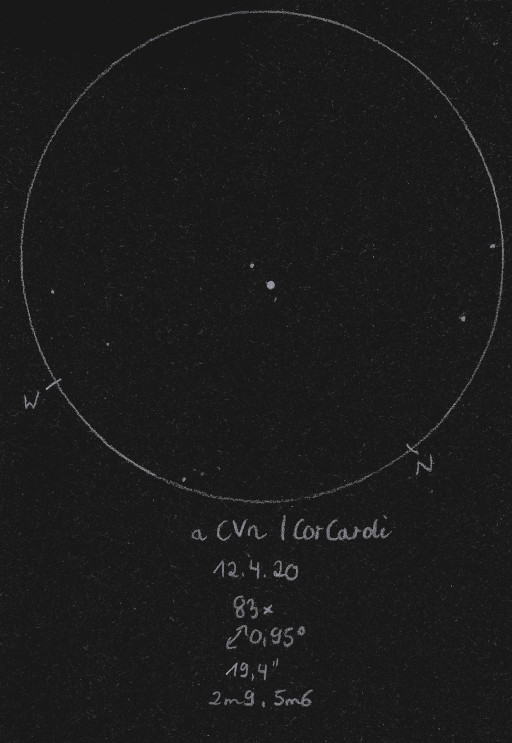
|
Mark McCarthy
Fremont (California/USA) |
203mm (205x) |
Cream white and light canary yellow. Well separated, 2 delta mag. |
|
Mark McCarthy
Fremont (California/USA) |
203mm (205x) |
Cor Caroli: Cream white and light canary yellow. Well separated, 2 delta mag. |
|
Gerd Kohler
Langenzenn (Germany) |
254mm (76x) |
Weiß-leicht bläulich - leicht orange rötlich. Kleiner Helligkeitsunterschied. |
|
Mark McCarthy
Fremont (California/USA) |
317mm (71x) |
Cor Caroli. Cream and bluish, use low power to fit STF 1688 & STF 1702 in the same field |
|
René Merting
Drachhausen (Germany) |
320mm (72x) |
bei 72x ein schönes Pärchen - A ist weiß - B zeigt sich gut getrennt südwestlich von A, ist gut 1.5 Größenklassen schwächer (2.67 mag laut Stelle Doppie) und mit einem leichten Stich ins gelbliche (warmweiß) - zurück auf 20x eine ungleiche 8, bei 32x knapp getrennt |
|
|
Berthold Fuchs
Wiesbaden (Germany) |
130mm |
easy DS |
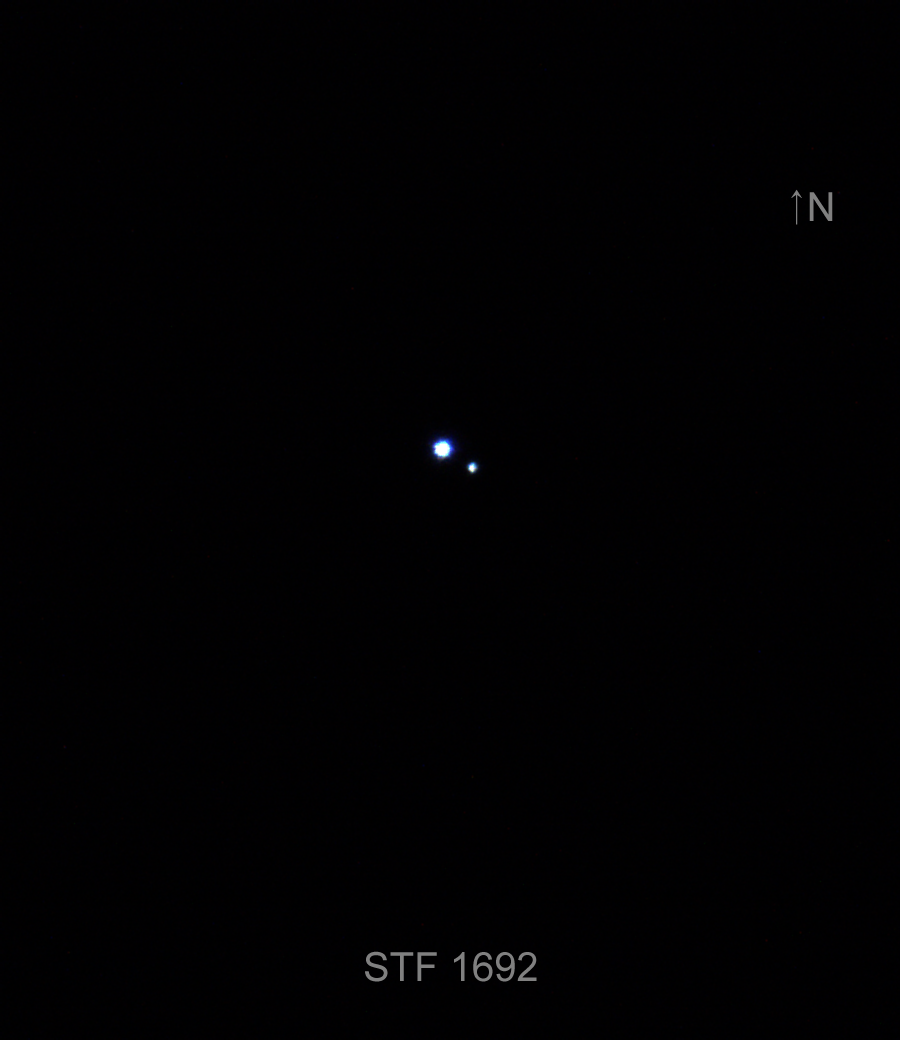
|
Frederik Wanink
Itterbeck (Germany) |
254mm |
|

|
|
|
★
|
STF1702 |
|
AB |
8m.7 |
9m.4 |
35.9" |
83° |
2017 |
CVn |
12h58m31.97s / +38°16'43.60" |
Mark McCarthy
Fremont (California/USA) |
317mm (71x) |
wide orange-yellow pair, in same low power field as STF 1692 & STF 1688 |
|
|
|
★
|
STF1709 |
|
|
7m.9 |
10m.0 |
2.7" |
252° |
2016 |
Com |
13h02m30.62s / +23°29'57.80" |
Mark McCarthy
Fremont (California/USA) |
317mm (553x) |
Nice! Brighter yellowish white A and 4 delta magnitude B, wide separation ~3" to west. |
|
Mark McCarthy
Fremont (California/USA) |
508mm (333x) |
White stars, ~2 delta mag, ~3" separation. Very attractive pair |
|
|
|
★
|
HO257 |
|
|
10m.4 |
10m.9 |
2.0" |
154° |
2016 |
Com |
13h05m51.04s / +26°13'36.40" |
Mark McCarthy
Fremont (California/USA) |
203mm (333x) |
Equal white, nice, ~2" |
|
|
|
★
|
COU11, 39 Com |
|
AB |
6m.1 |
8m.8 |
1.6" |
314° |
2020 |
Com |
13h06m21.28s / +21°09'12.60" |
Mark McCarthy
Fremont (California/USA) |
203mm (333x) |
39 Com. Very beautiful pair, A is creamy white, B is much fainter and bluish, ~1.5", resolved with seeing just beyond first diffraction |
|
|
|
★
|
COU2708 |
|
|
9m.6 |
10m.5 |
3.9" |
78° |
2019 |
Com |
13h08m04.40s / +23°24'42.80" |
Mark McCarthy
Fremont (California/USA) |
203mm (333x) |
B seen with averted vision, then I can hold direct. White stars, ~5". Nice. Physical |
|
|
|
★★
|
STF1728, 42 Com |
|
AB |
4m.8 |
5m.5 |
0.5" |
195° |
2020 |
Com |
13h09m59.28s / +17°31'46.00" |
|
|
|
|
AB-C |
4m.4 |
11m.4 |
84.8" |
349° |
2014 |
|
|
Mark McCarthy
Fremont (California/USA) |
317mm (443x) |
AB-C: Alpha Com: Bright yellow, very faint blue B |
|
Mark McCarthy
Fremont (California/USA) |
508mm (1067x) |
AB: Diadem. !! Most definite well split near equal, light yellow-orange. A faint star [AB-C] also in the field to tell orientation. Short period, made sketch. Wow! |
|
|
|
★
|
STFA24 |
|
AB |
6m.0 |
6m.3 |
275.6" |
296° |
2012 |
CVn |
13h10m03.27s / +38°29'55.90" |
|
|
Robert Zebahl
Leipzig (Germany) |
8x40 |
Both components similar in brightness with large distance. |
|
Christopher Hay
Seeheim (Germany) |
15x45 |
Already clearly split in 3x opera glass. In 15x45 the pair becomes interesting due to clear colour contrast, 17 CVn orangish, 15 CVn much colder, almost bluish.
Charming in 4.5° FOV together with asterism two degrees northeast made up of 19/20/23 CVn plus an unnamed fourth bright star to the southwest of those three. |
|
Mark McCarthy
Fremont (California/USA) |
317mm (277x) |
Wide bright pair |
|
René Merting
Drachhausen (Germany) |
320mm (45x) |
extrem weit getrennt, ein auffälliges Trio zusammen mit 16 CVn nördlich - eher etwas für Kleinst-Ferngläser |
|
|
|
★★
|
BGH46 |
|
AB |
6m.5 |
7m.6 |
202.9" |
58° |
2015 |
Com |
13h16m32.26s / +19°47'07.00" |
Christopher Hay
Seeheim (Germany) |
7x45 |
Handheld. Well apart. Nice in 8.6° FOV with very similar, slightly wider and brighter 1 Boo six degrees due east.
BGH = S. van den Bergh. BGH46 is a physical double at a distance to us of 279 light years. |
|
Robert Zebahl
Leipzig (Germany) |
8x40 |
2020-04-05: Widely separated with well visible difference in brightness. A appeared slightly white-bluish, B darker in color and not clearly definable. |
|
Christopher Hay
Seeheim (Germany) |
15x45 |
Wide apart. Would probably no longer feel like a pair in a crowded Milky Way field, but here, not all too far from the North Galactic Pole, the two components hold together well (and are indeed a physical pair).
Very attractive 4.5° FOV to south with east-west string of stars followed by fluffy ball of globular M53 and finally brilliant Alpha Com. |
|
Mark McCarthy
Fremont (California/USA) |
80mm (13x) |
Wide finder split, 1 delta mag, not much to recommend. Triangle of stars to the south, pointing to Bgh 46. [I did look at this at 667x to see if one of the wide pair had a pair of its own, but did not scrutinize well enough. This one should try on a really good night with 20": HDS1862 = Aa,Ab 6.56/9.69 0.4".] |
|
Mark McCarthy
Fremont (California/USA) |
178mm (205x) |
Super-wide pair even in the finder, and I am very surprised to see it is listed as physical, at least as proper motion is concerned. The close pair HDS1862Aa-Ab I thought I saw but it is too fleeting, seeing not supporting higher magnification. Reviewing the Gaia DR3 data, which includes parallax, it confirms there is overlap in the weighted distance but the weighted separation of the pair is 19,121 AU, which means this is very likely not a physical pair |
|
|
|
★
|
BU800 |
|
AB |
6m.7 |
9m.5 |
7.7" |
104° |
2020 |
Com |
13h16m51.05s / +17°01'01.90" |
|
|
Christopher Hay
Seeheim (Germany) |
125mm (36x) |
AB, March 2019: Clearly split in good moments, but secondary popping in and out of view in instable seeing.
A physical double only 36 light years distant to us. |
|
Mark McCarthy
Fremont (California/USA) |
203mm (333x) |
Nice pair, A is a light but rich yellow, B is blue-white. Wide, ~2 delta mag |
|
Mark McCarthy
Fremont (California/USA) |
317mm (553x) |
Not difficult, orange-yellow A with bluish B, 3 delta mag. pretty wide to east. |
|
|
|
★★
|
HU644 |
|
AB |
9m.1 |
9m.9 |
0.1" |
354° |
2019 |
CVn |
13h19m45.58s / +47°46'41.10" |
|
|
Uwe Pilz
Leipzig (Germany) |
120mm (250x) |
|

|
Mark McCarthy
Fremont (California/USA) |
317mm (443x) |
Orange-red pair, near equal mag, split with seeing at 443x |
|
Mark McCarthy
Fremont (California/USA) |
508mm (533x) |
Quite perfect star images, light orange stars, nearly 2 delta mag, well separated, PA northwest. Grade 2, physical, 48.776-year period. It has a slightly out of round orbit from our perspective, near it's periastron now and will widen to an easy 1.584" by 2030 |
|
|
|
★
|
A566 |
|
|
9m.0 |
10m.8 |
2.0" |
66° |
2016 |
Com |
13h22m17.99s / +26°31'10.10" |
Mark McCarthy
Fremont (California/USA) |
203mm (333x) |
Wow, very fine, very delicate pair, ~2" and ~2-3 delta mag |
|
|
|
★★
|
STF1744 & SMR4, zeta UMa |
STF1744, 79 UMa, Mizar |
AB |
2m.2 |
3m.9 |
14.7" |
154° |
2020 |
UMa |
13h23m55.42s / +54°55'31.50" |
|
|
|
STF1744, Mizar & Alcor |
AC |
2m.2 |
4m.0 |
715.5" |
73° |
2020 |
|
|
|
|
|
SMR4 |
AD |
2m.2 |
7m.6 |
498.1" |
103° |
2020 |
|
|
René Merting
Drachhausen (Germany) |
naked eye |
AC: perfekte Bedingungen: der Doppelstern steht im Zenit, gute Transparenz … und siehe da, das kleine Reiterlein Komponente C ist zu erkennen, ach was sage ich, leicht zu erkennen - C ist deutlich schwächer, Trennung mehr als knapp - heute so einfach, wie oft bin ich im Vorfeld gescheitert mit bloßem Auge |
|
Christopher Hay
Seeheim (Germany) |
naked eye |
AC: Mizar/Alcor: After seeing the two stars separated for the first time under clear corona skies in spring 2020, this became a regular and easy sighting. Naked-eye star splitting is a skill that develops rapidly with practice. Mizar and Alcor are wide apart with my 60-year-old eyes, and occasionally Alcor appears slightly bluish. |
|
Christopher Hay
Seeheim (Germany) |
7x50 |
On tripod. Mizar (AB) is an uneven figure-8, the smaller circle of the 8 pointing to an estimated PA of 150°. Without knowing that this is a double star one might think the binoculars have collimation issues, but Epsilon UMa displays a perfect little Airy disk.
Alcor (C) appears bluish, Mizar creamy-white.
D seems reddish. |
|
René Merting
Drachhausen (Germany) |
8x25 |
AC: ein weit getrenntes Pärchen - Helligkeitsunterschied 1.5 Magnituden\AD: Komponente D kann ich auch erkennen, diese steht näher an C und ist nochmal um einiges schwächer als diese |
|
René Merting
Drachhausen (Germany) |
8x30 |
AC: ein ultraweit getrenntes Pärchen - Komponente C im NO schätze ich eine Größenklasse schwächer ein (1.78 mag laut stelle Doppie)\AD: Komponente D (SMR4) ist östlich der beiden Sterne ganz schwach erkennbar, D steht dabei näher zu C |
|
Robert Zebahl
Leipzig (Germany) |
8x40 |
AB: 2020-04-05: Even with tripod not separable. |
|
Christopher Hay
Seeheim (Germany) |
10x56 |
AB: On tripod. Touching stars with a sliver of black in-between in good moments. Very aesthetic 6.3° field of view together with a little star group around 82 UMa. |
|
Christopher Hay
Seeheim (Germany) |
12x24 |
AB: On tripod. Very finely split, but stable. |
|
Christopher Hay
Seeheim (Germany) |
15x45 |
AB: Binoculars with internal stabilisation, handheld. AB nicely split with strong difference in magnitudes between A and B, very pretty. |
|
René Merting
Drachhausen (Germany) |
15x56 |
AB: bei guten Bedingungen ist Komponente B südöstlich von A erkennbar, der Stern klebt noch an A, deutliche Einschnürung, aber noch keine Trennung - in einer anderen Nacht mit schlechteren Bedingungen (heller, mäßige Durchsicht) gelingt mir die Trennung\AC: ja, was soll ich sagen, klar sehe ich die beiden Sterne getrennt ;-), manche schaffen das mit bloßem Auge, ich nicht\AD: D ist leicht nach Süden versetzt zwischen A und C erkennbar, die mit Abstand schwächste der vier sichtbaren Komponenten |
|
Christopher Hay
Seeheim (Germany) |
42mm (12x) |
AB: At 6.3x substantially elongated with clear positions of the brighter/darker components. At 10.7x a very stretched figure-eight tantalisingly close to popping apart. At 12x cleanly split with a stable sliver of black between A and B. |
|
Robert Zebahl
Leipzig (Germany) |
70mm (10x) |
AB: 2020-04-12: Observation from city with a 70/400mm ED refractor, for which I made aperture masks from 10mm to 60mm. Goal was to find the minimum magnification for a successful split.
70mm: At 12.5x no separation of the components possible due to outshining. Grey filters brought a slight improvement, but again no separation or elongation was visible.
60mm: At 12.5x slight outshining of the companion, clearly elongated and almost separated.
50mm: At 12.5x the companion was almost outshined. A separation was just possible.
40mm: At 12.5x both components appear finely separated from each other.
30mm: At 10x not clearly separable due to outshining, but clearly elongated. At 12.5x then quite easy to separate with a fine star rendition.
20mm: At 10x the companion is still clearly visible, but quite close to the primary component. At 12.5x best view under the used apertures with a very fine rendition!
10mm: At 10x the companion appears very faint. Separation possible, but extremely tight. At 12.5x reasonably well separated. |
|
Robert Zebahl
Leipzig (Germany) |
70mm (22x) |
AB: 2020-04-11: At 12x no separation possible, because the bright primary component outshines the companion. At 22x clearly separated, but still quite close together. |
|
René Merting
Drachhausen (Germany) |
76mm (29x) |
bei 29x sind alle vier Komponenten gut erkennbar - im Süden die östlich von Komponente A strahlende B-Komponente strahlt etwas schwächer als A und leicht gelblich, Trennung ordentlich - C weit im Norden ist der dritthellste Stern - Komponente D im Osten bildet ein Flaches Dreieck mit den anderen Komponente und ist dabei näher an C als an AB |
|
Robert Zebahl
Leipzig (Germany) |
102mm (28x) |
First pastel sketch (Pitt pastel by Faber-Castell) of a double star on black paper, where also the halos were sketched around the stars. The stars themselves were redrawn with an Edding (Edding 1500, Soft Pastel white). The sketch shows the components A to D. |
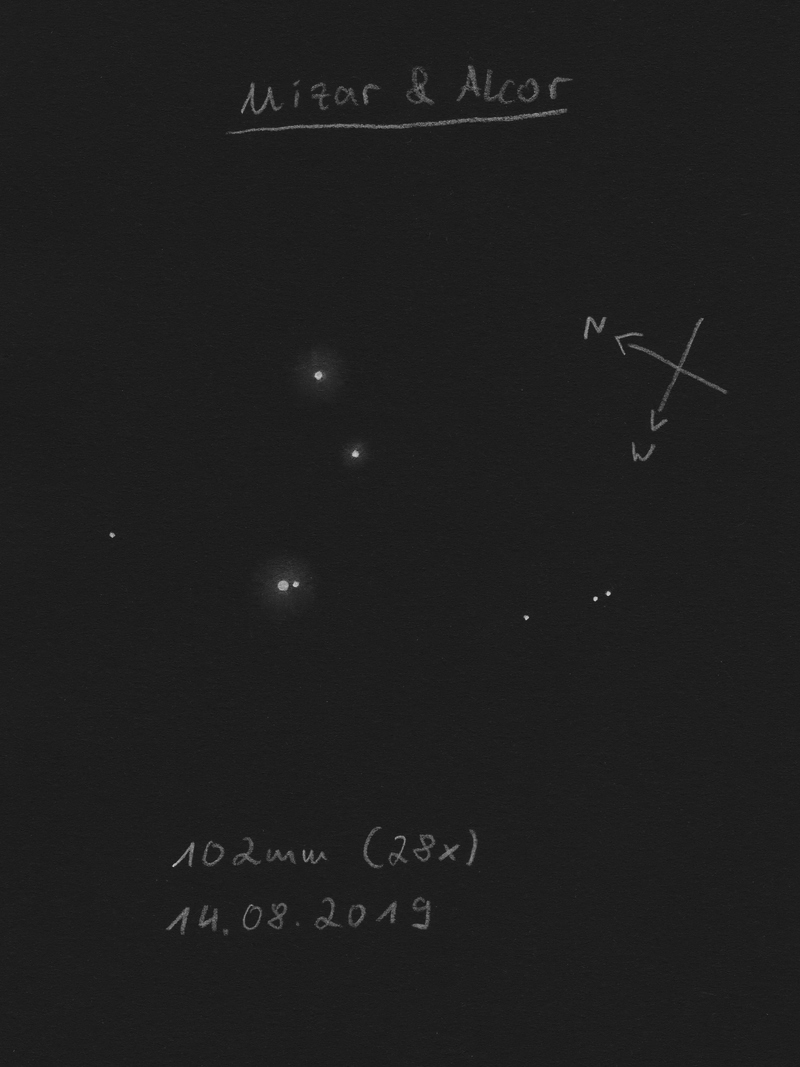
|
Uwe Pilz
Leipzig (Germany) |
105mm (288x) |
AB: mit viel Schwarz zwischen den Beugungsscheiben (1“9) |
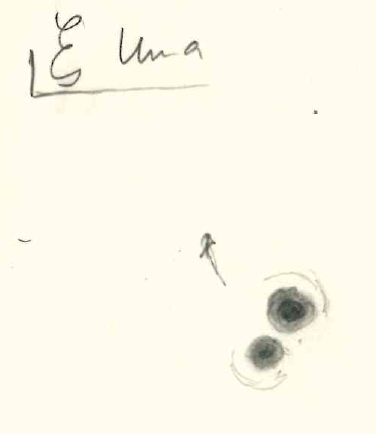
|
Jörg S. Schlimmer
Germany |
127mm (87x) |
easy to split |
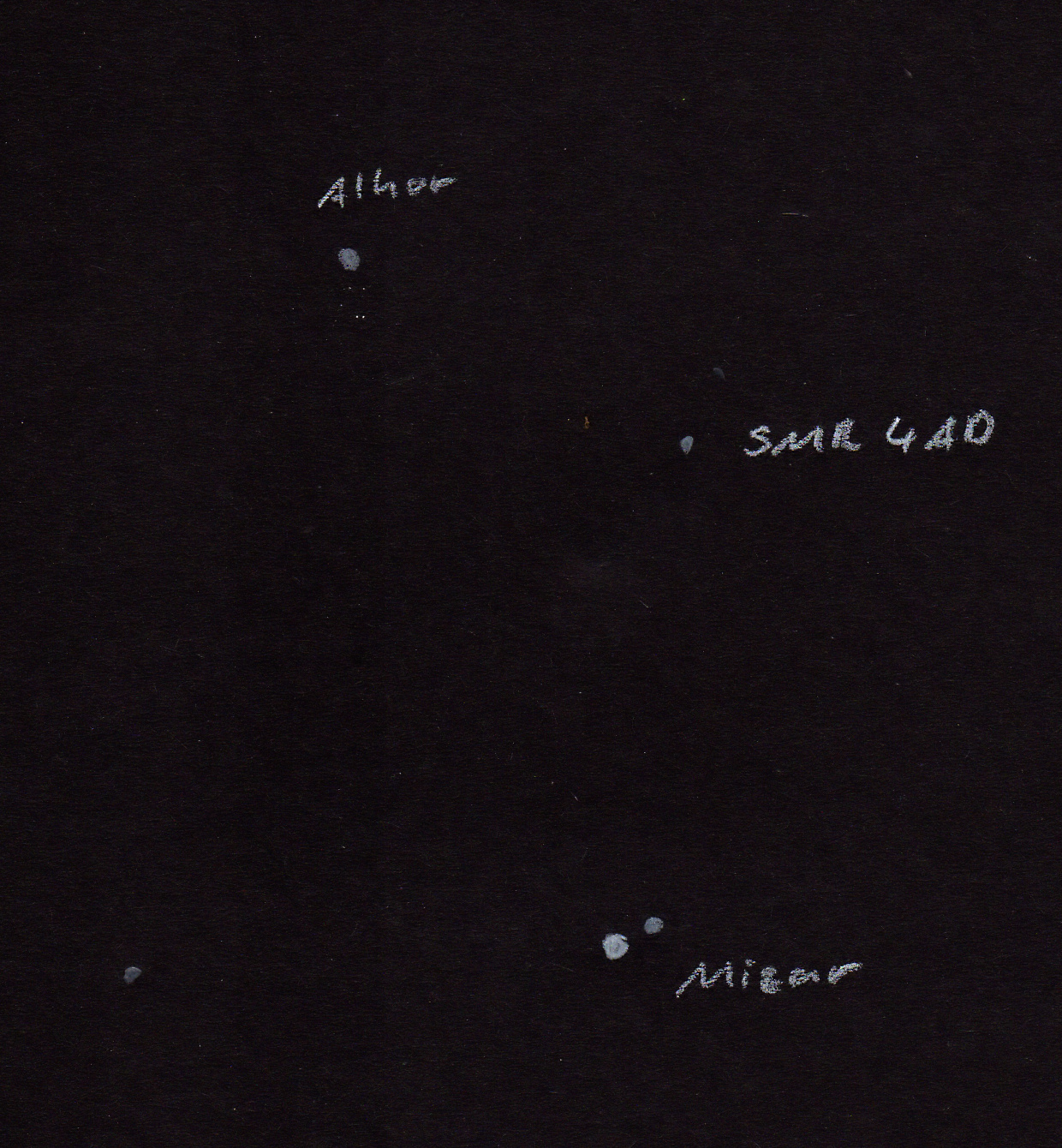
|
Sarah Gebauer
Germany |
150mm (83x) |
AB: einfacher, aber sehr schöner Doppelstern, Komponenten A und B mit 14,4'' Abstand stehen mit schönen Feldsternen zusammen im Bild |

|
René Merting
Drachhausen (Germany) |
320mm (45x) |
drei wunderschöne Juwelen strahlen mich an, A und B knapp getrennt, C weit entfernt im Nordosten von den beiden - Komponente B wirkt weißgelblich gegen die kühlweiß strahlende A-Komponente - Komponente D, die zwischen AB und C steht, wirkt eher grauweiß |
|
|
Robert Zebahl
Leipzig (Germany) |
|
|
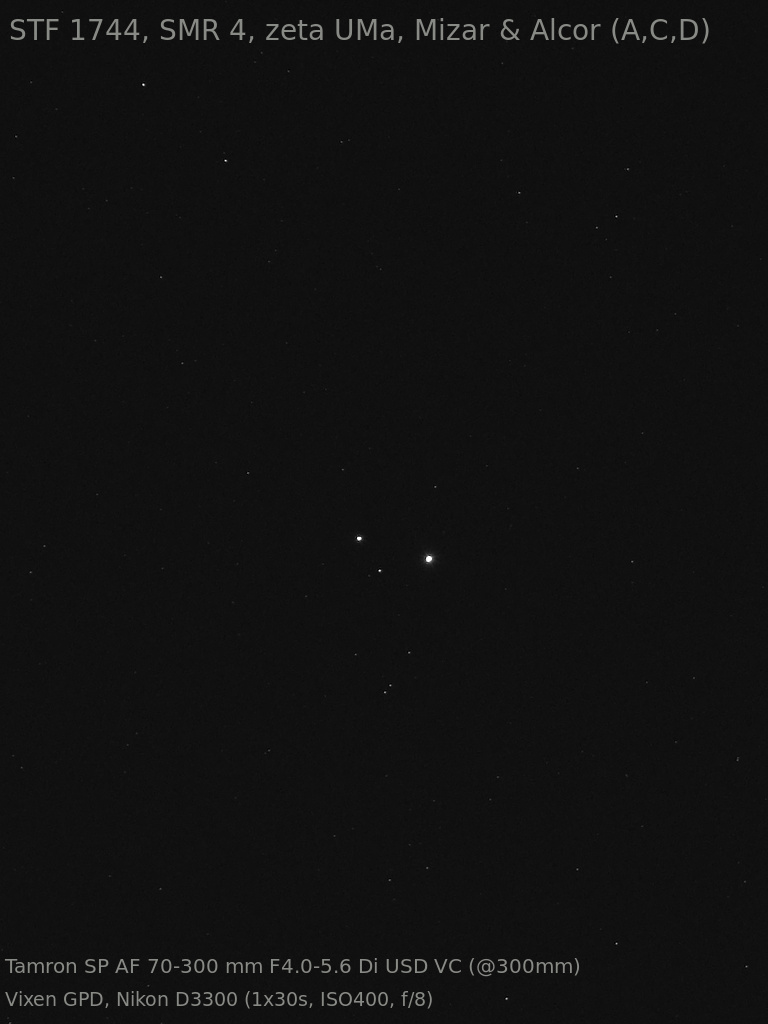
|
Werner E. Celnik
Rheinberg (Germany) |
120mm |
|
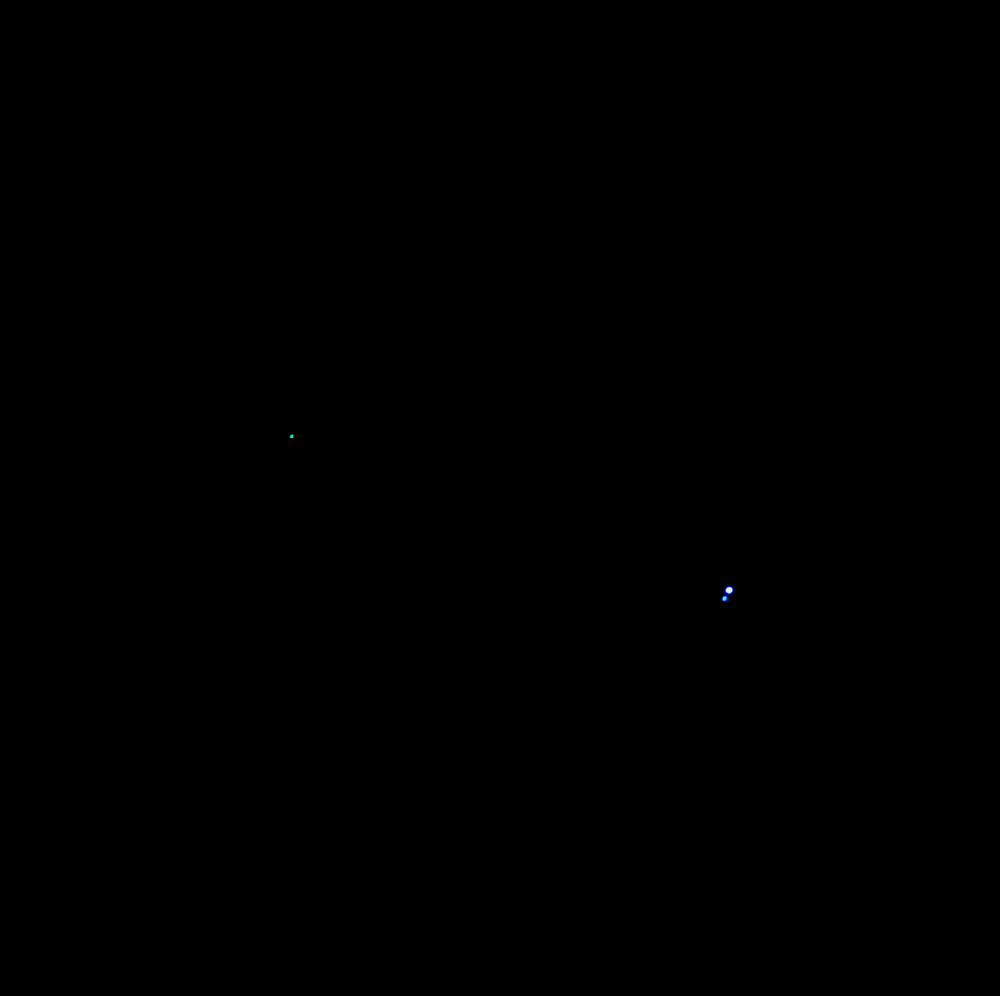
|
|
|
★
|
BU237 |
|
|
8m.5 |
10m.6 |
3.1" |
213° |
2018 |
Com |
13h26m53.35s / +14°22'21.70" |
Mark McCarthy
Fremont (California/USA) |
178mm (205x) |
Excellent pair, B visible with seeing as a very fine point, well separated ~4" from A, ~3 delta, very fine |
|
|
|
★
|
STTA123 |
|
AB |
6m.7 |
7m.0 |
69.7" |
148° |
2020 |
Dra |
13h27m04.70s / +64°44'07.60" |
|
|
|
|
BC |
7m.0 |
12m.0 |
40.1" |
98° |
2020 |
|
|
Christopher Hay
Seeheim (Germany) |
7x45 |
AB: Handheld binoculars. Difficult due to hand tremor, but clearly split. |
|
Christopher Hay
Seeheim (Germany) |
15x45 |
AB: Handheld binoculars with internal stabilisation. Wide split. Mild colour contrast between components, hard to grasp.
Analysis by Shaya and Olling (2011) found that this is a physical pair with near 100% probability. Catalogued as Shaya 622. |
|
|
|
★★
|
A567 |
|
|
6m.2 |
9m.7 |
1.5" |
257° |
2019 |
Com |
13h32m48.21s / +24°20'48.30" |
Christopher Hay
Seeheim (Germany) |
150mm (96x) |
At a position angle of roughly 265° I had the feeling something was going on; a kind of protusion of the primary, coming and going. 200x: yes, now a stellar condensation kept popping in and out of sight at the same position, just on the outside of the first ring, which itself was coming and going in not-so-perfect seeing. Upping the magnification to 240x and 300x didn't improve the view. |
|
Mark McCarthy
Fremont (California/USA) |
317mm (553x) |
very faint B, very close, ~1" when seeing stills, 3-4 delta magnitude. Surprised it is not so difficult. B looks like it doesn't have any light of its own and is illuminated by A. |
|
|
|
★
|
BU114 |
|
|
8m.1 |
8m.2 |
1.3" |
172° |
2018 |
Vir |
13h34m17.72s / -08°37'07.40" |
Mark McCarthy
Fremont (California/USA) |
317mm (553x) |
Nice near equal, slightly yellow white stars, ~10th mag. In 80mm finder it is shown with another widely separated equal pair. |
|
|
|
★
|
HJ1234 |
|
AB |
6m.4 |
10m.5 |
28.5" |
5° |
2015 |
CVn |
13h34m21.87s / +38°47'21.30" |
Mark McCarthy
Fremont (California/USA) |
317mm (277x) |
B a faint blue orb, looks like a planet reflecting A's light. Yellow A. Nice! |
|
|
|
★
|
25 CVn |
STF1768 |
AB |
5m.0 |
7m.0 |
1.6" |
95° |
2020 |
CVn |
13h37m27.70s / +36°17'41.40" |
|
|
|
STF1768 |
AC |
5m.0 |
11m.6 |
214.3" |
321° |
2015 |
|
|
|
|
|
KZA73 |
AD |
5m.0 |
13m.0 |
335.6" |
92° |
2015 |
|
|
|
|
|
KZA73 |
AE |
5m.0 |
12m.7 |
371.6" |
139° |
2020 |
|
|
|
|
|
KZA73 |
AF |
5m.0 |
9m.4 |
437.3" |
118° |
2015 |
|
|
|
|
Robert Zebahl
Leipzig (Germany) |
60mm (160x) |
AB: 2020-03-16: 102/1122mm ED refractor stopped down to 60mm. The diffraction ring of the primary component is virtually invisible. The companion appears only in few moments as an extremely faint, elongated brightening in the diffraction ring. Very difficult. Telescope should be in very good optical condition! |
|
Robert Zebahl
Leipzig (Germany) |
70mm (160x) |
AB: 2020-03-16: 102/1122mm ED refractor stopped down to 70mm. Companion only visible as a subtle, elongated, not permanently visible brightening. The diffraction ring of the primary component is only visible occasionally. Difficult. Telescope should be in good optical condition! |
|
Robert Zebahl
Leipzig (Germany) |
80mm (160x) |
AB: 2020-03-16: 102/1122mm ED refractor stopped down to 80mm. Companion permanently visible as elongated brightening in the diffraction ring. But the diffraction ring itself appears rather faint. Moderately difficult. |
|
Robert Zebahl
Leipzig (Germany) |
90mm (160x) |
AB: 2020-03-16: 102/1122mm ED refractor stopped down to 90mm. Companion quite clearly recognizable as elongated brightening in diffraction ring. Relatively simple. |
|
Robert Zebahl
Leipzig (Germany) |
102mm (160x) |
AB: 2020-03-16: The faint companion is immediately recognizable as a distinct, slightly elongated brightening in the diffraction ring. Easy. |
|
Robert Zebahl
Leipzig (Germany) |
152mm (150x) |
AB: 2020-03-19: At 150x the clearly fainter companion is visible as a roundish brightening. Due to the chromatic aberration of the achromat (152mm f/5.9) the companion is almost outshined. At 180x the companion is then well, at 225x and 300x very well visible as a tiny separated star. |
|
Mark McCarthy
Fremont (California/USA) |
203mm (205x) |
AB: Very tight pair, a little more than hairline split, ~2 delta mag. |
|
Mark McCarthy
Fremont (California/USA) |
203mm (205x) |
AB: Very tight pair, a little more than hairline split, ~2 delta mag. 8" 333x: white and dull blue, ~1", Nice! |
|
Frederik Wanink
Itterbeck (Germany) |
254mm (640x) |
AB: schwierig wegen Helligkeitsunterschied |
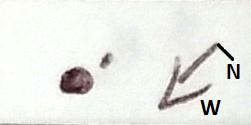
|
Mark McCarthy
Fremont (California/USA) |
317mm (277x) |
AB: Very pretty pale yellow and orange, 2-3 delta mag, ~2" |
|
|
|
★
|
STF1763 |
|
AB |
7m.8 |
8m.1 |
2.7" |
39° |
2017 |
Vir |
13h37m35.30s / -07°52'16.60" |
|
|
|
|
AC |
7m.8 |
12m.3 |
138.9" |
327° |
2015 |
|
|
René Merting
Drachhausen (Germany) |
100mm (107x) |
AB: bei 64x zeigt sich in guten Momenten eine schöne 8 - bei 107x ein schönes enges, knapp getrenntes Paar zweier gleich heller Sterne |
|
Mark McCarthy
Fremont (California/USA) |
317mm (553x) |
AB: 81 Vir: near equal orange stars, ~3", 9th mag. Nice! |
|
|
|
★★
|
STF1764 |
|
AB |
6m.8 |
8m.6 |
16.1" |
31° |
2018 |
Vir |
13h37m44.01s / +02°22'56.50" |
Mark McCarthy
Fremont (California/USA) |
80mm (92x) |
Extremely faint B flashes with averted vision only. Lower to horizon and in haze, so it was more difficult to see the faint star |
|
Sarah Gebauer
Germany |
100mm (49x) |
bei 21-fach noch unscheinbar - bei 49-fach zeigt sich die zweite Komponente noch sehr dicht, aber getrennt - die Hauptkomponente strahlt warmgelb, der Begleiter graublau - ein sehr dünnes, kleines Paar und dennoch recht auffällig dominant im GF, zumal es ein weiteres, viel schwächeres Sternpaar südlich davon gibt (TYC 307-837-1 mit 10m4 und TYC 307-957-1 mit 10m6), das wie ein entferntes Echo wirkt |
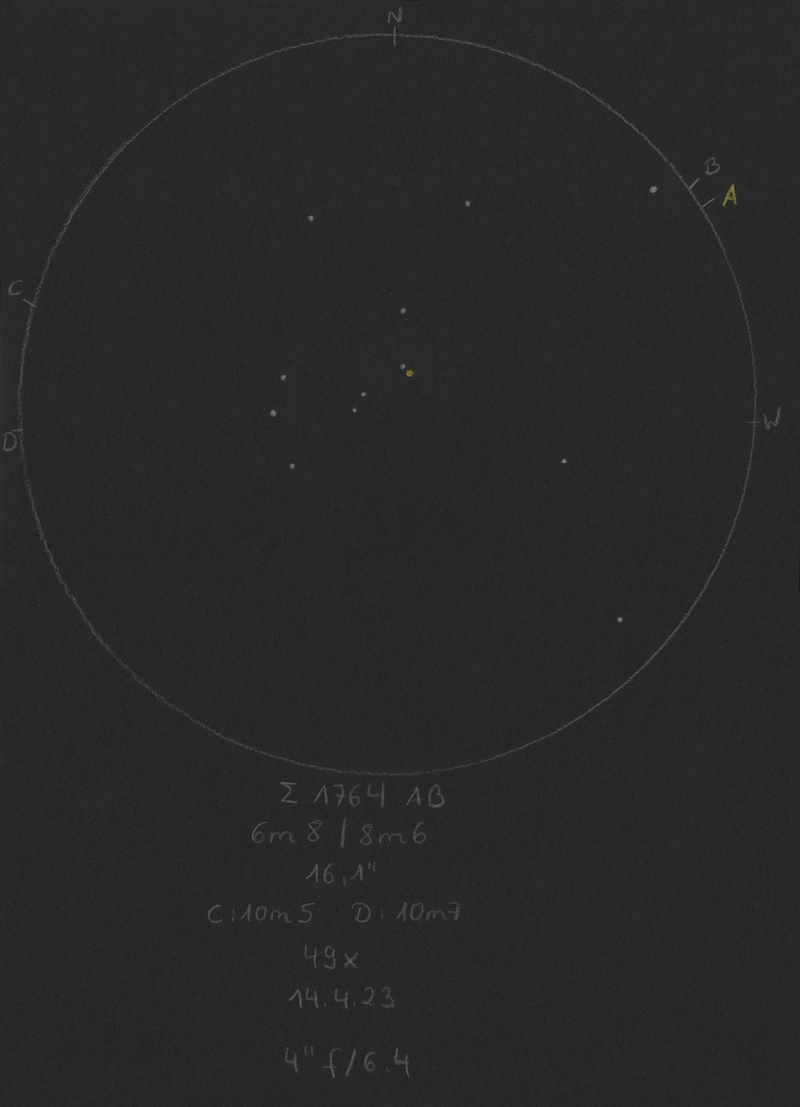
|
Mark McCarthy
Fremont (California/USA) |
203mm (333x) |
Orange and 2x fainter blue, wide. Another equal wide pair to the south. |
|
|
|
★★
|
STF1772, 1 Boo |
|
AB |
5m.8 |
9m.6 |
4.4" |
133° |
2019 |
Boo |
13h40m40.50s / +19°57'20.40" |
|
|
|
|
AC |
5m.8 |
12m.2 |
86.7" |
26° |
2020 |
|
|
|
|
|
|
AD |
5m.8 |
7m.4 |
208.7" |
1° |
2020 |
|
|
Christopher Hay
Seeheim (Germany) |
7x50 |
AD: On tripod. Wide split. Component D blueish. Fine in 7.3° field together with S 656.
A physical double at a distance to us of 328 light years. |
|
Christopher Hay
Seeheim (Germany) |
15x60 |
AD: On tripod. Very wide split. Component A cream-white, D pale blue. |
|
Robert Zebahl
Leipzig (Germany) |
70mm (22x) |
AD: 2020-04-24: Very widely split with clearly visible difference in brightness. The primary component appeared white-yellowish, the companion pale orange. |
|
Christopher Hay
Seeheim (Germany) |
80mm (63x) |
AB: B pops in and out of view as a very fine pinprick of light reasonably well set off from A. No success at 50x. |
|
Christopher Hay
Seeheim (Germany) |
150mm (96x) |
AB: Well split. Remarkably easy considering the 4-mag difference in brightness. A seems dusky yellow. B perhaps bluish, but hard to determine. 9-mag star a few arcminutes to the north makes the view even more pleasing. According to Stelledoppie AB is a physical double. |
|
Mark McCarthy
Fremont (California/USA) |
203mm (333x) |
AB: 1 Boo. Odd colors. Blue-white to greenish stars, wide, about 3 delta mag. AC is the very faint star well separated at nearly a right angle PA from the AB pair |
|
Karsten Kopp
Köln (Germany) |
600mm (180x) |
AB: Im CLT bei 180 x kein Problem. Der Reiz hier macht den größeren Helligkeitsunterschied von knapp 4 mag aus. Auch die Farben, der hellere erstrahlt eher weiß und der schwächere schwach rotbraun, sind schön anzusehen. |
|
|
Berthold Fuchs
Wiesbaden (Germany) |
130mm |
AB: difficult DS |
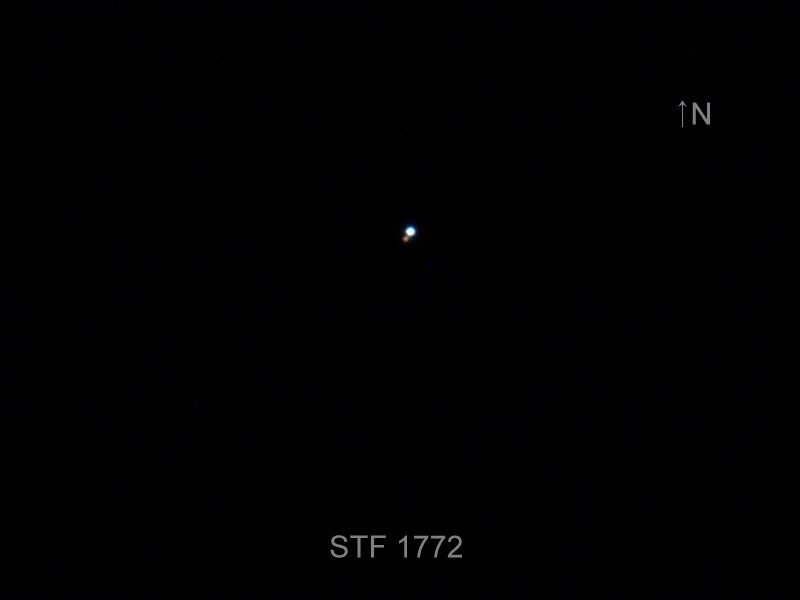
|
|
|
★★
|
STF1777, 84 Vir |
|
|
5m.5 |
8m.3 |
2.7" |
227° |
2016 |
Vir |
13h43m03.71s / +03°32'16.40" |
Sarah Gebauer
Germany |
100mm (136x) |
nicht zu trennen (zu starke Luftunruhe) - dennoch zeigt sich ein leicht goldener Farbeindruck, auch schon bei 80-fach |
|
Uwe Pilz
Leipzig (Germany) |
105mm (200x) |
deutliche Aufhellung im 1. Ring, nicht sonderlich schwierig |

|
Mark McCarthy
Fremont (California/USA) |
203mm (333x) |
Light orange and blue-green B, large magnitude difference, ~3". Pretty. |
|
Gerd Kohler
Langenzenn (Germany) |
254mm (218x) |
Blasses rot - eventuell rötlich. Enges Paar. Deutlicher Helligkeitsunterschied. |
|
|
|
★
|
S654 & SHY633 |
S654 |
AB |
5m.6 |
8m.9 |
71.3" |
239° |
2018 |
CVn |
13h46m59.77s / +38°32'33.70" |
|
|
|
SHY633 |
AC |
5m.6 |
8m.9 |
999.9" |
296° |
2020 |
|
|
Christopher Hay
Seeheim (Germany) |
7x42 |
AB: With handheld 7x42 binoculars I cannot separate B from A. With handheld 10x42 binoculars with internal stabilisation, B emerges in fleeting moments from the glare of A, wide. Yellow-orange hue of A that I had already noticed with 7x42 binoculars becomes clearer with 10x42.
With stabilised 20x60 binoculars I can hold B constantly, but B is far more difficult than component C (AC = Shaya 633) despite B and C having practically identical brightnesses.
AC: With handheld 7x42 binoculars component C is clear and very wide from A. A seems yellow-orange. Not visually exciting, it is nonetheless pleasurable to contemplate that this is in fact a physical pair travelling together in space, 317 light years distant from us.
SHY = E.J. Shaya, R. Olling, 2011: Very Wide Binaries and Other Comoving Stellar Companions: A Bayesian Analysis of the Hipparcos Catalogue. Component A is HIP 67250, C is 67041. AB is also physical, hence ABC is a triple system. |
|
Sarah Gebauer
Germany |
100mm (21x) |
S654 (AB): 02.10.23: bei 21-fach gut und weit getrennt, die nordöstliche Komponente strahlt sehr schön hellgolden, die südwestliche ist ein dunkelgraues Pünktchen - in etwa fünffachem Abstand südwestlich strahlt der benachbarte Stern HD120048 in einem schön kontrastreichen Warmweiß - bei 49-fach ist der Anblick auch noch schön, der Goldton von A intensiviert sich ins Roségoldene |
|
René Merting
Drachhausen (Germany) |
100mm (32x) |
S654 (AB): bei 32x ein weit getrenntes Pärchen - B im Südwesten ist deutlich schwächer und farblos ggü. der weiß strahlenden Komponente A |
|
Mark McCarthy
Fremont (California/USA) |
317mm (277x) |
S654 (AB): Striking yellow-orange and blue-green fainter B. |
|
|
|
★★★
|
STF1785 |
|
|
7m.4 |
8m.2 |
2.7" |
193° |
2021 |
Boo |
13h49m04.00s / +26°58'47.70" |
|
|
Christopher Hay
Seeheim (Germany) |
71mm (67x) |
4 June 2023. Hairfine split. Primary yellowish. Secondary seems duller, towards red.
Pair is slowly closing. Perhaps no longer accessible at 67x ten years from now. |
|
Sarah Gebauer
Germany |
100mm (49x) |
der angeblich Farbe zeigende DS ist bei 80x getrennt – zwei nahezu gleich helle Murmelchen, die ganz klein und dicht beieinander stehen – bei 50x zeigen die nun nicht mehr getrennten, aber länglichen Sterne einen leicht warmgelben Farbton, leicht ins Hellorange gehende |
|
Mark McCarthy
Fremont (California/USA) |
203mm (333x) |
Slightly orange-tinged white stars, near equal, well separated |
|
Christopher Hay
Seeheim (Germany) |
280mm (110x) |
4 June 2023. At 110x well split. Primary a clear, mild, cold yellow. Secondary hard to determine in colour.
At 180x primary retains its yellow and secondary exhibits a mild tangerine-orange.
A charming pair made all the more interesting by its true physical nature, with the secondary orbiting the primary every 156 years. Fairly easy to find 2° SW of globular Messier 3. |
|
Karsten Kopp
Köln (Germany) |
600mm (180x) |
Im CLT bei 180 x Vergrößerung gut zu trennen. Leichter Helligkeitsunterschied und beider Sterne erscheinen gelborange. |
|
|
|
★★★
|
S656 |
|
|
6m.9 |
7m.4 |
86.2" |
209° |
2018 |
Boo |
13h50m23.51s / +21°16'35.80" |
Christopher Hay
Seeheim (Germany) |
7x50 |
On tripod. Well split. A compact pair directly next to orangish-yellow 6 Boo in a remarkably attractive 7.3° FOV together with widely separated 1 Boo (STF 1772 AD) two degrees southwest plus Eta and Tau Boo about three degrees south.
A physical double at a distance to us of 345 light years. This means that South 656 is not just close to 1 Boo AD in our perspective but also actually in space, making the two pairs one of the finest physical double-doubles in the sky for 7x binoculars. |
|
Robert Zebahl
Leipzig (Germany) |
8x40 |
2020-04-05: Wide, medium bright pair. Primary component appeared slightly orange, the companion greyish. The double star is in close vicinity to the star 6 Boo, which shines in a pale orange. |
|
Christopher Hay
Seeheim (Germany) |
15x60 |
On tripod. Wide split. Primary orangish. Well-matched pair, very striking. Nicely accentuated by yellowish 6 Boo a few arc-minutes to the west. |
|
Christopher Hay
Seeheim (Germany) |
30mm (6x) |
While panning towards globular M3 I stumble across this striking pair in the finder, very even and well split. |
|
Robert Zebahl
Leipzig (Germany) |
70mm (22x) |
2020-04-24: Widely separated with little difference in brightness. Both components appeared slightly yellowish. Standing close to 6 Boo, which also shines in a slight yellow. |
|
Mark McCarthy
Fremont (California/USA) |
178mm (205x) |
Wide, white, half delta. WDS says it's physical but I calculate no parallax overlap and the two are too far apart to be gravitationally bound |
|
Christopher Hay
Seeheim (Germany) |
254mm (100x) |
At this power very wide, slight delta mag. At first sight no evident colour contrast, but after a while it becomes increasingly clear that the secondary is bluer than the primary. This effect is rather charming. |
|
|
|
★
|
HJ1244 |
|
AB |
6m.9 |
10m.8 |
6.9" |
130° |
2015 |
CVn |
13h53m20.79s / +42°11'05.30" |
Mark McCarthy
Fremont (California/USA) |
317mm (277x) |
Wow! Very faint B but can hold it direct vision with the seeing. Well separated from and orange-yellow A. |
|
|
|
★
|
STF1788 |
|
AB |
6m.7 |
7m.3 |
3.7" |
100° |
2019 |
Vir |
13h54m58.20s / -08°03'31.90" |
|
|
Robert Zebahl
Leipzig (Germany) |
70mm (47x) |
Very nice view! Pretty tight together with a moderate difference in brightness. |
|
René Merting
Drachhausen (Germany) |
100mm (64x) |
bei 107x zeigt sich ein schönes, knapp getrenntes Pärchen - B im Osten ist nur knapp schwächer als A - Komponente A ist weiß, B ist grau, wirkt aber auch leicht gelb gefärbt - zurück auf 64x kann ich die beiden Sterne auch schon knapp getrennt erkennen |
|
Mark McCarthy
Fremont (California/USA) |
317mm (340x) |
bright pair of near equal magnitude, both yellow-while color. |
|
|
|
★
|
BU224 |
|
|
8m.9 |
9m.3 |
0.6" |
101° |
2016 |
Boo |
14h13m26.94s / +12°34'26.20" |
|
|
Mark McCarthy
Fremont (California/USA) |
203mm (333x) |
Hairline split with seeing, light yellow-white stars, noticeable mag difference. Snowman when seeing is not stable |
|
|
|
★★
|
STF1821, kappa Boo, 17 Boo, Asellus Tertius |
|
AB |
4m.5 |
6m.6 |
13.8" |
236° |
2021 |
Boo |
14h13m29.00s / +51°47'23.80" |
|
|
Christopher Hay
Seeheim (Germany) |
15x60 |
On tripod. Fine split. Attractive together with well-split Iota Boo in 3.3° FOV.
Iota, Kappa, Theta were called Aselli by Johannes Bayer in the 17th century, meaning The Donkeys. The group is found easily naked-eye under a 5mag sky. Kappa Boo is Asellus Tertius, The Third Donkey.
A physical double at a distance to us of 163 light years. |
|
René Merting
Drachhausen (Germany) |
18x70 |
Komponente A strahlt so hell, dass B deutlich schwächer ganz knapp im SW von A abgesetzt sichtbar ist - Helligkeitsunterschied schätzungsweise 3 Magnituden (nur 2.09 mag laut Stelle Doppie) |
|
Robert Zebahl
Leipzig (Germany) |
70mm (22x) |
2020-04-24: Clearly separated with significant difference in brightness. The primary component showed a pale yellowish-orange color with a greyish companion. To the southeast there is the double star STFA 26. |
|
Sarah Gebauer
Germany |
100mm (49x) |
02.10.23: die nordöstliche A-Komponente strahlt bei 49-fach warmweiß mit einem Hauch Zitronengelb, die südwestliche, sehr dicht stehende und getrennte B-Komponente wirkt weißlicher - zusammen ergeben sie ein Gelbgold-Weißgold-Schmucksternpaar in einem schönen Sternumfeld mit STFA 26 südöstlich, der eine ähnliche Farbe zeigt |
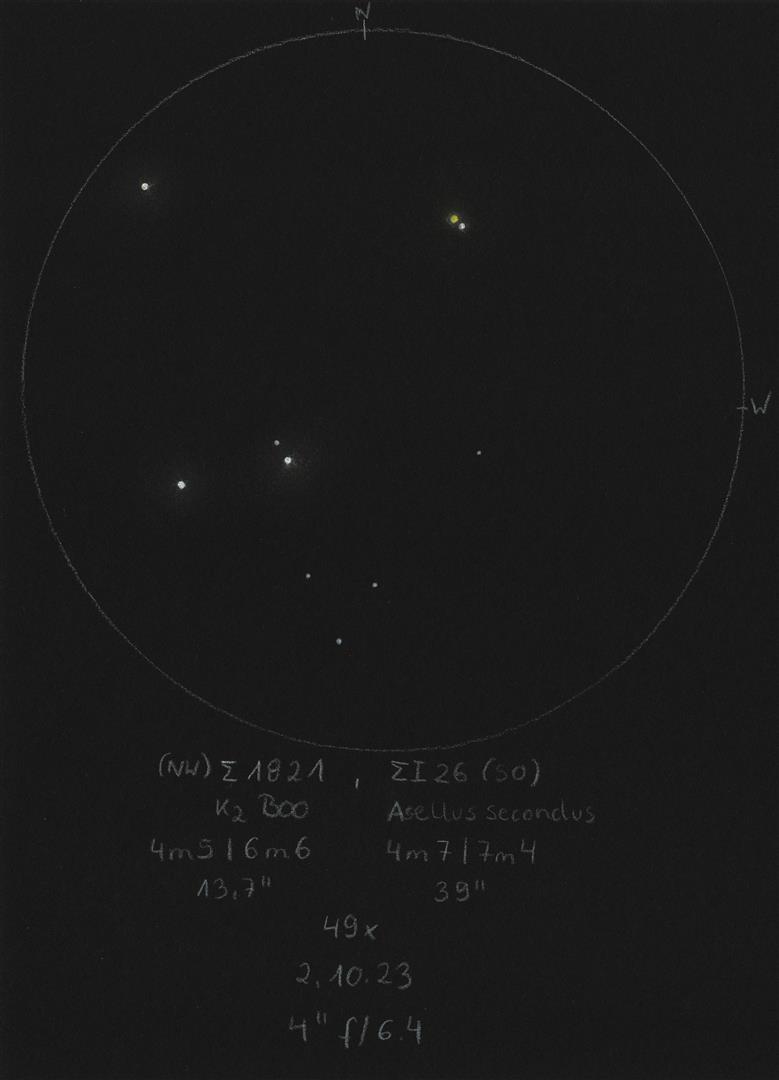
|
Sarah Gebauer
Germany |
100mm (73x) |
sehr schön zusammen mit STFA 26 in einem Gesichtsfeld bei 73x, dabei sehr schön getrennt |
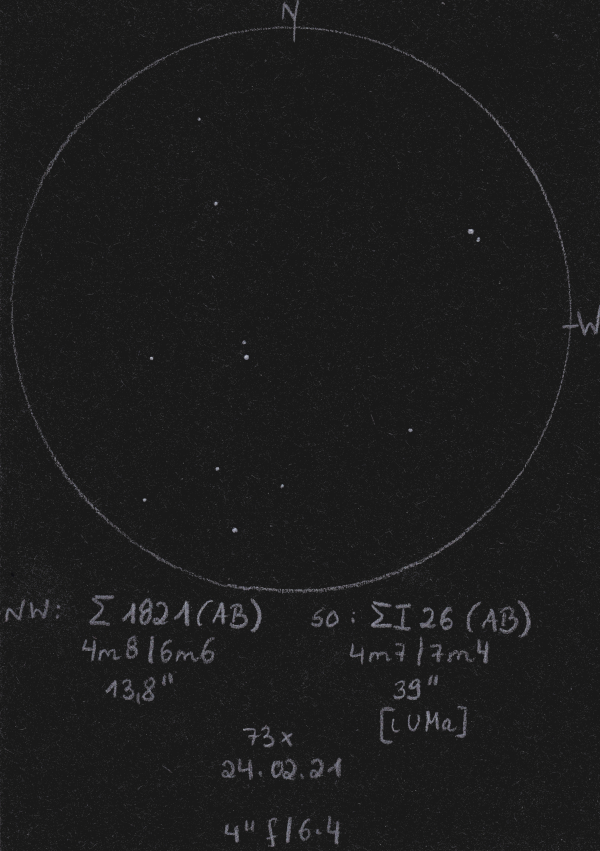
|
Uwe Pilz
Leipzig (Germany) |
105mm (144x) |
weiß-grau, trennbar bei 22x |
|
René Merting
Drachhausen (Germany) |
320mm (45x) |
bei 45x schicker Anblick und schön zusammen im Gesichtsfeld mit sehr ähnlichen Doppelstern STTA 26 - hier aber eine knappere Trennung und B steht im Südwesten von A - ähnlicher Farbkontrast wie beim Nachbardoppelstern, A ist weiß-gelb, B ist blau-grau |
|
Karsten Kopp
Köln (Germany) |
600mm (180x) |
Im CLT leicht zu trennen. Beider Sterne erscheinen weißlich. |
|
|
|
★
|
STT279 |
|
|
6m.8 |
9m.1 |
2.2" |
257° |
2018 |
Boo |
14h13m49.46s / +11°59'51.90" |
Mark McCarthy
Fremont (California/USA) |
203mm (333x) |
Fine pair, white A and slightly peach color B, ~2" separated and ~3 delta mag |
|
Mark McCarthy
Fremont (California/USA) |
317mm (553x) |
Very pretty orange and blue, 2-3", PA SW 2 delta mag |
|
|
|
★
|
STF1816 |
|
|
7m.4 |
7m.8 |
0.4" |
100° |
2019 |
Boo |
14h13m54.63s / +29°06'19.50" |
|
|
Uwe Pilz
Leipzig (Germany) |
105mm (88x) |
gelb |

|
Mark McCarthy
Fremont (California/USA) |
178mm (533x) |
Notched elongation, unequal pair, seeing won't support higher magnification. Physical with 1340-year period, it is near periastron now and will remain there the rest of my lifetime |
|
Mark McCarthy
Fremont (California/USA) |
317mm (553x) |
Rod-shaped equal white. July 2017 |
|
|
Frederik Wanink
Itterbeck (Germany) |
254mm |
|

|
|
|
★★
|
A1101 |
|
AB |
9m.7 |
10m.3 |
0.3" |
221° |
2020 |
Boo |
14h15m50.57s / +10°17'59.30" |
|
|
Mark McCarthy
Fremont (California/USA) |
508mm (1067x) |
I stared for a long time and had brief instants of an elongation or bump, and even a tentative split of a star. Sketched the orientation will check the PA later [I think I have it. My orientation on the sketch is in the correct position as in relation to the AB-C & AB-D pairs.] |
|
|
|
★★
|
STF1830 & STF1831 |
STF1831 |
AB |
7m.2 |
9m.6 |
5.8" |
138° |
2017 |
UMa |
14h16m08.47s / +56°42'45.70" |
|
|
|
STF1831 |
AC |
7m.2 |
6m.7 |
112.2" |
219° |
2017 |
|
|
|
|
|
STF1831 |
CD |
6m.7 |
13m.1 |
112.1" |
116° |
2016 |
|
|
|
|
|
STF1830 |
CE |
6m.7 |
9m.3 |
138.2" |
245° |
2020 |
|
|
|
|
|
STF1830 |
EF |
9m.3 |
10m.3 |
10.6" |
312° |
2017 |
|
|
|
|
|
STF1830 |
EG |
9m.3 |
12m.2 |
35.2" |
81° |
2017 |
|
|
Christopher Hay
Seeheim (Germany) |
7x45 |
STF1831 (AC): Wide split at 7x but still a very distinct impression of being a double. No colour impression. Two fine pinpricks of light, rather attractive in 8° FOV.
According to Stelledoppie the A-C pair, at 509 light years distance to us, is the only physical pair in the whole STF 1830/1831 complex. A nice physical double for small binoculars. |
|
Robert Zebahl
Leipzig (Germany) |
8x40 |
STF1831 (AC): 2020-04-05: Fairly wide pair with slight differences in brightness and color. C appeared slightly orange, A on the other hand slightly bluish. Comparatively bright double star, which gives a nice view. |
|
René Merting
Drachhausen (Germany) |
15x56 |
AC: beide Sterne sind gleich hell und mehr als komfortabel voneinander getrennt\CE: Komponente E im Südwesten von C fällt ebenfalls sofort ins Auge, wenn auch der Stern deutlich schwächer ist - Abstand zu C in etwa so groß, wie der Abstand AC |
|
Robert Zebahl
Leipzig (Germany) |
55mm (27x) |
STF1831 (AC): 2020-04-05: Moderate difference in brightness. C: pale orange, A: subtle blue. |
|
Robert Zebahl
Leipzig (Germany) |
70mm (57x) |
2020-04-11: At 22x the components AB, C, E & F are well visible and widely separated. E & F are comparatively faint. The C component in the middle appeared white-yellowish, AB rather white with a slight tendency to blue. At 57x, the pair AB with a clear difference in brightness can be easily split. An altogether rewarding and unusual multiple system. |
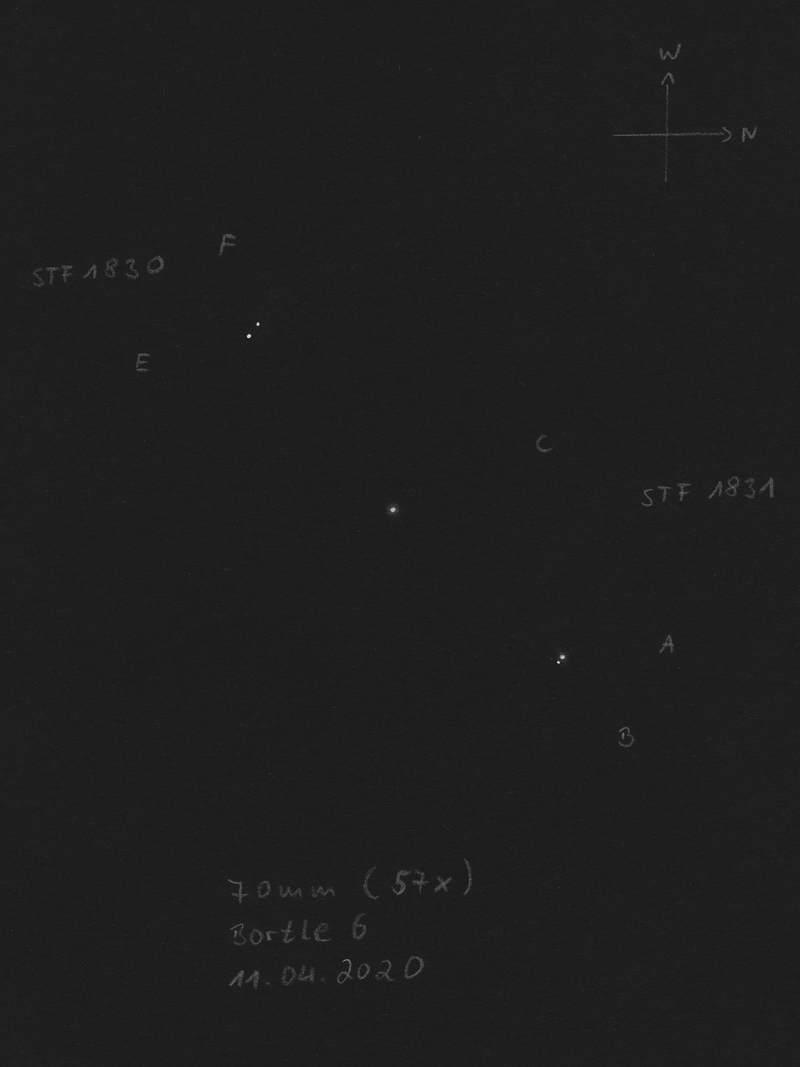
|
Sarah Gebauer
Germany |
100mm (80x) |
STF1830 (EF): ein ungleiches Doppel-Doppel zusammen mit STF 1830 (AC) - das feine Pärchen ist bei 49-fach gerade so getrennt und zeigt zwei nahezu gleich helle Sternpünktchen |

|
Sarah Gebauer
Germany |
100mm (80x) |
STF1831 (AC): ein ungleiches Doppel-Doppel zusammen mit STF 1831 (EF) - bei 49-fach zeigt das weite, helle Pärchen eine leicht gelbliche C-Komponente und einen leichten Helligkeitsunterschied |

|
Uwe Pilz
Leipzig (Germany) |
105mm (88x) |
Komponente G erforderte 200x |
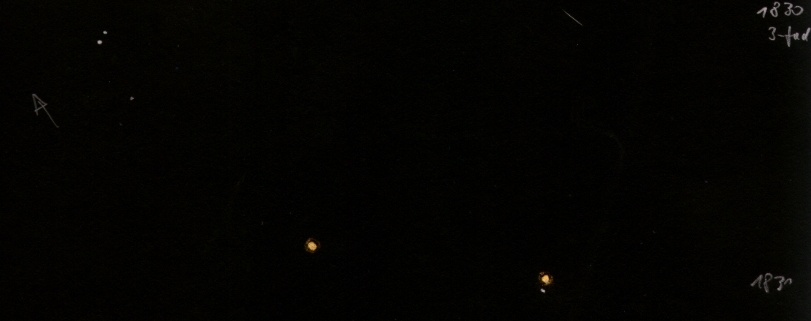
|
Mark McCarthy
Fremont (California/USA) |
317mm (553x) |
STF1831 (AB): One pair close to another, 5" and 2 delta mag. Part of a widely separated equal pair, and a gang of three stars further away -- five additional pairings in the system. |
|
René Merting
Drachhausen (Germany) |
320mm (72x) |
EF: bei 72x ein schwaches Sternpaar, gut getrennt - E ist gelblich, F eine halbe Größenklasse schwächer und grau
EG: bei 72 ist nordöstlich von EF noch ein ganz schwacher Lichtpunkt erkennbar - G hat ungefähr mit dreifachem Abstand EF |
|
René Merting
Drachhausen (Germany) |
320mm (72x) |
AB: bei 144x ist B ein bisschen mehr als knapp getrennt im SO von A erkennbar - B ist deutlich schwächer und grau gegen den weißgelblich strahlenden A - zurück auf 72x kann ich die beiden auch noch extrem knapp getrennt erkennen in guten Momenten - ein schönes Doppel zusammen mit STF1830 EF
AC: bei 72x fällt die helle Komponente C im Südwesten von AB zwar auf, ich hätte aber nicht vermutet, dass der Stern dazu gehört |
|
|
|
★★
|
STFA26, iota Boo, 21 Boo |
|
AB |
4m.8 |
7m.4 |
39.0" |
33° |
2020 |
Boo |
14h16m10.07s / +51°22'01.30" |
Robert Zebahl
Leipzig (Germany) |
8x40 |
2020-04-05: Even with tripod the faint companion was not visible. |
|
Christopher Hay
Seeheim (Germany) |
15x60 |
On tripod. Well split, companion seems bluish.
Fine 3.3° FOV star field with Kappa Boo (also split) and Theta Boo plus several 6th to 7th mag stars. Iota, Kappa, Theta were called Aselli by Johannes Bayer in the 17th century, meaning The Donkeys. The group is found easily naked-eye under a 5mag sky. Iota Boo is Asellus Secundus, The Second Donkey.
A physical double at a distance to us of 95 light years. |
|
Robert Zebahl
Leipzig (Germany) |
16x70 |
2021-03-21: Very beautifully embedded in a group of bright and medium bright stars. Significant difference in brightness. Primary component appeared white-yellowish, the much fainter companion grey-bluish at best. |
|
René Merting
Drachhausen (Germany) |
18x70 |
ein schönes ungleiches Paar, aber Komponente B ist deutlich besser abgesetzt von A erkennbar als beim Nachbar-DS STF1821 - leichter Farbkontrast |
|
Robert Zebahl
Leipzig (Germany) |
70mm (22x) |
2020-04-24: Similar view to the northwest standing kappa Boo. Nicely separated with larger distance and fainter companion. The primary component appeared rather white. |
|
Sarah Gebauer
Germany |
100mm (73x) |
bei 73x weit getrennt mit sichtbarem Helligkeitsunterschied, passt zusammen mit STF1821 in ein Gesichtsfeld und ist sehr schön anzusehen |

|
Uwe Pilz
Leipzig (Germany) |
105mm (144x) |
sehr weit, auffallend bei 22x |
|
René Merting
Drachhausen (Germany) |
320mm (45x) |
bei 45x weite Trennung der beiden Protagonisten - Komponente B im Nordwesten ist mehr als zwei Größenklassen schwächer - leichter Farbkontrast gelb-weiß vs. grau-weiß |
|
|
|
★
|
STF1825 |
|
|
6m.5 |
8m.4 |
4.2" |
154° |
2019 |
Boo |
14h16m32.84s / +20°07'18.70" |
|
|
Mark McCarthy
Fremont (California/USA) |
80mm (94x) |
Very fine split, >2 delta mag, white A and blue B, nice |
|
Mark McCarthy
Fremont (California/USA) |
203mm (333x) |
Cream white A and light blue B, wide ~5", ~2 delta mag |
|
Mark McCarthy
Fremont (California/USA) |
317mm (277x) |
White and orange, 3 delta mag, well split. |
|
|
|
★
|
COU482 |
|
|
9m.9 |
10m.0 |
0.6" |
120° |
2017 |
Boo |
14h21m20.69s / +30°50'07.10" |
Mark McCarthy
Fremont (California/USA) |
508mm (445x) |
! Excellent white pair, brief splits with seeing at 205x, easy steady split with six, slightly unequal. Uncertain in WDS, and no parallax data in EDR3 |
|
|
|
★★
|
STF1835 & BU1111 |
STF1835 |
A-BC |
5m.0 |
6m.8 |
6.4" |
197° |
2020 |
Boo |
14h23m22.74s / +08°26'47.90" |
|
|
|
BU1111 |
BC |
7m.4 |
7m.7 |
0.3" |
25° |
2020 |
|
|
|
|
René Merting
Drachhausen (Germany) |
100mm (64x) |
STF1835 (A-BC): bei 32x erscheint der Stern leicht unrund, verschmiert - bei 107x präsentiert sich BC gut getrennt im Süden von A - Helligkeitsunterschied eine Größenklasse (1.75 mag laut Stelle Doppie) - bei 64x sind beide Sterne auch getrennt erkennbar, BC strahlt warmweiß |
|
Robert Zebahl
Leipzig (Germany) |
102mm (62x) |
STF1835 (A-BC): At 28x barely split with visible difference in brightness. At 62x easy to separate. The colors seemed similar. |
|
Mark McCarthy
Fremont (California/USA) |
317mm (277x) |
STF1835 (A-BC): In a line of three stars, white and slightly red B. Wide, ~6", 2 delta mag. Did not detect BC 0.3" |
|
Mark McCarthy
Fremont (California/USA) |
508mm (1067x) |
BU1111 (BC): Short period pair, it is a component of STF 1835. I get a nothed near equal elongation with a clear direction in relation to the A star. Very cool |
|
Karsten Kopp
Köln (Germany) |
600mm (180x) |
STF1835 (A-BC): Doppelstern konnte im CLT gut getrennt werden. Helligkeitsunterschied ist merklich, aber nicht extrem. Der hellere erscheint eher weißlich und der kleinere eher bläulich. Der Farbunterschied ist aber minimal. |
|
|
Berthold Fuchs
Wiesbaden (Germany) |
130mm |
STF1835 (A-BC): close DS |
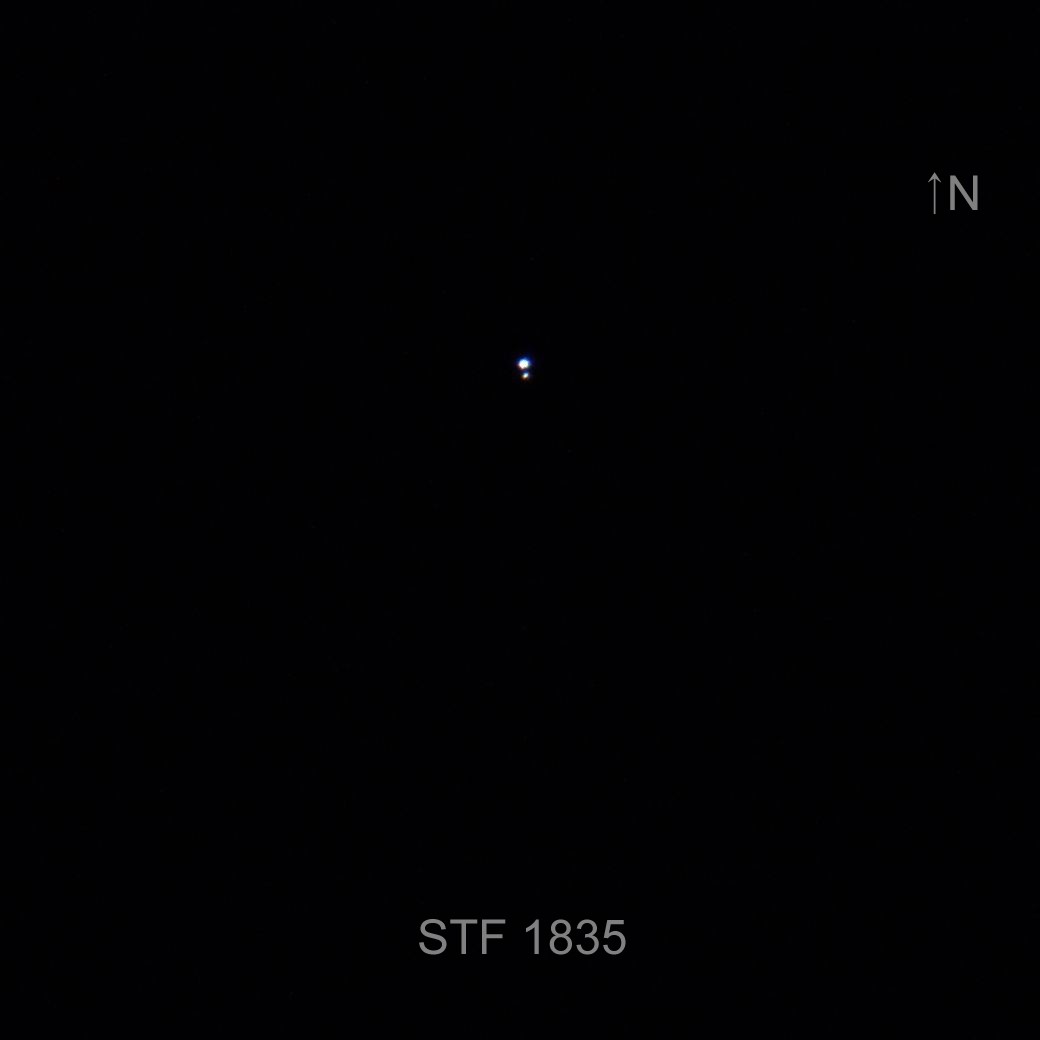
|
|
|
★
|
HO542 |
|
|
10m.3 |
10m.3 |
0.9" |
34° |
2017 |
Boo |
14h27m33.26s / +20°37'07.20" |
Mark McCarthy
Fremont (California/USA) |
203mm (333x) |
Faint near equal, very finely split with seeing, bluish stars |
|
|
|
★
|
STF1850 |
|
|
7m.1 |
7m.6 |
25.2" |
263° |
2018 |
Boo |
14h28m33.29s / +28°17'25.90" |
Robert Zebahl
Leipzig (Germany) |
8x40 |
2020-04-05: Separated, but still quite close together with a moderate difference in brightness. |
|
Christopher Hay
Seeheim (Germany) |
15x45 |
Handheld, binoculars with internal stabilisation. A tight pair, indirect vision helps to see black in-between. Eastern component clearly brighter. Nice in 4.5° FOV with Rho and Sigma Boo.
A physical double at a distance to us of 1140 light years. |
|
René Merting
Drachhausen (Germany) |
16x70 |
ein gut getrenntes Paar zweier gleich heller Sterne - beide weiß |
|
Robert Zebahl
Leipzig (Germany) |
70mm (22x) |
2020-04-24: Easily separated, medium bright with rather small difference in brightness and moderate distance. Fairly conspicuous. The components appeared white-yellowish and white-bluish. Beautiful double star. |
|
René Merting
Drachhausen (Germany) |
100mm (20x) |
bei 20x locker getrennt - Komponente B ist vielleicht eine halbe Magnitude schwächer als A und strahlt ein wenig dumpfer bzw. weniger weiß |
|
Sarah Gebauer
Germany |
100mm (49x) |
bei 49-fach ein gleich helles, unscheinbares, feines und weit getrenntes Pärchen |
|
Uwe Pilz
Leipzig (Germany) |
120mm (72x) |
recht weit, schöner Farbkontrast |
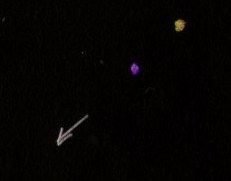
|
Mark McCarthy
Fremont (California/USA) |
178mm (205x) |
Near equal white wide. WDS claims physical, and their parallax do overlap, however they are separated by 7168 AU, too far than the known 5000 AU limit of known orbital pairs |
|
|
Berthold Fuchs
Wiesbaden (Germany) |
130mm |
easy DS |
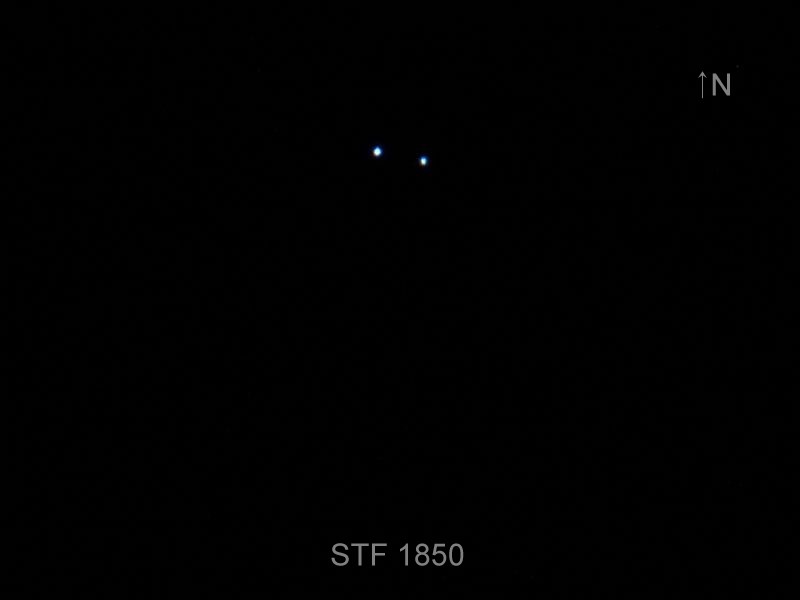
|
|
|
★
|
STF1863 |
|
|
7m.7 |
7m.8 |
0.6" |
58° |
2021 |
Boo |
14h38m00.71s / +51°34'42.10" |
|
|
Robert Zebahl
Leipzig (Germany) |
102mm (280x) |
2021-05-16: The double star appeared elongated with an estimated position angle of 60°. |
|
Christopher Hay
Seeheim (Germany) |
180mm (200x) |
30 May 2021, current separation 0.65” according to Stelledoppie. No prior PA knowledge nor knowledge of relative brightnesses.
Constant elongation seen. Definite determination of position of the primary within the elongation, more definite than the relative brightnesses (consulted after observation) would have led me to expect. PA estimated at 60°.
In good moments fragments of a pear-shaped first diffraction ring surround the system, particularly on the side of the primary. An interesting and attractive sight. |
|
Frederik Wanink
Itterbeck (Germany) |
254mm (640x) |
gerade trennbar |

|
|
|
★★
|
zeta Boo |
STF1865 |
AB |
4m.5 |
4m.5 |
0.2" |
273° |
2021 |
Boo |
14h41m08.92s / +13°43'42.00" |
|
|
|
H6 104 |
AB-C |
4m.5 |
11m.0 |
104.3" |
259° |
2020 |
|
|
|
|
Uwe Pilz
Leipzig (Germany) |
105mm (88x) |
AB-C |

|
Uwe Pilz
Leipzig (Germany) |
120mm (250x) |
AB |

|
Mark McCarthy
Fremont (California/USA) |
508mm (1067x) |
AB: Zeta Boo. Short period. First impression was moderately well notched overlapping disks (eg. not barely notched, but not strongly notched either). With more time observing & getting used to the image, and in moments of better seeing, the notch became more distinct. It would not separate in spite of moments of better seeing. I could also see the elongation, but only subtly notched due to the smaller scale, at 667x |
|
|
|
★★
|
HU575 |
|
AB |
9m.8 |
10m.1 |
0.4" |
284° |
2017 |
Boo |
14h42m33.63s / +19°28'46.90" |
|
|
Mark McCarthy
Fremont (California/USA) |
508mm (1067x) |
Short period. Small, faint, but definite split of these orange-red near equal stars. I sketched a clear orientation to field stars. Awesome |
|
|
|
★
|
A1109 |
|
AB |
7m.4 |
9m.4 |
1.9" |
88° |
2017 |
Vir |
14h42m47.60s / +06°35'26.40" |
|
|
Mark McCarthy
Fremont (California/USA) |
203mm (333x) |
Both stars light yellow, big magnitude difference, ~3-4 delta mag, about 2". Not difficult |
|
|
|
★★
|
STF1877, epsilon Boo, Izar |
|
AB |
2m.6 |
4m.8 |
2.9" |
347° |
2020 |
Boo |
14h44m59.14s / +27°04'29.90" |
Robert Zebahl
Leipzig (Germany) |
55mm (125x) |
The fainter component was seen as permanent brightening on the first diffraction ring of the primary component. |
|
Robert Zebahl
Leipzig (Germany) |
60mm (192x) |
Easy to split, whereby the much fainter component lies on the first diffraction ring of the primary component. The primary component itself appeared slightly yellowish. |

|
Robert Zebahl
Leipzig (Germany) |
70mm (133x) |
Easy to split, very unequal. A appeared in pale orange, B was visible as a very tiny, grey star on the first diffraction ring of component A. |
|
Christopher Hay
Seeheim (Germany) |
76mm (100x) |
AB: Secondary sits on the first diffraction ring of the primary, and appears there as a fine blue point. Further magnification not useful, merely darkens the image. |
|
Mark McCarthy
Fremont (California/USA) |
80mm (150x) |
Izar: Dull yellow-orange A and dull orange B, nice round images so split easily. No parallax for the B star, so it's uncertain if physical |
|
René Merting
Drachhausen (Germany) |
100mm (142x) |
bei 107x erscheint die B-Komponente nordwestlich leicht angesetzt an der gelblich strahlenden Komponente A - bei 142x dann ist die Trennung komplett, B liegt schön auf einem abgesetzten Beugungskranz von Komponente A |
|
Stefan Loibl
Rosenheim (Germany) |
102mm (205x) |
nice contrast yellow-orange/blue |
|
Robert Zebahl
Leipzig (Germany) |
102mm (224x) |
2021-05-12: Primary component appears in bright orange, the well separated, much fainter companion at 187x grey-bluish, at 224x and higher in a very nice, pale blue. |
|
René Merting
Drachhausen (Germany) |
107mm (120x) |
bei 120x gelingt die Trennung - die B-Komponente im Norden ist mindestens 2 Magnituden schwächer - A strahlt schön Gelbweiß, B ist Aschegrau |
|
Uwe Pilz
Leipzig (Germany) |
120mm (150x) |
Orange und blau, sehr lohnend |
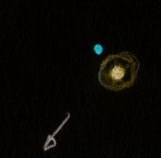
|
Robert Zebahl
Leipzig (Germany) |
120mm (192x) |
At 85x the fainter component was easily visible but not separated. At 192x well split. The fainter component was almost on the first diffraction ring of the primary component. Quite big difference in brightness. I did not looked at the color of the components. |
|
Sarah Gebauer
Germany |
150mm (166x) |
weder mit 166x noch mit 250x im April 2020 getrennt |
|
Gerd Kohler
Langenzenn (Germany) |
254mm (346x) |
Gelblich - leicht bläulich. Enges Paar. Deutlicher Helligkeitsunterschied. |
|
Frederik Wanink
Itterbeck (Germany) |
254mm (640x) |
deutl. Farbkontrast blau gelb |
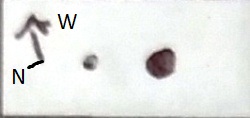
|
Christopher Hay
Seeheim (Germany) |
280mm (180x) |
Clearly split despite poor seeing. Slightly bluish impression of secondary at 180x becomes much clearer at 240x, indeed transforms into a charming, very light ultramarine blue or lapis lazuli. |
|
Sarah Gebauer
Germany |
280mm (250x) |
waberndes Seeing, aber eindeutig und zum ersten Mal getrennt - A erscheint leicht gelblich, B steht abgesetzt in weißlichem Ton daneben |

|
Mark McCarthy
Fremont (California/USA) |
317mm (553x) |
Izar: Yellow-orange and blue, very pretty, as always |
|
Karsten Kopp
Köln (Germany) |
600mm (257x) |
Sehr einfaches und auffälliges Objekt. Dieser Doppelstern war für mich an diesem Abend das Highlight. Vor allem, weil der schwächere hellblaue Stern gerade knapp neben den Spikes des helleren gelben Sterns steht. |

|
|
Berthold Fuchs
Wiesbaden (Germany) |
130mm |
magnificent DS |
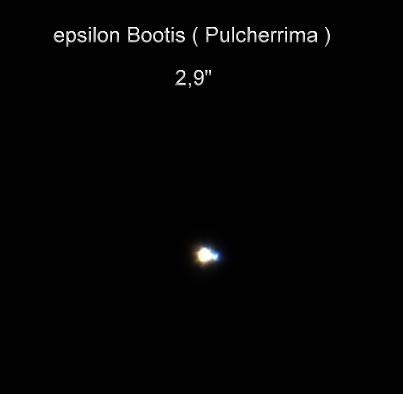
|
Frederik Wanink
Itterbeck (Germany) |
254mm |
|

|
|
|
★★
|
HLD20, 5 Lib |
|
|
6m.5 |
10m.1 |
3.1" |
250° |
2016 |
Lib |
14h45m57.78s / -15°27'34.40" |
Mark McCarthy
Fremont (California/USA) |
508mm (333x) |
8" 205x Orange star but no companion. 20" 333x Seeing distorted but a much fainter orange star seen as a point outside the diffraction, 5-6", Very fine! Put 8" mask back on @ 333x and can't see the B star! |
|
|
|
★
|
STF1884 |
|
|
6m.6 |
7m.5 |
2.3" |
55° |
2020 |
Boo |
14h48m23.37s / +24°22'01.00" |
|
|
Mark McCarthy
Fremont (California/USA) |
80mm (94x) |
Extremely fine, 1 delta mag, notched, to overlapping disks at best moments. Physical with a 1398.2859-year period, it has a nearly edge-on orbit and is currently at the shorter of the two furthest reaches of its orbit |
|
René Merting
Drachhausen (Germany) |
100mm (64x) |
bei 64x ist der Doppelstern als 8 erkennbar, 107x reicht dann für die knappe Trennung - die B-Komponente im NO ist nur unwesentlich schwächer - ein sehenswertes Pärchen |
|
Robert Zebahl
Leipzig (Germany) |
102mm (86x) |
At 86x pretty tight and unequal. At 160x clearly split. A: white, B: slightly orange. |
|
Mark McCarthy
Fremont (California/USA) |
203mm (333x) |
Prototypical pair, >1 delta mag, ~3" separation, white to off white color |
|
Frederik Wanink
Itterbeck (Germany) |
254mm (640x) |
einfach |

|
Karsten Kopp
Köln (Germany) |
600mm (180x) |
Doppelstern konnte gerade so getrennt werden. Beide Sternen leuchten weißlich. |
|
|
|
★
|
STF1890, 39 Boo |
|
|
6m.3 |
6m.7 |
2.6" |
46° |
2020 |
Boo |
14h49m41.37s / +48°43'15.60" |
|
|
Robert Zebahl
Leipzig (Germany) |
70mm (67x) |
2020-04-01: At 44x elongated, partly notched. At 67x split, but very tight. A difference in brightness was not seen. At 133x clearly separated with little difference in brightness. A appeared pale yellow, B rather warm-white. |
|
Robert Zebahl
Leipzig (Germany) |
70mm (100x) |
2020-04-18: At 57x very finely separated with extremely tightly spaced components that appeared equally bright. At 100x a very nice pair with little difference in brightness. Fantastic sight! The color of the components was slightly different: creamy-white & a touch of yellow-orange. |
|
Sarah Gebauer
Germany |
100mm (49x) |
02.10.23: das dünnste und feinste Sternpaar, das ich bei 80-fach bisher gesehen habe, zwei hauchfein getrennte Ameisenpünktchen - die südwestliche Komponente erscheint minimal heller und größer, beide wirken hellgold mit einem weißen Tupfen |
|
Robert Zebahl
Leipzig (Germany) |
102mm (187x) |
2021-05-16: Easy. Beautiful double star with slight difference in brightness. Yellowish & rather white. I estimated the position angle to 40°. |
|
Frederik Wanink
Itterbeck (Germany) |
254mm (640x) |
gleich hell |

|
Mark McCarthy
Fremont (California/USA) |
317mm (553x) |
Bright white pair, well split |
|
|
Frederik Wanink
Itterbeck (Germany) |
254mm |
|

|
|
|
★★★
|
alpha Lib, Zubenelgenubi, Kiffa Australis, Lanx Australis |
SHJ186 |
AB |
2m.7 |
5m.2 |
231.1" |
314° |
2012 |
Lib |
14h50m52.78s / -16°02'29.80" |
|
|
|
AOT53 |
AC |
2m.7 |
12m.5 |
275.6" |
291° |
2000 |
|
|
|
|
Christopher Hay
Seeheim (Germany) |
naked eye |
AB: Noticed with naked eye and without prior PA knowledge that a secondary was flickering next to Zubenelgenubi. Unexpected and first naked-eye sighting. Checked position with binoculars to be sure. Further naked-eye look at Mizar/Alkor (Zeta UMa) to gauge my momentary acuity and assess the difference to Alpha Lib. Zeta UMa more easily and widely split than ever before, and Alkor appeared for the first time bluish, so this was an exceptional night for naked-eye double-star splitting. Three-star rating awarded because Zubenelgenubi is the second-best naked-eye true-physical double star in the summer sky after Mizar/Alkor. |
|
René Merting
Drachhausen (Germany) |
8x25 |
AB: ein schöner Fernglas-Doppelstern mit leichtem Farbkontrast - beide Sterne stehen weit auseinander - B im Nordwesten wirkt braungrau gegen die warmweiße A-Komponente - Helligkeitsunterschied eine Größenklasse (total verschätzt, es sind 2.45 mag) |
|
Christopher Hay
Seeheim (Germany) |
10x56 |
AB: Handheld. A strong, wide pair. Both cold white, the secondary more bluish than the primary.
Delightful in 6.3° FOV together with the "Zub's Hat" (Hay-Merting 9) asterism directly above (north of) the pair, an array of six stars looking very much like a hat or cap on Zubenelgenubi. |
|
Gerd Kohler
Langenzenn (Germany) |
254mm (76x) |
AB: Bläulich-weiß - leicht bläulich. |
|
Gerd Kohler
Langenzenn (Germany) |
254mm (76x) |
AC: Bläulich-weiß - weiß. Sehr schwacher Begleiter. |
|
|
|
★
|
STF1886 |
|
AB |
7m.6 |
9m.7 |
7.9" |
224° |
2018 |
Boo |
14h51m02.31s / +09°43'25.20" |
Robert Zebahl
Leipzig (Germany) |
102mm (28x) |
At 28x, the B component appeared rather faint and pretty close to the primary component. At 62x both components were clearly visible and unequal. A: slightly orange, B: greyish. |
|
Mark McCarthy
Fremont (California/USA) |
317mm (553x) |
Yellow-orange and orange, pretty wide ~10" 2 delta mag |
|
Karsten Kopp
Köln (Germany) |
600mm (180x) |
Einfach zu trennen, aber der Helligkeitsunterschied mit 2,1 mag ist auffällig. Der hellere Stern erscheint gelblich weiß und der schwächere rotbraun. Sehr schön. |
|
|
Berthold Fuchs
Wiesbaden (Germany) |
130mm |
close DS |
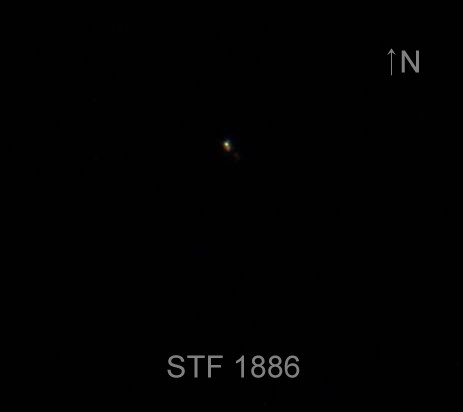
|
|
|
★
|
xi Boo, 37 Boo |
STF1888 |
AB |
4m.8 |
7m.0 |
5.0" |
296° |
2021 |
Boo |
14h51m23.38s / +19°06'01.70" |
|
|
|
STF1888 |
AC |
4m.8 |
13m.8 |
71.3" |
340° |
2015 |
|
|
|
|
|
STF1888 |
AD |
4m.8 |
11m.7 |
160.8" |
286° |
2015 |
|
|
|
|
|
ARN11 |
AE |
4m.8 |
8m.7 |
271.5" |
98° |
2015 |
|
|
|
|
|
ARN11 |
AF |
4m.8 |
9m.2 |
335.4" |
39° |
2020 |
|
|
|
|
|
STF1888 |
BC |
7m.0 |
13m.8 |
67.0" |
343° |
2016 |
|
|
|
|
|
STF1888 |
BE |
7m.0 |
8m.7 |
273.1" |
99° |
2016 |
|
|
|
|
Robert Zebahl
Leipzig (Germany) |
70mm (44x) |
AB: 2020-04-24: Beautifully separated with quite a large difference in brightness in a lovely star field. The primary component shines yellowish with a faint companion. |
|
Mark McCarthy
Fremont (California/USA) |
80mm (94x) |
AB: Yellow A and orange B, 2 delta mag, nice. Only 22 light years distant, it is physical with a 298-year period, and will tighten the next 30 years |
|
Sarah Gebauer
Germany |
150mm (83x) |
AB: die 6'' entfernten Komponenten A und B konnten mühelos bei 83x getrennt werden, Komponente E war zu sehen, C, D und F waren nicht sichtbar |

|
Mark McCarthy
Fremont (California/USA) |
508mm (333x) |
AB: Xi Boo. Short period. Richly colored yellow and orange stars, ~1 delta mag, ~5" separation, with several other stars in view. Very pretty |
|
Karsten Kopp
Köln (Germany) |
600mm (180x) |
AB: Ein recht schöner Doppelstern, wobei neben dem Helligkeitsunterschied von 2,2 mag auch die Sternfarben ein schönes Gesamtbild geben. Der hellere Stern erstrahlt gelblich weiß und der schwächere orangegelb.
Hier handelt es sich auch um ein recht nahes System mit 21,9 Lichtjahren Entfernung. |
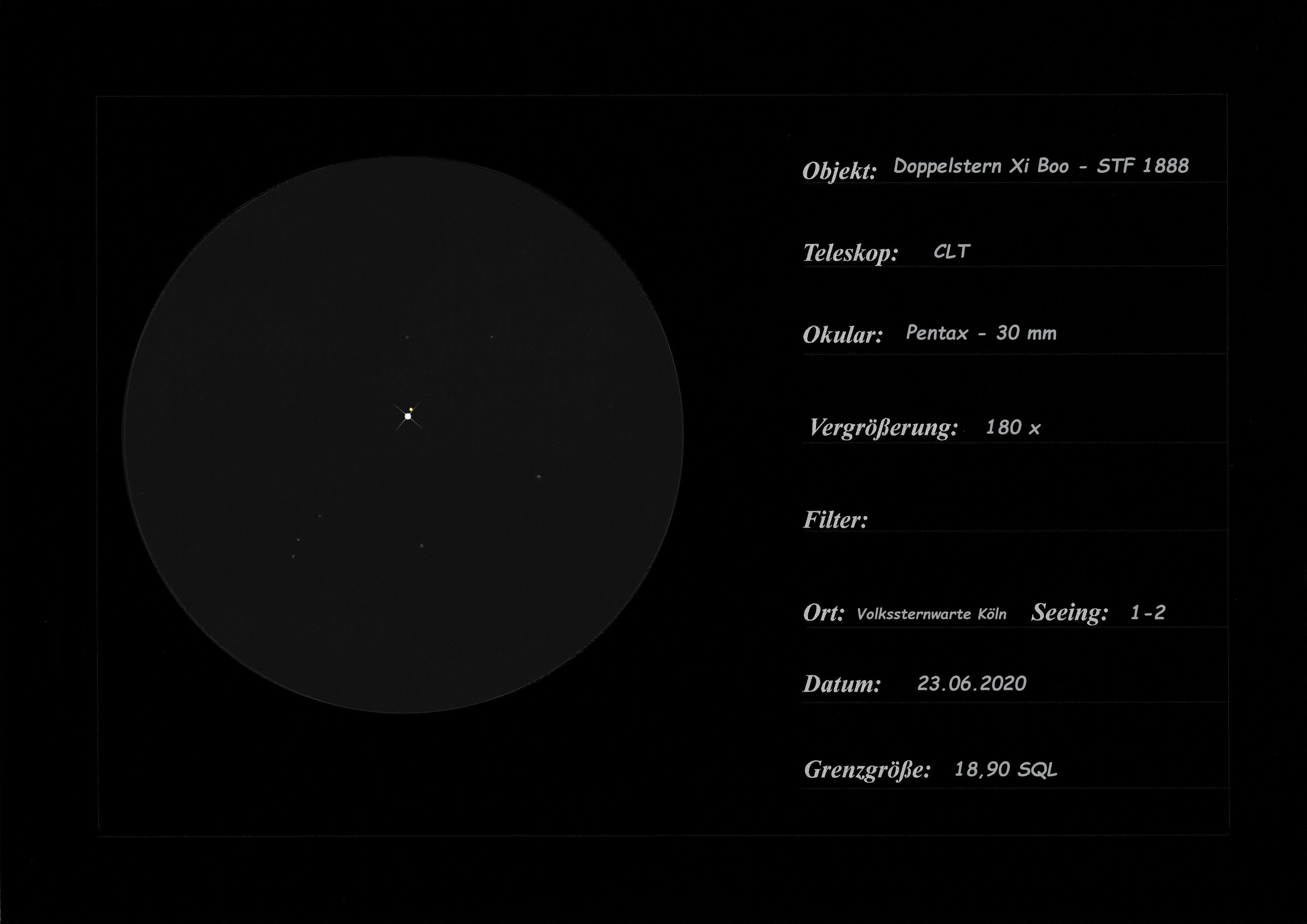
|
|
Frederik Wanink
Itterbeck (Germany) |
254mm |
AB |
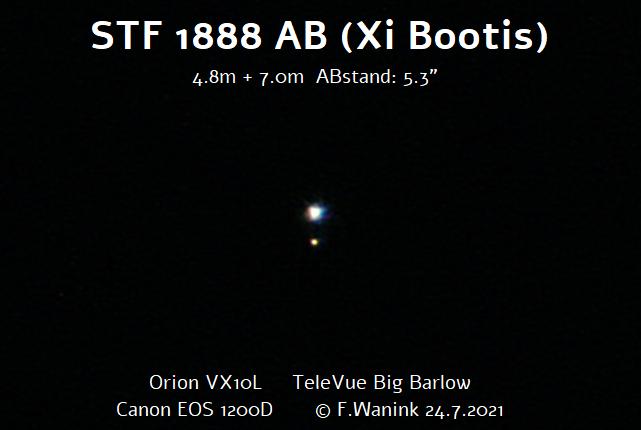
|
|
|
★
|
STT287 |
|
|
8m.4 |
8m.6 |
0.6" |
11° |
2021 |
Boo |
14h51m27.53s / +44°55'42.60" |
|
|
Mark McCarthy
Fremont (California/USA) |
317mm (553x) |
Wow! Hair-split, ~0.7", near equal to half a delta mag. |
|
Mark McCarthy
Fremont (California/USA) |
508mm (533x) |
An elongated smear at 205x, split with seeing at 445x, stead split at 533x. <1", near equal white stars. Binary with 340-year period, currently tightening to periastron around 2044 |
|
|
|
★
|
HO389 |
|
|
7m.0 |
10m.5 |
1.5" |
86° |
2016 |
Boo |
14h52m07.44s / +20°17'26.50" |
Mark McCarthy
Fremont (California/USA) |
203mm (333x) |
Extremely faint B resolves with best seeing as a tiny faint point outside first diffraction. Very tough, very excellent object |
|
Mark McCarthy
Fremont (California/USA) |
317mm (553x) |
Definite split of much fainter pair, ~1.5", somewhat lost in diffraction, but there! |
|
|
|
★
|
A2071, EQ Boo |
|
|
9m.3 |
9m.9 |
1.3" |
273° |
2017 |
Boo |
14h52m25.79s / +17°57'23.30" |
Mark McCarthy
Fremont (California/USA) |
203mm (333x) |
EQ Boo. ! Very fine pair nicely split, ~1", ~1 delta mag |
|
|
|
★
|
BU31 |
|
AB |
8m.5 |
10m.3 |
1.8" |
225° |
2021 |
Boo |
14h52m30.05s / +18°44'19.50" |
|
|
Mark McCarthy
Fremont (California/USA) |
203mm (333x) |
White A and light yellow B, finely split, ~2 delta mag |
|
Karsten Kopp
Köln (Germany) |
600mm (180x) |
Doppelstern konnte gerade so getrennt werden. Die Distanz von 2,0 Bogensekunden und die Helligkeit beider Sterne, macht die Sichtung nicht leicht. |
|
|
|
★
|
MLR532 |
|
|
11m.1 |
11m.1 |
0.7" |
248° |
2016 |
Boo |
14h57m34.23s / +20°40'31.00" |
Mark McCarthy
Fremont (California/USA) |
508mm (533x) |
Beautifully split with 533x, very clear, slight delta mag, light orange stars. It's a little challenging at this magnification with the small scale; the stars were elongated at 205x. WDS uncertain of physicality; Gaia shows no parallax overlap, so sadly this is not |
|
|
|
★
|
STF1909, 44 Boo |
|
|
5m.2 |
6m.1 |
0.2" |
138° |
2020 |
Boo |
15h03m47.30s / +47°39'14.60" |
|
|
Frederik Wanink
Itterbeck (Germany) |
254mm (640x) |
2015 getrennt zu sehen (1") |
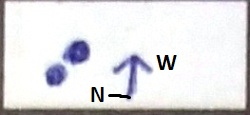
|
Mark McCarthy
Fremont (California/USA) |
317mm (553x) |
I Boo. Figure 8 to hair split, ~0.9". This pair shrinking separation fast, will be <0.5" in a couple of years. Only 40 LY away. (July 2017) |
|
|
|
★
|
STF1908 |
|
AB |
9m.2 |
10m.3 |
1.3" |
152° |
2016 |
Boo |
15h04m56.30s / +34°28'02.70" |
Mark McCarthy
Fremont (California/USA) |
203mm (333x) |
Wow! superfine B split with seeing, light orange stars. B is very faint next to A, a significant delta, >1" |
|
|
|
★
|
A690 |
|
AB |
10m.0 |
10m.5 |
0.2" |
11° |
2013 |
Boo |
15h09m09.80s / +28°08'48.20" |
Mark McCarthy
Fremont (California/USA) |
203mm (333x) |
Very tough, seems fainter than 9th and 10th mag as given in SkyTools (and indeed it is, both fainter by another half mag), and also closer than 1". With seeing only, significant delta mag, and very close, hairline only |
|
|
|
★★
|
STFA27, delta Boo, 49 Boo |
|
AB |
3m.6 |
7m.9 |
105.0" |
78° |
2021 |
Boo |
15h15m30.16s / +33°18'53.40" |
Christopher Hay
Seeheim (Germany) |
15x45 |
Handheld, binoculars with internal stabilisation. Very wide. Component A is of a slight yellow-orange hue, its companion too weak (NELM in target area: 5m0) for colour impression.
Nice in 4.5° FOV with Mu Boo AB, which is visibly slightly wider than Delta Boo and whose component B is slightly brighter than that of Delta Boo.
Delta Boo is a physical double at a distance to us of 122 light years. |
|
René Merting
Drachhausen (Germany) |
18x70 |
ein sehr ungleiches, weit auseinander stehendes Sternpaar - Komponente A im Westen strahlt gleißend cremegelb, die wesentlich schwächere Komponente B im Osten ist weißgrau bis bräunlich |
|
Robert Zebahl
Leipzig (Germany) |
70mm (22x) |
2020-04-24: Widely separated pair with large difference in brightness. Less striking. The bright primary component shines in a bright yellow. |
|
Mark McCarthy
Fremont (California/USA) |
80mm (13x) |
Split in 80mm finder. Very wide pair, very bright A, 3 delta mag B. Orange-yellow and blue-white B |
|
Mark McCarthy
Fremont (California/USA) |
80mm (94x) |
Delta Boo. Wide, large delta mag B, a 76,000-period pair! |
|
Sarah Gebauer
Germany |
100mm (49x) |
bei 49-fach zeigt A ein schönes, zartes Gelb, der weit entfernte Begleiter ist sehr fein, wesentlich schwächer und schafft es nicht über einen grauen Farbeindruck hinaus |
|
René Merting
Drachhausen (Germany) |
107mm (30x) |
bei 30x deutlich getrennt - Komponente A strahlt ein einem seidenen Gelb, B ist mehr als zwei Größenklassen schwächer und wirkt weißlich |
|
Mark McCarthy
Fremont (California/USA) |
203mm (205x) |
Bright star with many nearby faint stars. Didn't bother trying to figure out which are which. |
|
|
Frederik Wanink
Itterbeck (Germany) |
254mm |
|

|
|
|
★★
|
STF1930, 5 Ser |
|
AB |
5m.1 |
10m.1 |
11.7" |
36° |
2017 |
Ser |
15h19m18.79s / +01°45'55.50" |
Stefan Loibl
Rosenheim (Germany) |
102mm (68x) |
Messier 5 in the same FOV, wonderful |
|
Mark McCarthy
Fremont (California/USA) |
178mm (205x) |
Light yellow-white A and wide 3 delta B. WDS says physical and this is correct: 74% parallax overlap, 289 AU separation, and the radial velocity is less than the escape velocity |
|
Mark McCarthy
Fremont (California/USA) |
203mm (333x) |
Light yellow bright A, very much fainter orangish B, wide separation. Near M5. |
|
|
|
★
|
STF1937, eta CrB |
|
AB |
5m.6 |
6m.0 |
0.4" |
287° |
2020 |
CrB |
15h23m12.23s / +30°17'17.70" |
Uwe Pilz
Leipzig (Germany) |
120mm (250x) |
Schwierig |

|
Mark McCarthy
Fremont (California/USA) |
203mm (667x) |
8" 333x Suspect elongation. 8" 667x definite egg shape. 20" 667x Can't get a good focus. |
|
Frederik Wanink
Itterbeck (Germany) |
254mm (640x) |
deutlich als 8 zu sehen, 2015 0,6" |
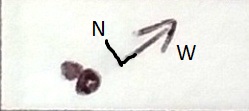
|
Mark McCarthy
Fremont (California/USA) |
317mm (277x) |
Close orange pair, equal mag, snowman shape |
|
Mark McCarthy
Fremont (California/USA) |
317mm (553x) |
Overlapping / notched orange-yellow stars. Used apodising mask. |
|
|
Frederik Wanink
Itterbeck (Germany) |
254mm |
scheint enger als 0.5" |

|
|
|
★★★
|
mu Boo, 51 Boo, Alkalurops |
CHR181, mu 1 Boo |
Aa-Ab |
4m.3 |
|
0.1" |
188° |
2012 |
Boo |
15h24m29.54s / +37°22'37.10" |
|
|
|
STFA28, mu 1 Boo |
AB |
4m.3 |
7m.1 |
109.2" |
171° |
2020 |
|
|
|
|
|
STF1938, mu 2 Boo |
Ba-Bb |
7m.1 |
7m.6 |
2.2" |
2° |
2020 |
|
|
|
|
Christopher Hay
Seeheim (Germany) |
7x45 |
STFA28 (AB): Handheld. Wide split. A compact uneven pair. Component A is bluish-white.
Rather charming in 8.6° FOV with Nu1/2 Boo, which has a gorgeous colour contrast, golden-orange and ice-blue, making it one of the strongest colour-contrast pairs in the sky for binoculars and greatly accentuating the sight of Mu Boo.
In 15x45 binoculars STFA28 AB is very wide, component A bluish-white, B warmer. |
|
Robert Zebahl
Leipzig (Germany) |
8x40 |
STFA28 (AB): Easily split with obvious difference in brightness. |
|
Robert Zebahl
Leipzig (Germany) |
16x70 |
STFA28 (AB): 2021-06-14: Wide, relatively striking pair. Pale yellow & dark orange. |
|
René Merting
Drachhausen (Germany) |
16x70 |
STFA28 (AB): weit getrenntes Pärchen, aufgrund der großen Helligkeitsunterschiedes schöner Farbkontrast - Komponente A im Norden gelblich, B im Süden mehr grau-braun |
|
Robert Zebahl
Leipzig (Germany) |
70mm (22x) |
STFA28 (AB): Evident, very wide apart and unequal. A: white-yellowish, B: grey. |
|
Mark McCarthy
Fremont (California/USA) |
80mm (94x) |
STFA28 (AB): Alkalurops Bright yellow-white A and bluish B, which is itself a slightly unequal close double, finely split (STF 1938 Ba,Bb) -- 256.5-year period, now coming off apastron |
|
Sarah Gebauer
Germany |
100mm (21x) |
STFA28 (AB): 02.10.23: bei 21-fach sehr eindeutig auszumachen, das Paar sticht durch eine sehr helle, blass zitronengelbe A-Komponente und eine graue bis schmutzig weiße, weit abgesetzte B-Komponente hervor |
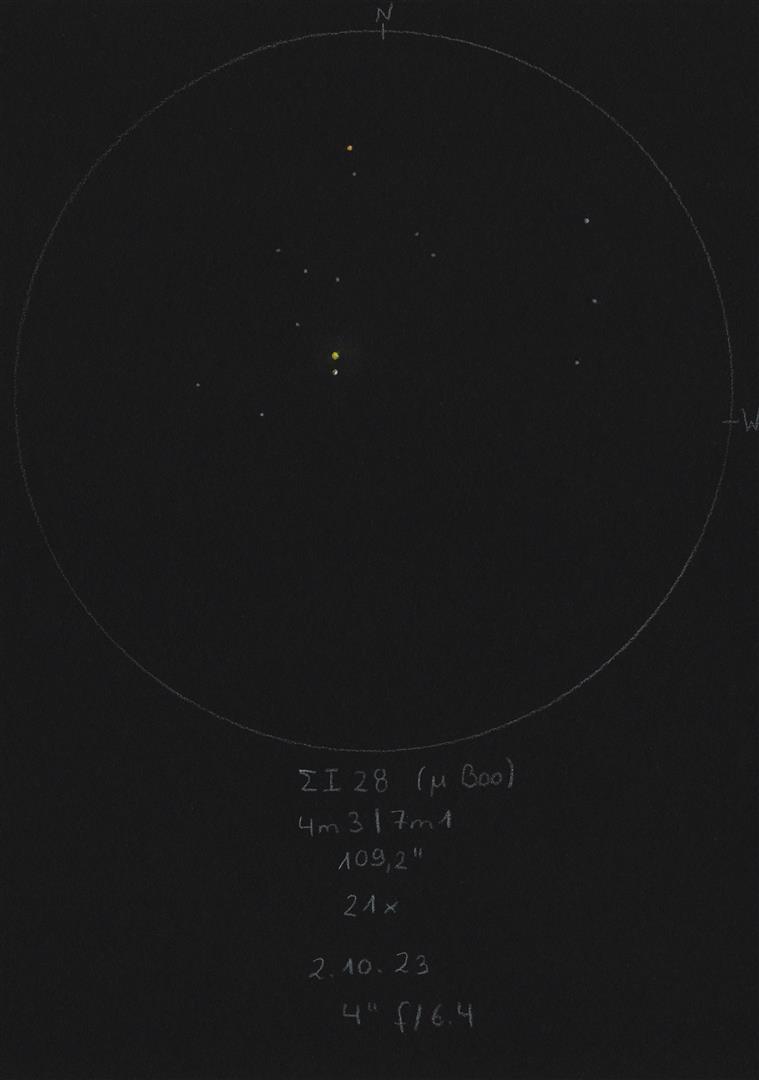
|
Sarah Gebauer
Germany |
100mm (49x) |
STFA28 (AB): bei 49-fach sehr hell und sehr weit, unterschiedlich hell und dominiert das ohnehin schon eher leere Gesichtsfeld |
|
Robert Zebahl
Leipzig (Germany) |
102mm (125x) |
Beautiful view! This triple system includes STFA 28 and STF 1938. |
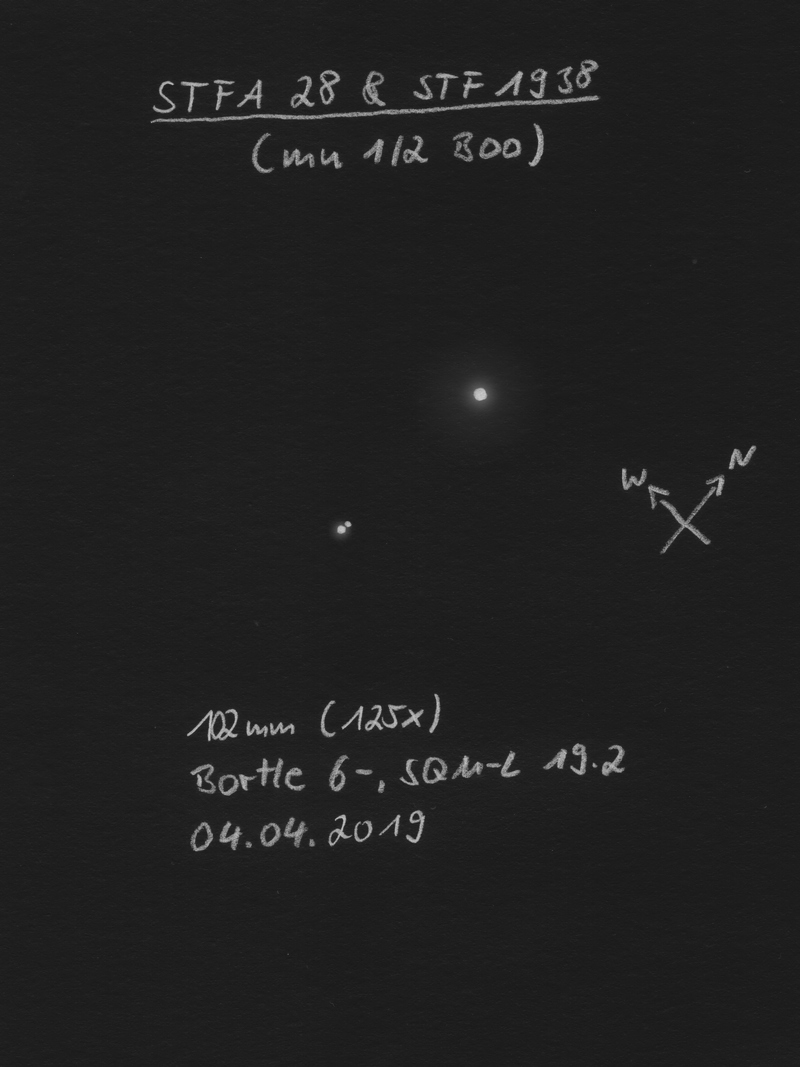
|
Uwe Pilz
Leipzig (Germany) |
105mm (288x) |
ein heller 4m und zwei nahe dunkle 7m, lohnend. |
|
René Merting
Drachhausen (Germany) |
107mm (30x) |
STFA28 (AB): AB: das Paar ist bei 30x komfortabel getrennt erkennbar, A strahlt leicht gelblich - Komponente B besteht aus zwei Sternen Ba, Bb (STF 1938), die ab 120x getrennt zu sehen sind - Bb im Norden ist gut eine viertel bis halbe Größenklasse schwächer als Ba |
|
René Merting
Drachhausen (Germany) |
107mm (120x) |
STF1938 (Ba-Bb): bei 86x ist nördlich von Ba ein zweiter etwas schwächerer Stern erkennbar, er klebt noch an Ba - 120x reichen dann für eine knappe Trennung - Bb im Norden ist eine viertel bis halbe Größenklasse schwächer |
|
Robert Zebahl
Leipzig (Germany) |
120mm (23x) |
STFA28 (AB): Easy to split with large angular distance and noticeable difference in brightness. |
|
Sarah Gebauer
Germany |
150mm (125x) |
A-BC mit 109'' sind bei 125x sehr weit getrennt, es ist der Ansatz eines engen Doppelsterns zu erkennen, der sich mit 2,2'' Abstand auch bis 250x nicht auftrennen ließ |
|
Christopher Hay
Seeheim (Germany) |
180mm (105x) |
STF1938 (Ba-Bb): At 105x in poor seeing a kissing, evenly matched pair. At 180x clearly split despite the poor seeing, southern component (Ba) seems slightly brighter than Bb. |
|
Mark McCarthy
Fremont (California/USA) |
203mm (205x) |
STFA28 (AB): Bright A star does not seem round. The B star is a tight equal pair, pretty set. [Aa,Ab is CHR 181 0.1", and I'd be shocked if I actually detected it. STFA 28 is technically the bright star and the tight pair, the tight pair is Ba,Bb = STF 1938, 7.09/7.63, 2.2"] |
|
Mark McCarthy
Fremont (California/USA) |
203mm (205x) |
STFA28 (AB): Bright A star does not seem round (CHR181). B star is a tight equal pair (STF1938 Ba-Bb). Pretty set. STFA 28 is technically the bright star and the tight pair |
|
Mark McCarthy
Fremont (California/USA) |
203mm (205x) |
CHR181 (Aa-Ab): Bright A star does not seem round (CHR181). B star is a tight equal pair (STF1938 Ba-Bb). Pretty set. STFA 28 is technically the bright star and the tight pair |
|
Mark McCarthy
Fremont (California/USA) |
203mm (205x) |
STF1938 (Ba-Bb): Bright A star does not seem round (CHR181). B star is a tight equal pair (STF1938 Ba-Bb). Pretty set. STFA 28 is technically the bright star and the tight pair |
|
Frederik Wanink
Itterbeck (Germany) |
254mm (640x) |
STF1938 (Ba-Bb): 3er System, schön |

|
Mark McCarthy
Fremont (California/USA) |
317mm (277x) |
STFA28 (AB): Bright white star with tight yellow pair STF 1938 as its companion. |
|
Mark McCarthy
Fremont (California/USA) |
317mm (553x) |
STFA28 (AB): Striking. Bright star with near equal double STF 1938 paired with it. A star is a spectroscopic binary |
|
Mark McCarthy
Fremont (California/USA) |
317mm (553x) |
STF1938 (Ba-Bb): Near equal close but well split double also paired with STFA28 |
|
Karsten Kopp
Köln (Germany) |
600mm (257x) |
Hier handelt es sich um ein Dreifachsternsystem, welches jetzt aber nicht durch eine besondere Färbung der Sterne auffällt. Die A - B/C Komponenten stehen noch sehr weit auseinander, wobei auch die A-Komponente um einiges heller erscheint. Die beiden Komponenten B/C sind wesentlich näher beieinander und unterscheiden sich auch kaum in ihrer Helligkeit. |

|
|
|
★★
|
STF1941 |
|
|
9m.7 |
9m.8 |
1.4" |
212° |
2017 |
CrB |
15h25m42.81s / +26°37'40.50" |
Mark McCarthy
Fremont (California/USA) |
317mm (553x) |
Faint, very close equal pair, ~1.5". Nice! |
|
|
|
★★
|
STT296 |
|
AB |
7m.8 |
9m.1 |
2.3" |
273° |
2020 |
Boo |
15h26m26.56s / +44°00'13.20" |
|
|
|
|
AC |
7m.8 |
12m.7 |
80.7" |
313° |
2016 |
|
|
|
|
Mark McCarthy
Fremont (California/USA) |
203mm (205x) |
AB: Very fine but well split, ~2", yellow-white A, reddish B, 2 delta mag. |
|
Mark McCarthy
Fremont (California/USA) |
317mm (553x) |
AB: Very beautiful, 2", 2 delta mag, with very faint third (AC) seen with averted vision widely separated. |
|
Mark McCarthy
Fremont (California/USA) |
317mm (553x) |
AC: Very beautiful, 2", 2 delta mag, with very faint third (AC) seen with averted vision widely separated. |
|
Mark McCarthy
Fremont (California/USA) |
317mm (553x) |
AB: Close near equal, 1 delta mag, white. |
|
|
|
★
|
JEF1, bet CrB |
|
|
3m.7 |
5m.2 |
0.3" |
140° |
2019 |
CrB |
15h27m49.85s / +29°06'19.80" |
Mark McCarthy
Fremont (California/USA) |
762mm (457x) |
Suspect out of roundness in the star disk. Tried with and without a hexagon mask |
|
|
|
★★
|
STF1950 |
|
|
8m.1 |
9m.2 |
3.3" |
91° |
2020 |
Ser |
15h29m58.46s / +25°30'31.10" |
Mark McCarthy
Fremont (California/USA) |
317mm (277x) |
Very fine orange pair 2 delta mag, ~1.5". B appears fine and delicate. |
|
|
|
★
|
STT298 |
|
AB |
7m.2 |
8m.4 |
1.2" |
191° |
2021 |
Boo |
15h36m02.22s / +39°48'08.90" |
|
|
|
|
AB-C |
6m.9 |
7m.8 |
120.4" |
328° |
2017 |
|
|
|
|
|
|
AB-D |
6m.9 |
13m.9 |
167.4" |
224° |
2002 |
|
|
|
|
|
|
AB-E |
6m.9 |
12m.1 |
456.0" |
335° |
2002 |
|
|
|
|
Robert Zebahl
Leipzig (Germany) |
102mm (28x) |
AB-C: Wide, moderately unequal pair. Little difference in color: Primary components appeared a bit more orange colored. |
|
Robert Zebahl
Leipzig (Germany) |
120mm (23x) |
AB-C: Easy to split with large angular distance and noticeable difference in brightness. |
|
Mark McCarthy
Fremont (California/USA) |
203mm (205x) |
AB: At zenith, but worth the effort to slew to. Another great 2+1. The tight pair [AB] is near equal and split a little more than a hairline |
|
Mark McCarthy
Fremont (California/USA) |
317mm (553x) |
AB: One component of compicated 6 star system, some of which is split in 80mm finter. This is a close equal pair, ~2". |
|
|
Frederik Wanink
Itterbeck (Germany) |
254mm |
AB-C |

|
|
|
★★
|
STF1964 & HU1167 |
HU1167 |
AB |
8m.1 |
9m.9 |
1.4" |
80° |
2016 |
CrB |
15h38m12.91s / +36°14'48.60" |
|
|
|
STF1964 |
AC |
8m.1 |
8m.1 |
14.5" |
90° |
2017 |
|
|
|
|
|
STF1964 |
AD |
8m.1 |
9m.0 |
15.1" |
83° |
2018 |
|
|
|
|
|
STF1964 |
CD |
8m.1 |
9m.0 |
1.5" |
21° |
2019 |
|
|
|
|
Robert Zebahl
Leipzig (Germany) |
16x70 |
STF1964 (AC): 2021-06-13: Beautiful double star with components of almost equal brightness and subtle color difference: white-bluish & slightly orange. |
|
René Merting
Drachhausen (Germany) |
18x70 |
STF1964 (AC): zu erkennen sind zwei gleich helle, sehr dicht stehende Sterne - Trennung ein wenig mehr als knapp |
|
René Merting
Drachhausen (Germany) |
100mm (20x) |
STF1964 (AC): bei 20x ein gut getrenntes Pärchen gleich heller Sterne, auffallend im Sternumfeld |
|
Sarah Gebauer
Germany |
100mm (49x) |
STF1964 (AC): zusammen mit STF 1965 im Gesichtsfeld, zwei recht unterschiedliche Doppelsterne - bei 49-fach getrennt, recht hell und besonders eng - der Farbeindruck ist zunächst strahlend weiß, bei 80-fach zeigt A dann einen Gelbtupfer |
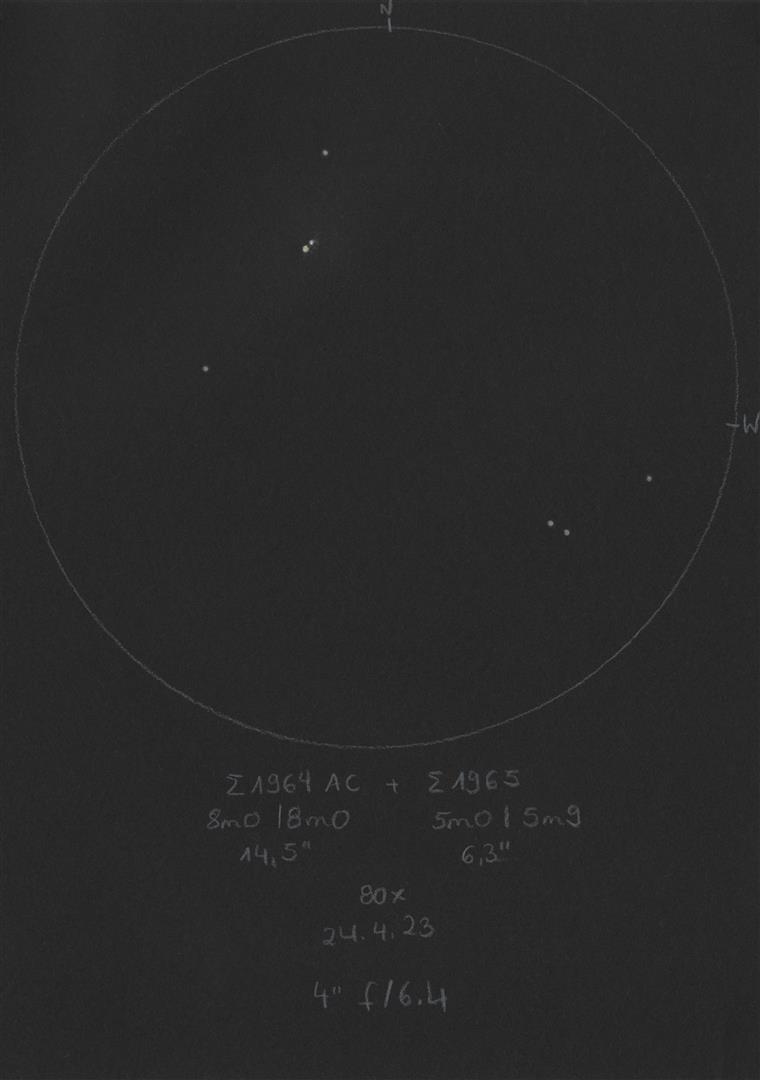
|
Robert Zebahl
Leipzig (Germany) |
102mm (62x) |
STF1964 (AC): Rather wide pair, equal without visible difference in color. |
|
Uwe Pilz
Leipzig (Germany) |
105mm (16x) |
Dreifachstern nicht trennbar |
|
René Merting
Drachhausen (Germany) |
107mm (30x) |
STF1964 (AC): bei 30x ein kleines, feines Paar zweier gleich heller Sterne - gleiche Farbe - schöner Anblick zusammen mit STF 1965 |
|
Robert Zebahl
Leipzig (Germany) |
120mm (23x) |
STF1964 (AC): Nice double star, well split with equally bright components. |
|
Mark McCarthy
Fremont (California/USA) |
317mm (277x) |
STF1964 (AC): Well split equal pair. I suspect B is pair as it is an elongated orange smear at 277x -- it is STF 1964CD. |
|
Mark McCarthy
Fremont (California/USA) |
317mm (553x) |
STF1964 (CD): Faint near equal pair about 3" separation. In the same field with HU 1167. Magnificent |
|
Mark McCarthy
Fremont (California/USA) |
317mm (553x) |
HU1167 (AB): Bright star with much fainter pair, about 1" separation, 3-4 delta mag. In same field with STF 1964. Magnificent |
|
|
Frederik Wanink
Itterbeck (Germany) |
254mm |
STF1964 (CD) |

|
|
|
★
|
STF1965, zeta CrB, zeta 1/2 CrB, 7 CrB |
|
|
5m.0 |
5m.9 |
6.4" |
306° |
2021 |
CrB |
15h39m22.68s / +36°38'09.00" |
Robert Zebahl
Leipzig (Germany) |
16x70 |
2021-06-14: A slight elongation can be guessed at best. |
|
Axel Tute
Küssaberg (Germany) |
70mm (58x) |
30.05.2009: A light blue, B greenish |
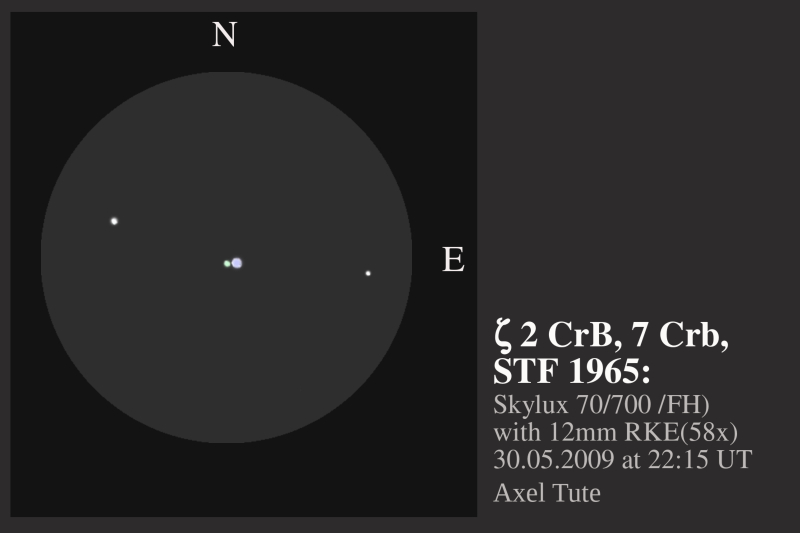
|
René Merting
Drachhausen (Germany) |
100mm (32x) |
bei 32x ein knapp getrenntes deutlich helleres Pärchen als der 27' südwestlich stehende Doppelstern STF1964 - Komponente B ist gut eine Größenklasse schwächer als A - beide Komponenten schmiegen sich meist noch aneinander, aber in guten Momenten sind beide getrennt sichtbar - zurück auf 20x ist ein länglicher Stern erkennbar |
|
Sarah Gebauer
Germany |
100mm (49x) |
zusammen mit STF 1964 im Gesichtsfeld, zwei recht unterschiedliche Doppelsterne - bei 49-fach getrennt, ein eher schwächeres Paar und etwas weiter getrennt |

|
Robert Zebahl
Leipzig (Germany) |
102mm (28x) |
At 28x very tight and barely split, unequal. At 86x very nice view. No difference in color: both components appeared white. |
|
Stefan Loibl
Rosenheim (Germany) |
102mm (68x) |
Elongated at 28x, split with 68x. Component A blue, B reddish. At 68x double star STF1964 in the same FOV |
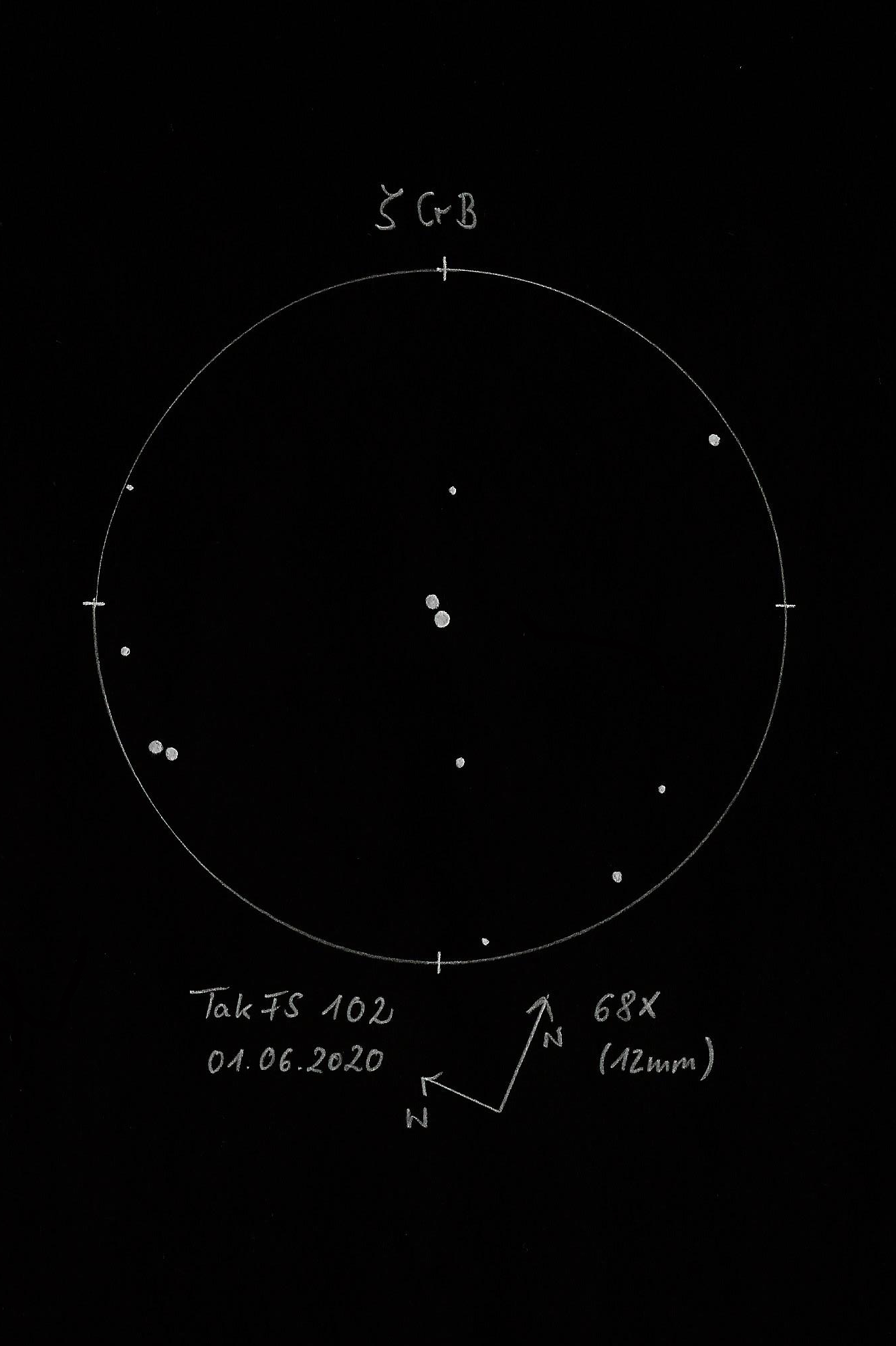
|
René Merting
Drachhausen (Germany) |
107mm (43x) |
bei 30x sehe ich zwei ungleiche Sterne mit Einschnürung kurz vor der Trennung - bei 43x zeigt sich ein knapp getrenntes Sternpaar - A schimmert Gelblichweiß, B ist eine Größenklasse schwächer und richtig schön weiß |
|
Robert Zebahl
Leipzig (Germany) |
120mm (48x) |
Very nice double star, well split with noticeable difference in brightness. |
|
Mark McCarthy
Fremont (California/USA) |
317mm (277x) |
Bright white, well separated, ~1 delta mag. |
|
Karsten Kopp
Köln (Germany) |
600mm (180x) |
Doppelstern konnte gut getrennt werden. Der Helligkeitsunterschied ist nicht sehr groß und der etwas hellere Stern erscheint weißlich und der schwächere geht eher ins bläulich weiße. |
|
|
Frederik Wanink
Itterbeck (Germany) |
254mm |
|
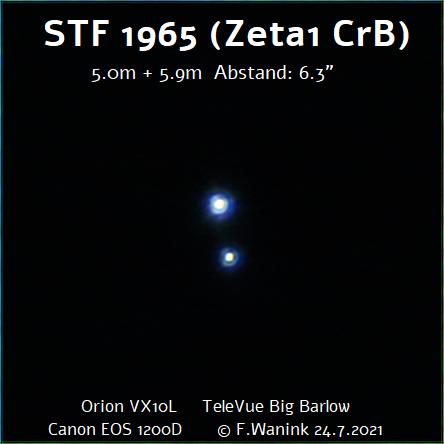
|
Frederik Wanink
Itterbeck (Germany) |
254mm |
|

|
|
|
★
|
STF1967, 8 CrB, gamma CrB |
|
|
4m.0 |
5m.6 |
0.5" |
110° |
2015 |
CrB |
15h42m44.57s / +26°17'44.30" |
|
|
Robert Zebahl
Leipzig (Germany) |
152mm (300x) |
2021-07-23: Gamma CrB was only a few degrees above the house roof and the refractor was insufficiently cooled down. In no way visible as a double star. I used magnifications from 200x to 400x. |
|
Mark McCarthy
Fremont (California/USA) |
203mm (667x) |
Definite mis-shape, oval to egg, observation made June 2019 |
|
|
|
★
|
AG198 |
|
|
9m.2 |
10m.1 |
2.2" |
144° |
2017 |
Ser |
15h45m20.23s / +04°31'56.50" |
Mark McCarthy
Fremont (California/USA) |
178mm (205x) |
Wow! Very fine direct vision, both disks are clear, white stars, 2 delta. WDS uncertain of binarity, and I find they are not: no parallax range overlap, and the escape velocity exceeds the radial velocity |
|
|
|
★★
|
STT301 |
|
|
7m.5 |
10m.4 |
4.0" |
27° |
2017 |
Boo |
15h46m13.64s / +42°28'06.30" |
Mark McCarthy
Fremont (California/USA) |
317mm (553x) |
Wow. Relatively bright A, orange, with a very faint B which shimmers and sparkles to view with averted vision and held with direct. B star is small, 4-5 delta mag, 6-8" |
|
|
|
★★
|
STF1973 |
|
|
7m.6 |
8m.8 |
30.6" |
321° |
2021 |
CrB |
15h46m24.50s / +36°26'45.60" |
René Merting
Drachhausen (Germany) |
18x70 |
ein gut getrenntes Sternpaar - Komponente A im Südosten ist doppelt so hell wie B - ganz leichter Farbkontrast |
|
René Merting
Drachhausen (Germany) |
100mm (20x) |
bei 20x sind beide Sterne gut getrennt erkennbar - schöner Farbkontrast zwischen beiden ungleich hellen Sternen |
|
Uwe Pilz
Leipzig (Germany) |
105mm (53x) |
blaugrün-orange, trennbar bei 15x |
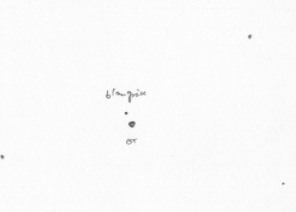
|
René Merting
Drachhausen (Germany) |
107mm (30x) |
bei 30x sind zwei schwache Sternchen gut getrennt erkennbar - leichter Farbkontrast, A wirkt leicht Cremegelb, B ist eher Weißgrau |
|
Robert Zebahl
Leipzig (Germany) |
120mm (23x) |
Nice double star, easy to split with noticeable difference in brightness. |
|
Mark McCarthy
Fremont (California/USA) |
317mm (553x) |
Wide, 1 delta magnitude white. |
|
|
|
★
|
BU621 |
|
|
7m.9 |
9m.4 |
0.6" |
27° |
2018 |
Her |
15h49m49.96s / +44°31'19.50" |
Mark McCarthy
Fremont (California/USA) |
508mm (667x) |
nice, split with seeing, 2 delta mag, very close, very slightly orange and yellow stars. |
|
|
|
★
|
SKF1311 |
|
|
5m.3 |
10m.3 |
74.8" |
300° |
2016 |
Ser |
15h50m17.55s / +02°11'47.50" |
Mark McCarthy
Fremont (California/USA) |
203mm (333x) |
Cool. Bright yellow-orange star broken up by seeing and with a water vapor glow (sky is deteriorating). Much fainter B star hanging at edge of halo. |
|
|
|
★
|
BU810 |
|
|
9m.1 |
10m.8 |
1.6" |
84° |
2016 |
Her |
15h51m00.24s / +42°27'59.50" |
Mark McCarthy
Fremont (California/USA) |
508mm (667x) |
Very cool, light orange and blue, close but very good split. 2 delta mag. |
|
|
Frederik Wanink
Itterbeck (Germany) |
254mm |
|

|
|
|
★
|
H3 7, beta Sco |
|
AC |
2m.6 |
4m.5 |
13.4" |
20° |
2019 |
Sco |
16h05m26.23s / -19°48'19.40" |
Christopher Hay
Seeheim (Germany) |
15x45 |
Stabilised binoculars, handheld. Difficult handheld in this instrument, but clearly split and attractive as such. Tripod mounting would surely help and make the difference for a nice pair for this magnification. One of the earliest doubles split, found by Benedetto Castelli in 1627, but according to Stelledoppie not a physical double (in contrast to the very tight BU 947 AB pair in the system, which is physical, with a separation of 0.3” in 2020 and 0.4” in 2030 – and the wide PWL 9001 AD pair with a separation of 518” – A, B and D are thus a physical triple). “H“ in the catalogue name means that this double star is listed in the catalogue of W. Herschel. The 3 in the name means that it is a double star of the 3rd Class [separation 5'' - 15''] in Herschel’s system. |
|
Sarah Gebauer
Germany |
150mm (85x) |
unspektakulär, mit 85x einfach zu trennen, wenige Feldsterne |
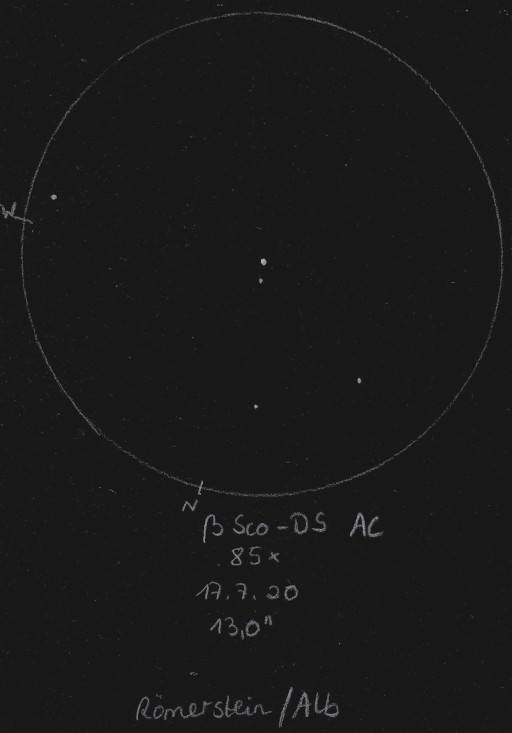
|
|
|
★
|
COU1276 |
|
|
10m.9 |
12m.9 |
3.3" |
53° |
2016 |
CrB |
16h08m52.28s / +37°58'00.80" |
Mark McCarthy
Fremont (California/USA) |
508mm (667x) |
Good find, B star only visible averted vision, flashes out obvious and clear. |
|
|
|
★
|
STF2015 |
|
AB |
8m.2 |
9m.5 |
3.0" |
159° |
2019 |
Her |
16h08m54.75s / +45°21'11.80" |
|
|
|
|
AC |
8m.2 |
13m.8 |
8.9" |
102° |
2015 |
|
|
|
|
|
|
BC |
9m.5 |
13m.8 |
9.0" |
102° |
2007 |
|
|
René Merting
Drachhausen (Germany) |
100mm (107x) |
AB: bei 107x ist Komponente B südlich von A knapp getrennt erkennbar - Helligkeitsunterschied eine knappe Größenklasse, dadurch wirkt B nicht ganz so reinweiß wie A |
|
Mark McCarthy
Fremont (California/USA) |
203mm (205x) |
AB: ! Blue-white A and white-blue B (which is to say A is white with a tinge of blue, and B is blue with a tinge of white) ~3", ~2 delta mag |
|
Karsten Kopp
Köln (Germany) |
600mm (180x) |
AB: Doppelstern ist gut zu trennen. Der Helligkeitsunterschied ist merklich, aber nicht markant. Der hellere leuchtet weißlich und der schwächere eher gelblich. |
|
|
Frederik Wanink
Itterbeck (Germany) |
254mm |
|

|
|
|
★
|
STF2025 |
|
|
8m.0 |
9m.8 |
2.6" |
164° |
2016 |
Her |
16h11m11.71s / +47°33'36.10" |
René Merting
Drachhausen (Germany) |
100mm (107x) |
bei 107x wird mit viel Konzentration Komponente B südlich von A ganz knapp getrennt und wie ein Schatten bzw. wie eine zarte Andeutung erkennbar - bei 142x habe ich vergeblich versucht, B noch einmal zu erblicken - schwer |
|
Axel Tute
Küssaberg (Germany) |
200mm (77x) |
17.07.2006: Beautiful pair in an attractive star field. Separated at 77x magnification. No colours noted. |
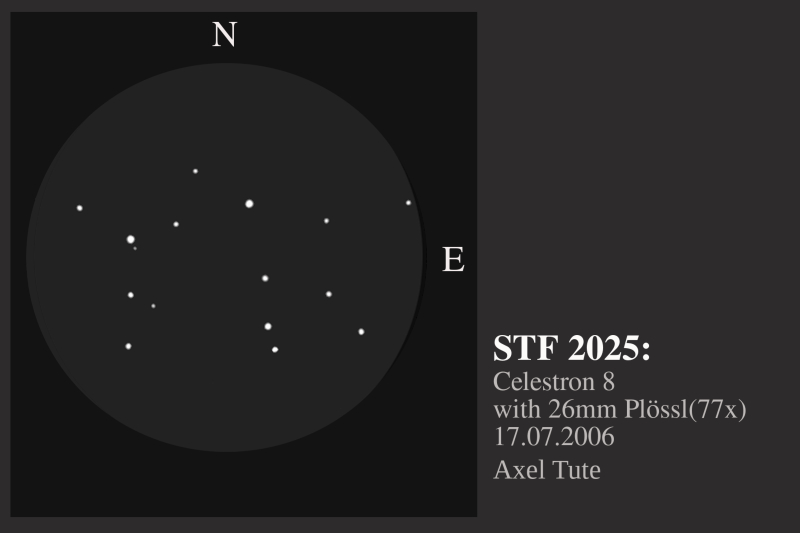
|
Mark McCarthy
Fremont (California/USA) |
203mm (205x) |
! Very delicate pair, large delta mag, close ~2", B held with direct vision after foveal coaxing. Not far away is another bright white star about same magnitude as A, but is not paired with it |
|
Mark McCarthy
Fremont (California/USA) |
317mm (553x) |
Unrelated wide near equal white pair split in finder, but one has a very faint ~2 delta mag 2-3" companion and is the AB pair. Nice! |
|
Karsten Kopp
Köln (Germany) |
600mm (180x) |
Doppelstern konnte gut getrennt werden. Beide Komponente wirken weißlich. |
|
|
|
★
|
nu Sco, 14 Sco, Jabbah |
BU120 |
AB |
4m.3 |
5m.3 |
1.4" |
1° |
2021 |
Sco |
16h11m59.74s / -19°27'38.30" |
|
|
|
H5 6 |
AC |
4m.3 |
6m.6 |
41.3" |
336° |
2019 |
|
|
|
|
|
MTL2 |
CD |
6m.6 |
7m.2 |
2.4" |
55° |
2019 |
|
|
Christopher Hay
Seeheim (Germany) |
15x45 |
AC: Stabilised binoculars, handheld. Widely separated. Nice pair reminiscent of Beta Lyrae at 10x. Also split clearly in stabilised handheld 10x42, but view not as pleasing as in 15x45. |
|
Christopher Hay
Seeheim (Germany) |
15x60 |
AC: Wide split. Secondary faint blue, a fine contrast to the very slightly yellowish-white primary. |
|
René Merting
Drachhausen (Germany) |
18x70 |
AC: ein schönes Sternpaar mit einem leichten Farbkontrast - Komponente A im SSO ist leicht gelblich, die schwächere C-Komponente weißbläulich - A ist nicht ganz rund, aber das kann auch vom FG herrühren |
|
|
|
★
|
STF2021, 49 Ser |
|
AB |
7m.4 |
7m.5 |
4.0" |
0° |
2021 |
Her |
16h13m18.45s / +13°31'37.20" |
|
|
Robert Zebahl
Leipzig (Germany) |
70mm (57x) |
Lovely split. Almost equal pair with relatively close components. |
|
René Merting
Drachhausen (Germany) |
100mm (64x) |
bei 32x zeigen sich zwei gleich helle weiße Sterne, die sich gerade noch berühren - bei 64x dann knappe Trennung, B ist nur minimal schwächer |
|
Axel Tute
Küssaberg (Germany) |
200mm (77x) |
02.07.2006: The close pair AB could be separated with the 26mm Plössl (77x). C can be observed at an estimated PA of 120°. |
|
Mark McCarthy
Fremont (California/USA) |
203mm (205x) |
49 Ser. Light yellow orange, near equal, bright, wide ~4". Physical, 1354 year period |
|
Karsten Kopp
Köln (Germany) |
600mm (180x) |
Doppelstern ist gut zu trennen, bei fast identischer Helligkeit. Ein weißliches Augenpaar schaut mich an. |
|
|
|
★
|
sigma CrB, 17 CrB, STF2032 |
|
AB |
5m.6 |
6m.5 |
7.2" |
240° |
2021 |
CrB |
16h14m40.85s / +33°51'31.00" |
|
|
Robert Zebahl
Leipzig (Germany) |
16x70 |
2021-06-13: Clearly recognizable as a double star with a well visible difference in brightness. It appears clearly as '8' and is close to be separated. |
|
Robert Zebahl
Leipzig (Germany) |
70mm (22x) |
At 22x clearly separated, but very close with a clear difference in brightness. At 57x easy without any noticeable difference in color. |
|
Axel Tute
Küssaberg (Germany) |
70mm (58x) |
30.05.2009: A reddish, B orange |
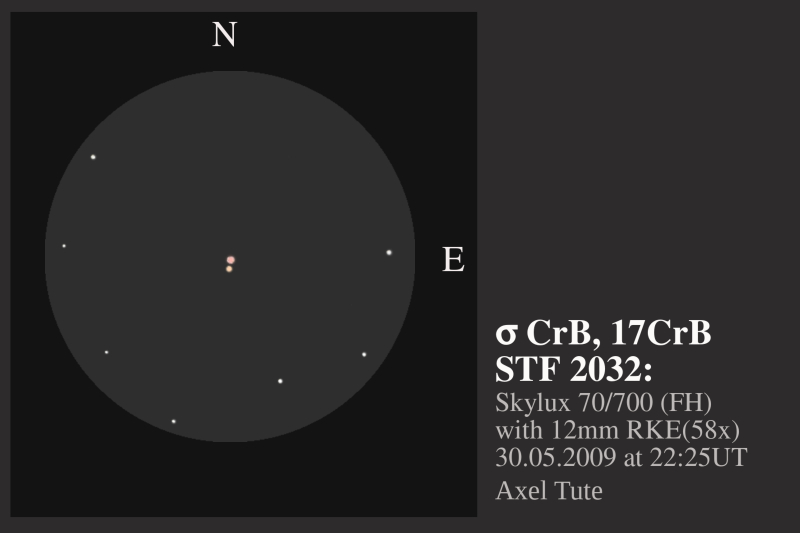
|
René Merting
Drachhausen (Germany) |
100mm (32x) |
bei 20x zwei knapp zusammenstehende Sterne mit tiefer Einschnürung - bei 32x dann ein knapp getrenntes Pärchen - B-Komponente südwestlich gut eine halbe Größenklasse schwächer - beide Sterne mit weißem Brautkleid |
|
Sarah Gebauer
Germany |
100mm (49x) |
bei 49-fach ein ganz entzückendes, feines Murmel-Pärchen mit zwei warmweißen Komponenten mit einem Hauch Gold, A leicht heller und stärker als B |
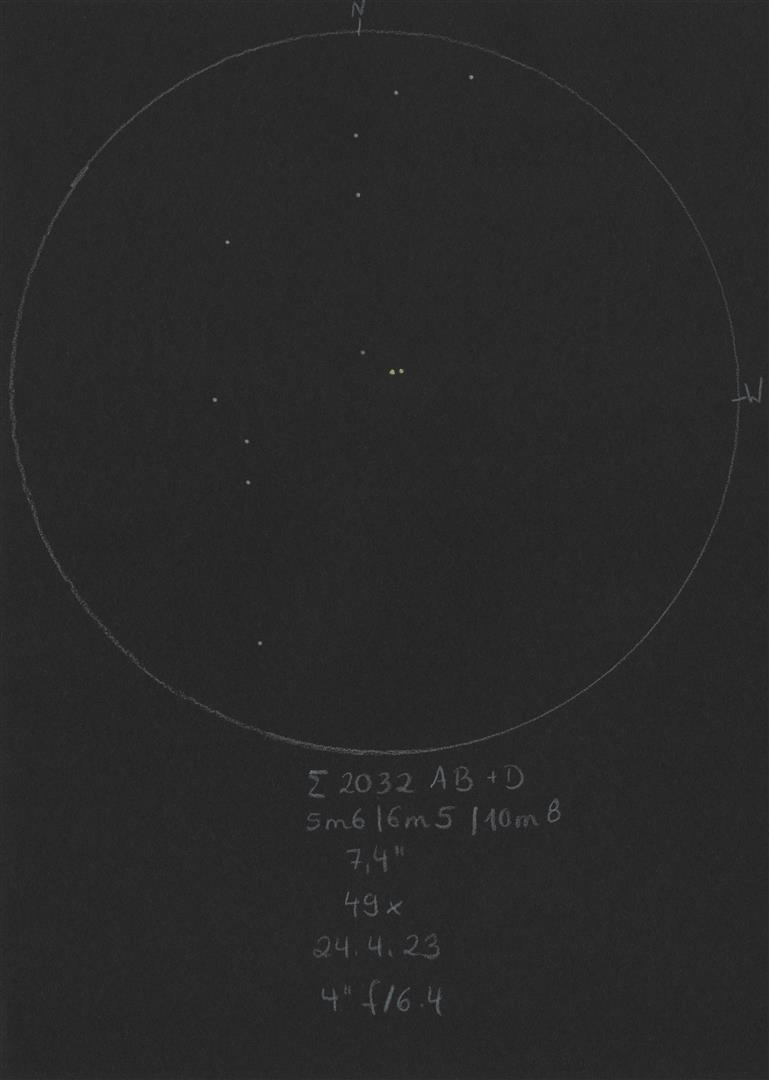
|
Stefan Loibl
Rosenheim (Germany) |
102mm (26x) |
Already split at 26x. Component A orange, B yellow. |
|
René Merting
Drachhausen (Germany) |
107mm (30x) |
bei 30x zeigt sich B im Westen von A, Helligkeitsunterschied eine halbe Größenklasse, farblich unauffällig - bei 60x dann ein schöner Farbkontrast, A strahlt in einem schönen, sanften Gelb, B im Kontrast Roséweiß |
|
René Merting
Drachhausen (Germany) |
320mm (72x) |
bei 72x ein schick anzusehendes, knapp getrenntes Pärchen - A im Osten ist hellgelb - B ist vielleicht eine halbe Größenklasse schwächer und auch gelblich, aber nicht so stark wie A |
|
Mark McCarthy
Fremont (California/USA) |
508mm (667x) |
Sigma CrB. AB nice bright half delta mag wide. two more stars in system, one (AC) closer fainter, other (AD) further away. |
|
Karsten Kopp
Köln (Germany) |
600mm (135x) |
Sehr einfaches, auffälliges Objekt im Okular, ansonsten keine weiteren Auffälligkeiten. |
|
|
|
★
|
COU1450 |
|
|
10m.5 |
11m.8 |
1.3" |
62° |
2016 |
Her |
16h16m25.97s / +43°25'25.50" |
Mark McCarthy
Fremont (California/USA) |
508mm (333x) |
! Very fine pair, slight mag difference, close ~2" |
|
|
|
★★
|
nu CrB, nu 1/2 CrB, 20 CrB |
STFA29 |
AB |
5m.4 |
5m.6 |
354.7" |
164° |
2011 |
CrB |
16h22m21.42s / +33°47'56.90" |
|
|
|
HN 81 |
AC |
5m.4 |
12m.6 |
68.1" |
241° |
2002 |
|
|
|
|
|
STFA29 |
AD |
5m.4 |
11m.5 |
277.2" |
153° |
2020 |
|
|
|
|
|
H6 18 |
BD |
5m.6 |
11m.5 |
98.7" |
16° |
2020 |
|
|
Christopher Hay
Seeheim (Germany) |
7x45 |
AB: A strong, well separated pair. Both orangish, Nu1 with a touch of yellow.
Nicely framed in 8.6° FOV with globular cluster M13, which presents as a fluffy little ball under a NELM 5m2 sky. |
|
René Merting
Drachhausen (Germany) |
18x70 |
AB: auffallend, zwei gleichhelle Sterne weit getrennt - die südliche Komponente strahlt zartgelb |
|
Sarah Gebauer
Germany |
100mm (21x) |
STFA29 (AB): bei 21-fach sehr weit getrennt, nicht mehr als Doppelstern zu erkennen, wären da nicht die nahezu gleiche Helligkeit und ähnliche Farbe von A und B, die aprikosengelb wirken - ein sehr strahlendes Paar, das im Sternumfeld mit einigen schwächeren Sternchen hervorsticht |
|
Christopher Hay
Seeheim (Germany) |
101mm (51x) |
AB: Extremely wide apart but still holding together very strongly thanks to identical, substantial brightnesses and identical yelowish-orange colours. Very impressive in 1.6° FOV. |
|
René Merting
Drachhausen (Germany) |
107mm (30x) |
bei 30x ein wunderschönes Sternpaar zweier gleichheller Sterne - beide strahlen in einem schönen warmgelben Farbton, wie ein klares Schlüsselblumengelb, die nördliche Komponente ist dabei noch ein kleines bisschen intensiver |
|
René Merting
Drachhausen (Germany) |
320mm (72x) |
AB: bei 72x ein weit auseinander stehendes helles Pärchen - die nördliche Komponente ist leicht heller - diesen Doppelstern macht die relativ gleiche hellgelbe Färbung beider Komponenten aus - was diesen Doppelstern noch ausmacht, dass beide hellen Komponenten einen schwachen Begleiter haben
AC: bei 72x blinkt bei der nördlichen A-Komponente südwestlich ein schwacher Lichtpunkt auf, Abstand ordentlich
BD: bei 72x steht bei der südlichen B-Komponente ein schwacher Lichtpunkt nordöstlich, D ist etwas weiter entfernt, als der Abstand AC - ein schickes Quartett |
|
Mark McCarthy
Fremont (California/USA) |
508mm (667x) |
STFA29 (AD): Nu 1 CrB. Nice bright orange finder split. AD is a wide faint star in the scope |
|
|
|
★
|
BU951 |
|
AB-C |
9m.3 |
10m.1 |
1.0" |
30° |
2016 |
CrB |
16h23m32.23s / +33°21'27.80" |
Mark McCarthy
Fremont (California/USA) |
508mm (667x) |
Wow seeing is amazing getting airy disks 20 inch 667x, orange and blue stars, very nice split, dare I say wide (AB is near equal 0.1" pair, try again to notice out of round) |
|
|
|
★★
|
STF2054 |
|
AB |
6m.2 |
7m.1 |
1.0" |
350° |
2018 |
Dra |
16h23m47.19s / +61°41'47.00" |
Robert Zebahl
Leipzig (Germany) |
70mm (133x) |
Not split in any way. |
|
Robert Zebahl
Leipzig (Germany) |
102mm (160x) |
Immediately visible as a double star. The diffraction disks overlapped slightly. The difference in brightness was clearly visible. Together with the nearby double star eta Dra in the same field of view, the sight was highly fascinating, as both double stars are very different in their appearance. |
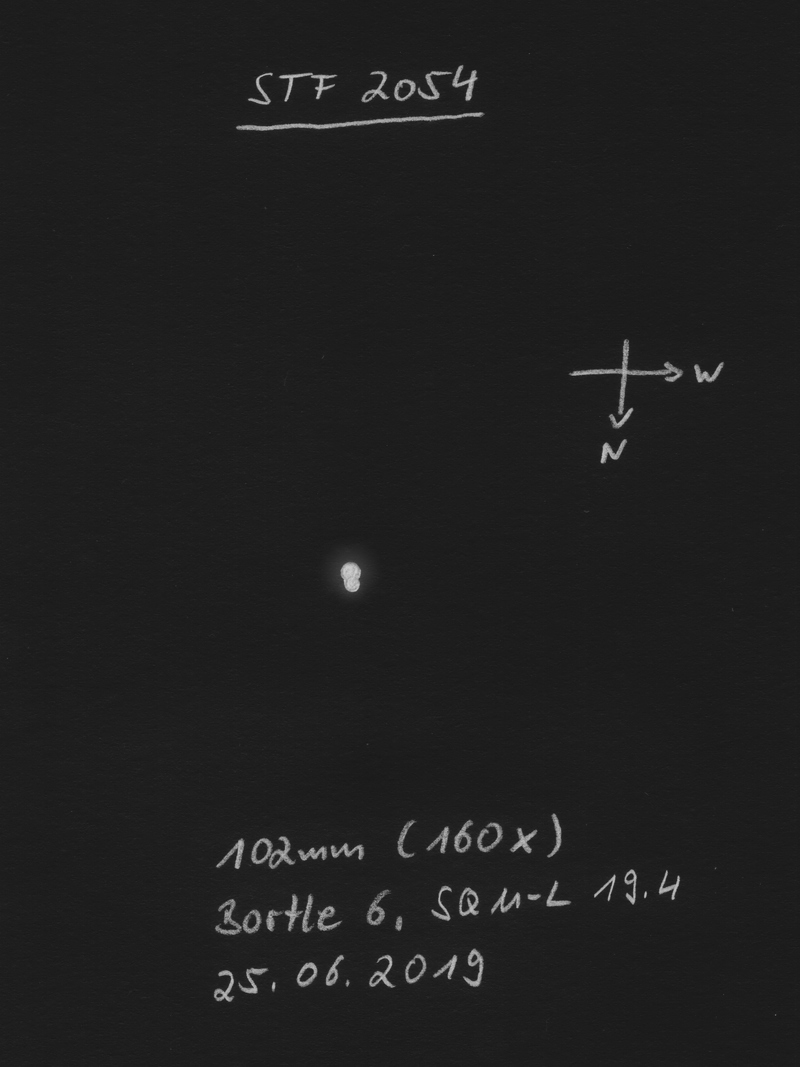
|
Uwe Pilz
Leipzig (Germany) |
105mm (198x) |
verformte Beugungsscheibe, auf den ersten Blick erkennbar |

|
Frederik Wanink
Itterbeck (Germany) |
254mm (640x) |
getrennt |
|
|
|
★★
|
STT312, eta Dra, 14 Dra |
|
AB |
2m.8 |
8m.2 |
4.7" |
142° |
2016 |
Dra |
16h23m59.51s / +61°30'50.70" |
Robert Zebahl
Leipzig (Germany) |
70mm (133x) |
Not split in any way. |
|
Robert Zebahl
Leipzig (Germany) |
102mm (160x) |
Easy. Very large difference in brightness. The faint companion appeared as a tiny star outside the first diffraction ring of the primary component. Highly recommended, especially with the nearby double star STF 2054! |

|
|
|
★★
|
TDS9883 |
|
|
11m.7 |
11m.9 |
0.8" |
299° |
1991 |
CrB |
16h24m38.78s / +31°59'42.90" |
Mark McCarthy
Fremont (California/USA) |
508mm (667x) |
Very extraordinarily fine, only at the best moments, a very close pair hairline split, very faint. |
|
|
|
★★★
|
rho Oph, 5 Oph |
H2 19 |
AB |
5m.1 |
5m.7 |
3.0" |
335° |
2021 |
Oph |
16h25m35.03s / -23°26'47.00" |
|
|
|
H2 19 |
AC |
5m.1 |
7m.3 |
151.1" |
0° |
2021 |
|
|
|
|
|
H2 19 |
AD |
5m.1 |
6m.8 |
156.1" |
253° |
2021 |
|
|
|
|
|
KOU63 |
CF |
5m.8 |
11m.7 |
4.8" |
206° |
2000 |
|
|
|
|
|
BU1115 |
DE |
6m.8 |
8m.4 |
0.3" |
196° |
2018 |
|
|
|
|
Stefan Loibl
Rosenheim (Germany) |
102mm (102x) |
AB: possible components (DE) and (CF) already visible at 27x magnification with ca. 2 arcmin distance |
|
|
|
★
|
STF2048 |
|
AB |
6m.6 |
9m.7 |
5.6" |
297° |
2016 |
Oph |
16h28m48.99s / -08°07'43.20" |
|
|
|
|
AC |
6m.6 |
12m.7 |
130.6" |
302° |
2015 |
|
|
René Merting
Drachhausen (Germany) |
100mm (107x) |
AB: schlechtes Seeing bzw. unerwartet heftiger Tanz der Sterne - erst bei 107x kann ich Komponente B ganz schwach west-nordwestlich von A erkennen - großer Helligkeitsunterschied - die Trennung hat keine Freude bereitet |
|
Stefan Loibl
Rosenheim (Germany) |
102mm (102x) |
AB: nice faint pair, both components orange |
|
|
|
★
|
STF2052 |
|
AB |
7m.7 |
7m.9 |
2.5" |
118° |
2020 |
Her |
16h28m52.67s / +18°24'50.60" |
|
|
|
|
AC |
7m.7 |
11m.8 |
136.4" |
44° |
2016 |
|
|
|
|
Axel Tute
Küssaberg (Germany) |
70mm (117x) |
AB: 30.06.2009: At 88x magnification you can see two stars touching each other. At 117x magnification you can see this more clearly, but no space in between. |
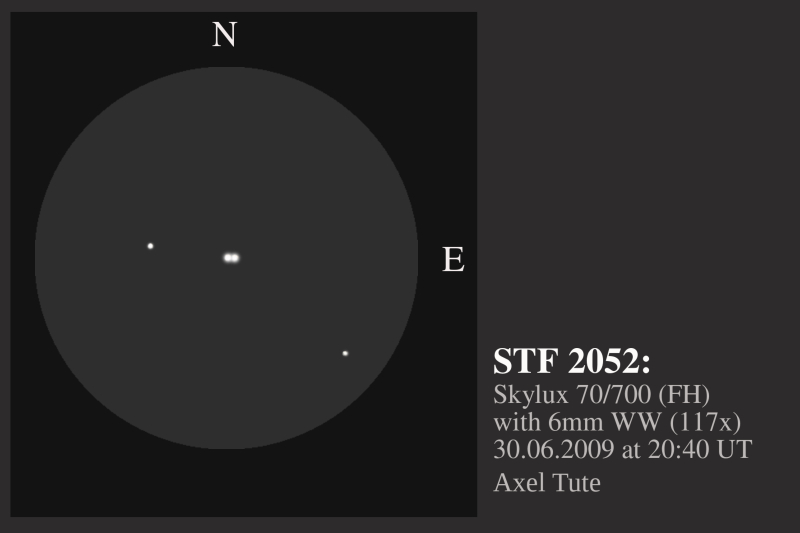
|
René Merting
Drachhausen (Germany) |
76mm (95x) |
AB: bei 57x kann ich eine schwache 8 erkennen, die beiden gleich schwachen Sterne stehen kurz vor der Trennung - bei 95x dann sind beide Komponenten knapp getrennt sichtbar |
|
René Merting
Drachhausen (Germany) |
100mm (107x) |
AB: bei 64x zwei gleichhelle Sterne, die sich gerade so berühren - bei 107x ein knapp getrenntes Pärchen, Komponente B im SO ist nur marginal schwächer |
|
Stefan Loibl
Rosenheim (Germany) |
102mm (102x) |
AB: Does not appear as a multiple star at 28x, elongated at 68x, splith with 102x. Component A blueish, B reddish. Observation of component C questionable. Occasional observation of a star at the presumably correct position. |
|
Mark McCarthy
Fremont (California/USA) |
317mm (277x) |
AB: Pretty pale yellow-orange pair of equal magnitude, about 2" separation. |
|
Karsten Kopp
Köln (Germany) |
600mm (180x) |
AB: Doppelstern war noch gut zu trennen, bei fast identischer Helligkeit. Komponente A wirkt weißlich, während die etwas schwächere Komponente B gelblich orange strahlt. |
|
|
|
★
|
lambda Oph, 10 Oph, STF2055, Marfic |
|
AB |
4m.2 |
5m.2 |
1.4" |
44° |
2019 |
Oph |
16h30m54.84s / +01°59'02.80" |
|
|
Stefan Loibl
Rosenheim (Germany) |
102mm (205x) |
components cannot be split at 205x |
|
Uwe Pilz
Leipzig (Germany) |
105mm (288x) |
schöner Farbkontrast, lohnend. |
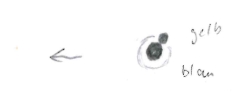
|
Sarah Gebauer
Germany |
150mm (160x) |
habe den Doppelstern zwar gefunden und konnte auch erkennen, dass es zwei Sterne sind, eine Trennung war aber heute Abend nicht möglich |
|
Mark McCarthy
Fremont (California/USA) |
203mm (205x) |
Marfic. Nice blazing white pair, ~1 delta, ~2". 129 year period, but not much change in the next few years |
|
Frederik Wanink
Itterbeck (Germany) |
254mm (640x) |
getrennt |
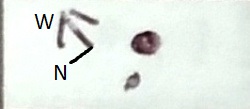
|
|
|
★
|
STF2059 |
|
|
8m.8 |
8m.8 |
0.3" |
179° |
2016 |
Her |
16h30m55.71s / +38°03'52.60" |
|
|
Frederik Wanink
Itterbeck (Germany) |
254mm (640x) |
nicht als DS gesehen |
|
Mark McCarthy
Fremont (California/USA) |
317mm (553x) |
Overlapping disks, notched. Need perfect seeing. This was 1.2" at Struve's discovery, so easier for him to see -- I doubt he would have found it now, near its closest separation. August 2017 |
|
|
Frederik Wanink
Itterbeck (Germany) |
254mm |
Doppelsternnatur nicht zu sehen |

|
|
|
★
|
STT313 |
|
|
8m.0 |
8m.3 |
0.9" |
128° |
2018 |
Her |
16h32m33.19s / +40°06'47.70" |
Frederik Wanink
Itterbeck (Germany) |
254mm (640x) |
mit Zwischenraum zu sehen |

|
Mark McCarthy
Fremont (California/USA) |
317mm (553x) |
Clean split, near equal pair. Nice |
|
|
Frederik Wanink
Itterbeck (Germany) |
254mm |
|

|
|
|
★★★
|
STF2078 & STFA30, 16/17 Dra |
STF2078, 17 Dra |
AB |
5m.4 |
6m.4 |
2.9" |
104° |
2021 |
Dra |
16h36m13.72s / +52°55'27.80" |
|
|
|
STFA30, 16/17 Dra |
AC |
5m.4 |
5m.5 |
90.2" |
193° |
2018 |
|
|
Christopher Hay
Seeheim (Germany) |
3x63 |
Clean split. Separation is much clearer than that of Nu1/2 Dra (STFA35), which is also in 14° FOV and is hair-fine split.
A physical double at a distance to us of 412 light years. |
|
Christopher Hay
Seeheim (Germany) |
7x45 |
A well split and nicely compact pair. When 16/17 Dra is put at the edge of the 8.6° field of view, Nu1/2 Dra stands at the opposite edge. Their comparison thus suggests itself. 16/17 is somewhat wider than Nu1/2. While the components of Nu1/2 are of equal brightness and whiteness, those of 16/17 display a slight difference in both brightness and colour. 17 (A) first seems bluer than 16 (C), but after 20 seconds this impression flips to C and from then on goes back and forth. |
|
Robert Zebahl
Leipzig (Germany) |
55mm (27x) |
STFA30 (AC): Rather wide pair with almost equal components. C component appeared slightly yellowish-orange. |
|
Robert Zebahl
Leipzig (Germany) |
55mm (71x) |
Grand sight! |

|
Christopher Hay
Seeheim (Germany) |
80mm (30x) |
16 Dra seems more bluish than 17 Dra, the latter seems slightly yellow in comparison and is distinctly elongated. At 84x 17 Dra is cleanly split and such a delightful view together with 16 Dra that I had no desire to ramp up the magnification. All three stars belong to a physical system. |
|
Sarah Gebauer
Germany |
100mm (80x) |
01.10.23: das Doppel 16/17 Dra zeigt bei 80-fach zum ersten Mal eine feine, warmweiße B-Komponente extrem knapp östlich neben der warmweißen, leicht gelblichen A-Komponente - Komponente C im Süden strahlt reinweiß und wirft einen ebenso großen Halo wie AB zusammen, sodass sich beide Halos überlagern - die D-Komponente ist als grauer, schwacher Stern südöstlich versetzt zu sehen |

|
René Merting
Drachhausen (Germany) |
100mm (107x) |
AB: bei 64x noch ein Stäbchen, bei 107x ist B dann knapp getrennt östlich von A erkennbar - B ist auch noch relativ hell bzw. maximal eine Magnitude schwächer
AC: bei 32x weit auseinander stehend - Komponente C im Süden ist maximal eine viertel Magnitude schwächer - leichter Farbkontrast, A weißgelb und C kühlweiß |
|
Frederik Wanink
Itterbeck (Germany) |
254mm (640x) |
STF2078 (AB): sehr schönes Dreiersystem |
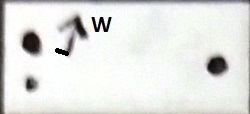
|
|
Frederik Wanink
Itterbeck (Germany) |
254mm |
STF2078 (AB) |

|
|
|
★
|
ES632 |
|
|
11m.3 |
11m.7 |
2.2" |
104° |
2016 |
Her |
16h40m50.12s / +50°13'40.60" |
Mark McCarthy
Fremont (California/USA) |
508mm (333x) |
! Very fine, noticeable magnitude difference, ~2", very nice |
|
|
|
★
|
STF2084, zeta Her, 40 Her |
|
|
3m.0 |
5m.4 |
1.6" |
110° |
2019 |
Her |
16h41m17.16s / +31°36'09.80" |
|
|
Sarah Gebauer
Germany |
100mm (136x) |
auf Anhieb ganz haarscharf getrennt, aber leider nur wenige Sekunden haltbar; dennoch erfolgreiche Trennung! |
|
Robert Zebahl
Leipzig (Germany) |
102mm (224x) |
Faint companion as distinct brightening on the first diffraction ring visible. In steadier moments visible as small, round condensation. |
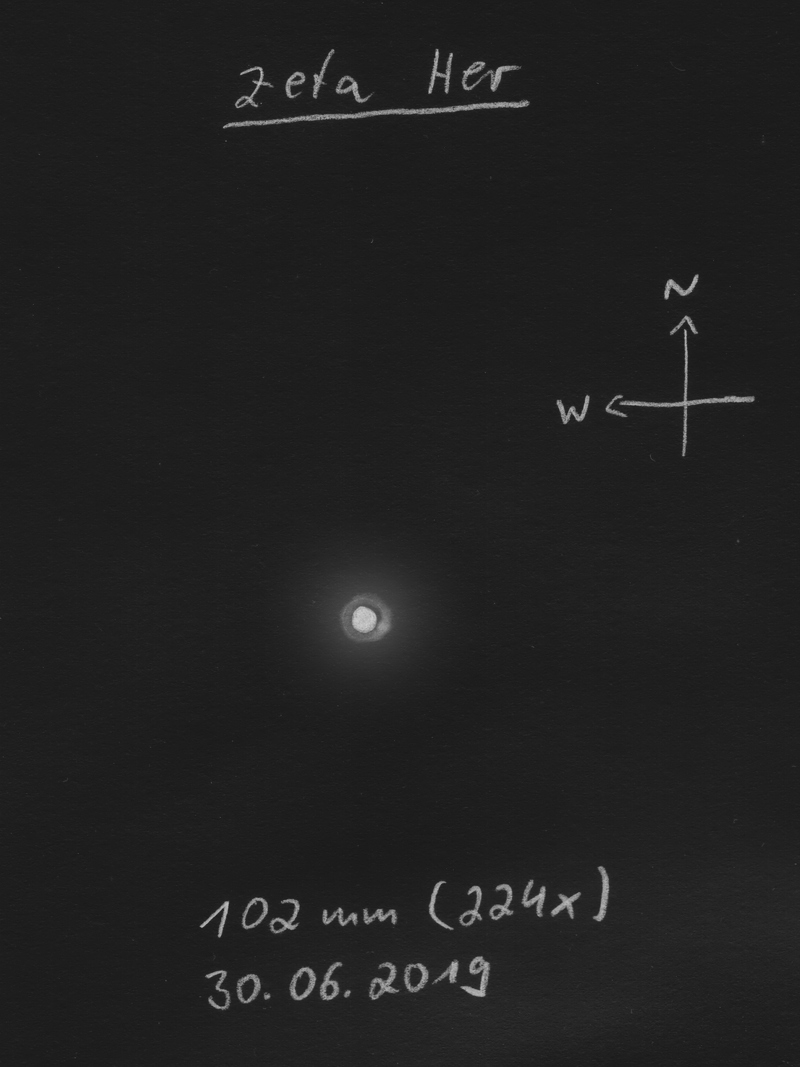
|
Robert Zebahl
Leipzig (Germany) |
102mm (280x) |
After a longer, concentrated observation, a permanent brightening of the first diffraction ring of the primary component could be seen at the correct position angle. The brightening appeared only arch-shaped without any noticeable condensation. |
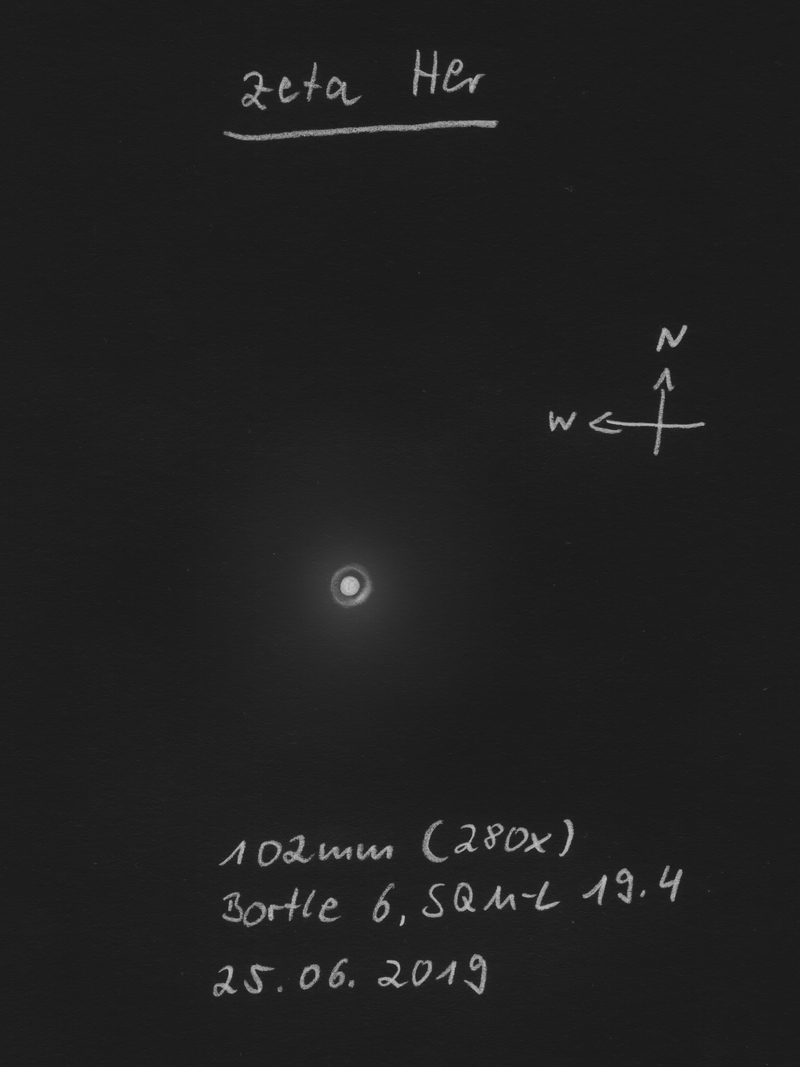
|
Uwe Pilz
Leipzig (Germany) |
105mm (288x) |
äußerst schwierig |
|
Uwe Pilz
Leipzig (Germany) |
105mm (288x) |
Bei sehr ruhiger Luft ohne Probleme sichtbar, trotz der störenden Restkoma meines Refraktors |

|
Mark McCarthy
Fremont (California/USA) |
152mm (285x) |
Zeta Her. A lot of diffraction but there is a persistent bulge, brightening to a split, at the first diffraction ring. Suspected at 175x |
|
Axel Tute
Küssaberg (Germany) |
200mm (300x) |
29.07.2006: Could not be separated. |
|
Mark McCarthy
Fremont (California/USA) |
203mm (533x) |
Zeta Her. B was seen, not too difficult as a disk within the diffraction of bright A, just outside first ring so ~1.5", like a diamond ring, significant mag difference |
|
Frederik Wanink
Itterbeck (Germany) |
254mm (640x) |
nicht als DS gesehen |
|
Frederik Wanink
Itterbeck (Germany) |
254mm (640x) |
getrennt |

|
René Merting
Drachhausen (Germany) |
320mm (320x) |
in der Nacht konnte ich nur bis 320x gewinnbringend vergrößern - Komponente A zeigt schöne Beugungsscheibchen, B offenbarte sich mir nicht |
|
|
|
★
|
STF2094 |
|
AB |
7m.5 |
7m.9 |
1.1" |
75° |
2020 |
Her |
16h44m10.57s / +23°31'02.80" |
|
|
|
|
AC |
7m.5 |
11m.7 |
24.9" |
312° |
2015 |
|
|
Mark McCarthy
Fremont (California/USA) |
152mm (285x) |
AB: Snowman at 175x, hairline split at 285x. Noticed wide faint C (11.70 mag) at 285x |
|
Axel Tute
Küssaberg (Germany) |
200mm (250x) |
AB: 29.06.2006: Separated at 250x magnification, but without space between. Estimated PA 90°: |
|
Mark McCarthy
Fremont (California/USA) |
203mm (333x) |
AC: Wide separation, 1 delta mag, 333x (AC seen, missed the tight A pair 1") |
|
Mark McCarthy
Fremont (California/USA) |
317mm (277x) |
AB: White-orange pair of equal magnitude, clean split when the seeing stills |
|
Mark McCarthy
Fremont (California/USA) |
317mm (277x) |
AC: ~25" separated, bluish about 3 magnitudes fainter than A |
|
René Merting
Drachhausen (Germany) |
320mm (320x) |
AB: bei 320x sind beide Komponenten knapp getrennt voneinander erkennbar - sie sind etwa gleich hell |
|
|
|
★
|
STF2095 |
|
|
7m.4 |
9m.2 |
5.4" |
160° |
2020 |
Her |
16h45m05.23s / +28°21'28.90" |
René Merting
Drachhausen (Germany) |
107mm (60x) |
bei 43x sind zwei schwache Perlchen zu erkennen, die noch nicht zu trennen sind - bei 60x ist B knapp getrennt südlich von A zu erkennen - Helligkeitsunterschied 2 Größenklassen |
|
Mark McCarthy
Fremont (California/USA) |
152mm (175x) |
Rather wide, 1 delta mag stars, yellow color A |
|
Axel Tute
Küssaberg (Germany) |
200mm (77x) |
29.06.2006: Simple. Separated at 77x magnification. PA estimated 180°. |
|
Mark McCarthy
Fremont (California/USA) |
317mm (553x) |
Nice! Yellow and white pair, 2 delta mag, 4" |
|
|
|
★
|
CTT20 & ES1089 |
ES1089 |
AB |
10m.7 |
11m.7 |
11.8" |
150° |
2015 |
Her |
16h46m28.63s / +47°59'24.00" |
|
|
|
ES1089 |
AC |
10m.7 |
12m.7 |
32.4" |
29° |
2015 |
|
|
|
|
|
CTT20 |
AD |
10m.7 |
10m.8 |
71.1" |
127° |
2015 |
|
|
|
|
|
CTT20 |
DE |
10m.8 |
12m.5 |
27.2" |
126° |
2015 |
|
|
|
|
|
CTT20 |
EF |
12m.5 |
12m.7 |
34.5" |
34° |
2015 |
|
|
René Merting
Drachhausen (Germany) |
320mm (72x) |
DE: bei 72x sind 5 Sterne der Herkules-Box (Leiter 6) getrennt voneinander erkennbar, u.a. auch die beiden Komponenten D und E - Komponente E bildet die südliche Ecke der Box, D liegt nahe E auf der Geraden zwischen A und E
EF: bei 40x zeigt sich der Herkules-Box noch als nebliger Strich - bei 72x ist Komponente E getrennt nordöstlich von Komponente E zu erkennen - F bildet die nordöstliche Ecke des Rechtecks |
|
René Merting
Drachhausen (Germany) |
320mm (160x) |
AB: bei 160x wird die Herkules-Box (Leiter 6) sehr deutlich, ES 1089 zeigt sich als schön getrenntes Sternpaar im NW
AC: das einzige physikalische Doppel in dieser Sechser-Gruppierung - bei 72x können die beiden Komponenten getrennt gesehen werden, sie bilden die westliche kurze Kante des Musters Leiter 6 |
|
Mark McCarthy
Fremont (California/USA) |
508mm (333x) |
ES1089 (AB): ! Nice little cluster of six near same magnitude stars with a couple fainter mixed in, this one the faintest pair and closest in, ~2", ~1 delta. Not physical |
|
|
|
★★
|
52 Her |
BU627 |
A-BC |
4m.8 |
8m.4 |
2.2" |
44° |
2018 |
Her |
16h49m14.21s / +45°58'59.90" |
|
|
|
A1866 |
BC |
9m.5 |
9m.6 |
0.3" |
267° |
2013 |
|
|
|
|
René Merting
Drachhausen (Germany) |
100mm (142x) |
BU627 (A-BC): bis 142x probiert, hat nicht funktioniert - der Helligkeitsunterschied ist vermutlich zu groß und das Beugungsscheibchen von A so hell wie BC selbst |
|
Robert Zebahl
Leipzig (Germany) |
102mm (280x) |
BU627 (A-BC): At 160x the faint component is already beginning to be visible as brightening in the first diffraction ring. At 280x the brightening is quite clearly visible and appears partly clear as a small knot in the first diffraction ring. |
|
Uwe Pilz
Leipzig (Germany) |
105mm (288x) |
BU627 (A-BC) |
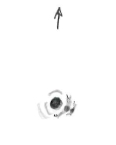
|
Uwe Pilz
Leipzig (Germany) |
120mm (180x) |
BU627 (A-BC) |
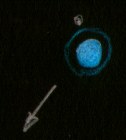
|
Mark McCarthy
Fremont (California/USA) |
317mm (553x) |
BU627 (A-BC): 52 Her. Very bright white star with a companion disk 2", 4-5 delta mag. Wow! B appears as if it is illuminated by A's light. Did not detect BC, 0.3" |
|
|
|
★★
|
STF2103 |
|
AB |
5m.9 |
10m.0 |
4.9" |
43° |
2018 |
Her |
16h49m34.67s / +13°15'40.30" |
Mark McCarthy
Fremont (California/USA) |
317mm (553x) |
Nice! Pretty bright white A, much fainter 5 delta mag B, well separated, looks like a planet. |
|
|
|
★★
|
STF2107 |
|
AB |
6m.9 |
8m.5 |
1.4" |
112° |
2020 |
Her |
16h51m50.10s / +28°39'58.70" |
|
|
Mark McCarthy
Fremont (California/USA) |
152mm (175x) |
! Extremely fine hairline split with seeing, 1.5 delta mag white stars. Obvious split with 285x. Physical with a 274 year orbit, now at apastron. 1.1" at discovery in 1828 |
|
Mark McCarthy
Fremont (California/USA) |
317mm (553x) |
Yellow and orange pair, very close ~1.5", 1 delta mag. Very pretty. |
|
Mark McCarthy
Fremont (California/USA) |
508mm (667x) |
Nice pair yellow and slightly blue two delta mag, about 1.5" (AC is 11.5 and much further separated) |
|
Karsten Kopp
Köln (Germany) |
600mm (385x) |
Doppelstern ist bei 180-facher Vergrößerung gerade so als 8 zu erkennen. Bei 385-facher Vergrößerung in den seltenen Augenblicken des ruhigen Seeings gerade so eben zu trennen. Sehr schwierig auch wegen des Helligkeitsunterschied von 1,6 mag. |
|
|
|
★
|
BU821 |
|
|
9m.8 |
10m.5 |
1.3" |
324° |
2016 |
Her |
16h51m50.65s / +31°50'36.30" |
Mark McCarthy
Fremont (California/USA) |
203mm (205x) |
! Nice, exceedingly fine split at this low magnification, noticeable mag difference, white stars. Burnham discovered with 15.5-inch Washburn |
|
|
|
★★
|
BU822 |
|
AB |
6m.6 |
9m.9 |
1.5" |
223° |
2016 |
Her |
17h03m52.67s / +19°41'25.80" |
Mark McCarthy
Fremont (California/USA) |
317mm (277x) |
Bright orange star with a consistent pin-prick point of light, stays still in occasional seeing shimmer. Fainter than PRY 2's B. ~1.5". In same field as PRY 2, same PA as PRY 2's. |
|
|
|
★★
|
PRY2 |
|
AB |
6m.2 |
9m.3 |
1.8" |
227° |
2012 |
Her |
17h04m41.34s / +19°35'56.70" |
Mark McCarthy
Fremont (California/USA) |
152mm (175x) |
! Wow! 3 delta mag B star just outside blue-green A's diffraction ring. Seen at both 175x and 285x. J.J.M. Perry. Uncertain in WDS, but from the Gaia EDR3 data I find a 23% parallax overlap, 2030 AU weighted distance, with the primary star 3.31 primary star solar mass vs 1.61 for the secondary -- so it should bind at 2030 AU -- so it is likely gravitationally bound. Gaia lacks the radial velocity otherwise I could confirm it |
|
Mark McCarthy
Fremont (California/USA) |
317mm (277x) |
Blue-white and slightly reddish B, 3-4 delta mag, 1.5". Not hard at all! Makes a double-double with BU 822 at 277x |
|
|
|
★★
|
mu Dra, 21 Dra, Alrakis, Arrakis |
STF2130 |
AB |
5m.7 |
5m.7 |
2.5" |
358° |
2020 |
Dra |
17h05m20.20s / +54°28'14.30" |
|
|
|
BU1088 |
AC |
5m.7 |
13m.7 |
12.2" |
174° |
2015 |
|
|
|
|
Christopher Hay
Seeheim (Germany) |
80mm (100x) |
In May 2019 neatly split, no colours seen. A physical system with a period of 812 years. Periastron was in 1946, since then the distance is widening to reach 2.7“ in 2025 and 2.8“ in 2030 |
|
René Merting
Drachhausen (Germany) |
100mm (107x) |
AB: bei 107x zeigen sich zwei knapp getrennte Perlchen, beide gleichhell und weiß schimmernd - ein schickes Paar |
|
Sarah Gebauer
Germany |
100mm (130x) |
AB: bei 130-fach nicht dauerhaft getrennt - gleich helle Sterne mit einem warmweißen, leicht gelben Farbton |
|
Robert Zebahl
Leipzig (Germany) |
102mm (125x) |
AB: Easy to separate. Beautiful sight. Components equally bright with no discernible color difference. |
|
Uwe Pilz
Leipzig (Germany) |
105mm (144x) |
AB |
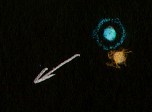
|
Mark McCarthy
Fremont (California/USA) |
203mm (205x) |
AB: Mu Dra. "Arrakis" (which was the name of the planet in the book Dune, but means "Dancer" in Arabic). Light yellow-orange stars, well split, equal. 812 year period |
|
Frederik Wanink
Itterbeck (Germany) |
254mm (460x) |
AB: gleich hell |
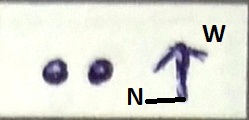
|
René Merting
Drachhausen (Germany) |
320mm (240x) |
AB: bei 240x zeigen sich beide Komponenten wunderschön und etwas mehr als knapp getrennt zu erkennen - Farben Fehlanzeige |
|
|
|
★
|
STT324 |
|
|
6m.0 |
10m.7 |
3.6" |
222° |
2016 |
Her |
17h08m00.70s / +31°12'22.50" |
Mark McCarthy
Fremont (California/USA) |
508mm (333x) |
Very interesting. At 20 inch the a star was orange and bloated with the seeing, did not notice a pair. I used the 8 inch mask which tightened the A star up considerably, then with averted vision could discern a very faint small glow in one particular direction, but could not hold it direct. Back to the 20" and now in good moments I can see the B star quite well, 5 delta mag, bluish. 333x |
|
|
|
★
|
STF2142 |
|
AB |
6m.2 |
9m.3 |
4.9" |
110° |
2018 |
Her |
17h11m40.26s / +49°44'46.70" |
René Merting
Drachhausen (Germany) |
100mm (64x) |
bei 64x offenbart der Stern seine Doppelsternseele - östlich von Komponente A ist knapp getrennt ein ganz schwacher Lichtpunkt sichtbar - gut 3-4 Größenklassen Unterschied zwischen den beiden - ein ungleiches Paar, aber schön anzusehen |
|
Mark McCarthy
Fremont (California/USA) |
203mm (205x) |
White star and ~3 detla mag, well separated, a little reddish color |
|
Karsten Kopp
Köln (Germany) |
600mm (180x) |
Doppelstern konnte gut getrennt werden. Der Reiz bei diesem Doppelstern liegt bei dem sehr deutlichen Helligkeitsunterschied von über 3 mag. Komponente A erstrahlt weißlich und Komponente B leicht rötlich. |
|
|
|
★★
|
HO557, AK Her |
|
|
8m.6 |
12m.0 |
4.5" |
323° |
2016 |
Her |
17h13m57.81s / +16°21'01.00" |
Mark McCarthy
Fremont (California/USA) |
317mm (553x) |
B only visible with averted vision. As I drift from averted back to direct the star fades and I can only hold direct for a moment before it disappears. Very interesting effect. ~5" and 4 delta mag. |
|
Mark McCarthy
Fremont (California/USA) |
508mm (205x) |
AK Her. White A and much fainter orange B, interesting pair. It is an uncertain pair yet WDS shows a period of 58.8 years, +/- 8 years. |
|
|
|
★★
|
STF2140, alpha Her, 64 Her, Ras Algethi |
|
AB |
3m.5 |
5m.4 |
4.7" |
103° |
2020 |
Her |
17h14m38.86s / +14°23'24.90" |
|
|
Christopher Hay
Seeheim (Germany) |
36mm (50x) |
At 50x secondary detaches momentarily from first diffraction ring of primary as the tiniest pinprick of light, delta-mag seems massive.
At 66x separation becomes much clearer. Can hold secondary 80% of the time as a fine point on the outer rim of the first diffraction ring. Primary is orange-yellow, secondary far too faint in this aperture for any kind of colour impression. Rather charming in a strange sort of way. See for comparison simultaneous observation with 210mm at 68x. |
|
Robert Zebahl
Leipzig (Germany) |
55mm (41x) |
Well split with noticeable difference in brightness. |
|
René Merting
Drachhausen (Germany) |
100mm (64x) |
bei 32x ist noch nichts erkennbar - bei 64x wird östlich von Rasalgethi der schwache Begleiter B knapp getrennt sichtbar - A ist strahlend gelb, B mit einer Tendenz zum gelb, eher ein warmes weiß |
|
Uwe Pilz
Leipzig (Germany) |
105mm (88x) |
himmelblau und hellgelb, getrennt bei 53x |
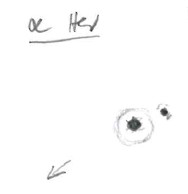
|
Uwe Pilz
Leipzig (Germany) |
105mm (288x) |
gelb-lachsfarben |
|
René Merting
Drachhausen (Germany) |
107mm (86x) |
bei 30x zeigt sich das Paar noch zusammen und zeigt ein auffallendes Gelb - bei 86x präsentiert sich A in Zitronenschalengelb, im Südosten zeigt sich knapp getrennt die B-Komponente, zwar deutlich schwächer, aber immernoch hell und auch farblich ein schwächerer Abklatsch von A in Hellgelb |
|
Robert Zebahl
Leipzig (Germany) |
120mm (100x) |
Easily split with noticeable difference in brightness. A: intensively orange colored, B: slightly orange. |
|
Christopher Hay
Seeheim (Germany) |
125mm (133x) |
At 133x split well and showing a fine colour contrast, orange / grey-blue. Each step to 160x, 200x and finally 266x benefits the aesthetic experience, drawing the pair apart and making the colour contrast clearer. At 266x primary is yellowish orange and secondary exhibits a fine grey-blue. Fine diffraction pattern at 266x with first ring around secondary and hint of a second ring around primary. |
|
Karsten Kopp
Köln (Germany) |
140mm (94x) |
Konnte erst mit 94-facher Vergrößerung gut getrennt wahrgenommen werden. |
|
Sarah Gebauer
Germany |
150mm (85x) |
bei Halbmond auf der Schwäbischen Alb: sehr eng, aber sauber getrennt, eine Komponente ist viel heller und größer, mein Farbeindruck ist allerdings unerwartet eher gelb |
|
Sarah Gebauer
Germany |
150mm (160x) |
richtig gold, es strahlt mich richtiggehend an, auch sehr schön getrennt, ein toller Doppelstern! |
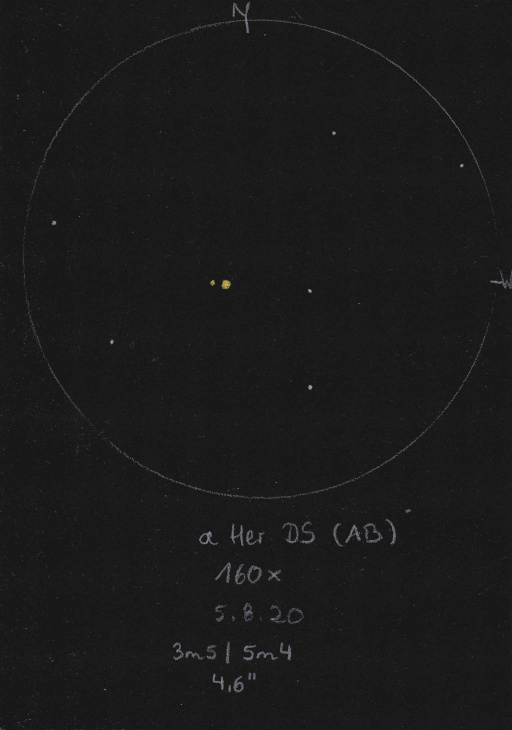
|
Mark McCarthy
Fremont (California/USA) |
152mm (175x) |
Rasalgethi. Wow best ever view, perfect disks with no flaring. Light orange A and 2 delta mag light aqua B. Physical with a 3600-year period |
|
Mark McCarthy
Fremont (California/USA) |
203mm (667x) |
Rasalgethi. 8" inch mask due to seeing. AB orange and blue 4 delta mag. Faint AD seen very wide separation. pretty star. |
|
Christopher Hay
Seeheim (Germany) |
210mm (68x) |
Despite the primary being a little bloated in mediocre seeing, the secondary is set off clearly as a fine pinprick of light. Both are orangish-yellow. A very charming sight. See for comparison simultaneous observation with 36mm at 66x. |
|
Sarah Gebauer
Germany |
254mm (96x) |
bei 96-fach ein sehr enges Pärchen mit einem weiten Lichthof, das hübsch umkreist wird von etwa einem halben Dutzend schwacher Sterne – beide Komponenten leuchten in einem warmen Gold, die Hauptkomponente deutlich heller und stärker |
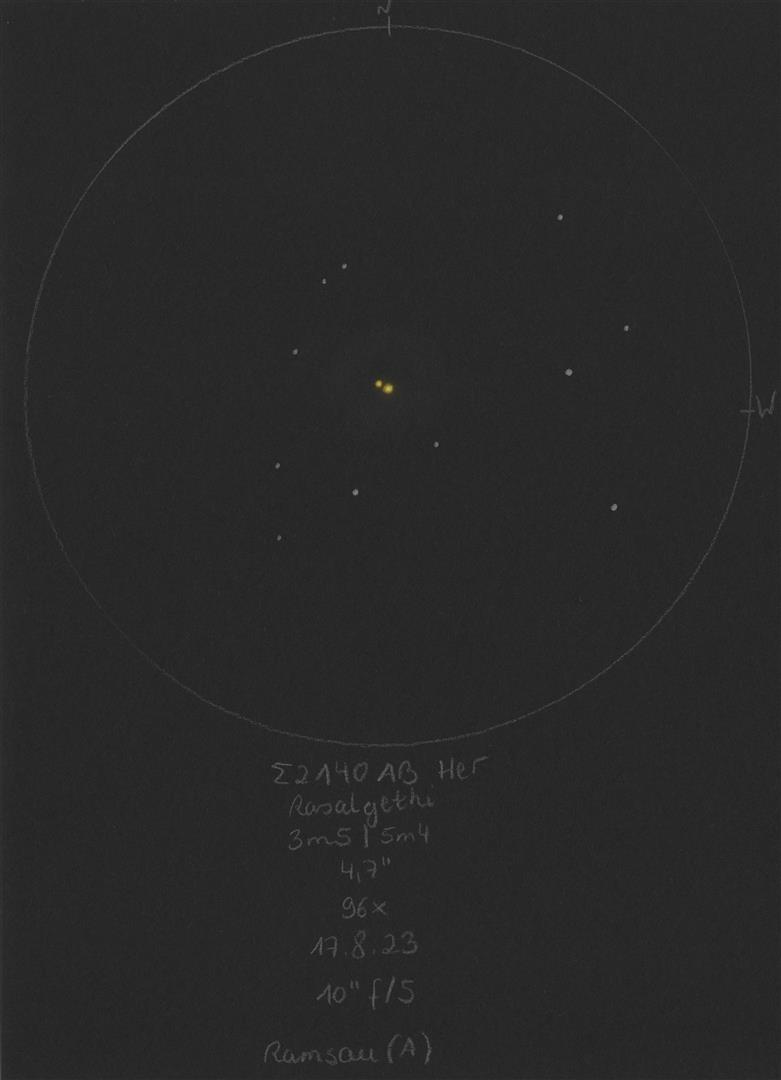
|
Christopher Hay
Seeheim (Germany) |
254mm (170x) |
At this power the components are drawn far enough apart, and there is enough exit pupil with this aperture, to clearly see a charming contrast of two different types of yellow. The primary is distinctly orangish, while the secondary is lemon yellow. The FOV of a little under 0.5° frames the pair well. At lower powers the primary swamps the secondary and both appear similarly orange-yellow. |
|
Frederik Wanink
Itterbeck (Germany) |
254mm (640x) |
gelblich und bläulicher Stern |

|
Mark McCarthy
Fremont (California/USA) |
317mm (277x) |
Rasalgethi, Bright orange A & pale green much fainter B. Very nice! |
|
Karsten Kopp
Köln (Germany) |
600mm (135x) |
Leicht zu trennen. Komponente A erscheint orange, Komponente B gelblich. |
|
Karsten Kopp
Köln (Germany) |
600mm (180x) |
Doppelstern ist gut zu trennen. Komponente A erstrahlt orange und Komponente B gelblich. |

|
|
Frederik Wanink
Itterbeck (Germany) |
254mm |
|
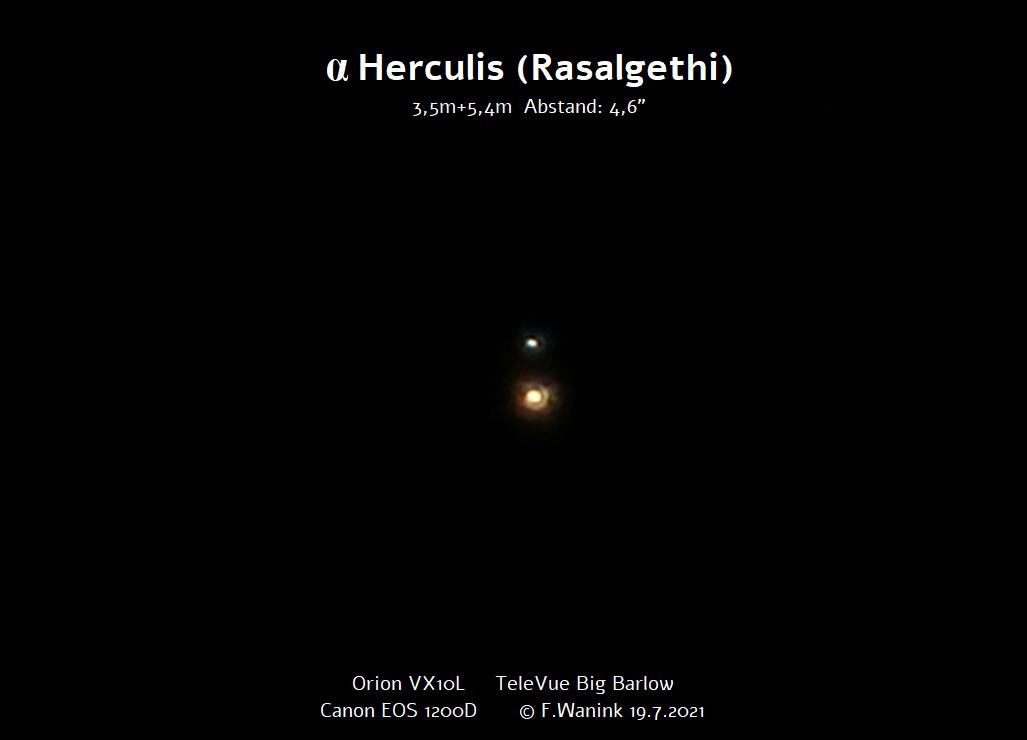
|
Jens Leich
Germany |
130mm |
|

|
|
|
★★
|
STF3127, delta Her, 65 Her |
|
AB |
3m.1 |
8m.3 |
13.8" |
291° |
2020 |
Her |
17h15m01.92s / +24°50'22.50" |
Axel Tute
Küssaberg (Germany) |
70mm (117x) |
16.07.2009: A is bluish. |

|
René Merting
Drachhausen (Germany) |
100mm (64x) |
was für ein schönes ungleiches Paar - bei 64x präsentiert sich Komponente A gleißend hell und weiß, B zeigt sich gut abgesetzt westlich von A - zurück auf 32x habe ich bei der Strahlkraft von A keine Chance mehr, B zu erkennen - sehr schick ab 64x |
|
Stefan Loibl
Rosenheim (Germany) |
102mm (68x) |
Faint component B is not visible at 26x. At 68x B is visible and split. Component A yellowish. |
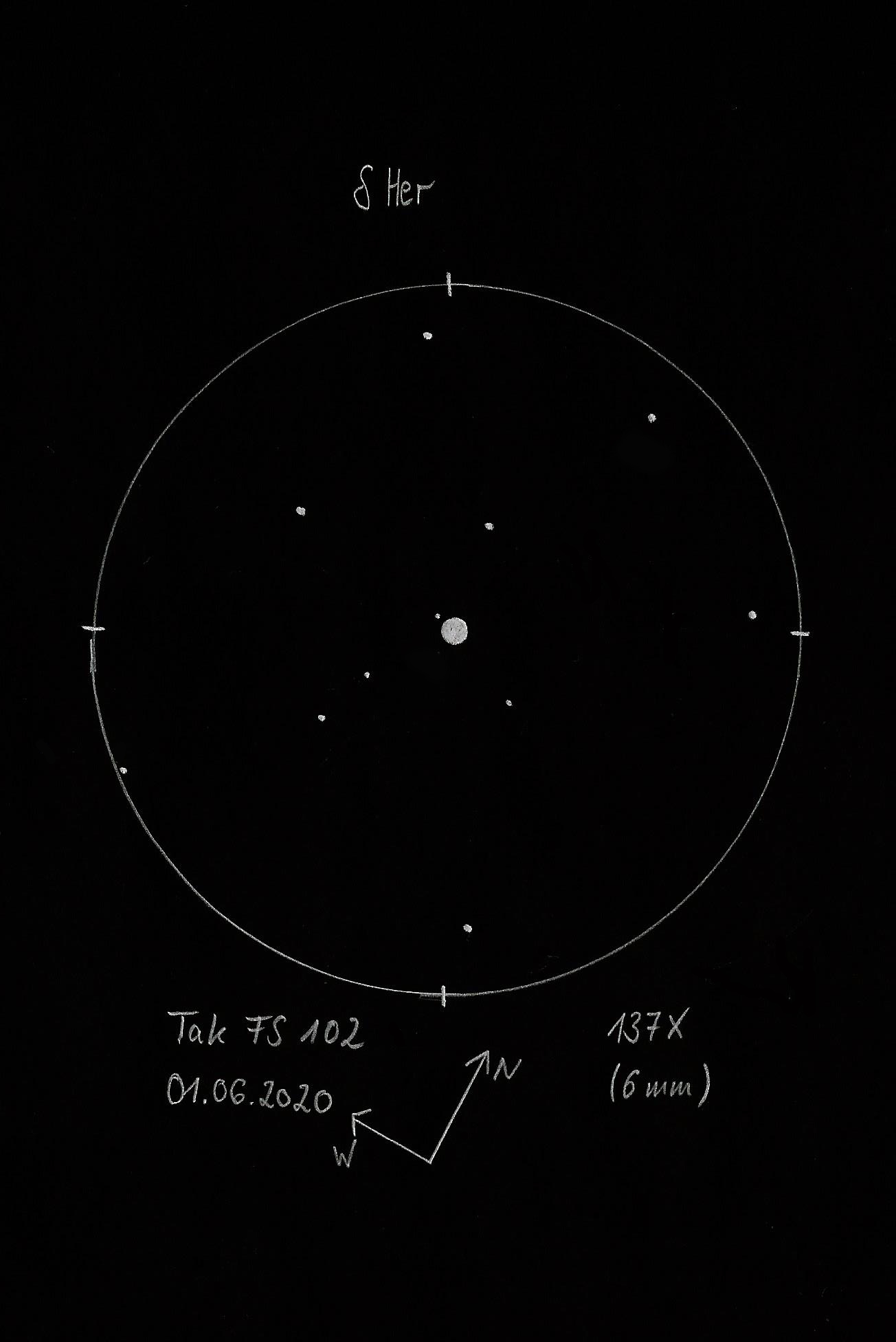
|
Robert Zebahl
Leipzig (Germany) |
102mm (86x) |
Easy. Pretty wide apart with large difference in brightness. |
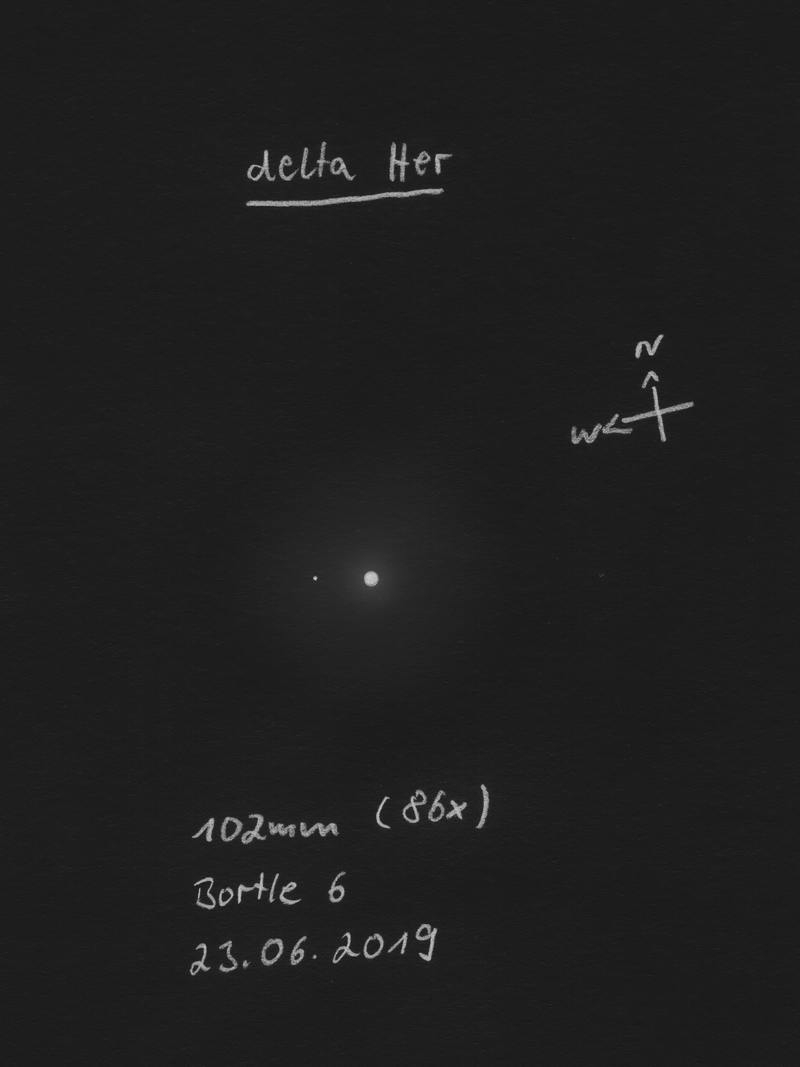
|
Mark McCarthy
Fremont (California/USA) |
203mm (667x) |
Very bright yellow white A and bluish B at least four delta mag, wide separation. I don't think it would be seen but for the mask tightening A's diffraction |
|
Mark McCarthy
Fremont (California/USA) |
317mm (553x) |
Sarin. Very bright and much fainter B, looks like a planet |
|
Karsten Kopp
Köln (Germany) |
600mm (180x) |
Doppelstern gut zu trennen. Der Reiz von diesem Doppelstern liegt im schon extremen Helligkeitsunterschied von über 5 mag. Komponente A erstrahlt weiß und die Komponente B leicht rötlich. |
|
|
|
★★
|
STT328, 68 Her |
|
|
4m.7 |
10m.3 |
4.5" |
56° |
2017 |
Her |
17h17m19.57s / +33°06'00.40" |
René Merting
Drachhausen (Germany) |
100mm (142x) |
erst bei 142x ist B ganz selten als schwacher Begleiter nordöstlich von A zu erkennen - schwierig |
|
Mark McCarthy
Fremont (California/USA) |
203mm (205x) |
68 Her. ! Very nice, white stars. Very bright A, B like a planet, a point of light, well separated from A |
|
Mark McCarthy
Fremont (California/USA) |
317mm (553x) |
Faint but steadily held B, ~8", 4 delta mag. Nice!! |
|
|
|
★
|
BU629 |
|
|
9m.0 |
10m.0 |
1.2" |
340° |
2015 |
Her |
17h17m29.38s / +32°05'11.30" |
Mark McCarthy
Fremont (California/USA) |
203mm (205x) |
! Fine split and with seeing, significant mag difference, ~1". Burnham discovered with Dearborn 18.5-inch @ 0.99" |
|
|
|
★
|
STF2147 |
|
|
7m.1 |
11m.0 |
6.5" |
93° |
2016 |
Her |
17h17m34.65s / +28°54'47.70" |
Mark McCarthy
Fremont (California/USA) |
203mm (205x) |
! V944 Her. Very nice bright light yellow-orange A, B is vey much fainter but can just see directly. Wide ~5", really nice sight |
|
|
|
★★
|
HEI246 |
|
|
11m.0 |
11m.5 |
1.2" |
45° |
2016 |
Her |
17h18m13.17s / +15°58'13.70" |
Mark McCarthy
Fremont (California/USA) |
508mm (667x) |
Wow! very nice just nearly unequal close but well split orange stars. one is obviously fainter than the other but not by much |
|
|
|
★★★
|
BU628 |
|
|
9m.5 |
9m.6 |
0.6" |
262° |
2016 |
Her |
17h18m22.22s / +32°39'38.50" |
|
|
Mark McCarthy
Fremont (California/USA) |
508mm (1067x) |
Wow split clean, amazing. No resolution at 667x but at 1067x two airy disks, sep by half disk, half delta mag. Remarkable |
|
|
|
★★★
|
COU994 |
|
|
9m.4 |
11m.2 |
0.5" |
214° |
2011 |
Her |
17h19m44.04s / +37°02'37.30" |
Mark McCarthy
Fremont (California/USA) |
508mm (1067x) |
At very best moments A presents a perfect disk, and a point resolves within the first faint diffraction ring, very faint and small Amazing. |
|
|
|
★★★
|
A2088 |
|
|
9m.9 |
10m.0 |
0.3" |
8° |
2014 |
Her |
17h20m32.37s / +47°38'51.50" |
Mark McCarthy
Fremont (California/USA) |
508mm (1067x) |
sharp and clean split in best moments, seeing lasts a couple seconds. Otherwise it's touching disks. |
|
|
|
★
|
COU415 |
|
|
8m.8 |
9m.8 |
0.2" |
236° |
2013 |
Her |
17h22m04.55s / +23°09'40.40" |
|
|
Mark McCarthy
Fremont (California/USA) |
508mm (1067x) |
Notched elongation at 533x & 667x. I get an instantaneous split with perfect seeing at 1067x, it stays notched. ~1 delta. 90 year period. |
|
|
|
★
|
STF2161, 75 Her, rho Her |
|
AB |
4m.5 |
5m.4 |
4.0" |
321° |
2021 |
Her |
17h23m40.97s / +37°08'45.30" |
Robert Zebahl
Leipzig (Germany) |
55mm (38x) |
Very nice view. Easily split with visible difference in brightness. Pretty tight. Component A appeared rather white, B slightly yellowish. The double star forms with two other, fainter field stars a conspicuous, acute-angled triangle, whereby the double star marks the tip. |
|
Axel Tute
Küssaberg (Germany) |
70mm (117x) |
01:07.2009: Simple. A light blue. B light green. |
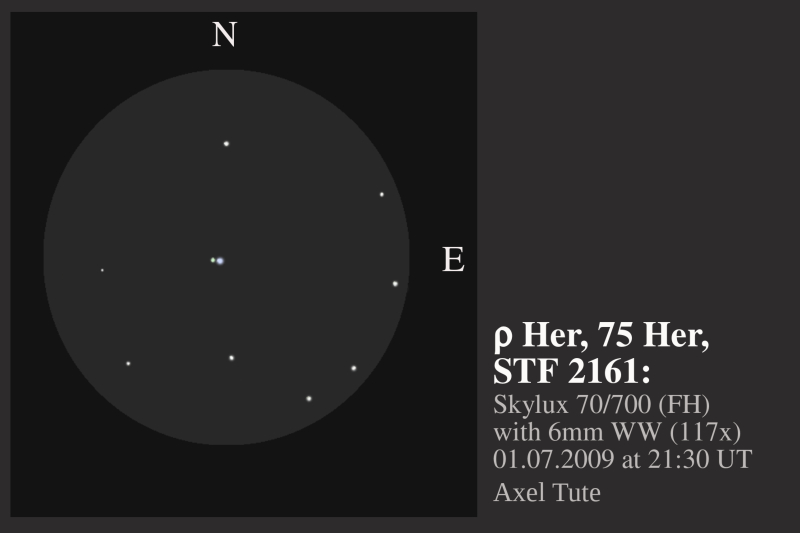
|
Sarah Gebauer
Germany |
100mm (49x) |
bei 50-fach vermutlich das engste bisher getrennte Doppel-Doppel, das ich kenne, zusammen mit STT 329 - der STF-Doppelstern ist der deutlich hellere und engere der beiden und zeigt zudem warmweiße Komponenten mit Gelbhauch mit deutlichem Helligkeitsunterschied |
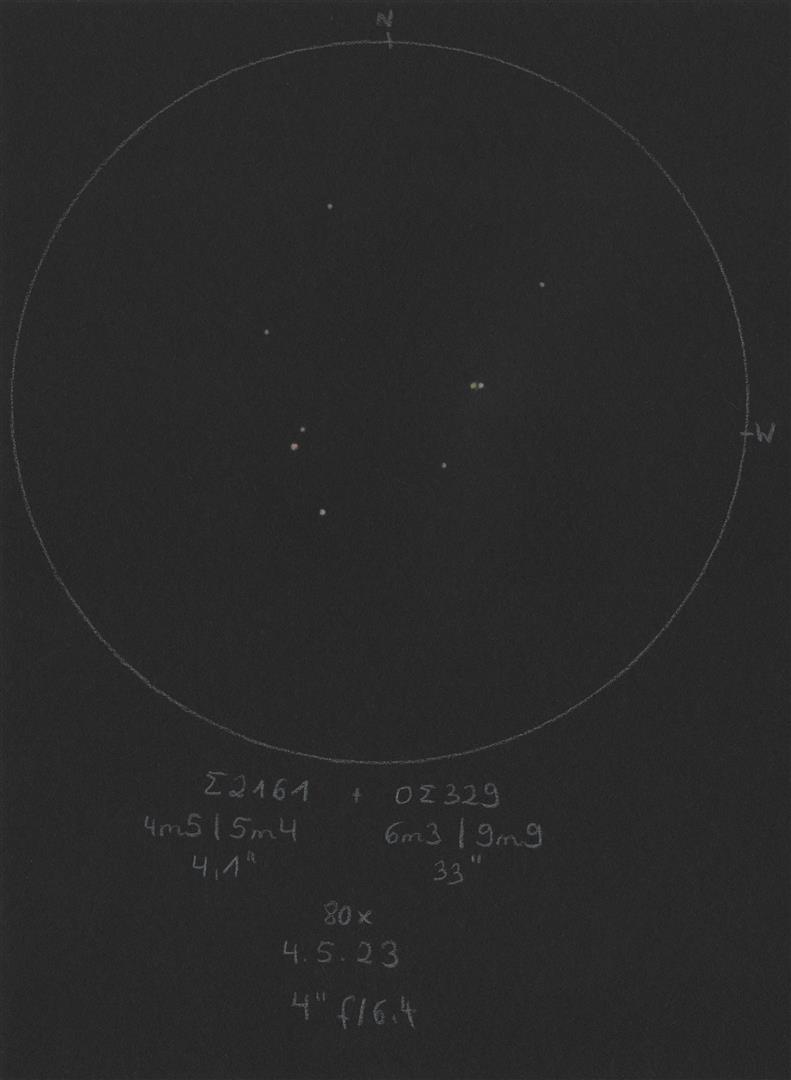
|
René Merting
Drachhausen (Germany) |
100mm (64x) |
bei 107x sind beide Komponenten klar getrennt erkennbar - Komponente B im NW ist eine knappe Größenklasse schwächer - A creme-weiß, B kühler weiß-bläulich - zurück auf 64x kann ich den Doppelstern auch schon ganz knapp getrennt erkennen, da war ich wohl nicht mutig genug, dass ich mit 107x begonnen habe |
|
René Merting
Drachhausen (Germany) |
107mm (86x) |
bei 86x wunderbar anzusehen, etwas mehr als knapp getrennt, B im Westen ist eine knappe Größenklasse schwächer - bei längerem Hinsehen zeigt sich ein dezenter Farbkontrast von der warmweißen A-Komponente mit einem Hauch Hellgelb zu der kühlweißen B-Komponente |
|
Sarah Gebauer
Germany |
150mm (170x) |
der typische Doppelstern für mich, er bildet mit zwei ählich hellen Sternen ein schönes, langes und spitzes Dreieck |

|
Mark McCarthy
Fremont (California/USA) |
152mm (175x) |
Rho Her. Lovely cream-white stars, half delta mag, nice split |
|
Mark McCarthy
Fremont (California/USA) |
203mm (667x) |
Rho Her. Light yellow white stars 1 delta mag well separated. |
|
|
Frederik Wanink
Itterbeck (Germany) |
254mm |
|

|
|
|
★★
|
A2184 & LBU5 |
A2184 |
AB |
7m.3 |
10m.6 |
1.6" |
41° |
2018 |
Her |
17h27m32.79s / +16°27'24.50" |
|
|
|
LBU5 |
AC |
7m.3 |
11m.5 |
49.3" |
259° |
2015 |
|
|
Mark McCarthy
Fremont (California/USA) |
317mm (553x) |
LBU5 (AC): Was trying for A 2184, but it is 2" and 3.26 delta mag, and I did not see. Wide faint pair LBU 5 seen |
|
Mark McCarthy
Fremont (California/USA) |
508mm (667x) |
A2184 (AB): Wow! real nice when seeing stills and with some critical focusing the diffraction of the star tightens and the three delta mag B shows on its own as a sharp point well separated and round. Really great view |
|
|
|
★★
|
STFA35, nu Dra, nu 1/2 Dra, 24/25 Dra |
|
|
4m.9 |
4m.9 |
62.3" |
311° |
2021 |
Dra |
17h32m15.88s / +55°10'22.10" |
Christopher Hay
Seeheim (Germany) |
3x63 |
Hair-fine split.
A physical double at a distance to us of 99 light years. |
|
Christopher Hay
Seeheim (Germany) |
7x45 |
Well split and very compact. A very evenly matched pair, both colourless. Attractive in 8.6° FOV together with the rest of the head of the dragon, namely Beta, Gamma and Xi Dra (Rastaban, Etamin, Grumium). |
|
Christopher Hay
Seeheim (Germany) |
10x42 |
Clearly split, components of identical brightness, no colour. One of the finest doubles for 10x. |
|
René Merting
Drachhausen (Germany) |
16x70 |
der Doppelstern ist bereits mit bloßem Auge zu erkennen, im FG dann offenbart sich ein ordentlich getrenntes Pärchen zweier gleich heller Sterne |
|
René Merting
Drachhausen (Germany) |
18x70 |
zwei sehr helle reinweiße Sterne, komfortabel voneinander getrennt - sehr auffällig |
|
René Merting
Drachhausen (Germany) |
100mm (32x) |
bei 32x ein schönes, auffallendes Pärchen zweier gleich heller Sterne - beide sind komfortabel getrennt erkennbar und präsentieren sich weiß |
|
Sarah Gebauer
Germany |
100mm (50x) |
Nu1 und Nu2 Draconis starrt mich so richtig eindringlich als Augenpaar an, sie stehen in einem ansonsten ganz leeren, schwarzen Umfeld |
|
Robert Zebahl
Leipzig (Germany) |
102mm (28x) |
Wide, bright, equal pair. Both components looked cream-white. Due to the distance a double for binoculars. |
|
René Merting
Drachhausen (Germany) |
107mm (30x) |
die zwei Wölfe im Drachen zeigen sich bei 30x ordentlich getrennt schön strahlend hellgelb und gleich hell, die südliche Komponente strahlt minimal gelber - einfach immer wieder schön im Umfeld anzuschauen |
|
Christopher Hay
Seeheim (Germany) |
125mm (80x) |
Gorgeous sight, widely split, dominating the FOV. The more northern B-component (=Nu1 Dra = 24 Dra) appears brighter and more yellowish than the A-component (=Nu2 Dra = 25 Dra). |
|
Sarah Gebauer
Germany |
150mm (85x) |
auf den ersten Blick "zwei Augen", die mich anleuchten, ansonsten aufgrund der wenigen Feldsterne eher unspektakulär |
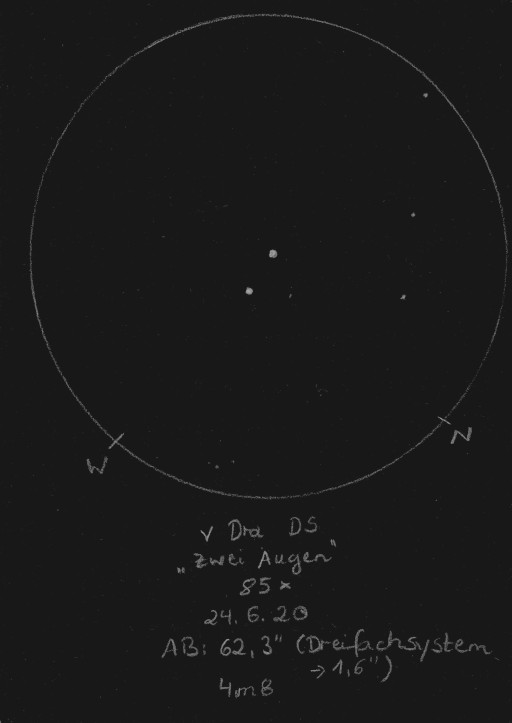
|
René Merting
Drachhausen (Germany) |
320mm (45x) |
bei 45x zwei wunderschöne Diamanten, gleich hell - beide strahlen cremeweiß - sehr auffällig im Umfeld |
|
|
|
★★★
|
COU1594 |
|
|
10m.7 |
10m.6 |
0.5" |
330° |
2014 |
Her |
17h33m59.60s / +44°28'45.60" |
Mark McCarthy
Fremont (California/USA) |
508mm (1067x) |
Needed to wait for seeing but a very extraordinarily fine point resolves with the best seeing, seems much fainter than data but it's definitely there, a hard point. |
|
|
|
★
|
ES1257 |
|
AB |
10m.4 |
10m.9 |
2.7" |
296° |
2021 |
Her |
17h38m13.95s / +45°00'23.30" |
Mark McCarthy
Fremont (California/USA) |
203mm (205x) |
Very cool. First noticed is a wide pair same mag (AC) but there's a close pair to the B star (BC) one of them, near equal ~3" (not physical!) |
|
|
|
★
|
STF2191 |
|
AB |
7m.8 |
8m.5 |
26.4" |
267° |
2018 |
Oph |
17h39m47.28s / -04°58'04.80" |
Uwe Pilz
Leipzig (Germany) |
16x70 |
schwierig aber sehenswert |

|
Mark McCarthy
Fremont (California/USA) |
203mm (667x) |
Wide separation near equal (AB seen. BC is Ho 419 12.71 7.6" not seen) |
|
|
|
★★
|
STF2241, psi 1 Dra, 31 Dra |
|
AB |
4m.6 |
5m.6 |
29.6" |
14° |
2019 |
Dra |
17h41m56.36s / +72°08'55.80" |
Sarah Gebauer
Germany |
12x42 |
sehr hell und schon schön getrennt mit warmweißem Farbeindruck |
|
Christopher Hay
Seeheim (Germany) |
15x45 |
Stabilised binoculars, handheld. Easily split. A appears pearl white, B brick red. A very fine pair for 15x. Resolved in stabilised 10x42 but not so pleasantly. Psi1 Dra is a physical double with a period of roughly 10,000 years. |
|
René Merting
Drachhausen (Germany) |
16x70 |
ein auffälliges Pärchen in einem wilden Sterngewimmel vieler heller Sterne, beide Komponenten sind knapp getrennt zu erkennen - Komponente B ist mindestens eine Größenklasse schwächer und strahlt nicht so schön reinweiß wie A |
|
Christopher Hay
Seeheim (Germany) |
80mm (30x) |
Widely split. A light yellow, B light blue. |
|
Sarah Gebauer
Germany |
100mm (21x) |
bei 20-fach ein schmales, helles und warmweiß-golden strahlendes Pärchen, sehr dominant und schön |

|
Uwe Pilz
Leipzig (Germany) |
105mm (55x) |
weiß-orange |
|
Sarah Gebauer
Germany |
254mm (49x) |
bei 49-fach ein fast gleich helles Paar mit zwei sehr warmen, hell strohgelben Komponenten – ein sehr durchdringendes Augenpaar – die dritte Komponente, die direkt nach Osten weist, ist auch noch ganz schwach zu sehen |
|
René Merting
Drachhausen (Germany) |
320mm (144x) |
die beiden bei 144x gut getrennten Sterne strahlen blass goldgelb mit relativ großen Halos, die sich überlagern, B im Nordosten ist etwa eine halbe bis dreiviertel Größenklasse schwächer als A |

|
René Merting
Drachhausen (Germany) |
320mm (144x) |
die beiden bei 144x gut getrennten Sterne strahlen blass goldgelb mit relativ großen Halos, die sich überlagern, B im Nordosten ist etwa eine halbe bis dreiviertel Größenklasse schwächer als A |
|
|
|
★★★
|
COU1596 |
|
|
9m.3 |
9m.3 |
0.2" |
104° |
2007 |
Her |
17h42m14.40s / +44°22'59.10" |
Mark McCarthy
Fremont (California/USA) |
508mm (1067x) |
Olive to notched at best moments, equal stars |
|
|
|
★★★
|
STF2202, 61 Oph |
|
AB |
6m.1 |
6m.5 |
20.8" |
92° |
2019 |
Oph |
17h44m34.09s / +02°34'45.90" |
René Merting
Drachhausen (Germany) |
8x30 |
die B-Komponente ist östlich von A erkennbar, lässt sich aber noch nicht trennen - eine klassische Ameise |
|
René Merting
Drachhausen (Germany) |
10x35 |
ein richtig schöner Doppelstern für 10-fache Vergrößerung - zwei gleich helle Sterne, knapp getrennt |
|
René Merting
Drachhausen (Germany) |
10x50 |
ein ausgesprochen schönes knapp getrenntes Sternpaar - beide Sterne sind in etwas gleich hell - Komponente B im Osten ist nicht ganz so weiß wie A |
|
René Merting
Drachhausen (Germany) |
15x56 |
wunderschön - ein sauber getrenntes Sternpaar, wobei B im Osten nur minimal schwächer wirkt - beide Sterne zeigen sich strahlend weiß |
|
René Merting
Drachhausen (Germany) |
16x70 |
ein schön eng stehendes Pärchen, knapp getrennt - Komponente A im Westen ist nur leicht heller als B - beide Komponenten wirken weiß |
|
Uwe Pilz
Leipzig (Germany) |
16x70 |
beide gelb |
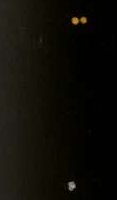
|
René Merting
Drachhausen (Germany) |
100mm (20x) |
bei 20x leicht zu trennen - Komponente B im Osten ist nur minimal schwächer (keine halbe Größenklasse, denke ich) - Komponente A stahlt ein wenig wärmer als B |
|
Sarah Gebauer
Germany |
150mm (30x) |
bei geringer Vergrößerung (30x) schon sauber getrennt, beide Sterne wirken gleich groß und gleich hell, ein nettes Pärchen |
|
Sarah Gebauer
Germany |
150mm (54x) |
zwei nicht ganz enge Glanzpünktchen in einer eher uninteressanten Umgebung |
|
Mark McCarthy
Fremont (California/USA) |
203mm (667x) |
Half delta mag wide separation white. |
|
|
Berthold Fuchs
Wiesbaden (Germany) |
130mm |
easy DS |
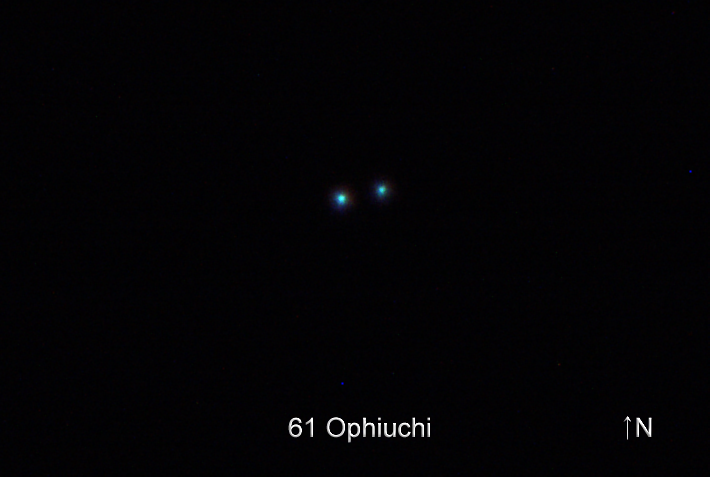
|
|
|
★
|
mu Her, 86 Her |
STF2220 |
A-BC |
3m.5 |
9m.8 |
35.4" |
249° |
2016 |
Her |
17h46m27.51s / +27°43'14.30" |
|
|
|
AC7 |
BC |
10m.2 |
10m.7 |
1.0" |
27° |
2021 |
|
|
|
|
Sarah Gebauer
Germany |
100mm (80x) |
STF2220 (A-BC): bei 80-fach recht weit getrennt, ein extrem ungleich helles Pärchen, A strahlt richtig schön goldgelb, BC steht extrem schwach im Schatten davon |

|
Robert Zebahl
Leipzig (Germany) |
120mm (86x) |
STF2220 (A-BC): Easy, pretty wide, unequal pair. A appeared yellowish-orange, BC was barely visible with direct vision. |
|
Mark McCarthy
Fremont (California/USA) |
203mm (333x) |
STF2220 (A-BC): Pretty, bright canary yellow A and much fainter bluish B. Nice! (Missed AC 7 BC which are near equal 0.6") |
|
Mark McCarthy
Fremont (California/USA) |
317mm (277x) |
STF2220 (A-BC): Bright yellow with diffraction spikes and some haze around it (poor transparency). 4 delta mag small star on the edge of the haze, wide separation. |
|
Mark McCarthy
Fremont (California/USA) |
508mm (533x) |
AC7 (BC): Mu Her. Nice one to star with. STF 2220 A is a very bright light orange, and BC is widely separated blue, much fainter. I suspected B was also a pair at 333x, and could get a nice clean split with seeing at 533x, so I could tell an orientation and make a sketch (43-year period). Indeed it is a short period pair and I should be able to get at least a quarter turn out of it |
|
|
|
★★★
|
HU1288 |
|
|
8m.3 |
9m.4 |
0.4" |
163° |
2016 |
Her |
17h47m09.16s / +15°02'13.80" |
|
|
Mark McCarthy
Fremont (California/USA) |
508mm (1067x) |
Awesome! clean split, very clean star images. Split by half disk, half delta mag. very cool great catch! suspected at 667x, ramped up power to 1067x to split. |
|
|
|
★
|
TDT519 |
|
|
11m.8 |
11m.9 |
1.0" |
221° |
2016 |
Her |
17h48m54.56s / +16°33'10.70" |
Mark McCarthy
Fremont (California/USA) |
508mm (667x) |
Extremely fine pair, brightens and elongated with averted vision but it's better to let the seeing settle down the hazy refraction and can see points of stars. |
|
|
|
★
|
FOX22 |
|
|
10m.7 |
11m.3 |
1.0" |
340° |
2013 |
Her |
17h50m41.55s / +15°16'15.40" |
Mark McCarthy
Fremont (California/USA) |
508mm (667x) |
Half delta mag. actually appears well split, two tiny dots, resolved from haze with seeing. Very cool. |
|
|
|
★
|
TDT536 |
|
|
10m.4 |
10m.8 |
1.1" |
61° |
2016 |
Her |
17h51m18.78s / +17°23'08.70" |
Mark McCarthy
Fremont (California/USA) |
508mm (667x) |
Very fine pair, well split, 1 delta mag, yellow white stars. Very tight but a nice wide clean split. Resolves with seeing. |
|
|
|
★
|
STT338 |
|
AB |
7m.2 |
7m.4 |
0.9" |
168° |
2018 |
Her |
17h51m58.46s / +15°19'34.90" |
|
|
Uwe Pilz
Leipzig (Germany) |
120mm (250x) |
|

|
Frederik Wanink
Itterbeck (Germany) |
254mm (640x) |
getrennt |
|
Mark McCarthy
Fremont (California/USA) |
317mm (553x) |
Just split, a pair of bright near equal orange stars. |
|
Mark McCarthy
Fremont (California/USA) |
508mm (667x) |
Yellow-white very clean split stars seem more equal than what the data says |
|
|
|
★★★
|
S694 |
|
|
6m.7 |
7m.3 |
79.3" |
238° |
2018 |
Oph |
17h52m05.20s / +01°06'40.30" |
René Merting
Drachhausen (Germany) |
15x56 |
ein idealer FG-Doppelstern mit schön anzusehendem Farbkontrast - Komponente A im Osten strahlt reinweiß, hat ordentlich Abstand ist eine halbe Magnitude schwächer und wirkt weißgrau, fraglich wo bei diesen Farben der Farbkontrast herkommen soll, das Pärchen entfaltet trotzdem diese Wirkung |
|
Uwe Pilz
Leipzig (Germany) |
16x70 |
gelbweiß und blau; identisch WDS1752+0107 |
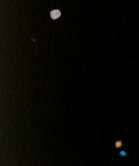
|
|
|
★★
|
BU130, 90 Her |
|
|
5m.3 |
8m.8 |
1.6" |
110° |
2009 |
Her |
17h53m18.03s / +40°00'28.60" |
Robert Zebahl
Leipzig (Germany) |
120mm (300x) |
Not split at 200x and 300x. I used a 120/600mm achromat. |
|
Mark McCarthy
Fremont (California/USA) |
152mm (285x) |
90 Her. Orange star with one part of the airy disk persistently brighter but which does not resolve to a disk. Tried up to 380x. The slightly brighter primary made this more difficult than PRY 2. This was one I wanted to try since Burnham discovered it with his 6-inch. He writes: 90 Her. "…a beautiful pair, even with small aperture. The components have a striking difference in color -- golden and blue….[due to common proper motion] there is little doubt of its being a physical system." WDS uncertain after 49 measures. Unfortunately Gaia lacks the parallax measurements for the B star |
|
Mark McCarthy
Fremont (California/USA) |
317mm (553x) |
90 Her. Need stillness, it coalesces from the diffraction to a light orange point at 553x (grey at 885x). No doubt about it, star, point light. For the first 10 minutes of observing seeing allowed me to glimpse it 1 of every 10 seconds. But after a while seeing was better and I could hold it pretty consistently in both magnifications. At 553x it's in the first ring, at 885x it's in the second. |
|
|
|
★
|
AC9 |
|
|
9m.0 |
9m.2 |
1.0" |
242° |
2015 |
Her |
17h54m08.02s / +29°48'44.60" |
Mark McCarthy
Fremont (California/USA) |
203mm (205x) |
! Wow, very fine near equal split, white stars |
|
|
|
★
|
HU235 |
|
|
6m.9 |
9m.0 |
1.8" |
289° |
2018 |
Her |
17h57m05.08s / +45°51'21.40" |
Mark McCarthy
Fremont (California/USA) |
317mm (553x) |
Very certain point sitting just outside the diffraction ring, brightens and sharpens with seeing. 2" 2-3 delta mag. |
|
|
|
★★
|
HO424 |
|
|
8m.4 |
10m.7 |
1.4" |
204° |
2015 |
Her |
17h57m44.09s / +28°15'12.80" |
Mark McCarthy
Fremont (California/USA) |
203mm (205x) |
! Extraordinarily fine pair. Bright white A and very tight B which lies just outside A's first diffraction ring, ~1.5". Need foveal coaxing to bring out B, which is very much fainter |
|
|
|
★★
|
STF2308 |
40/41 Dra |
AB |
5m.7 |
6m.0 |
18.9" |
232° |
2022 |
Dra |
18h00m09.07s / +80°00'13.70" |
|
|
|
|
AC |
5m.7 |
8m.3 |
225.3" |
129° |
2017 |
|
|
|
|
Robert Zebahl
Leipzig (Germany) |
8x44 |
2020-06-27: The pair AB split, but very tight with components of equal brightness. In acute angle far apart the component C was also visible. |
|
Christopher Hay
Seeheim (Germany) |
15x45 |
AB: Clearly split, brighter component seems bluish. One of the finest doubles for 15x, hence my two-star rating. In 10x42 a difficult split at the limit. |
|
René Merting
Drachhausen (Germany) |
16x70 |
ein schön eng stehendes Pärchen, die Himmelsrichtungen erschließen sich mir hier leider nicht, aber die Komponenten sind beide ähnlich hell und weiß - schöner Anblick im Fernglas |
|
Christopher Hay
Seeheim (Germany) |
50mm (8x) |
AB: An elongated figure-8 very close to splitting |
|
Christopher Hay
Seeheim (Germany) |
80mm (30x) |
AB: Very clearly split, dominates the 2.5° FOV, with interesting sprinkling of fainter stars throughout the field. |
|
Sarah Gebauer
Germany |
100mm (49x) |
AB: bei 50-fach sehr eindeutig getrennt - zwei helle Augenpunkte, die beide warmweiß und leicht gelb strahlen |

|
Robert Zebahl
Leipzig (Germany) |
102mm (28x) |
Very nice, slightly uneven pair. Components appeared yellowish-white. Beautiful surroundings. On the sketch the components A, B and C are visible. |
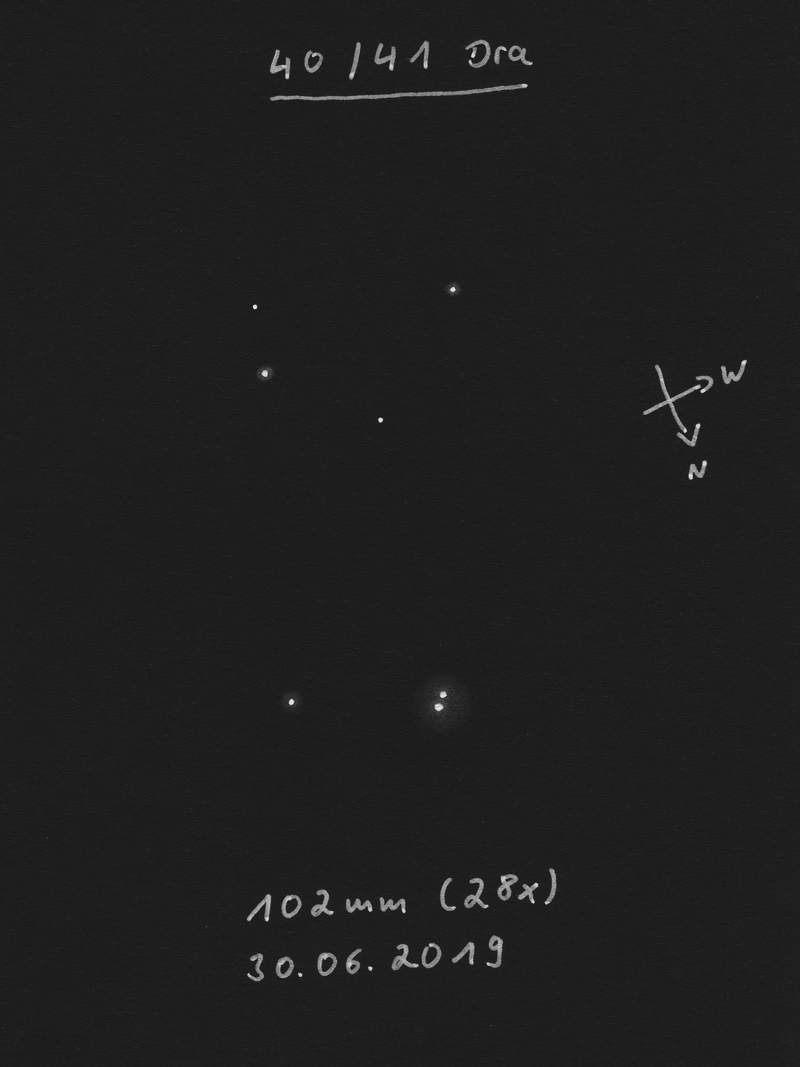
|
Uwe Pilz
Leipzig (Germany) |
105mm (100x) |
AB: =40/41 Dra. Auffallend |
|
Christopher Hay
Seeheim (Germany) |
140mm (75x) |
AB: Wide apart, the pair absolutely dominates the field of view, with attractive sprinkling of fainter stars to the west. Very delicate colour contrast that was hard to grasp in 3-inch scope now becomes clear, component B (40 Dra) is bluish, component A (41 Dra) yellowish. |
|
|
|
★
|
COU809 |
|
|
11m.4 |
11m.6 |
2.1" |
26° |
2016 |
Her |
18h00m30.13s / +17°33'52.70" |
Mark McCarthy
Fremont (California/USA) |
508mm (205x) |
Excellent fine near equal pair, nicely separated, nice contrast with rich field of brighter stars. WDS uncertain of binarity, but Gaia shows there is no overlap in the parallax ranges. The proper motions are similar so these are comoving but not gravitationally bound |
|
|
|
★
|
H6 2, 67 Oph |
|
AC |
4m.0 |
8m.1 |
54.7" |
143° |
2019 |
Oph |
18h00m38.72s / +02°55'53.70" |
René Merting
Drachhausen (Germany) |
10x35 |
zwischen beide Sterne passt maximal ein halbes Blatt Papier - C im Südosten kommt mir entgegen aller früheren Erfahrungen nicht so schwach vor wie sonst, ich würde hier nur auf maximal eine Größenklasse schätzen, eigenartig |
|
René Merting
Drachhausen (Germany) |
10x50 |
ein einfacher Doppelstern - Komponente C steht mit gutem Abstand südöstlich von A - Komponente A ist gleißend weiß, C wirkt dagegen richtiggehend grau-braun |
|
Christopher Hay
Seeheim (Germany) |
15x45 |
Stabilised binoculars, handheld. Components wide apart, almost too wide to appear as a double star. Secondary a fine speck of light beside the primary, which is >4mag brighter. According to Stelledoppie a true physical pair at a distance of 1230 light years. It is interesting to contemplate that at this distance in space the companion still looks so separate. “H“ in the catalogue name means that this double star is listed in the catalogue of W. Herschel. The 6 in the name means that it is a double star of the 6th Class [separation 1’ or larger] in Herschel’s system. |
|
René Merting
Drachhausen (Germany) |
16x70 |
auf den ersten Blick bin ich enttäuscht, weil ich nur einen hell strahlenden Stern erkennen kann - dann aber mit etwas Konzentration ist südöstlich von der Leuchtgranate ein ganz schwacher Begleiter zu erkennen - ein sehr ungleiches Paar mit geschätzt 4 Größenklassen Unterschied - Komponente C wirkt rotbraun und steht ordentlich getrennt von A |
|
Uwe Pilz
Leipzig (Germany) |
16x70 |
der helle ist gelb-weiß |

|
Christopher Hay
Seeheim (Germany) |
25x80 |
Very far apart, almost so far as to appear to not belong together. However, in the 3° field of view 70 Ophiuchi, which is also a physical double, is seen to be also split. Thus a very attractive field overall.
67 Oph and 70 Oph are the left and right nostrils of the bull in the old constellation Taurus Poniatowski (Poniatowski’s Bull). 68 Oph (the tip of the bull’s nose) and 73 Oph (the bull’s right eye) are also double stars, but can’t be split at 25x. All four doubles – 67, 68, 70 and 73 Oph – are physical, a rare assemblage! |
|
René Merting
Drachhausen (Germany) |
100mm (20x) |
bei 20x großer Abstand zwischen beiden Sternen - weil Komponente A so gleißend hell strahlt, fehlt der mindestens um 3 Größenklassen schwächeren Komponente C im SO die Farbe, eher gräulich |
|
Sarah Gebauer
Germany |
254mm (49x) |
zentral inmitten von Taurus Poniatowski/Melotte 186 liegt dieser schöne Doppelstern mit einer hellen, sehr warmweißen Komponente und weit abgesetzt bei 49-fach einem deutlich schwächeren Begleiter |
|
|
|
★
|
STF2264, 95 Her |
|
|
4m.8 |
5m.2 |
6.4" |
255° |
2020 |
Her |
18h01m30.41s / +21°35'44.80" |
Axel Tute
Küssaberg (Germany) |
70mm (117x) |
16.07.2009: Both light yellow. |

|
René Merting
Drachhausen (Germany) |
100mm (32x) |
bei 32x mein erster Eindruck ist, dass zwei annähernd gleichhelle sehr eng stehende Sterne mich wie zwei Augen anschauen, das unmittelbare Sternumfeld passt schön und verleiht dem Doppel eine hervorgehobene Stellung - Komponente B im Westen ist nur minimal schwächer als A - in guten Momenten ist die Trennung sehr eindeutig erkennbar |
|
René Merting
Drachhausen (Germany) |
100mm (64x) |
bei 64x zwei helle, knapp getrennte Sterne - die schwächere westliche Komponente zeigt ein schönes, helles Gelb und wirkt dadurch leicht schwächer - zurück auf 32x ist eine 8 mit deutlicher Einschnürung erkennbar - der Farbunterschied ist ebenfalls deutlich |
|
Sarah Gebauer
Germany |
100mm (80x) |
24.09.23: bei 49x ein enger, getrennter DS, bestehend aus zwei sehr hellen, dominanten Murmelchen, die buttergelb strahlen - bei 80x wird der Anblick schöner, der Farbton intensiviert sich ins Dunklere, die beiden ganz engen Lichtpünktchen sind das Highlight im Gesichtsfeld, das Umfeld hält sich sehr zurück - durch den geringen Abstand der Komponenten etwas Besonderes |
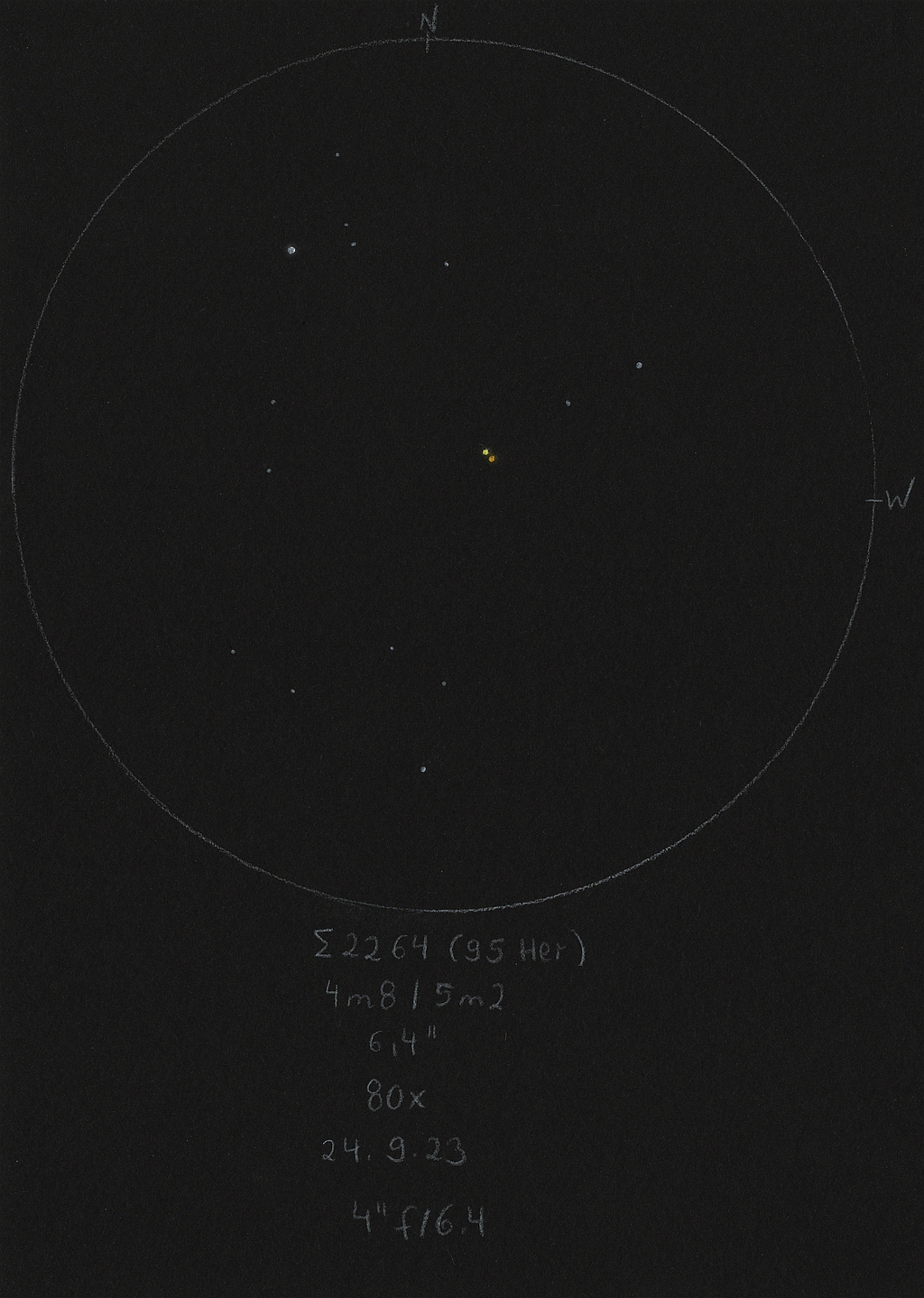
|
Uwe Pilz
Leipzig (Germany) |
105mm (288x) |
|
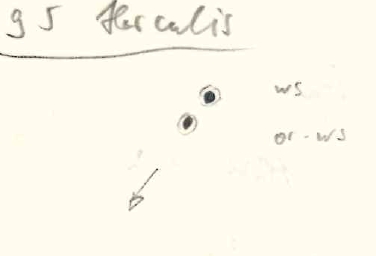
|
Karsten Kopp
Köln (Germany) |
140mm (94x) |
Konnte erst mit 94-facher Vergrößerung gut getrennt wahrgenommen werden. |
|
Sarah Gebauer
Germany |
150mm (54x) |
zwei enge, hübsche Glanzpünktchen, die ich zuvor ziemlich lange in dem hellen Sterntrapez gesucht habe |
|
Robert Zebahl
Leipzig (Germany) |
152mm (49x) |
2020-06-23: At 49x eye catching double star, relatively tight with rather small difference in brightness. Beautiful color impression, which was even better visible at 69x: yellowish and yellowish-orange. |
|
Mark McCarthy
Fremont (California/USA) |
508mm (667x) |
95 Her. Orange and blue, wide, bright. |
|
Karsten Kopp
Köln (Germany) |
600mm (135x) |
Sehr einfaches und auffälliges Objekt. Kein Helligkeitsunterschied erkennbar. |
|
|
Berthold Fuchs
Wiesbaden (Germany) |
130mm |
close DS |
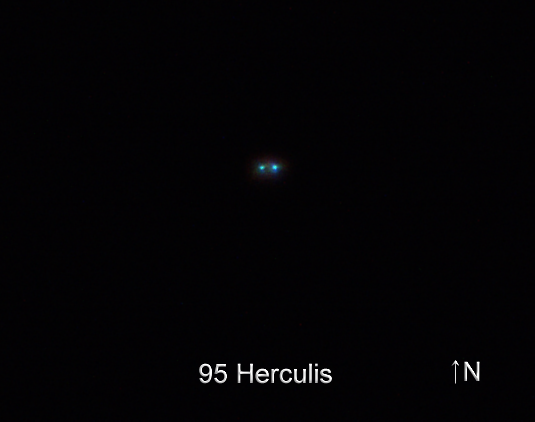
|
Frederik Wanink
Itterbeck (Germany) |
254mm |
|

|
|
|
★
|
BU1127 |
|
AB |
7m.3 |
9m.2 |
0.7" |
39° |
2018 |
Her |
18h02m30.89s / +44°14'02.60" |
Mark McCarthy
Fremont (California/USA) |
152mm (175x) |
Notched elongation at all powers |
|
Mark McCarthy
Fremont (California/USA) |
317mm (553x) |
Very tough but a small point of a star resolved at the rim of the diffraction ring at both 553x & 885x, using kind of a partial averted vision. |
|
|
|
★
|
AC15, 99 Her |
|
AB |
5m.1 |
9m.0 |
1.4" |
331° |
2018 |
Her |
18h07m01.61s / +30°33'42.70" |
|
|
Mark McCarthy
Fremont (California/USA) |
203mm (667x) |
99 Her.Very nice. B star resolves just outside first diffraction ring when that ring has faded with good seeing, a very fine faint point. large delta mag. There are many other pairings in this system, including 0.2" for the A star] |
|
|
|
★
|
STF2280, 100 Her |
|
AB |
5m.8 |
5m.8 |
14.3" |
182° |
2019 |
Her |
18h07m49.56s / +26°06'04.40" |
René Merting
Drachhausen (Germany) |
10x35 |
ein 8, eine Einschnürung ist ab und an erkennbar - Trennung nicht möglich |
|
René Merting
Drachhausen (Germany) |
10x50 |
zwei extrem dicht stehende helle Sterne - noch nicht getrennt, aber schön als 8 erkennbar |
|
Robert Zebahl
Leipzig (Germany) |
16x70 |
2020-07-05: Very nice, rather isolated double star. Striking. Similar bright component, both white. |
|
René Merting
Drachhausen (Germany) |
18x70 |
perfekt für 18-fache Vergrößerung - zwei gleich helle, dicht zusammen stehende Sterne - reinweiß und sehr auffällig, weil keine ähnlich hellen Sterne im Umfeld zu sehen sind |
|
Axel Tute
Küssaberg (Germany) |
70mm (117x) |
16.07.2009: Both light yellow. |

|
René Merting
Drachhausen (Germany) |
100mm (32x) |
bei 32x ein schönes, enges Pärchen zweier gleichheller Sterne - beide gleich hell und reinweiß - zurück auf 20x zeigen sich beide Protagonisten weiterhin ganz knapp getrennt - Komponente B im Süden wirkt leicht gelblich und schwächer |
|
Uwe Pilz
Leipzig (Germany) |
105mm (26x) |
Weiß-orangeweiß |
|
Robert Zebahl
Leipzig (Germany) |
120mm (40x) |
Conditions in the target region: SQM-L 20.5
Very nice, evident double star with equally bright components. |
|
Karsten Kopp
Köln (Germany) |
140mm (94x) |
Doppelstern ist einfach zu trennen. Das besondere ist hier, dass die beiden Sterne recht alleine zu stehen scheinen. Beide erscheinen weiß. |
|
Sarah Gebauer
Germany |
150mm (54x) |
zwei hübsche Glanzpünktchen, die mich an ein Knöpflein mit zwei Löchern erinnern, der "typische" DS für mich: nicht zu eng, nicht zu weit, gleich hell, sehr nett |
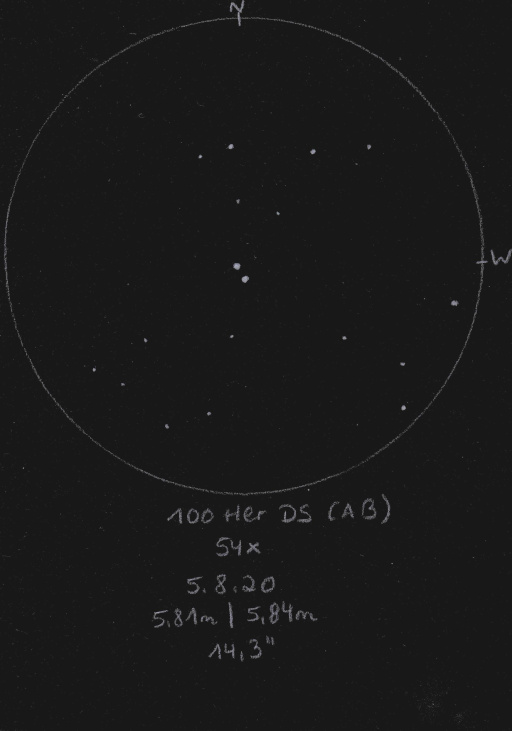
|
Robert Zebahl
Leipzig (Germany) |
152mm (22x) |
Beautiful view. Easy to separate with components of the same brightness. It is noticeable that there are no brighter stars in the immediate vicinity, so that the double star stands out very well. |
|
Mark McCarthy
Fremont (California/USA) |
203mm (205x) |
100 Her. Bright equal wide yellow-white stars. [not physical] |
|
|
Berthold Fuchs
Wiesbaden (Germany) |
130mm |
easy DS |
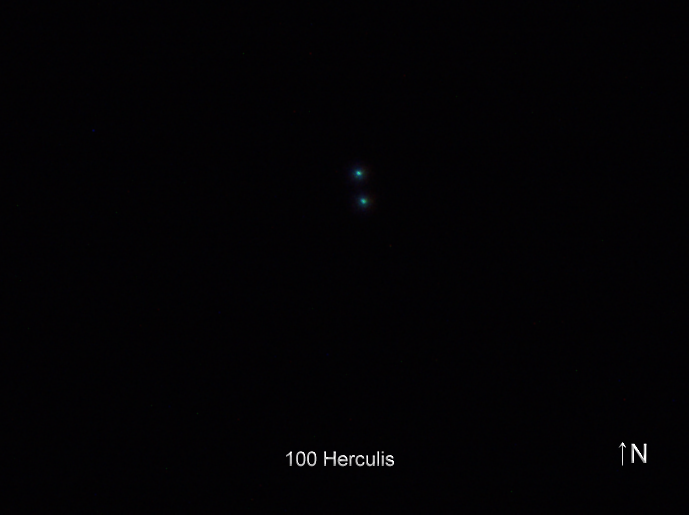
|
|
|
★★
|
HU674 |
|
|
7m.7 |
8m.6 |
0.7" |
213° |
2018 |
Her |
18h09m40.64s / +50°24'07.40" |
|
|
Frederik Wanink
Itterbeck (Germany) |
254mm (640x) |
getrennt, ähnlich hell |
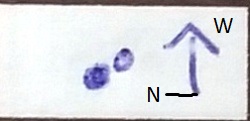
|
Mark McCarthy
Fremont (California/USA) |
508mm (333x) |
Split with seeing at 333x, near equal white. |
|
|
|
★
|
A238 |
|
|
8m.6 |
9m.6 |
0.6" |
72° |
2016 |
Her |
18h11m20.99s / +25°19'18.60" |
Mark McCarthy
Fremont (California/USA) |
508mm (667x) |
Extraordinary pair. With critical focus it pops into view with clear airy disks, nicely split light yellow orange A and blue B. Seeing is steady for around 7 seconds before fuzzing out for longer stretches. WDS uncertain, and Gaia lacks data for the secondary. |
|
|
|
★
|
BU1274 |
|
BC |
9m.8 |
10m.6 |
1.0" |
144° |
2017 |
Dra |
18h14m31.41s / +56°34'26.90" |
Mark McCarthy
Fremont (California/USA) |
508mm (333x) |
Super challenging. A-BC is bright white A and BC is blue widely separated. Near to BC is BD, which is near equal to BC and ~6". BC is faint and split with seeing, hairline, significant mag difference |
|
|
|
★
|
ES1651, TZ Lyr |
|
|
11m.2 |
12m.4 |
2.5" |
5° |
2021 |
Lyr |
18h15m49.67s / +41°06'37.80" |
Mark McCarthy
Fremont (California/USA) |
317mm (553x) |
Challenging! Faint elongated star with direct vision. With averted vision it flashes a split, half delta mag, just split. |
|
|
|
★★★
|
BU641 |
|
|
7m.0 |
8m.7 |
0.8" |
341° |
2015 |
Her |
18h21m48.44s / +21°30'27.90" |
Frederik Wanink
Itterbeck (Germany) |
254mm (640x) |
sehr schwierig |
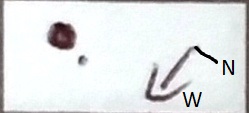
|
Mark McCarthy
Fremont (California/USA) |
317mm (553x) |
Extraordinary! Moderately bright A and very much fainter B, 4-5 delta mag, <1" separation. Seeing needs to still. |
|
Mark McCarthy
Fremont (California/USA) |
508mm (533x) |
V989 Her. Seen as a snowman dot to bright white A @ 333x, split with 533x, inside first diffraction ring. Need A's disk to be perfectly tight for B to resolve with seeing. Very nice. 1" at discovery 1878 with Dearborn 18.5-inch |
|
|
|
★
|
HU581 |
|
|
8m.8 |
9m.4 |
0.4" |
122° |
2016 |
Her |
18h22m54.84s / +14°58'11.00" |
|
|
Mark McCarthy
Fremont (California/USA) |
508mm (1067x) |
Snowman at 533x & 667x, clean split at 1067x & apodising mask, one delta mag. Amazing. Coalesces into two points, can easily tell orientation & magnitude difference for sketch. At apastron, it is on a nearly edge on orientation, will close rapidly within the next ten years to be too close for me to detect. |
|
|
|
★
|
STF2323, 39 Dra |
|
AB |
5m.1 |
8m.1 |
3.6" |
348° |
2020 |
Dra |
18h23m54.65s / +58°48'02.10" |
|
|
|
|
AC |
5m.1 |
8m.0 |
88.9" |
20° |
2020 |
|
|
|
|
Robert Zebahl
Leipzig (Germany) |
55mm (27x) |
AC: Pretty wide, unequal pair. Die brighter A component appeared white. |
|
Robert Zebahl
Leipzig (Germany) |
55mm (71x) |
AB: Very nice. The B component seemed to be comparable faint as the C component. |
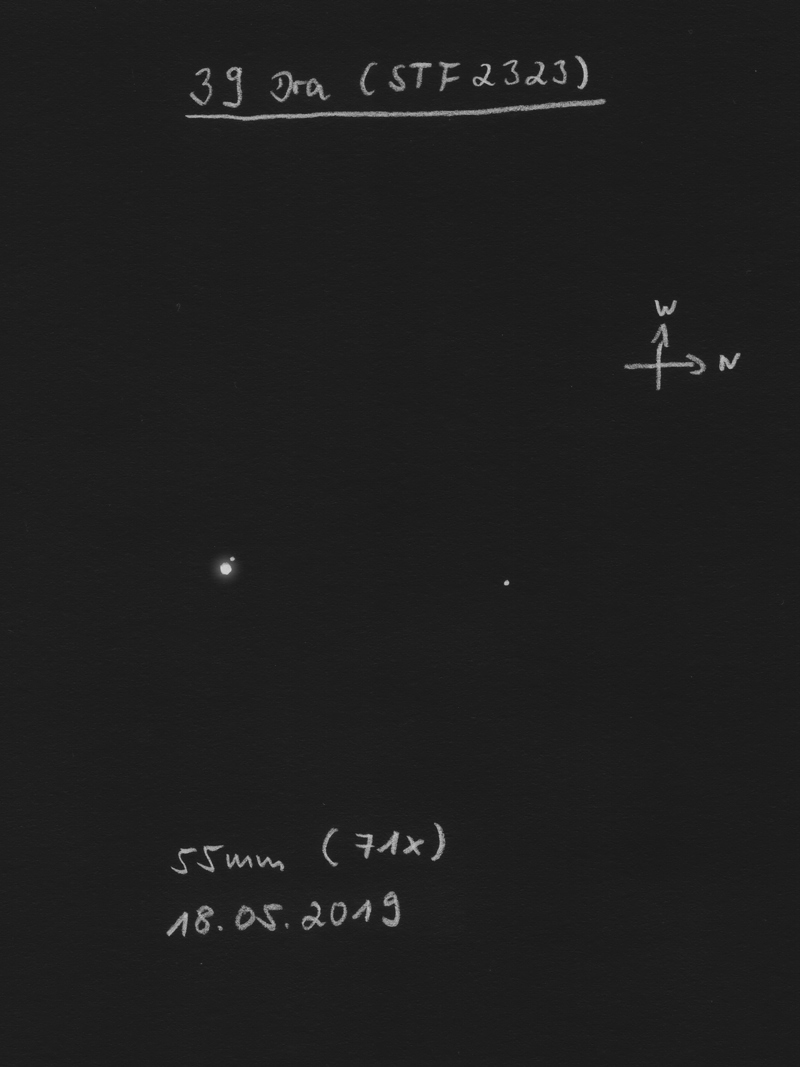
|
Mark McCarthy
Fremont (California/USA) |
203mm (205x) |
AB: 39 Dra. Brilliant white A and slightly ruddy B, ~3 delta mag, ~4" sep. 3962.5 year period. |
|
René Merting
Drachhausen (Germany) |
320mm (144x) |
bei 144x ein richtig schöner Mehrfachstern - an der strahlend weißen A-Komponente klebt eine kleine Murmel (B), die ab und an auch schon getrennt zu erkennen ist - B ist auch noch relativ hell und weiß strahlend - Komponente C steht nördlich von den beiden in weitem Abstand - Helligkeit zwischen A und B |
|
|
|
★
|
STF2315 |
|
AB |
6m.6 |
7m.8 |
0.6" |
117° |
2018 |
Her |
18h24m58.46s / +27°23'41.30" |
|
|
Frederik Wanink
Itterbeck (Germany) |
254mm (640x) |
als 8 zu sehen |

|
Mark McCarthy
Fremont (California/USA) |
317mm (277x) |
! Hairline split @ 553x near equal mag. Suspected elongation at 277x.: |
|
Mark McCarthy
Fremont (California/USA) |
508mm (533x) |
Barely split with seeing, resolves to two disks, more than hairline but almost 2 delta mag, very tough, need perfect seeing. 2094 year period |
|
|
|
★
|
STT352 |
|
|
7m.9 |
9m.4 |
24.2" |
221° |
2019 |
Lyr |
18h26m24.42s / +46°48'32.20" |
René Merting
Drachhausen (Germany) |
100mm (32x) |
bei 32x ist B schön abgesetzt südwestlich von A erkennbar - Helligkeitsunterschied 1.5 mag - bei 64x zeigt sich A reinweiß, B ist grau |
|
Sarah Gebauer
Germany |
100mm (50x) |
zusammen mit BU134 im Bild; ein sehr schwaches Paar, schmal, die schwächere Komponente muss ich beinahe konzentriert suchen |
|
Mark McCarthy
Fremont (California/USA) |
152mm (175x) |
Wide one delta mag |
|
René Merting
Drachhausen (Germany) |
320mm (45x) |
bei 45x einfach zu trennen, B im Südwesten ist gut 1.5 Magnituden schwächer und wirkt dadurch nicht so strahlend Weiß wie A |
|
|
|
★
|
BU1326 |
|
AB |
6m.5 |
12m.1 |
5.5" |
107° |
2015 |
Her |
18h26m40.93s / +26°26'57.20" |
|
|
|
|
AC |
6m.5 |
9m.6 |
61.8" |
60° |
2015 |
|
|
Mark McCarthy
Fremont (California/USA) |
152mm (175x) |
AB: Very extremely fine B is split with seeing and with averted vision only, blue to A's white. Very, very fine! |
|
Mark McCarthy
Fremont (California/USA) |
317mm (553x) |
AB: B star is extremely faint 5" |
|
Mark McCarthy
Fremont (California/USA) |
317mm (553x) |
AC: C star is extremely faint and much further out, ~50" |
|
Mark McCarthy
Fremont (California/USA) |
508mm (333x) |
AB: Extremely faint star ~4" distant from the A, 5 delta mag. |
|
|
|
★
|
TDT886 |
|
|
11m.0 |
11m.3 |
0.5" |
24° |
1991 |
Her |
18h27m27.80s / +24°17'10.40" |
Mark McCarthy
Fremont (California/USA) |
508mm (667x) |
Extremely fine. At first it seems not split, but in best moments B stretches out and pops out from B, 0.5" and 1 delta mag. |
|
|
|
★
|
STF2320 |
|
|
7m.1 |
8m.9 |
0.9" |
1° |
2015 |
Her |
18h27m45.89s / +24°41'50.80" |
Mark McCarthy
Fremont (California/USA) |
203mm (667x) |
V994 Her. Seen with the 20", but used the 8" mask to clean up the images. Two delta mag, ~1" very nice pair. [eclipsing binary of Algol type--surely not seeing the eclipsing star? In fact, both A & B each are eclipsing binaries, the first such system to be discovered in the whole sky!] |
|
Frederik Wanink
Itterbeck (Germany) |
254mm (640x) |
|
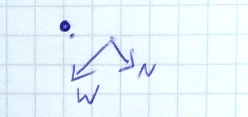
|
Mark McCarthy
Fremont (California/USA) |
317mm (553x) |
Nice! Blue-white stars, 1", 2 delta mag. |
|
|
Frederik Wanink
Itterbeck (Germany) |
254mm |
|

|
|
|
★★
|
STT359 |
|
|
6m.3 |
6m.6 |
0.8" |
5° |
2021 |
Her |
18h35m30.40s / +23°36'19.90" |
|
|
Robert Zebahl
Leipzig (Germany) |
102mm (160x) |
2020-11-10: Clearly elongated with slight notching and little difference in brightness. I estimated the position angle to 0°. |
|
Uwe Pilz
Leipzig (Germany) |
105mm (198x) |
leicht eingekerbt, Abstand 0“75 |
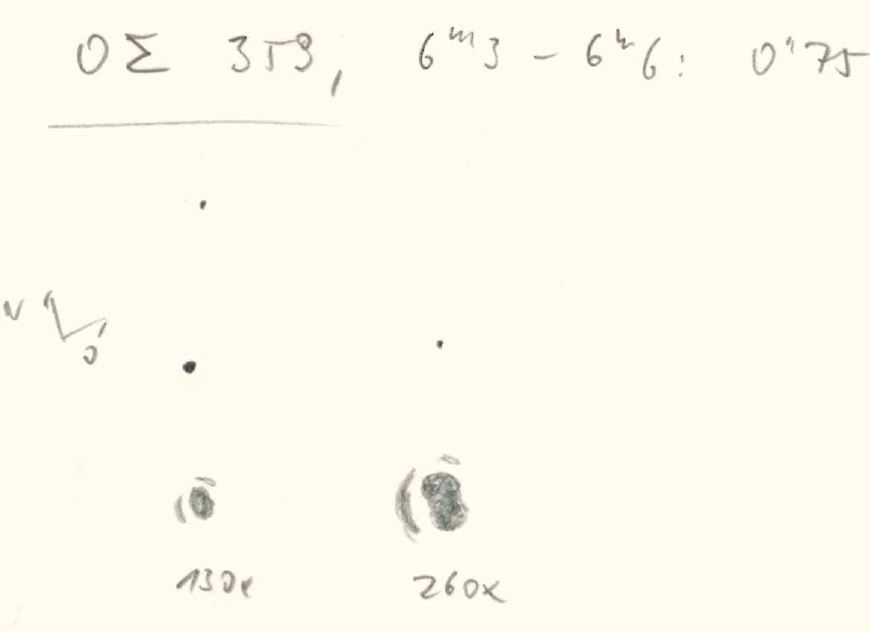
|
Uwe Pilz
Leipzig (Germany) |
120mm (250x) |
|
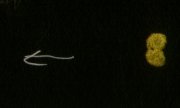
|
Mark McCarthy
Fremont (California/USA) |
152mm (175x) |
Light orange near equal stars, notched elongation, overlapping disks. Physical with a 219-year period, at apastron now |
|
Mark McCarthy
Fremont (California/USA) |
203mm (667x) |
Kissing 8" 333x, hairline split 667x. Near equal white A and bluish white B. |
|
Frederik Wanink
Itterbeck (Germany) |
254mm (640x) |
getrennt |

|
Mark McCarthy
Fremont (California/USA) |
317mm (553x) |
Nice! ~0.8" equal yellow-orange stars. |
|
Uwe Pilz
Leipzig (Germany) |
320mm (388x) |
ein sehr ruhiger Abend gestattete die Nutzung von 12 Zoll |
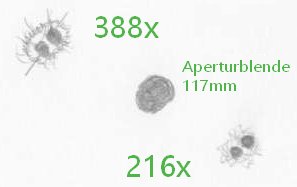
|
Mark McCarthy
Fremont (California/USA) |
508mm (333x) |
Light yellow near equal split, very close. 219 year period |
|
|
Frederik Wanink
Itterbeck (Germany) |
254mm |
|

|
|
|
★★
|
STT358 |
|
AB |
6m.9 |
7m.1 |
1.7" |
146° |
2019 |
Her |
18h35m53.22s / +16°58'32.50" |
|
|
Uwe Pilz
Leipzig (Germany) |
105mm (110x) |
fast gleich hell, deutlich trennbar |
|
Mark McCarthy
Fremont (California/USA) |
203mm (333x) |
Pretty, near equal white, perfect disks. |
|
Mark McCarthy
Fremont (California/USA) |
508mm (205x) |
Yellow-white stars, half delta mag, well split. 380 year period |
|
|
|
★
|
STF2351 |
|
|
7m.6 |
7m.6 |
5.0" |
160° |
2020 |
Lyr |
18h36m12.00s / +41°16'41.20" |
Robert Zebahl
Leipzig (Germany) |
70mm (67x) |
2021-08-15: Beautifully separated with similar bright components. Mild but beautiful color contrast: light yellow/orange & light blue. |
|
René Merting
Drachhausen (Germany) |
100mm (64x) |
bei 32x sind zwei Sterne zu erkennen, die sich noch berühren - bei 64x zeigt sich dann nein knapp getrenntes Pärchen - fast kein Helligkeitsunterschied, ich habe Komponente A für die schwächere der beiden in etwas gleich hellen Sterne gehalten - Komponente B ist warm-weiß |
|
Sarah Gebauer
Germany |
100mm (80x) |
ein superkleines, superschwaches, superenges Augenpärchen, ganz dich beeinander und dennoch getrennt, gleich hell |
|
Mark McCarthy
Fremont (California/USA) |
178mm (205x) |
White, <1 delta mag, wide. WDS uncertain; there is a -15% parallax overlap, so not physical |
|
Mark McCarthy
Fremont (California/USA) |
317mm (553x) |
Bright yellow-orange equal pair, wide. |
|
René Merting
Drachhausen (Germany) |
320mm (45x) |
bei 45x ist ein äußerst knapp getrenntes Paar zweier gleich heller Perlchen zu erkennen - bei 72x stehen beide immernoch dicht zusammen, die südliche Komponente wirkt nun minimal schwächer |
|
|
|
★★
|
alpha Lyr, 3 Lyr, Vega |
H5 39 |
AB |
0m.1 |
9m.5 |
84.5" |
185° |
2021 |
Lyr |
18h36m56.33s / +38°47'01.20" |
|
|
|
STFB9 |
AC |
0m.1 |
11m.0 |
76.0" |
255° |
2012 |
|
|
|
|
|
STFB9 |
AE |
0m.1 |
9m.5 |
84.3" |
40° |
2021 |
|
|
Jörg S. Schlimmer
Germany |
127mm (203x) |
um Vega mehrere Beugungsringe sowie Speckles sichtbar, B leicht zu sehen, E nicht sichtbar |
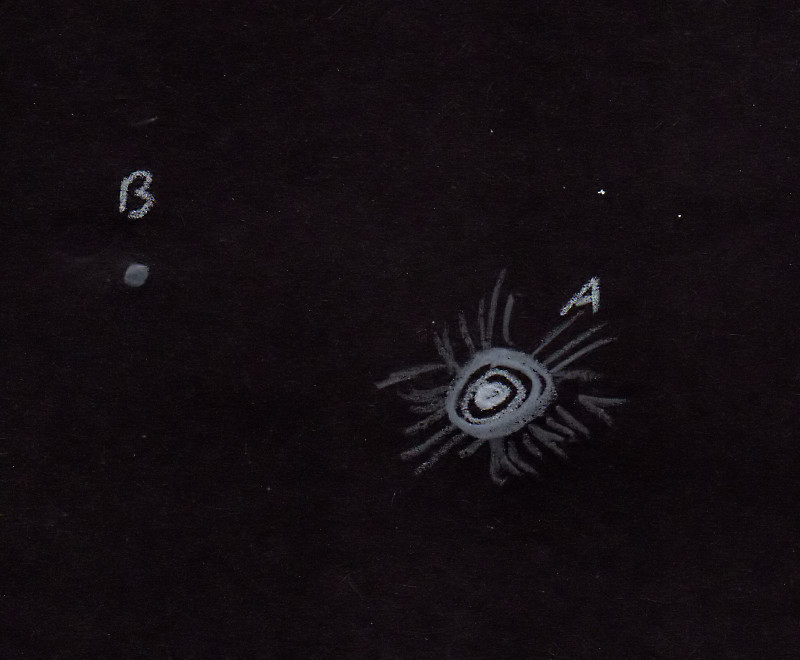
|
Jörg S. Schlimmer
Germany |
127mm (203x) |
verschiedene Vergrößerungen zwischen 40 und 203 fach, Komponente E zeitweise bei indirektem Sehen sichtbar, da Himmel heute klarer ist |

|
René Merting
Drachhausen (Germany) |
320mm (45x) |
AB (H 5 39): bei 45x zeigt sich Komponente B weit abgesetzt südlich vom gleißend hellen Stern Vega
AE (STFB 9): bei 45x ist auf der gegenüberliegenden Seite in gleicher Entfernung ein genauso schwacher Stern wie B zu erkennen |
|
|
|
★★
|
STF2356 |
|
|
8m.8 |
9m.2 |
1.0" |
63° |
2015 |
Lyr |
18h38m22.51s / +28°41'49.70" |
Mark McCarthy
Fremont (California/USA) |
178mm (205x) |
Exquisite! Just split, 1 delta mag so it looks like a split snowman, light orange stars. Very nice. WDS uncertain. Sadly there is no parallax overlap, -33%, so these are not gravitationally bound |
|
|
|
★★
|
STF2358 |
|
CD |
9m.8 |
10m.2 |
2.5" |
224° |
2016 |
Lyr |
18h38m35.04s / +30°43'20.10" |
Mark McCarthy
Fremont (California/USA) |
178mm (205x) |
Faint, near equal, very close but still split. WDS uncertain; there is no parallax overlap |
|
Mark McCarthy
Fremont (California/USA) |
317mm (553x) |
Faint near equal <2", another brighter / wider pair nearby. Nice! |
|
|
|
★
|
STF2360 |
|
|
8m.0 |
9m.2 |
2.5" |
358° |
2016 |
Her |
18h39m19.16s / +20°55'58.90" |
Mark McCarthy
Fremont (California/USA) |
152mm (175x) |
! very fine, faint 1 delta mag light yellow-orange, close split |
|
Mark McCarthy
Fremont (California/USA) |
203mm (333x) |
Fainter white and 1 delta mag bluish B, ~4" nice pair. |
|
Mark McCarthy
Fremont (California/USA) |
508mm (205x) |
White, ~2 delta mag, wide ~3" |
|
|
|
★
|
HU325 |
|
|
10m.2 |
10m.8 |
0.4" |
6° |
2014 |
Her |
18h44m18.57s / +20°52'17.80" |
Mark McCarthy
Fremont (California/USA) |
508mm (533x) |
Hairline split, ~1 delta mag, very fine pair |
|
|
|
★★★
|
epsilon Lyr |
STF2382, 4 Lyr, epsilon 1 Lyr |
AB |
5m.2 |
6m.1 |
2.2" |
345° |
2021 |
Lyr |
18h44m20.34s / +39°40'12.40" |
|
|
|
STFA37 |
AB-CD |
4m.7 |
4m.6 |
209.4" |
172° |
2021 |
|
|
|
|
|
STFA37 |
AI |
5m.2 |
10m.1 |
150.4" |
137° |
2021 |
|
|
|
|
|
STF2383, 5 Lyr, epsilon 2 Lyr |
CD |
5m.2 |
5m.4 |
2.3" |
75° |
2021 |
|
|
|
|
Christopher Hay
Seeheim (Germany) |
naked eye |
STFA37 (AB-CD): While waiting for Comet Neowise at 3 in the morning in July 2020 surprised myself with my first naked-eye separation of Alpha1 und Alpha2 Capricornis (observing site at 50° northern latitude, Alpha1/2 passing through meridian). Encouraged by this, I lay down and had a close look at Epsilon Lyrae, without really expecting to be able to split it naked-eye, having never succeeded previously. At first Epsilon Lyrae appeared as a very short dash of light. Then the dash resolved into two pinpoints. After 15 years in the hobby and at age 60, at last got Eps Lyr split! No precise prior PA knowledge. After memorising PA as seen naked-eye carefully, confirmed it with binoculars. Eps Lyr is the third-easiest physical double in the (northern hemisphere) summer sky for the naked eye, after Zeta UMa (much easier) und Alpha Lib (marginally easier). |
|
Christopher Hay
Seeheim (Germany) |
2x54 |
STFA37 (AB-CD): Clean split. Actually more pleasant than in 4x10 binoculars, presumably due to more steady handheld view. |
|
Robert Zebahl
Leipzig (Germany) |
55mm (59x) |
STF2382 (AB): At 42x slightly elongated, at 59x elongated and obviously notched. |
|
Robert Zebahl
Leipzig (Germany) |
55mm (59x) |
STF2383 (CD): At 42x clearly elongated, but without any visible notch. At 59x split with touching diffraction disks. |
|
Robert Zebahl
Leipzig (Germany) |
70mm (57x) |
STF2382 (AB): Obviously seen as figure '8'. |
|
Robert Zebahl
Leipzig (Germany) |
70mm (57x) |
STF2383 (CD): Split, but extremely tight with almost touching diffraction disks. |
|
René Merting
Drachhausen (Germany) |
76mm (95x) |
AB-CD: bei 29x schön getrennt erkennbar, ohne dass sich AB und CD schon trennen lassen
AB: bei 57x leicht länglich mit kleiner Einschnürung - bei 95x schön eng getrennt, B nördlich wirkt etwas schwächer- bei 127x wunderschön, das Sternpaar hat zwei Beugungsscheibchen, die wie ein Heiligenschein um die beiden Sterne stehen
CD: bei 57x eine 8 - bei 95x ein schön eng getrenntes Pärchen gleichheller Sterne - bei 127x wunderschön, das Sternpaar hat zwei Beugungsscheibchen, die wie ein Heiligenschein um die beiden Sterne stehen
EF und I: bei 127x sind alle drei Sterne (I 10.1 mag / E 12.3 mag / F 12.7 mag) erkennbar |
|
René Merting
Drachhausen (Germany) |
100mm (107x) |
AB: bei 64x ist das Sternpaar mit leichter Einschnürung und Nord-Süd-Ausdehnung erkennbar - beide Sterne stehen minimal enger zusammen als das südlichere Paar CD - bei 107x knappe Trennung, Komponente B nördlich ist mindestens eine halbe Größenklasse schwächer als A
CD: bei 64x als 8 mit Ost-West-Ausdehnung erkennbar - bei 107x knapp getrennt, beide Komponenten sind etwa gleich hell |
|
Sarah Gebauer
Germany |
100mm (136x) |
ein Test mit dem neuen Refraktor, um einen Vergleich zum 6''-Newton zu ziehen: bei 136x schon astrein getrennt, natürlich ziemlich eng und ganz fein getrennt, aber dennoch ein überraschend positives Ergebnis |
|
Robert Zebahl
Leipzig (Germany) |
102mm (125x) |
Stunning view of the components A-D and I! |
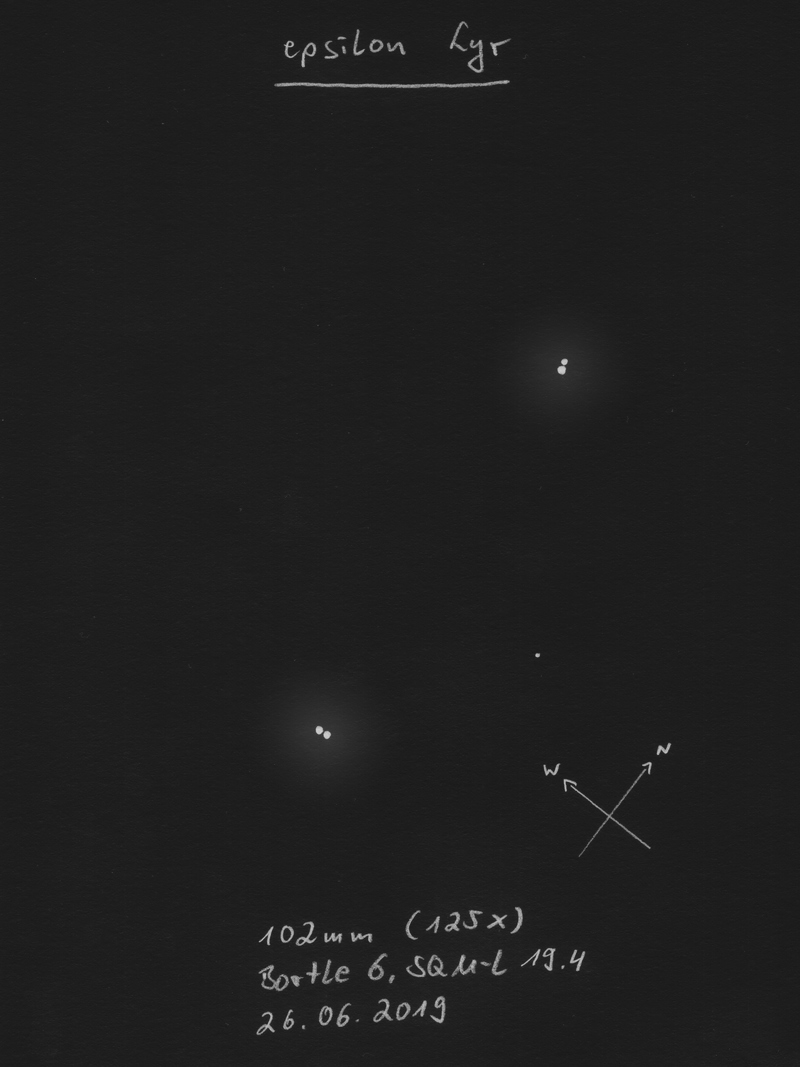
|
Uwe Pilz
Leipzig (Germany) |
105mm (26x) |
bei 22x nicht trennbar |
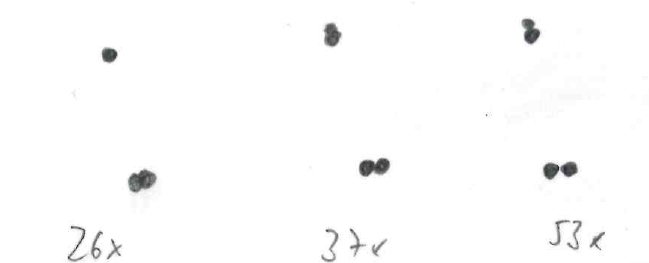
|
Jörg S. Schlimmer
Germany |
127mm (203x) |
easy to split |
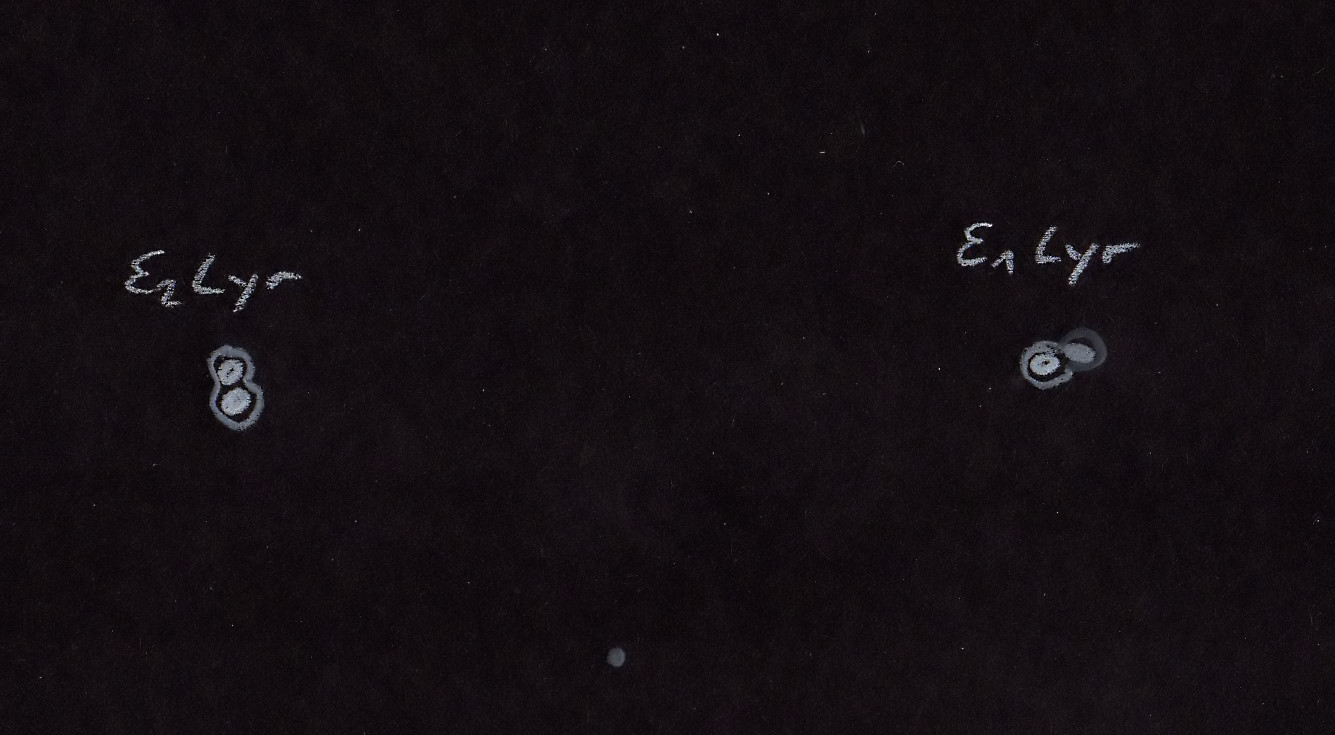
|
Sarah Gebauer
Germany |
150mm (250x) |
August 2019 zum ersten Mal die nah beieinanderstehenden Komponenten sauber getrennt, ein grandioser Doppel-Doppel-Anblick |
|
Winfried Kräling
Marburg (Germany) |
152mm (175x) |
|
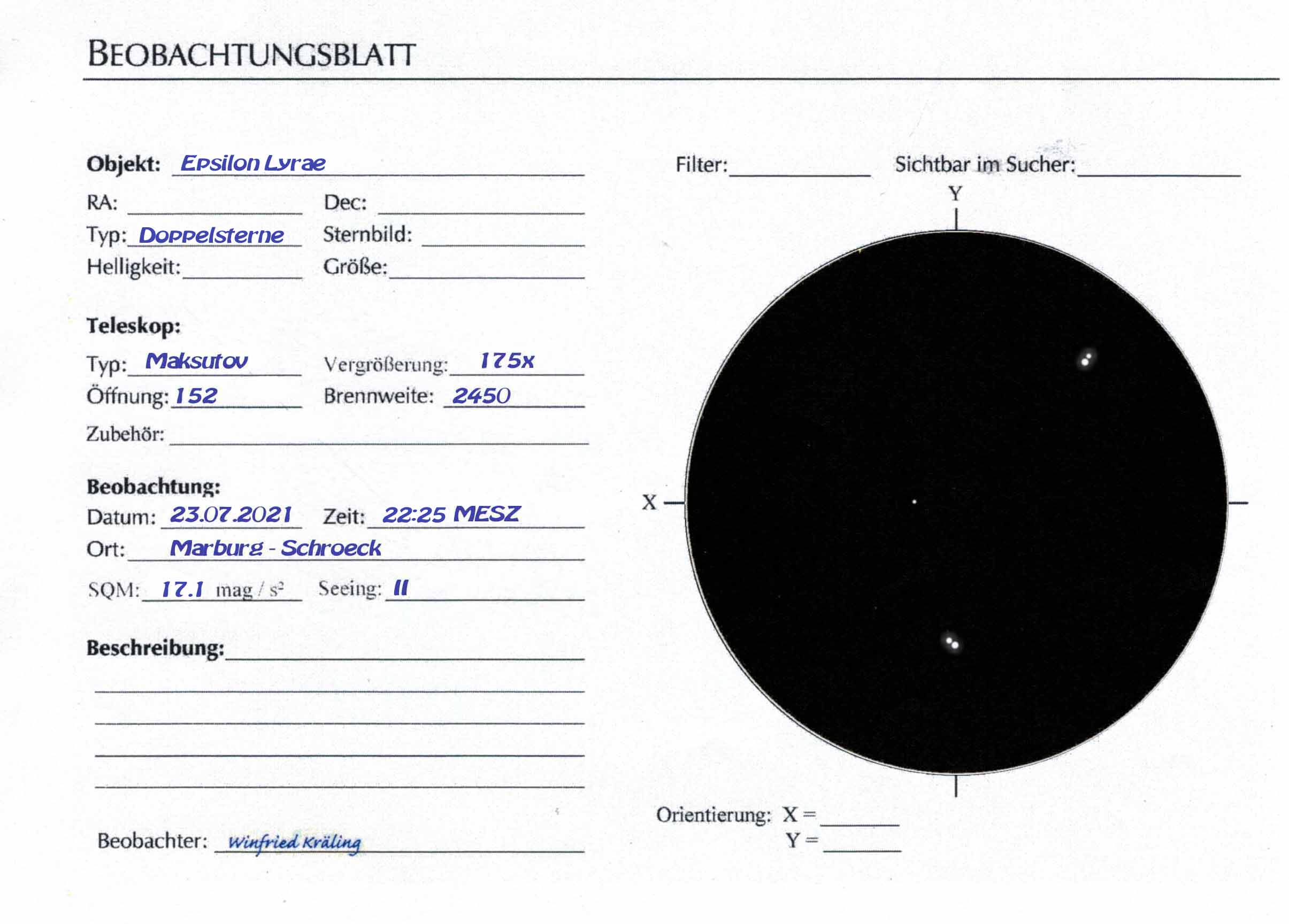
|
René Merting
Drachhausen (Germany) |
320mm (144x) |
AB: bei 72x ist erkennbar, in welche Richtung die Sterne elongieren, bei 43x dann ist eine deutliche 8 sichtbar - erst bei 206x lassen sich A und B zweifelsfrei trennen, zeigen sich aber auch schon ordentlich aufgebläht
CD: bei 103x ist die südliche Komponente als 8 erkennbar - bei 144x kann ich C und D trennen |
|
René Merting
Drachhausen (Germany) |
320mm (144x) |
bei 144x sind die Komponenten von AB und CD gerade so getrennt voneinander erkennbar, sie tanzen wie wild miteinander - mit Arperturmaske und Abblendung auf 120 mm zeigen die vier nun deutlich schwächeren Sterne schöne Beugungsscheibchen und sind besser getrennt voneinander sichtbar |
|
Uwe Pilz
Leipzig (Germany) |
320mm (200x) |
7 Komponenten!! A-B-C-D-E-F-I |

|
|
Berthold Fuchs
Wiesbaden (Germany) |
130mm |
Double-Double |
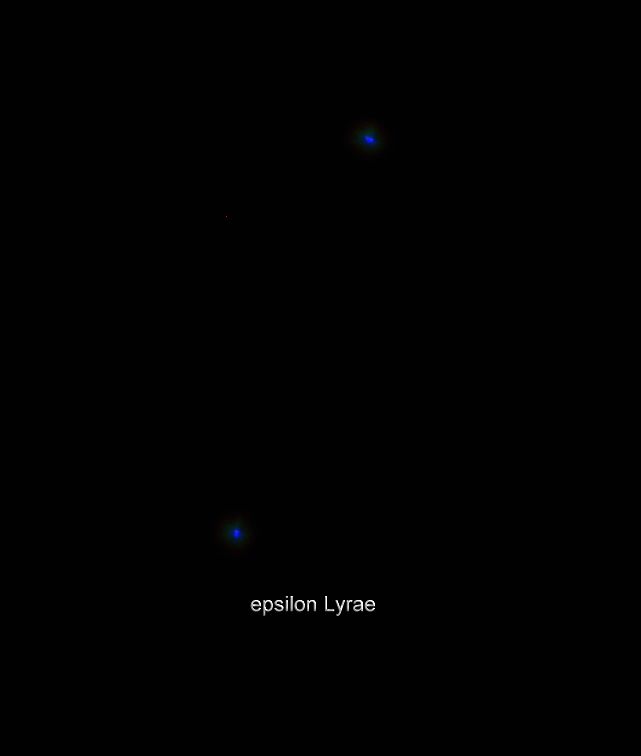
|
Frederik Wanink
Itterbeck (Germany) |
254mm |
|

|
|
|
★★
|
STFA38, zeta Lyr, zeta 1/2 Lyr, 6/7 Lyr |
|
AD |
4m.3 |
5m.6 |
43.7" |
150° |
2018 |
Lyr |
18h44m46.36s / +37°36'18.40" |
Christopher Hay
Seeheim (Germany) |
7x45 |
Handheld. Clearly split, almost wide. Primary bluish-white. Fantastic 8.6° FOV together with Eps1/2 and Delta1/2 Lyrae. One of the best doubles for 7x. |
|
Christopher Hay
Seeheim (Germany) |
10x42 |
Clearly separated. Colour contrast between bluish A and orangish D is there if one knows it, but not as striking as in 15x45 binoculars. |
|
Sarah Gebauer
Germany |
12x42 |
gut getrennt, mit schönem Helligkeitsunterschied und weißem Farbeindruck - zusammen mit Vega, ihrem weiten Halo und dem einfachen Epsilon-Lyrae-Doppel ein wundervoller Anblick |
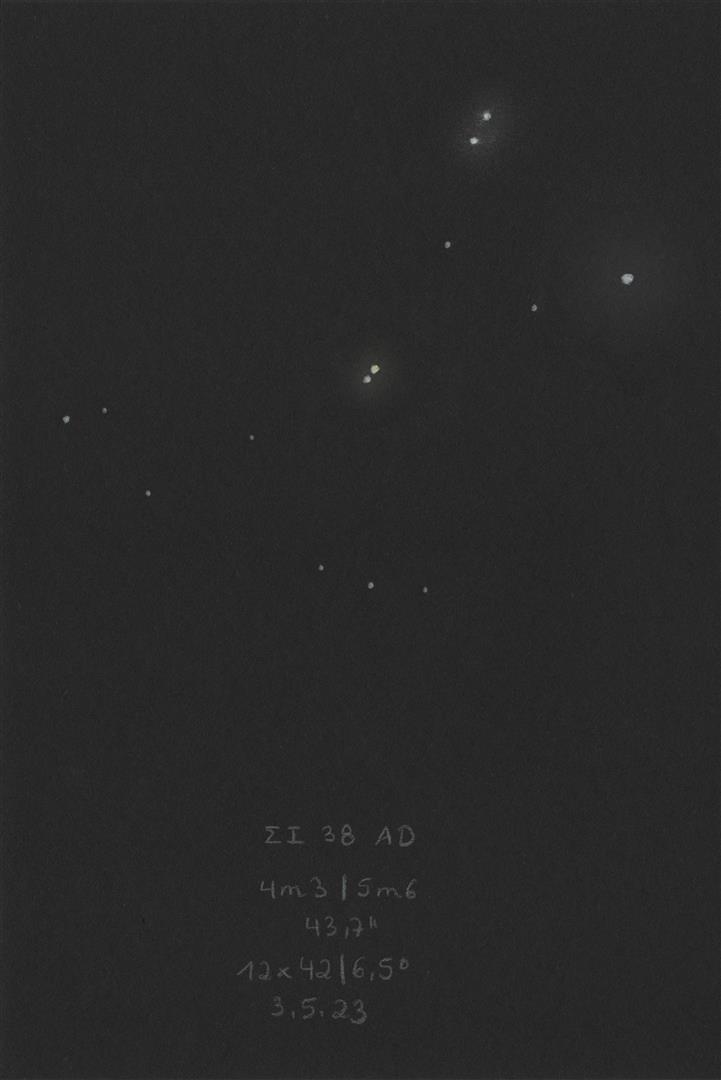
|
Christopher Hay
Seeheim (Germany) |
15x45 |
Component A clear blue-white, component D very pale tangerine orange. Wide split. Colour contrast seems even greater than that of nearby Delta 1/2 Lyrae. Physical double. |
|
René Merting
Drachhausen (Germany) |
76mm (29x) |
bei 29x ein sehr auffälliges Sternpaar, ordentlich getrennt - ein extrem schöner, dezenter Farbkontrast, A ist hellst gelb, D strahlt hell mintfarben, aber nur, wenn man nicht genau drauf schaut, sondern nur beiläufig - bei 57x verstärkt sich der Farbeindruck, vor allem, wenn man die Sterne leicht unscharf stellt, A ist dann samtgelb, B wirkt nicht mehr mintgrün sondern zart braunorange |
|
René Merting
Drachhausen (Germany) |
76mm (29x) |
bei 29x ein schön getrenntes Pärchen - D im Südosten ist 1.5 Magnituden schwächer und wirkt blaugrau gegen die weißgelbe A-Komponente |
|
Mark McCarthy
Fremont (California/USA) |
80mm (13x) |
Zeta 2 Lyr. Slightly greenish-white stars. Best view in finder, cleaner. Wide, 1 delta mag. |
|
René Merting
Drachhausen (Germany) |
100mm (20x) |
bei 20x weit getrennt, Komponente A weißlich, D leicht gelblich |
|
Sarah Gebauer
Germany |
100mm (21x) |
bei 20-fach auf den ersten Blick farblos bzw. warmweiß - ein sehr dominantes Pärchen in der Sternumgebung durch seine Helligkeit - mit etwas Geduld beim Beobachten zeigt sich ein gelber Farbhauch |
|
Sarah Gebauer
Germany |
100mm (80x) |
ein typisches Augenpaar, der nördliche Stern leuchtet leicht heller als der südliche |
|
Axel Tute
Küssaberg (Germany) |
100mm (217x) |
11.10.2023: Simple. No colours noted. |
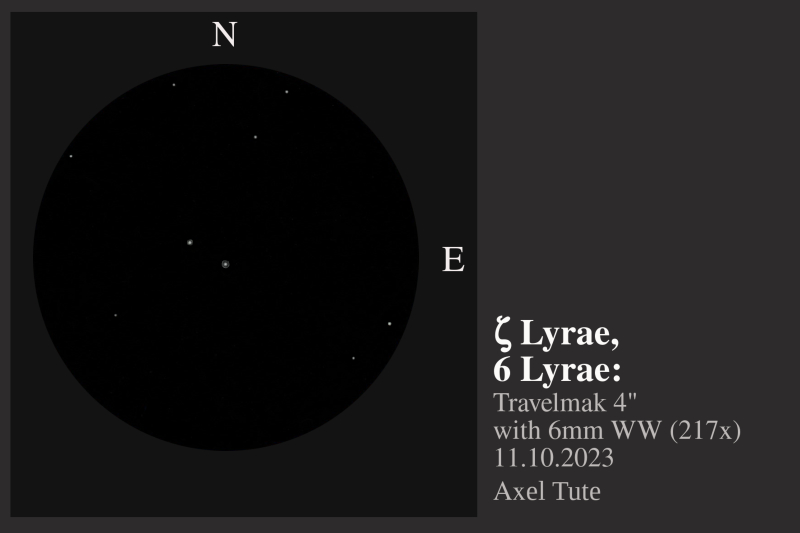
|
Uwe Pilz
Leipzig (Germany) |
105mm (88x) |
weiß-orange |

|
Sarah Gebauer
Germany |
150mm (85x) |
weit getrennt, unspektakulär |
|
Winfried Kräling
Marburg (Germany) |
152mm (175x) |
|
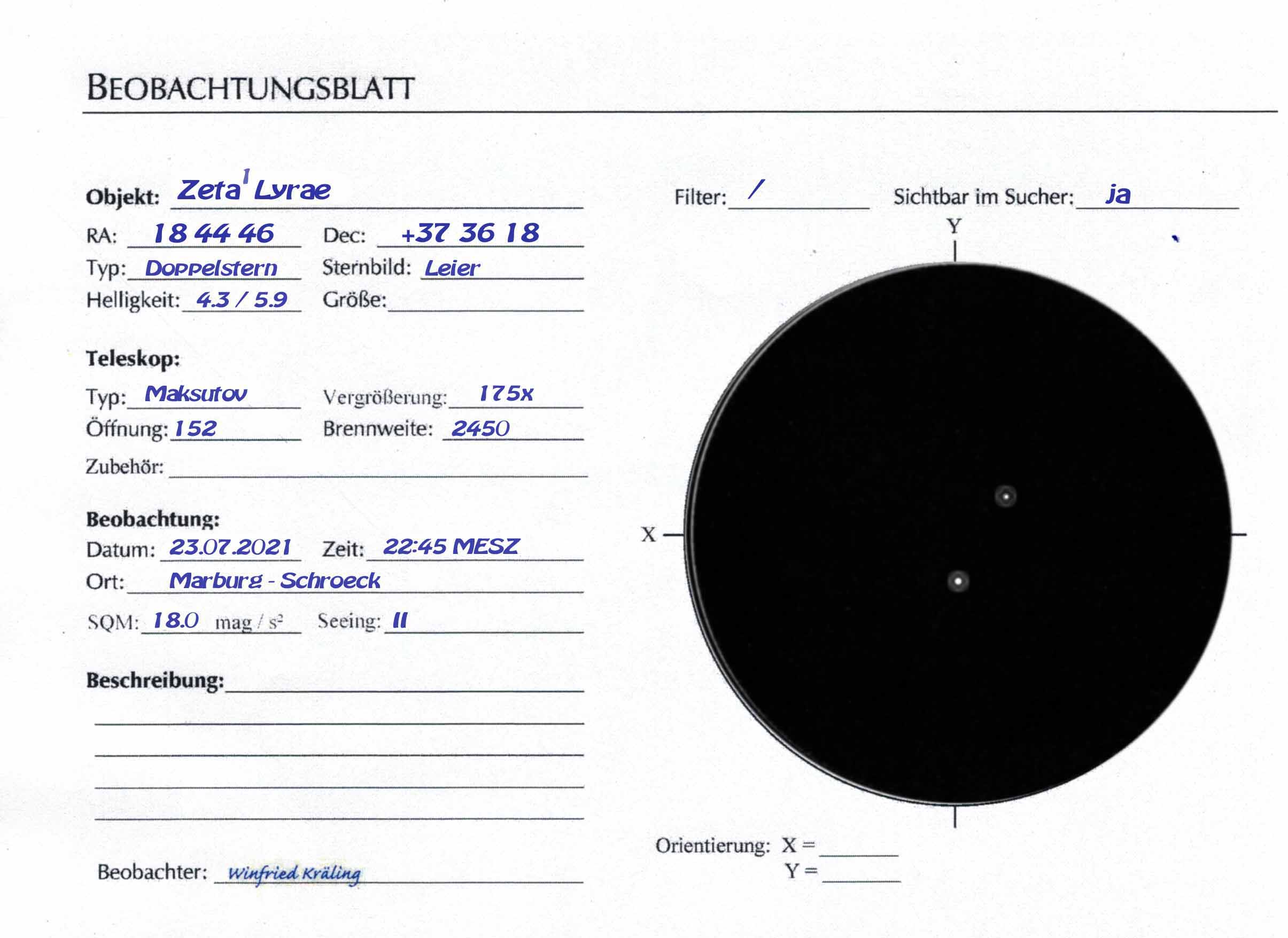
|
Mark McCarthy
Fremont (California/USA) |
152mm (175x) |
Wide, white-yellow stars, one delta |
|
René Merting
Drachhausen (Germany) |
320mm (45x) |
bei 45x ein helles Sternpaar mit leichtem Farbkontrast - die südöstlich stehende B-Komponente wirkt eine halbe Größenklasse schwächer und strahlt zartgelb, A dagegen wirkt weiß |
|
|
Frederik Wanink
Itterbeck (Germany) |
254mm |
|
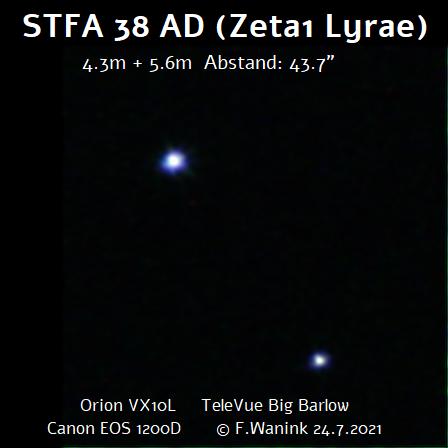
|
|
|
★
|
STF2393 |
|
AB |
7m.8 |
10m.4 |
18.2" |
24° |
2020 |
Lyr |
18h45m10.84s / +38°18'54.60" |
Mark McCarthy
Fremont (California/USA) |
317mm (553x) |
Pretty light orange and light blue! Wide separation, 1.5 delta mag. |
|
|
|
★
|
STF2375 |
|
AB |
6m.3 |
6m.7 |
2.6" |
120° |
2019 |
Ser |
18h45m28.36s / +05°30'00.40" |
|
|
René Merting
Drachhausen (Germany) |
76mm (95x) |
bei 57x erkenne ich eine Ameisen - beide Sterne stehen kurz vor der Trennung - bei 95x dann ein wunderschönes Bild, es zeigen sich zwei gleich helle Sterne, äußerst knapp getrennt |
|
René Merting
Drachhausen (Germany) |
100mm (64x) |
bei 64x sehe ich zwei sehr dicht stehende Sterne, mit etwas Geduld wird ab und an eine knappe Trennung deutlich - beide sind in gleich hell (ich habe sogar A und B falsch zugeordnet, weil ich B knapp heller fand) und strahlen um die Wette in weiß |
|
Stefan Loibl
Rosenheim (Germany) |
102mm (102x) |
'Tweedledum' and 'Tweedledee', recognizable as double star at 68x, clearly split at 102x, components equally bright, quadruple, visual double |
|
|
|
★
|
STF2390 |
|
|
7m.4 |
8m.6 |
4.3" |
155° |
2016 |
Lyr |
18h45m49.83s / +34°31'06.60" |
René Merting
Drachhausen (Germany) |
100mm (64x) |
bei 64x ploppt Komponente B knapp getrennt auf, vorher war sie unsichtbar - Farben Fehlanzeige |
|
Uwe Pilz
Leipzig (Germany) |
105mm (88x) |
|
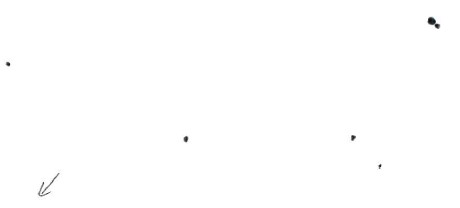
|
Mark McCarthy
Fremont (California/USA) |
317mm (277x) |
Orange and very wide separation B, 2x fainter B, bluish. |
|
|
|
★
|
COU1154 |
|
|
11m.1 |
11m.0 |
0.6" |
57° |
2016 |
Lyr |
18h47m38.65s / +32°47'28.90" |
Mark McCarthy
Fremont (California/USA) |
508mm (667x) |
Suspect notch at 553x, 1067x too hazy, but great clean split at 667x, very small, near equal. What a great sight. |
|
|
|
★
|
HU936 |
|
|
9m.7 |
9m.8 |
1.8" |
101° |
2017 |
Lyr |
18h48m42.19s / +34°01'04.80" |
Mark McCarthy
Fremont (California/USA) |
178mm (205x) |
Excellent pair, clean and precise split with seeing, near equal blue-white stars, nicely split. Struve should have got this. WDS uncertain, I find no parallax range overlap |
|
|
|
★★
|
STF2406 |
|
|
7m.1 |
11m.2 |
4.6" |
4° |
2018 |
Lyr |
18h49m55.77s / +26°25'30.60" |
Mark McCarthy
Fremont (California/USA) |
317mm (553x) |
Bright white, 3-4 delta mag, B is averted vision only and delicate, with seeing. Wow! |
|
Mark McCarthy
Fremont (California/USA) |
508mm (667x) |
White star no split at 8" 333x and 667x, but needed the 20" to see the well separated B star. |
|
|
|
★
|
A256 |
|
|
9m.0 |
11m.2 |
2.9" |
60° |
2016 |
Lyr |
18h50m03.54s / +31°48'48.20" |
Mark McCarthy
Fremont (California/USA) |
508mm (533x) |
Orange pair, about 2 delta mag, wide 4-5". Nice pair. |
|
|
|
★★
|
beta Lyr, 10 Lyr, Sheliak |
STFA39 |
AB |
3m.6 |
6m.7 |
45.7" |
149° |
2017 |
Lyr |
18h50m04.79s / +33°21'45.60" |
|
|
|
BU293 |
AE |
3m.6 |
10m.1 |
67.2" |
317° |
2015 |
|
|
|
|
|
BU293 |
AF |
3m.6 |
10m.6 |
86.0" |
18° |
2015 |
|
|
René Merting
Drachhausen (Germany) |
10x32 |
AB: einfach zu trennen, etwas mehr als knapp getrennt - B im Südosten ist deutlich schwächer, bestimmt 3 bis 4 Größenklassen |
|
Christopher Hay
Seeheim (Germany) |
10x42 |
AB: Stabilised binoculars, handheld. B is well apart from A and distinct. Very pretty! |
|
René Merting
Drachhausen (Germany) |
12x42 |
AB: die schwache Komponente B ist glasklar getrennt südlich von der weißbläulich strahlenden A-Komponente zu erkennen - Trennung ordentlich, Helligkeitsunterschied nicht abschätzbar |
|
Robert Zebahl
Leipzig (Germany) |
70mm (22x) |
At 22x and 57x the components A, B, E and F were easily seen. The B component appeared slightly bluish-silver at 22x, but at 57x the color was difficult to tell. All four components form a slightly curved 'Y' with the bright A component in the center. |
|
René Merting
Drachhausen (Germany) |
76mm (18x) |
AB: bei 18x sind die beiden Sterne gut getrennt voneinander zu erkennen
EF: beide Komponenten zeigen sich bei 18x sehr schwach |
|
René Merting
Drachhausen (Germany) |
100mm (32x) |
AB: bei 32x sind die Komponenten A und B weit getrennt, B ist deutlich schwächer
EF: ebenfalls bei 32x machen zwei gleichhelle Fühlersterne (E und F) nördlich von Komponente A das System interessanter - sie sind noch schwächer als B - Farbe konnte ich bei keinem der vier Sterne erkennen |
|
Sarah Gebauer
Germany |
100mm (80x) |
AB: sehr heller und weit getrennter Doppelstern mit einem gefühlten Farbunterschied, der nördliche Stern wirkt warmweiß, der südliche leicht kühl-bläulich |
|
Robert Zebahl
Leipzig (Germany) |
102mm (62x) |
Components A, B, E and F are easily visible. The two southern stars on the drawing do not belong to the system. |
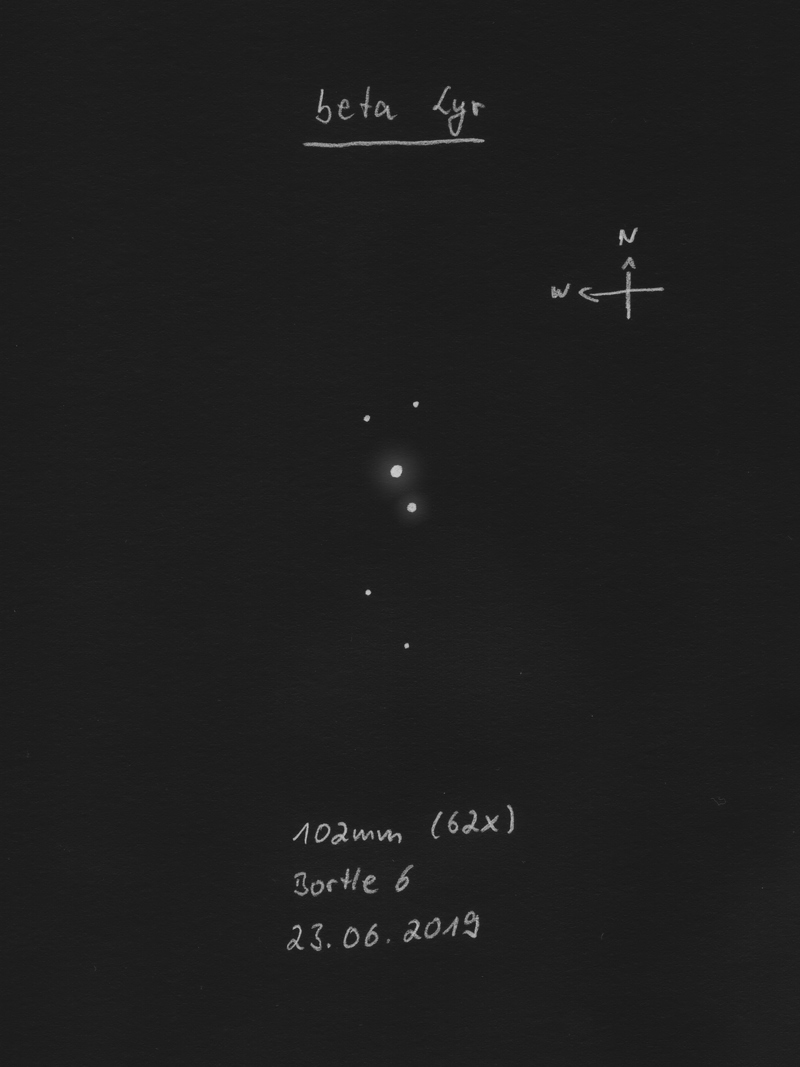
|
Uwe Pilz
Leipzig (Germany) |
105mm (139x) |
AB: Begleiter ist tiefrot; die Natur des Systems ist unsicher |

|
Uwe Pilz
Leipzig (Germany) |
105mm (144x) |
schon sichtbar bei 26x, aber schwierig. A blauweiß, B orange. |

|
Jörg S. Schlimmer
Germany |
127mm (108x) |
easy to split |
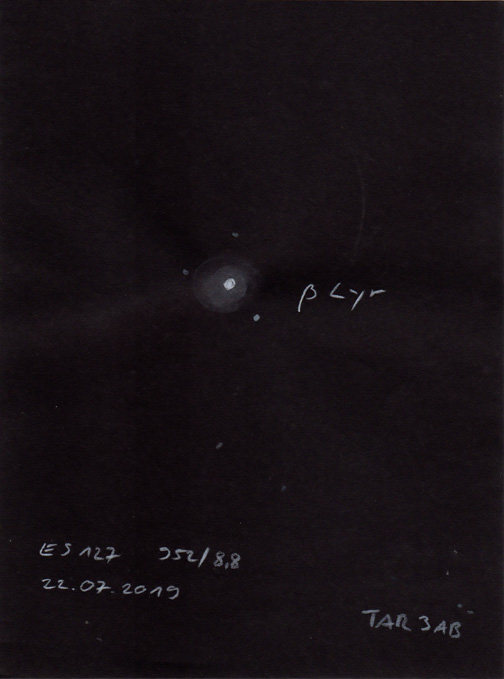
|
Sarah Gebauer
Germany |
150mm (85x) |
AB: weit getrennt, viele helle Feldsterne |
|
|
|
★
|
BU265 |
|
|
7m.4 |
9m.2 |
1.5" |
227° |
2018 |
Aql |
18h50m14.94s / +11°31'21.50" |
Mark McCarthy
Fremont (California/USA) |
203mm (667x) |
Very tremulous B star appears with seeing, surprisingly difficult for the mag, maybe because so close. |
|
Mark McCarthy
Fremont (California/USA) |
317mm (553x) |
Very faint but resolved B at outer diffraction ring when seeing stills. Yellow A, bluish B. |
|
|
|
★
|
STF2404 |
|
|
6m.9 |
7m.8 |
3.6" |
180° |
2020 |
Aql |
18h50m45.55s / +10°58'35.20" |
Robert Zebahl
Leipzig (Germany) |
70mm (44x) |
Already at 22x the double star is striking due to its orange color. At 44x split, but rather tight with a clear difference in brightness. At 100x the primary component appears in a bright orange, the secondary component shows a bluish tint. |
|
René Merting
Drachhausen (Germany) |
76mm (57x) |
bei 57x zeigt sich die B-Komponente extrem knapp getrennt südlich von A und ist knapp eine Größenklasse schwächer - A ist weiß, B grauweiß - bei 95x gefällt mir die Trennung besser |
|
Sarah Gebauer
Germany |
100mm (128x) |
20.09.23: ein besonders enges Pärchen, das bei 128-fach erst getrennt zu sehen ist - Farbe ist auf den ersten Blick zu sehen, die hellere Komponente nördlich zeigt sich gelb- bis goldorange, die schwächere südlich ähnlich, nur etwas bräunlicher |
|
Axel Tute
Küssaberg (Germany) |
100mm (163x) |
19.08.2012: A: light yellow |
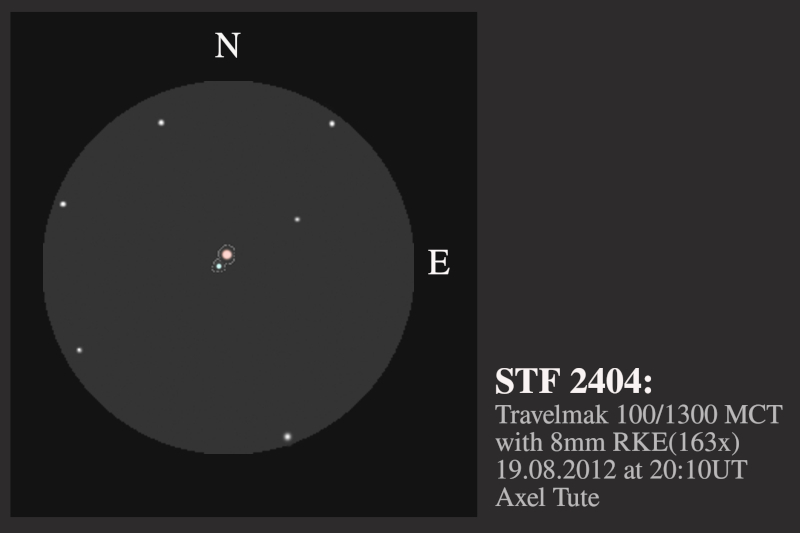
|
Mark McCarthy
Fremont (California/USA) |
203mm (667x) |
Light orange and light blue, pretty. |
|
Frederik Wanink
Itterbeck (Germany) |
254mm (640x) |
beide gelblich |

|
Mark McCarthy
Fremont (California/USA) |
317mm (553x) |
well split, yellow A and yellow-orange B. |
|
René Merting
Drachhausen (Germany) |
320mm (103x) |
bei 103x sehe ich ein schön eng beieinander stehendes Sternpaar - beide Sterne strahlen Ährengelb, sie nehmen sich farblich nicht viel - Helligkeitsunterschied gut 1 Magnitude - bei 206x kann A sich auf farblich etwas absetzen und behält seinen gelben Glanz mehr für sich |
|
|
|
★
|
RST4605 |
|
|
11m.2 |
11m.6 |
0.8" |
117° |
2013 |
Aql |
18h50m58.96s / -02°38'02.20" |
Mark McCarthy
Fremont (California/USA) |
508mm (667x) |
Very, very fine, faint, split, quarter delta mag. Very tough considering proximity to nearly full moon with poor transparency. Nice! |
|
|
|
★
|
HU199 |
|
|
9m.1 |
9m.5 |
0.9" |
345° |
2015 |
Aql |
18h52m07.48s / +11°47'54.30" |
Mark McCarthy
Fremont (California/USA) |
203mm (667x) |
Wow! With seeing very tight very faint but split near equal. very cool. |
|
|
|
★
|
BU137 |
|
AB |
8m.7 |
9m.0 |
1.6" |
167° |
2022 |
Lyr |
18h53m57.56s / +37°22'49.70" |
|
|
Frederik Wanink
Itterbeck (Germany) |
254mm (640x) |
|
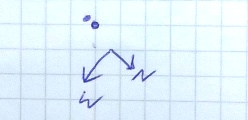
|
Mark McCarthy
Fremont (California/USA) |
317mm (553x) |
Fine near equal light orange, ~2". Rich finder field. In Steph 1 open cluster. |
|
Mark McCarthy
Fremont (California/USA) |
508mm (667x) |
Nice bright white near equal stars, 1.5", in a two plus one system with much fainter farther C. (AC 12th mag 23.6") |
|
|
|
★
|
HU1294 |
|
|
9m.6 |
10m.6 |
1.6" |
119° |
2016 |
Lyr |
18h54m14.83s / +32°14'12.70" |
Mark McCarthy
Fremont (California/USA) |
508mm (667x) |
Well split, 1.5 delta mag, 2" sep, light orange and blue stars. pretty. |
|
|
|
★
|
delta 2 Lyr, 12 Lyr, delta Lyrae Cluster, Stephenson 1 |
ES2028 |
AB |
4m.3 |
11m.2 |
86.3" |
349° |
2014 |
Lyr |
18h54m30.29s / +36°53'55.00" |
|
|
|
SMR13 |
AD |
4m.5 |
8m.8 |
193.1" |
210° |
2014 |
|
|
|
|
|
SMR13 |
AE |
4m.5 |
10m.3 |
400.6" |
238° |
2014 |
|
|
|
|
|
SMR13 |
AF |
4m.5 |
8m.8 |
369.4" |
245° |
2014 |
|
|
|
|
|
SMR13 |
AG |
4m.5 |
9m.8 |
335.9" |
261° |
2014 |
|
|
|
|
|
SMR13 |
AH |
4m.5 |
8m.7 |
229.4" |
284° |
2014 |
|
|
|
|
|
SMR13 |
AJ |
4m.3 |
12m.0 |
279.5" |
249° |
2014 |
|
|
|
|
|
SMR13 |
AK |
4m.3 |
12m.0 |
304.2" |
236° |
2014 |
|
|
|
|
|
ES2028 |
BC |
11m.2 |
11m.6 |
2.1" |
135° |
2008 |
|
|
|
|
|
SMR13 |
HI |
8m.7 |
12m.9 |
26.1" |
251° |
2015 |
|
|
Jörg S. Schlimmer
Germany |
305mm (94x) |
easy to split |
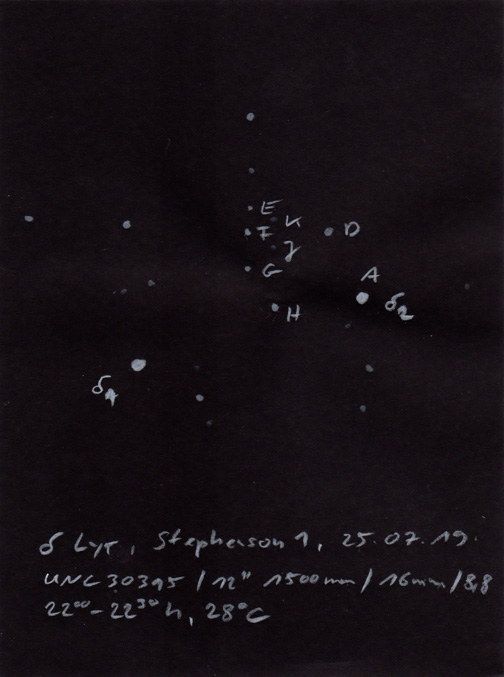
|
Mark McCarthy
Fremont (California/USA) |
508mm (205x) |
ES2028 (BC): Delta 2 Lyr. ! Very cool. A is bright light orange, and BC are blue pinpoints, ~2" with a slight mag difference. Clearly and cleanly seen. |
|
|
|
★
|
STF2415 |
|
|
7m.1 |
8m.7 |
2.0" |
290° |
2015 |
Her |
18h54m32.84s / +20°36'55.10" |
Mark McCarthy
Fremont (California/USA) |
152mm (175x) |
! Light yellow-white A and blue B closely split, just a little more than 1 delta mag, very fine |
|
Mark McCarthy
Fremont (California/USA) |
203mm (333x) |
Nice pair, 2 delta mag, well separated. |
|
Mark McCarthy
Fremont (California/USA) |
203mm (667x) |
Two delta mag, ~2". Used the 8" mask to clean up the star images, but the view in the 20" was more colorful, yellow A and bluish B. |
|
|
|
★
|
HO270 |
|
AB |
5m.4 |
12m.6 |
8.4" |
300° |
2013 |
Lyr |
18h54m52.18s / +41°36'09.80" |
Mark McCarthy
Fremont (California/USA) |
508mm (205x) |
! Bright yellow A and very faint B seen with averted vision then held direct, with another faint star one ninety degrees different PA and three times farter out (this is AC). There is a streak of grainy stars across the field, very rich. |
|
|
|
★★
|
STT525 & SHJ282 |
STT525 |
AB |
6m.1 |
9m.1 |
1.8" |
130° |
2015 |
Lyr |
18h54m52.52s / +33°58'06.90" |
|
|
|
SHJ282 |
AC |
6m.1 |
7m.6 |
45.4" |
349° |
2018 |
|
|
|
|
|
SHJ282 |
AD |
6m.1 |
11m.0 |
214.8" |
295° |
2015 |
|
|
Christopher Hay
Seeheim (Germany) |
10x42 |
SHJ282 (AC): Stabilised binoculars, handheld. Wide split, the A component yellowish. Alias South 282. According to Stelledoppie a physical double. |
|
Robert Zebahl
Leipzig (Germany) |
16x70 |
SHJ282 (AC): 2020-07-06: Easy, striking with reasonably apparent color contrast: yellowish to slightly orange & bluish. |
|
Christopher Hay
Seeheim (Germany) |
60mm (15x) |
SHJ282 (AC): Wide split. Blue colour of C component much more striking than the orange colour of the A component. |
|
Robert Zebahl
Leipzig (Germany) |
70mm (22x) |
SHJ282 (AC): Fairly bright and wide pair. The double star was conspicuous, especially in regard to its color: A appeared orange, C rather grey-bluish. It could be observed together with Messier 57 and beta & gamma Lyrae. Very nice. |
|
René Merting
Drachhausen (Germany) |
76mm (18x) |
SHJ282 (AC): bei 18x ist das Pärchen schon sehr auffällig - A ist hellgelb mit schönem Kontrast zur nördlich stehenden, gut getrennten B-Komponente - bei 57x präsentiert sich B in einem zarten stahlblau |
|
Sarah Gebauer
Germany |
100mm (49x) |
SHJ282 (AC): bei 50-fach weit getrennt mit nur geringem Helligkeitsunterschied, dafür aber einem schönen, warmgelb-graublauen Farbeindruck der beiden Komponenten - außerdem zusammen mit dem leicht südöstlich stehenden, deutlich schwächeren STF 2421 zusammen im Bild |
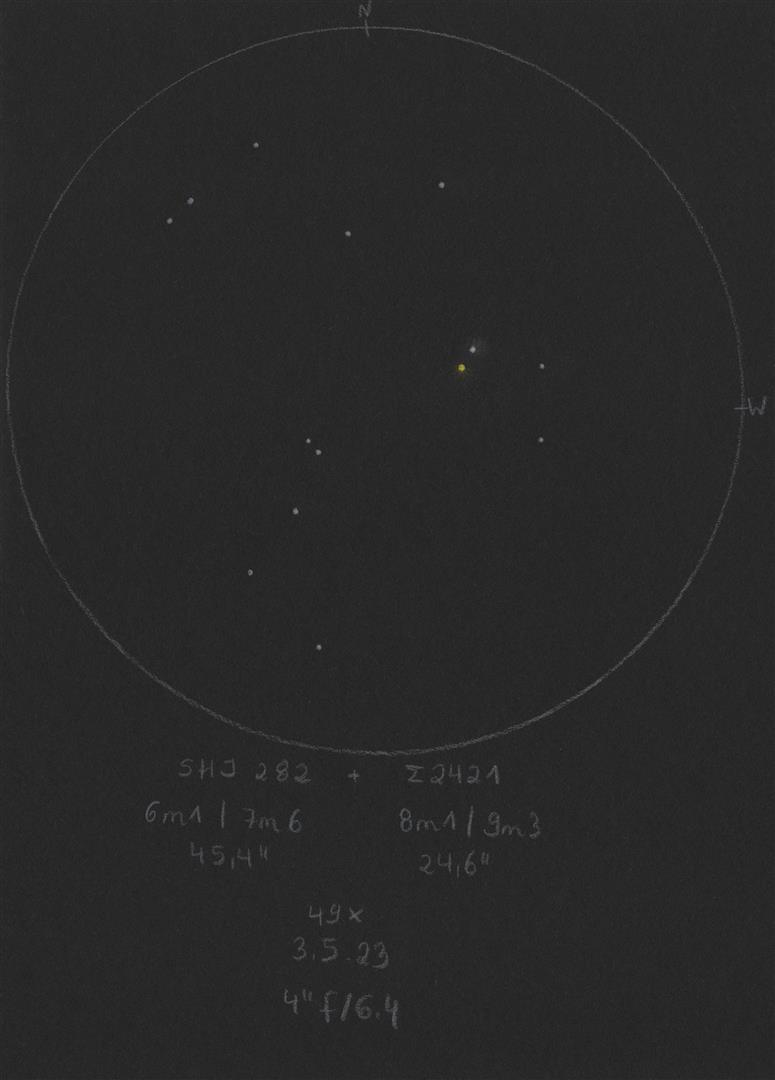
|
Uwe Pilz
Leipzig (Germany) |
105mm (21x) |
SHJ282 (AC): Orange und türkis |
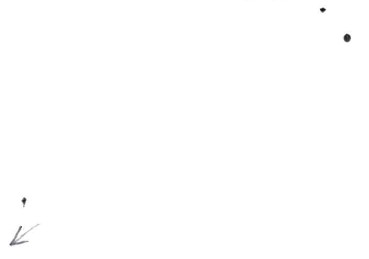
|
Uwe Pilz
Leipzig (Germany) |
105mm (180x) |
STT525 (AB): gelbweiß-blau |
|
Christopher Hay
Seeheim (Germany) |
125mm (23x) |
SHJ282 (AC): Widely split, dominates the field of view, very attractive. A component is tangerine orange, C component ice blue. An echo of Albireo. A true physical pair. |
|
Mark McCarthy
Fremont (California/USA) |
152mm (285x) |
STT525 (AB): Suspected at 175x, best seen 285x. Orange A, subtle elongation to notched with best seeing, unequal. Wide SHJ 282 AC also seen. WDS uncertain but there is a -34% parallax overlap, so it's not possible to be |
|
Mark McCarthy
Fremont (California/USA) |
178mm (205x) |
STT525 (AB): Extremely fine point shows just outside bright white A's first diffraction, only with best seeing and when A is a perfect disk. WDS uncertain, however unfortunately there is -34% parallax overlap, it is not physical |
|
Christopher Hay
Seeheim (Germany) |
180mm (200x) |
SHJ282 (AC): A is very distant from C but the two are still a fine pair. Colour of C is more striking than that of A, in a manner similar to my simultaneous observation with 60mm at 15x, but not quite as pronounced.
C has a companion set off from it by a hair of black. I estimate PA from C at approx. 80°, separation very roughly 2". Surprisingly can't find this companion in the double star catalogues. |
|
Frederik Wanink
Itterbeck (Germany) |
254mm (640x) |
STT525 (AB): 3er System, sehr schwierig wegen Helligkeitsunterschied |
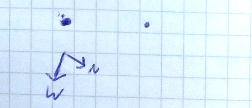
|
Mark McCarthy
Fremont (California/USA) |
317mm (277x) |
SHJ282 (AC): Wide separation orange and blue, 2 delta mag. |
|
|
Frederik Wanink
Itterbeck (Germany) |
254mm |
STT525 (AB) |

|
Claus-Dieter Jahn
Leipzig (Germany) |
|
SHJ282 (AC): TS APQ 65/420mm, ZWO ASI 178mc, Livestack with Sharpcap, Exposure time: 1600x 0.6s |
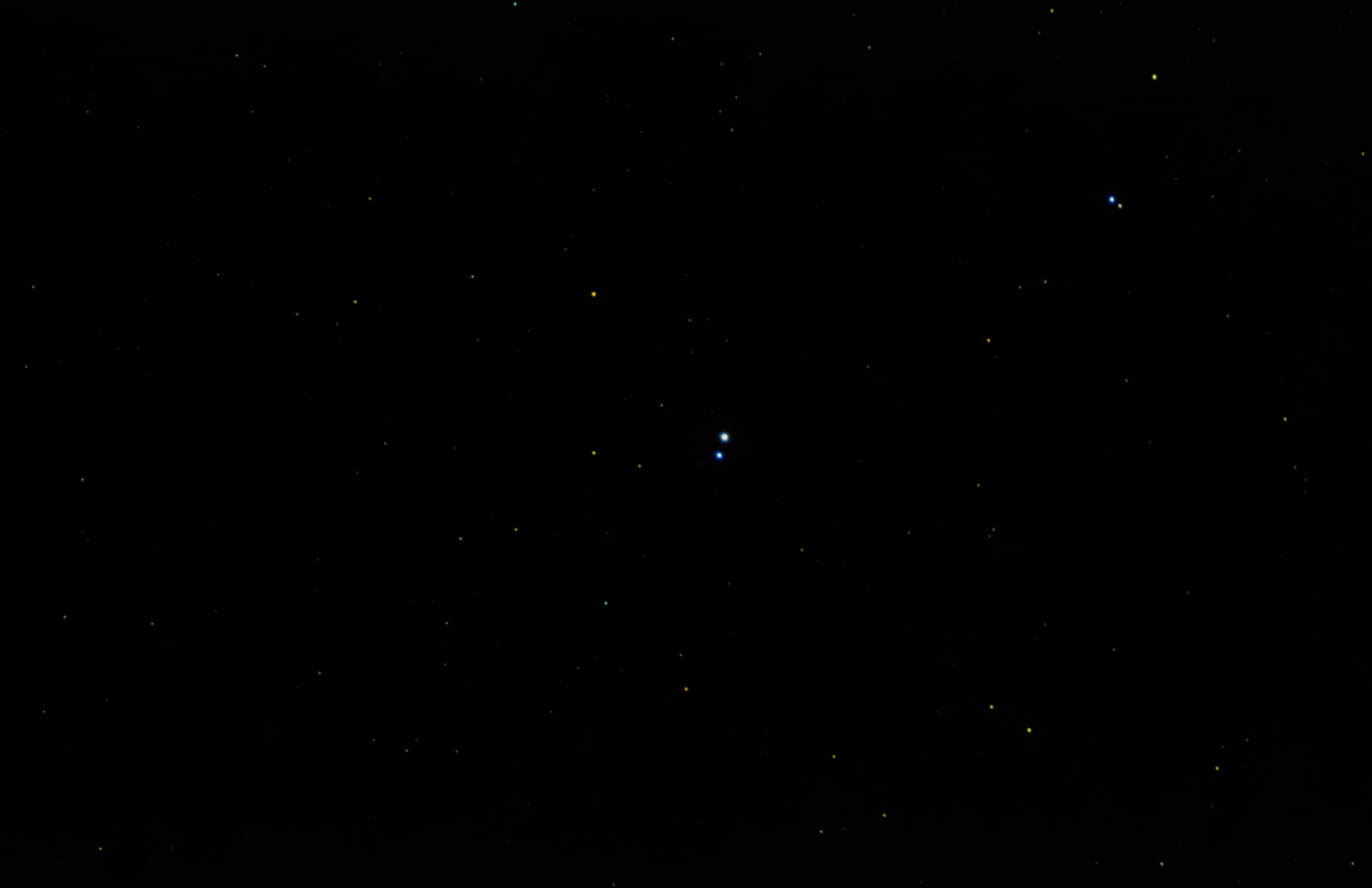
|
|
|
★
|
COU511 |
|
Aa-Ab |
9m.7 |
9m.9 |
0.7" |
190° |
2016 |
Her |
18h55m23.68s / +23°24'00.10" |
Mark McCarthy
Fremont (California/USA) |
508mm (533x) |
! Wow great pair. A star rather bright with B very close-in, ~1 delta mag, the tiniest pin prick <1" separated from A |
|
|
|
★
|
A2193 |
|
|
8m.8 |
9m.2 |
1.0" |
357° |
2017 |
Ser |
18h55m51.23s / +03°22'30.80" |
Mark McCarthy
Fremont (California/USA) |
203mm (667x) |
Pair of white stars, half delta mag. found very quickly slew to. Nice pair. Very clean split. |
|
|
|
★
|
STF3130 & STT365 |
STT365 |
AB |
7m.2 |
8m.3 |
0.2" |
359° |
2016 |
Lyr |
18h55m57.14s / +44°13'41.90" |
|
|
|
STF3130 |
AB-C |
7m.0 |
10m.5 |
2.6" |
257° |
2016 |
|
|
|
|
|
STF3130 |
AB-D |
7m.0 |
12m.0 |
181.2" |
310° |
2003 |
|
|
Mark McCarthy
Fremont (California/USA) |
152mm (175x) |
STF3130 (AB-C): Very fine, B very much fainter and red color. B appears with seeing, very close (AB is 0.4" and doable with 20-inch) |
|
Mark McCarthy
Fremont (California/USA) |
317mm (553x) |
STF3130 (AB-C): Extremely faint but present direct vision, white A and blue B, 4" 3-4 delta mag. Did not see AB 0.4". Nearby R Lyr which is a pretty orange. |
|
Mark McCarthy
Fremont (California/USA) |
317mm (553x) |
STT365 (AB): Very fine, white and blue stars, ~4", 3 delta mag. Nice! |
|
Mark McCarthy
Fremont (California/USA) |
508mm (205x) |
STF3130 (AB-C): Very nice bright white A and slightly red B well split from A, three delta mag. Did not notice the 0.4" AB pair STT 365 |
|
|
|
★
|
STF2417, theta Ser, 63 Ser, Alya |
|
AB |
4m.6 |
4m.9 |
22.4" |
106° |
2019 |
Ser |
18h56m13.18s / +04°12'12.90" |
|
|
|
|
AC |
4m.6 |
6m.8 |
421.0" |
58° |
2007 |
|
|
René Merting
Drachhausen (Germany) |
10x35 |
AB: wunderschön für diese Vergrößerung - zwei helle dicht beieinander stehende Sterne, knapp getrennt - die hellsten Sterne im Umfeld |
|
René Merting
Drachhausen (Germany) |
10x50 |
AB: zwei helle schneeweiße Sterne, knapp getrennt - B im Osten ist nur knapp schwächer - ein schönes enges Pärchen |
|
René Merting
Drachhausen (Germany) |
16x70 |
AB: ein gut getrennt zu sehendes Pärchen - beide Sterne stahlen weiß, Komponente B im Osten ist keine halbe Größenklasse schwächer |
|
René Merting
Drachhausen (Germany) |
100mm (20x) |
AB: bei 20x ein auffälliges gut getrenntes Sternpaar - Komponente B östlich ist nur leicht schwächer und strahlt ein wenig warm-weißer |
|
Sarah Gebauer
Germany |
100mm (73x) |
AB: die mit deutlichem Abstand bei 73x getrennten Doppelsterne liegen wie in einem U aus recht gleich hellen Sternen und bilden dabei im Süden den unteren Bereich des Buchstabens |

|
Stefan Loibl
Rosenheim (Germany) |
102mm (102x) |
AB: wide pair, hardly any difference in brightness, wonderful field, double stars looks like an embedded pair of eyes |
|
|
Berthold Fuchs
Wiesbaden (Germany) |
130mm |
AB: easy DS |

|
|
|
★★
|
STF2422 |
|
|
7m.9 |
8m.2 |
0.8" |
71° |
2021 |
Her |
18h57m07.83s / +26°05'45.10" |
Mark McCarthy
Fremont (California/USA) |
203mm (333x) |
Excellent hairline split at 333x with eight inch. Near equal white stars. Picked them out in a crowded field, suspected elongation right away, split with seeing as I centered it in eyepiece, and from then it was a steady split |
|
Frederik Wanink
Itterbeck (Germany) |
254mm (640x) |
schwieriger wegen schwacher Sterne |
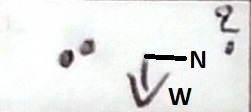
|
Mark McCarthy
Fremont (California/USA) |
317mm (553x) |
Very tight, <0.8", equal light orange, pretty faint. |
|
|
|
★
|
A587 |
|
BC |
10m.6 |
11m.5 |
1.8" |
188° |
2017 |
Lyr |
18h57m55.98s / +44°07'00.00" |
Mark McCarthy
Fremont (California/USA) |
508mm (205x) |
Excellent 2+1 pair, bright A, BC wide and 1 delta mag, well split ~2" |
|
|
|
★
|
COU1156 |
|
|
11m.1 |
11m.2 |
0.7" |
111° |
2016 |
Lyr |
19h00m34.25s / +33°01'24.80" |
Mark McCarthy
Fremont (California/USA) |
508mm (667x) |
Near qual small and at best moments a clean split, still, just nice points. great star |
|
|
|
★
|
HO92 |
|
|
10m.6 |
10m.8 |
1.3" |
40° |
2015 |
Lyr |
19h00m59.89s / +32°33'11.60" |
Mark McCarthy
Fremont (California/USA) |
508mm (667x) |
Beautifully well split, had an instant of perfect images. White pair near equal. |
|
|
|
★
|
STF2437 |
|
|
8m.4 |
8m.8 |
0.6" |
334° |
2021 |
Sge |
19h01m53.16s / +19°10'11.70" |
|
|
Mark McCarthy
Fremont (California/USA) |
178mm (333x) |
Light orange, snowman only. Physical with a 804.6-year period |
|
Mark McCarthy
Fremont (California/USA) |
317mm (553x) |
Small faint, notched peanut when seeing stills. Orange. |
|
René Merting
Drachhausen (Germany) |
320mm (411x) |
bis 411x hoch vergrößert, dann endlich zeigen sich in ruhigen Momenten zwei Perlchen, knapp getrennt und in den Beugungsringen des Partner stehend - Schwerstarbeit |
|
|
|
★
|
A589 |
|
|
9m.5 |
10m.1 |
0.7" |
6° |
2017 |
Lyr |
19h03m01.81s / +42°32'45.80" |
Mark McCarthy
Fremont (California/USA) |
508mm (533x) |
! Exceedingly fine pair, split with seeing, ~1 delta mag, white A and blue B. In the same field with ES 1430. |
|
|
|
★
|
COU1935 |
|
|
10m.6 |
11m.1 |
1.2" |
41° |
2016 |
Lyr |
19h04m11.37s / +38°58'47.40" |
Mark McCarthy
Fremont (California/USA) |
508mm (667x) |
Very fine near equal, well split, 1", white. Verified on chart. |
|
|
|
★
|
15 Aql, SHJ286 |
|
|
5m.5 |
7m.0 |
39.6" |
211° |
2019 |
Aql |
19h04m57.67s / -04°01'53.10" |
Christopher Hay
Seeheim (Germany) |
7x42 |
Handheld binoculars in reclining chair. Difficult due to hand tremor and significant delta-mag, but definitely split.
In handheld 15x60 binoculars quite clearly split.
In handheld stabilised 20x60 binoculars a strong wide pair, primary is golden-yellow. |
|
René Merting
Drachhausen (Germany) |
8x30 |
beide Sterne zeigen sich gut getrennt, wobei B im Süden lediglich dunkler wirkt, Farben sind nicht wirklich erkennbar |
|
René Merting
Drachhausen (Germany) |
10x32 |
beide Sterne sind ein klein wenig mehr als knapp getrennt - A im Norden wirkt hell gelb, B im Süden ist eher grauweiß und knapp 2 Magnituden schwächer |
|
René Merting
Drachhausen (Germany) |
10x35 |
ein wunderschöner Doppelstern - die beiden Mitglieder sind sehr hell - B im Südwesten wirkt kupfern, A eher gelblich - Trennung ordentlich |
|
René Merting
Drachhausen (Germany) |
10x50 |
sehr auffälliges dicht zusammen stehendes Sternpaar - Komponente A im Norden ist hellgelb, B grau-orange, schöner Farbkontrast |
|
René Merting
Drachhausen (Germany) |
12x50 |
ein ordentlich getrenntes Sternpaar - A im NO ist weißgelb, B wirkt gelborange |
|
René Merting
Drachhausen (Germany) |
16x70 |
ein wunderschönes ordentlich getrenntes Sternpaar - Komponente A im NO samtgelb, B dagegen apricot-orange und gut 1.5 Magnituden schwächer als A - zudem ein interessanter Farbvergleich möglich zu dem mit im Gesichtsfeld stehenden V Aql gut 1.7° weiter südlich, der farblich noch eine Schippe drauf legen kann mit einem kräftigen zinnober-orange |
|
Robert Zebahl
Leipzig (Germany) |
70mm (22x) |
Striking, pretty wide, uneven pair. Primary component gleamed in shiny orange, the companion appeared slightly orange. |
|
René Merting
Drachhausen (Germany) |
76mm (29x) |
bei 29x ein weit getrenntes Pärchen, B ist eine Größenklasse schwächer - A ist buttergelb, B wirkt noch etwas dunkelgelblicher |
|
René Merting
Drachhausen (Germany) |
100mm (32x) |
bei 32x weit getrennt, Komponente A hellgelb, B dagegen orangefarben - sehenswert |
|
René Merting
Drachhausen (Germany) |
107mm (30x) |
bei 30x ist der Doppelstern mehr als gut getrennt erkennbar - Komponente A strahlt in einem schönen nicht zu kräftigen Gelb, B wirkt flüchtig betrachtet bernsteinorange, direkt betrachtet dann hellorange |

|
Sarah Gebauer
Germany |
150mm (125x) |
gut gefunden, beide Sterne stehen in weitem Abstand zueinander |
|
Robert Zebahl
Leipzig (Germany) |
200mm (37x) |
Conditions in the target region: SQM-L 19.9
Easy to split, evident. Both components appeared slightly orange colored. |
|
Sarah Gebauer
Germany |
254mm (49x) |
bei 49-fach strahlt A in schönstem Gold – die schwächere B-Komponente in gutem Abstand zeigt auch einen roségoldenen Farbton |
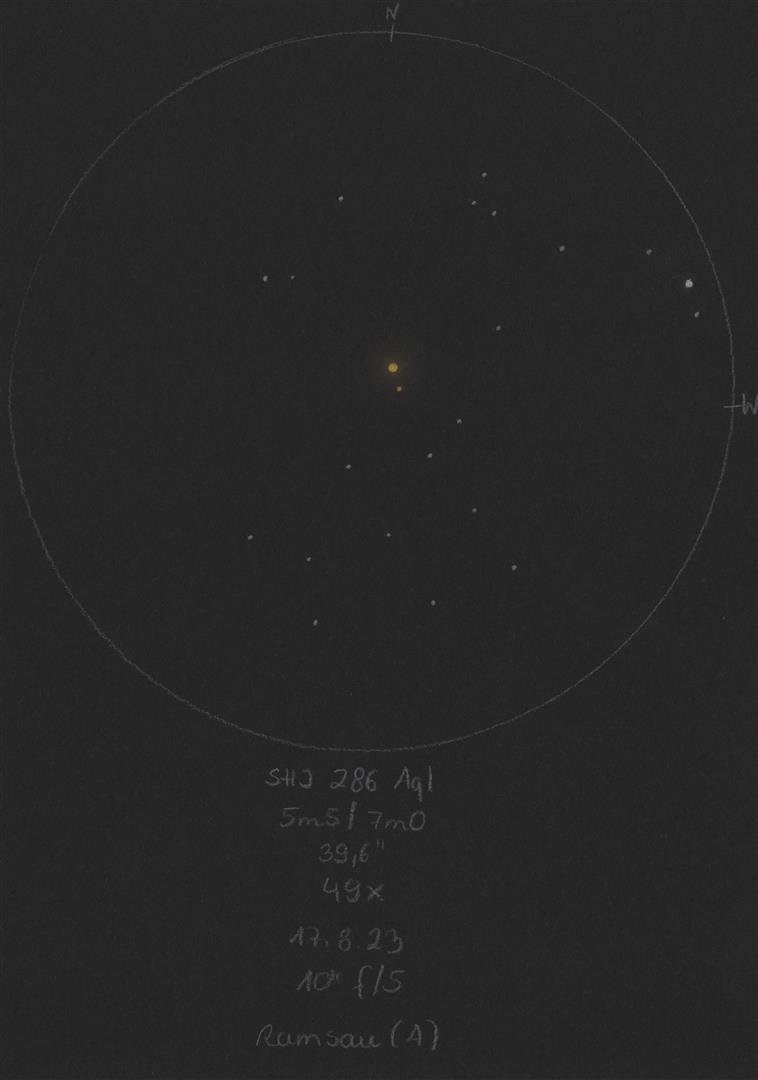
|
|
|
★
|
STF2449 |
|
|
7m.2 |
7m.7 |
8.2" |
289° |
2020 |
Aql |
19h06m23.04s / +07°09'20.10" |
Robert Zebahl
Leipzig (Germany) |
70mm (22x) |
At 22x well separable, but quite close together. Some fainter and similarly bright stars in the immediate surrounding. At 57x small difference in brightness. Main component looked white-bluish, companion slightly orange. |
|
René Merting
Drachhausen (Germany) |
100mm (32x) |
bei 32x ein knapp getrenntes Pärchen - B-Komponente westlich nur unwesentlich schwächer - beide Sterne heiraten in weiß - STF2449 ist ein schönes Doppel-Doppel zusammen mit dem 37' südlich stehenden STF2446, wo die Komponenten einen ähnlichen Abstand haben |
|
Mark McCarthy
Fremont (California/USA) |
178mm (205x) |
Pretty pair, wide, white stars, <1 delta magnitude. WDS uncertain, but there is no overlap in their parallax ranges, so for sure not physical |
|
|
|
★
|
STF2457 |
|
|
7m.5 |
9m.5 |
10.2" |
201° |
2020 |
Vul |
19h07m08.02s / +22°35'03.70" |
René Merting
Drachhausen (Germany) |
100mm (32x) |
bei 32x gut getrennt, bei 64x schon ein ordentlicher Abstand - wie STF2457 und der nahe STF2455 (25' nördlicher) sich gegenüberstehen und die jeweils schwächere Komponente in Richtung des anderen Doppelsterns vor sich herschiebt, das hat was - als ob die beiden Fußball spielen (die jeweilige Komponente A hat einen Ball vor den Füßen) - zwischen den beiden Doppelsternen steht ein schwacher Stern, vermutlich der verwirrte Schiedsrichter |
|
Christopher Hay
Seeheim (Germany) |
150mm (96x) |
Widely split. Attractive together in 0.8-degree FOV with Struve 2455AB a little less than half a degree south. The secondaries of the two doubles point towards each other, a nice sort of double-double. According to Stelledoppie 2457 is a physical double, while 2455AB is not. In 2457 the brightness of both components is less than those of 2455AB, their separation greater, and their colour contrast (itself hard to define) is greater. In 2455AB focussing on the A-component precisely is hard to achieve, perhaps due to an unresolved field star very close to it? |
|
Mark McCarthy
Fremont (California/USA) |
152mm (175x) |
Very faint B seen with averted vision only, around 2" separation |
|
Mark McCarthy
Fremont (California/USA) |
203mm (333x) |
Pale yellow stars, wide separation, 1.5 delta mag. |
|
René Merting
Drachhausen (Germany) |
320mm (45x) |
bei 45x schön zusammen mit STF 2455 im Gesichtsfeld - zwischen beiden DS steht auf halber Strecke ein etwa gleich heller Stern, sodass der Gesamteindruck von zwei Spielern entsteht, die sich gegenseitig einen Ball zuspielen - die A-Komponenten sind jeweils gleich hell und die B-Komponenten etwa 1.5 Größenklassen schwächer - sehr schön! |
|
|
|
★
|
STF2461, 17 Lyr |
|
AB |
5m.3 |
9m.1 |
3.2" |
281° |
2017 |
Lyr |
19h07m25.58s / +32°30'06.20" |
René Merting
Drachhausen (Germany) |
100mm (142x) |
nichts zu holen für mich bis 142x, vermutlich verhindert der große Helligkeitsunterschied die Trennung |
|
Robert Zebahl
Leipzig (Germany) |
152mm (129x) |
At 129x clearly split. The B component was just visible as pretty faint, tiny star. At 270x much easier visible. |
|
Mark McCarthy
Fremont (California/USA) |
152mm (175x) |
Elongation only up to 380x |
|
Mark McCarthy
Fremont (California/USA) |
317mm (553x) |
17 Lyr. Yellow and red, much fainter B ~3 delta mag. |
|
Mark McCarthy
Fremont (California/USA) |
508mm (667x) |
17 Lyr. Huge delta mag. B is obvious in 20", though A's diffraction was horrible. Used mask to clean it up but the B star momentarily disappeared, though I could eventually pull it back out with seeing and critical focus. 4 delta mag. |
|
|
|
★
|
STF2470 |
|
|
7m.0 |
8m.4 |
13.8" |
267° |
2017 |
Lyr |
19h08m45.20s / +34°45'37.10" |
Robert Zebahl
Leipzig (Germany) |
16x70 |
2020-07-06: Striking with well visible brightness difference. Very nice together with STF2474, which gives a similar view. A double-double for binoculars. |
|
René Merting
Drachhausen (Germany) |
100mm (20x) |
bei 20x knapp getrennt - wunderschönes Synchrontänzer-Doppel-Doppel zusammen mit STF2474 unmittelbar 10' südlich, weil A und B bei beiden Paaren mit gleichen Helligkeiten und Positionswinkel strahlen - A-Komponente von STF2470 knapp schwächer als A-Komponente von STF2470 |
|
Axel Tute
Küssaberg (Germany) |
100mm (144x) |
07.09.2023: A light blue. B white. Very nice star field with STF2474 |

|
Robert Zebahl
Leipzig (Germany) |
102mm (40x) |
Striking, especially with STF 2474 in one visual field. The color of the components was not clearly visible. Worthwhile! Sketch see STF 2474. |
|
Sarah Gebauer
Germany |
150mm (85x) |
nach mehreren Anläufen dann gefunden und bei 85x wie ein Doppel-Doppel im Bild, sehr sehenswert, auch der Abstandsunterschied (13,8'' bei STF 2470 und 15,9'' bei STF 2474) ist zu erkennen |

|
|
|
★★
|
STF2474 |
|
AB |
6m.8 |
7m.9 |
16.0" |
262° |
2019 |
Lyr |
19h09m04.35s / +34°35'59.90" |
Robert Zebahl
Leipzig (Germany) |
16x70 |
2020-07-06: Striking with well visible brightness difference. Very nice together with STF2470, which gives a similar view. A double-double for binoculars. |
|
René Merting
Drachhausen (Germany) |
100mm (20x) |
bei 20x knapp getrennt - wunderschönes Synchrontänzer-Doppel-Doppel zusammen mit STF2470 unmittelbar 10' nördlich, weil A und B bei beiden Paaren mit gleichen Helligkeiten und Positionswinkel strahlen - A-Komponente von STF2474 knapp heller als A-Komponente von STF2470 - bei 64x Komponente A ein wenig gelblich |
|
Axel Tute
Küssaberg (Germany) |
100mm (144x) |
07.09.2023: A light blue. B white. Very nice star field with STF2470 |

|
Robert Zebahl
Leipzig (Germany) |
102mm (40x) |
Pretty conspicuous, easy double star. Especially attractive with the nearby double star STF 2470, as both are very similar in brightness, distance and position angle. The color of both components appeared slightly yellowish-orange. |

|
Sarah Gebauer
Germany |
150mm (85x) |
nach mehreren Anläufen dann gefunden und bei 85x wie ein Doppel-Doppel im Bild, sehr sehenswert, auch der Abstandsunterschied (13,8'' bei STF 2470 und 15,9'' bei STF 2474) ist zu erkennen |

|
Christopher Hay
Seeheim (Germany) |
150mm (96x) |
Widely separated. Component A yellowish, B light ice-blue. A true physical pair in 171 LY distance. Very attractive in field of view together with Struve 2470 about 10 arcseconds north. The components of each of the two Struves have almost the same position angles, similar separations and very similar delta-magnitudes. Struve 2470 is like an echo of 2474 but with no definite colour impression. |
|
|
|
★
|
STF2486 |
|
AB |
6m.5 |
6m.7 |
7.2" |
204° |
2020 |
Cyg |
19h12m05.03s / +49°51'20.70" |
|
|
René Merting
Drachhausen (Germany) |
15x56 |
eine Ameise mit Nordost-Südwestausdehnung - Einschnürung nur leicht |
|
Robert Zebahl
Leipzig (Germany) |
16x70 |
2020-07-03: Fine split, but very tight with equally bright components. |
|
Robert Zebahl
Leipzig (Germany) |
70mm (22x) |
At 22x barely split with a slight difference in brightness. At 44x the primary looked orange. I could not determine the color of the companion. |
|
Mark McCarthy
Fremont (California/USA) |
317mm (553x) |
Near equal yellow pair. |
|
|
|
★
|
BU139 & STTA177, V338 Sge |
BU139 |
AB |
7m.1 |
8m.0 |
0.6" |
135° |
2017 |
Sge |
19h12m34.45s / +16°50'47.20" |
|
|
|
STTA177 |
AC |
7m.1 |
8m.0 |
98.4" |
276° |
2017 |
|
|
|
|
|
BU139 |
AE |
7m.1 |
11m.2 |
28.8" |
101° |
2015 |
|
|
|
|
|
BU139 |
CD |
8m.0 |
11m.2 |
138.9" |
269° |
2015 |
|
|
|
|
René Merting
Drachhausen (Germany) |
12x42 |
STTA177 (AC): zwei komfortabel getrennte Sterne - Komponente C im Westen wirkt grauweiß und ist gut eine bis eineinhalb Größenklassen schwächer |
|
Mark McCarthy
Fremont (California/USA) |
80mm (13x) |
STTA177 (AC): Near equal wide pair split in finder |
|
Mark McCarthy
Fremont (California/USA) |
152mm (456x) |
BU139 (AB): Very subtle notched unequal elongation at all powers. Physical with a 587-year period, currently coming of apastron, it will continue to tighten. Component of STT 177. Burnham discovered with his 6-inch in at 0.5", about what it is now, an astounding catch |
|
Frederik Wanink
Itterbeck (Germany) |
254mm (640x) |
BU139 (AB): getrennt, schwierig, 0,6"? |
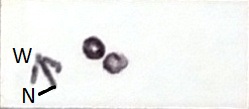
|
Mark McCarthy
Fremont (California/USA) |
317mm (553x) |
STTA177 (AC): Very wide orange-yellow and blue, ~2-3 delta mag. |
|
René Merting
Drachhausen (Germany) |
320mm (45x) |
STTA177 (AC): bei 45x weit auseinanderstehend - A wirkt weiß und B schmutzig gelblich, was sich bei 103x bestätigt |
|
|
|
★★
|
STF2496 |
|
AB |
6m.5 |
10m.0 |
2.1" |
81° |
2016 |
Cyg |
19h15m19.18s / +50°04'16.00" |
|
|
|
|
AC |
6m.5 |
11m.2 |
186.1" |
242° |
2003 |
|
|
Robert Zebahl
Leipzig (Germany) |
152mm (270x) |
AB: In steadier moments, the much fainter companion can be seen near the first diffraction ring of the primary component. |
|
Mark McCarthy
Fremont (California/USA) |
317mm (553x) |
AB: Very much fainter B, a pin prick when seeing stills. 3 delta mag, ~2" |
|
|
|
★
|
STT371 |
|
AB |
7m.0 |
7m.5 |
0.9" |
161° |
2018 |
Lyr |
19h15m56.96s / +27°27'21.40" |
|
|
|
|
AB-C |
7m.0 |
9m.8 |
47.2" |
268° |
2019 |
|
|
René Merting
Drachhausen (Germany) |
100mm (20x) |
AB-C: bei 20x ist Komponente C im Westen schwach erkennbar in einem ordentlichen Abstand zu Komponente AB |
|
Robert Zebahl
Leipzig (Germany) |
102mm (160x) |
2021-08-20: At 28x the much fainter C component is clearly visible at quite a large separation. The tight pair AB showed up at 160x and 187x clearly elongated, partially as an '8'. A small difference in brightness could be guessed. Higher magnifications did not yield any gain. The air was only moderately steady (seeing 3/5). |
|
Mark McCarthy
Fremont (California/USA) |
152mm (104x) |
AB-C: Nice close 2 delta white stars. Not physical. Power too low to notice AB is 0.9" 7.05/7.55 and physical |
|
Mark McCarthy
Fremont (California/USA) |
203mm (333x) |
AB: Bright pair showed best masked down to 8-inches. Near equal, white stars, perfect! |
|
Frederik Wanink
Itterbeck (Germany) |
254mm (640x) |
AB: getrennt |
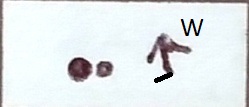
|
|
|
★
|
STT368 |
|
AB |
7m.5 |
8m.5 |
1.1" |
218° |
2017 |
Aql |
19h16m01.84s / +16°09'39.50" |
|
|
|
|
AC |
7m.5 |
13m.2 |
15.2" |
105° |
2016 |
|
|
Mark McCarthy
Fremont (California/USA) |
178mm (205x) |
AB: Very nice, very close split, 1 delta mag, excellent pair. WDS uncertain, but very probably gravitational: 4% parallax range overlap with 2% error, 221 AU weighted separation, 2.43/1.91 solar mass, pretty high given the low AU separation |
|
Mark McCarthy
Fremont (California/USA) |
203mm (333x) |
AB: Very fine 1 delta mag, ~1" split, white. |
|
Mark McCarthy
Fremont (California/USA) |
317mm (553x) |
AB: Definite split, 1/2 an airy disk width, near equal brightness. |
|
René Merting
Drachhausen (Germany) |
320mm (288x) |
AB: bei 206x als 8 erkennbar, wobei die Komponenten sich jeweils im Beugungsscheibchen des Nachbarn suhlen - bei 288x sind dann beide Sterne in ruhigen Momenten getrennt zu sehen - sie sind schon ordentlich aufgebläht und nicht mehr sehr ansehnlich |
|
|
|
★
|
BU248 & HO654, 2 Vul |
BU248 |
AB |
5m.4 |
8m.8 |
1.8" |
128° |
2015 |
Vul |
19h17m43.64s / +23°01'32.00" |
|
|
|
HO654 |
AC |
5m.4 |
10m.4 |
51.1" |
119° |
2015 |
|
|
Mark McCarthy
Fremont (California/USA) |
152mm (245x) |
AB: 2 Vul. Nice! B seen just outside bright A's diffraction as a very small fine point, 3 delta mag. WDS is uncertain, but there's a good chance they are gravitationally bound: 24% parallax range overlap, 985 AU separation, 6.47/2.98 mass |
|
Mark McCarthy
Fremont (California/USA) |
203mm (205x) |
AB: 2 Vul. White A and light blue B, split outside first diffraction ~1.5" really pretty. Burnham discovered in 1876 with his 6-inch at 1.86", "a fine pair with a moderate aperture" |
|
René Merting
Drachhausen (Germany) |
320mm (206x) |
AB: bei 206x erscheint in ruhigen Momenten blickweise die B-Komponente im Beugungsring von A in Richtung Südosten |
|
|
|
★
|
STF2505 |
|
AB |
8m.3 |
9m.5 |
10.9" |
315° |
2015 |
Lyr |
19h19m52.83s / +35°32'16.60" |
|
|
|
|
AC |
8m.3 |
13m.3 |
20.8" |
224° |
2015 |
|
|
René Merting
Drachhausen (Germany) |
100mm (32x) |
AB: bei 32x gut getrenntes Pärchen - Komponente B ist nur leicht schwächer als A - Komponente A ist nicht ganz weiß, mehr wie ein zarter Stich ins gelbliche |
|
Mark McCarthy
Fremont (California/USA) |
317mm (553x) |
AB: Orange and blue, looks like Alberio, but fainter. Wide separation. |
|
|
|
★
|
COU1023 |
|
|
9m.5 |
9m.5 |
0.2" |
138° |
2014 |
Lyr |
19h20m23.74s / +26°30'58.80" |
Mark McCarthy
Fremont (California/USA) |
508mm (1067x) |
Hairline split, very definite and consistent, near equal |
|
|
|
★
|
TDT1416 |
|
|
10m.5 |
11m.1 |
0.7" |
298° |
1991 |
Vul |
19h23m28.49s / +22°34'19.70" |
Mark McCarthy
Fremont (California/USA) |
508mm (533x) |
Exceptionally fine, split with seeing, very faint ~1 delta mag. B resolves at first diffraction, light orange stars |
|
|
|
★★
|
A2786 |
|
|
10m.1 |
10m.1 |
0.4" |
108° |
2014 |
Vul |
19h26m57.67s / +21°09'02.70" |
Mark McCarthy
Fremont (California/USA) |
508mm (1067x) |
Wow! Exceptionally fine but clean split, ~1 delta split, best without apodising mask, nearly perfect seeing. In the same FOV as STF 2523. |
|
|
|
★★
|
STF3132 |
|
AB |
10m.1 |
11m.8 |
7.8" |
39° |
2020 |
Vul |
19h28m12.76s / +20°12'59.60" |
Mark McCarthy
Fremont (California/USA) |
178mm (205x) |
2 delta B seen with averted vision only. There are two other faint stars, WAL 113 AC and AD. Forms a double-double with STF2530 in the same field. WDS says physical, and there is 21% parallax overlap, 1,441 AU weighted separation, and 1.40/1.06 solar mass. However the radial velocity delta (2.07) exceeds the escape velocity (1.74), so likely will not remain gravitationally bound |
|
Mark McCarthy
Fremont (California/USA) |
317mm (553x) |
Near equal orange stars with hairline split April 2019 |
|
|
|
★★★
|
beta Cyg, 6 Cyg, Albireo, STFA43 |
|
AB |
3m.2 |
4m.7 |
34.6" |
54° |
2022 |
Cyg |
19h30m43.29s / +27°57'34.90" |
Sarah Gebauer
Germany |
6x24 |
auf Anhieb schön getrennt, wenn auch sehr, sehr eng - der leichte Orangefarbton der Hauptkomponente ist sofort auszumachen, das Blau des Begleiters noch ganz zart und blass - wirklich entzückend in der Kleinstvergrößerung! |
|
Christopher Hay
Seeheim (Germany) |
7x42 |
Handheld binoculars in reclining chair. Following a surprisingly easy split of Zeta Lyr, I try out whether Albireo may also be splittable. Indeed, the pair is split, difficult but definite. Staring at Altair (Alpha Aql) for a few seconds with the binoculars prior to observing Albireo heigtens my acuity and makes the split more definite. Component A exhibits a mild orange-yellow hue. |
|
Robert Zebahl
Leipzig (Germany) |
8x40 |
Well split, but I didn't recognised any color. |
|
René Merting
Drachhausen (Germany) |
10x50 |
Komponente A ist gleißend hell und stroh-gelb, Komponente B ist deutlich schwächer leicht abgesetzt von A erkennbar und strahlt eigenartig mintgrün |
|
Christopher Hay
Seeheim (Germany) |
12x36 |
Well split. A golden-red, B cold blue. Gorgeous! |
|
René Merting
Drachhausen (Germany) |
12x42 |
ein bisschen mehr als knapp getrenntes Pärchen - A strahlt in einem schönen, hellen Gelb, B wirkt blaugrau - Helligkeitsunterscheid etwas mehr als eine Größenklasse |
|
Sarah Gebauer
Germany |
12x42 |
ein knackscharfes, farbiges, leuchtendes Paar, nach der Saisonpause endlich wieder sichtbar - A strahlt warm, orangegold, kräftig - B glitzert kristalleisblau klein daneben - ein traumhafter Anblick im Fernglas, die Sternumgebung nimmt sich scheinbar bewusst zurück und sprenkelt das Bild mit zahlreichen schwachen Sternen |

|
René Merting
Drachhausen (Germany) |
15x56 |
die Hauptkomponente strahlt in einem schönen buttergelb, die Komponente B zeigt sich westlich und wirkt bim ersten Eindruck mintgrün, der Farbeindruck verliert sich aber, je länger ich dieses schöne Sternpaar bewundere - Helligkeitsunterschied 1.5 bis 2 Größenklassen |
|
Robert Zebahl
Leipzig (Germany) |
16x70 |
2020-07-06: Bright orange & white-bluish. |
|
Robert Zebahl
Leipzig (Germany) |
80mm (25x) |
One of the most beautiful double stars in the northern hemisphere. Differences in brightness and color (orange-blue) are brilliant! Even under urban conditions with small aperture an enjoyment! |
|
René Merting
Drachhausen (Germany) |
100mm (32x) |
bei 32x stehen beide Sterne weit getrennt - Komponente A mit einem satten zitronen-gelb, Komponente B mit einem leichten Stich ins Blaue |
|
René Merting
Drachhausen (Germany) |
107mm (43x) |
bei 43x zeigt die hellere Komponente ein wunderschönes Samtgelb, kurz davor, ein richtig kräftiges Gelb zu sein - die schwächere Komponente wirkt auf den ersten Blick blauweiß |
|
Jörg S. Schlimmer
Germany |
127mm (203x) |
easy to split |
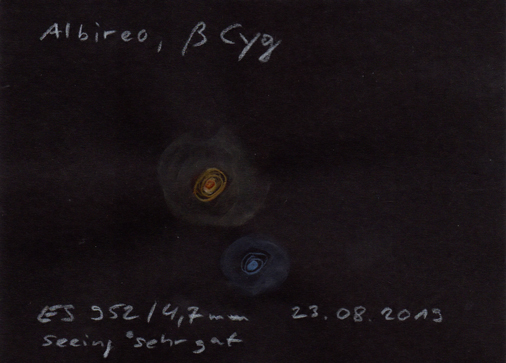
|
Sarah Gebauer
Germany |
150mm (116x) |
Erstbeobachtung August 2019: deutlicher Farbunterschied zwischen blau und sattem Gelb zu sehen |
|
Jörg S. Schlimmer
Germany |
305mm (170x) |
alle Komponenten einfach zu trennen |
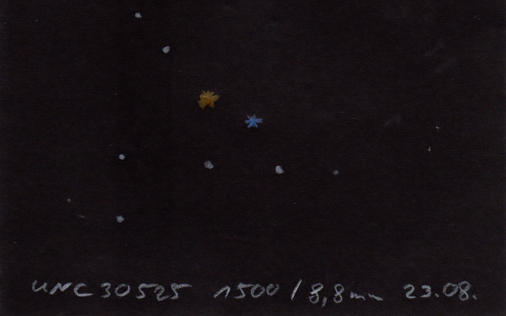
|
René Merting
Drachhausen (Germany) |
320mm (45x) |
|
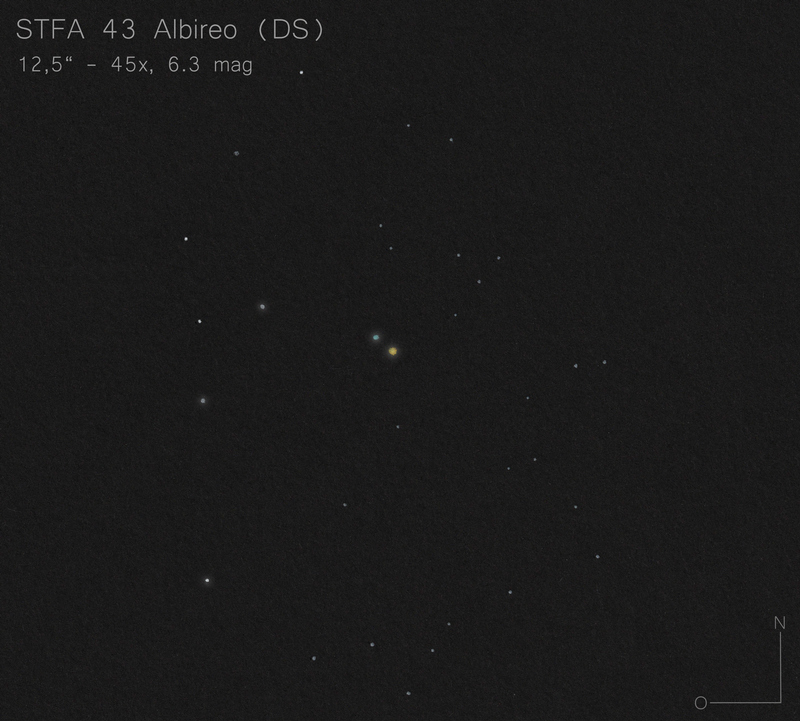
|
|
Frederik Wanink
Itterbeck (Germany) |
254mm |
Doppelsternnatur von MCA 55 nicht zu sehen |

|
Werner E. Celnik
Rheinberg (Germany) |
150mm |
|
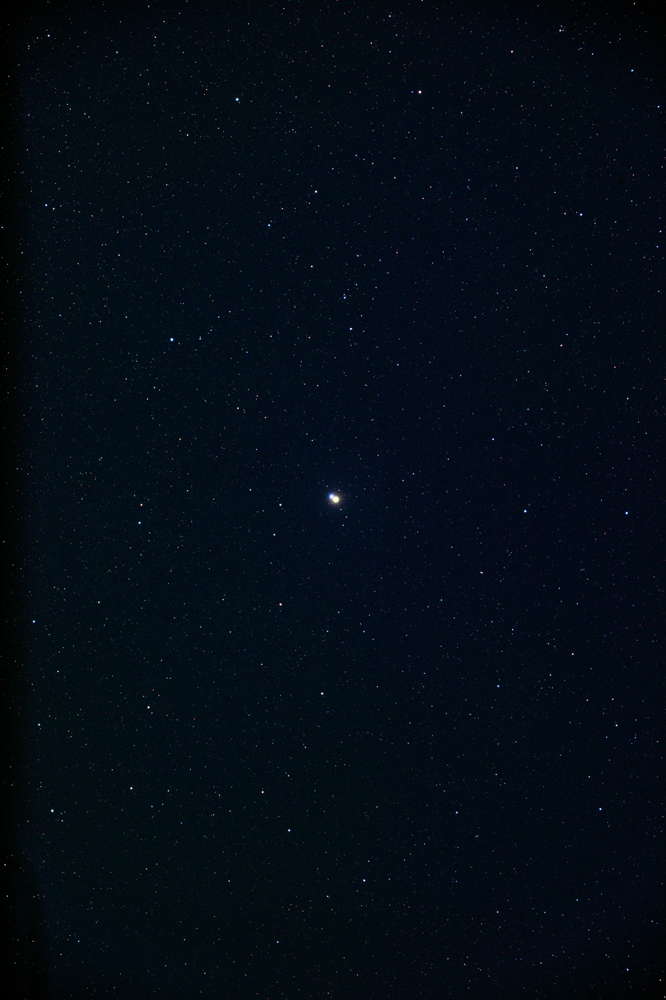

|
Werner E. Celnik
Rheinberg (Germany) |
150mm |
|
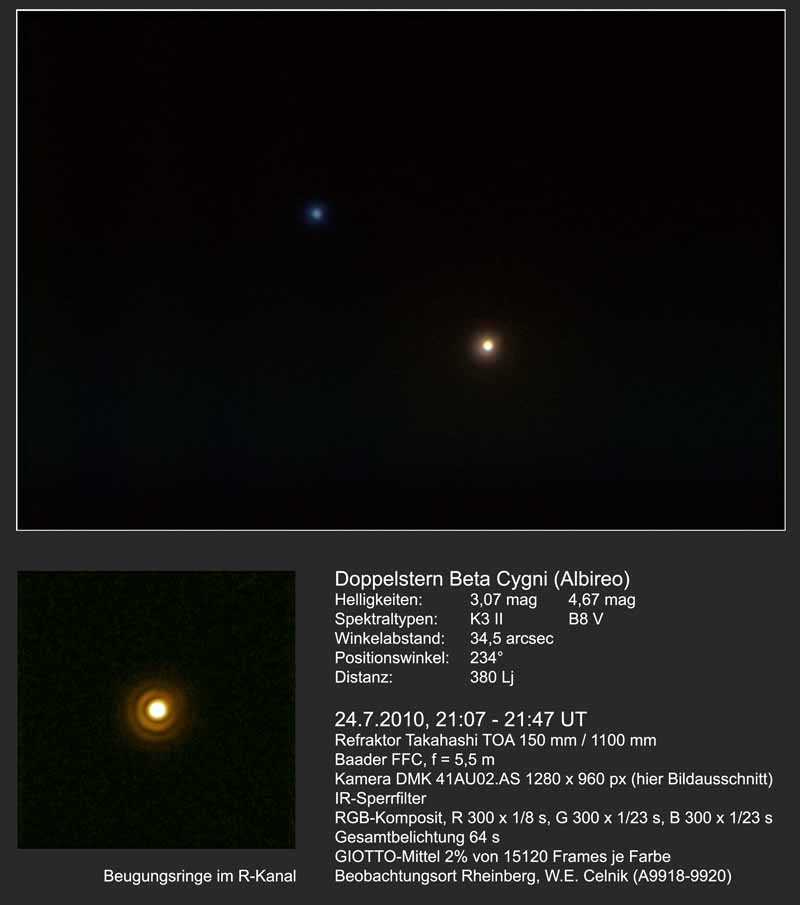
|
|
|
★
|
D20, V822 Aql |
|
AB |
7m.2 |
9m.6 |
1.3" |
65° |
1991 |
Aql |
19h31m15.78s / -02°06'36.70" |
Mark McCarthy
Fremont (California/USA) |
317mm (553x) |
A has a notched / trailing star in east PA, very close in and very much fainter. With seeing. Tough! |
|
Mark McCarthy
Fremont (California/USA) |
317mm (553x) |
tight airy disk of A, and a faint star widely separated, 3 delta mag ~25" Very near to a pretty orange carbon star. |
|
|
|
★★
|
A598 |
|
AB |
9m.9 |
10m.2 |
1.0" |
191° |
2016 |
Cyg |
19h36m29.82s / +41°24'08.60" |
Mark McCarthy
Fremont (California/USA) |
317mm (553x) |
UV Cyg. Orange-red with very much fainter blue ~1", 1 delta mag. Seeing must still. A a perfect round disk the color of the setting sun. Very special. |
|
|
|
★★★
|
HN 84, V340 Sge |
|
|
6m.4 |
9m.5 |
28.4" |
301° |
2013 |
Sge |
19h39m25.33s / +16°34'16.00" |
René Merting
Drachhausen (Germany) |
12x42 |
man muss schon länger hinschauen, bevor die schwache Komponente nordwestlich leicht abgesetzt von A erkennbar ist |
|
Sarah Gebauer
Germany |
12x42 |
etwas mehr als knapp getrennt, A strahlt sehr schön dunkelgelb bis goldbraun |
|
René Merting
Drachhausen (Germany) |
12x50 |
verdammt schwer - Komponente B ist ganz schwach nordwestlich von A auszumachen - beide Sterne berühren sich noch |
|
René Merting
Drachhausen (Germany) |
16x70 |
beide Sterne präsentieren sich gut getrennt, nicht zu weit aber auch nicht zu nah - Komponente A meint es gut mit der Farbe gelb, bei Komponente B kann ich keine Farbe erkennen |
|
Christopher Hay
Seeheim (Germany) |
80mm (30x) |
Primary ruddy red, secondary wide apart but too faint for any colour impression. Straw-yellow Epsilon Saggitae half a degree to the west with its ice-blue eastern companion enhances the experience of colour contrast in the FOV and is actually more attractive than HN 84 with this aperture and power. |
|
René Merting
Drachhausen (Germany) |
100mm (20x) |
bei 20x sind beide Komponenten weit getrennt - Komponente A auffällig gelb-orange, B dagegen grau-blau, ein schöner Farbkontrast, der sich bei 32x verstärkt |
|
Sarah Gebauer
Germany |
150mm (85x) |
Holden 84, eine sehr goldgelbe Komponente und in 28'' Abstand die zweite, sehr schwache und weiße Komponente mit einem Hauch von Blau, sehr, sehr schön! |
|
Christopher Hay
Seeheim (Germany) |
150mm (96x) |
Main component ruddy tangerine orange, companion wide apart and ice blue. The longer I look the stronger the colour contrast becomes, which is by no means normal in many doubles. Epsilon Saggitae in same 0.8-degree field of view is straw-yellow with a cold blue companion (a field star?) pointing away from Epsilon in the direction of HN 84. I can’t think offhand of a better colour-contrast pair that can be framed in this manner in the same FOV. |
|
Sarah Gebauer
Germany |
150mm (160x) |
die hellere Hauptkomponente ist deutlich und stark goldfarben, die zweite dagegen sehr schwach, silbrig und dumpf |

|
Mark McCarthy
Fremont (California/USA) |
178mm (205x) |
Very pretty orange A and neon blue B, 1 delta mag, very wide |
|
René Merting
Drachhausen (Germany) |
320mm (103x) |
bei 45x weit getrennt, für den Farbeindruck aber auf 103x vergrößert, dann strahlt A in einem tiefsatten Gelb - B im Westen wirkt beiläufig betrachtet Türkis bis Blaugrau - wenn ich mich aber auf B konzentriere, verwandelt sich der Stern in eine grauweiße Maus |
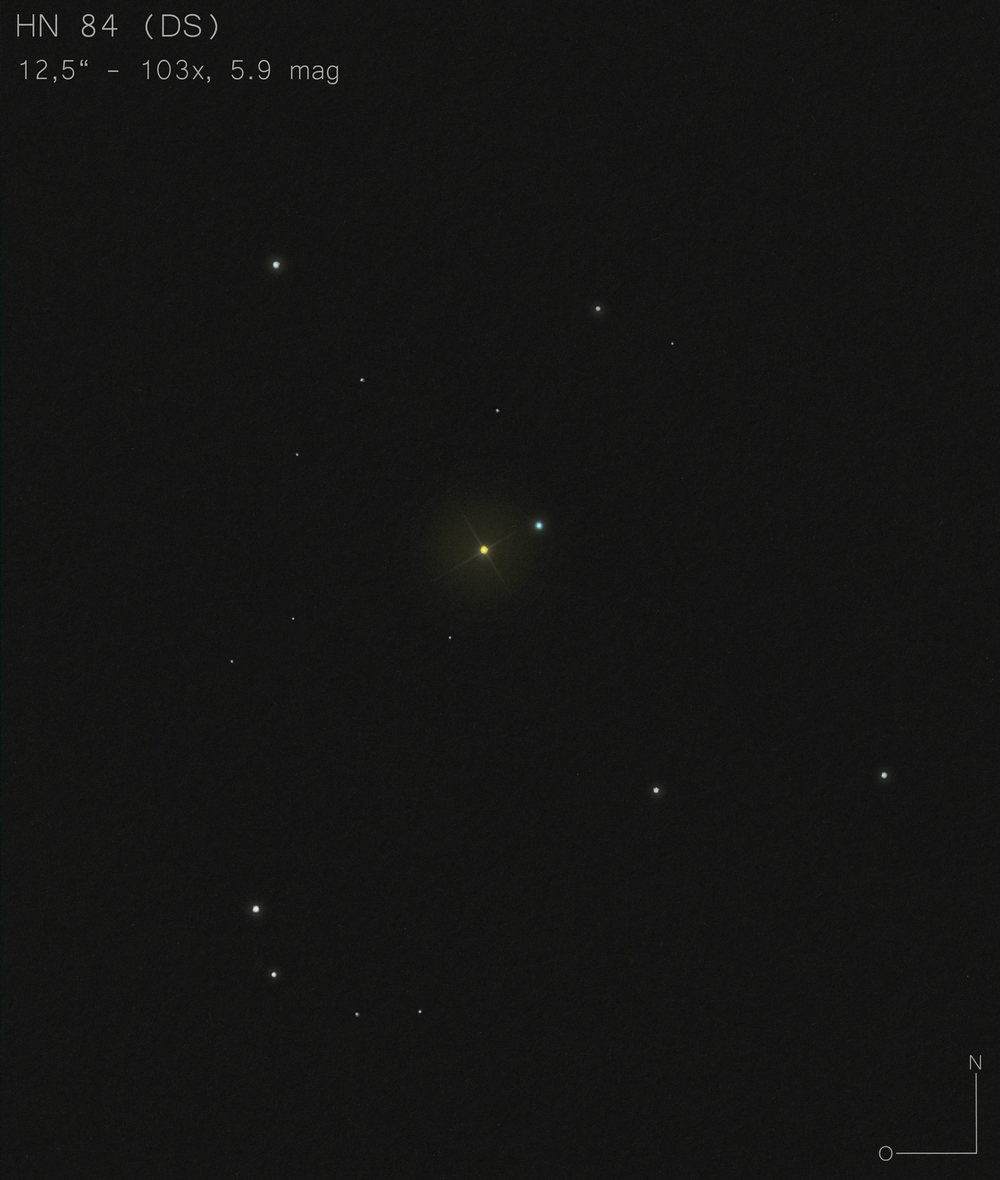
|
|
|
★
|
A272 |
|
AB |
9m.8 |
10m.4 |
1.3" |
193° |
2009 |
Vul |
19h40m09.48s / +26°11'23.40" |
Mark McCarthy
Fremont (California/USA) |
203mm (333x) |
Wow, I get the split, very close but split, obvious difference in magnitude, about 1 delta mag. Less than 1" sep. Impressed i could get it [CD is 15th mag and 1"!] |
|
|
|
★★
|
STFA46, 16 Cyg |
|
AB |
6m.0 |
6m.2 |
39.7" |
133° |
2020 |
Cyg |
19h41m49.09s / +50°31'31.60" |
Christopher Hay
Seeheim (Germany) |
3x63 |
Self-built binoculars, hence the unusual specification. Made of top-quality teleconverters, apochromatic and sharp to the edge.
With naked eye under good suburban sky 16 Cyg is just seen. In the 3x binoculars the double is split into two finest points of light in good moments despite the low magnification. A physical pair according to Stelledoppie.
Two-star rating awarded because this is a true physical pair that can be split with the smallest binoculars and reveals increasingly more with growing binocular size (brightness disctinction between A and B in 7x50, colour distinction in 15x45). |
|
Christopher Hay
Seeheim (Germany) |
7x50 |
Finely split, A-component appears very slightly brighter than B-component. A very pleasing binocular pair. |
|
Christopher Hay
Seeheim (Germany) |
15x45 |
Wide split, very strong visual presence dominating 4.5° FOV. A-component very pale orange, B-component equally pale blue. |
|
Robert Zebahl
Leipzig (Germany) |
16x70 |
2021-06-01: Very striking, bright at moderate separation and small difference in brightness. White-yellowish & white. |
|
René Merting
Drachhausen (Germany) |
18x70 |
zwei ordentlich getrennte fast gleich helle Sterne - beide Komponenten sind reinweiß und die hellsten Sterne im unmittelbaren Umfeld - auffällig |
|
Christopher Hay
Seeheim (Germany) |
44x100 |
Extremely strong pair in 1.9° FOV. Northern component marginally brighter and with slightest touch of yellow. |
|
Sarah Gebauer
Germany |
100mm (21x) |
27.09.23: bei 21-fach ein schmales, sehr helles, warmweiß bis leicht goldenes Farbsternpaar mit nahezu gleich hellen und gleichfarbigen Komponenten - westlich strahlt noch R Cyg etwas heller und in einem leicht intensiveren Gelb |
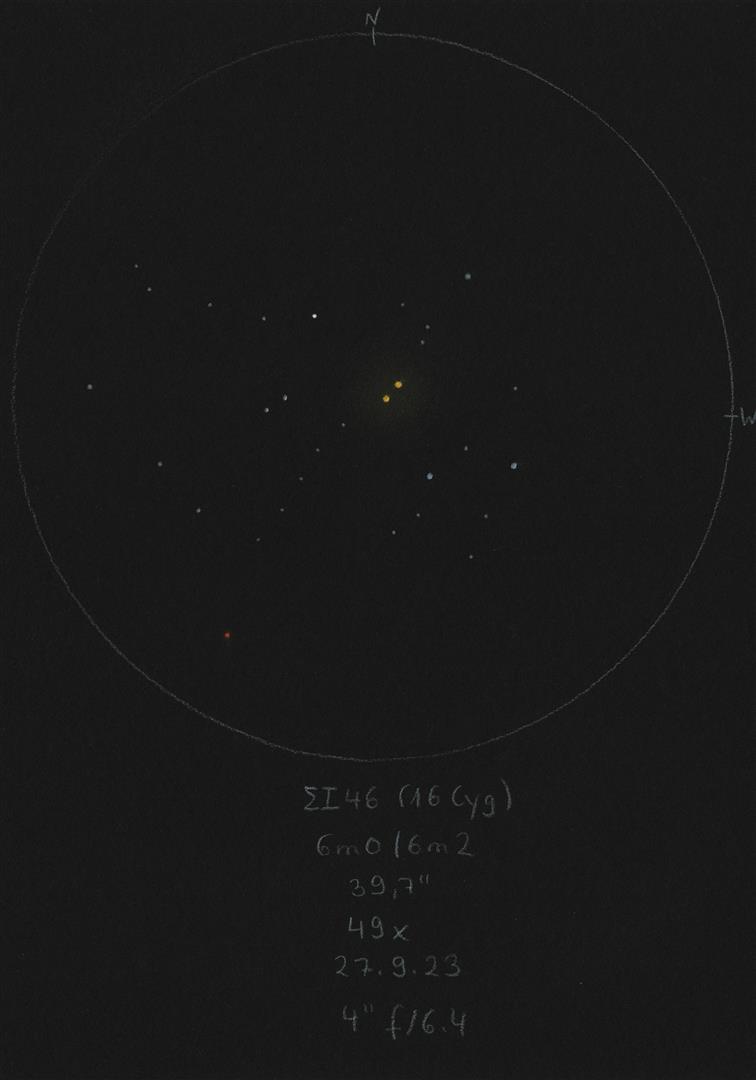
|
Sarah Gebauer
Germany |
100mm (80x) |
der Doppelstern springt mich regelrecht an bei der Suche nach dem Blinking PN, es sind zwei ganz durchdringende, gleich helle Sternpunkte, die zwar schon einem sternreichen Umfeld stehen, aber dennoch deutlich heller hervortreten; südlich davon befindet sich rein optisch betrachtet eine abgeschwächte Kopie davon |

|
Mark McCarthy
Fremont (California/USA) |
317mm (553x) |
16 Cyg: Wide equal orange-yellow, also split in 80mm finder |
|
|
|
★★
|
BU658, PS Vul |
|
|
6m.7 |
7m.9 |
0.4" |
282° |
2009 |
Vul |
19h43m55.97s / +27°08'07.50" |
Mark McCarthy
Fremont (California/USA) |
317mm (553x) |
Pretty orange star, subtly out of round / pear shaped. In a large cluster-like group of stars, around 3 degrees angular size, V-shaped, pretty in the finder. If the stars were brighter it would be as famous as the M45. |
|
|
|
★
|
AGC10 & STF2570 |
AGC10 |
AB |
8m.4 |
8m.4 |
0.2" |
137° |
2013 |
Aql |
19h44m56.78s / +10°46'30.60" |
|
|
|
STF2570 |
AB-C |
7m.6 |
9m.8 |
4.3" |
277° |
2016 |
|
|
Sarah Gebauer
Germany |
100mm (80x) |
STF2570 (AB-C): 24.09.23: der DS ist bei 80x getrennt zu sehen, die A-Komponente scheint schon sehr schwach, B zeigt sich sehr dicht und besonders schwach im Westen |
|
René Merting
Drachhausen (Germany) |
100mm (107x) |
STF2570 (AB-C): beide Komponenten erscheinen bei 107x knapp getrennt - der Begleiter ist nur ganz schwach sichtbar, wie ein Geist |
|
Stefan Loibl
Rosenheim (Germany) |
102mm (102x) |
STF2570 (AB-C): (AB) orange, C red-orange, faint pair, close to gamma Aql |
|
René Merting
Drachhausen (Germany) |
107mm (86x) |
STF2570 (AB-C): bei 60x ist die B-Komponente schon zu erkennen, bei 86x ist B extrem schwach und sehr dicht westlich von A auszumachen, ein eher unansehnliches, schwaches Sternpaar |
|
Mark McCarthy
Fremont (California/USA) |
152mm (175x) |
STF2570 (AB-C): Light orange A and blue B, nice separation, 2 delta mag. AB is AGC 10, 0.2" 8.43/8.42 |
|
Mark McCarthy
Fremont (California/USA) |
152mm (175x) |
STF2570 (AB-C): 2 delta mag, light orange AB and blue B. AB is AGC 10, 0.2" 8.43/8.42 and would be a good target for the 20-inch |
|
Mark McCarthy
Fremont (California/USA) |
152mm (285x) |
STF2570 (AB-C): Easily split, white A and much fainter ruddy B. Did not see AB, which is near equal mag. 0.2", which I could get with the 20-inch on a good night. |
|
René Merting
Drachhausen (Germany) |
320mm (72x) |
STF2570 (AB-C): bei 72x knapp getrenntes Pärchen, Komponente AB im Osten weiß-gelblich, C deutlich schwächer |
|
Mark McCarthy
Fremont (California/USA) |
508mm (333x) |
AGC10 (AB): Wide split pair. I was trying for AB 0.2" which only suggested elongation, too marginal to claim success |
|
Mark McCarthy
Fremont (California/USA) |
508mm (410x) |
AGC10 (AB): I can sense olive shape, very tough. |
|
Mark McCarthy
Fremont (California/USA) |
508mm (410x) |
STF2570 (AB-C): White and off white wide separated pair, ~1 delta mag. |
|
|
|
★
|
STF2579, delta Cyg, 18 Cyg |
|
AB |
2m.9 |
6m.3 |
2.7" |
213° |
2020 |
Cyg |
19h44m58.44s / +45°07'50.50" |
|
|
Robert Zebahl
Leipzig (Germany) |
70mm (200x) |
2019-07-28: At 100x only indicated. At 200x the much fainter companion is visible as a slightly elongated brightening on the first diffraction ring. |
|
Uwe Pilz
Leipzig (Germany) |
105mm (288x) |
blauweiß |
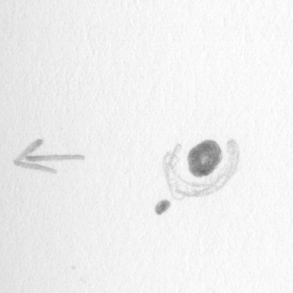
|
Robert Zebahl
Leipzig (Germany) |
152mm (133x) |
2022-09-21: At 92x clearly separated, but still pretty tight. Primary component slightly yellowish with much fainter companion. At 133x easy to separate. The faint companion appears orange-brownish. |
|
Mark McCarthy
Fremont (California/USA) |
317mm (553x) |
Very bright white with ruddy B, ~4", 4 delta mag. Nice! |
|
|
|
★★
|
STF2583, 52 Aql, pi Aql |
|
AB |
6m.3 |
6m.8 |
1.4" |
104° |
2019 |
Aql |
19h48m42.05s / +11°48'57.30" |
Axel Tute
Küssaberg (Germany) |
100mm (163x) |
19.08.2012: Simple at this magnification. No space between the two stars. |

|
Robert Zebahl
Leipzig (Germany) |
102mm (160x) |
2022-09-23: Small difference in brightness visible. From time to time the double star appeared just separated with a fine gap, but at least visible as a distinct '8'. |
|
Stefan Loibl
Rosenheim (Germany) |
102mm (205x) |
not fully split, seen as constricted '8' |
|
Robert Zebahl
Leipzig (Germany) |
120mm (337x) |
At 100x elongated, at 200x seen as '8'. At 337x split in moments of good seeing, but still very tight. Overall the seeing was not so good. |
|
Sarah Gebauer
Germany |
150mm (160x) |
wieder ganz haarscharf getrennt, bildet ein großes, nettes Dreieck mit Feldsternen, gefällt mir wieder sehr gut! |

|
Sarah Gebauer
Germany |
150mm (170x) |
bei 170x ganz, ganz knapp getrennt, ein haarfeiner, schwarzer Trennstrich ist zu sehen, eine geniale Grenzbeobachtung! |
|
Robert Zebahl
Leipzig (Germany) |
152mm (133x) |
2022-09-22: Very finely separated pair of nearly equally bright components. |
|
Mark McCarthy
Fremont (California/USA) |
152mm (285x) |
Pi Aql. Very pretty near equal light blue stars, cleanly separated |
|
Mark McCarthy
Fremont (California/USA) |
203mm (205x) |
Pi Aql. Pretty yellow-orange A and a little more than 1 delta mag pale blue B, ~1", yet neatly separated |
|
Frederik Wanink
Itterbeck (Germany) |
254mm (640x) |
Helligkeitsunterschied erkennbar |
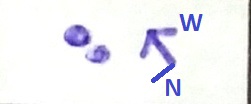
|
|
|
★
|
STT387 |
|
|
7m.1 |
7m.9 |
0.5" |
94° |
2020 |
Cyg |
19h48m43.81s / +35°18'41.30" |
|
|
Frederik Wanink
Itterbeck (Germany) |
254mm (640x) |
zeitweise als 8 zu sehen |
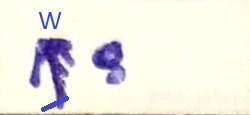
|
Mark McCarthy
Fremont (California/USA) |
317mm (277x) |
Red, very close pair? Seeing not supporting higher magnification. Marginal. |
|
Mark McCarthy
Fremont (California/USA) |
317mm (553x) |
Overlapping disks, to a nearly hairline split with seeing. Half delta mag. |
|
|
Frederik Wanink
Itterbeck (Germany) |
254mm |
|
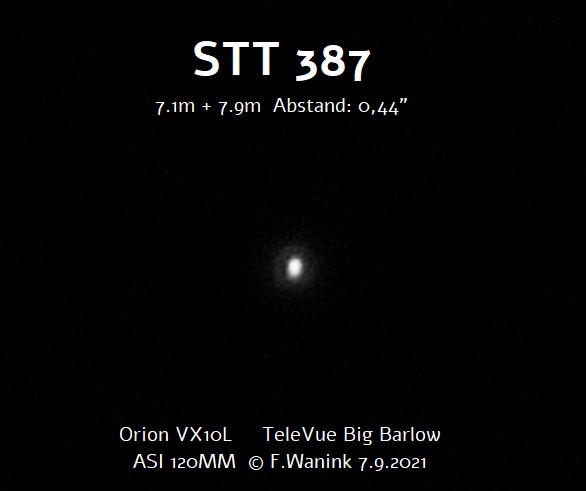
|
|
|
★
|
DJU4, 13 Vul |
|
|
4m.6 |
7m.4 |
1.5" |
248° |
2020 |
Vul |
19h53m27.69s / +24°04'46.60" |
|
|
Mark McCarthy
Fremont (California/USA) |
152mm (285x) |
Gorgeous! Bright A and 3 delta mag B appears as a fine point just beyond A's diffraction. Seen at 175x, best at 285x. Physical with a 615-year period, at apastron |
|
Frederik Wanink
Itterbeck (Germany) |
254mm (640x) |
schwierig wegen Helligkeitsunterschied |

|
|
|
★
|
STF2605, psi Cyg, 24 Cyg |
|
AB |
5m.0 |
7m.5 |
2.9" |
175° |
2017 |
Cyg |
19h55m37.82s / +52°26'20.50" |
Robert Zebahl
Leipzig (Germany) |
70mm (100x) |
At 80x difficult. At 100x and 133x the fainter component was clearly visible as small, roundish, partly slightly oval brightening. |
|
René Merting
Drachhausen (Germany) |
100mm (107x) |
bei 107x knapp getrennt, A strahlt weiß mit einer schwachen Andeutung von gelb, B im Süden ist deutlich schwächer |
|
Uwe Pilz
Leipzig (Germany) |
105mm (96x) |
nicht schwierig |
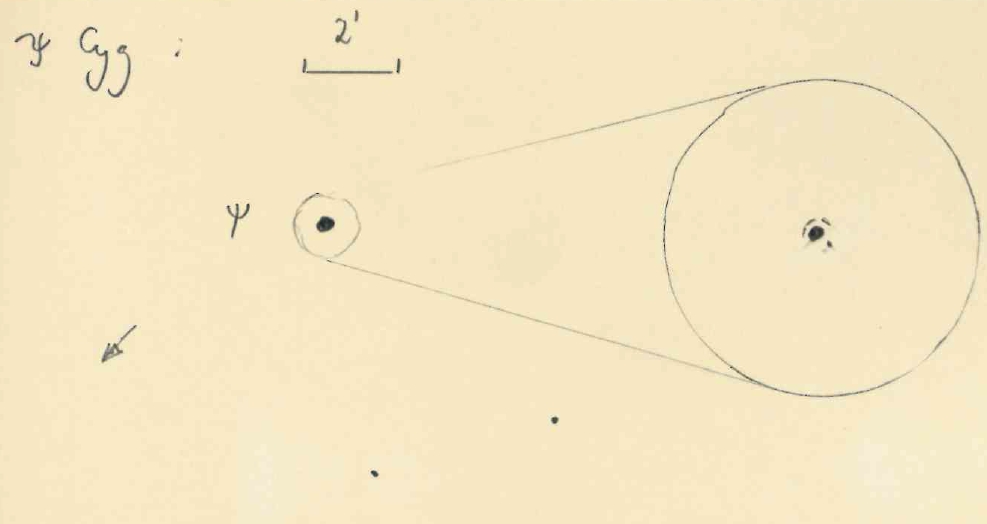
|
Uwe Pilz
Leipzig (Germany) |
105mm (144x) |
|

|
Mark McCarthy
Fremont (California/USA) |
317mm (553x) |
Yellow and ruddy, fairly wide, ~4" 2 delta mag. |
|
|
|
★★
|
STF2606 |
|
AB |
7m.7 |
8m.4 |
0.7" |
146° |
2018 |
Cyg |
19h58m32.66s / +33°16'38.80" |
|
|
Frederik Wanink
Itterbeck (Germany) |
254mm (640x) |
sehr schwierig, Luftunruhe |
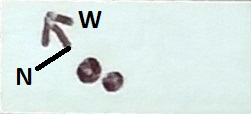
|
Mark McCarthy
Fremont (California/USA) |
317mm (553x) |
Hair split to clean split when seeing stills and there is only an airy disk. Near equal, half a delta mag. ~0.8" |
|
Mark McCarthy
Fremont (California/USA) |
508mm (333x) |
Close pair 2 delta mag. |
|
|
|
★
|
BU1133 |
|
|
6m.7 |
9m.9 |
1.1" |
344° |
2014 |
Cyg |
19h59m39.13s / +31°49'35.40" |
Mark McCarthy
Fremont (California/USA) |
317mm (553x) |
Tough find, dense field. Very temporary brightening in diffraction, 20% held. This is a tough one, <1" and large delta mag. |
|
Mark McCarthy
Fremont (California/USA) |
508mm (445x) |
B glimpsed with seeing at 445x, a solid point in some flaring from A. Suspected at 333x. WDS says physical, and unfortunately there is no parallax data on the companion. Burnham discovered on the Lick 36-inch at 0.9" |
|
|
|
★
|
STT394 |
|
AB |
7m.1 |
10m.3 |
11.0" |
294° |
2016 |
Cyg |
20h00m11.43s / +36°24'50.80" |
Mark McCarthy
Fremont (California/USA) |
152mm (175x) |
Light orange A and a faint wide companion. WDS calls it physical, no data for B in Gaia |
|
Mark McCarthy
Fremont (California/USA) |
152mm (245x) |
White star among several fainter stars, none which strike one as being the pair. WDS is calling it physical, and they might be right: 28% parallax range overlap, 2,011 AU weighted separation, 2.77/1.22 solar mass |
|
Mark McCarthy
Fremont (California/USA) |
317mm (553x) |
Pretty orange and blue, well separated, 2 delta mag. |
|
Mark McCarthy
Fremont (California/USA) |
508mm (205x) |
Wide, 3 delta mag light yellow A and blue B, pretty. WDS says physical, and there is 28% overlap in their parallax ranges, 2,011 AU weighted separation, 2.77/1.22 Msun, so possible it is gravitational |
|
|
|
★★
|
H5 47, 26 Cyg |
|
AB |
5m.2 |
8m.9 |
41.8" |
150° |
2018 |
Cyg |
20h01m21.55s / +50°06'16.80" |
|
|
|
|
AE |
5m.2 |
11m.1 |
168.3" |
343° |
2012 |
|
|
|
|
|
|
BC |
8m.9 |
12m.9 |
8.8" |
76° |
2015 |
|
|
|
|
|
|
BD |
8m.9 |
15m.8 |
9.4" |
258° |
2015 |
|
|
René Merting
Drachhausen (Germany) |
100mm (20x) |
AB: bei 20x ein weit getrenntes Pärchen mit schönem Farbkontrast - Komponente A im NW ist cremegelb, Komponente B ist mindestens 3 Größenklassen schwächer und zeigt sich weißgrau |
|
Sarah Gebauer
Germany |
100mm (80x) |
AB: 20.09.23: 26 Cygni strahlt bei 80-fach in einem schönen Gelb mit einem grauen, schwächeren Begleiter und bei genauem Betrachten fällt südlich des weit getrennten Doppels noch ein intensiv brauner Stern auf, nämlich der Veränderliche Z Cygni - drei Farben in einem Bild! |
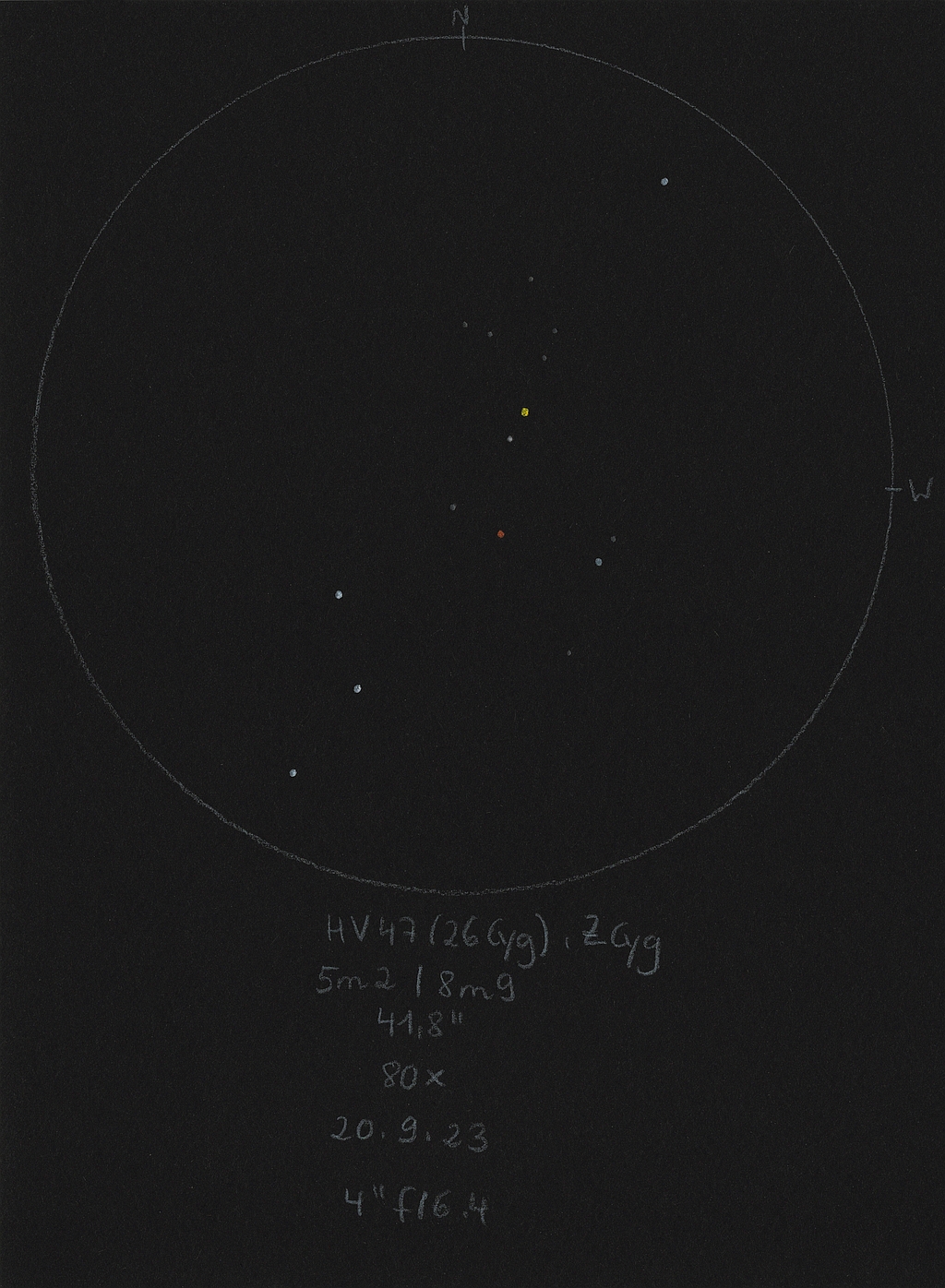
|
Robert Zebahl
Leipzig (Germany) |
152mm (30x) |
AB: 2023-09-14: Well separated, relatively wide, uneven pair. Bright component glows yellowish-orange, the significantly fainter companion also appears warm in color. |
|
René Merting
Drachhausen (Germany) |
320mm (72x) |
AB |
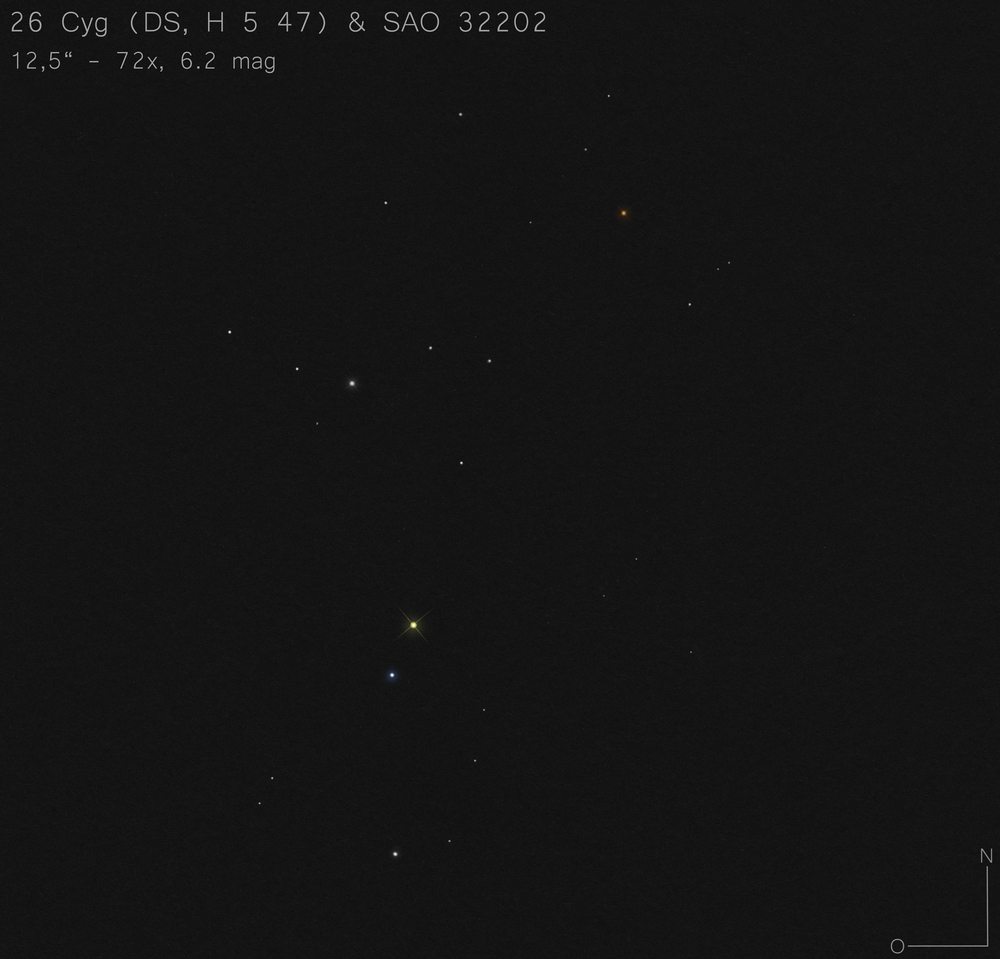
|
|
|
★★
|
SHJ314, V1676 Cyg |
|
AD |
6m.8 |
9m.5 |
11.3" |
299° |
2019 |
Cyg |
20h05m57.32s / +35°47'18.20" |
|
|
|
|
AF |
6m.8 |
7m.3 |
36.3" |
28° |
2019 |
|
|
René Merting
Drachhausen (Germany) |
100mm (32x) |
AD: bei 32x ist westlich von A knapp getrennt ein sehr schwacher Lichtpunkt erkennbar - mindestens 3 Größenklassen Helligkeitsunterschied zwischen A und D - zurück auf 20x sind beide Sterne auch noch ganz knapp getrennt erkennbar
AF: bei 32x sind zwei weit auseinander stehende Sterne erkennbar, Komponente F im NO ist nur unwesentlich schwächer und strahlt nicht ganz so klar wie A |
|
Sarah Gebauer
Germany |
100mm (49x) |
27.09.23: bei 49-fach ist das Mehrfachsystem innerhalb des Sternhaufens NGC 6871 einfach und hell zu sehen, die beiden Komponente A und D strahlen gleich hell im Norden und Süden und dicht westlich an A zeigt sich die deutlich schwächere D-Komponente |
|
Uwe Pilz
Leipzig (Germany) |
105mm (144x) |
liegt gemeinsam mit SHJ 315 im OC NGC 6871. Die Zeichnung des gesamten Haufens enthält nur die hellsten Sterne. |

|
|
|
★★
|
STF2675, kappa Cep, 1 Cep |
|
AB |
4m.4 |
8m.3 |
7.3" |
120° |
2016 |
Cep |
20h08m53.32s / +77°42'40.90" |
Robert Zebahl
Leipzig (Germany) |
55mm (38x) |
At 27x faint companion not visible. At 38x and higher magnification the companion is quite easily visible as faint, tiny star. Very nice, uneven pair! |
|
Mark McCarthy
Fremont (California/USA) |
152mm (175x) |
Light yellow bright A, 2 delta mag orange B, well separated. WDS physical, but they (just barely) don't share parallax range overlap, -3% |
|
Mark McCarthy
Fremont (California/USA) |
508mm (333x) |
Bright white and 3 delta mag light orange B, well split. |
|
|
|
★★
|
AC17 |
|
AB |
6m.2 |
10m.6 |
4.4" |
82° |
2016 |
Cyg |
20h12m31.73s / +51°27'49.00" |
Mark McCarthy
Fremont (California/USA) |
317mm (553x) |
Wow. Pretty orange-yellow and much fainter 3-4 delta mag B, resolves into view with seeing, just appears then vanishes if seeing quavers. ~4". |
|
|
|
★★★
|
STFA50, 30/31 Cyg, omicron Cyg |
|
AC |
3m.9 |
7m.0 |
108.6" |
173° |
2016 |
Cyg |
20h13m37.90s / +46°44'28.80" |
|
|
|
|
AD |
3m.9 |
4m.8 |
336.7" |
322° |
2016 |
|
|
Robert Zebahl
Leipzig (Germany) |
naked eye |
AD: Well split with noticeable difference in brightness. |
|
René Merting
Drachhausen (Germany) |
naked eye |
meist sehe ich nur einen diffusen Lichtpunkt und dann irgendwann … immer wieder sind A und D klar erkennbar und getrennt voneinander zu sehen - D steht in Richtung Nordwesten von A aus gesehen |
|
Sarah Gebauer
Germany |
naked eye |
AC: 16.09.23 Jeßnigk: Ohne zu wissen, dass es möglich ist, lässt sich Omicron 1 Cygni in beide Komponenten auftrennen - mit deutlichem Helligkeitsunterschied und sichtbarem Abstand zueinander sind beide Sterne sehr gut einzeln zu sehen |
|
Christopher Hay
Seeheim (Germany) |
3x63 |
AD: Self-built binoculars, hence the unusual specification.
Widely split, A (31 Cyg) light orange, D (30 Cyg) light blue. |
|
Christopher Hay
Seeheim (Germany) |
7x50 |
A-D: Widely split, A (31 Cyg) luminous orange-red, D (30 Cyg) luminous ice-blue. C set off from A as a fine speck of light. |
|
Robert Zebahl
Leipzig (Germany) |
8x40 |
AC: Observation at full moon. Easily split with big difference in brightness. Brighter component slightly orange. C component rather faint. |
|
Robert Zebahl
Leipzig (Germany) |
8x40 |
AD: Wonderful double star for binoculars. Large distance of the components, brighter once (31 Cyg) appeared slightly orange, the fainter (Cyg 30) more bluish. |
|
Christopher Hay
Seeheim (Germany) |
15x45 |
A-D: Very wide apart but still perceived as belonging together. A (31 Cyg) orange-red, D (30 Cyg) ice-blue. C well set off from A and light ice-blue, like an echo of D. A delightful group of three for binoculars at this power, further accentuated by nearby orange Omicron2 Cygni. Both the brightnesses and colour hues of Omi1A and Omi2 appear practically identical. |
|
Robert Zebahl
Leipzig (Germany) |
16x70 |
2020-07-03: Fantastic sight. A: bright orange, D: white-bluish, C: light blue. Very beautiful field. |
|
René Merting
Drachhausen (Germany) |
18x70 |
wunderschön - Komponente A präsentiert sich buttergelb - die südliche, schwächste Komponente C zeigt sich aquamarinblau - D im Norden ist reinweiß und steht dreimal weitere entfernt wie AC |
|
René Merting
Drachhausen (Germany) |
76mm (57x) |
Mondscheinnacht - bei 29x ein wunderschönes Sterntrio, A wirkt goldgelb, D weiß mit einem Stich ins türkise, C ist kühlweiß mit einem Stich ins Blaue |
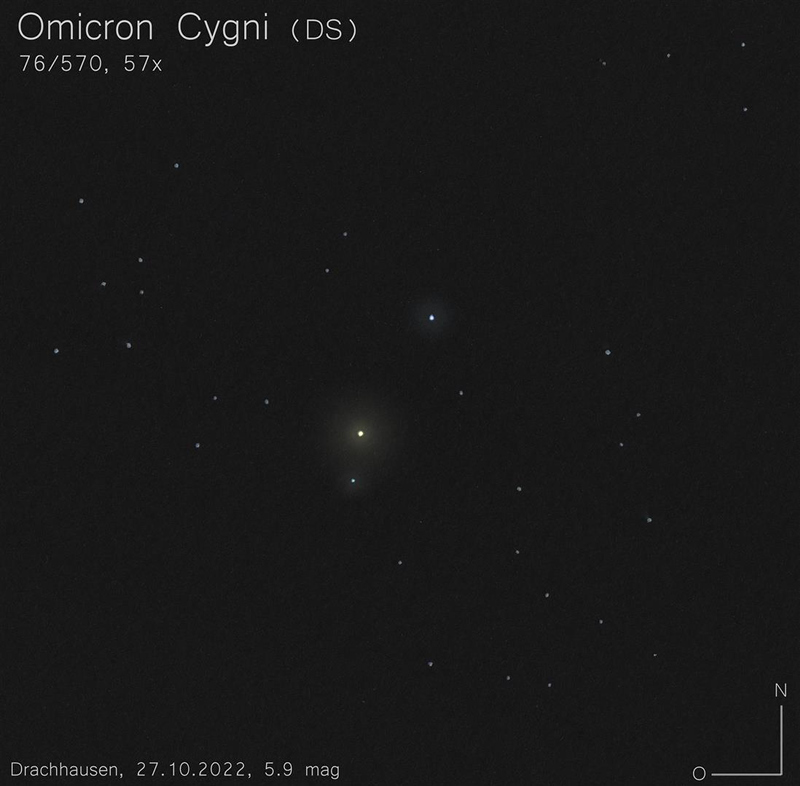
|
Robert Zebahl
Leipzig (Germany) |
80mm (25x) |
AC: Similar to the observation with binoculars. C component appeared bluish and gave good contrast to the orange colored 31 Cyg. |
|
René Merting
Drachhausen (Germany) |
100mm (32x) |
bei 32x sind alle drei Sterne weit getrennt und doch irgendwie zusammengehörend, Komponente A ist rapsgelb und am auffälligsten, Komponente D strahlt weiß und die schwächste Komponente C schimmert bläulich, schöner Anblick |
|
Robert Zebahl
Leipzig (Germany) |
102mm (28x) |
Bright, wide apart and wonderful contrast in color. A: light yellowish-orange, C: blue, D: light blue. |

|
René Merting
Drachhausen (Germany) |
107mm (30x) |
|

|
Sarah Gebauer
Germany |
150mm (30x) |
die drei Komponenten plus Omicron2 bilden ein wunderschönes, sehr langes und spitzes Dreieck und zeigen dabei wundervolle Farben, Komponente A von o1 sowie o2 erscheinen schön gelblich, Komponente D von o1 hat einen deutlichen Blaustich im Weißen, wirklich ein sehr schönes Gesamtbild - auf Komponente C hatte ich nicht geachtet |
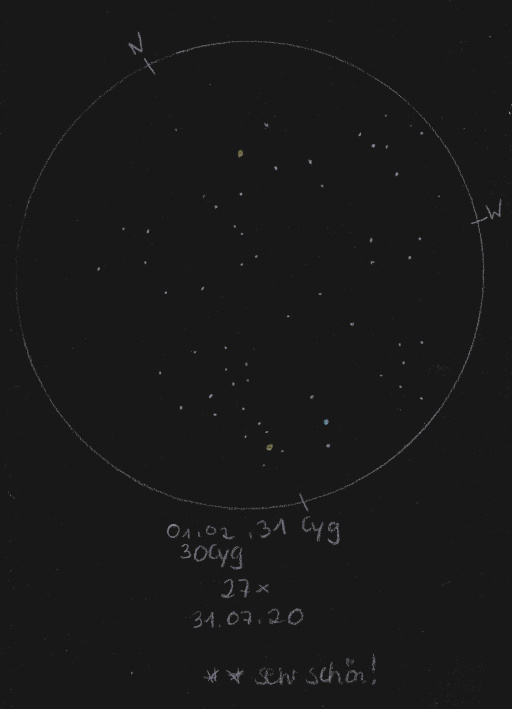
|
Sarah Gebauer
Germany |
150mm (85x) |
dieses Mal nur die drei dicht beieinanderstehenden Komponenten A, C und D im Sichtfeld gehabt, Komponente A ist wieder deutlich gelbgold, C wirkt leicht bläulich und Komponente D wirkt dieses Mal eher weiß |

|
|
|
★
|
STF2653 |
|
AB |
6m.7 |
9m.2 |
2.7" |
279° |
2016 |
Vul |
20h13m40.56s / +24°14'20.50" |
René Merting
Drachhausen (Germany) |
76mm (57x) |
bei 57x ist B mit ordentlich Abstand außerhalb des Leuchtens der A-Komponente erkennbar - vorher bei 29x war B nicht auszumachen - ein sehr ungleiches Paar |
|
Mark McCarthy
Fremont (California/USA) |
203mm (667x) |
Pretty pair, pale white star and blue, very faint and small 3" separated B. Looks like a planet |
|
|
|
★
|
STT403 & STF2657 |
STT403 |
AB |
7m.3 |
7m.6 |
0.9" |
170° |
2019 |
Cyg |
20h14m21.53s / +42°06'15.60" |
|
|
|
STF2657 |
AC |
7m.3 |
9m.8 |
11.6" |
32° |
2015 |
|
|
René Merting
Drachhausen (Germany) |
100mm (64x) |
STF2657 (AC): bei 64x zeigt sich C ganz schwach nordöstlich von A - mindestens 2 Größenklassen Helligkeitsunterschied - A ist reinweiß, bei C bin ich froh, dass ich C überhaupt erkennen kann |
|
Uwe Pilz
Leipzig (Germany) |
105mm (288x) |
STT403 (AB): schwierig |
|
Mark McCarthy
Fremont (California/USA) |
152mm (175x) |
STT403 (AB): Near equal hairline split, white, 2 delta mag. Fainter C (STF 2657 AC) well split nearby. WDS uncertain but there is 26% parallax range overlap, 372 AU weighted separation, and high 3.54/3.29 solar mass, so very likely gravitational |
|
Robert Zebahl
Leipzig (Germany) |
152mm (270x) |
STT403 (AB): At 129x clearly elongated, notched. At 270x clearly split, but very tight with almost touching diffraction disks. Visible, but very small difference in brightness. Inconspicuous color. |
|
Frederik Wanink
Itterbeck (Germany) |
254mm (640x) |
STT403 (AB): schwaches 3er System, getrennt |

|
Mark McCarthy
Fremont (California/USA) |
317mm (553x) |
STT403 (AB): Dramatic near equal white, just split, ~1", with a third in the system 2x fainter and wide separation (Indeed a triple, as described.) |
|
Mark McCarthy
Fremont (California/USA) |
317mm (553x) |
STT403 (AB): Dramatic near equal white, just split, ~1", with a third in the system 2x fainter and wide separation (Indeed a triple, as described.) |
|
|
Frederik Wanink
Itterbeck (Germany) |
254mm |
STT403 (AB) |
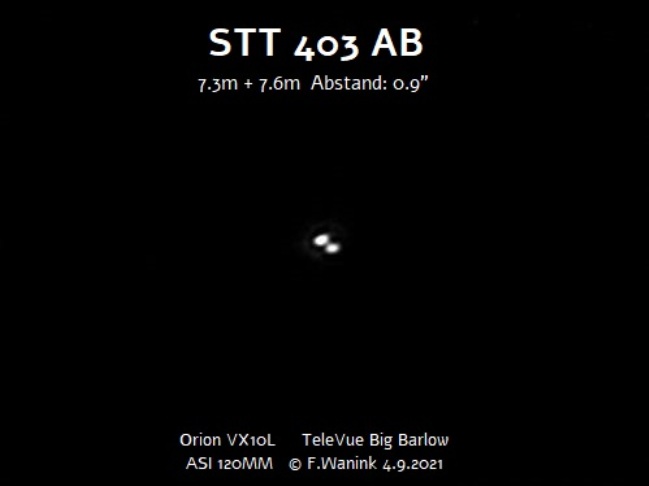
|
|
|
★
|
RST4659 |
|
AB |
7m.2 |
9m.2 |
1.8" |
7° |
2016 |
Aql |
20h16m50.26s / -03°29'30.00" |
Mark McCarthy
Fremont (California/USA) |
317mm (553x) |
White and 2-3 delta mag, ~2" B. |
|
|
|
★
|
BU441 |
|
AB |
6m.4 |
10m.5 |
6.2" |
64° |
2016 |
Vul |
20h17m31.54s / +29°08'51.00" |
Mark McCarthy
Fremont (California/USA) |
317mm (553x) |
Orange star with very faint bluish B seen with averted vision at first then can just hold. Needs fine focus. |
|
|
|
★
|
STFA51, alpha Cap, alpha 1/2 Cap |
|
AE |
3m.7 |
4m.3 |
381.2" |
290° |
2012 |
Cap |
20h18m03.22s / -12°32'41.40" |
Sarah Gebauer
Germany |
naked eye |
mit freiem Auge sind am südlichen Horizont in Dänemark zwei helle Sterne zu sehen, die verdächtig nach Doppelstern ausschauen |
|
Christopher Hay
Seeheim (Germany) |
naked eye |
While waiting for Comet Neowise at 3 in the morning in July 2020 surprised myself with my first naked-eye separation of Alpha1 und Alpha2 Capricornis (observing site at 50° northern latitude, Alpha1/2 passing through meridian). Western, weaker component Alpha 1 Cap well separated from Alpha 2 Cap in good moments. Much more difficult to split naked-eye than Mizar/Alcor (Zeta UMa). Not a physical double. |
|
Sarah Gebauer
Germany |
8x30 |
im Fernglas ein ganz toller, heller und weit getrennter Doppelstern, sehr schöne Sichtung abwechselnd mit und ohne FG |
|
René Merting
Drachhausen (Germany) |
12x50 |
ein wunderschönes Sternpaar, obwohl beide so weit auseinander stehen - die hellere östliche Komponente strahlt buttergelb, der Begleiter ist weiß |
|
René Merting
Drachhausen (Germany) |
15x56 |
ein schönes Paar zweier gelblich schimmernder Sterne - weit auseinanderstehend und doch wirken beide gut zusammen - die westliche Komponente E ist ein wenig schwächer |
|
Sarah Gebauer
Germany |
100mm (21x) |
bei 21x sind alpha1 und alpha2 deutlich getrennt voneinander mit ganz leicht orangefarbenem Eindruck, sie stechen wie zwei helle Augen hervor |
|
René Merting
Drachhausen (Germany) |
320mm (45x) |
?1 und ?2 Capricorni - bei 45x zwei strahlend hellgelbe, weit getrennte Bananensterne, von denen die westliche Komponente auch noch einmal einen schwachen Begleiter im Südwesten hat, der bereits sichtbar ist |
|
|
|
★★
|
STF2666 |
|
AB |
6m.0 |
8m.2 |
2.8" |
245° |
2018 |
Cyg |
20h18m06.99s / +40°43'55.60" |
|
|
|
|
AC |
6m.0 |
10m.7 |
34.0" |
207° |
2006 |
|
|
|
|
|
|
CD |
10m.7 |
11m.0 |
24.1" |
142° |
2018 |
|
|
Christopher Hay
Seeheim (Germany) |
90mm (145x) |
AB: Cleanly split in moments of stable air column. Companion is just outside the first diffraction ring of the primary.
Observed in the shortest night of the year on 21 June 2018, but in zenith under transparent sky.
Comparison observation nearby: Epsilon Lyrae is substantially easier to split despite its smaller separation. |
|
Christopher Hay
Seeheim (Germany) |
150mm (96x) |
AB: Observed at zenith in late July 2019. Clean split, B a fine speck of light to the south of the much brighter primary. Very charming, the highlight of that night’s double-star observing. |
|
Robert Zebahl
Leipzig (Germany) |
152mm (129x) |
AB: 2020-06-24: Very nicely separated with clear difference in brightness. The A component appears white-yellowish. The companion was well visible as a tiny star without color. |
|
Mark McCarthy
Fremont (California/USA) |
152mm (175x) |
AB: 2 delta mag, quite close, white A and bluish B. WDS uncertain, 32% overlap, 2,749 AU weighted separation, very high stellar mass 7.63/4.80 -- likely to be gravitationally bound |
|
Mark McCarthy
Fremont (California/USA) |
152mm (175x) |
AB: Light yellow A and orange B, 2 delta, nice. WDS uncertain. 32% parallax range overlap (but with 13% error), 2,749 AU weighted separation, pretty high 7.63/4.80 solar mass |
|
Christopher Hay
Seeheim (Germany) |
254mm (110x) |
AB: Neatly split with a sliver of black inbetween. A fine double for this aperture and power.
At 65x Struve 2666 is not yet spit, but accompanied by a fine sprinkling of stardust to the south. These are the other members of open cluster Collinder 419, of which Struve 2666 is the lucida. A captivating sight. |
|
Mark McCarthy
Fremont (California/USA) |
317mm (553x) |
AB: White A, slightly red B, ~2 delta mag, ~4" |
|
|
|
★★
|
BU1206 |
|
AB |
7m.5 |
10m.7 |
2.2" |
355° |
2016 |
Cyg |
20h19m07.08s / +36°45'07.60" |
Mark McCarthy
Fremont (California/USA) |
317mm (553x) |
Very much fainter B, ~2", 3-4 delta mag. Pinpoint when seeing stills. |
|
|
|
★★★
|
BLL49, U Cyg |
|
|
8m.0 |
9m.0 |
65.4" |
231° |
2015 |
Cyg |
20h19m41.66s / +47°54'19.90" |
|
|
Robert Zebahl
Leipzig (Germany) |
16x70 |
2020-07-03: Easy split with very good color contrast: white and clear orange. |
|
Sarah Gebauer
Germany |
100mm (80x) |
20.09.23: absolut vergleichbar mit der Beobachtung mit dem 10''-Spiegel, alle Sterne wirken nur etwas schwächer, der Farbeindruck ist jedoch genau so intensiv |
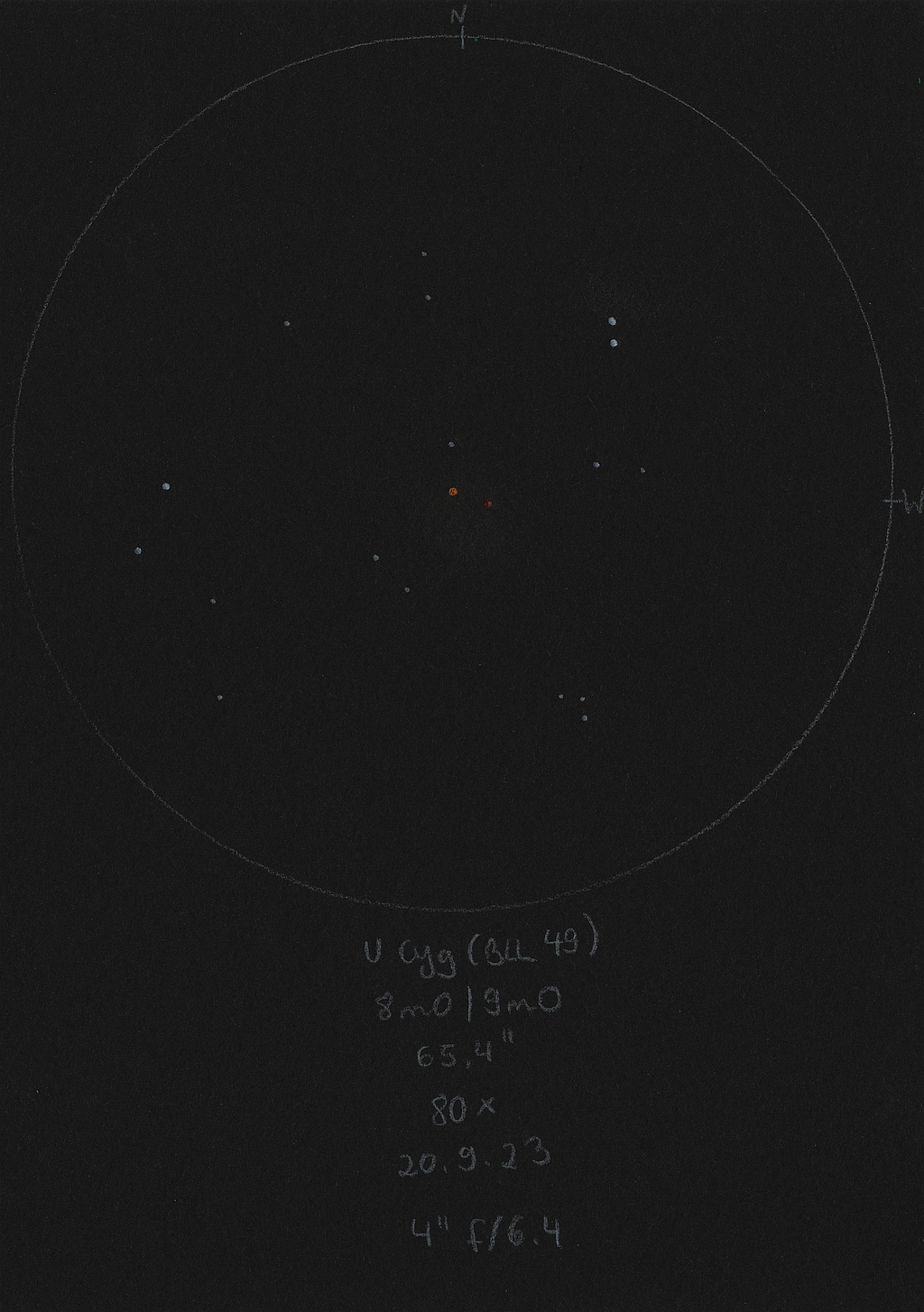
|
Robert Zebahl
Leipzig (Germany) |
102mm (28x) |
2019-08-22: While the primary component appears quite unspectacular in a white, the companion U Cygni is much more interesting. It is a carbon star whose brightness varies between 5m9 and 12m1 with a period of about 463 days. It appears in mostly intensely orange, and even deep red in the towards its minimum. Extremely rewarding! |

|
Sarah Gebauer
Germany |
254mm (96x) |
12.09.23: abartig krebsrot, richtig metallisch, dunkel, stark und ein richtiger Kracher bei 96-fach - der Begleiter im Nordosten mit recht weitem Abstand zeigt ein ganz zartes, hellbuttriges Cremegelb |
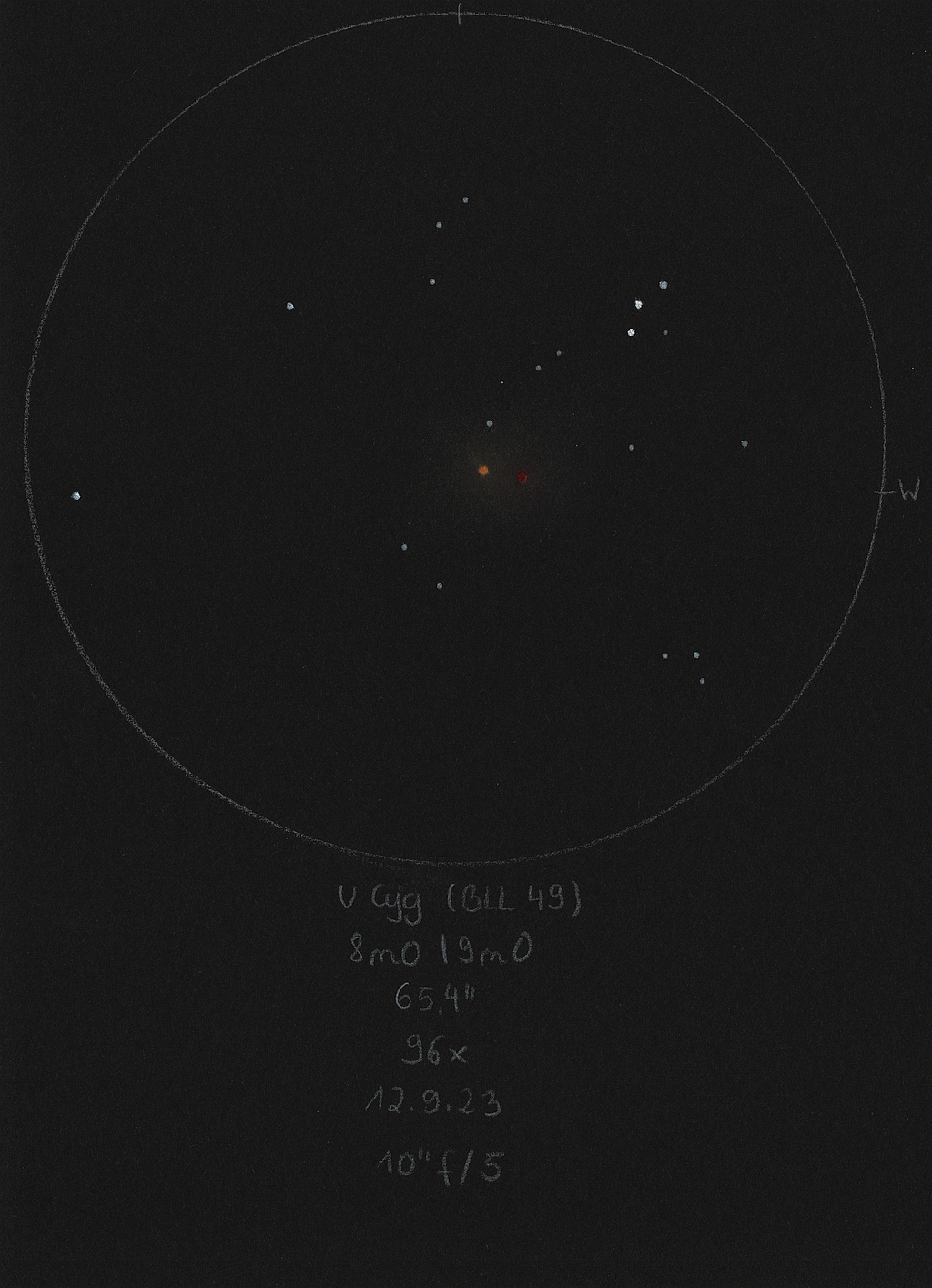
|
René Merting
Drachhausen (Germany) |
320mm (72x) |
|
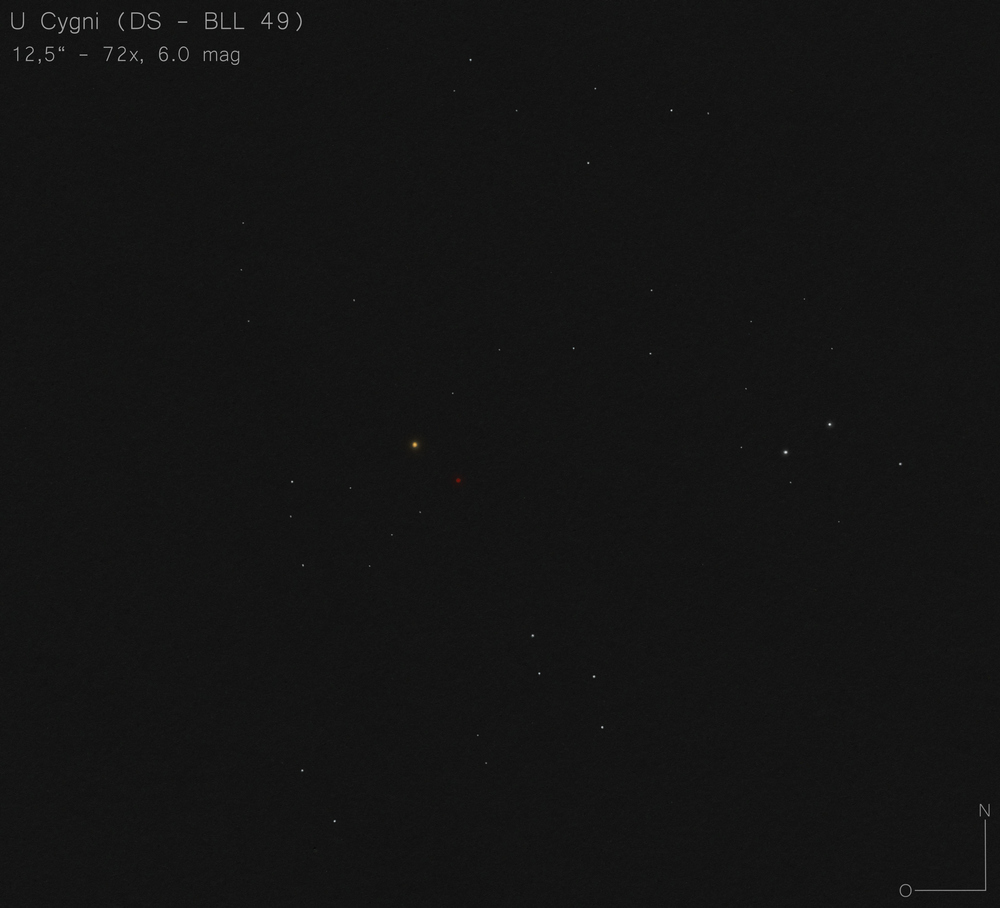
|
|
|
★
|
COU327 |
|
AB |
9m.1 |
9m.1 |
0.2" |
245° |
2019 |
Del |
20h21m35.69s / +19°29'40.10" |
|
|
Mark McCarthy
Fremont (California/USA) |
508mm (1067x) |
The AB-C pair is easy at 205x, C is a faint star ~4" separated from bright A (8.41/11.97 4.0"). AB is much more difficult. At 1067x it is mostly overlapping disks & I can tell its orientation. But at repeated best moments, I get an instant of the finest hairline split with noticeable magnitude difference & I can estimate an orientation relative to nearby stars. It's PA [246-degrees] is nearly perpendicular to AB-C [131-degrees] -- this is how I confirmed I have it. Cocteau discovered it in 1968 with the Nice 30-inch refractor at 0.2". 42.46 year period, last observation in 2005, with grade 3 orbit (which is certain but not definitive). It is currently coming off apastron with the current orbital solution at 0.167" separation. It will tighten very rapidly the next few years, but even on the opposite side of it's orbit it will not be detectable by me, I need to wait until 2050 to try again -- but since the PA will be similar I won't notice that change. I can only look forward to the tightening, and maybe detectability again. If is the 0.167" is correct I have exceeded the Raleigh, Dawes, and Sparrow criteria and it's a new personal best -- and given I did not split some similar pairs later in the night, I was very lucky with the seeing at the time of the observation |
|
|
|
★
|
STF2673 |
|
AB |
8m.3 |
9m.8 |
2.4" |
326° |
2016 |
Del |
20h22m43.76s / +13°20'25.40" |
|
|
|
|
AC |
8m.3 |
8m.6 |
76.5" |
100° |
2016 |
|
|
René Merting
Drachhausen (Germany) |
100mm (142x) |
AB: bei 107x wird Komponente B nordwestlich von A blickweise sichtbar, noch nicht ganz getrennt die beiden - 142x reicht dann aber, um B sauber von A zu trennen - Helligkeitsunterschied eine Größenklasse (1.5 Größenklassen laut Stelle Doppie) |
|
Mark McCarthy
Fremont (California/USA) |
317mm (553x) |
AB: Faint but well-split, ~3 disk separation. B ~2 magnitudes fainter. A is blue-green, B reddish. |
|
Mark McCarthy
Fremont (California/USA) |
508mm (333x) |
AB: Bright white stars, ~2 delta mag, ~2" separation |
|
Karsten Kopp
Köln (Germany) |
600mm (257x) |
AB: AB: Erst bei 257-facher Vergrößerung sauber getrennt. Helligkeitsunterschied ist mit gut 1,5 mag auffällig. Beider Sterne strahlen weißlich. |
|
|
|
★★
|
STF2681 |
|
AB |
8m.0 |
10m.6 |
6.8" |
39° |
2015 |
Cyg |
20h22m49.54s / +53°25'02.80" |
|
|
|
|
AC |
8m.0 |
8m.9 |
38.2" |
199° |
2015 |
|
|
|
|
|
|
AD |
8m.0 |
11m.8 |
42.0" |
166° |
2015 |
|
|
|
|
|
|
CD |
8m.9 |
11m.8 |
23.3" |
101° |
2015 |
|
|
René Merting
Drachhausen (Germany) |
100mm (32x) |
AB: bei 32x gut getrenntes Pärchen, Komponente A nördlich strahlt doppelt so hell wie B im Süden, auf C nicht geachtet |
|
Uwe Pilz
Leipzig (Germany) |
105mm (144x) |
Auf den ersten Blick sah ich nur A und C, aber D war auch kein Problem. B war nur blickweise zu erkennen. |
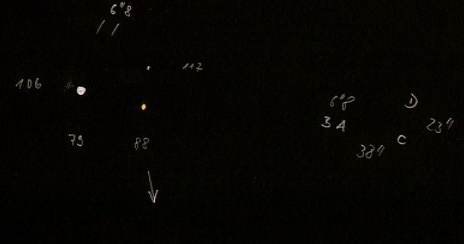
|
Mark McCarthy
Fremont (California/USA) |
317mm (553x) |
AB: Nice. 3x fainter B, ~4", another wide pair below. (4 stars in system.) |
|
Uwe Pilz
Leipzig (Germany) |
320mm (225x) |
|

|
|
|
★
|
A288 |
|
|
8m.7 |
9m.0 |
0.2" |
296° |
2012 |
Del |
20h23m08.98s / +20°51'51.10" |
|
|
Mark McCarthy
Fremont (California/USA) |
508mm (1067x) |
Hairline split, noticeable mag difference, white. Very fine pair. 163y period, it won't make an appreciable change in my time, though it will widen to the 1901 discovery separation of 0.3" in 2075 |
|
|
|
★
|
HO457 |
|
AB |
9m.1 |
9m.2 |
2.0" |
61° |
2020 |
Vul |
20h24m21.08s / +29°22'55.30" |
Mark McCarthy
Fremont (California/USA) |
203mm (333x) |
Nice! quite a pair. Equal stars, well separated ~2", white stars. [AC 14th mag and wide not seen] |
|
|
|
★
|
WOR33 & A1209 |
WOR33 |
Aa-Ab |
8m.6 |
9m.3 |
0.6" |
131° |
2016 |
Del |
20h24m26.64s / +12°12'44.80" |
|
|
|
A1209 |
AB |
9m.2 |
10m.6 |
1.9" |
324° |
2016 |
|
|
Mark McCarthy
Fremont (California/USA) |
508mm (333x) |
A1209 (AB): Very cool! A is obviously split with a At the opposite side is the wider fainter companion, which is A 1209 AB. |
|
Mark McCarthy
Fremont (California/USA) |
508mm (333x) |
WOR33 (Aa-Ab): ~1 delta white companion <1" from the A star of A1209 AB. WOR 33 was 0.3" at discovery in 1970 and it has widened very considerably since, so this might be "only" a high proper motion star.* C.E. Worley was a well loved astronomer at the US Naval Observatory |
|
|
|
★
|
STF2687 |
|
|
6m.4 |
8m.3 |
25.1" |
118° |
2019 |
Cyg |
20h26m23.47s / +56°38'19.30" |
Robert Zebahl
Leipzig (Germany) |
16x70 |
2020-08-19: Gorgeous sight, separated with distinct brightness difference. Primary component appeared rather white with a greyish companion. With two similarly bright stars to the east and southeast STF 2687 forms a prominent triangle surrounded by several star chains. About 12 arcminutes apart to the southeast of STF 2687 is another pair of stars, which is particularly striking because of its color (bluish & orange). |
|
René Merting
Drachhausen (Germany) |
76mm (29x) |
bei 29x ein ordentlich getrenntes Sternpaar - B im Osten von A ist gut 1.5 bis 2 Magnituden schwächer und wirkt noch ordentlich weiß gegenüber der helleren Komponente, muss sich also nicht verstecken |
|
|
|
★
|
COU2538 |
|
|
10m.4 |
10m.4 |
1.0" |
31° |
2016 |
Cyg |
20h28m17.00s / +40°05'09.80" |
Mark McCarthy
Fremont (California/USA) |
508mm (333x) |
Perfect white stars, near equal, nice separation at 333x, suspected not single with 205x, part of a triangle of same mag white stars. WDS uncertain, however there is 35% parallax range overlap, 107 AU weighted separation, and equal 0.97 solar masses, so likely gravitationally bound |
|
|
|
★★
|
HO131 |
|
AB |
7m.0 |
10m.6 |
3.4" |
334° |
2016 |
Del |
20h28m18.64s / +18°46'10.20" |
Mark McCarthy
Fremont (California/USA) |
317mm (553x) |
Seeing needed to be perfectly still so that A's diffraction disappeared. Then B would emerge from the dark as a very faint point to the NW, about 3 disks away. |
|
Mark McCarthy
Fremont (California/USA) |
508mm (333x) |
Bright light yellow A and ~3 delta mag yellow B, ~3" |
|
|
|
★★
|
WEI35 |
|
AB |
8m.3 |
8m.8 |
4.2" |
214° |
2020 |
Cyg |
20h29m13.54s / +37°30'45.80" |
|
|
|
|
AC |
8m.3 |
9m.4 |
87.6" |
100° |
2015 |
|
|
|
|
|
|
CD |
9m.4 |
10m.6 |
12.1" |
202° |
2018 |
|
|
René Merting
Drachhausen (Germany) |
100mm (64x) |
AB: bei 64x ist ein schön eng stehendes Paar zweier schwacher Sterne erkennbar - Komponente B im SW schwächelt helligkeitstechnisch nur um eine halbe Magnitude gegenüber A - Komponente A wirkt leicht farbig, das aber ist nicht greifbar |
|
Uwe Pilz
Leipzig (Germany) |
105mm (200x) |
eine anderer doppelter Doppelstern! Lohnend! Es ist erstaunlich, dass er nicht in den klassischen Katalogen auftaucht |
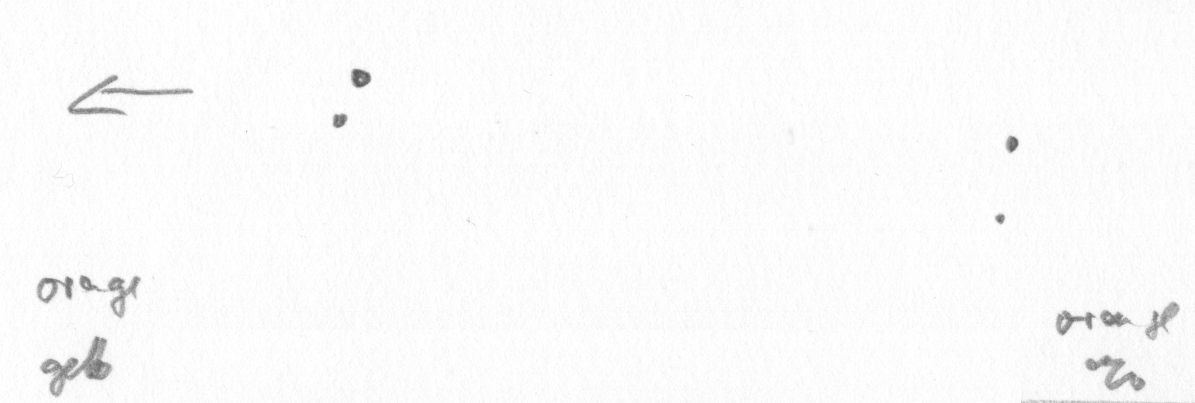
|
Mark McCarthy
Fremont (California/USA) |
317mm (553x) |
AB: Double-double! Near equal 3", and closeby a wider pair, 5", 1 delta mag. (AB is first, CD might be second? 4 stars visible in system) |
|
|
|
★
|
omicron Cap, 12 Cap, SHJ324 |
|
AB |
5m.9 |
6m.7 |
22.0" |
238° |
2019 |
Cap |
20h29m53.91s / -18°34'59.40" |
René Merting
Drachhausen (Germany) |
12x50 |
ein dicht zusammenstehendes, gut getrenntes Paar, beide Komponenten sind schön hell - die Komponente B im SW ist eine halbe Größenklasse schwächer |
|
René Merting
Drachhausen (Germany) |
15x56 |
ein wunderschöner Doppelstern, ein bisschen mehr als gut getrennt - ich habe den Eindruck von einem Farbkontrast, der hin und her zu springen scheint (lt. Stelledoppie sind beide Sterne reinweiß) |
|
René Merting
Drachhausen (Germany) |
320mm (45x) |
bei 45x ein ordentlich getrenntes Sternpaar, A im Osten strahlt minimalst warmweiß, B wirkt ähnlich, wenn auch eine viertel bis halbe Größenklasse schwächer, durch Seeingeffekte glitzern die Sterne wunderschön |
|
|
|
★
|
BU63, 1 Del |
|
AB |
6m.2 |
8m.0 |
0.9" |
347° |
2016 |
Del |
20h30m17.95s / +10°53'45.30" |
Sarah Gebauer
Germany |
100mm (136x) |
auch bei 136x nicht zu trennen, bei 0,9'' Distanz und Amiciprisma aber auch kein Wunder |
|
Frederik Wanink
Itterbeck (Germany) |
254mm (640x) |
schwierig |

|
Mark McCarthy
Fremont (California/USA) |
317mm (553x) |
1 Delphini: 1 disk split to the NNW when seeing stills. A tough observation. 1 Del is a fascinating star that spins once in 0.9 earth days! See http://stars.astro.illinois.edu/sow/1del.html. |
|
Mark McCarthy
Fremont (California/USA) |
508mm (533x) |
1 Del. B seen within A's diffraction at 533x and apodising mask, <1", ~2 delta |
|
|
|
★
|
STF2688 |
|
|
9m.3 |
10m.4 |
7.9" |
175° |
2019 |
Del |
20h30m48.26s / +13°47'02.40" |
Mark McCarthy
Fremont (California/USA) |
508mm (333x) |
Gold A and blue B, half delta mag. Very like Albireo, and like Albireo it is not physical |
|
Karsten Kopp
Köln (Germany) |
600mm (180x) |
Doppelstern ist einfach zu trennen, mit auffälligen Helligkeitsunterschied von ca. 1 mag. Komponente A leuchtet orange und B geht ins bläuliche. Kleine Version von Albireo. |
|
|
|
★
|
STF2690 & HJ269 & DA1 |
STF2690 |
A-BC |
7m.1 |
7m.4 |
17.8" |
255° |
2020 |
Del |
20h31m11.94s / +11°15'33.70" |
|
|
|
HJ269 |
AD |
7m.1 |
12m.1 |
23.0" |
108° |
2016 |
|
|
|
|
|
DA1 |
BC |
7m.9 |
8m.0 |
0.3" |
184° |
2016 |
|
|
|
|
René Merting
Drachhausen (Germany) |
10x50 |
STF2690 (A-BC): ein ganz enges Sternpaar mit zwei gleich hellen Sternen - ich würde beide als 8 mit tiefer Einschnürung bezeichnen, also kurz vor der Trennung |
|
Robert Zebahl
Leipzig (Germany) |
12x42 |
STF2690 (A-BC): 2021-10-09: Very nice. Clearly separated with almost equally bright components. |
|
René Merting
Drachhausen (Germany) |
12x42 |
STF2690 (A-BC): ein superenges, schönes Paar gleich heller Sterne - da passen maximal eineinhalb Blatt Papier zwischen - schön im Zusammenspiel mit den beiden hellen Sternen südöstlich und südwestlich |
|
Robert Zebahl
Leipzig (Germany) |
16x70 |
STF2690 (A-BC): 2020-08-19: Striking, moderately bright with nice separation of the similarly bright components in nice environment. The eastern component seemed slightly brighter and colorwise cooler. |
|
Uwe Pilz
Leipzig (Germany) |
16x70 |
STF2690 (A-BC) |

|
Uwe Pilz
Leipzig (Germany) |
16x70 |
STF2690 (A-BC): etwa gleichhell, sauber getrennt |
|
René Merting
Drachhausen (Germany) |
100mm (20x) |
STF2690 (A-BC): bei 32x ein schön getrenntes Sternpaar mit leichtem Farbkontrast - Komponente A im Osten ist weiß, BC im Westen ist leicht gelblich und dumpfer, aber kaum ein Helligkeitsunterschied zwischen beiden Sternen - zurück auf 20x ist das Paar noch schöner anzusehen, weil beide Sterne dichter zusammen stehen |
|
Sarah Gebauer
Germany |
100mm (49x) |
STF2690 (A-BC): weit getrennt, zwei simple Glupschäuglein im Leeren, mehr nicht |
|
Robert Zebahl
Leipzig (Germany) |
102mm (28x) |
STF2690 (A-BC): 2021-09-11: Very attractive, almost equally bright with subtle color contrast: pale yellow-orange & white-bluish. |
|
Robert Zebahl
Leipzig (Germany) |
152mm (30x) |
STF2690 (A-BC): 2021-09-08: Striking in nice star environment, easy to separate with little difference in brightness. Both components appeared slightly yellowish. |
|
Mark McCarthy
Fremont (California/USA) |
317mm (277x) |
STF2690 (A-BC): Widely separated near equal white stars. |
|
Mark McCarthy
Fremont (California/USA) |
508mm (533x) |
DA1 (BC): This is part of STF 2690 A-BC, which is a white, wide, near equal, pair (7.12/7.39 17.7") observed with 8-inch at 205x. I suspected BC at 8-inch 333x, & had overlapping disks with 8-inch 533x. With 20-inch 533x I see a hairline split, slight magnitude difference. Seeing is not supporting it well, but it's clear. Very nice. Dawes discovered in 1840 at 0.7" -- DA 1 was discovered when Dawes was working at "Mr Bishop's observatory" in London, from 1839 to 1844. It had a 7-inch refractor by Dollond (1836) who had made both mounting and telescope. So at current 0.369" it's not surprising I only had overlapping disks at 8-inch. It's a physical pair, with a 236.52 year period, and will widen another 0.1" in the next 15 years |
|
Karsten Kopp
Köln (Germany) |
600mm (180x) |
STF2690 (A-BC): STF 2690: Gut zu trennender Doppelstern mit leichtem Helligkeitsunterschied. Komponente A leuchtet weiß und die Komponente B geht ins gelbliche. |
|
|
|
★
|
STF2695 |
|
|
6m.6 |
8m.8 |
0.3" |
257° |
2020 |
Vul |
20h31m58.19s / +25°48'18.10" |
|
|
Mark McCarthy
Fremont (California/USA) |
508mm (1067x) |
Using 8" mask at 667x, no sign of elongation. With 20" and progressively higher magnifications, I can get to olive shape at 1067x, but extremely marginal. [0.8" at discovery, so easier for Struve] |
|
|
|
★
|
STT408 |
|
|
6m.8 |
9m.4 |
1.6" |
193° |
2016 |
Cyg |
20h34m01.96s / +34°40'44.40" |
Mark McCarthy
Fremont (California/USA) |
317mm (553x) |
Very fine dull white A and pinpoint B, split well with seeing, ~2" |
|
|
|
★
|
COU223 |
|
AB |
11m.1 |
11m.2 |
0.4" |
161° |
2016 |
Del |
20h34m46.33s / +17°25'38.70" |
Mark McCarthy
Fremont (California/USA) |
508mm (533x) |
Elongation with 333x, very finely split with 533x, wider split with 667x. Very faint, more than just a little delta mag., slightly orange stars |
|
|
|
★
|
A2793 |
|
|
9m.9 |
10m.3 |
0.9" |
210° |
2016 |
Vul |
20h36m29.63s / +23°41'43.50" |
Mark McCarthy
Fremont (California/USA) |
508mm (533x) |
Nice! very fine pair, white stars, half delta mag, close, ~1" |
|
|
|
★★
|
STF2703 |
|
AB |
8m.3 |
8m.4 |
25.1" |
290° |
2019 |
Del |
20h36m49.41s / +14°43'42.40" |
|
|
|
|
AC |
8m.3 |
8m.8 |
77.8" |
234° |
2016 |
|
|
|
|
|
|
AD |
8m.3 |
12m.8 |
84.7" |
347° |
2016 |
|
|
|
|
|
|
BC |
8m.4 |
8m.8 |
67.0" |
215° |
2016 |
|
|
René Merting
Drachhausen (Germany) |
12x42 |
AB: flüchtig betrachtet erst übersehen (C im Südwesten hat etwas abgelenkt), aber bei genauem Hinschauen ist zu erkennen, dass die nordöstliche Komponente aus zwei gleich hellen Sternen besteht
AC: die südwestliche Komponente hat dreifachen Abstand wie AB |
|
Robert Zebahl
Leipzig (Germany) |
16x70 |
2020-08-19: Immediately eye-catching multiple star located between beta and zeta Delphini. Components A, B & C are very easily seen as a triple system forming a striking triangle. A very slight difference in brightness between A & B is perceptible, as well as a color difference, though I cannot name any colors. Very nice. |
|
Uwe Pilz
Leipzig (Germany) |
16x70 |
AB |
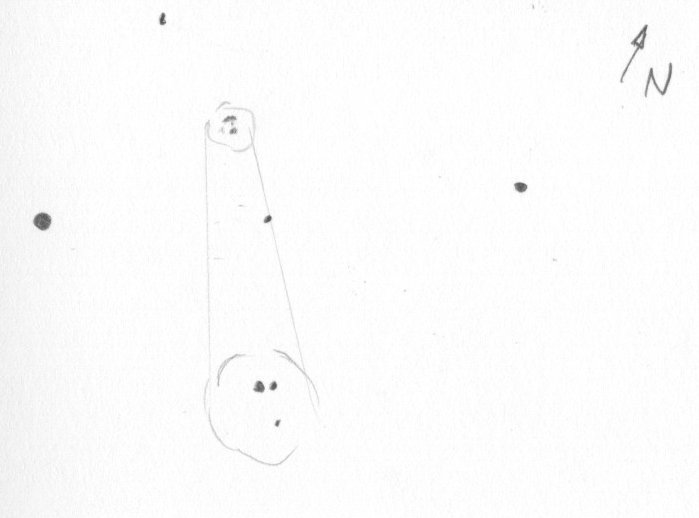
|
René Merting
Drachhausen (Germany) |
100mm (20x) |
AB: bei 20x einfach - Komponente B im Westen ist nur minimal schwächer
BC: bei 20x ist Komponente C südwestlich von B in mehr als dem doppeltem Abstand von A zu B erkennbar, Helligkeitsunterschied gut eine halbe Größenklasse |
|
Uwe Pilz
Leipzig (Germany) |
105mm (144x) |
AB |
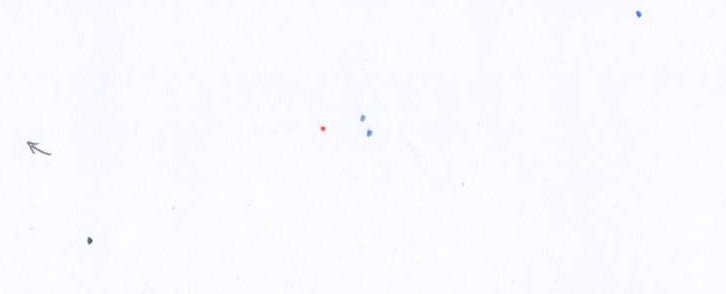
|
Karsten Kopp
Köln (Germany) |
600mm (180x) |
Sehr schönes Mehrfachsternsystem. AB mit fast identische Helligkeit, wobei Komponente C mit 0,5 mag etwas schwächer ist. Ansonsten sind AB,AC und BC als auffälliges Dreieck leicht zu trennen. AD: Hier ist die Komponente D eine sehr große Herausforderung, die ich nur mit indirektem aus der Stadt heraus sichten konnte. |


|
|
Karsten Kopp
Köln (Germany) |
140mm |
Image taken with TEC 140, Canon 700Da, 4 seconds exposure time |
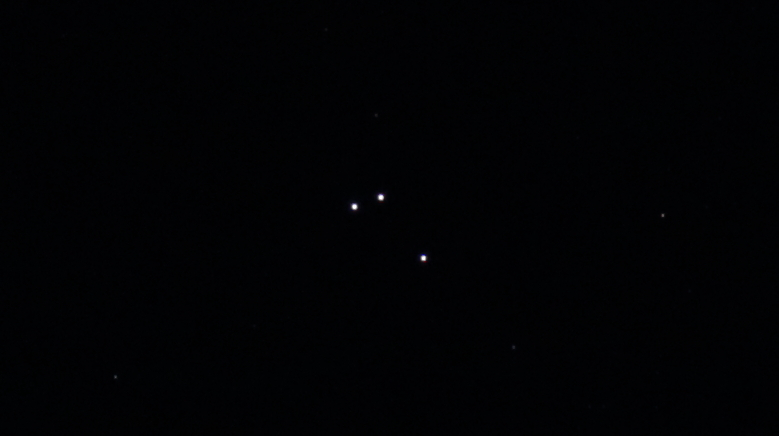
|
|
|
★★
|
ARY48 |
|
|
8m.2 |
8m.8 |
53.3" |
41° |
2016 |
Cyg |
20h37m45.00s / +32°23'42.90" |
René Merting
Drachhausen (Germany) |
18x70 |
das Paar ist sofort bequem getrennt als solches erkennbar - Komponente B im Osten ist maximal eine halbe Magnitude schwächer |
|
René Merting
Drachhausen (Germany) |
76mm (29x) |
Mondscheinnacht - bei 29x sehe ich ein Pärchen zweier gleich heller Sterne mit einem leichten Farbkontrast - Trennung komfortabel |
|
Mark McCarthy
Fremont (California/USA) |
80mm (13x) |
A beautiful split in finder, just equal pair, wide separation, white with red tint. |
|
René Merting
Drachhausen (Germany) |
100mm (20x) |
bei 32x zeigt sich B fast gleichhell weit getrennt nordöstlich von A - bei 20x ein kleines schwaches ordentlich getrenntes Pärchen |
|
|
|
★
|
TDT2441 |
|
|
10m.6 |
10m.6 |
0.6" |
89° |
2016 |
Vul |
20h38m20.78s / +21°05'37.50" |
Mark McCarthy
Fremont (California/USA) |
508mm (667x) |
Very difficult and faint B star appears with averted vision, only at the instant seeing settles the A star down to a clean round diffraction. B is a brown hard point on the diffraction ring. very tough. |
|
|
|
★
|
COU226 |
|
AB |
8m.0 |
8m.3 |
0.4" |
53° |
2018 |
Del |
20h41m51.24s / +19°31'13.60" |
Mark McCarthy
Fremont (California/USA) |
508mm (533x) |
Wow really nice 2+1 system. The +1 is a faint wide star (AC, 8.58/11.50, 13.5"). The AB is a very tight double, ~0.5", split, white, near equal |
|
|
|
★
|
STF2718 |
|
AB |
8m.3 |
8m.4 |
8.5" |
87° |
2020 |
Del |
20h42m33.47s / +12°43'41.90" |
|
|
|
|
AC |
8m.3 |
9m.0 |
167.2" |
346° |
2015 |
|
|
|
|
|
|
BC |
8m.4 |
9m.0 |
167.3" |
346° |
2015 |
|
|
Robert Zebahl
Leipzig (Germany) |
16x70 |
AB: 2021-09-02: Appears elongated at first glance, on closer observation just separable. A very small difference in brightness is visible. The double star is located in a beautiful surrounding field of stars. |
|
René Merting
Drachhausen (Germany) |
100mm (32x) |
AB: der Doppelstern steht sehenswert in einem Bogen aus 5 Sternen - bei 32x werden zwei gleich helle knapp getrennte Sterne sichtbar - schwer zu sagen, welches die A-Komponente ist - die westliche Komponente wirkt im Weiß-Farbton etwas kühler |
|
Sarah Gebauer
Germany |
100mm (80x) |
AB: wie der oberste Stern in einer Wiege, nordwestlich dieser Wiege ist noch eine weitere geschwungene Sternlinie zu sehen, sehr schön |

|
Mark McCarthy
Fremont (California/USA) |
203mm (205x) |
AB: Easy wide, white, near equal Psychical |
|
Mark McCarthy
Fremont (California/USA) |
317mm (553x) |
AB: Same brightness white pair. |
|
Karsten Kopp
Köln (Germany) |
600mm (180x) |
AB: Doppelstern ist sehr einfach zu trennen mit gleicher Helligkeit. Beide Komponenten erstrahlen weißlich. |
|
|
|
★★
|
STF2725 |
|
AB |
7m.5 |
8m.2 |
6.2" |
12° |
2019 |
Del |
20h46m13.31s / +15°54'26.40" |
|
|
Robert Zebahl
Leipzig (Germany) |
16x70 |
2021-09-02: The double star appears clearly elongated at the correct position angle, but nothing more. |
|
René Merting
Drachhausen (Germany) |
100mm (32x) |
bei 32x ein schöner Kontrast zum 15' nördlich stehenden viel helleren Sternpaar STF2727 - hier bei dem wesentlich schwächeren Sternpaar zeigt sich bei 32x die Komponente B knapp getrennt nördlich von A - Helligkeitsunterschied etwas mehr als eine halbe Magnitude, aber Komponente A ist noch deutlich schwächer als die Komponente B von STF2727 |
|
Sarah Gebauer
Germany |
100mm (45x) |
das Doppel lässt sich bei 45x sauber trennen und bildet mit Gamma2 Delphini ein optisches Doppel-Doppel, da beide Doppelsterne sehr gut in ein Gesichtsfeld passen |

|
Sarah Gebauer
Germany |
100mm (80x) |
01.10.23: südwestlich versetzt von Gamma2 Del zeigt STF 2725 eine dunkelgelb, matt schimmernde A-Komponente und eine dicht stehende, sauber getrennte B-Komponente, die silbrig wirkt |
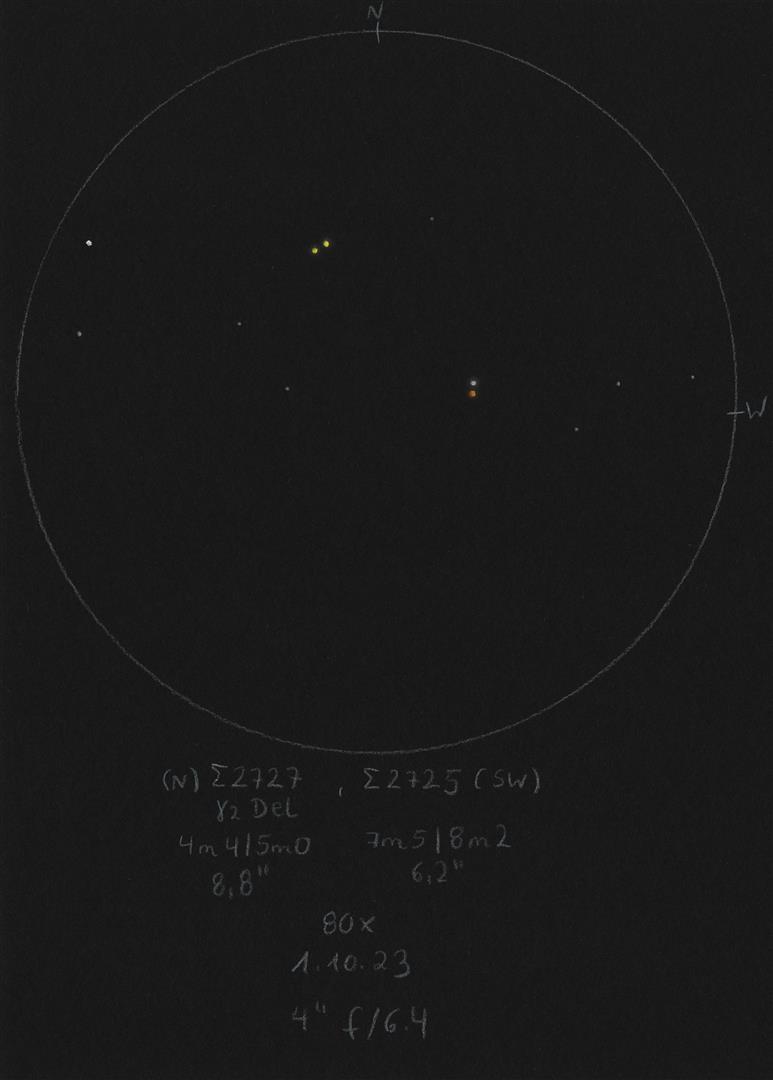
|
Uwe Pilz
Leipzig (Germany) |
105mm (66x) |
im selben Feld mit gamma Del |
|
Uwe Pilz
Leipzig (Germany) |
105mm (88x) |
|
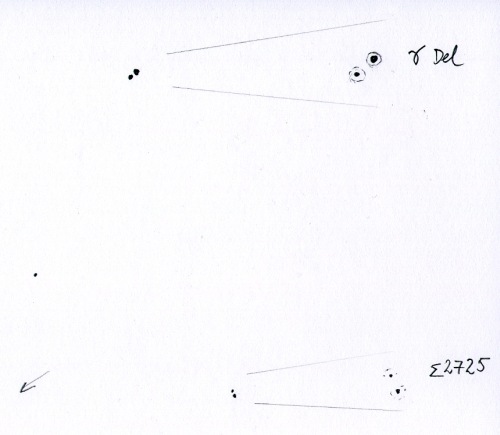
|
René Merting
Drachhausen (Germany) |
107mm (60x) |
bei 60x knapp getrennt, gut zusammen im Gesichtsfeld mit dem helleren, farbigen Sternpaar STF 2727 |

|
Robert Zebahl
Leipzig (Germany) |
152mm (30x) |
2021-09-11: Separated but still very close components with moderate brightness difference. |
|
Mark McCarthy
Fremont (California/USA) |
203mm (205x) |
OR Del. Light yellow stars, half delta mag, wide. Physical pair with a 2945.18 year period. In same field with bright pair STF 2727 |
|
Mark McCarthy
Fremont (California/USA) |
317mm (553x) |
Super wide, 1 magnitude difference, both faint yellow-white. |
|
Mark McCarthy
Fremont (California/USA) |
508mm (333x) |
Easy, half delta mag and wide. I was after the super close WSI 110 Aa-Ab 0.1" but had no hope of seeing it. |
|
Karsten Kopp
Köln (Germany) |
600mm (180x) |
Leicht zu trennender Doppelstern mit leichtem Helligkeitsunterschied von ca. 0,5 mag. Komponente A leuchtet weißlich und die Komponente B b gelblich. |
|
|
Berthold Fuchs
Wiesbaden (Germany) |
130mm |
close DS |
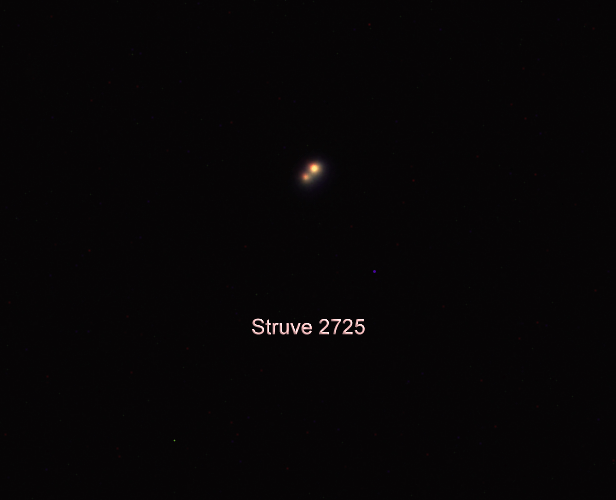
|
|
|
★★
|
STF2727, 12 Del, gamma Del |
|
AB |
4m.4 |
5m.0 |
8.8" |
266° |
2020 |
Del |
20h46m39.50s / +16°07'27.40" |
|
|
Christopher Hay
Seeheim (Germany) |
8x42 |
On tripod. Definite elongation, and eastern end of elongation (i.e. component A) is definitely brighter than the other end. PA estimated at 240° without prior knowledge. |
|
Christopher Hay
Seeheim (Germany) |
15x45 |
Stabilised binoculars, handheld. A very elongated figure-8 very close to popping apart. According to Stelledoppie a physical double with a period of 3249 years. Observed in June 2019 when separation was 8,89“. Will be 8.67“ in 2030 according to Stelledoppie. |
|
Robert Zebahl
Leipzig (Germany) |
16x70 |
2021-09-02: Beautiful sight in very nice surrounding. Easy to split, but quite small separation. A rather small difference in brightness is clearly visible. The primary component appears golden in color. |
|
Christopher Hay
Seeheim (Germany) |
18x80 |
Very tight pair but clearly split with black in-between. Observed in July 2019 when separation was 8,89“. An excellent object to test the resolution of large binoculars. Struve 2725 a few arcminutes to the southwest is a further good test object for magnifications >20x. |
|
Christopher Hay
Seeheim (Germany) |
40x80 |
Widely split, visually strong, dominating the field of view. Component A appears yellowish compared to component B. Struve 2725 in same FOV finely split. |
|
René Merting
Drachhausen (Germany) |
100mm (32x) |
bei 32x knapp getrennt - Komponente A ist schön gelb, B im Westen ist gut 1.5 Magnituden schwächer (lt. Stelle Doppie Helligkeitsunterschied nur 0.67 mag) - zusammen mit dem wesentlich schwächeren STF2725 gut 15' südlich sehenswert |
|
Sarah Gebauer
Germany |
100mm (45x) |
bei 45x sauber getrennt und zusammen mit dem DS STF 2725 in einem Gesichtsfeld, dadurch wirken sie wie ein optisches Doppel-Doppel, sehr schön! Beide DS bilden auch einen auffälligen Lichthof |

|
Sarah Gebauer
Germany |
100mm (80x) |
01.10.23: bei 80-fach zeigt sich der DS sehr hell, gut getrennt und strahlend maisgelb - schön zusammen mit dem südwestlich stehenden Doppelstern STF 2725, der ebenfalls leicht Farbe zeigt |

|
Uwe Pilz
Leipzig (Germany) |
105mm (66x) |
im selben Feld mit STF2725 |
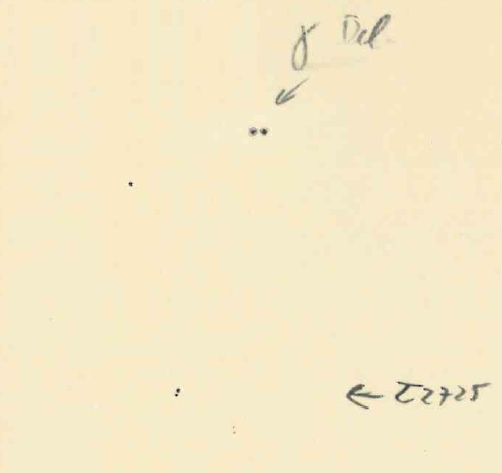
|
Uwe Pilz
Leipzig (Germany) |
105mm (144x) |
schon trennbar bei 26x. In einem Feld mit STF2725 |

|
René Merting
Drachhausen (Germany) |
107mm (60x) |
bei 30x getrennt, bei 60x kommen die Farben aber noch schöner zur Geltung, A ährengelb bis biergelb, B im Westen ist rinr Größenklasse schwächer und samtig hellgelb, schöner Farbkontrast |

|
Robert Zebahl
Leipzig (Germany) |
152mm (30x) |
2021-09-11: Difference in brightness well visible. Light yellow/golden & lemon yellow. |
|
Mark McCarthy
Fremont (California/USA) |
152mm (175x) |
Gam2 Del. Gorgeous, light yellow-orange A and blue-green B, I like this better than Albireo. Physical with 3249-year period, it will slowly tighten the next couple of hundred years |
|
Mark McCarthy
Fremont (California/USA) |
152mm (285x) |
Gam 2 Del. ! Most beautiful light orange-yellow A and ~1 delta mag blue-green B |
|
Mark McCarthy
Fremont (California/USA) |
317mm (277x) |
Gamma Delphinus. Rich gold-yellow A, blue-white B, ~6" separation estimated by eye. Very pretty pair. |
|
Karsten Kopp
Köln (Germany) |
600mm (180x) |
Recht heller und auch leicht zu trennender Doppelstern mit ca. 0,5 mag Helligkeitsunterschied. Komponente A leuchtet schön gelblich und Komponente B weiß. |
|
|
|
★
|
STT413, 54 Cyg, lambda Cyg |
|
AB |
4m.7 |
6m.3 |
0.9" |
1° |
2020 |
Cyg |
20h47m24.53s / +36°29'26.70" |
|
|
Robert Zebahl
Leipzig (Germany) |
102mm (280x) |
The diffraction disk of the primary component was slightly elongated towards north. The air here was however a bit too unsteady for an accurate observation. |
|
Uwe Pilz
Leipzig (Germany) |
105mm |
schwierig |
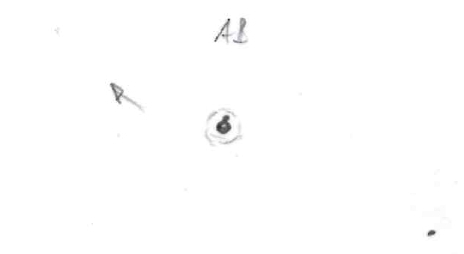
|
Mark McCarthy
Fremont (California/USA) |
152mm (175x) |
Very unequal mag snowman. Physical with an 800-year period |
|
Robert Zebahl
Leipzig (Germany) |
152mm (300x) |
Observation with an achromat. The fainter component was visible as a permanent brightening of the first diffraction ring. |
|
Robert Zebahl
Leipzig (Germany) |
152mm (300x) |
2020-08-24: Observation with an ED refractor. At 171x partially, at 200x clearly visible as '8'. At 300x two clear, overlapping diffraction disks of differently bright components. |
|
Frederik Wanink
Itterbeck (Germany) |
254mm (640x) |
schwierig aber getrennt |
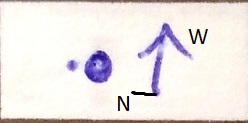
|
Mark McCarthy
Fremont (California/USA) |
317mm (553x) |
Lambda Cyg: ~1.5 delta mag, blue-white. Bright mess resolves to two disks 0.8-1.0", with seeing. |
|
|
|
★★
|
BU66 |
|
|
8m.8 |
9m.3 |
1.1" |
169° |
2016 |
Vul |
20h48m06.26s / +27°27'25.30" |
Mark McCarthy
Fremont (California/USA) |
317mm (553x) |
Exceedingly fine, elongated haze resolved to a clean split, half delta mag, with seeing. 1" Nice! |
|
|
|
★
|
BU67 |
|
AB |
6m.8 |
9m.9 |
1.5" |
311° |
2016 |
Cyg |
20h50m36.05s / +30°54'45.70" |
Mark McCarthy
Fremont (California/USA) |
152mm (175x) |
Very faint B, with seeing and averted vision only. WDS uncertain, but -8% parallax overlap. Burnham discovered with his 6-inch |
|
Robert Zebahl
Leipzig (Germany) |
152mm (270x) |
Not split. |
|
Mark McCarthy
Fremont (California/USA) |
317mm (553x) |
Pale blue A and 3 delta mag B, ~2". In the middle of the Cygnus Loop. |
|
|
|
★
|
STF2730 |
|
|
8m.4 |
8m.6 |
3.3" |
333° |
2019 |
Del |
20h51m03.77s / +06°23'14.10" |
René Merting
Drachhausen (Germany) |
100mm (64x) |
bei 64x ein schickes sehr eng zusammen stehendes Sternpaar - beide Komponenten haben die gleiche Helligkeit - ich habe B im NW vermutet bei meiner Beobachtung, leider falsch, der Helligkeitsunterschied zwischen beiden beträgt aber auch nur 0.14 mag |
|
Mark McCarthy
Fremont (California/USA) |
203mm (533x) |
Near equal, fairly wide, white stars ~4" |
|
René Merting
Drachhausen (Germany) |
320mm (144x) |
bei 144x ein schickes Paar zweier gleich heller, fast warmweißer Sterne, die im Umfeld auffallen und etwas mehr als knapp getrennt sind |
|
Karsten Kopp
Köln (Germany) |
600mm (180x) |
Noch gut zu trennender Doppelstern mit fast identischer Helligkeit. Beide Sterne leuchten leicht orange. |
|
|
|
★
|
STT420 |
|
|
6m.7 |
10m.5 |
5.8" |
2° |
2016 |
Cyg |
20h54m22.25s / +40°42'10.60" |
Mark McCarthy
Fremont (California/USA) |
317mm (553x) |
Light yellow A and reddish B, very faint, very wide, 3 delta mag. |
|
|
|
★
|
STT419 |
|
|
7m.2 |
10m.0 |
1.7" |
24° |
2016 |
Cyg |
20h54m42.00s / +37°04'25.30" |
Mark McCarthy
Fremont (California/USA) |
317mm (553x) |
Tough, needed to wait for a while for right seeing. Bright yellowish A with brightening in diffraction which stays put and recedes to a fine point momentarily with the seeing. |
|
|
|
★
|
STT423 |
|
|
7m.1 |
9m.6 |
2.7" |
76° |
2016 |
Cyg |
20h55m17.96s / +42°30'48.60" |
Mark McCarthy
Fremont (California/USA) |
152mm (175x) |
Excellent, 2 delta mag close pair, white, nice split. WDS uncertain, but it is almost certain to be gravitationally bound: 46% parallax range overlap, 1,239 AU weighted separation, 3.96 & 2.25 solar mass |
|
|
|
★
|
STF2735 |
|
|
6m.5 |
7m.5 |
2.0" |
282° |
2016 |
Del |
20h55m40.64s / +04°31'57.70" |
Frederik Wanink
Itterbeck (Germany) |
254mm (640x) |
Hauptstern leicht gelblich |
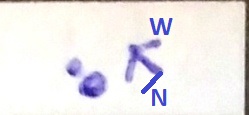
|
Mark McCarthy
Fremont (California/USA) |
317mm (553x) |
Pretty orange and blue, Alberio-like, 2 delta mag, well split |
|
René Merting
Drachhausen (Germany) |
320mm (288x) |
bei 288x wirkt A gelblich und die weiße, etwa eine Größenklasse schwächere B-Komponente zeigt sich in ruhigen Momenten westlich ganz knapp abgesetzt |
|
Karsten Kopp
Köln (Germany) |
600mm (180x) |
Doppelstern ist gerade so noch zu trennen. Helligkeitsunterschied gut zu erkennen. Komponente A leuchtet gelblich und die B Komponente weißlich. |
|
|
|
★
|
STF2737, epsilon Equ, 1 Equ |
|
AB |
6m.0 |
6m.3 |
0.0" |
125° |
2021 |
Equ |
20h59m04.54s / +04°17'37.80" |
|
|
|
|
AB-C |
5m.3 |
7m.0 |
10.6" |
67° |
2019 |
|
|
|
|
|
|
AD |
6m.0 |
13m.1 |
69.3" |
293° |
2013 |
|
|
|
|
René Merting
Drachhausen (Germany) |
12x50 |
AB-C: in ruhigen Momenten präsentieren sich beide Sterne länglich mit Einschnürung, dann sieht das System aus wie eine kleine Ameise |
|
Robert Zebahl
Leipzig (Germany) |
70mm (22x) |
AB-C: At 22x well separated, but still relatively close together with a clear difference in brightness. At 44x AB looked rather white. The color of C was not apparent. |
|
Christopher Hay
Seeheim (Germany) |
80mm (30x) |
AB-C: Well split, C bluish, AB no definite colour, a nice pair at this power. According to Stelledoppie B and C are a physical pair with a period of 5200 years, and A and B are again a physical pair with a period of 104 years. |
|
René Merting
Drachhausen (Germany) |
100mm (32x) |
AB-C: bei 32x knapp getrennt - Komponente AB mit einem schönen cremegelb, C steht nordöstlich und ist gut 1.5 Größenklassen schwächer |
|
Sarah Gebauer
Germany |
100mm (45x) |
AB-C: bei 45x ganz eng, aber sauber getrennt, die hellere Komponente AB ist gelbstichig und die nordöstliche, schwächere Komponente C hat phasenweise einen Blaustich, wie ein ganz enger, ganz kleiner und schwächerer Albireo |
|
Sarah Gebauer
Germany |
100mm (49x) |
AB-C: 24.09.23: mit 49x sind AB und C schmal, aber sauber getrennt - A zeigt sich auf den ersten Blick richtig hell zitronengelb, B eher kühlweiß bis grau im Nordosten - mit 80x verändert sich der Farbton von AB in Richtung Orange - das übrige Sternumfeld ist bis auf wenige schwache Sternen und einen etwas helleren im Südwesten sehr leer |
|
Mark McCarthy
Fremont (California/USA) |
317mm (553x) |
AB-C: Easy yellow stars, very wide, 1 delta mag. |
|
Mark McCarthy
Fremont (California/USA) |
317mm (553x) |
AB: 1 Equ / Epsilon Equ / Strongly feel an oval AB pairing, marginal |
|
René Merting
Drachhausen (Germany) |
320mm (45x) |
AB-C: bei 45x schon getrennt - bei 72x ordentlich getrennt - AB zeigt sich in einem schönen, strahlenden Hellgelb und mit einem großen Halo bis über den Begleiter hinaus, die etwa 2 Größenklassen schwächere B-Komponente strahlt weißgelblich bis weiß |
|
|
Berthold Fuchs
Wiesbaden (Germany) |
130mm |
AB-C: close DS |
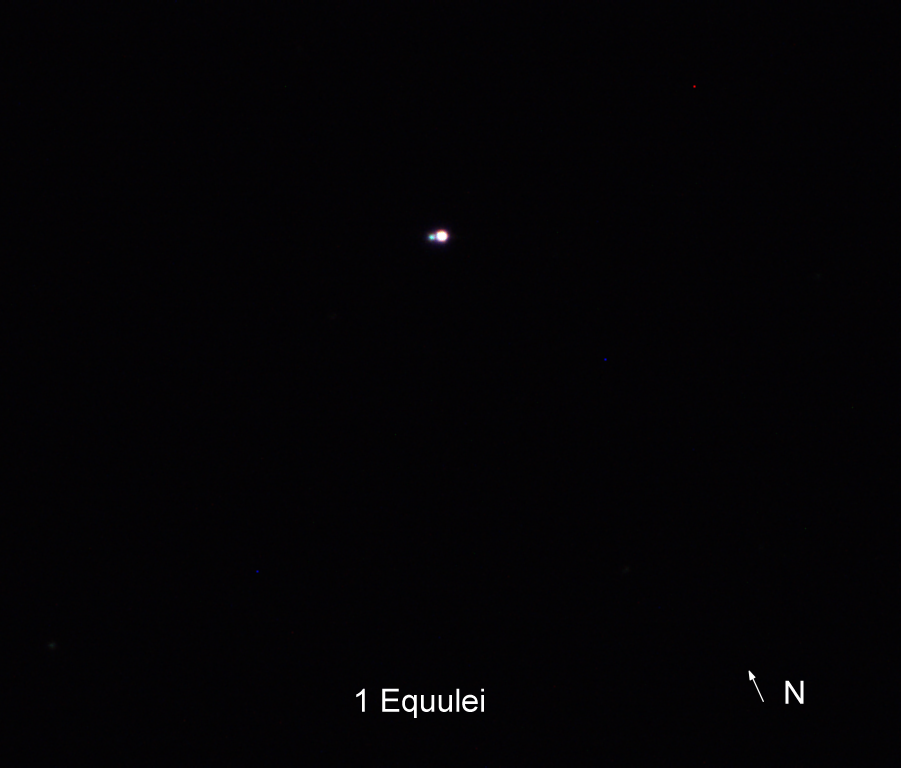
|
|
|
★
|
BU156 |
|
|
7m.4 |
9m.2 |
0.9" |
235° |
2012 |
Cyg |
21h00m49.84s / +46°34'42.80" |
Mark McCarthy
Fremont (California/USA) |
508mm (533x) |
Using apodising mask. Extraordinarily fine, B is a tiny faint point where light orange A's first diffraction ring would be -- ~1" -- but I need the diffraction ring to disappear, with seeing, to resolve it. 1.2" at discovery at 1873 with his 6-inch! |
|
|
|
★★★
|
STF2742 |
|
|
7m.4 |
7m.6 |
3.0" |
213° |
2021 |
Equ |
21h02m12.51s / +07°10'47.30" |
Robert Zebahl
Leipzig (Germany) |
70mm (57x) |
At 44x almost split with slight difference in brightness. At 57x split, but tight. |
|
René Merting
Drachhausen (Germany) |
100mm (64x) |
ähnlich wie STF2765 und STF2786 weiter nördlich wieder so ein knappes Pärchen bei 64x, das scheint Sternbild-typisch zu sein - beide Sterne sind fast gleich hell, der Stern im NO ist minimal heller |
|
Uwe Pilz
Leipzig (Germany) |
105mm (94x) |
Prachtstück! Weiß-Weißgelb. |
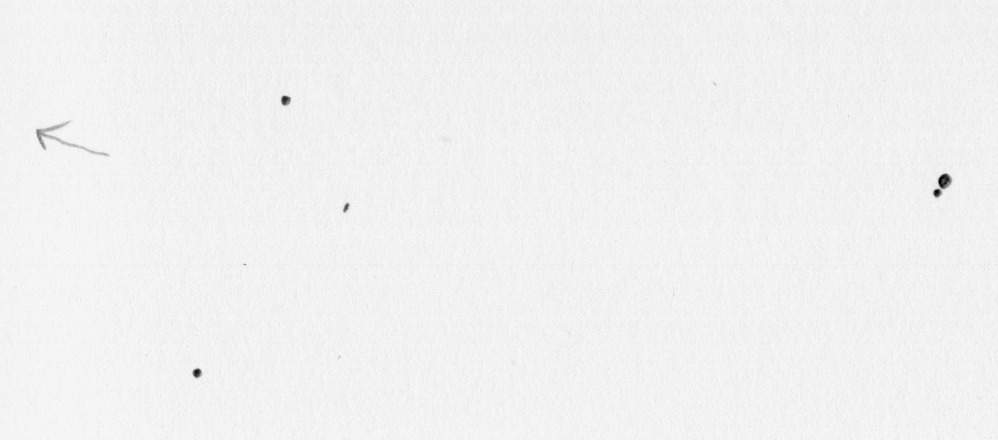
|
Mark McCarthy
Fremont (California/USA) |
317mm (553x) |
equal light orange, well split, pretty |
|
René Merting
Drachhausen (Germany) |
320mm (144x) |
bei 144x ein relativ enges Sternpaar zweier relativ gleich heller Sterne, B im Südwesten ist annähernd so hell wie A und beide Sterne strahlen reinweiß |
|
|
|
★
|
BU69 |
|
AB |
8m.3 |
9m.8 |
0.4" |
6° |
2017 |
Vul |
21h02m36.08s / +21°41'28.20" |
|
|
Mark McCarthy
Fremont (California/USA) |
317mm (553x) |
I sense overlapping disks at 553x, but marginal. |
|
|
|
★
|
BU1138 |
|
AB |
7m.1 |
7m.3 |
0.1" |
172° |
2006 |
Cyg |
21h02m48.62s / +45°50'56.00" |
|
|
Mark McCarthy
Fremont (California/USA) |
508mm (1067x) |
Notched elongation with seeing and apodising mask, white, can tell A and B's orientation by difference in magnitude. Current separation 0.155". 314 year period, it will only make modest position angle change in my time. Burnham discovered in 1888 with the Lick 36-inch at 0.3"! It seems Hough also discovered it in 1888 but published his results later, HO 282 |
|
|
|
★★
|
BU445 |
|
AB |
7m.0 |
11m.1 |
4.7" |
109° |
2015 |
Cyg |
21h03m29.53s / +29°05'33.00" |
Mark McCarthy
Fremont (California/USA) |
317mm (553x) |
Orange-red with exceptionally fainter B, only when seeing stills, else it is lost in the diffraction. Pinpoint. ~2", 4 delta mag. |
|
|
|
★
|
ES96 |
|
|
8m.3 |
12m.2 |
8.2" |
253° |
2015 |
Cyg |
21h04m35.43s / +50°28'13.70" |
Mark McCarthy
Fremont (California/USA) |
508mm (205x) |
! Extremely faint companion on edge of direct vision, wide separation. White stars, very large delta mag. Not physical |
|
|
|
★
|
COU129 |
|
|
8m.8 |
11m.8 |
0.7" |
76° |
2012 |
Vul |
21h05m32.01s / +24°33'51.10" |
Mark McCarthy
Fremont (California/USA) |
317mm (553x) |
I felt B flash momentarily with seeing, but marginal. Very tough one. |
|
|
|
★
|
BU836 |
|
AB |
10m.0 |
9m.6 |
0.8" |
177° |
2016 |
Cyg |
21h06m32.69s / +48°23'12.40" |
Mark McCarthy
Fremont (California/USA) |
508mm (333x) |
Suspected at 205x, better view at 333x. Very fine split, faint pair, nearly 1 delta mag. Burnham: "The principal pair was discovered with the 15.5-inch of the Washburn Observatory, and it was then stated that C might also be double. This was verified with the 36-inch in 1888, thus making a pretty but difficult quadruple group." Unfortunately I didn't bother with the AC pair since it was widely separated, so I missed observing CD 11.28/12.30 1.4" (1.2" when suspected at Washburn & later verified at Lick). Amazing |
|
|
|
★★★
|
STF2758, 61 Cyg |
|
AB |
5m.2 |
6m.0 |
31.9" |
154° |
2021 |
Cyg |
21h06m53.95s / +38°44'57.90" |
|
|
Christopher Hay
Seeheim (Germany) |
8x42 |
On tripod. Clearly split, northern component A substantially brighter than B. Both orange, whereby A is distinctly more yellowish than B (sky quality similar to that of earlier 15x45 and 10x42 observations). Also seems to be split using the 8x42 handheld, but hand tremor makes this uncertain. |
|
Christopher Hay
Seeheim (Germany) |
15x45 |
Clear to wide separation. Both components of orange hue. Brighter northern component seemed to go slightly into yellow. In 10x42 also clearly split, northern component of orange hue, southern component of indeterminate colour (sky not quite dark enough at the time to see 61 Cyg naked-eye). Piazzi’s Flying Star, flying more than 5” per year to the northeast, and a true physical double with a period of 678 years. |
|
Robert Zebahl
Leipzig (Germany) |
16x70 |
2021-06-14: Beautiful sight. Bright orange & orange. |
|
Sarah Gebauer
Germany |
100mm (21x) |
20.09.23: der DS hebt sich bei 20-fach sehr stark vom Umfeld ab, das typisch für das Sternbild Schwan fein und üppig funkelnd wirkt - absolut mittig, wie auf dem Präsentierteller, zeigt sich der DS kupferbraun leuchtend mit einem geringen Helligkeitsunterschied, ein fantastischer Anblick - bei 49-fach ist der Farbeindruck leicht abgeschwächt, auch der Gesamteindruck leidet aufgrund geringeren Gesichtsfeldes |
|
René Merting
Drachhausen (Germany) |
100mm (32x) |
bei 32x sind beide Sterne gut getrennt, Komponente A strahlt in einem schmutzig dunklem gelb, schwächere Komponente B leicht orange |
|
Uwe Pilz
Leipzig (Germany) |
105mm (200x) |
gelb und orange. Der weitere Stern im Bild ist TYC 3168-6781 |
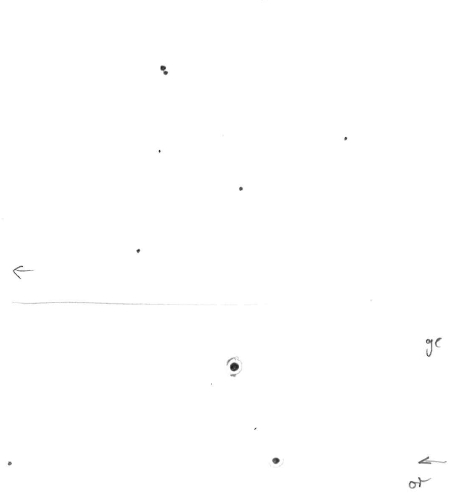
|
Uwe Pilz
Leipzig (Germany) |
105mm (200x) |
TYC 3168-5901 kann dazu dienen, den sich ändernden Positionswinkel abzuschätzen. |
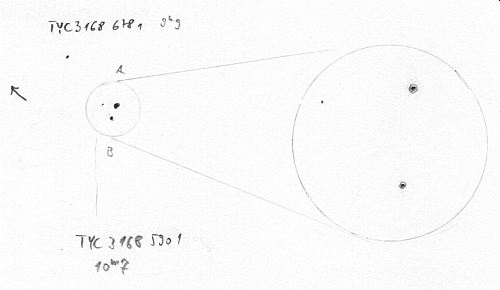
|
Jörg S. Schlimmer
Germany |
127mm (203x) |
Intensive Farbe |
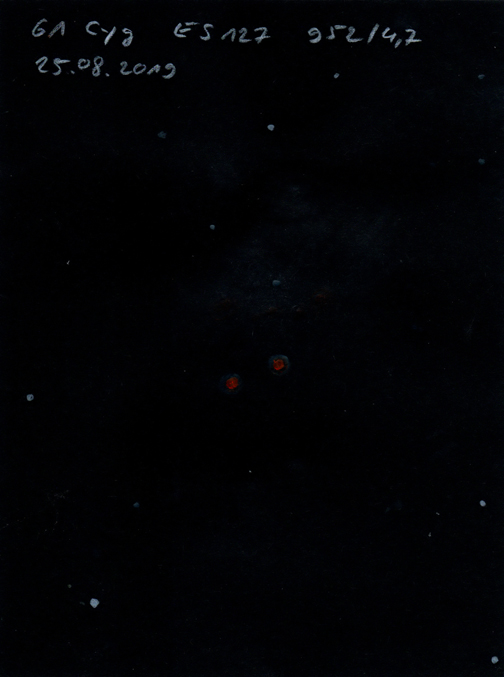
|
Robert Zebahl
Leipzig (Germany) |
152mm (22x) |
2020-06-24: Beautifully separated, bright, striking, especially the colors: bright orange and orange. |
|
Mark McCarthy
Fremont (California/USA) |
152mm (175x) |
61 Cyg. Stunning pair, yellow A and orange B, half delta mag, wide. Spectral class K5V+K7V (yellow-orange/yellow-orange). Only 11.38 light years away! Physical with a 618.6911-year period, it is now at apastron. There are 18 stars in the system but none of the visible ones are, and those only detected in K-band are uncertain |
|
Mark McCarthy
Fremont (California/USA) |
203mm (121x) |
61 Cyg. Nice near equal wide orange pair, bright [18 stars in system -- if so should be an OC] |
|
René Merting
Drachhausen (Germany) |
320mm (45x) |
bei 32x sind beide Sterne gut getrennt, Komponente A strahlt in einem schmutzig dunklem gelb, schwächere Komponente B leicht orange |
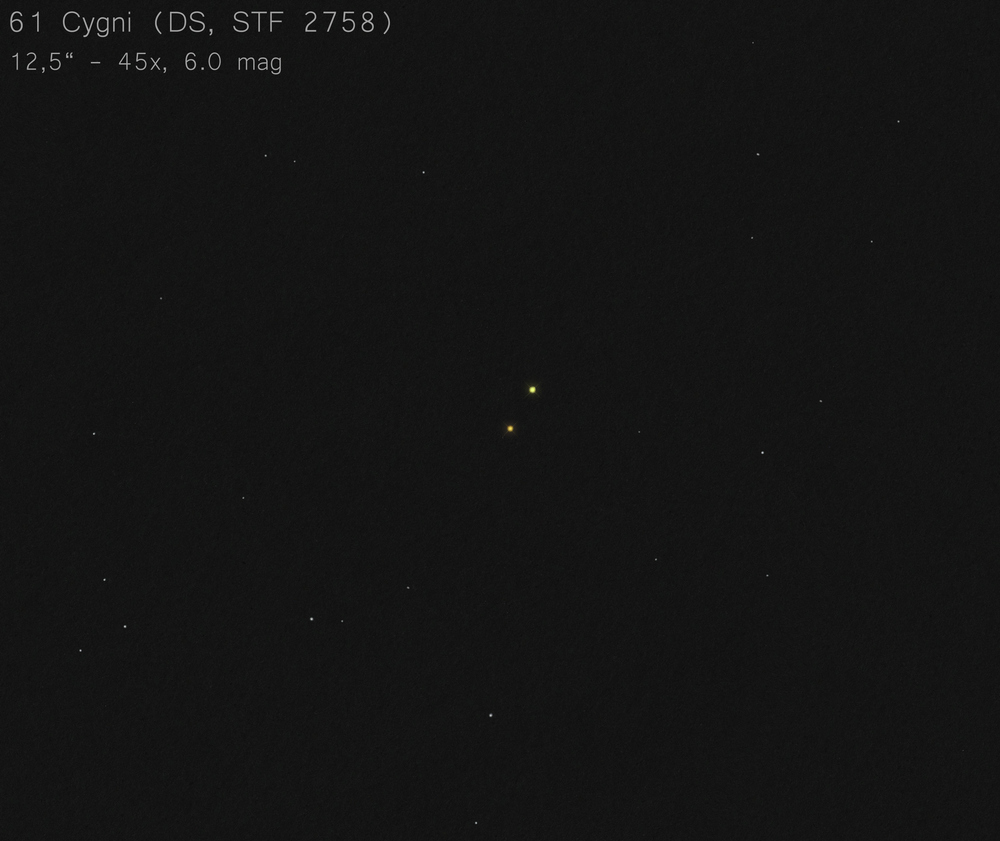
|
Uwe Pilz
Leipzig (Germany) |
320mm (121x) |
Der Doppelstern bildet 2021 mit dem 11-mag-Stern ein fast gleichschenkliges Dreieck |

|
|
Berthold Fuchs
Wiesbaden (Germany) |
130mm |
easy DS |
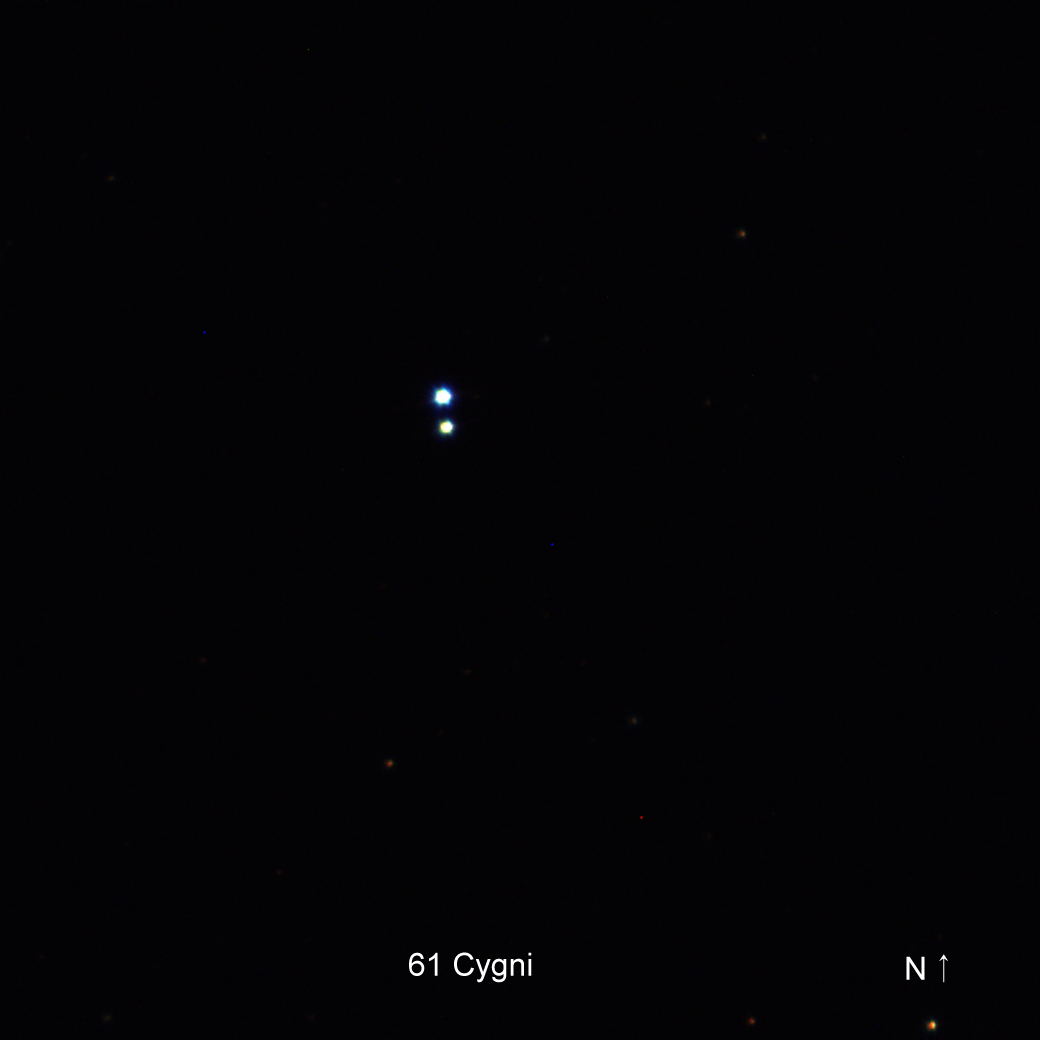
|
|
|
★
|
HU1309 |
|
AB |
10m.3 |
11m.3 |
3.0" |
171° |
2011 |
Cyg |
21h10m10.16s / +37°25'46.70" |
Mark McCarthy
Fremont (California/USA) |
203mm (205x) |
Suspected at 121x, moved up to 205x to see the tremulous B star very faint next to A, very close, good view with seeing |
|
|
|
★
|
HO151 |
|
|
9m.7 |
10m.0 |
1.6" |
17° |
2016 |
Equ |
21h10m55.45s / +03°51'55.30" |
Mark McCarthy
Fremont (California/USA) |
317mm (553x) |
Very faint, hazy unresolved patch which, when the seeing stills, is pierced by two small pinpoints. Very firm, close but separated. Both stars bluish. Lies to the south of a brighter orange star. |
|
Mark McCarthy
Fremont (California/USA) |
508mm (205x) |
Very fine pair, ~1.5", ~1 delta mag, nicely split white stars |
|
|
|
★
|
STT431 |
|
AB |
8m.8 |
9m.0 |
2.6" |
127° |
2018 |
Cyg |
21h11m30.87s / +41°14'28.70" |
Mark McCarthy
Fremont (California/USA) |
203mm (205x) |
Near equal yellow-white stars ~3" or a little less, nice! |
|
|
|
★
|
BU681 |
|
|
7m.5 |
10m.9 |
2.9" |
242° |
2016 |
Peg |
21h13m16.58s / +16°55'08.40" |
Mark McCarthy
Fremont (California/USA) |
152mm (175x) |
What a difficult pair. Did not get a convincing view at higher powers, though there seemed a brightening in diffraction with averted vision. Going to 175x I saw the B star and an especially fine point cleanly separated. WDS says physical, but very disappointingly they do not overlap their parallax ranges. Burnham discovered with the Dearborn 18.5-inch, at 2.5" |
|
Mark McCarthy
Fremont (California/USA) |
317mm (553x) |
Orange star with a very small and faint point, 0.8", condensed to a hard point in the diffraction. Tough! After reviewing data later, I think the magnitude difference made it seem closer & more difficult than it really was. |
|
|
|
★
|
H1 48 |
|
|
7m.2 |
7m.3 |
0.8" |
246° |
2020 |
Cep |
21h13m42.46s / +64°24'15.10" |
|
|
Mark McCarthy
Fremont (California/USA) |
152mm (245x) |
This was a surprise since most Herschel doubles are wide. Can tell is not single at 175x, and I get a near equal hairline split at 245x |
|
Robert Zebahl
Leipzig (Germany) |
152mm (270x) |
Clearly elongated, of equal brightness with partly visible, slight notching. |
|
Frederik Wanink
Itterbeck (Germany) |
254mm (640x) |
getrennt |

|
|
|
★
|
COU2299 |
|
|
9m.2 |
9m.4 |
0.4" |
33° |
2016 |
Cyg |
21h13m56.67s / +44°00'16.90" |
Mark McCarthy
Fremont (California/USA) |
508mm (1067x) |
Hairline split at 667x, no question steady split with 1067x. Light orange-yellow stars, nearly one delta. |
|
|
|
★
|
HO153 |
|
|
8m.5 |
9m.6 |
1.0" |
128° |
2016 |
Cyg |
21h17m39.56s / +33°45'29.80" |
Mark McCarthy
Fremont (California/USA) |
317mm (553x) |
Faint, split with seeing, 1" 1 delta mag. |
|
|
|
★
|
STF2801 |
|
|
7m.9 |
8m.6 |
2.1" |
271° |
2019 |
Cep |
21h18m31.05s / +80°21'12.50" |
René Merting
Drachhausen (Germany) |
100mm (142x) |
bei 107x als 8 erkennbar - bei 142x sind beide Komponenten in guten Momenten knapp getrennt erkennbar, B ist eine halbe Größenklasse schwächer - bei 213x stehen beide Sterne dicht beieinander und sind eindeutiger getrennt und besser zu halten als noch bei 142x |
|
Robert Zebahl
Leipzig (Germany) |
152mm (92x) |
2022-10-25: At 66x clearly visible as figure '8', partly appearing separated. At 92x finely separated with moderate brightness difference. The primary component appears in bright orange with a fainter companion. |
|
Mark McCarthy
Fremont (California/USA) |
152mm (245x) |
Nice! Light orange A and blue B, 1 delta mag, around 2" separation |
|
|
|
★
|
STF2786 |
|
|
7m.5 |
8m.2 |
2.8" |
188° |
2016 |
Equ |
21h19m39.36s / +09°31'30.30" |
Robert Zebahl
Leipzig (Germany) |
70mm (57x) |
At 44x elongated, slightly notched. At 57x barely split with visible, but little difference in brightness. |
|
René Merting
Drachhausen (Germany) |
100mm (64x) |
bei 64x sind beide Komponenten ganz knapp getrennt erkennbar - Komponente A im Norden ist etwas heller als B |
|
Uwe Pilz
Leipzig (Germany) |
105mm (144x) |
|
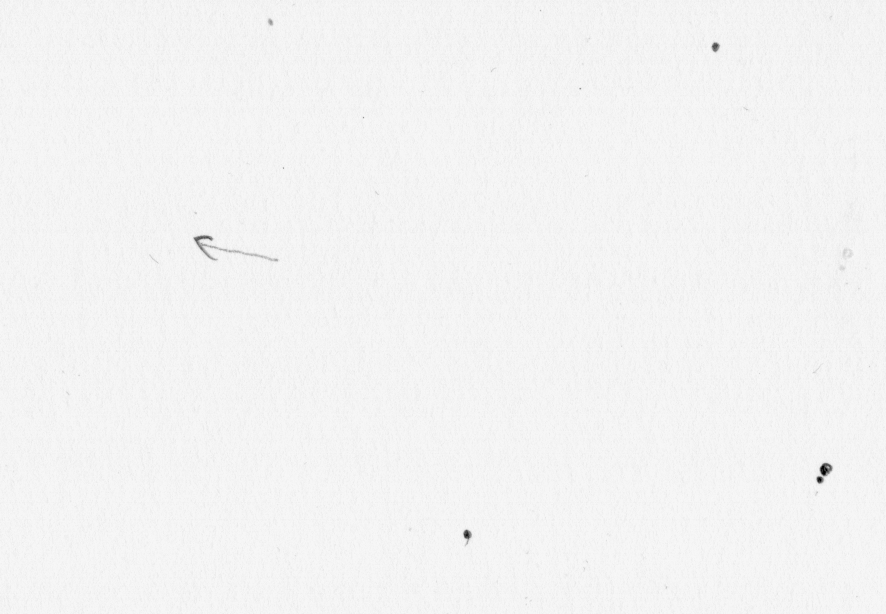
|
Mark McCarthy
Fremont (California/USA) |
203mm (533x) |
Sharp white and B is about 1 delta mag and duller, almost bluish. |
|
Mark McCarthy
Fremont (California/USA) |
317mm (553x) |
Pale yellow stars, B a slightly darker tint though 1 delta mag dimmer, well split |
|
|
|
★
|
STF2789 |
|
AB |
7m.7 |
7m.9 |
6.9" |
113° |
2019 |
Cyg |
21h19m58.84s / +52°58'44.10" |
Robert Zebahl
Leipzig (Germany) |
70mm (44x) |
At 22x almost separated. The double star appeared strikingly orange and forms a conspicuous, nearly isosceles triangle with neighbouring stars. At 44x clearly separated, relatively close together with a small difference in brightness. |
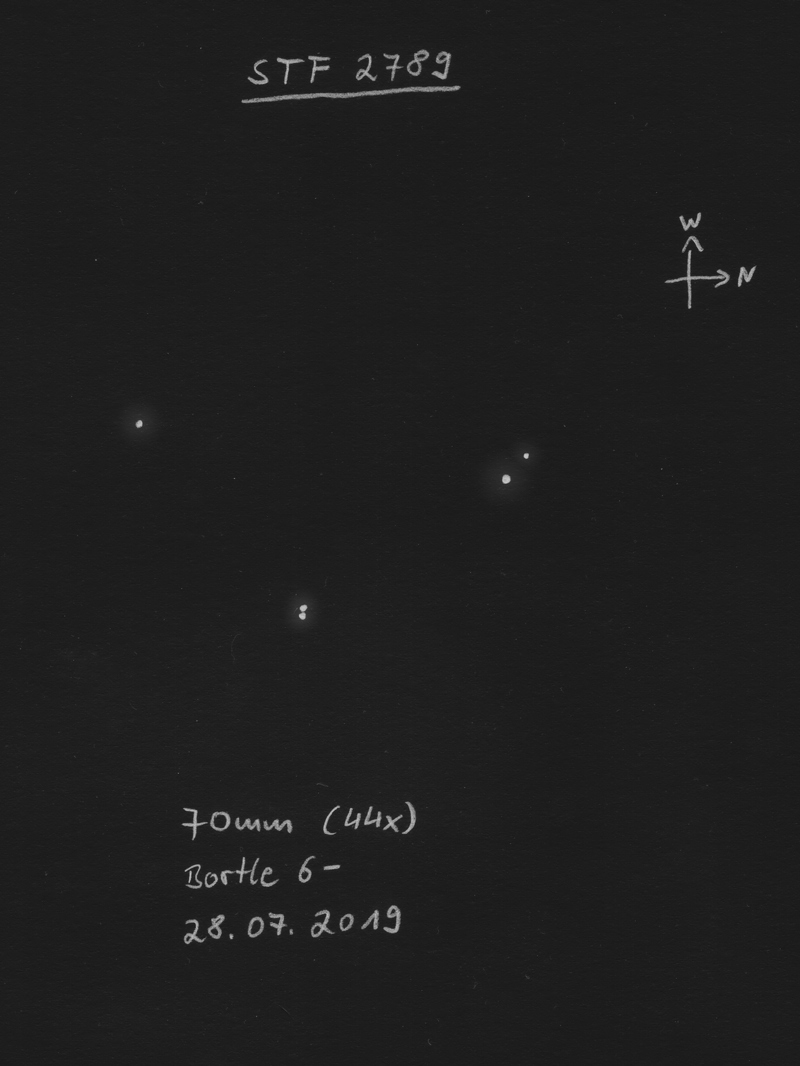
|
René Merting
Drachhausen (Germany) |
100mm (32x) |
bei 32x zwei gleichhelle ganz dicht beieinander stehende weiße Lichtpünktchen, ganz knapp getrennt - wunderschön mit dieser Teleskopöffnung |
|
Mark McCarthy
Fremont (California/USA) |
152mm (175x) |
Well separated equal pair. WDS says physical with a 180 century period, and provides an orbit. 98% parallax range overlap, 565 AU weighted separation, 1.55/1.51 solar mass, and the delta radial velocity is less than the escape velocity, so that's a confirmed gravitational pair |
|
|
|
★
|
STFB11 & TOK9001, 1 Peg |
STFB11 |
AB |
4m.2 |
9m.3 |
36.6" |
313° |
2020 |
Peg |
21h22m05.13s / +19°48'15.70" |
|
|
|
STFB11 |
AC |
4m.2 |
12m.9 |
64.3" |
13° |
2017 |
|
|
|
|
|
TOK9001 |
AD |
4m.2 |
9m.6 |
5.3" |
151° |
1993 |
|
|
|
|
René Merting
Drachhausen (Germany) |
18x70 |
STFB11 (AB): ein heller Doppelstern mit einer samtgelben A-Komponente - B gut abgesetzt im Nordwesten von A, ein schwacher grauer Fleck - Helligkeitsunterschied enorm |
|
René Merting
Drachhausen (Germany) |
76mm (29x) |
STFB11 (AB): bei 29x zeigt sich die B Komponente deutlich abgesetzt nordwestlich von A und ist viel schwächer - Komponente A ist gelblich, B eher grau |
|
Uwe Pilz
Leipzig (Germany) |
105mm (88x) |
STFB11 (AB): der helle Stern ist weiß. |
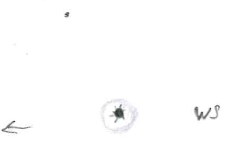
|
Mark McCarthy
Fremont (California/USA) |
317mm (553x) |
STFB11 (AB): 1 Peg: Easy yellow-orange & wide separated B |
|
|
|
★
|
HU275 |
|
|
9m.5 |
9m.5 |
0.4" |
56° |
2017 |
Equ |
21h22m28.64s / +08°27'16.10" |
Mark McCarthy
Fremont (California/USA) |
508mm (667x) |
! Suspected at 533x, hairline split 667x, light orange stars, near equal |
|
|
|
★
|
ALD76 |
|
|
11m.4 |
11m.5 |
3.0" |
66° |
2016 |
Equ |
21h22m52.26s / +06°43'56.60" |
Mark McCarthy
Fremont (California/USA) |
508mm (205x) |
! Nice near equal stars, nicely separated outside the glow of a very bright white star. Sadly not physical |
|
|
|
★
|
A1892 |
|
|
8m.2 |
9m.3 |
0.8" |
351° |
2016 |
Cyg |
21h23m40.12s / +55°17'38.70" |
Mark McCarthy
Fremont (California/USA) |
317mm (553x) |
When seeing stills disk resolves with pin point <1" split, very fine. 1 delta mag. |
|
|
|
★
|
STF2806, 8 Cep, beta Cep, Alfirk |
|
AB |
3m.2 |
8m.6 |
13.6" |
250° |
2020 |
Cep |
21h28m39.58s / +70°33'38.50" |
Sarah Gebauer
Germany |
100mm (45x) |
bei 45x haarscharf getrennt, die zweite Komponente fällt erst auf den zweiten Blick auf, da sie viel schwächer und kleiner ist und beinahe vom Lichtschein der Hauptkomponente überstrahlt wird |
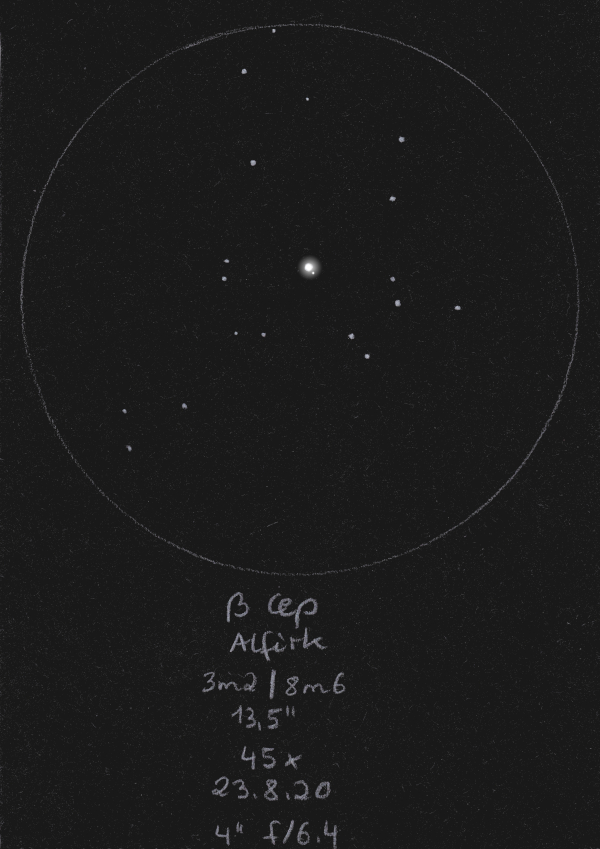
|
Sarah Gebauer
Germany |
100mm (49x) |
01.10.23: der DS ist bei 21-fach nur ein greller, weißer Stern - bei 49-fach zeigt sich plötzlich ein bedeutend schwächerer, schmutzig grauer Begleitstern im Westsüdwesten, A strahlt nach wie vor alpina-reinweiß |
|
Mark McCarthy
Fremont (California/USA) |
152mm (175x) |
Alfirk. Bright yellow-green and 3 delta mag, bluish b, wide. WDS uncertain, no Gaia data on the primary |
|
|
Frederik Wanink
Itterbeck (Germany) |
254mm |
|
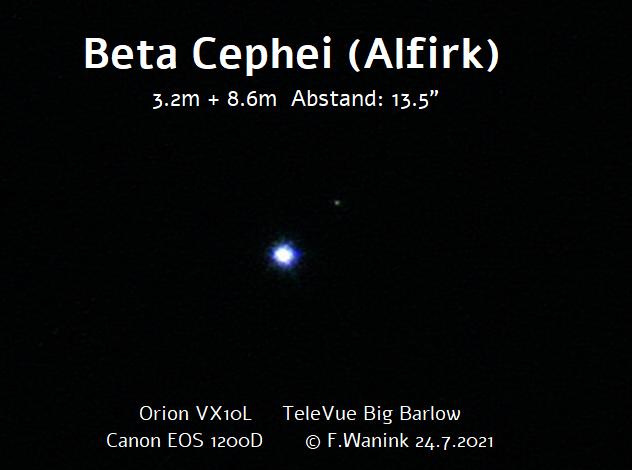
|
|
|
★★
|
B1008 |
|
AB |
8m.9 |
8m.1 |
0.1" |
206° |
2021 |
PsA |
21h30m57.70s / -36°32'49.70" |
|
|
Mark McCarthy
Fremont (California/USA) |
317mm (553x) |
Propus (means "forefoot") = Eta Geminorum: So cool! Bright orange star with B very close, ~1.5", just preceding, ~3 delta mag. B is in diffraction but is well separated & has its own airy disk, bluish white. |
|
|
|
★★
|
HO603 |
|
AB |
7m.5 |
9m.8 |
80.6" |
251° |
2015 |
Cyg |
21h32m04.61s / +34°12'06.10" |
|
|
|
|
BC |
9m.8 |
11m.3 |
3.6" |
276° |
2016 |
|
|
Mark McCarthy
Fremont (California/USA) |
317mm (553x) |
AB: Very wide 2 delta mag, but B has a fainter close pair to it, seen with averted vision, about 3" separation (this is BC). |
|
Mark McCarthy
Fremont (California/USA) |
317mm (553x) |
BC: B star to HO603AB has a fainter close pair to it, seen with averted vision, about 3" separation. |
|
|
|
★
|
STF2804 |
|
AB |
7m.7 |
8m.0 |
3.3" |
359° |
2019 |
Peg |
21h32m58.30s / +20°42'44.50" |
|
|
Robert Zebahl
Leipzig (Germany) |
70mm (57x) |
Clearly split, pretty close, moderately uneven. The primary components looked slightly orange. Very nice pair. |
|
Uwe Pilz
Leipzig (Germany) |
105mm (88x) |
der südliche Stern ist einen Hauch heller. Gelb und orange. |

|
Mark McCarthy
Fremont (California/USA) |
203mm (533x) |
Nice light orange and light blue, sharp, 1 delta mag 3". pretty. |
|
René Merting
Drachhausen (Germany) |
320mm (144x) |
bei 144x ein ganz knapp getrennter DS mit zwei gleich hellen, weißen Sternen - B im Norden scheint etwas schwächer zu sein |
|
|
|
★
|
STF2816 |
|
AC |
5m.7 |
7m.5 |
11.8" |
120° |
2018 |
Cep |
21h38m57.61s / +57°29'20.50" |
|
|
|
|
AD |
5m.7 |
7m.5 |
20.6" |
339° |
2018 |
|
|
Sarah Gebauer
Germany |
100mm (49x) |
26.09.23: bei 49-fach sind auf Anhieb drei schmal beieinander stehende Komponenten zu sehen, außerdem ist STF 2819 mit im Gesichtsfeld - AB als hellste Komponente steht mittig und strahlt ganz zart zitronengelb, die nordwestliche Komponente D zeigt hin und wieder einen Blauschimmer, die südöstliche Komponente C zeigt sich ganz leicht beigebraun - drei ganz subtil unterschiedliche Farben, schön! |
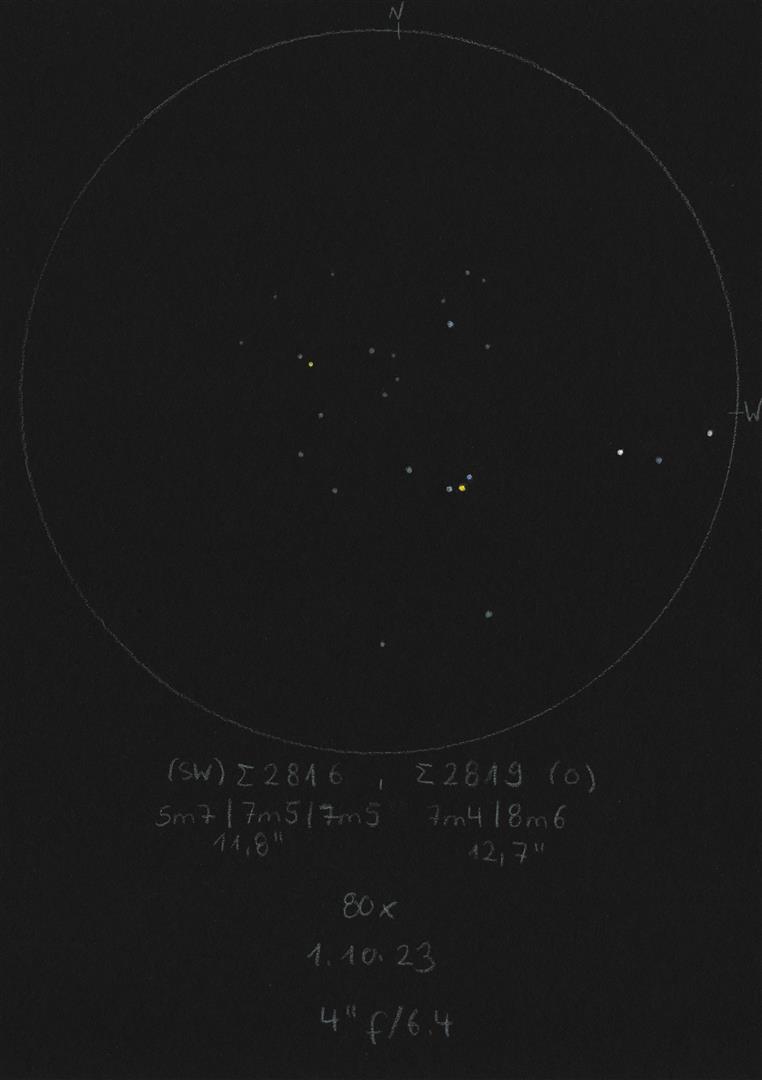
|
Uwe Pilz
Leipzig (Germany) |
105mm (200x) |
gehört zu einem Sternentstehungsgebiet |
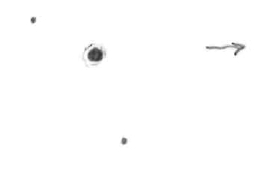
|
Mark McCarthy
Fremont (California/USA) |
152mm (175x) |
AC: Bright A, 2 delta mag B, close split. It is the brighter and closer pair of the double-double, with STF 2829, at the center of open cluster IC 1396 |
|
|
|
★
|
mu Cyg, 78 Cyg, STF2822 |
|
AB |
4m.8 |
6m.2 |
1.6" |
325° |
2020 |
Cyg |
21h44m08.57s / +28°44'33.40" |
|
|
|
|
AD |
4m.8 |
6m.9 |
197.0" |
43° |
2019 |
|
|
|
|
Uwe Pilz
Leipzig (Germany) |
60mm (198x) |
AB: Aufhellung innerhalb des ersten Rings |
|
Robert Zebahl
Leipzig (Germany) |
70mm (128x) |
AB: At 128x I was able to see this double at least elongated. |
|
Sarah Gebauer
Germany |
150mm (160x) |
AD: bei der Sichtung noch eher unsicher, welche der hellen Sterne die Komponenten AB enthalten, denn diese habe ich nicht getrennt, AD mit einem Abstand von 196'' stehen mit drei weiteren Feldsternen in einer mehr oder minder interessanten Konstellation |

|
Mark McCarthy
Fremont (California/USA) |
152mm (175x) |
AB: Very pretty color contrast, yellow and orange, 2 delta mag. Physical with a 692.0588-year period, it is coming off periastron and will slowly widen |
|
Robert Zebahl
Leipzig (Germany) |
200mm (171x) |
AB: Quite well split with noticeable fainter component. |
|
Frederik Wanink
Itterbeck (Germany) |
254mm (640x) |
AB: getrennt |

|
Mark McCarthy
Fremont (California/USA) |
317mm (553x) |
AB: Yellow and light orange pair, ~1", 1 delta mag. Very pretty, subtle colors |
|
|
|
★
|
kappa Peg, 10 Peg |
BU989 |
AB |
4m.9 |
5m.0 |
0.2" |
134° |
2019 |
Peg |
21h44m38.70s / +25°38'42.00" |
|
|
|
STF2824 |
AB-C |
4m.1 |
10m.8 |
14.5" |
288° |
2004 |
|
|
Mark McCarthy
Fremont (California/USA) |
203mm (533x) |
STF2824 (AB-C): Kappa Peg Pretty pale yellow A star, bright, with 6 delta mag B wide and clean, small blue dot no diffraction spikes [Did not see BU 989 AB, 5.04 0.2"] |
|
René Merting
Drachhausen (Germany) |
320mm (144x) |
STF2824 (AB-C): bei 144x steht C mit ordentlichem Abstand getrennt zu AB, der so gleißend hell ist und einen Halo bis weiter über die C-Komponente hinaus wirft - die Farbe von AB ist weiß mit einem Hauch Gelb, C ist extrem schwach und wirkt grau, wie ein kleiner Planet, der um seine Sonne kreist |
|
Mark McCarthy
Fremont (California/USA) |
508mm (1067x) |
BU989 (AB): Overlapping disks, moderately strong notch, near equal. This has an astonishingly short 11.57 year period. At apastron now, it will be at periastron by 2025, and widen agin -- it will be fun to see this close then open again. |
|
|
|
★
|
STF2840 |
|
AB |
5m.6 |
6m.4 |
18.1" |
197° |
2018 |
Cep |
21h52m01.02s / +55°47'48.30" |
René Merting
Drachhausen (Germany) |
15x56 |
optimal für diese Vergrößerung - ein schönes helles Pärchen, knapp getrennt |
|
Robert Zebahl
Leipzig (Germany) |
55mm (25x) |
Striking double star with clear distance and difference in brightness. |
|
Robert Zebahl
Leipzig (Germany) |
70mm (22x) |
Striking, beautiful double star with visible difference in brightness. At 44x A appeared rather yellowish, B slightly bluish, whereby the colors were difficult to detect. |
|
René Merting
Drachhausen (Germany) |
100mm (20x) |
bei 32x ein gut getrenntes Pärchen - Komponente B im Süden ist knapp eine Größenklasse schwächer - Komponente A wirkt weiß-gelblich, B eher gräulich - zurück auf 20x ist das Pärchen auch noch sehr ansehnlich, beide Sterne stehen schön dicht zusammen, die Trennung ist deutlich |
|
Sarah Gebauer
Germany |
100mm (21x) |
bei 20x bereits ganz fein getrennt, zeigt allerdings keine Farbe – bei 80x und weiter Trennung dann nach wie vor kein Farbeindruck |
|
René Merting
Drachhausen (Germany) |
320mm (103x) |
bei 45x bereits getrennt zu sehen - bei 103x zeigt er sich in zwei unterschiedlichen, diamantenen Farben, die B-Komponente im Süden strahlt leicht gelbgolden, die A-Komponente schimmert blauweiß - der Farbkontrast ist nicht direkt greifbar und dennoch wahrnehmbar |
|
|
|
★★
|
STF2841 |
|
A-BC |
6m.5 |
8m.0 |
22.4" |
110° |
2018 |
Peg |
21h54m17.44s / +19°43'05.30" |
Robert Zebahl
Leipzig (Germany) |
70mm (22x) |
At 22x easy to separate with considerable difference in brightness. The primary component appeared slightly yellowish-orange, the fainter component greyish-blue. The slight color contrast was especially visible at 44x. |
|
Sarah Gebauer
Germany |
100mm (49x) |
01.10.23: ein ganz klassisches Farbkontrastpaar von Gelbgold zu Leinblütenblau, bei 49-fach schön getrennt |

|
Uwe Pilz
Leipzig (Germany) |
105mm (88x) |
|
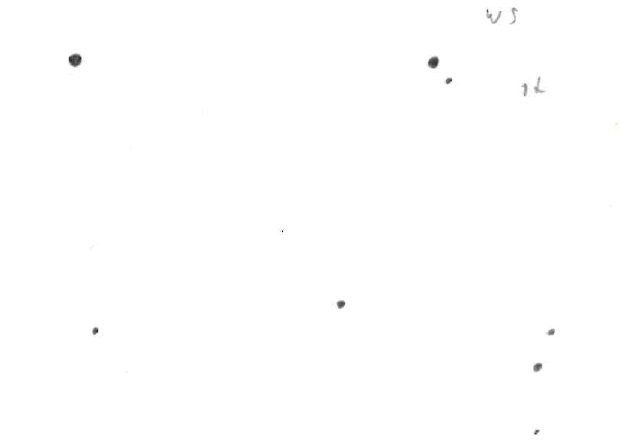
|
Mark McCarthy
Fremont (California/USA) |
203mm (533x) |
Very wide 2 delta mag pair, white and light blue [COU 432 is the AB, 0.1" near equal, was 0.2" at discovery!] |
|
Mark McCarthy
Fremont (California/USA) |
317mm (553x) |
Orange & blue, very wide separation, ~2 magnitude difference. |
|
|
Berthold Fuchs
Wiesbaden (Germany) |
130mm |
easy DS |
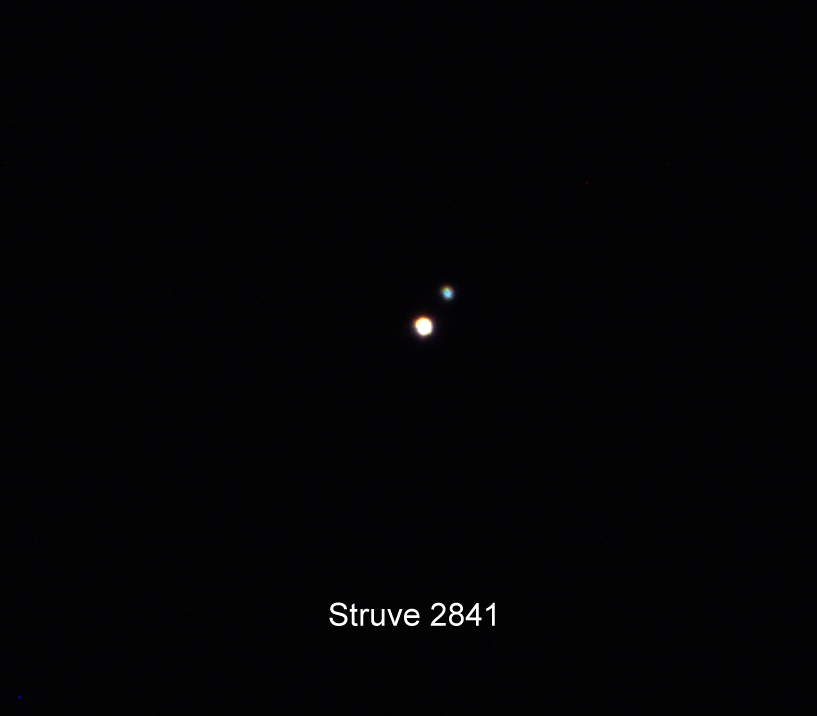
|
|
|
★★
|
STF2838 |
|
AB |
6m.3 |
9m.5 |
16.0" |
183° |
2015 |
Aqr |
21h54m35.91s / -03°18'04.50" |
René Merting
Drachhausen (Germany) |
100mm (20x) |
bei 32x zeigt sich B gut abgesetzt südlich von A - großer Helligkeitsunterschied, mindestens 3 Größenklassen - zurück auf 20x kann ich beide Sterne auch getrennt erkennen, Komponente B ist dann aber eine ordentliche Anstrengung, hier braucht es etwas Geduld, bis ich den Stern erkennen kann |
|
Sarah Gebauer
Germany |
254mm (49x) |
bei 49-fach schon ganz fein getrennt – die helle Komponente hebt sich farblich kaum von den anderen Sternen in der gedanklich gebildeten Raute im Bildfeld ab – sie ist nur minimal wärmer vom Farbton – der Begleiter südwestlich ist besonders schwach und mausgrau – bei 96-fach ist die Trennung dann weit und die Hauptkomponente zeigt sich wesentlich warmgelber, der Begleiter schimmert immer wieder in einem blassen, hellen Königsblau auf – da ist der Farbkontrast, toll! |
|
|
|
★
|
HO173 |
|
|
10m.3 |
10m.6 |
0.9" |
73° |
2016 |
Peg |
21h55m17.17s / +18°43'11.70" |
Mark McCarthy
Fremont (California/USA) |
508mm (533x) |
Very fine pair, almost one delta mag, very close but nicely split, <1", quite a sight |
|
|
|
★
|
A303 |
|
AB |
9m.2 |
11m.6 |
2.3" |
52° |
2016 |
Peg |
21h55m29.91s / +27°23'35.60" |
Mark McCarthy
Fremont (California/USA) |
508mm (533x) |
Slightly orange A star and very faint blue B, ~4", just seen direct vision. Very nice. |
|
|
|
★
|
STT452 |
|
|
9m.0 |
9m.6 |
0.8" |
177° |
2016 |
Peg |
21h55m40.01s / +07°15'13.90" |
Mark McCarthy
Fremont (California/USA) |
508mm (533x) |
Noticed split immediately, white stars, half delta mag, very cool split |
|
|
|
★
|
STF2873 |
|
AB |
7m.0 |
7m.5 |
14.6" |
66° |
2022 |
Cep |
21h58m13.53s / +82°52'10.80" |
|
|
Robert Zebahl
Leipzig (Germany) |
55mm (25x) |
2018-09-27: Easy to split with visible difference in brightness. Stands out immediately. |
|
René Merting
Drachhausen (Germany) |
100mm (20x) |
bei 32x ein gut getrenntes Pärchen, B ist eine halbe Magnitude schwächer und strahlt ein wenig kühler als A - eine richtig schöne Vergrößerung ist 20x, dann stehen beide Sterne sehr dicht und zeigen schön ihren leichten Farbkontrast |
|
Robert Zebahl
Leipzig (Germany) |
152mm (30x) |
2022-10-25: Very pretty, eye-catching double star with nice separation and slight difference in brightness. The color assignment of the components was difficult: bright orange & white-bluish. |
|
|
|
★
|
A304 |
|
AB |
9m.5 |
9m.3 |
0.6" |
131° |
2015 |
Peg |
21h58m30.37s / +27°24'34.60" |
Mark McCarthy
Fremont (California/USA) |
508mm (533x) |
Most definite clean split of one delta mag stars, very nice disks |
|
|
|
★
|
STF2850 |
|
|
7m.0 |
11m.0 |
2.8" |
264° |
1983 |
Peg |
21h59m49.60s / +23°56'27.40" |
Mark McCarthy
Fremont (California/USA) |
508mm (533x) |
OU Peg. Very beautiful pair, rich orange and blue, well separated, four or five delta mag. |
|
|
|
★
|
HO610 |
|
AB |
10m.1 |
10m.2 |
0.6" |
241° |
2016 |
Peg |
22h02m00.73s / +26°50'46.60" |
Mark McCarthy
Fremont (California/USA) |
508mm (533x) |
Superfine, split nicely, ~0.7", half delta mag. [three other wider >12th mag pairs not seen] |
|
|
|
★★
|
STF2863, xi Cep, 17 Cep |
|
AB |
4m.5 |
6m.4 |
8.2" |
274° |
2022 |
Cep |
22h03m47.45s / +64°37'40.70" |
|
|
Robert Zebahl
Leipzig (Germany) |
55mm (27x) |
At 27x well separable, but quite close together with a clear difference in brightness. At 71x very nice view. |
|
Sarah Gebauer
Germany |
100mm (80x) |
bei 20x ansatzweise länglich und leicht gelblich zu erkennen – bei 80x wirkt die Trennung sehr schön und A hat einen richtig warmorange Farbton, B wirkt kaltweißer und deutlich feiner – beide zusammen wirken wie ein Schmuckstück, das aus Gelbgold und Weißgold gearbeitet wurde |
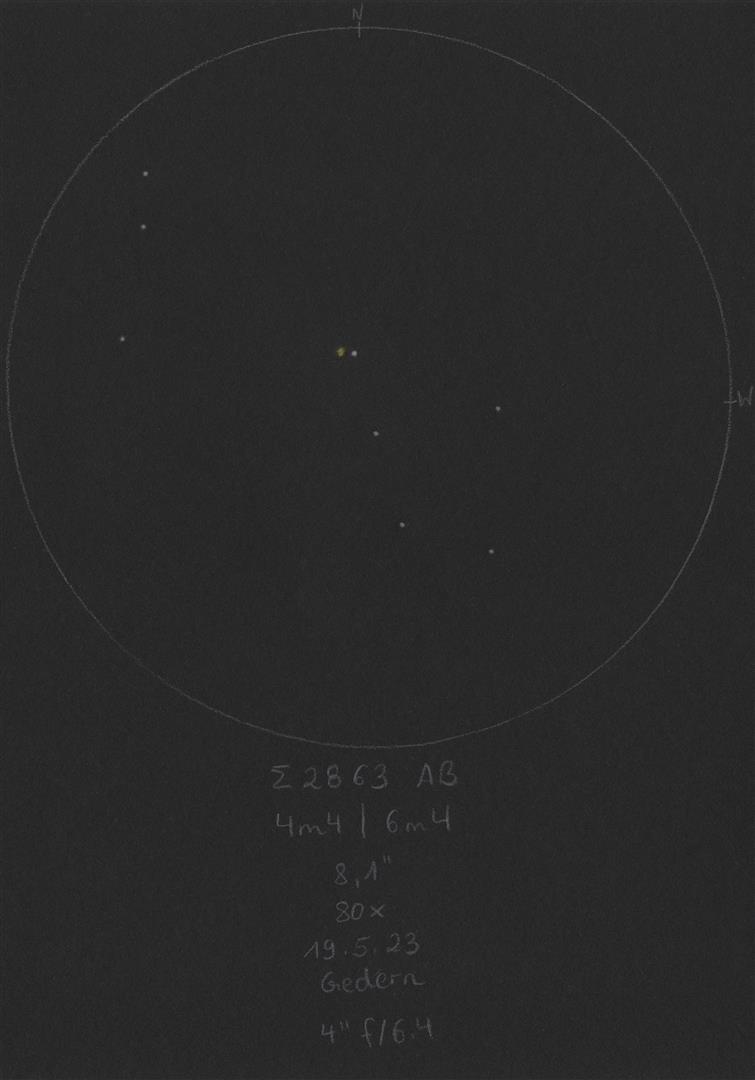
|
René Merting
Drachhausen (Germany) |
107mm (43x) |
bei 43x sind beide Komponenten dicht beieinander - B ist deutlich schwächer und kann sich nicht trennen vom großen Bruder - 60x reichen dann aber für eine knappe Trennung - Komponente A strahlt in einem schönen Gelbweiß, B schätze ich 2 Magnituden schwächer, aber immernoch hell genug, um weiß zu strahlen |
|
Mark McCarthy
Fremont (California/USA) |
203mm (205x) |
Alkurhah. Pretty very light yellow bright A star, and ~2 delta mag, very light orange B, wide. Physical pair with a 3800 year period |
|
René Merting
Drachhausen (Germany) |
320mm (45x) |
bei 45x sind beide Sterne noch dicht aneinander klebend zu erkennen, in guten Momenten gelingt aber auch schon die Trennung - A wirkt warmweiß, B ist gut 1.5 Magnituden schwächer und ist weiß |
|
|
|
★★★
|
STF2854 |
|
|
7m.8 |
7m.9 |
1.6" |
84° |
2017 |
Peg |
22h04m22.52s / +13°38'53.40" |
Robert Zebahl
Leipzig (Germany) |
70mm (133x) |
Observed at 133x and 160x. Clearly elongated, from time to time with very little indentation. The air could have been steadier. |
|
Uwe Pilz
Leipzig (Germany) |
105mm (200x) |
|

|
Mark McCarthy
Fremont (California/USA) |
152mm (175x) |
Nice! Very fine near equal blue-white stars. WDS uncertain, but they are likely gravitational with 45% parallax range overlap, 130 AU weighted separation, 1.42/1.37 solar mass |
|
Mark McCarthy
Fremont (California/USA) |
203mm (533x) |
Striking pair, more near equal then 1 delta mag in Sky Tools. 2", white. Very nice. |
|
|
|
★
|
HJ1721 |
|
|
7m.9 |
9m.4 |
12.8" |
264° |
2018 |
Peg |
22h05m44.53s / +29°54'23.30" |
René Merting
Drachhausen (Germany) |
100mm (20x) |
bei 32x ein schönes nicht zu weit getrenntes Sternpaar - Komponente A im Osten strahlt leicht gelblich, die gut 1.5 Magnituden schwächere Komponente B leicht grau-weiß - zurück auf 20x ist B nur blickweise und noch nicht getrennt erkennbar |
|
Sarah Gebauer
Germany |
254mm (49x) |
zeigt sich bei 49-fach auf Anhieb mit Farbkontrast mit Orange und ganz zartem Leinblütenblau - die Trennung ist mit 96-fach einfacher - das Sternumfeld ist ansprechend und nimmt sich dennoch auf seine Weise zurück, sodass der Doppelstern das Zentrum des Bildes für sich einnehmen kann |
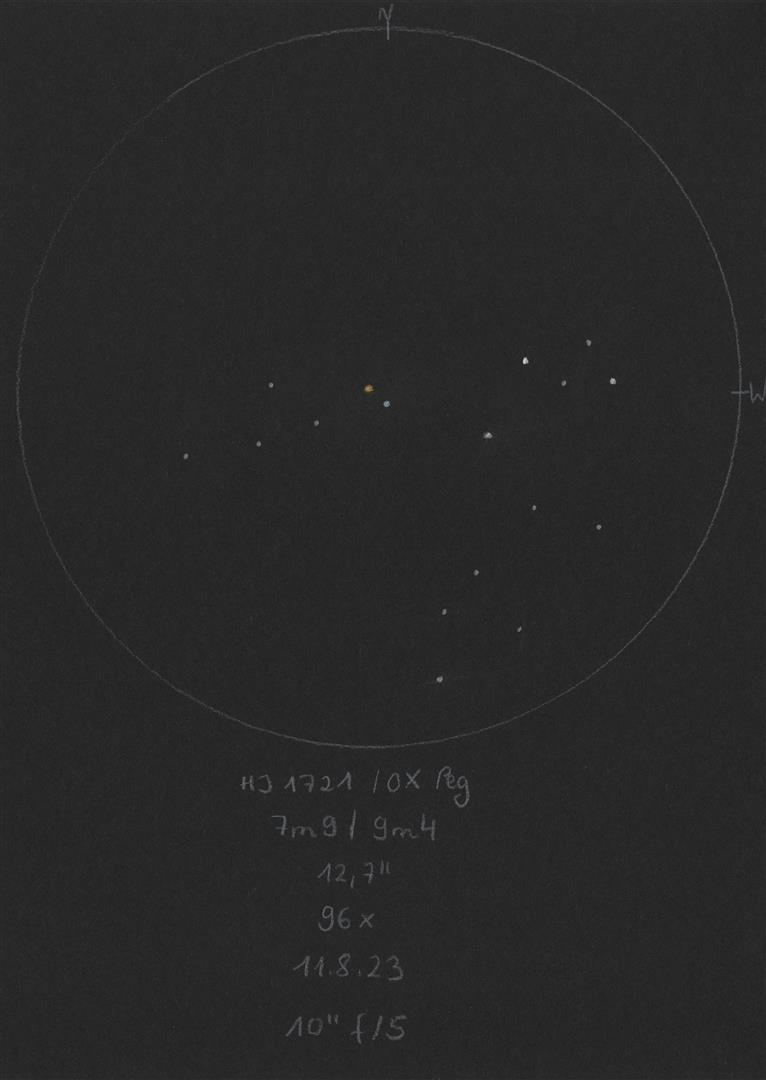
|
Mark McCarthy
Fremont (California/USA) |
508mm (205x) |
OX Peg. A surprisingly pretty pair, light orange A and light blue B, ~2 delta mag, wide. The A star is spectral class M (red). There's a fine near equal double in the same field, J 1225 |
|
|
|
★
|
COU537 |
|
|
8m.6 |
8m.8 |
0.2" |
328° |
2013 |
Peg |
22h07m40.20s / +26°21'35.80" |
|
|
Mark McCarthy
Fremont (California/USA) |
508mm (1067x) |
Suspected with 667x. Exceedingly difficult, it's an elongated rod pointed a particular way from the reference star in the field. At moments of best seeing I detect two brightened ends of that rod, not quite split, but can tell is double. PA is now to the north and this closely matches my sketch, however my sense of which is A and B is reversed. 47.3 year period, at apastron now, it will not be detectable after 2030 |
|
|
|
★
|
COU136 |
|
|
9m.2 |
7m.6 |
0.4" |
19° |
2015 |
Peg |
22h10m02.22s / +23°07'33.00" |
|
|
Mark McCarthy
Fremont (California/USA) |
508mm (1067x) |
Awesome hairline at 533x, nice clean split at 1067x. The stars are split the diffraction patters merge at the boarders, perfect images. Appears more near equal than SkyTools data suggests |
|
|
|
★
|
STF2879 |
|
AB |
8m.0 |
8m.3 |
0.7" |
233° |
2018 |
Cep |
22h10m59.56s / +63°23'58.50" |
Mark McCarthy
Fremont (California/USA) |
203mm (205x) |
V447 Cep ! Excellent pair, seen at small scale at this magnification. Nice clean split, half delta mag, really pretty. A is variable 7.26 - 7.62 V over a period of 7.52655 days, but there is a lack of recent observations on AAVSO. If it were near maximum it might be more difficult to resolve the split at small aperture. I also pick up a very faint white star the averted vision, widely separated -- this is AC, 7.99/11.91 29.2. FYM 192 AD, mag 12.98, not seen |
|
Frederik Wanink
Itterbeck (Germany) |
254mm (640x) |
ähnlich hell, gut trennbar |

|
|
|
★
|
HO178 |
|
AB |
7m.4 |
11m.2 |
3.4" |
221° |
2019 |
Peg |
22h11m28.36s / +32°05'09.90" |
Mark McCarthy
Fremont (California/USA) |
152mm (175x) |
Extremely faint B seen averted vision only, close but fairly well split. WDS physical based on proper motions, but there is no overlap in the parallax range, so not |
|
Mark McCarthy
Fremont (California/USA) |
508mm (205x) |
! Wow this is a good one. A is a blazing white and just beyond its glow is a very faint point of the B star, such a contrast in the magnitudes. ~4" and ~4 delta mag. |
|
|
|
★★
|
HJ1740 |
|
|
12m.7 |
13m.2 |
9.9" |
111° |
2016 |
Aqr |
22h11m57.12s / -07°29'31.00" |
Sarah Gebauer
Germany |
100mm (49x) |
20.09.23: mit 49-fach sehr weit getrennt, die südöstliche Komponente zeigt sich ganz leicht orange, die nordwestliche grau mit einem zarten Hauch von Leinblütenblau - das Sternumfeld erinnert mich sehr an einen Apfel, dessen kleiner Stiel im Nordwesten vom Doppelstern gebildet wird, der Apfel selbst besteht aus sehr vielen, feinen Sternchen, die zumeist in Zweiergrüppchen angeordnet sind |
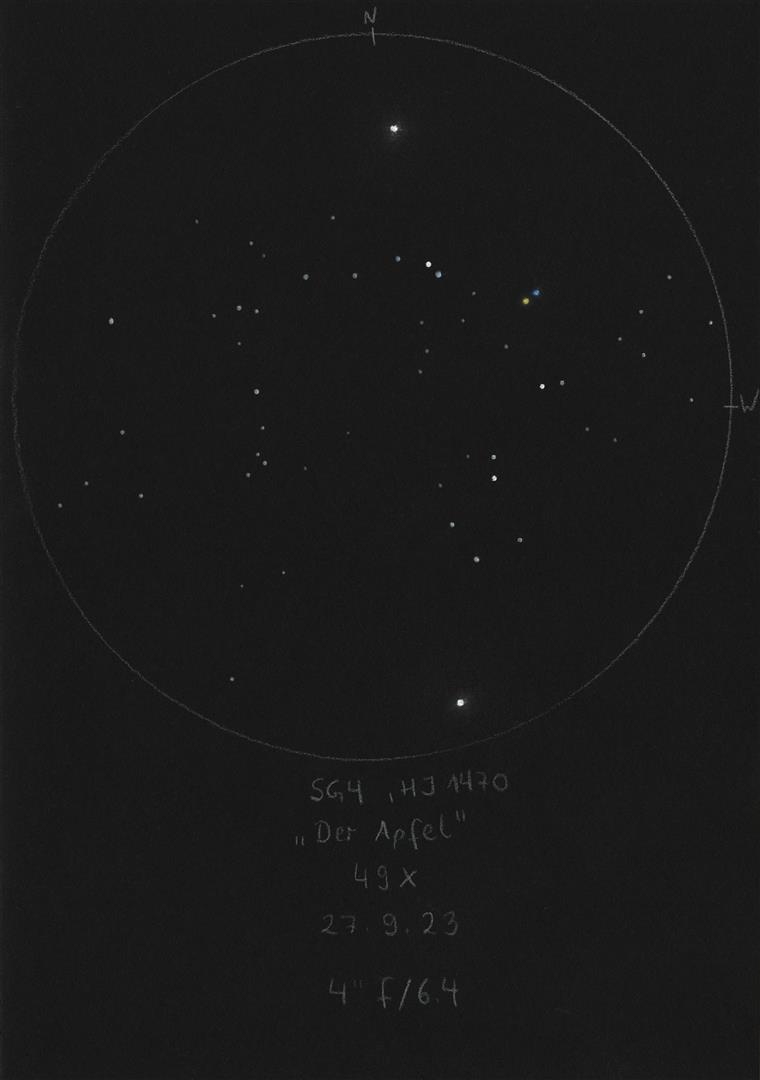
|
|
|
★★
|
STF2893 |
|
|
6m.2 |
7m.9 |
28.9" |
347° |
2018 |
Cep |
22h12m52.76s / +73°18'25.90" |
Sarah Gebauer
Germany |
100mm (45x) |
ein deutlicher und sehr schöner Farbkontrast der beiden ähnlich hellen Komponenten, gelblich-orange und bläulich trifft es sehr gut, die Farben sind recht stark und der DS erinnert an einen Mini-Albireo |
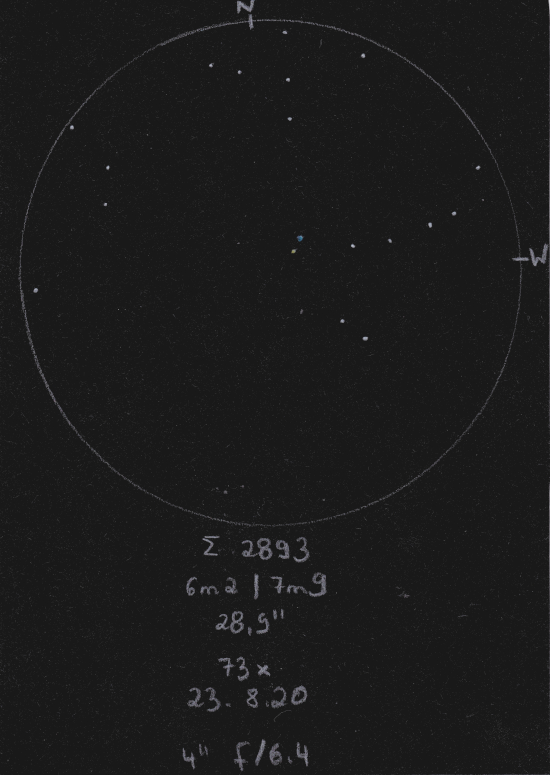
|
Mark McCarthy
Fremont (California/USA) |
152mm (175x) |
Light orange A and light blue 3 delta mag., very wide. A feels like it's a snowman (no other companion to A). WDS says physical, which is unusual for a wide separation, but it does share 23% parallax range overlap, 6,332 AU weighted separation but pretty high solar mass 3.74/2.03 |
|
|
|
★
|
STF2877 |
|
AB |
6m.7 |
9m.2 |
24.0" |
24° |
2018 |
Peg |
22h14m18.40s / +17°11'21.60" |
|
|
|
|
AC |
6m.7 |
12m.4 |
97.3" |
44° |
2016 |
|
|
|
|
|
|
AD |
6m.7 |
11m.3 |
101.2" |
309° |
2016 |
|
|
|
|
|
|
BC |
9m.2 |
12m.4 |
75.5" |
50° |
2016 |
|
|
|
|
|
|
BD |
9m.2 |
11m.3 |
97.9" |
296° |
2016 |
|
|
René Merting
Drachhausen (Germany) |
15x56 |
AB: Komponente B ist knapp abgesetzt nordöstlich von A erkennbar |
|
Sarah Gebauer
Germany |
100mm (21x) |
AB: 25.09.23: mit 21-fach schon getrennt zu sehen, im Südwesten strahlt eine zart goldfarbene A-Komponente und dicht daran im Nordosten steht ein ganz graues Lichtpünktchen mit einem Hauch eines metallischen Farbglanzes |

|
Uwe Pilz
Leipzig (Germany) |
105mm (37x) |
AB |

|
René Merting
Drachhausen (Germany) |
320mm (45x) |
AB: bei 45x zeigt B sich gut abgesetzt nordwestlich von A - A wirkt Maisgelb, aber eher wie junger, frischer Mais, B ist 2 bis 3 Größenklassen schwächer und einen grauen Kittel an - bei 144x ist das Paar ansehnlicher, A ist sattgelb, B weißgrau |
|
|
Berthold Fuchs
Wiesbaden (Germany) |
130mm |
AB: easy DS |
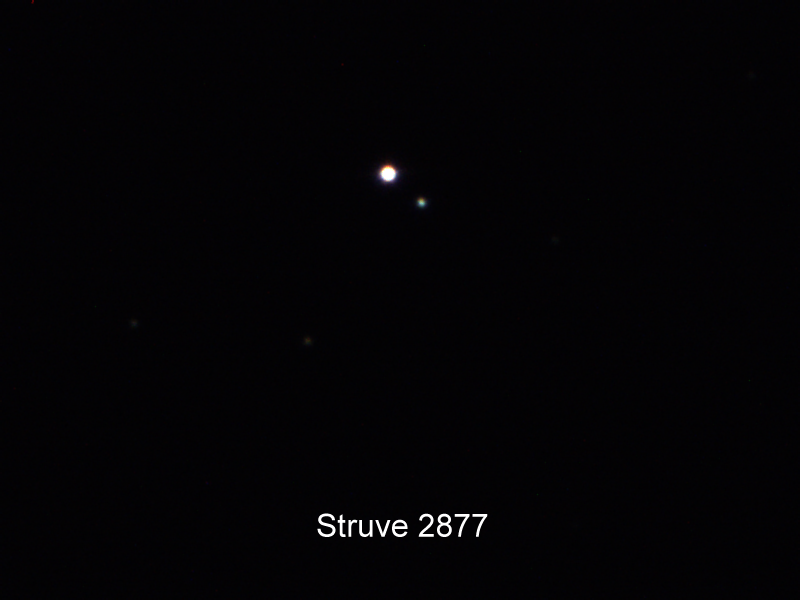
|
|
|
★
|
COU138 |
|
|
11m.4 |
11m.9 |
1.5" |
37° |
2016 |
Peg |
22h15m16.25s / +23°53'39.50" |
Mark McCarthy
Fremont (California/USA) |
508mm (533x) |
Wonderful faint pair, ~2" and two delta mag, very fine. Almost need averted vision but not quite. |
|
|
|
★
|
STF2894 |
|
AB |
6m.2 |
8m.8 |
15.8" |
194° |
2020 |
Lac |
22h18m56.21s / +37°46'09.40" |
|
|
|
|
AC |
6m.2 |
13m.5 |
48.5" |
248° |
2015 |
|
|
|
|
|
|
AD |
6m.2 |
11m.2 |
226.2" |
177° |
2015 |
|
|
|
|
|
|
BD |
8m.8 |
11m.2 |
211.0" |
176° |
2015 |
|
|
Robert Zebahl
Leipzig (Germany) |
16x70 |
AB: 2021-09-14: Rather unspectacular. Components pretty tight with a clear difference in brightness. The companion was barely visible. |
|
René Merting
Drachhausen (Germany) |
100mm (20x) |
AB: bei 32x ordentlich getrennt - der Doppelstern ist ansehnlicher als der gut 1,5° weiter westlich stehende STF2876 - Komponente A strahlt gelblich, B im Süden ist gut 2 Magnituden schwächer und dadurch grau bis rostig braun - zurück auf 20x sind beide Sterne knapp getrennt zu erkennen |
|
Sarah Gebauer
Germany |
100mm (49x) |
AB: die Spitze eines wunderschönen, nach Nordosten zeigenden Dreiecks mit etwa 60' Länge, der helle Stern 1 Lac wirkt sogar leicht gelblich, der Doppelstern selbst hat einen hübschen Helligkeitsunterschied |
|
|
|
★
|
HU383 |
|
|
9m.9 |
10m.1 |
0.4" |
29° |
2012 |
Peg |
22h19m36.43s / +21°07'00.60" |
Mark McCarthy
Fremont (California/USA) |
508mm (1067x) |
Suspected split with 533x, but no question of split at 1067x, very nice split near equal stars |
|
|
|
★
|
HO292 |
|
|
7m.7 |
11m.2 |
4.4" |
64° |
2015 |
Peg |
22h23m15.11s / +05°38'47.80" |
Mark McCarthy
Fremont (California/USA) |
317mm (553x) |
Extremely faint B, ~2", PA to north, seen with Averted vision only |
|
Mark McCarthy
Fremont (California/USA) |
508mm (205x) |
White A and ruddy B which is much fainter, wide |
|
|
|
★★
|
STF2909, zet 2 Aqr |
|
AB |
4m.3 |
4m.5 |
2.4" |
157° |
2021 |
Aqr |
22h28m49.81s / -00°01'12.20" |
|
|
Christopher Hay
Seeheim (Germany) |
60mm (39x) |
28 September 2024. At 39x definite elongation into a tiny rod, at 51x position angle is entirely clear. At 59x a notch appears between the components, at 79x a figure-eight close to separation. At 101x finally separation is achieved and the northern component A appears slightly warmer in hue than B to the south. At 118x this colour impression becomes more definite and the first diffraction rings of the components surround the pair as a faint figure-eight, very attractive. |
|
Sarah Gebauer
Germany |
100mm (80x) |
bei 80-fach blickweise getrennt, etwas unruhig, dennoch deutlich mit Einkerbung und leuchtet insgesamt schon buttergelb - bei 130-fach dann knapp und eindeutig getrennt, sehr buttrig gelb - die südliche der gleich hellen Komponenten wirkt minimal mehr orange - das sonstige Sternumfeld ist sehr leer, dadurch steht der DS sehr dominant im Bild |
|
Christopher Hay
Seeheim (Germany) |
180mm (120x) |
Neatly split, whereby the first difraction rings of each component touch the Airy discs of the other. Component A in the north seems marginally more yellowish than component B in the south.
Zeta Aqr is called Sadaltager, meaning „Merchant’s Luck“. It is framed nicely by Pi, Gamma and Eta Aquarii, with which it forms a striking triangular asterism known as „The Tent“. Moreover, Zeta Aqr is a true physical double. This constellation and the beautiful telescopic appearance warrant a two-star rating. |
|
Frederik Wanink
Itterbeck (Germany) |
254mm (240x) |
einfach |
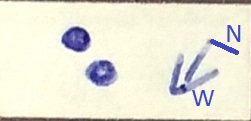
|
Mark McCarthy
Fremont (California/USA) |
317mm (277x) |
Very bright white, equal magnitude, fairly close ~2". |
|
|
|
★★
|
delta Cep, 27 Cep |
BU702 |
AB |
4m.2 |
13m.0 |
21.5" |
282° |
2015 |
Cep |
22h29m10.25s / +58°24'54.70" |
|
|
|
STFA58 |
AC |
4m.2 |
6m.1 |
41.0" |
191° |
2018 |
|
|
|
|
|
DAL45 |
AD |
4m.2 |
13m.9 |
109.0" |
39° |
2015 |
|
|
|
|
|
DAL45 |
DE |
13m.9 |
14m.0 |
1.4" |
23° |
2008 |
|
|
Christopher Hay
Seeheim (Germany) |
7x45 |
AC: Hand tremor hampers splitting A and C at this low magnification, as the apparent separation is small. Nonetheless, a grey-blue C dances next to the luminous-orange A.
Component A is the prototype of the Cepheid class of variable stars, with a brightness variation of a full magnitude over 5 days. To assess a somewhat difficult handheld binocular split like this it would really be necessary to know the momentary brightness of A, but I didn’t have a telescope at hand. |
|
René Merting
Drachhausen (Germany) |
15x56 |
AC: ein wunderschönes Paar - A strahlt satt gelb, C zeigt sich gut getrennt und tendiert mehr ins weißgraue - dadurch ein schöner Farbkontrast |
|
Robert Zebahl
Leipzig (Germany) |
16x70 |
AC: 2020-09-20: Nice separation with noticeable difference in brightness. Slightly yellowish & white-bluish. |
|
Robert Zebahl
Leipzig (Germany) |
55mm (27x) |
AC: At 27x easy to separate, rather wide apart with clear difference in brightness. At 38x the colors are slightly better visible: A shines in bright orange, C appears rather grey-bluish. |
|
Robert Zebahl
Leipzig (Germany) |
80mm (25x) |
AC: Obvious difference in brightness and color. Brighter component slightly orange, weaker bluish. Could be Albireo's little brother ;) |
|
René Merting
Drachhausen (Germany) |
107mm (30x) |
AC: bei 30x ein sehr auffälliges Sternpaar mit einem auffälligen Farbkontrast - auch wenn C deutlich schwächer ist, so strahlen doch beide Sterne um die Wette - Komponente A zeigt sich Siennagelb, C wirkt Blauweiß - ordentliche Trennung - bei 6x ändert C ein wenig seine Farbe, ich habe mitunter den Eindruck, Grünblau zu sehen |
|
Sarah Gebauer
Germany |
150mm (85x) |
AC: die hellere Komponente ist sehr intensiv und richtig schön goldgelb und die zweite, deutlich schwächere Komponente hat einen sichtbar bläulichen Farbstich, insgesamt schon ab 21x sehr schön anzuschauen |

|
Mark McCarthy
Fremont (California/USA) |
508mm (667x) |
DE: Slight brightening in the diffraction ring |
|
|
Frederik Wanink
Itterbeck (Germany) |
254mm |
AC |
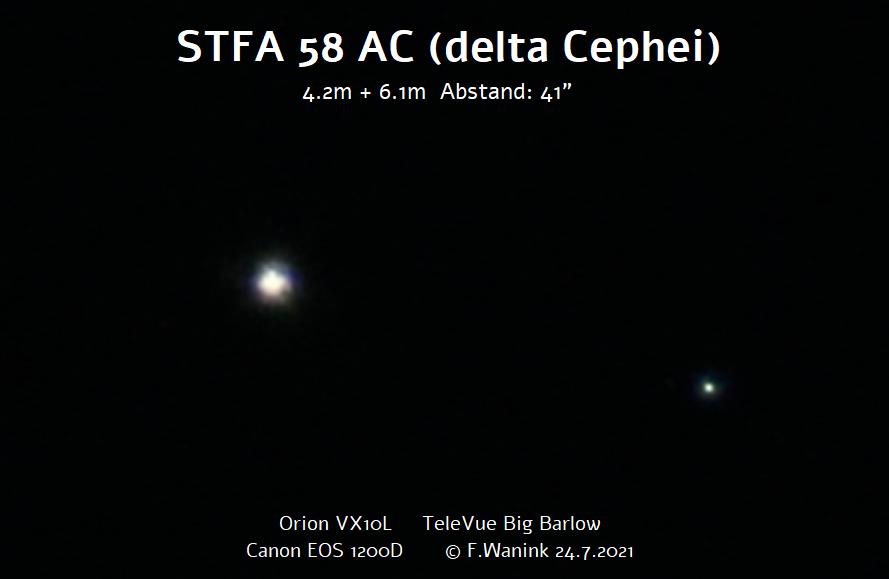
|
|
|
★
|
HO475 |
|
AB |
9m.3 |
9m.6 |
1.1" |
306° |
2016 |
Peg |
22h32m45.51s / +26°24'32.70" |
Mark McCarthy
Fremont (California/USA) |
508mm (533x) |
Great! two plus one it must be. Tight near equal very well split, ~1", and another star about 1.5 fainter, rather wide about ten (AC) |
|
|
|
★
|
HU982 |
|
|
7m.8 |
9m.4 |
0.6" |
216° |
2009 |
Peg |
22h35m12.10s / +14°36'37.90" |
Mark McCarthy
Fremont (California/USA) |
508mm (1067x) |
Persistent elongation at 533x and with barlow at 1067x. No resolution through, maybe an instant of notching |
|
|
|
★
|
HO294 |
|
|
8m.2 |
11m.0 |
1.9" |
60° |
2016 |
Peg |
22h37m35.20s / +27°26'22.80" |
Mark McCarthy
Fremont (California/USA) |
508mm (533x) |
When I first viewed the seeing was very rough, but after a couple of minutes it settled down so I could see a beautiful orange-yellow star resolved with a very faint reddish B ~3", nice hard points |
|
|
|
★★
|
HO296 |
|
AB |
6m.1 |
7m.2 |
0.4" |
26° |
2020 |
Peg |
22h40m52.71s / +14°32'57.50" |
Mark McCarthy
Fremont (California/USA) |
152mm (175x) |
Subtly out of round, no notch, very slightly weaker on one side. 20.83-year period, it is tightening |
|
Mark McCarthy
Fremont (California/USA) |
317mm (553x) |
Snowman. Light orange. Very tough |
|
Mark McCarthy
Fremont (California/USA) |
508mm (667x) |
Definite smaller point or appendage sprouting from A's disk, >1 delta mag, and more than subtle notching. PA is to the north which matches the current position. Physical with 20.83 year period, now at 0.362", it will close rapidly and likely be impossible to detect by 2023, then become detectable (at 0.3") by 2029. One to keep an eye on |
|
|
|
★
|
HU985 |
|
|
9m.6 |
9m.9 |
0.7" |
134° |
2016 |
Peg |
22h47m54.00s / +12°58'36.20" |
|
|
Mark McCarthy
Fremont (California/USA) |
508mm (533x) |
Wow I got it! Light orange star and a very faint star just outside first diffraction, very subtle and tough |
|
|
|
★★
|
HO482 |
|
AB |
7m.3 |
8m.3 |
0.6" |
13° |
2017 |
Peg |
22h51m26.66s / +26°23'27.90" |
|
|
Mark McCarthy
Fremont (California/USA) |
152mm (285x) |
Notched elongation, blue-green stars. 383-year period, missing data in EDR3 |
|
Mark McCarthy
Fremont (California/USA) |
508mm (533x) |
!! Excellent split, white stars, slight magnitude difference, really good. Physical with 383 year period |
|
|
|
★
|
COU239 |
|
|
10m.9 |
11m.4 |
2.1" |
297° |
2017 |
Peg |
22h51m56.95s / +22°19'21.00" |
Mark McCarthy
Fremont (California/USA) |
508mm (205x) |
! Really excellent pair, faint but comfortably split, slight delta mag, very pretty |
|
|
|
★
|
TDT3763 |
|
AB |
10m.4 |
11m.8 |
1.7" |
13° |
2017 |
Peg |
22h52m24.77s / +28°18'54.90" |
Mark McCarthy
Fremont (California/USA) |
508mm (533x) |
Cool! B just shows itself with seeing ~1.5" separation. Can tell its there, even with some smearing it does resolve to a point |
|
|
|
★
|
STF2977 |
|
AB |
6m.8 |
10m.3 |
1.8" |
356° |
2016 |
Cep |
23h06m28.56s / +61°26'24.50" |
Mark McCarthy
Fremont (California/USA) |
152mm (175x) |
Fine 1" split, 2 delta mag, light yellow stars. Spectral class F5V (yellow-white). WDS physical, however there is no parallax range overlap, -22% |
|
Mark McCarthy
Fremont (California/USA) |
203mm (205x) |
! Wow very nice. Split with seeing, bright white A settles to round and B appears as a blue disk just outside A's diffraction, light blue color, really a treat. Physical |
|
|
|
★
|
BU180 |
|
AB |
8m.0 |
9m.2 |
0.5" |
134° |
2016 |
Cep |
23h07m09.99s / +60°49'57.10" |
|
|
Mark McCarthy
Fremont (California/USA) |
203mm (533x) |
Snowman through 533x. Just too much of a delta mag. Burnham discovered with his 6-inch at 0.57"! Physical, 537 year period |
|
Mark McCarthy
Fremont (California/USA) |
508mm (667x) |
Exceedingly fine split at best moments, hairline, 1 delta mag. |
|
|
|
★★★
|
BVD142 & TDT3916 |
BVD142 |
AB |
7m.8 |
10m.3 |
80.0" |
165° |
2018 |
And |
23h10m29.28s / +41°19'18.70" |
|
|
|
TDT3916 |
Ba-Bb |
10m.7 |
11m.4 |
0.6" |
89° |
1991 |
|
|
Mark McCarthy
Fremont (California/USA) |
317mm (553x) |
BVD142 (AB): Orange stars, 1 delta mag, well separated (finder split). B looks suspiciously like a pair -- but the transparency may be causing it to smear. This is quite an amazing catch considering the conditions! AB is as described 7.80/10.28 79.6". B is indeed a pair: TDT 3916 = BaBb, 10.69/11.41 0.6". Discovered in 1991 and only one observation! |
|
Mark McCarthy
Fremont (California/USA) |
317mm (553x) |
TDT3916 (Ba-Bb): Orange stars, 1 delta mag, well separated (finder split). B looks suspiciously like a pair -- but the transparency may be causing it to smear. This is quite an amazing catch considering the conditions! AB is as described 7.80/10.28 79.6". B is indeed a pair: TDT 3916 = BaBb, 10.69/11.41 0.6". Discovered in 1991 and only one observation! |
|
|
|
★
|
STFB12 & BU1220, 91 Aqr, psi 1 Aqr |
STFB12 |
A-BC |
4m.4 |
9m.9 |
48.9" |
312° |
2014 |
Aqr |
23h15m53.50s / -09°05'15.90" |
|
|
|
BU1220 |
AD |
4m.4 |
13m.5 |
110.1" |
273° |
2008 |
|
|
|
|
|
BU1220 |
BC |
10m.5 |
10m.7 |
0.4" |
107° |
2021 |
|
|
|
|
|
BU1220 |
BC-E |
9m.9 |
14m.3 |
42.3" |
294° |
2008 |
|
|
|
|
Christopher Hay
Seeheim (Germany) |
30x80 |
A-BC: Very wide apart but still with the appearance of belonging together. BC a single, fine point of light.
Attractive together with STF2993 in 1.6° field of view. Psi1 Aqr and STF2993 are at same elevation in January evenings, a pleasing constellation. |
|
Sarah Gebauer
Germany |
100mm (49x) |
A-BC: 02.10.23: bei 21-fach als nordwestlichster der drei "Psi-Aquarii-Sterne" und gleich warmgold zu sehen - bei 49-fach taucht nordwestlich von der vor allem im Gegensatz zu Psi 2 und Psi 3 schön goldgelben A-Komponente mit weißem Farbtupfer mittig weit abgesetzt der ganz schwache, dunkelgraue Begleiter auf |
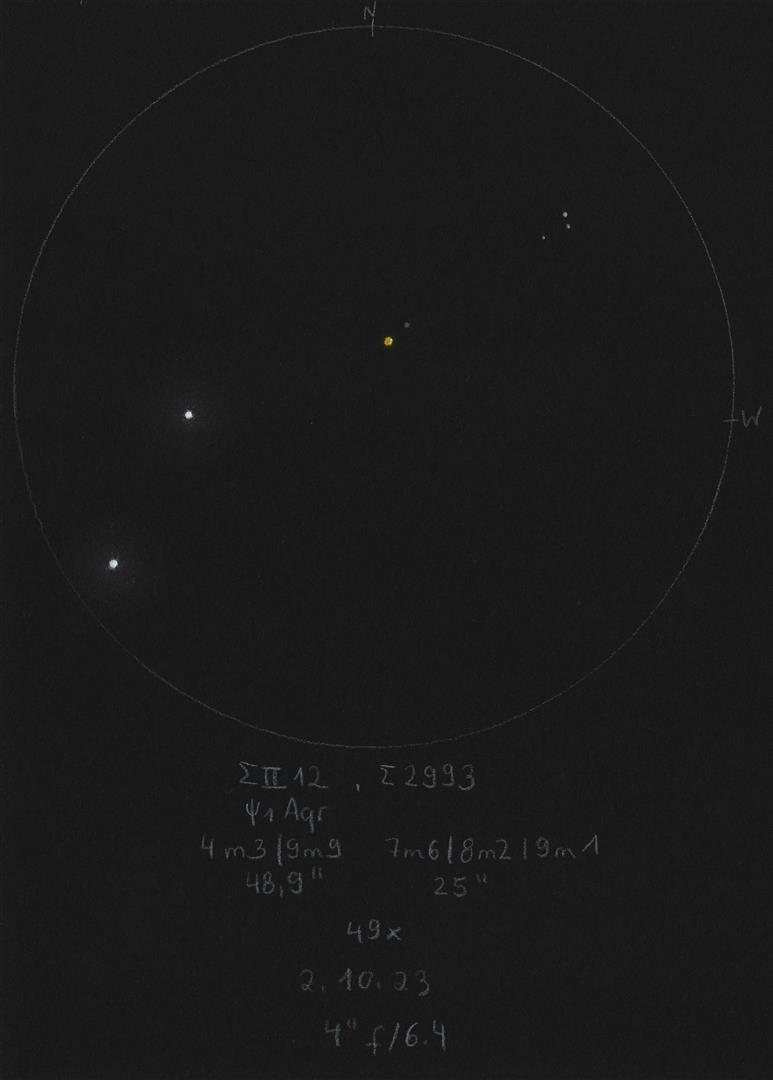
|
Christopher Hay
Seeheim (Germany) |
200mm (170x) |
A-BC: According to Stelledoppie A and BC are a physical double, and B and C are in turn a tight physical double, hence a true triple system at a distance of 150 light years. A smaller aperture suffices to separate A-BC, but with 8 inches the fine colour contrast of A to BC presents nicely and the double dominates the 0.3° FOV. Very nice, for A is lemon-yellow, BC brick-red. |
|
|
|
★
|
HEI89 |
|
|
10m.5 |
10m.8 |
1.2" |
68° |
2016 |
Peg |
23h21m23.99s / +16°22'00.40" |
Mark McCarthy
Fremont (California/USA) |
508mm (533x) |
Very fine pair, very pretty not really that equal magnitude, ~2" |
|
|
|
★★
|
STF3009 |
|
AB |
6m.9 |
8m.8 |
7.1" |
230° |
2018 |
Psc |
23h24m16.47s / +03°42'56.10" |
Sarah Gebauer
Germany |
100mm (42x) |
schon bei 42-fach als sehr ungleich helles Paar getrennt, die helle Komponente strahlt sehr schön orangegold, die schwächere südöstlich zeigt sich sehr schwach und bräunlich - bei 80-fach wird der Farbeindruck und B ist besser direkt sichtbar, immer noch graubraun - A ist nun phänomenal orangegold |

|
René Merting
Drachhausen (Germany) |
100mm (64x) |
bei 64x ist Komponente B südwestlich von A knapp getrennt erkennbar - großer Helligkeitsunterschied, vielleicht 3 bis 3.5 Größenklassen |
|
Uwe Pilz
Leipzig (Germany) |
105mm (144x) |
|
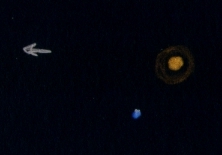
|
|
|
★★
|
STF3012 & STF3013 & DOB18 |
STF3012 |
AB |
9m.5 |
9m.8 |
2.9" |
190° |
2016 |
Peg |
23h27m33.16s / +16°37'22.90" |
|
|
|
STF3012 |
AC |
9m.5 |
8m.5 |
53.4" |
67° |
2018 |
|
|
|
|
|
DOB18 |
AD |
9m.5 |
10m.2 |
49.7" |
64° |
2015 |
|
|
|
|
|
STF3013 |
BC |
9m.8 |
8m.5 |
54.1" |
64° |
2015 |
|
|
|
|
|
DOB18 |
BD |
9m.8 |
10m.2 |
51.4" |
62° |
2015 |
|
|
|
|
|
STF3013 |
CD |
8m.5 |
10m.2 |
3.2" |
277° |
2017 |
|
|
Sarah Gebauer
Germany |
100mm (136x) |
beginnend mit 21x ist das Doppel-Doppel gefunden, bei 45x ist zu erkennen, dass jeder Stern jeweils ein DS ist, doch bei 136x wird das Bild so dunkel, dass die Sterne kaum noch zu sehen, geschweige denn zu trennen sind |
|
Uwe Pilz
Leipzig (Germany) |
105mm (180x) |
STF3012: Es war schwierig zu erkennen, welcher Stern der hellere war. Die Trennung war insgesamt nicht einfach. Anfangs sah ich nur einen länglichen Stern.
STF3013: Anfangs sah ich nur einen länglichen Stern. Der große Helligkeitsunterschied macht die Trennung interessanterweise einfacher als STF3012. |

|
Mark McCarthy
Fremont (California/USA) |
317mm (553x) |
STF3012 (AB): near equal brightness ~3" separation. Double double with STF 3021 |
|
|
|
★★
|
STF3021 |
|
AB |
8m.1 |
9m.3 |
8.7" |
308° |
2017 |
Peg |
23h31m24.65s / +16°13'07.60" |
|
|
|
|
AC |
8m.1 |
10m.8 |
118.2" |
23° |
2015 |
|
|
René Merting
Drachhausen (Germany) |
100mm (32x) |
AB: bei 32x zeigt sich B ganz knapp getrennt nordwestlich von A - Helligkeitsunterschied gut 2 Größenklassen - der Doppelstern bildet mit drei helleren Sternen eine flache Drachenraute |
|
Mark McCarthy
Fremont (California/USA) |
317mm (553x) |
AB: ~3.5" and ~1 delta mag. Double double with STF 3012 |
|
|
Berthold Fuchs
Wiesbaden (Germany) |
130mm |
AB: easy DS |

|
|
|
★
|
72 Peg, BU720 |
|
|
5m.7 |
6m.1 |
0.6" |
106° |
2018 |
Peg |
23h33m57.19s / +31°19'31.00" |
|
|
Uwe Pilz
Leipzig (Germany) |
120mm (250x) |
gelb und orange |
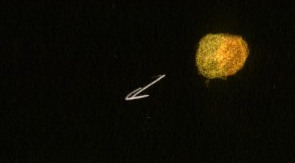
|
Mark McCarthy
Fremont (California/USA) |
152mm (175x) |
Light orange, probably elongated, but seeing is too poor to resolve. Physical with a 492 year period. Spectral class K4IIIb (yellow-orange) |
|
Frederik Wanink
Itterbeck (Germany) |
254mm (640x) |
als 8 zu sehen |
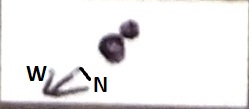
|
Mark McCarthy
Fremont (California/USA) |
317mm (553x) |
72 Peg. Small, hard, faint point very tight to A, but split. Stays with seeing. |
|
|
|
★
|
TDT4190 |
|
|
10m.2 |
10m.3 |
0.6" |
33° |
2012 |
Peg |
23h46m58.42s / +17°25'51.20" |
Mark McCarthy
Fremont (California/USA) |
508mm (533x) |
Amazing I got the split at 533x only, clean split, near equal, light orange stars. |
|
|
|
★
|
BU995 |
|
|
6m.1 |
8m.7 |
0.8" |
245° |
2014 |
And |
23h47m33.04s / +46°49'57.20" |
Mark McCarthy
Fremont (California/USA) |
317mm (553x) |
Very fine 4 delta mag, <0.8" |
|
|
|
★★
|
STF3041 |
|
A-BC |
8m.3 |
8m.4 |
60.5" |
358° |
2017 |
Peg |
23h47m51.79s / +17°03'21.60" |
|
|
|
|
AB |
8m.3 |
9m.1 |
61.1" |
356° |
2018 |
|
|
|
|
|
|
AC |
8m.3 |
9m.2 |
59.5" |
358° |
2018 |
|
|
|
|
|
|
BC |
9m.2 |
9m.0 |
3.4" |
356° |
2020 |
|
|
René Merting
Drachhausen (Germany) |
15x56 |
A-BC: popeleinfach - zwei gleichhelle, weiße Sterne, komfortabel getrennt - durch viele gleich helle Sterne im Umfeld haben die beiden aber keine exponierte Stellung |
|
René Merting
Drachhausen (Germany) |
100mm (20x) |
A-BC: bei 20x riecht das nicht nach Trennung, sondern es sieht nach weit auseinander stehenden Sternen aus - Komponente BC ist kupferbraun und genauso hell wie die weiß strahlende Komponente A - auf die Trennung von BC habe ich leider nicht geachtet (Sep. 3,3" laut Stelle Doppie) |
|
Uwe Pilz
Leipzig (Germany) |
105mm (144x) |
A-BC ist mit 21x leicht erkennbar. Drei fast gleichhelle Komponenten, etwas besonderes! |
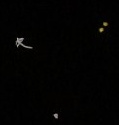
|
Robert Zebahl
Leipzig (Germany) |
120mm (86x) |
2021-11-05: At 21x the pair A-BC is widely separated, the components appear similar bright. A appears white-bluish, BC rather slightly orange. The color changes partly between the components. At 46x BC then appears clearly elongated with a slight notch, at 86x clearly separated with almost equally bright components. The color impression remains: A white-bluish, B & C slightly orange. All three components are in line. Worthwhile. |
|
|
|
★
|
HEI91 |
|
|
10m.1 |
11m.9 |
0.7" |
153° |
2010 |
Peg |
23h48m38.11s / +16°21'36.40" |
Mark McCarthy
Fremont (California/USA) |
508mm (533x) |
Wow B star emerges with perfect seeing only, just within where A's diffraction ring was -- seeing needs to be so good the ring all but disappears, otherwise the ring would hide it. Great |
|
|
|
★★
|
STF3044 |
|
|
7m.3 |
7m.9 |
18.7" |
283° |
2017 |
Peg |
23h52m59.94s / +11°55'27.40" |
René Merting
Drachhausen (Germany) |
15x56 |
ein schöner 15-fach-Fernglas-Doppelstern - ein sehr dicht zusammenstehendes Sternpaar, bei dem B im Nordwesten nur minimal schwächer ist - beide haben ein strahlend weißes Zahnpastalächeln und haben kaum Konkurrenz im Umfeld |
|
Robert Zebahl
Leipzig (Germany) |
70mm (22x) |
At 22x easy to separate with small difference in brightness. A color difference was noticeable. One component looked white-bluish, the other slightly orange. However, the colors changed again and again between the components. Even at 44x the color impression remained the same. |
|
René Merting
Drachhausen (Germany) |
100mm (20x) |
bei 32x gut getrennt, Komponente B im Westen etwa eine viertel Magnitude schwächer - auch bei 20x noch sehr ansehnlich, beide Sterne stehen gut getrennt eng beieinander |
|
Uwe Pilz
Leipzig (Germany) |
105mm (88x) |
|
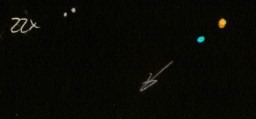
|
|
|
★
|
STF3049, sigma Cas, 8 Cas |
|
AB |
5m.0 |
7m.2 |
3.1" |
326° |
2017 |
Cas |
23h59m00.53s / +55°45'17.80" |
|
|
|
|
AC |
5m.0 |
10m.4 |
106.0" |
66° |
2014 |
|
|
Robert Zebahl
Leipzig (Germany) |
70mm (120x) |
AB: At 57x barely separated, where the B component appears as a faint tiny star. At 120x the B component is clearly visible and slightly elongated on the first diffraction ring of the primary component. Very fine. |
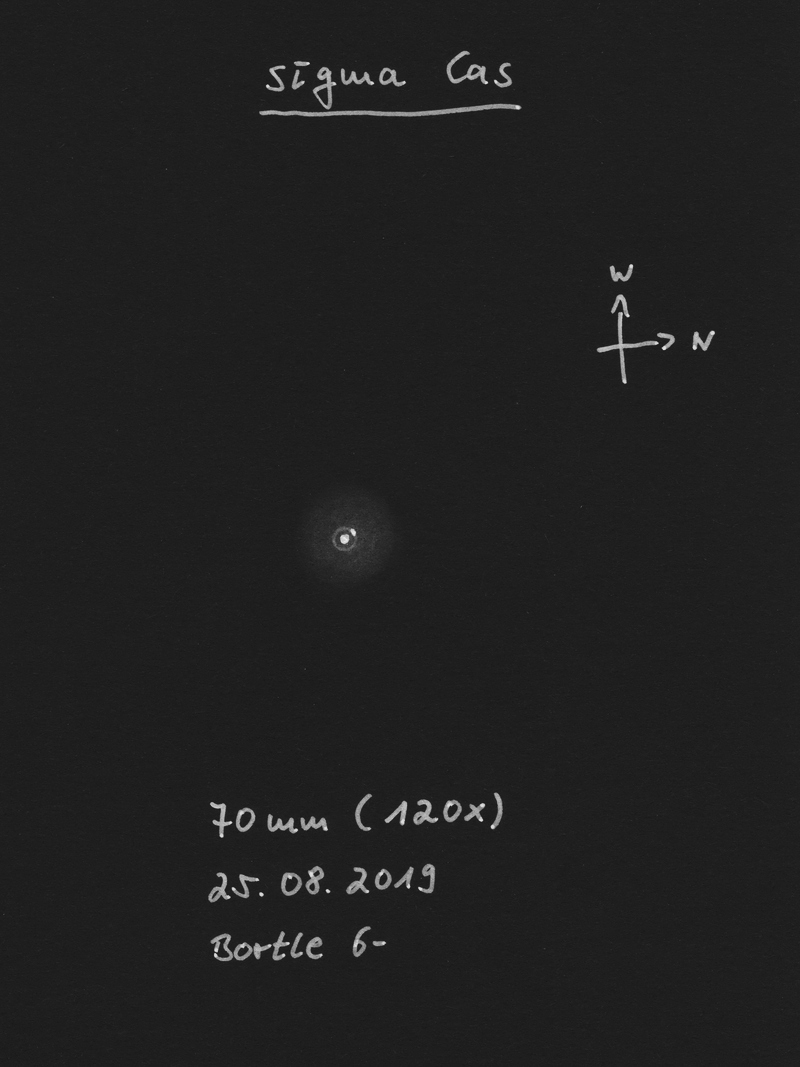
|
Sarah Gebauer
Germany |
100mm (80x) |
AB: bei 49-fach noch nicht getrennt, aber bereits als zwei schwach goldgelbe Murmelchen aneinander zu sehen - bei 80-fach auch noch nicht getrennt, nun dürfte es Luftunruhe sein - der Farbton bleibt warm goldgelb |
|
Uwe Pilz
Leipzig (Germany) |
105mm (288x) |
AB: Begleiter gerade außerhalb des Beugungsrings |
|
Mark McCarthy
Fremont (California/USA) |
152mm (175x) |
AB: Cream white A and light yellow, 2 delta mag B, well split. WDS is uncertain, but there is no parallax range overlap (-12%) |
|
Mark McCarthy
Fremont (California/USA) |
317mm (277x) |
AB: White A to slight yellow B, 3-4", 1.5 delta mag. |
|
René Merting
Drachhausen (Germany) |
320mm (144x) |
AB: bei 144x sind beide Komponenten knapp getrennt erkennbar - Komponente B ist bestimmt 2 Magnituden schwächer - Komponente A wirkt kühler, obwohl kein echter Farbkontrast erkennbar ist |
|
|
|
★
|
STF3050 |
|
AB |
6m.5 |
6m.7 |
2.5" |
343° |
2021 |
And |
23h59m29.33s / +33°43'26.90" |
|
|
Robert Zebahl
Leipzig (Germany) |
55mm (83x) |
At 83x seen as '8'. From 100x to 166x seen as '8', temporarily visible with space between. |
|
Robert Zebahl
Leipzig (Germany) |
70mm (100x) |
Wonderful double star. Easy to split with slight difference in brightness. |
|
René Merting
Drachhausen (Germany) |
76mm (95x) |
bei 57x deutet sich an, dass es sich um einen Doppelstern handeln könnte - bei 95x zeigt sich dann ein extrem knapp getrenntes Pärchen - beide Sterne sind gleich hell |
|
Sarah Gebauer
Germany |
100mm (136x) |
ui, schön! Ein sehr enges Pärchen, bei 136x ganz knapp getrennt, zwei winzig kleine, gleich helle Äuglein nebeneinander |
|
Frederik Wanink
Itterbeck (Germany) |
254mm (640x) |
einfaches Paar, gleich hell |
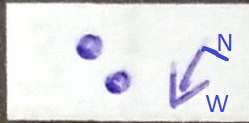
|
Mark McCarthy
Fremont (California/USA) |
317mm (277x) |
Nice near equal yellow-white, ~3" |
|
|










